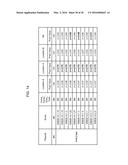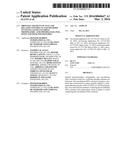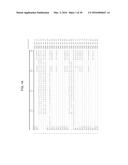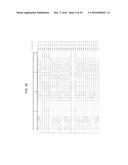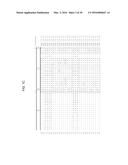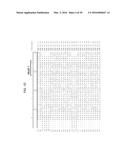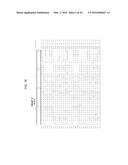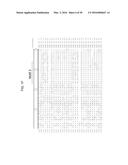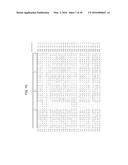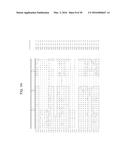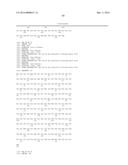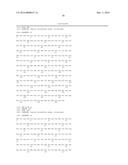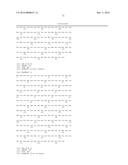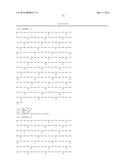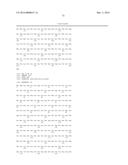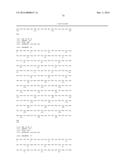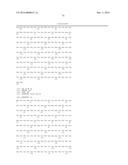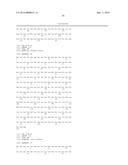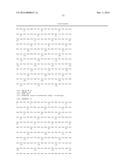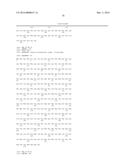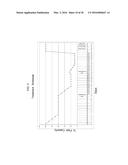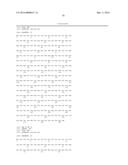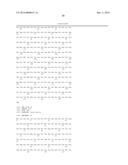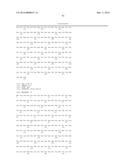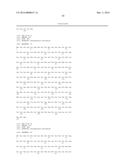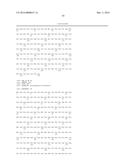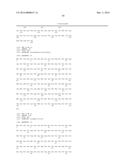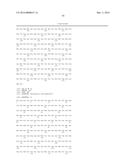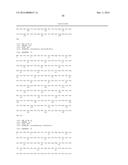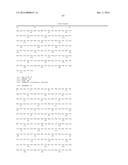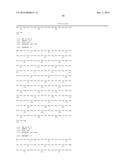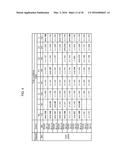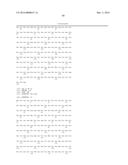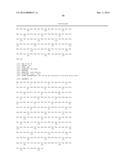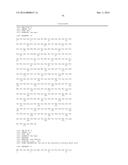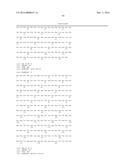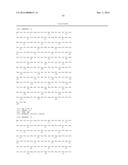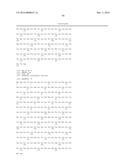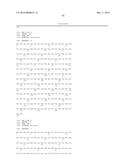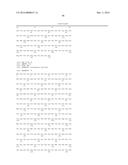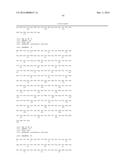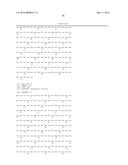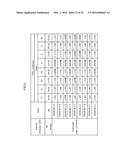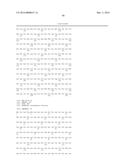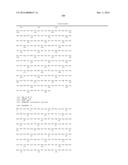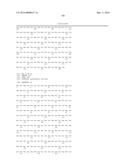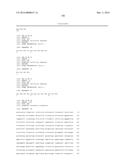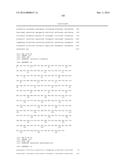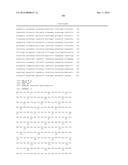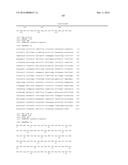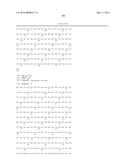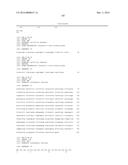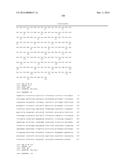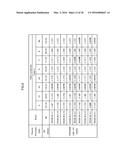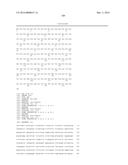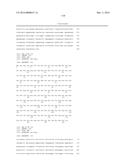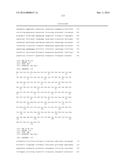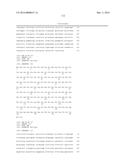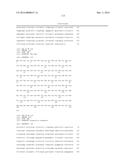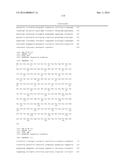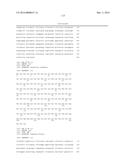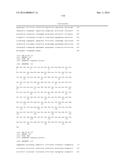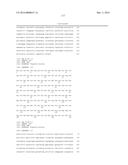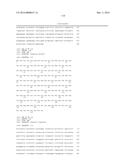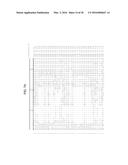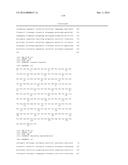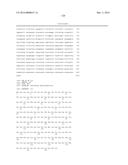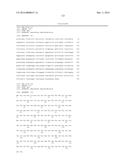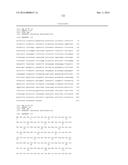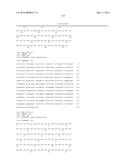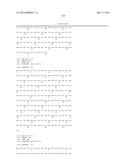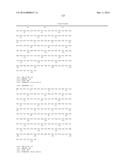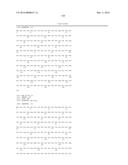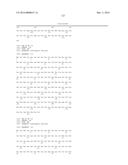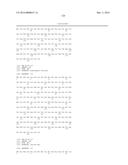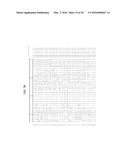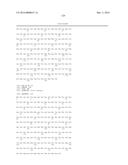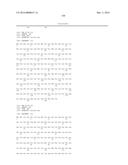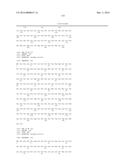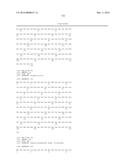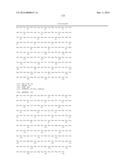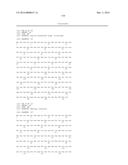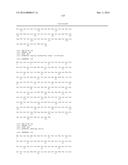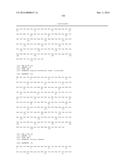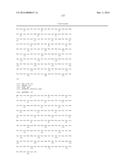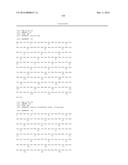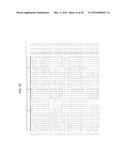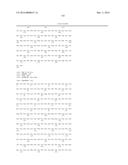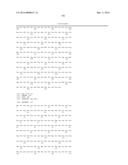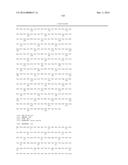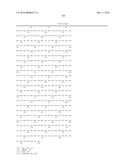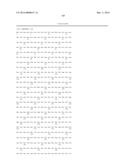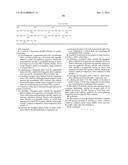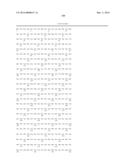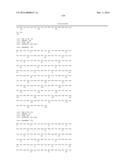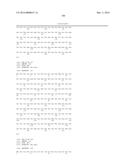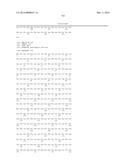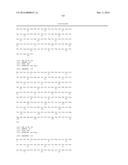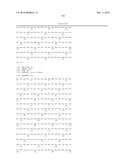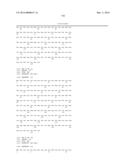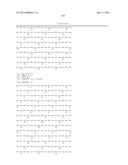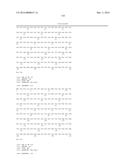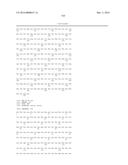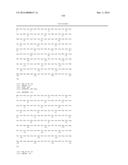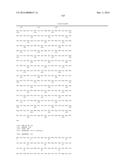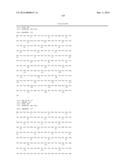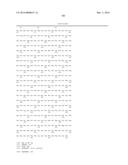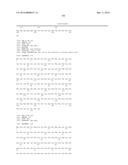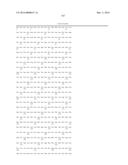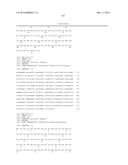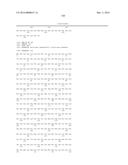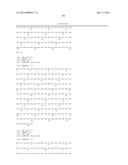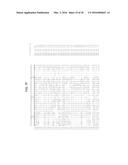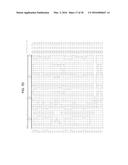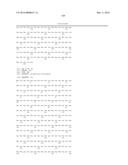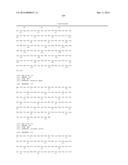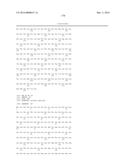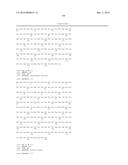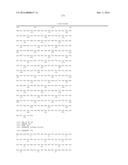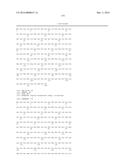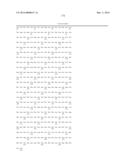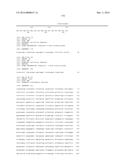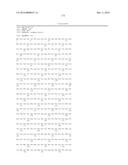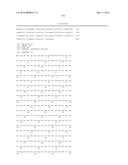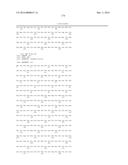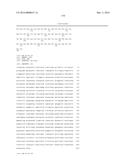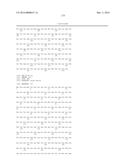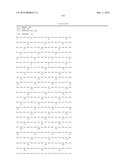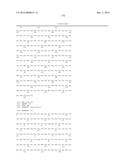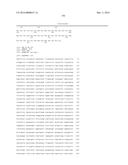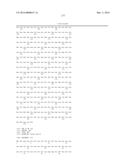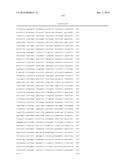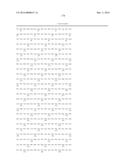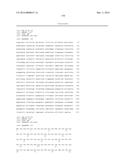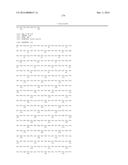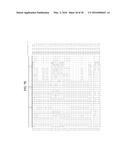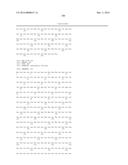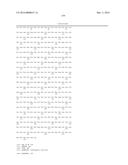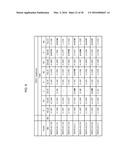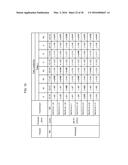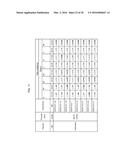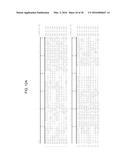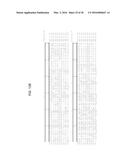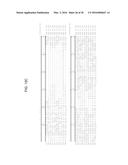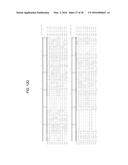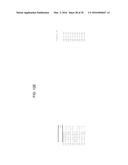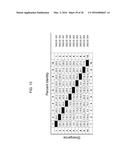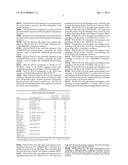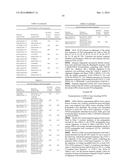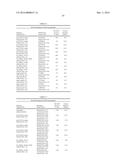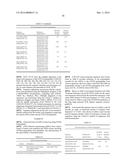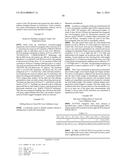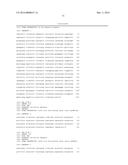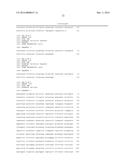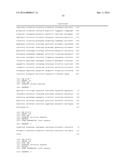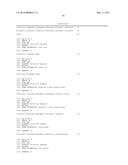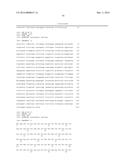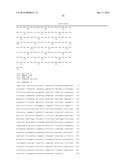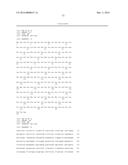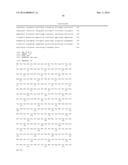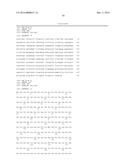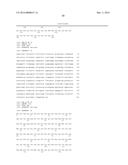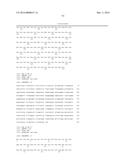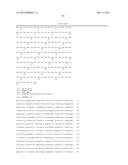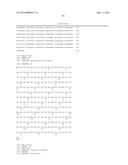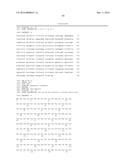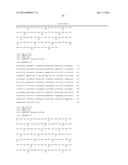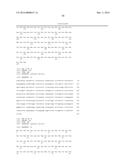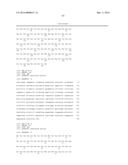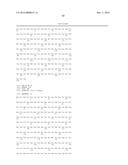Patent application title: DROUGHT TOLERANT PLANTS AND RELATED CONSTRUCTS AND METHODS INVOLVING GENES ENCODING PHOSPHATIDIC ACID PHOSPHATASE (PAP), DTP25 and DTP46 POLYPEPTIDES
Inventors:
Stephen M. Allen (Wilmington, DE, US)
Honor Renee Lafitte (Davis, CA, US)
Honor Renee Lafitte (Davis, CA, US)
Stanley Luck (Wilmington, DE, US)
Jeffrey Mullen (Maple Plain, MN, US)
Hajime Sakai (Newark, DE, US)
Rinku Ranjan Sarangi (Andhra Pradesh, IN, US)
Abhiman Saraswathi (Andhra Pradesh, IN, US)
Sobhana Sivasankar (Urbandale, IA, US)
Scott V. Tingey (Rockdale, TX, US)
Scott V. Tingey (Rockdale, TX, US)
Robert W. Williams (Hockessin, DE, US)
IPC8 Class: AC12N1582FI
USPC Class:
800278
Class name: Multicellular living organisms and unmodified parts thereof and related processes method of introducing a polynucleotide molecule into or rearrangement of genetic material within a plant or plant part
Publication date: 2016-03-03
Patent application number: 20160060647
Abstract:
Isolated polynucleotides, polypeptides and recombinant DNA constructs
useful for conferring drought tolerance are disclosed. The recombinant
DNA construct comprises a promoter that is functional in a plant operably
linked to a polynucleotide that encodes a PAP, a DTP25 or a DTP46
polypeptide. Also disclosed are methods of utilizing the recombinant DNA
construct and compositions (such as plants or seeds) comprising the
recombinant DNA construct.Claims:
1-5. (canceled)
6. A method of increasing drought tolerance in a plant, comprising: (a) introducing into a regenerable plant cell a recombinant DNA construct comprising a polynucleotide operably linked to at least one regulatory sequence, wherein the polynucleotide encodes a polypeptide having an amino acid sequence of at least 90% sequence identity, based on the Clustal V method of alignment, when compared to SEQ ID NO:17; (b) regenerating a transgenic plant from the regenerable plant cell of (a), wherein the transgenic plant comprises in its genome the recombinant DNA construct; and (c) obtaining a progeny plant derived from the transgenic plant of (b), wherein said progeny plant comprises in its genome the recombinant DNA construct and exhibits increased drought tolerance when compared to a control plant not comprising the recombinant DNA construct.
7. A method of selecting for increased drought tolerance in a plant, comprising: (a) obtaining a transgenic plant, wherein the transgenic plant comprises in its genome a recombinant DNA construct comprising a polynucleotide operably linked to at least one regulatory element, wherein said polynucleotide encodes a polypeptide having an amino acid sequence of at least 90% sequence identity, based on the Clustal V method of alignment, when compared to SEQ ID NO:17; (b) growing the transgenic plant of part (a) under conditions wherein the polynucleotide is expressed; and (c) selecting the plant of (b) with increased drought tolerance compared to a control plant not comprising the recombinant DNA construct.
8. A method of selecting for an increase of yield, biomass, or both in a plant, comprising: (a) obtaining a transgenic plant, wherein the transgenic plant comprises in its genome a recombinant DNA construct comprising a polynucleotide operably linked to at least one regulatory element, wherein said polynucleotide encodes a polypeptide having an amino acid sequence of at least 90% sequence identity, based on the Clustal V method of alignment, when compared to SEQ ID NO:17; (b) growing the transgenic plant of part (a) under conditions wherein the polynucleotide is expressed; and (c) selecting the plant of (b) that exhibits an increase of yield, biomass or both when compared to a control plant not comprising the recombinant DNA construct.
9. The method of claim 8, wherein said selecting step (c) comprises determining whether the progeny plant of (b) exhibits an increase of yield, biomass or both when compared, under water limiting conditions, to a control plant not comprising the recombinant DNA construct.
10. (canceled)
11. The method of claim 8, wherein said plant is selected from the group consisting of: Arabidopsis, maize, soybean, sunflower, sorghum, canola, wheat, alfalfa, cotton, rice, barley, millet, sugar cane and switchgrass.
12-16. (canceled)
Description:
CROSS REFERENCE TO RELATED APPLICATIONS
[0001] This application claims the benefit of U.S. Provisional Application No. 61/714,312, filed Oct. 16, 2012, U.S. Provisional Application No. 61/714,320, filed Oct. 16, 2012, U.S. Provisional Application No. 61/739,454, filed Dec. 19, 2012, U.S. Provisional Application No. 61/775,720, filed Mar. 8, 2013, and U.S. Provisional Application No. 61/786,679, filed Mar. 15, 2013, the entire content of each is herein incorporated by reference.
FIELD OF THE INVENTION
[0002] The field of invention relates to plant breeding and genetics and, in particular, relates to recombinant DNA constructs useful in plants for conferring tolerance to drought.
BACKGROUND OF THE INVENTION
[0003] Abiotic stress is the primary cause of crop loss worldwide, causing average yield losses of more than 50% for major crops (Boyer, J. S. (1982) Science 218:443-448; Bray, E. A. et al. (2000) In Biochemistry and Molecular Biology of Plants, Edited by Buchannan, B. B. et al., Amer. Soc. Plant Biol., pp. 1158-1203). Among the various abiotic stresses, drought is the major factor that limits crop productivity worldwide. Exposure of plants to a water-limiting environment during various developmental stages appears to activate various physiological and developmental changes. Understanding of the basic biochemical and molecular mechanism for drought stress perception, transduction and tolerance is a major challenge in biology. Reviews on the molecular mechanisms of abiotic stress responses and the genetic regulatory networks of drought stress tolerance have been published (Valliyodan, B., and Nguyen, H. T., (2006) Curr. Opin. Plant Biol. 9:189-195; Wang, W., et al. (2003) Planta 218:1-14); Vinocur, B., and Altman, A. (2005) Curr. Opin. Biotechnol. 16:123-132; Chaves, M. M., and Oliveira, M. M. (2004) J. Exp. Bot. 55:2365-2384; Shinozaki, K., et al. (2003) Curr. Opin. Plant Biol. 6:410-417; Yamaguchi-Shinozaki, K., and Shinozaki, K. (2005) Trends Plant Sci. 10:88-94).
[0004] Earlier work on molecular aspects of abiotic stress responses was accomplished by differential and/or subtractive analysis (Bray, E. A. (1993) Plant Physiol. 103:1035-1040; Shinozaki, K., and Yamaguchi-Shinozaki, K. (1997) Plant Physiol. 115:327-334; Zhu, J.-K. et al. (1997) Crit. Rev. Plant Sci. 16:253-277; Thomashow, M. F. (1999) Annu. Rev. Plant Physiol. Plant Mol. Biol. 50:571-599). Other methods include selection of candidate genes and analyzing expression of such a gene or its active product under stresses, or by functional complementation in a stressor system that is well defined (Xiong, L., and Zhu, J.-K. (2001) Physiologia Plantarum 112:152-166). Additionally, forward and reverse genetic studies involving the identification and isolation of mutations in regulatory genes have also been used to provide evidence for observed changes in gene expression under stress or exposure (Xiong, L., and Zhu, J.-K. (2001) Physiologia Plantarum 112:152-166).
[0005] Activation tagging can be utilized to identify genes with the ability to affect a trait. This approach has been used in the model plant species Arabidopsis thaliana (Weigel, D., et al. (2000) Plant Physiol. 122:1003-1013). Insertions of transcriptional enhancer elements can dominantly activate and/or elevate the expression of nearby endogenous genes. This method can be used to select genes involved in agronomically important phenotypes, including stress tolerance.
SUMMARY OF THE INVENTION
[0006] The present invention includes:
[0007] In one embodiment, a plant comprising in its genome a recombinant DNA construct comprising a polynucleotide operably linked to at least one regulatory element, wherein said polynucleotide encodes a polypeptide having an amino acid sequence of at least 50% sequence identity, based on the Clustal V method of alignment, when compared to SEQ ID NO:17, 19, 21, 23, 25, 27, 29, 31, 33, 35, 37, 38-83, 84, 89, 91, 93, 94, 98, 100, 102, 104, 106, 108, 110, 112, 114, 116, 118, 120, 122, 124, 126, 128, 129-169, 171-178, 182, 184, 187, 188-204 or 208, and wherein said plant exhibits increased drought tolerance when compared to a control plant not comprising said recombinant DNA construct.
[0008] In another embodiment, a plant comprising in its genome a recombinant DNA construct comprising a polynucleotide operably linked to at least one regulatory element, wherein said polynucleotide encodes a polypeptide having an amino acid sequence of at least 50% sequence identity, based on the Clustal V method of alignment, when compared to SEQ ID NO:17, 19, 21, 23, 25, 27, 29, 31, 33, 35, 37, 38-83, 84, 89, 91, 93, 94, 98, 100, 102, 104, 106, 108, 110, 112, 114, 116, 118, 120, 122, 124, 126, 128, 129-169, 171-178, 182, 184, 187, 188-204 or 208, and wherein said plant exhibits an alteration of at least one agronomic characteristic when compared to a control plant not comprising said recombinant DNA construct. Optionally, the plant exhibits said alteration of said at least one agronomic characteristic when compared, under water limiting conditions, to said control plant not comprising said recombinant DNA construct. The at least one agronomic trait may be yield, biomass, or both and the alteration may be an increase.
[0009] In another embodiment, the present invention includes any of the plants of the present invention wherein the plant is selected from the group consisting of: Arabidopsis, maize, soybean, sunflower, sorghum, canola, wheat, alfalfa, cotton, rice, barley, millet, sugar cane and switchgrass.
[0010] In another embodiment, the present invention includes seed of any of the plants of the present invention, wherein said seed comprises in its genome a recombinant DNA construct comprising a polynucleotide operably linked to at least one regulatory element, wherein said polynucleotide encodes a polypeptide having an amino acid sequence of at least 50% sequence identity, based on the Clustal V method of alignment, when compared to SEQ ID NO:17, 19, 21, 23, 25, 27, 29, 31, 33, 35, 37, 38-83, 84, 89, 91, 93, 94, 98, 100, 102, 104, 106, 108, 110, 112, 114, 116, 118, 120, 122, 124, 126, 128, 129-169, 171-178, 182, 184, 187, 188-204 or 208, and wherein a plant produced from said seed exhibits either an increased drought tolerance, or an alteration of at least one agronomic characteristic, or both, when compared to a control plant not comprising said recombinant DNA construct. The at least one agronomic trait may be yield, biomass, or both and the alteration may be an increase.
[0011] In another embodiment, a method of increasing drought tolerance in a plant, comprising: (a) introducing into a regenerable plant cell a recombinant DNA construct comprising a polynucleotide operably linked to at least one regulatory sequence, wherein the polynucleotide encodes a polypeptide having an amino acid sequence of at least 50% sequence identity, based on the Clustal V method of alignment, when compared to SEQ ID NO:17, 19, 21, 23, 25, 27, 29, 31, 33, 35, 37, 38-83, 84, 89, 91, 93, 94, 98, 100, 102, 104, 106, 108, 110, 112, 114, 116, 118, 120, 122, 124, 126, 128, 129-169, 171-178, 182, 184, 187, 188-204 or 208; (b) regenerating a transgenic plant from the regenerable plant cell after step (a), wherein the transgenic plant comprises in its genome the recombinant DNA construct; and (c) obtaining a progeny plant derived from the transgenic plant of step (b), wherein said progeny plant comprises in its genome the recombinant DNA construct and exhibits increased drought tolerance when compared to a control plant not comprising the recombinant DNA construct.
[0012] In another embodiment, a method of selecting for drought tolerance in a plant, comprising: (a) obtaining a transgenic plant, wherein the transgenic plant comprises in its genome a recombinant DNA construct comprising a polynucleotide operably linked to at least one regulatory element, wherein said polynucleotide encodes a polypeptide having an amino acid sequence of at least 50% sequence identity, based on the Clustal V method of alignment, when compared to SEQ ID NO:17, 19, 21, 23, 25, 27, 29, 31, 33, 35, 37, 38-83, 84, 89, 91, 93, 94, 98, 100, 102, 104, 106, 108, 110, 112, 114, 116, 118, 120, 122, 124, 126, 128, 129-169, 171-178, 182, 184, 187, 188-204 or 208; (b) growing the transgenic plant of part (a) under conditions wherein the polynucleotide is expressed; and (c) selecting the plant of part (b) with increased drought tolerance compared to a control plant not comprising the recombinant DNA construct.
[0013] In another embodiment, a method of selecting for an alteration of at least one agronomic characteristic in a plant, comprising: (a) obtaining a transgenic plant, wherein the transgenic plant comprises in its genome a recombinant DNA construct comprising a polynucleotide operably linked to at least one regulatory element, wherein said polynucleotide encodes a polypeptide having an amino acid sequence of at least 50% sequence identity, based on the Clustal V method of alignment, when compared to SEQ ID NO:17, 19, 21, 23, 25, 27, 29, 31, 33, 35, 37, 38-83, 84, 89, 91, 93, 94, 98, 100, 102, 104, 106, 108, 110, 112, 114, 116, 118, 120, 122, 124, 126, 128, 129-169, 171-178, 182, 184, 187, 188-204 or 208, wherein the transgenic plant comprises in its genome the recombinant DNA construct; (b) growing the transgenic plant of part (a) under conditions wherein the polynucleotide is expressed; and (c) selecting the plant of part (b) that exhibits an alteration of at least one agronomic characteristic when compared to a control plant not comprising the recombinant DNA construct. Optionally, said selecting step (c) comprises determining whether the transgenic plant exhibits an alteration of at least one agronomic characteristic when compared, under water limiting conditions, to a control plant not comprising the recombinant DNA construct. The at least one agronomic trait may be yield, biomass, or both and the alteration may be an increase.
[0014] In another embodiment, the present invention includes any of the methods of the present invention wherein the plant is selected from the group consisting of: Arabidopsis, maize, soybean, sunflower, sorghum, canola, wheat, alfalfa, cotton, rice, barley, millet, sugar cane and switchgrass.
[0015] In another embodiment, the present invention includes an isolated polynucleotide comprising: (a) a nucleotide sequence encoding a polypeptide with drought tolerance activity, wherein the polypeptide has an amino acid sequence of at least 90% sequence identity when compared to SEQ ID NO:17, 19, 21, 23, 25, 27, 29, 31, 33, 35, 37, 38-83, 84, 89, 91, 93, 94, 98, 100, 102, 104, 106, 108, 110, 112, 114, 116, 118, 120, 122, 124, 126, 128, 129-169, 171-178, 182, 184, 187, 188-204 or 208, or (b) a full complement of the nucleotide sequence, wherein the full complement and the nucleotide sequence consist of the same number of nucleotides and are 100% complementary. The polypeptide may comprise the amino acid sequence of SEQ ID NO:17, 19, 21, 23, 25, 27, 29, 31, 33, 35, 37, 38-83, 84, 89, 91, 93, 94, 98, 100, 102, 104, 106, 108, 110, 112, 114, 116, 118, 120, 122, 124, 126, 128, 129-169, 171-178, 182, 184, 187, 188-204 or 208. The nucleotide sequence may comprise the nucleotide sequence of SEQ ID NO:16, 18, 20, 22, 24, 26, 28, 30, 32, 34, 36, 88, 90, 92, 97, 99, 101, 103, 105, 107, 109, 111, 113, 115, 117, 119, 121, 123, 125, 127, 170, 181, 183, 185 or 186.
[0016] In another embodiment, the present invention concerns a recombinant DNA construct comprising any of the isolated polynucleotides of the present invention operably linked to at least one regulatory sequence, and a cell, a plant, and a seed comprising the recombinant DNA construct. The cell may be eukaryotic, e.g., a yeast, insect or plant cell, or prokaryotic, e.g., a bacterial cell.
[0017] In another embodiment, a plant comprising in its genome a polynucleotide operably linked to at least one recombinant regulatory element (e.g., at least one enhancer element), wherein said polynucleotide encodes a polypeptide having an amino acid sequence of at least 50% sequence identity, based on the Clustal V method of alignment, when compared to SEQ ID NO:17, 19, 21, 23, 25, 27, 29, 31, 33, 35, 37, 38-83, 84, 89, 91, 93, 94, 98, 100, 102, 104, 106, 108, 110, 112, 114, 116, 118, 120, 122, 124, 126, 128, 129-169, 171-178, 182, 184, 187, 188-204 or 208, and wherein said plant exhibits increased drought tolerance when compared to a control plant not comprising the recombinant regulatory element.
BRIEF DESCRIPTION OF THE DRAWINGS AND SEQUENCE LISTING
[0018] The invention can be more fully understood from the following detailed description and the accompanying drawings and Sequence Listing which form a part of this application.
[0019] FIGS. 1A-1H show the multiple alignment of the amino acid sequences of the PAP polypeptides of SEQ ID NOs:17, 19, 21, 23, 25, 27, 29, 31, 33, 35, 37, 43, 65-77, 89, 91, 93 and 94. Residues that are identical to the residue of SEQ ID NO:17 at a given position are enclosed in a box. A consensus sequence is presented where a residue is shown if identical in all sequences, otherwise, a period is shown.
[0020] FIG. 2 shows the percent sequence identity and the divergence values for each pair of amino acids sequences of PAP polypeptides displayed in FIGS. 1A-1H.
[0021] FIG. 3 shows the treatment schedule for screening plants with enhanced drought tolerance.
[0022] FIG. 4 shows the yield analysis of maize lines transformed with PHP42968 encoding the Arabidopsis lead gene At5g03080.
[0023] FIGS. 5 and 6 show the second year yield analysis of maize lines transformed with PHP42968 encoding the Arabidopsis lead gene At5g03080, in two inbred lines, Tester 1 and Tester 2.
[0024] FIGS. 7A-7F show the multiple alignment of the amino acid sequences of the DTP25 polypeptides of SEQ ID NOS: 98, 100, 102, 104, 106, 108, 110, 112, 114, 116, 118, 120, 122, 124, 126, 128, 149, 155-169, 172-178. Residues that are identical to the residue of SEQ ID NO:98 at a given position are enclosed in a box. A consensus sequence (consensus #1) is presented where a residue is shown if identical in all sequences, otherwise, a period is shown.
[0025] FIG. 8 shows the percent sequence identity and the divergence values for each pair of amino acids sequences of DTP25 polypeptides displayed in FIGS. 7A-7F.
[0026] FIG. 9 shows the yield analysis of maize lines transformed with PHP42955 encoding the Arabidopsis lead gene At3g02640.
[0027] FIGS. 10 and 11 show the second year yield analysis of maize lines transformed with PHP42955 encoding the Arabidopsis lead gene At3g02640, in two tester lines, tester 1 and tester 2.
[0028] FIGS. 12A-12E show the multiple alignment of the amino acid sequences of the DTP46 polypeptides of SEQ ID NOs: 182, 184, 187-189, 205-209. Residues that are identical to the residue of SEQ ID NO:182 at a given position are enclosed in a box. A consensus sequence (consensus #2) is presented where a residue is shown if identical in all sequences, otherwise, a period is shown.
[0029] FIG. 13 shows the percent sequence identity and the divergence values for each pair of amino acids sequences of DTP46 polypeptides displayed in FIGS. 12A-12E.
[0030] FIG. 14 shows the yield analysis of maize lines transformed with the construct PHP37480, encoding the Arabidopsis lead gene AT-DTP46. The analysis was by ASREML and the values are BLUPs, as explained in Example 19.
[0031] SEQ ID NO:1 is the sequence of the 4×35S enhancer element from the pHSbarENDs2 activation tagging vector.
[0032] SEQ ID NO:2 is the sequence of the attP1 site.
[0033] SEQ ID NO:3 is the sequence of the attP2 site.
[0034] SEQ ID NO:4 is the sequence of the attL1 site.
[0035] SEQ ID NO:5 is the sequence of the attL2 site.
[0036] SEQ ID NO:6 is the sequence of the ubiquitin promoter with 5' UTR and intron (Zea mays).
[0037] SEQ ID NO:7 is the sequence of the PinII terminator (Solanum tuberosum).
[0038] SEQ ID NO:8 is the sequence of the attR1 site.
[0039] SEQ ID NO:9 is the sequence of the attR2 site.
[0040] SEQ ID NO:10 is the nucleotide sequence of the attB1 site.
[0041] SEQ ID NO:11 is the nucleotide sequence of the attB2 site.
[0042] SEQ ID NO:12 is the nucleotide sequence of the At5g03080-5'attB forward primer, containing the attB1 sequence, used to amplify the At5g03080 protein-coding region.
[0043] SEQ ID NO:13 is the nucleotide sequence of the At5g03080-3'attB reverse primer, containing the attB2 sequence, used to amplify the At5g03080 protein-coding region.
[0044] SEQ ID NO:14 is the nucleotide sequence of the VC062 primer, containing the T3 promoter and attB1 site, useful to amplify cDNA inserts cloned into a BLUESCRIPT® II SK(+) vector (Stratagene).
[0045] SEQ ID NO:15 is the nucleotide sequence of the VC063 primer, containing the T7 promoter and attB2 site, useful to amplify cDNA inserts cloned into a BLUESCRIPT® II SK(+) vector (Stratagene).
[0046] SEQ ID NO:16 corresponds to NCBI GI No. 42567603, which is the cDNA nucleotide sequence from locus At5g03080 encoding an Arabidopsis Phosphatidic acid phosphatase (PAP) polypeptide.
[0047] SEQ ID NO:17 corresponds to the amino acid sequence of At5g03080, corresponds to NCBI GI No. 15242619, and is encoded by SEQ ID NO:16.
[0048] Table 1 presents SEQ ID NOs for the nucleotide sequences obtained from cDNA clones from maize, scented hay fern, resurrection grass, bahia grass, pearl millet, chickling vetch, Artemesia tridentate, Amaranthus hypochondriacus and Sesbania bispinosa. The SEQ ID NOs for the corresponding amino acid sequences encoded by the cDNAs are also presented.
TABLE-US-00001 TABLE 1 cDNAs Encoding PAP Polypeptides SEQ ID NO: SEQ ID NO: Plant Clone Designation* (Nucleotide) (Amino Acid) Corn dpzm01g019960 18 19 Corn dpzm04g043730.1.1 20 21 Corn dpzm04g43730.1.2 22 23 Corn dpzm05g064280.1.1 24 25 Corn dpzm05g064280.1.2 26 27 scented hay fern ehsf2n.pk008.o17 28 29 Resurrection En_NODE_41174 30 31 grass Bahia grass epn2n.pk047.a14 32 33 Chickling vetch gcvf3c.pk003.a24 34 35 Pearl millet pgfp1n.pk009.k20 36 37 Artemesia arttr1n.pk093.f13 88 89 tridentata Amaranthus ahgr1c.pk165.p4 90 91 hypochondriacus Sesbania sesgr1n.pk158.n19 92 93 bispinosa The "Full-Insert Sequence" ("FIS") is the sequence of the entire cDNA insert.
[0049] SEQ ID NO:38 is the amino acid sequence corresponding to NCBI GI No. 225439908 (Vitis vinifera).
[0050] SEQ ID NO:39 is the amino acid sequence corresponding to NCBI GI No. 147865849 (Vitis vinifera).
[0051] SEQ ID NO:40 is the amino acid sequence corresponding to NCBI GI No. 224068673 (Populus trichocarpa).
[0052] SEQ ID NO:41 is the amino acid sequence corresponding to NCBI GI No.
[0053] 224140171 (Populus trichocarpa).
[0054] SEQ ID NO:42 is the amino acid sequence corresponding to NCBI GI No. 255568396 (Ricinus communis).
[0055] SEQ ID NO:43 is the amino acid sequence corresponding to NCBI GI No. 116778929 (Picea sitchensis).
[0056] SEQ ID NO:44 is the amino acid sequence corresponding to NCBI GI No. 168004435 (Physcomitrella patens).
[0057] SEQ ID NO:45 is the amino acid sequence corresponding to NCBI GI No. 168054149 (Physcomitrella patens).
[0058] SEQ ID NO:46 is the amino acid sequence corresponding to Glyma10g05750.1, a soybean (Glycine max) predicted protein from predicted coding sequences from Soybean JGI Glyma1.01 genomic sequence from the US Department of energy Joint Genome Institute.
[0059] SEQ ID NO:47 is the amino acid sequence corresponding to Glyma13g20100.1, a soybean (Glycine max) predicted protein from predicted coding sequences from Soybean JGI Glyma1.01 genomic sequence from the US Department of energy Joint Genome Institute.
[0060] SEQ ID NO:48 is the amino acid sequence corresponding to the locus LOC_Os03g17940.1, a rice (japonica) predicted protein from the Michigan State University Rice Genome Annotation Project Osa1 release 6 (January 2009).
[0061] SEQ ID NO:49 is the amino acid sequence corresponding to Sb01g038580.1, a sorghum (Sorghum bicolor) predicted protein from the Sorghum JGI genomic sequence version 1.4 from the US Department of energy Joint Genome Institute.
[0062] SEQ ID NO:50 is the amino acid sequence corresponding to GSVIVT01018921001 from Phytozome database (Vitis vinifera).
[0063] SEQ ID NO:51 is the amino acid sequence corresponding to 0005s12240.1 from Phytozome database (Populus trichocarpa).
[0064] SEQ ID NO:52 is the amino acid sequence corresponding to 0007s13230.1 from Phytozome database (Populus trichocarpa).
[0065] SEQ ID NO:53 is the amino acid sequence corresponding to Glyma01g37710.1, a soybean (Glycine max) predicted protein from predicted coding sequences from Soybean JGI Glyma1.01 genomic sequence from the US Department of energy Joint Genome Institute.
[0066] SEQ ID NO:54 is the amino acid sequence corresponding to Glyma11g07590.1, a soybean (Glycine max) predicted protein from predicted coding sequences from Soybean JGI Glyma1.01 genomic sequence from the US Department of energy Joint Genome Institute.
[0067] SEQ ID NO:55 is the amino acid sequence corresponding to the locus LOC_Os02g47570.1, a rice (japonica) predicted protein from the Michigan State University Rice Genome Annotation Project Osa1 release 6 (January 2009).
[0068] SEQ ID NO:56 is the amino acid sequence corresponding to the locus LOC_Os02g47570.2, a rice (japonica) predicted protein from the Michigan State University Rice Genome Annotation Project Osa1 release 6 (January 2009).
[0069] SEQ ID NO:57 is the amino acid sequence corresponding to Bradi1g65657.1 from Phytozome database (Brachypodium distachyon).
[0070] SEQ ID NO:58 is the amino acid sequence corresponding to Bradi3g52697.1 from Phytozome database (Brachypodium distachyon).
[0071] SEQ ID NO:59 is the amino acid sequence corresponding to Bradi3g52710.1 from Phytozome database (Brachypodium distachyon).
[0072] SEQ ID NO:60 is the amino acid sequence corresponding to Bradi3g52710.2 from Phytozome database (Brachypodium distachyon).
[0073] SEQ ID NO:61 is the amino acid sequence corresponding to Sb04g030620.1, a sorghum (Sorghum bicolor) predicted protein from the Sorghum JGI genomic sequence version 1.4 from the US Department of energy Joint Genome Institute.
[0074] SEQ ID NO:62 is the amino acid sequence corresponding to 71455 from Phytozome database (Selaginella moellendorffii).
[0075] SEQ ID NO:63 is the amino acid sequence corresponding to 73772 from Phytozome database (Selaginella moellendorffii).
[0076] SEQ ID NO:64 is the amino acid sequence corresponding to Cre06.g272400.t1.1 from Phytozome database (Chlamydomonas reinhardtii).
[0077] SEQ ID NO:65 is the amino acid sequence presented in SEQ ID NO:1376 of U.S. Pat. No. 7,569,389 (Arabidopsis thaliana).
[0078] SEQ ID NO:66 is the amino acid sequence corresponding to NCBI GI No. 195654141 (Zea mays).
[0079] SEQ ID NO:67 is the amino acid sequence presented in SEQ ID NO:298683 of US Patent Publication No. US20110214206 (Zea mays).
[0080] SEQ ID NO:68 is the amino acid sequence corresponding to NCBI GI No. 194707170 (Zea mays).
[0081] SEQ ID NO:69 is the amino acid sequence presented in SEQ ID NO:358618 of US Patent Publication No. US20110214206 (Zea mays).
[0082] SEQ ID NO:70 is the amino acid sequence presented in SEQ ID NO:66003 of US Patent Publication No. US20110277178 (Zea mays).
[0083] SEQ ID NO:71 is the amino acid sequence presented in SEQ ID NO:184398 of US Patent Publication No. US20110131679 (Zea mays).
[0084] SEQ ID NO:72 is the amino acid sequence corresponding to NCBI GI No. 215766799 (Oryza sativa).
[0085] SEQ ID NO:73 is the amino acid sequence presented in SEQ ID NO:101048 of US Patent Publication No. US20110214205 (Setaria italica).
[0086] SEQ ID NO:74 is the amino acid sequence presented in SEQ ID NO:23235 of US Patent Publication No. US20110167514 (Panicum vigratum).
[0087] SEQ ID NO:75 is the amino acid sequence corresponding to NCBI GI No. 110737805 (Arabidopsis thaliana).
[0088] SEQ ID NO:76 is the amino acid sequence presented in SEQ ID NO:260063 of US Patent Publication No. US20040031072 (Glycine max).
[0089] SEQ ID NO:77 is the amino acid sequence corresponding to NCBI GI No. 219888527 (Zea mays).
[0090] SEQ ID NO:78 corresponds to the amino acid sequence of At3g50920.1, corresponds to NCBI GI No. 42565815.
[0091] SEQ ID NO:79 corresponds to the amino acid sequence of At3g50920.2, corresponds to NCBI GI No. 79314709.
[0092] SEQ ID NO:80 corresponds to the amino acid sequence of At4g22550, corresponds to NCBI GI No. 332659223.
[0093] SEQ ID NO:81 corresponds to the amino acid sequence of At3g58490.1, corresponds to NCBI GI No. 15231046.
[0094] SEQ ID NO:82 corresponds to the amino acid sequence of At3g58490.2, corresponds to NCBI GI No. 145332885.
[0095] SEQ ID NO:83 corresponds to the amino acid sequence of At5g66450.1, corresponds to NCBI GI No. 30698229.
[0096] SEQ ID NO:84 corresponds to the amino acid sequence of At5g66450.2, corresponds to NCBI GI No. 145334923.
[0097] SEQ ID NO:85 is the sequence of a conserved active site motif (motif 1) present in the PAP polypeptides of the present invention.
[0098] SEQ ID NO:86 is the sequence of a conserved active site motif (motif 2) present in PAP polypeptides of the present invention.
[0099] SEQ ID NO:87 is the sequence of a conserved active site motif (motif 3) present in PAP polypeptides of the present invention.
[0100] SEQ ID NO:94 is the amino acid sequence presented in SEQ ID NO:1376 of US Patent Publication No. US20100083407 (Arabidopsis thaliana).
[0101] SEQ ID NO:95 is the nucleotide sequence of the At3g02640-5'attB forward primer, containing the attB1 sequence, used to amplify the At3g02640 protein-coding region.
[0102] SEQ ID NO:96 is the nucleotide sequence of the At3g02640-3'attB reverse primer, containing the attB2 sequence, used to amplify the At3g02640 protein-coding region.
[0103] SEQ ID NO:97 corresponds to NCBI GI No. 30678629, which is the cDNA sequence from locus At3g02640 encoding an Arabidopsis DTP25 polypeptide.
[0104] SEQ ID NO:98 corresponds to the amino acid sequence of At3g02640 encoded by SEQ ID NO:97.
[0105] Table 2 presents SEQ ID NOS for the nucleotide sequences obtained from cDNA clones from maize, Bahia grass, Resurrection grass, Sesbania bispinosa, Amaranthus hypochondriacus and Lamium amplexicaule. The SEQ ID NOs for the corresponding amino acid sequences encoded by the cDNAs are also presented.
TABLE-US-00002 TABLE 2 cDNAs Encoding DTP25 Polypeptides SEQ ID NO: SEQ ID NO: Plant Clone Designation* (Nucleotide) (Amino Acid) Corn pco521600 (CGS) 99 100 Corn pco591575 101 102 Corn pco612806 (FIS) 103 104 Corn pco521599 105 106 Corn pco521598 (FIS) 107 108 Resurrection En_NODE_159114 109 110 grass Resurrection En_NODE_140096_60940 111 112 grass Bahia grass Pn_NODE_337969 113 114 Bahia grass Pn_NODE_86349 115 116 Bahia grass Pn_NODE_301475 117 118 Sesbania sesgr1n.pk051.b9 119 120 bispinosa Amaranthus ahgr1c.pk148.d21 121 122 hypochondriacus Amaranthus ahgr1c.pk081.j23 123 124 hypochondriacus Amaranthus ahgr1c.pk066.n24 125 126 hypochondriacus Lamium hengr1n.pk110.p6 127 128 amplexicaule *"Full-Insert Sequence" ("FIS") is the sequence of the entire cDNA insert; "Complete Gene Sequence" ("CGS") is the sequence encoding an entire or functional protein
[0106] SEQ ID NO:129 is the amino acid sequence corresponding to the locus LOC_Os04g41900.1, a rice (japonica) predicted protein from the Michigan State University Rice Genome Annotation Project Osa1 release 6 (January 2009).
[0107] SEQ ID NO:130 is the amino acid sequence corresponding to the locus LOC_Os01g67110.1, a rice (japonica) predicted protein from the Michigan State University Rice Genome Annotation Project Osa1 release 6 (January 2009).
[0108] SEQ ID NO:131 is the amino acid sequence corresponding to the locus LOC_Os05g43140.1, a rice (japonica) predicted protein from the Michigan State University Rice Genome Annotation Project Osa1 release 6 (January 2009).
[0109] SEQ ID NO:132 is the amino acid sequence corresponding to NCBI GI NO. 116310690 (Oryza sativa).
[0110] SEQ ID NO:133 is the amino acid sequence corresponding to NCBI GI NO. 226502234 (Zea mays).
[0111] SEQ ID NO:134 is the amino acid sequence corresponding to NCBI GI NO. 15237310, corresponding to the locus At5g16250.1 (Arabidopsis thaliana).
[0112] SEQ ID NO:135 is the amino acid sequence corresponding to NCBI GI NO. 15239407, corresponding to the locus At5g36710 (Arabidopsis thaliana).
[0113] SEQ ID NO:136 is the amino acid sequence corresponding to NCBI GI NO. At5g36800 (Arabidopsis thaliana).
[0114] SEQ ID NO:137 is the amino acid sequence corresponding to NCBI GI NO. 351724021 (Glycine max).
[0115] SEQ ID NO:138 is the amino acid sequence corresponding to NCBI GI NO. 225467749 (Vitis vinifera).
[0116] SEQ ID NO:139 is the amino acid sequence corresponding to Glyma09g38320.1, a soybean (Glycine max) predicted protein from predicted coding sequences from Soybean JGI Glyma1.01 genomic sequence from the US Department of Energy Joint Genome Institute.
[0117] SEQ ID NO:140 is the amino acid sequence corresponding to Glyma18g48030.1, a soybean (Glycine max) predicted protein from predicted coding sequences from Soybean JGI Glyma1.01 genomic sequence from the US Department of Energy Joint Genome Institute.
[0118] SEQ ID NO:141 is the amino acid sequence corresponding to Sb06g021400, a sorghum (Sorghum bicolor) predicted protein from the Sorghum JGI genomic sequence version 1.4 from the US Department of Energy Joint Genome Institute.
[0119] SEQ ID NO:142 is the amino acid sequence corresponding to Sb09g024920.1, a sorghum (Sorghum bicolor) predicted protein from the Sorghum JGI genomic sequence version 1.4 from the US Department of Energy Joint Genome Institute.
[0120] SEQ ID NO:143 is the amino acid sequence corresponding to Sb03g042590.1, a sorghum (Sorghum bicolor) predicted protein from the Sorghum JGI genomic sequence version 1.4 from the US Department of Energy Joint Genome Institute.
[0121] SEQ ID NO:144 is the amino acid sequence corresponding to NCBI GI NO. 224109182 (Populus trichocarpa).
[0122] SEQ ID NO:145 is the amino acid sequence corresponding to NCBI GI NO. 255547444 (Ricinus communis).
[0123] SEQ ID NO:146 is the amino acid sequence corresponding to NCBI GI NO. 224101255 (Populus trichocarpa).
[0124] SEQ ID NO:147 is the amino acid sequence corresponding to NCBI GI NO. 217075865 (Medicago truncatula).
[0125] SEQ ID NO:148 is the amino acid sequence corresponding to NCBI GI NO. 224109514 (Populus trichocarpa).
[0126] SEQ ID NO:149 is the amino acid sequence corresponding to NCBI GI NO. 71534995 (Medicago sativa).
[0127] SEQ ID NO:150 is the amino acid sequence corresponding to NCBI GI NO. 224121768 (Populus trichocarpa).
[0128] SEQ ID NO:151 is the amino acid sequence corresponding to NCBI GI NO. 255567776 (Ricinus communis).
[0129] SEQ ID NO:152 is the amino acid sequence corresponding to NCBI GI NO. 119720760 (Brassica rapa).
[0130] SEQ ID NO:153 is the amino acid sequence corresponding to accession number C6T0L6 (Glycine max) from UniProtKB database.
[0131] SEQ ID NO:154 is the amino acid sequence corresponding to accession number B9P8K5 (Populus trichocarpa) from UniProtKB database.
[0132] SEQ ID NO:155 is the amino acid sequence presented in SEQ ID NO: 1227 (Arabidopsis thaliana) of US Patent Publication No. US20110277190.
[0133] SEQ ID NO:156 is the amino acid sequence corresponding to NCBI GI NO. 195639258 (Zea mays).
[0134] SEQ ID NO:157 is the amino acid sequence presented in SEQ ID NO: 28392 (Zea mays) of US Patent Publication No. US20110277190.
[0135] SEQ ID NO:158 is the amino acid sequence corresponding to NCBI GI NO. 223948063 (Zea mays).
[0136] SEQ ID NO:159 is the amino acid sequence presented in SEQ ID NO: 23610 (Zea mays) of US Patent Publication No. US20110277190.
[0137] SEQ ID NO:160 is the amino acid sequence corresponding to NCBI GI NO. 194703618 (Zea mays).
[0138] SEQ ID NO:161 is the amino acid sequence presented in SEQ ID NO: 305794 (Zea mays) of US Patent Publication No. US20110214206.
[0139] SEQ ID NO:162 is the amino acid sequence corresponding to NCBI GI NO. 223945019 (Zea mays).
[0140] SEQ ID NO:163 is the amino acid sequence presented in SEQ ID NO: 259501 (Zea mays) of US Patent Publication No. US20110214206.
[0141] SEQ ID NO:164 is the amino acid sequence corresponding to NCBI GI NO. 194691670 (Zea mays).
[0142] SEQ ID NO:165 is the amino acid sequence presented in SEQ ID NO: 8392 (Zea mays) of US Patent Publication No. US20110277190.
[0143] SEQ ID NO:166 is the amino acid sequence presented in SEQ ID NO: 814 (Zea mays) of US Patent Publication No. US20070277269.
[0144] SEQ ID NO:167 is the amino acid sequence presented in SEQ ID NO: 36698 (Zea mays) of US Patent Publication No. US20110277190.
[0145] SEQ ID NO:168 is the amino acid sequence corresponding to NCBI GI NO. 195643408 (Zea mays).
[0146] SEQ ID NO:169 is the amino acid sequence presented in SEQ ID NO: 43352 (Zea mays) of US Patent Publication No. US20110277190.
[0147] SEQ ID NO:170 is the nucleotide sequence of PN_NODE--86349 (SEQ ID NO: 34) edited to complete the 5' end using the homolog En_NODE--140096--60940 (SEQ ID NO: 30).
[0148] SEQ ID NO:171 is the amino acid sequence encoded by the nucleotide sequence given in SEQ ID NO:170.
[0149] SEQ ID NO:172 is the amino acid sequence presented in SEQ ID NO: 3428 (Glycine max) of US Patent Publication No. US20120096584.
[0150] SEQ ID NO:173 is the amino acid sequence corresponding to NCBI GI NO. 255629403 (Glycine max).
[0151] SEQ ID NO:174 is the amino acid sequence presented in SEQ ID NO: 52002 (Brassica napus) of US Patent Publication No. US20110277190.
[0152] SEQ ID NO:175 is the amino acid sequence corresponding to NCBI GI NO. 317106645 (Jatropha curcas).
[0153] SEQ ID NO:176 is the amino acid sequence corresponding to NCBI GI NO. 21593832 (Arabidopsis thaliana).
[0154] SEQ ID NO:177 is the amino acid sequence presented in SEQ ID NO: 1598 (Brassica napus) of US Patent Publication No. US20110162107.
[0155] SEQ ID NO:178 is the amino acid sequence corresponding to NCBI GI NO. 118483634 (Populus trichocarpa).
[0156] SEQ ID NO:179 is the nucleotide sequence of the At5g19120-5'attB forward primer, containing the attB1 sequence, used to amplify the At5g19120 protein-coding region.
[0157] SEQ ID NO:180 is the nucleotide sequence of the At5g19120-3'attB reverse primer, containing the attB2 sequence, used to amplify the At5g19120 protein-coding region.
[0158] SEQ ID NO:181 corresponds to NCBI GI No. 145358201, which is the nucleotide sequence from locus At5g19120 encoding an Arabidopsis DTP46 polypeptide.
[0159] SEQ ID NO:182 corresponds to the amino acid sequence of At5g19120 encoded by SEQ ID NO:181.
[0160] Table 3 presents SEQ ID NOs for the nucleotide sequences obtained from cDNA clones from maize. The SEQ ID NOs for the corresponding amino acid sequences encoded by the cDNAs are also presented.
TABLE-US-00003 TABLE 3 cDNAs and Genomic PCR Capture Sequences Encoding DTP46 Polypeptides SEQ ID NO: SEQ ID NO: Plant Clone Designation* (Nucleotide) (Amino Acid) Corn cfp5n.pk063.i8 (FIS) 183 184 Corn userizea.pk002.f6 (Sense 185 Genomic PCR capture) *Sequence of the entire cDNA insert is the "Full-Insert Sequence" ("FIS").
[0161] SEQ ID NO:186 corresponds to the FGENESH nucleotide prediction from the genomic capture sequence userizea.pk002.f6.
[0162] SEQ ID NO:187 corresponds to the protein sequence corresponding to the SEQ ID NO:186.
[0163] SEQ ID NO:188 is the amino acid sequence corresponding to NCBI GI No. 15218740 (Arabidopsis thaliana).
[0164] SEQ ID NO:189 is the amino acid sequence corresponding to NCBI GI No. 18379072 (Arabidopsis thaliana).
[0165] SEQ ID NO:190 is the amino acid sequence corresponding to NCBI GI No. 157336416 (Vitis vinifera).
[0166] SEQ ID NO:191 is the amino acid sequence corresponding to NCBI GI No. 157347926 (Vitis vinifera).
[0167] SEQ ID NO:192 is the amino acid sequence corresponding to NCBI GI No. 285741 (Daucus carota).
[0168] SEQ ID NO:193 is the amino acid sequence corresponding to NCBI GI No. 147801500 (Vitis vinifera).
[0169] SEQ ID NO:194 is the amino acid sequence corresponding to NCBI GI No. 147821120 (Vitis vinifera).
[0170] SEQ ID NO:195 is the amino acid sequence corresponding to NCBI GI No. 62362434 (Nicotiana langsdorfii×Nicotiana sanderae).
[0171] SEQ ID NO:196 is the amino acid sequence corresponding to NCBI GI No. 68449754 (Lycopersicon esculentum).
[0172] SEQ ID NO:197 is the amino acid sequence corresponding to NCBI GI No. 32482806 (Solanum tuberosum).
[0173] SEQ ID NO:198 is the amino acid sequence corresponding to Sb09g019770.1, a sorghum (Sorghum bicolor) predicted protein from the Sorghum JGI genomic sequence version 1.4 from the US Department of energy Joint Genome Institute.
[0174] SEQ ID NO:199 is the amino acid sequence corresponding to Sb03g045250.1, a sorghum (Sorghum bicolor) predicted protein from the Sorghum JGI genomic sequence version 1.4 from the US Department of energy Joint Genome Institute.
[0175] SEQ ID NO:200 is the amino acid sequence corresponding to Sb03g045260.1, a sorghum (Sorghum bicolor) predicted protein from the Sorghum JGI genomic sequence version 1.4 from the US Department of energy Joint Genome Institute.
[0176] SEQ ID NO:201 is the amino acid sequence corresponding to the locus LOC_Os05g33400.1, a rice (japonica) predicted protein from the Michigan State University Rice Genome Annotation Project Osa1 release 6 (January 2009). SEQ ID NO:202 is the amino acid sequence corresponding to the locus LOC_Os05g33410.1, a rice (japonica) predicted protein from the Michigan State University Rice Genome Annotation Project Osa1 release 6 (January 2009).
[0177] SEQ ID NO:203 is the amino acid sequence corresponding to the locus LOC_Os05g33430.1, a rice (japonica) predicted protein from the Michigan State University Rice Genome Annotation Project Osa1 release 6 (January 2009).
[0178] SEQ ID NO: 204 is the amino acid sequence corresponding to the locus LOC_Os09g25910.1, a rice (japonica) predicted protein from the Michigan State University Rice Genome Annotation Project Osa1 release 6 (January 2009).
[0179] SEQ ID NO:205 is the amino acid sequence presented in SEQ ID NO: 32757 of US Patent Publication No. US20100037355 (Arabidopsis thaliana).
[0180] SEQ ID NO:206 is the amino acid sequence corresponding to NCBI GI No. 194706824 (Zea mays).
[0181] SEQ ID NO:207 is the amino acid sequence presented in SEQ ID NO: 60221 of PCT International Patent Publication No. WO2010083178.
[0182] SEQ ID NO:208 is the amino acid sequence corresponding to NCBI GI No. 50878438 (Oryza sativa).
[0183] SEQ ID NO:209 is the amino acid sequence presented in SEQ ID NO: 49506 of PCT International Patent Publication No. WO2010083178.
[0184] The sequence descriptions and Sequence Listing attached hereto comply with the rules governing nucleotide and/or amino acid sequence disclosures in patent applications as set forth in 37 C.F.R. §1.821-1.825.
[0185] The Sequence Listing contains the one letter code for nucleotide sequence characters and the three letter codes for amino acids as defined in conformity with the IUPAC-IUBMB standards described in Nucleic Acids Res. 13:3021-3030 (1985) and in the Biochemical J. 219 (No. 2):345-373 (1984) which are herein incorporated by reference. The symbols and format used for nucleotide and amino acid sequence data comply with the rules set forth in 37 C.F.R. §1.822.
DETAILED DESCRIPTION
[0186] The disclosure of each reference set forth herein is hereby incorporated by reference in its entirety.
[0187] As used herein and in the appended claims, the singular forms "a", "an", and "the" include plural reference unless the context clearly dictates otherwise. Thus, for example, reference to "a plant" includes a plurality of such plants, reference to "a cell" includes one or more cells and equivalents thereof known to those skilled in the art, and so forth.
[0188] As used herein:
[0189] The term "AT-PAP polypeptide" or "AT-Phosphatidic acid phosphatase polypeptide" or "AT-Lipid phosphate phosphatase" or "AT-LPP" refers to an Arabidopsis thaliana protein that confers a drought tolerance phenotype and is encoded by the Arabidopsis thaliana locus At5g03080. "PAP polypeptide" refers to a protein with a Drought Tolerance Phenotype and refers herein to AT-PAP polypeptide and its homologs from other organisms. The terms "Phosphatidic acid phosphatase polypeptide", "Phosphatidate phosphatase polypeptide" or "PAP polypeptide" are used interchangeably herein.
[0190] The terms Zm-PAP polypeptide and Gm-PAP polypeptide refer respectively to Zea mays and Glycine max proteins that are homologous to AT-PAP polypeptide.
[0191] The AT-PAP polypeptide (SEQ ID NO:17) is encoded by the nucleotide sequence (SEQ ID NO:16) at locus At5g03080.
[0192] The AT-PAP polypeptide is predicted to be a transmembrane protein with three transmembrane segments. It also contains three active site motifs KTSVEQARP (SEQ ID NO:85), PSSH (SEQ ID NO:86) and SRVYLGYHTVAQ (SEQ ID NO:87) that are predicted to reside in the non-transmembrane regions.
[0193] The enzyme phosphatidic acid phosphatase (EC3.1.3.4) (PAP) catalyzes the dephosphorylation of phosphatidic acid (PA) to yield diacylglycerol (DAG).
[0194] Nakamura et al. (Nakamura et al (2007) J Biol. Chem. vol. 282 (39): 29013-29021) have reported the isolation of a subfamily of LPP in Arabidopsis and their ancestral ortholog in the cyanobacterium Synechosystis sp. PCC6803, and they have designated AT-PAP polypeptide encoded by the locus At5g03080 as LPPγ. Nakamura et al. have also shown that "AT-PAP polypeptide" has a putative chloroplast transit peptide and have also shown that this protein is localized mainly to the chloroplasts. Franca, M. G. et al. have characterized drought-stimulated phosphatidic acid phosphatase genes from Vigna unguiculata (Franca, M. G. et al. (2008) Plant Physiol. Biochem. 46:1093-1100).
[0195] The term "AT-DTP25" refers to an Arabidopsis thaliana protein that confers a drought tolerance (DT) phenotype and is encoded by the Arabidopsis thaliana locus At3g02640. The terms "DTP" and "Drought Tolerant Phenotype" are used interchangeably herein. "DTP25 polypeptide" refers to a protein with a Drought Tolerance Phenotype and refers herein to the AT-DTP25 polypeptide and its homologs from other organisms.
[0196] The AT-DTP25 polypeptide (SEQ ID NO:98) encoded by the nucleotide sequence (SEQ ID NO:97) at locus At3g02640, has been reported to be down regulated by γ-irradiation in wild-type (WT) Arabidopsis plants, but the level of down regulation has been shown to be decreased in atr and atm protein kinase mutants (Culligan, K. M. et al Plant Journal (2006) 48, 947-961). This protein does not have any prior assigned function or annotation. One of the DTP25 homologs (SEQ ID NO:149) with the amino acid sequence corresponding to NCBI GI NO. 71534995 (Medicago sativa) is a putative adenosylhomocysteinase.
[0197] The term "AT-DTP46" polypeptide (SEQ ID NO:182) refers to an Arabidopsis thaliana protein that confers a drought tolerance (DT) phenotype and is encoded by the Arabidopsis thaliana locus At5g19120. The terms "DTP" and "Drought Tolerant Phenotype" are used interchangeably herein. "DTP46 polypeptide" refers to a protein with a Drought Tolerance Phenotype and refers herein to the AT-DTP46 polypeptide and its homologs from other organisms. The term Zm-DTP46 refers to Zea mays proteins that are homologous to AT-DTP46.
[0198] AT-DTP46 protein exhibits structural homology to the aspartic proteases. It is also homologous to the xylanase-inhibitor proteins such as TAXI-1 like proteins and to NEC4 (Saqlan Naqvi, S. M. et al (2005), Plant Physiology, 139:1389-1400).
[0199] "Aspartic proteases" or "aspartoproteases" or "aspartic-type proteases" are members of a class of endopeptidases with acidic pH optima that are inhibited by pepstatin A. They have a conserved three dimensional structure with a substrate binding cleft between the two lobes of the structure. Two conserved Asp residues are specifically involved in the catalytic cleavage of peptide bonds between amino acid residues with large hydrophobic side chains (Cruz de Carvalho, M. H. et al, (2001) FEBS Letters; 492:242-246). The motif containing the aspartates at the active site in many aspartoproteases is Asp-Thr-Gly (Sansen et al. (2004) J. Biol. Chem.; 279(34):36022-36028).
[0200] The DTP46 polypeptides described herein optionally have aspartoprotease activity. The polypeptides optionally have xyloglucanase inhibitor activity.
[0201] The gene At5g19120, that encodes AT-DTP46 protein, has been shown to be overexpressed in the plants overexpressing AtbZIP60 gene, which encodes a basic domain/leucine zipper (bZIP) class transcription factor (Fujita et al, (2007) Biochem. Biophys. Res. Comm. 364:250-257). At5g19120 is also found to be overexpressed in plants with a disrupted AtMYB60 gene (Cominelli et al, (2005) Current Biology, Vol. 15, 1196-1200), and its expression has been shown to be downregulated in roots of Arabidopsis subjected to salinity stress (Ciftci-Yilmaz, S. et al (2007) Journal Biol. Chem.; 282(12): 9260-9268)
[0202] The terms "monocot" and "monocotyledonous plant" are used interchangeably herein. A monocot of the current invention includes the Gramineae.
[0203] The terms "dicot" and "dicotyledonous plant" are used interchangeably herein. A dicot of the current invention includes the following families: Brassicaceae, Leguminosae, and Solanaceae.
[0204] The terms "full complement" and "full-length complement" are used interchangeably herein, and refer to a complement of a given nucleotide sequence, wherein the complement and the nucleotide sequence consist of the same number of nucleotides and are 100% complementary.
[0205] An "Expressed Sequence Tag" ("EST") is a DNA sequence derived from a cDNA library and therefore is a sequence which has been transcribed. An EST is typically obtained by a single sequencing pass of a cDNA insert. The sequence of an entire cDNA insert is termed the "Full-Insert Sequence" ("FIS"). A "Contig" sequence is a sequence assembled from two or more sequences that can be selected from, but not limited to, the group consisting of an EST, FIS and PCR sequence. A sequence encoding an entire or functional protein is termed a "Complete Gene Sequence" ("CGS") and can be derived from an FIS or a contig.
[0206] A "trait" refers to a physiological, morphological, biochemical, or physical characteristic of a plant or particular plant material or cell. In some instances, this characteristic is visible to the human eye, such as seed or plant size, or can be measured by biochemical techniques, such as detecting the protein, starch, or oil content of seed or leaves, or by observation of a metabolic or physiological process, e.g. by measuring tolerance to water deprivation or particular salt or sugar concentrations, or by the observation of the expression level of a gene or genes, or by agricultural observations such as osmotic stress tolerance or yield.
[0207] "Agronomic characteristic" is a measurable parameter including but not limited to, abiotic stress tolerance, greenness, yield, growth rate, biomass, fresh weight at maturation, dry weight at maturation, fruit yield, seed yield, total plant nitrogen content, fruit nitrogen content, seed nitrogen content, nitrogen content in a vegetative tissue, total plant free amino acid content, fruit free amino acid content, seed free amino acid content, free amino acid content in a vegetative tissue, total plant protein content, fruit protein content, seed protein content, protein content in a vegetative tissue, drought tolerance, nitrogen uptake, root lodging, harvest index, stalk lodging, plant height, ear height, ear length, salt tolerance, early seedling vigor and seedling emergence under low temperature stress.
[0208] Particular phenotypes may include, but are not limited to kernel number, kernel area, grain weight, and predicted weight of the grain on the ear (based on the calibration of kernel area to grain weight).
[0209] Abiotic stress may be at least one condition selected from the group consisting of: drought, water deprivation, flood, high light intensity, high temperature, low temperature, salinity, etiolation, defoliation, heavy metal toxicity, anaerobiosis, nutrient deficiency, nutrient excess, UV irradiation, atmospheric pollution (e.g., ozone) and exposure to chemicals (e.g., paraquat) that induce production of reactive oxygen species (ROS).
[0210] "Increased stress tolerance" of a plant is measured relative to a reference or control plant, and is a trait of the plant to survive under stress conditions over prolonged periods of time, without exhibiting the same degree of physiological or physical deterioration relative to the reference or control plant grown under similar stress conditions.
[0211] A plant with "increased stress tolerance" can exhibit increased tolerance to one or more different stress conditions.
[0212] "Stress tolerance activity" of a polypeptide indicates that over-expression of the polypeptide in a transgenic plant confers increased stress tolerance to the transgenic plant relative to a reference or control plant.
[0213] Increased biomass can be measured, for example, as an increase in plant height, plant total leaf area, plant fresh weight, plant dry weight or plant seed yield, as compared with control plants.
[0214] The ability to increase the biomass or size of a plant would have several important commercial applications. Crop species may be generated that produce larger cultivars, generating higher yield in, for example, plants in which the vegetative portion of the plant is useful as food, biofuel or both.
[0215] Increased leaf size may be of particular interest. Increasing leaf biomass can be used to increase production of plant-derived pharmaceutical or industrial products. An increase in total plant photosynthesis is typically achieved by increasing leaf area of the plant. Additional photosynthetic capacity may be used to increase the yield derived from particular plant tissue, including the leaves, roots, fruits or seed, or permit the growth of a plant under decreased light intensity or under high light intensity.
[0216] Modification of the biomass of another tissue, such as root tissue, may be useful to improve a plant's ability to grow under harsh environmental conditions, including drought or nutrient deprivation, because larger roots may better reach water or nutrients or take up water or nutrients.
[0217] For some ornamental plants, the ability to provide larger varieties would be highly desirable. For many plants, including fruit-bearing trees, trees that are used for lumber production, or trees and shrubs that serve as view or wind screens, increased stature provides improved benefits in the forms of greater yield or improved screening.
[0218] The growth and emergence of maize silks has a considerable importance in the determination of yield under drought (Fuad-Hassan et al. 2008 Plant Cell Environ. 31:1349-1360). When soil water deficit occurs before flowering, silk emergence out of the husks is delayed while anthesis is largely unaffected, resulting in an increased anthesis-silking interval (ASI) (Edmeades et al. 2000 Physiology and Modeling Kernel set in Maize (eds M. E. Westgate & K. Boote; CSSA (Crop Science Society of America) Special Publication No. 29. Madison, Wis.: CSSA, 43-73). Selection for reduced ASI has been used successfully to increase drought tolerance of maize (Edmeades et al. 1993 Crop Science 33: 1029-1035; Bolanos & Edmeades 1996 Field Crops Research 48:65-80; Bruce et al. 2002 J. Exp. Botany 53:13-25).
[0219] Terms used herein to describe thermal time include "growing degree days" (GDD), "growing degree units" (GDU) and "heat units" (HU).
[0220] "Transgenic" refers to any cell, cell line, callus, tissue, plant part or plant, the genome of which has been altered by the presence of a heterologous nucleic acid, such as a recombinant DNA construct, including those initial transgenic events as well as those created by sexual crosses or asexual propagation from the initial transgenic event. The term "transgenic" as used herein does not encompass the alteration of the genome (chromosomal or extra-chromosomal) by conventional plant breeding methods or by naturally occurring events such as random cross-fertilization, non-recombinant viral infection, non-recombinant bacterial transformation, non-recombinant transposition, or spontaneous mutation.
[0221] "Genome" as it applies to plant cells encompasses not only chromosomal DNA found within the nucleus, but organelle DNA found within subcellular components (e.g., mitochondrial, plastid) of the cell.
[0222] "Plant" includes reference to whole plants, plant organs, plant tissues, plant propagules, seeds and plant cells and progeny of same. Plant cells include, without limitation, cells from seeds, suspension cultures, embryos, meristematic regions, callus tissue, leaves, roots, shoots, gametophytes, sporophytes, pollen, and microspores.
[0223] "Propagule" includes all products of meiosis and mitosis able to propagate a new plant, including but not limited to, seeds, spores and parts of a plant that serve as a means of vegetative reproduction, such as corms, tubers, offsets, or runners. Propagule also includes grafts where one portion of a plant is grafted to another portion of a different plant (even one of a different species) to create a living organism. Propagule also includes all plants and seeds produced by cloning or by bringing together meiotic products, or allowing meiotic products to come together to form an embryo or fertilized egg (naturally or with human intervention).
[0224] "Progeny" comprises any subsequent generation of a plant.
[0225] "Transgenic plant" includes reference to a plant which comprises within its genome a heterologous polynucleotide. For example, the heterologous polynucleotide is stably integrated within the genome such that the polynucleotide is passed on to successive generations. The heterologous polynucleotide may be integrated into the genome alone or as part of a recombinant DNA construct.
[0226] The commercial development of genetically improved germplasm has also advanced to the stage of introducing multiple traits into crop plants, often referred to as a gene stacking approach. In this approach, multiple genes conferring different characteristics of interest can be introduced into a plant. Gene stacking can be accomplished by many means including but not limited to co-transformation, retransformation, and crossing lines with different transgenes.
[0227] "Transgenic plant" also includes reference to plants which comprise more than one heterologous polynucleotide within their genome. Each heterologous polynucleotide may confer a different trait to the transgenic plant.
[0228] "Heterologous" with respect to sequence means a sequence that originates from a foreign species, or, if from the same species, is substantially modified from its native form in composition and/or genomic locus by deliberate human intervention.
[0229] "Polynucleotide", "nucleic acid sequence", "nucleotide sequence", or "nucleic acid fragment" are used interchangeably and is a polymer of RNA or DNA that is single- or double-stranded, optionally containing synthetic, non-natural or altered nucleotide bases. Nucleotides (usually found in their 5'-monophosphate form) are referred to by their single letter designation as follows: "A" for adenylate or deoxyadenylate (for RNA or DNA, respectively), "C" for cytidylate or deoxycytidylate, "G" for guanylate or deoxyguanylate, "U" for uridylate, "T" for deoxythymidylate, "R" for purines (A or G), "Y" for pyrimidines (C or T), "K" for G or T, "H" for A or C or T, "I" for inosine, and "N" for any nucleotide.
[0230] "Polypeptide", "peptide", "amino acid sequence" and "protein" are used interchangeably herein to refer to a polymer of amino acid residues. The terms apply to amino acid polymers in which one or more amino acid residue is an artificial chemical analogue of a corresponding naturally occurring amino acid, as well as to naturally occurring amino acid polymers. The terms "polypeptide", "peptide", "amino acid sequence", and "protein" are also inclusive of modifications including, but not limited to, glycosylation, lipid attachment, sulfation, gamma-carboxylation of glutamic acid residues, hydroxylation and ADP-ribosylation.
[0231] "Messenger RNA (mRNA)" refers to the RNA that is without introns and that can be translated into protein by the cell.
[0232] "cDNA" refers to a DNA that is complementary to and synthesized from a mRNA template using the enzyme reverse transcriptase. The cDNA can be single-stranded or converted into the double-stranded form using the Klenow fragment of DNA polymerase I.
[0233] "Coding region" refers to the portion of a messenger RNA (or the corresponding portion of another nucleic acid molecule such as a DNA molecule) which encodes a protein or polypeptide. "Non-coding region" refers to all portions of a messenger RNA or other nucleic acid molecule that are not a coding region, including but not limited to, for example, the promoter region, 5' untranslated region ("UTR"), 3' UTR, intron and terminator. The terms "coding region" and "coding sequence" are used interchangeably herein. The terms "non-coding region" and "non-coding sequence" are used interchangeably herein.
[0234] "Mature" protein refers to a post-translationally processed polypeptide; i.e., one from which any pre- or pro-peptides present in the primary translation product have been removed.
[0235] "Precursor" protein refers to the primary product of translation of mRNA; i.e., with pre- and pro-peptides still present. Pre- and pro-peptides may be and are not limited to intracellular localization signals.
[0236] "Isolated" refers to materials, such as nucleic acid molecules and/or proteins, which are substantially free or otherwise removed from components that normally accompany or interact with the materials in a naturally occurring environment. Isolated polynucleotides may be purified from a host cell in which they naturally occur. Conventional nucleic acid purification methods known to skilled artisans may be used to obtain isolated polynucleotides. The term also embraces recombinant polynucleotides and chemically synthesized polynucleotides.
[0237] "Recombinant" refers to an artificial combination of two otherwise separated segments of sequence, e.g., by chemical synthesis or by the manipulation of isolated segments of nucleic acids by genetic engineering techniques. "Recombinant" also includes reference to a cell or vector, that has been modified by the introduction of a heterologous nucleic acid or a cell derived from a cell so modified, but does not encompass the alteration of the cell or vector by naturally occurring events (e.g., spontaneous mutation, natural transformation/transduction/transposition) such as those occurring without deliberate human intervention.
[0238] "Recombinant DNA construct" refers to a combination of nucleic acid fragments that are not normally found together in nature. Accordingly, a recombinant DNA construct may comprise regulatory sequences and coding sequences that are derived from different sources, or regulatory sequences and coding sequences derived from the same source, but arranged in a manner different than that normally found in nature. The terms "recombinant DNA construct" and "recombinant construct" are used interchangeably herein.
[0239] The terms "entry clone" and "entry vector" are used interchangeably herein.
[0240] "Regulatory sequences" refer to nucleotide sequences located upstream (5' non-coding sequences), within, or downstream (3' non-coding sequences) of a coding sequence, and which influence the transcription, RNA processing or stability, or translation of the associated coding sequence. Regulatory sequences may include, but are not limited to, promoters, translation leader sequences, introns, and polyadenylation recognition sequences. The terms "regulatory sequence" and "regulatory element" are used interchangeably herein.
[0241] "Promoter" refers to a nucleic acid fragment capable of controlling transcription of another nucleic acid fragment.
[0242] "Promoter functional in a plant" is a promoter capable of controlling transcription in plant cells whether or not its origin is from a plant cell.
[0243] "Tissue-specific promoter" and "tissue-preferred promoter" are used interchangeably, and refer to a promoter that is expressed predominantly but not necessarily exclusively in one tissue or organ, but that may also be expressed in one specific cell.
[0244] "Developmentally regulated promoter" refers to a promoter whose activity is determined by developmental events.
[0245] "Operably linked" refers to the association of nucleic acid fragments in a single fragment so that the function of one is regulated by the other. For example, a promoter is operably linked with a nucleic acid fragment when it is capable of regulating the transcription of that nucleic acid fragment.
[0246] "Expression" refers to the production of a functional product. For example, expression of a nucleic acid fragment may refer to transcription of the nucleic acid fragment (e.g., transcription resulting in mRNA or functional RNA) and/or translation of mRNA into a precursor or mature protein.
[0247] "Phenotype" means the detectable characteristics of a cell or organism.
[0248] "Introduced" in the context of inserting a nucleic acid fragment (e.g., a recombinant DNA construct) into a cell, means "transfection" or "transformation" or "transduction" and includes reference to the incorporation of a nucleic acid fragment into a eukaryotic or prokaryotic cell where the nucleic acid fragment may be incorporated into the genome of the cell (e.g., chromosome, plasmid, plastid or mitochondrial DNA), converted into an autonomous replicon, or transiently expressed (e.g., transfected mRNA).
[0249] A "transformed cell" is any cell into which a nucleic acid fragment (e.g., a recombinant DNA construct) has been introduced.
[0250] "Transformation" as used herein refers to both stable transformation and transient transformation.
[0251] "Stable transformation" refers to the introduction of a nucleic acid fragment into a genome of a host organism resulting in genetically stable inheritance. Once stably transformed, the nucleic acid fragment is stably integrated in the genome of the host organism and any subsequent generation.
[0252] "Transient transformation" refers to the introduction of a nucleic acid fragment into the nucleus, or DNA-containing organelle, of a host organism resulting in gene expression without genetically stable inheritance.
[0253] "Allele" is one of several alternative forms of a gene occupying a given locus on a chromosome. When the alleles present at a given locus on a pair of homologous chromosomes in a diploid plant are the same that plant is homozygous at that locus. If the alleles present at a given locus on a pair of homologous chromosomes in a diploid plant differ that plant is heterozygous at that locus. If a transgene is present on one of a pair of homologous chromosomes in a diploid plant that plant is hemizygous at that locus.
[0254] A "chloroplast transit peptide" is an amino acid sequence which is translated in conjunction with a protein and directs the protein to the chloroplast or other plastid types present in the cell in which the protein is made (Lee et al. (2008) Plant Cell 20:1603-1622). The terms "chloroplast transit peptide" and "plastid transit peptide" are used interchangeably herein. "Chloroplast transit sequence" refers to a nucleotide sequence that encodes a chloroplast transit peptide. A "signal peptide" is an amino acid sequence which is translated in conjunction with a protein and directs the protein to the secretory system (Chrispeels (1991) Ann. Rev. Plant Phys. Plant Mol. Biol. 42:21-53). If the protein is to be directed to a vacuole, a vacuolar targeting signal (supra) can further be added, or if to the endoplasmic reticulum, an endoplasmic reticulum retention signal (supra) may be added. If the protein is to be directed to the nucleus, any signal peptide present should be removed and instead a nuclear localization signal included (Raikhel (1992) Plant Phys. 100:1627-1632). A "mitochondrial signal peptide" is an amino acid sequence which directs a precursor protein into the mitochondria (Zhang and Glaser (2002) Trends Plant Sci 7:14-21).
[0255] Sequence alignments and percent identity calculations may be determined using a variety of comparison methods designed to detect homologous sequences including, but not limited to, the Megalign® program of the LASERGENE® bioinformatics computing suite (DNASTAR® Inc., Madison, Wis.). Unless stated otherwise, multiple alignment of the sequences provided herein were performed using the Clustal V method of alignment (Higgins and Sharp (1989) CABIOS. 5:151-153) with the default parameters (GAP PENALTY=10, GAP LENGTH PENALTY=10). Default parameters for pairwise alignments and calculation of percent identity of protein sequences using the Clustal V method are KTUPLE=1, GAP PENALTY=3, WINDOW=5 and DIAGONALS SAVED=5. For nucleic acids these parameters are KTUPLE=2, GAP PENALTY=5, WINDOW=4 and DIAGONALS SAVED=4. After alignment of the sequences, using the Clustal V program, it is possible to obtain "percent identity" and "divergence" values by viewing the "sequence distances" table on the same program; unless stated otherwise, percent identities and divergences provided and claimed herein were calculated in this manner.
[0256] Alternatively, the Clustal W method of alignment may be used. The Clustal W method of alignment (described by Higgins and Sharp, CABIOS. 5:151-153 (1989); Higgins, D. G. et al., Comput. Appl. Biosci. 8:189-191 (1992)) can be found in the MegAlign® v6.1 program of the LASERGENE® bioinformatics computing suite (DNASTAR® Inc., Madison, Wis.). Default parameters for multiple alignment correspond to GAP PENALTY=10, GAP LENGTH PENALTY=0.2, Delay Divergent Sequences=30%, DNA Transition Weight=0.5, Protein Weight Matrix=Gonnet Series, DNA Weight Matrix=IUB. For pairwise alignments the default parameters are Alignment=Slow-Accurate, Gap Penalty=10.0, Gap Length=0.10, Protein Weight Matrix=Gonnet 250 and DNA Weight Matrix=IUB. After alignment of the sequences using the Clustal W program, it is possible to obtain "percent identity" and "divergence" values by viewing the "sequence distances" table in the same program.
[0257] Standard recombinant DNA and molecular cloning techniques used herein are well known in the art and are described more fully in Sambrook, J., Fritsch, E. F. and Maniatis, T. Molecular Cloning: A Laboratory Manual; Cold Spring Harbor Laboratory Press: Cold Spring Harbor, 1989 (hereinafter "Sambrook").
[0258] Complete sequences and figures for the vectors described herein are given in PCT Application No. PCT/US2011/058273, the contents of which are herein incorporated by reference.
[0259] Turning now to the embodiments:
[0260] Embodiments include isolated polynucleotides and polypeptides, recombinant DNA constructs useful for conferring drought tolerance, compositions (such as plants or seeds) comprising these recombinant DNA constructs, and methods utilizing these recombinant DNA constructs.
[0261] Isolated Polynucleotides and Polypeptides:
[0262] The present invention includes the following isolated polynucleotides and polypeptides:
[0263] An isolated polynucleotide comprising: (i) a nucleic acid sequence encoding a polypeptide having an amino acid sequence of at least 50%, 51%, 52%, 53%, 54%, 55%, 56%, 57%, 58%, 59%, 60%, 61%, 62%, 63%, 64%, 65%, 66%, 67%, 68%, 69%, 70%, 71%, 72%, 73%, 74%, 75%, 76%, 77%, 78%, 79%, 80%, 81%, 82%, 83%, 84%, 85%, 86%, 87%, 88%, 89%, 90%, 91%, 92%, 93%, 94%, 95%, 96%, 97%, 98%, 99%, or 100% sequence identity, based on the Clustal V method of alignment, when compared to SEQ ID NO:17, 19, 21, 23, 25, 27, 29, 31, 33, 35, 37, 38-83, 84, 89, 91, 93, 94, 98, 100, 102, 104, 106, 108, 110, 112, 114, 116, 118, 120, 122, 124, 126, 128, 129-169, 171-178, 182, 184, 187, 188-204 or 208, and combination thereof; or (ii) a full complement of the nucleic acid sequence of (i), wherein the full complement and the nucleic acid sequence of (i) consist of the same number of nucleotides and are 100% complementary. Any of the foregoing isolated polynucleotides may be utilized in any recombinant DNA constructs (including suppression DNA constructs) of the present invention. The polypeptide is preferably a PAP, a DTP25 or a DTP46 polypeptide. The polypeptide preferably has drought tolerance activity.
[0264] An isolated polypeptide having an amino acid sequence of at least 50%, 51%, 52%, 53%, 54%, 55%, 56%, 57%, 58%, 59%, 60%, 61%, 62%, 63%, 64%, 65%, 66%, 67%, 68%, 69%, 70%, 71%, 72%, 73%, 74%, 75%, 76%, 77%, 78%, 79%, 80%, 81%, 82%, 83%, 84%, 85%, 86%, 87%, 88%, 89%, 90%, 91%, 92%, 93%, 94%, 95%, 96%, 97%, 98%, 99%, or 100% sequence identity, based on the Clustal V method of alignment, when compared to SEQ ID NO:17, 19, 21, 23, 25, 27, 29, 31, 33, 35, 37, 38-83, 84, 89, 91, 93, 94, 98, 100, 102, 104, 106, 108, 110, 112, 114, 116, 118, 120, 122, 124, 126, 128, 129-169, 171-178, 182, 184, 187, 188-204 or 208, and combinations thereof. The polypeptide is preferably a PAP, a DTP25 or a DTP46 polypeptide. The polypeptide preferably has drought tolerance activity.
[0265] An isolated polynucleotide comprising (i) a nucleic acid sequence of at least 50%, 51%, 52%, 53%, 54%, 55%, 56%, 57%, 58%, 59%, 60%, 61%, 62%, 63%, 64%, 65%, 66%, 67%, 68%, 69%, 70%, 71%, 72%, 73%, 74%, 75%, 76%, 77%, 78%, 79%, 80%, 81%, 82%, 83%, 84%, 85%, 86%, 87%, 88%, 89%, 90%, 91%, 92%, 93%, 94%, 95%, 96%, 97%, 98%, 99%, or 100% sequence identity, based on the Clustal V method of alignment, when compared to SEQ ID NO:16, 18, 20, 22, 24, 26, 28, 30, 32, 34, 36, 88, 90, 92, 97, 99, 101, 103, 105, 107, 109, 111, 113, 115, 117, 119, 121, 123, 125, 127, 170, 181, 183, 185 or 186, and combinations thereof; or (ii) a full complement of the nucleic acid sequence of (i). Any of the foregoing isolated polynucleotides may be utilized in any recombinant DNA constructs (including suppression DNA constructs) of the present invention. The isolated polynucleotide preferably encodes a PAP, a DTP25 or a DTP46 polypeptide. The PAP, DTP25 or DTP46 polypeptide preferably has drought tolerance activity.
[0266] An isolated polynucleotide comprising a nucleotide sequence, wherein the nucleotide sequence is hybridizable under stringent conditions with a DNA molecule comprising the full complement of SEQ ID NO:16, 18, 20, 22, 24, 26, 28, 30, 32, 34, 36, 88, 90, 92, 97, 99, 101, 103, 105, 107, 109, 111, 113, 115, 117, 119, 121, 123, 125, 127, 170, 181, 183, 185 or 186. The isolated polynucleotide preferably encodes a PAP, a DTP25 or a DTP46 polypeptide. The PAP, DTP25 or DTP46 polypeptide preferably has drought tolerance activity.
[0267] An isolated polynucleotide comprising a nucleotide sequence, wherein the nucleotide sequence is derived from SEQ ID NO:16, 18, 20, 22, 24, 26, 28, 30, 32, 34, 36, 88, 90, 92, 97, 99, 101, 103, 105, 107, 109, 111, 113, 115, 117, 119, 121, 123, 125, 127, 170, 181, 183, 185 or 186, by alteration of one or more nucleotides by at least one method selected from the group consisting of: deletion, substitution, addition and insertion. The isolated polynucleotide preferably encodes a PAP, a DTP25 or a DTP46 polypeptide. The PAP, DTP25 or DTP46 polypeptide preferably has drought tolerance activity.
[0268] An isolated polynucleotide comprising a nucleotide sequence, wherein the nucleotide sequence corresponds to an allele of SEQ ID NO:16, 18, 20, 22, 24, 26, 28, 30, 32, 34, 36, 88, 90, 92, 97, 99, 101, 103, 105, 107, 109, 111, 113, 115, 117, 119, 121, 123, 125, 127, 170, 181, 183, 185 or 186.
[0269] It is understood, as those skilled in the art will appreciate, that the invention encompasses more than the specific exemplary sequences. Alterations in a nucleic acid fragment which result in the production of a chemically equivalent amino acid at a given site, but do not affect the functional properties of the encoded polypeptide, are well known in the art. For example, a codon for the amino acid alanine, a hydrophobic amino acid, may be substituted by a codon encoding another less hydrophobic residue, such as glycine, or a more hydrophobic residue, such as valine, leucine, or isoleucine. Similarly, changes which result in substitution of one negatively charged residue for another, such as aspartic acid for glutamic acid, or one positively charged residue for another, such as lysine for arginine, can also be expected to produce a functionally equivalent product. Nucleotide changes which result in alteration of the N-terminal and C-terminal portions of the polypeptide molecule would also not be expected to alter the activity of the polypeptide. Each of the proposed modifications is well within the routine skill in the art, as is determination of retention of biological activity of the encoded products.
[0270] The protein of the current invention may also be a protein which comprises an amino acid sequence comprising deletion, substitution, insertion and/or addition of one or more amino acids in an amino acid sequence selected from the group consisting of SEQ ID NO:17, 19, 21, 23, 25, 27, 29, 31, 33, 35, 37, 38-83, 84, 89, 91, 93, 94, 98, 100, 102, 104, 106, 108, 110, 112, 114, 116, 118, 120, 122, 124, 126, 128, 129-169, 171-178, 182, 184, 187, 188-204 or 208. The substitution may be conservative, which means the replacement of a certain amino acid residue by another residue having similar physical and chemical characteristics. Non-limiting examples of conservative substitution include replacement between aliphatic group-containing amino acid residues such as Ile, Val, Leu or Ala, and replacement between polar residues such as Lys-Arg, Glu-Asp or Gln-Asn replacement.
[0271] Proteins derived by amino acid deletion, substitution, insertion and/or addition can be prepared when DNAs encoding their wild-type proteins are subjected to, for example, well-known site-directed mutagenesis (see, e.g., Nucleic Acid Research, Vol. 10, No. 20, p. 6487-6500, 1982, which is hereby incorporated by reference in its entirety). As used herein, the term "one or more amino acids" is intended to mean a possible number of amino acids which may be deleted, substituted, inserted and/or added by site-directed mutagenesis.
[0272] Site-directed mutagenesis may be accomplished, for example, as follows using a synthetic oligonucleotide primer that is complementary to single-stranded phage DNA to be mutated, except for having a specific mismatch (i.e., a desired mutation). Namely, the above synthetic oligonucleotide is used as a primer to cause synthesis of a complementary strand by phages, and the resulting duplex DNA is then used to transform host cells. The transformed bacterial culture is plated on agar, whereby plaques are allowed to form from phage-containing single cells. As a result, in theory, 50% of new colonies contain phages with the mutation as a single strand, while the remaining 50% have the original sequence. At a temperature which allows hybridization with DNA completely identical to one having the above desired mutation, but not with DNA having the original strand, the resulting plaques are allowed to hybridize with a synthetic probe labeled by kinase treatment. Subsequently, plaques hybridized with the probe are picked up and cultured for collection of their DNA.
[0273] Techniques for allowing deletion, substitution, insertion and/or addition of one or more amino acids in the amino acid sequences of biologically active peptides such as enzymes while retaining their activity include site-directed mutagenesis mentioned above, as well as other techniques such as those for treating a gene with a mutagen, and those in which a gene is selectively cleaved to remove, substitute, insert or add a selected nucleotide or nucleotides, and then ligated.
[0274] The protein of the present invention may also be a protein which is encoded by a nucleic acid comprising a nucleotide sequence comprising deletion, substitution, insertion and/or addition of one or more nucleotides in a nucleotide sequence selected from the group consisting of SEQ ID NO:16, 18, 20, 22, 24, 26, 28, 30, 32, 34, 36, 88, 90, 92, 97, 99, 101, 103, 105, 107, 109, 111, 113, 115, 117, 119, 121, 123, 125, 127, 170, 181, 183, 185 or 186. Nucleotide deletion, substitution, insertion and/or addition may be accomplished by site-directed mutagenesis or other techniques as mentioned above.
[0275] The protein of the present invention may also be a protein which is encoded by a nucleic acid comprising a nucleotide sequence hybridizable under stringent conditions with the complementary strand of a nucleotide sequence selected from the group consisting of SEQ ID NO:16, 18, 20, 22, 24, 26, 28, 30, 32, 34, 36, 88, 90, 92, 97, 99, 101, 103, 105, 107, 109, 111, 113, 115, 117, 119, 121, 123, 125, 127, 170, 181, 183, 185 or 186.
[0276] The term "under stringent conditions" means that two sequences hybridize under moderately or highly stringent conditions. More specifically, moderately stringent conditions can be readily determined by those having ordinary skill in the art, e.g., depending on the length of DNA. The basic conditions are set forth by Sambrook et al., Molecular Cloning: A Laboratory Manual, third edition, chapters 6 and 7, Cold Spring Harbor Laboratory Press, 2001 and include the use of a prewashing solution for nitrocellulose filters 5×SSC, 0.5% SDS, 1.0 mM EDTA (pH 8.0), hybridization conditions of about 50% formamide, 2×SSC to 6×SSC at about 40-50° C. (or other similar hybridization solutions, such as Stark's solution, in about 50% formamide at about 42° C.) and washing conditions of, for example, about 40-60° C., 0.5-6×SSC, 0.1% SDS. Preferably, moderately stringent conditions include hybridization (and washing) at about 50° C. and 6×SSC. Highly stringent conditions can also be readily determined by those skilled in the art, e.g., depending on the length of DNA.
[0277] Generally, such conditions include hybridization and/or washing at higher temperature and/or lower salt concentration (such as hybridization at about 65° C., 6×SSC to 0.2×SSC, preferably 6×SSC, more preferably 2×SSC, most preferably 0.2×SSC), compared to the moderately stringent conditions. For example, highly stringent conditions may include hybridization as defined above, and washing at approximately 65-68° C., 0.2×SSC, 0.1% SDS. SSPE (1×SSPE is 0.15 M NaCl, 10 mM NaH2PO4, and 1.25 mM EDTA, pH 7.4) can be substituted for SSC (1×SSC is 0.15 M NaCl and 15 mM sodium citrate) in the hybridization and washing buffers; washing is performed for 15 minutes after hybridization is completed.
[0278] It is also possible to use a commercially available hybridization kit which uses no radioactive substance as a probe. Specific examples include hybridization with an ECL direct labeling & detection system (Amersham). Stringent conditions include, for example, hybridization at 42° C. for 4 hours using the hybridization buffer included in the kit, which is supplemented with 5% (w/v) Blocking reagent and 0.5 M NaCl, and washing twice in 0.4% SDS, 0.5×SSC at 55° C. for 20 minutes and once in 2×SSC at room temperature for 5 minutes.
[0279] Recombinant DNA Constructs and Suppression DNA Constructs:
[0280] In one aspect, the present invention includes recombinant DNA constructs (including suppression DNA constructs).
[0281] In one embodiment, a recombinant DNA construct comprises a polynucleotide operably linked to at least one regulatory sequence (e.g., a promoter functional in a plant), wherein the polynucleotide comprises (i) a nucleic acid sequence encoding an amino acid sequence of at least 50%, 51%, 52%, 53%, 54%, 55%, 56%, 57%, 58%, 59%, 60%, 61%, 62%, 63%, 64%, 65%, 66%, 67%, 68%, 69%, 70%, 71%, 72%, 73%, 74%, 75%, 76%, 77%, 78%, 79%, 80%, 81%, 82%, 83%, 84%, 85%, 86%, 87%, 88%, 89%, 90%, 91%, 92%, 93%, 94%, 95%, 96%, 97%, 98%, 99%, or 100% sequence identity, based on the Clustal V method of alignment, when compared to SEQ ID NO:17, 19, 21, 23, 25, 27, 29, 31, 33, 35, 37, 38-83, 84, 89, 91, 93, 94, 98, 100, 102, 104, 106, 108, 110, 112, 114, 116, 118, 120, 122, 124, 126, 128, 129-169, 171-178, 182, 184, 187, 188-204 or 208, and combinations thereof; or (ii) a full complement of the nucleic acid sequence of (i).
[0282] In another embodiment, a recombinant DNA construct comprises a polynucleotide operably linked to at least one regulatory sequence (e.g., a promoter functional in a plant), wherein said polynucleotide comprises (i) a nucleic acid sequence of at least 50%, 51%, 52%, 53%, 54%, 55%, 56%, 57%, 58%, 59%, 60%, 61%, 62%, 63%, 64%, 65%, 66%, 67%, 68%, 69%, 70%, 71%, 72%, 73%, 74%, 75%, 76%, 77%, 78%, 79%, 80%, 81%, 82%, 83%, 84%, 85%, 86%, 87%, 88%, 89%, 90%, 91%, 92%, 93%, 94%, 95%, 96%, 97%, 98%, 99%, or 100% sequence identity, based on the Clustal V method of alignment, when compared to SEQ ID NO:16, 18, 20, 22, 24, 26, 28, 30, 32, 34, 36, 88, 90, 92, 97, 99, 101, 103, 105, 107, 109, 111, 113, 115, 117, 119, 121, 123, 125, 127, 170, 181, 183, 185 or 186, and combinations thereof; or (ii) a full complement of the nucleic acid sequence of (i).
[0283] In another embodiment, a recombinant DNA construct comprises a polynucleotide operably linked to at least one regulatory sequence (e.g., a promoter functional in a plant), wherein said polynucleotide encodes a PAP, a DTP25 or a DTP46 polypeptide. The PAP, DTP25 or DTP46 polypeptide preferably has drought tolerance activity. The PAP, DTP25 or DTP46 polypeptide may be from Arabidopsis thaliana, Zea mays, Glycine max, Glycine tabacina, Glycine soja, Glycine tomentella, Oryza sativa, Brassica napus, Sorghum bicolor, Saccharum officinarum, or Triticum aestivum.
[0284] In another aspect, the present invention includes suppression DNA constructs.
[0285] A suppression DNA construct may comprise at least one regulatory sequence (e.g., a promoter functional in a plant) operably linked to (a) all or part of: (i) a nucleic acid sequence encoding a polypeptide having an amino acid sequence of at least 50%, 51%, 52%, 53%, 54%, 55%, 56%, 57%, 58%, 59%, 60%, 61%, 62%, 63%, 64%, 65%, 66%, 67%, 68%, 69%, 70%, 71%, 72%, 73%, 74%, 75%, 76%, 77%, 78%, 79%, 80%, 81%, 82%, 83%, 84%, 85%, 86%, 87%, 88%, 89%, 90%, 91%, 92%, 93%, 94%, 95%, 96%, 97%, 98%, 99%, or 100% sequence identity, based on the Clustal V method of alignment, when compared to SEQ ID NO:17, 19, 21, 23, 25, 27, 29, 31, 33, 35, 37, 38-83, 84, 89, 91, 93, 94, 98, 100, 102, 104, 106, 108, 110, 112, 114, 116, 118, 120, 122, 124, 126, 128, 129-169, 171-178, 182, 184, 187, 188-204 or 208, and combinations thereof, or (ii) a full complement of the nucleic acid sequence of (a)(i); or (b) a region derived from all or part of a sense strand or antisense strand of a target gene of interest, said region having a nucleic acid sequence of at least 50%, 51%, 52%, 53%, 54%, 55%, 56%, 57%, 58%, 59%, 60%, 61%, 62%, 63%, 64%, 65%, 66%, 67%, 68%, 69%, 70%, 71%, 72%, 73%, 74%, 75%, 76%, 77%, 78%, 79%, 80%, 81%, 82%, 83%, 84%, 85%, 86%, 87%, 88%, 89%, 90%, 91%, 92%, 93%, 94%, 95%, 96%, 97%, 98%, 99%, or 100% sequence identity, based on the Clustal V method of alignment, when compared to said all or part of a sense strand or antisense strand from which said region is derived, and wherein said target gene of interest encodes a PAP, a DTP25 or a DTP46 polypeptide; or (c) all or part of: (i) a nucleic acid sequence of at least 50%, 51%, 52%, 53%, 54%, 55%, 56%, 57%, 58%, 59%, 60%, 61%, 62%, 63%, 64%, 65%, 66%, 67%, 68%, 69%, 70%, 71%, 72%, 73%, 74%, 75%, 76%, 77%, 78%, 79%, 80%, 81%, 82%, 83%, 84%, 85%, 86%, 87%, 88%, 89%, 90%, 91%, 92%, 93%, 94%, 95%, 96%, 97%, 98%, 99%, or 100% sequence identity, based on the Clustal V method of alignment, when compared to SEQ ID NO:16, 18, 20, 22, 24, 26, 28, 30, 32, 34, 36, 88, 90, 92, 97, 99, 101, 103, 105, 107, 109, 111, 113, 115, 117, 119, 121, 123, 125, 127, 170, 181, 183, 185 or 186, and combinations thereof, or (ii) a full complement of the nucleic acid sequence of (c)(i). The suppression DNA construct may comprise a cosuppression construct, antisense construct, viral-suppression construct, hairpin suppression construct, stem-loop suppression construct, double-stranded RNA-producing construct, RNAi construct, or small RNA construct (e.g., an sRNA construct or an miRNA construct).
[0286] It is understood, as those skilled in the art will appreciate, that the invention encompasses more than the specific exemplary sequences. Alterations in a nucleic acid fragment which result in the production of a chemically equivalent amino acid at a given site, but do not affect the functional properties of the encoded polypeptide, are well known in the art. For example, a codon for the amino acid alanine, a hydrophobic amino acid, may be substituted by a codon encoding another less hydrophobic residue, such as glycine, or a more hydrophobic residue, such as valine, leucine, or isoleucine. Similarly, changes which result in substitution of one negatively charged residue for another, such as aspartic acid for glutamic acid, or one positively charged residue for another, such as lysine for arginine, can also be expected to produce a functionally equivalent product. Nucleotide changes which result in alteration of the N-terminal and C-terminal portions of the polypeptide molecule would also not be expected to alter the activity of the polypeptide. Each of the proposed modifications is well within the routine skill in the art, as is determination of retention of biological activity of the encoded products.
[0287] "Suppression DNA construct" is a recombinant DNA construct which when transformed or stably integrated into the genome of the plant, results in "silencing" of a target gene in the plant. The target gene may be endogenous or transgenic to the plant. "Silencing," as used herein with respect to the target gene, refers generally to the suppression of levels of mRNA or protein/enzyme expressed by the target gene, and/or the level of the enzyme activity or protein functionality. The terms "suppression", "suppressing" and "silencing", used interchangeably herein, include lowering, reducing, declining, decreasing, inhibiting, eliminating or preventing. "Silencing" or "gene silencing" does not specify mechanism and is inclusive, and not limited to, anti-sense, cosuppression, viral-suppression, hairpin suppression, stem-loop suppression, RNAi-based approaches, and small RNA-based approaches.
[0288] A suppression DNA construct may comprise a region derived from a target gene of interest and may comprise all or part of the nucleic acid sequence of the sense strand (or antisense strand) of the target gene of interest. Depending upon the approach to be utilized, the region may be 100% identical or less than 100% identical (e.g., at least 50%, 51%, 52%, 53%, 54%, 55%, 56%, 57%, 58%, 59%, 60%, 61%, 62%, 63%, 64%, 65%, 66%, 67%, 68%, 69%, 70%, 71%, 72%, 73%, 74%, 75%, 76%, 77%, 78%, 79%, 80%, 81%, 82%, 83%, 84%, 85%, 86%, 87%, 88%, 89%, 90%, 91%, 92%, 93%, 94%, 95%, 96%, 97%, 98%, or 99% identical) to all or part of the sense strand (or antisense strand) of the gene of interest. A suppression DNA construct may comprise 100, 200, 300, 400, 500, 600, 700, 800, 900 or 1000 contiguous nucleotides of the sense strand (or antisense strand) of the gene of interest, and combinations thereof.
[0289] Suppression DNA constructs are well-known in the art, are readily constructed once the target gene of interest is selected, and include, without limitation, cosuppression constructs, antisense constructs, viral-suppression constructs, hairpin suppression constructs, stem-loop suppression constructs, double-stranded RNA-producing constructs, and more generally, RNAi (RNA interference) constructs and small RNA constructs such as sRNA (short interfering RNA) constructs and miRNA (microRNA) constructs.
[0290] Suppression of gene expression may also be achieved by use of artificial miRNA precursors, ribozyme constructs and gene disruption. A modified plant miRNA precursor may be used, wherein the precursor has been modified to replace the miRNA encoding region with a sequence designed to produce a miRNA directed to the nucleotide sequence of interest. Gene disruption may be achieved by use of transposable elements or by use of chemical agents that cause site-specific mutations.
[0291] "Antisense inhibition" refers to the production of antisense RNA transcripts capable of suppressing the expression of the target gene or gene product. "Antisense RNA" refers to an RNA transcript that is complementary to all or part of a target primary transcript or mRNA and that blocks the expression of a target isolated nucleic acid fragment (U.S. Pat. No. 5,107,065). The complementarity of an antisense RNA may be with any part of the specific gene transcript, i.e., at the 5' non-coding sequence, 3' non-coding sequence, introns, or the coding sequence.
[0292] "Cosuppression" refers to the production of sense RNA transcripts capable of suppressing the expression of the target gene or gene product. "Sense" RNA refers to RNA transcript that includes the mRNA and can be translated into protein within a cell or in vitro. Cosuppression constructs in plants have been previously designed by focusing on overexpression of a nucleic acid sequence having homology to a native mRNA, in the sense orientation, which results in the reduction of all RNA having homology to the overexpressed sequence (see Vaucheret et al., Plant J. 16:651-659 (1998); and Gura, Nature 404:804-808 (2000)).
[0293] Another variation describes the use of plant viral sequences to direct the suppression of proximal mRNA encoding sequences (PCT Publication No. WO 98/36083 published on Aug. 20, 1998).
[0294] RNA interference refers to the process of sequence-specific post-transcriptional gene silencing in animals mediated by short interfering RNAs (siRNAs) (Fire et al., Nature 391:806 (1998)). The corresponding process in plants is commonly referred to as post-transcriptional gene silencing (PTGS) or RNA silencing and is also referred to as quelling in fungi. The process of post-transcriptional gene silencing is thought to be an evolutionarily-conserved cellular defense mechanism used to prevent the expression of foreign genes and is commonly shared by diverse flora and phyla (Fire et al., Trends Genet. 15:358 (1999)).
[0295] Small RNAs play an important role in controlling gene expression. Regulation of many developmental processes, including flowering, is controlled by small RNAs. It is now possible to engineer changes in gene expression of plant genes by using transgenic constructs which produce small RNAs in the plant.
[0296] Small RNAs appear to function by base-pairing to complementary RNA or DNA target sequences. When bound to RNA, small RNAs trigger either RNA cleavage or translational inhibition of the target sequence. When bound to DNA target sequences, it is thought that small RNAs can mediate DNA methylation of the target sequence. The consequence of these events, regardless of the specific mechanism, is that gene expression is inhibited.
[0297] MicroRNAs (miRNAs) are noncoding RNAs of about 19 to about 24 nucleotides (nt) in length that have been identified in both animals and plants (Lagos-Quintana et al., Science 294:853-858 (2001), Lagos-Quintana et al., Curr. Biol. 12:735-739 (2002); Lau et al., Science 294:858-862 (2001); Lee and Ambros, Science 294:862-864 (2001); Llave et al., Plant Cell 14:1605-1619 (2002); Mourelatos et al., Genes Dev. 16:720-728 (2002); Park et al., Curr. Biol. 12:1484-1495 (2002); Reinhart et al., Genes. Dev. 16:1616-1626 (2002)). They are processed from longer precursor transcripts that range in size from approximately 70 to 200 nt, and these precursor transcripts have the ability to form stable hairpin structures.
[0298] MicroRNAs (miRNAs) appear to regulate target genes by binding to complementary sequences located in the transcripts produced by these genes. It seems likely that miRNAs can enter at least two pathways of target gene regulation: (1) translational inhibition; and (2) RNA cleavage. MicroRNAs entering the RNA cleavage pathway are analogous to the 21-25 nt short interfering RNAs (siRNAs) generated during RNA interference (RNAi) in animals and posttranscriptional gene silencing (PTGS) in plants, and likely are incorporated into an RNA-induced silencing complex (RISC) that is similar or identical to that seen for RNAi.
[0299] The terms "miRNA-star sequence" and "miRNA* sequence" are used interchangeably herein and they refer to a sequence in the miRNA precursor that is highly complementary to the miRNA sequence. The miRNA and miRNA* sequences form part of the stem region of the miRNA precursor hairpin structure.
[0300] Regulatory Sequences:
[0301] A recombinant DNA construct (including a suppression DNA construct) of the present invention may comprise at least one regulatory sequence.
[0302] A regulatory sequence may be a promoter.
[0303] A number of promoters can be used in recombinant DNA constructs of the present invention. The promoters can be selected based on the desired outcome, and may include constitutive, tissue-specific, inducible, or other promoters for expression in the host organism.
[0304] Promoters that cause a gene to be expressed in most cell types at most times are commonly referred to as "constitutive promoters".
[0305] High level, constitutive expression of the candidate gene under control of the 35S or UBI promoter may have pleiotropic effects, although candidate gene efficacy may be estimated when driven by a constitutive promoter. Use of tissue-specific and/or stress-specific promoters may eliminate undesirable effects but retain the ability to enhance drought tolerance. This effect has been observed in Arabidopsis (Kasuga et al. (1999) Nature Biotechnol. 17:287-91).
[0306] Suitable constitutive promoters for use in a plant host cell include, for example, the core promoter of the Rsyn7 promoter and other constitutive promoters disclosed in WO 99/43838 and U.S. Pat. No. 6,072,050; the core CaMV 35S promoter (Odell et al., Nature 313:810-812 (1985)); rice actin (McElroy et al., Plant Cell 2:163-171 (1990)); ubiquitin (Christensen et al., Plant Mol. Biol. 12:619-632 (1989) and Christensen et al., Plant Mol. Biol. 18:675-689 (1992)); pEMU (Last et al., Theor. Appl. Genet. 81:581-588 (1991)); MAS (Velten et al., EMBO J. 3:2723-2730 (1984)); ALS promoter (U.S. Pat. No. 5,659,026), the constitutive synthetic core promoter SCP1 (International Publication No. 03/033651) and the like. Other constitutive promoters include, for example, those discussed in U.S. Pat. Nos. 5,608,149; 5,608,144; 5,604,121; 5,569,597; 5,466,785; 5,399,680; 5,268,463; 5,608,142; and 6,177,611.
[0307] In choosing a promoter to use in the methods of the invention, it may be desirable to use a tissue-specific or developmentally regulated promoter.
[0308] A tissue-specific or developmentally regulated promoter is a DNA sequence which regulates the expression of a DNA sequence selectively in the cells/tissues of a plant critical to tassel development, seed set, or both, and limits the expression of such a DNA sequence to the period of tassel development or seed maturation in the plant. Any identifiable promoter may be used in the methods of the present invention which causes the desired temporal and spatial expression.
[0309] Promoters which are seed or embryo-specific and may be useful in the invention include soybean Kunitz trypsin inhibitor (Kti3, Jofuku and Goldberg, Plant Cell 1:1079-1093 (1989)), patatin (potato tubers) (Rocha-Sosa, M., et al. (1989) EMBO J. 8:23-29), convicilin, vicilin, and legumin (pea cotyledons) (Rerie, W. G., et al. (1991) Mol. Gen. Genet. 259:149-157; Newbigin, E. J., et al. (1990) Planta 180:461-470; Higgins, T. J. V., et al. (1988) Plant. Mol. Biol. 11:683-695), zein (maize endosperm) (Schemthaner, J. P., et al. (1988) EMBO J. 7:1249-1255), phaseolin (bean cotyledon) (Segupta-Gopalan, C., et al. (1985) Proc. Natl. Acad. Sci. U.S.A. 82:3320-3324), phytohemagglutinin (bean cotyledon) (Voelker, T. et al. (1987) EMBO J. 6:3571-3577), B-conglycinin and glycinin (soybean cotyledon) (Chen, Z-L, et al. (1988) EMBO J. 7:297-302), glutelin (rice endosperm), hordein (barley endosperm) (Marris, C., et al. (1988) Plant Mol. Biol. 10:359-366), glutenin and gliadin (wheat endosperm) (Colot, V., et al. (1987) EMBO J. 6:3559-3564), and sporamin (sweet potato tuberous root) (Hattori, T., et al. (1990) Plant Mol. Biol. 14:595-604). Promoters of seed-specific genes operably linked to heterologous coding regions in chimeric gene constructions maintain their temporal and spatial expression pattern in transgenic plants. Such examples include Arabidopsis thaliana 2S seed storage protein gene promoter to express enkephalin peptides in Arabidopsis and Brassica napus seeds (Vanderkerckhove et al., Bio/Technology 7:L929-932 (1989)), bean lectin and bean beta-phaseolin promoters to express luciferase (Riggs et al., Plant Sci. 63:47-57 (1989)), and wheat glutenin promoters to express chloramphenicol acetyl transferase (Colot et al., EMBO J 6:3559-3564 (1987)).
[0310] Inducible promoters selectively express an operably linked DNA sequence in response to the presence of an endogenous or exogenous stimulus, for example by chemical compounds (chemical inducers) or in response to environmental, hormonal, chemical, and/or developmental signals. Inducible or regulated promoters include, for example, promoters regulated by light, heat, stress, flooding or drought, phytohormones, wounding, or chemicals such as ethanol, jasmonate, salicylic acid, or safeners.
[0311] Promoters for use in the current invention include the following: 1) the stress-inducible RD29A promoter (Kasuga et al. (1999) Nature Biotechnol. 17:287-91); 2) the barley promoter, B22E; expression of B22E is specific to the pedicel in developing maize kernels ("Primary Structure of a Novel Barley Gene Differentially Expressed in Immature Aleurone Layers". Klemsdal, S. S. et al., Mol. Gen. Genet. 228(1/2):9-16 (1991)); and 3) maize promoter, Zag2 ("Identification and molecular characterization of ZAG1, the maize homolog of the Arabidopsis floral homeotic gene AGAMOUS", Schmidt, R. J. et al., Plant Cell 5(7):729-737 (1993); "Structural characterization, chromosomal localization and phylogenetic evaluation of two pairs of AGAMOUS-like MADS-box genes from maize", Theissen et al. Gene 156(2):155-166 (1995); NCBI GenBank Accession No. X80206)). Zag2 transcripts can be detected 5 days prior to pollination to 7 to 8 days after pollination ("DAP"), and directs expression in the carpel of developing female inflorescences and Ciml which is specific to the nucleus of developing maize kernels. Ciml transcript is detected 4 to 5 days before pollination to 6 to 8 DAP. Other useful promoters include any promoter which can be derived from a gene whose expression is maternally associated with developing female florets.
[0312] Additional promoters for regulating the expression of the nucleotide sequences of the present invention in plants are stalk-specific promoters. Such stalk-specific promoters include the alfalfa S2A promoter (GenBank Accession No. EF030816; Abrahams et al., Plant Mol. Biol. 27:513-528 (1995)) and S2B promoter (GenBank Accession No. EF030817) and the like, herein incorporated by reference.
[0313] Promoters may be derived in their entirety from a native gene, or be composed of different elements derived from different promoters found in nature, or even comprise synthetic DNA segments.
[0314] In one embodiment the at least one regulatory element may be an endogenous promoter operably linked to at least one enhancer element; e.g., a 35S, nos or ocs enhancer element.
[0315] Promoters for use in the current invention may include: RIP2, mLIP15, ZmCOR1, Rab17, CaMV 35S, RD29A, B22E, Zag2, SAM synthetase, ubiquitin, CaMV 19S, nos, Adh, sucrose synthase, R-allele, the vascular tissue preferred promoters S2A (Genbank accession number EF030816) and S2B (Genbank accession number EF030817), and the constitutive promoter GOS2 from Zea mays. Other promoters include root preferred promoters, such as the maize NAS2 promoter, the maize Cyclo promoter (US 2006/0156439, published Jul. 13, 2006), the maize ROOTMET2 promoter (WO05063998, published Jul. 14, 2005), the CR1B10 promoter (WO06055487, published May 26, 2006), the CRWAQ81 (WO05035770, published Apr. 21, 2005) and the maize ZRP2.47 promoter (NCBI accession number: U38790; GI No. 1063664),
[0316] Recombinant DNA constructs of the present invention may also include other regulatory sequences, including but not limited to, translation leader sequences, introns, and polyadenylation recognition sequences. In another embodiment of the present invention, a recombinant DNA construct of the present invention further comprises an enhancer or silencer.
[0317] An intron sequence can be added to the 5' untranslated region, the protein-coding region or the 3' untranslated region to increase the amount of the mature message that accumulates in the cytosol. Inclusion of a spliceable intron in the transcription unit in both plant and animal expression constructs has been shown to increase gene expression at both the mRNA and protein levels up to 1000-fold. Buchman and Berg, Mol. Cell Biol. 8:4395-4405 (1988); Callis et al., Genes Dev. 1:1183-1200 (1987).
[0318] Any plant can be selected for the identification of regulatory sequences and PAP, DTP25 or DTP46 polypeptide genes to be used in recombinant DNA constructs and other compositions (e.g. transgenic plants, seeds and cells) and methods of the present invention. Examples of suitable plants for the isolation of genes and regulatory sequences and for compositions and methods of the present invention would include but are not limited to alfalfa, apple, apricot, Arabidopsis, artichoke, arugula, asparagus, avocado, banana, barley, beans, beet, blackberry, blueberry, broccoli, brussels sprouts, cabbage, canola, cantaloupe, carrot, cassava, castorbean, cauliflower, celery, cherry, chicory, cilantro, citrus, clementines, clover, coconut, coffee, corn, cotton, cranberry, cucumber, Douglas fir, eggplant, endive, escarole, eucalyptus, fennel, figs, garlic, gourd, grape, grapefruit, honey dew, jicama, kiwifruit, lettuce, leeks, lemon, lime, Loblolly pine, linseed, mango, melon, mushroom, nectarine, nut, oat, oil palm, oil seed rape, okra, olive, onion, orange, an ornamental plant, palm, papaya, parsley, parsnip, pea, peach, peanut, pear, pepper, persimmon, pine, pineapple, plantain, plum, pomegranate, poplar, potato, pumpkin, quince, radiata pine, radicchio, radish, rapeseed, raspberry, rice, rye, sorghum, Southern pine, soybean, spinach, squash, strawberry, sugarbeet, sugarcane, sunflower, sweet potato, sweetgum, switchgrass, tangerine, tea, tobacco, tomato, triticale, turf, turnip, a vine, watermelon, wheat, yams, and zucchini.
[0319] Compositions:
[0320] A composition of the present invention includes a transgenic microorganism, cell, plant, and seed comprising the recombinant DNA construct. The cell may be eukaryotic, e.g., a yeast, insect or plant cell, or prokaryotic, e.g., a bacterial cell.
[0321] A composition of the present invention is a plant comprising in its genome any of the recombinant DNA constructs (including any of the suppression DNA constructs) of the present invention (such as any of the constructs discussed above). Compositions also include any progeny of the plant, and any seed obtained from the plant or its progeny, wherein the progeny or seed comprises within its genome the recombinant DNA construct (or suppression DNA construct). Progeny includes subsequent generations obtained by self-pollination or out-crossing of a plant. Progeny also includes hybrids and inbreds.
[0322] In hybrid seed propagated crops, mature transgenic plants can be self-pollinated to produce a homozygous inbred plant. The inbred plant produces seed containing the newly introduced recombinant DNA construct (or suppression DNA construct). These seeds can be grown to produce plants that would exhibit an altered agronomic characteristic (e.g., an increased agronomic characteristic optionally under water limiting conditions), or used in a breeding program to produce hybrid seed, which can be grown to produce plants that would exhibit such an altered agronomic characteristic. The seeds may be maize seeds.
[0323] The plant may be a monocotyledonous or dicotyledonous plant, for example, a maize or soybean plant, such as a maize hybrid plant or a maize inbred plant. The plant may also be sunflower, sorghum, canola, wheat, alfalfa, cotton, rice, barley, millet, sugar cane or switchgrass. The plant may be a hybrid plant or an inbred plant.
[0324] The recombinant DNA construct may be stably integrated into the genome of the plant.
[0325] Particular embodiments include but are not limited to the following:
[0326] 1. A plant (for example, a maize, rice or soybean plant) comprising in its genome a recombinant DNA construct comprising a polynucleotide operably linked to at least one regulatory sequence, wherein said polynucleotide encodes a polypeptide having an amino acid sequence of at least 50%, 51%, 52%, 53%, 54%, 55%, 56%, 57%, 58%, 59%, 60%, 61%, 62%, 63%, 64%, 65%, 66%, 67%, 68%, 69%, 70%, 71%, 72%, 73%, 74%, 75%, 76%, 77%, 78%, 79%, 80%, 81%, 82%, 83%, 84%, 85%, 86%, 87%, 88%, 89%, 90%, 91%, 92%, 93%, 94%, 95%, 96%, 97%, 98%, 99%, or 100% sequence identity, based on the Clustal V method of alignment, when compared to SEQ ID NO:17, 19, 21, 23, 25, 27, 29, 31, 33, 35, 37, 38-83, 84, 89, 91, 93, 94, 98, 100, 102, 104, 106, 108, 110, 112, 114, 116, 118, 120, 122, 124, 126, 128, 129-169, 171-178, 182, 184, 187, 188-204 or 208, and wherein said plant exhibits increased drought tolerance when compared to a control plant not comprising said recombinant DNA construct. The plant may further exhibit an alteration of at least one agronomic characteristic when compared to the control plant.
[0327] 2. A plant (for example, a maize, rice or soybean plant) comprising in its genome a recombinant DNA construct comprising a polynucleotide operably linked to at least one regulatory sequence, wherein said polynucleotide encodes a PAP polypeptide, a DTP25 polypeptide or a DTP46 polypeptide, and wherein said plant exhibits increased drought tolerance when compared to a control plant not comprising said recombinant DNA construct. The plant may further exhibit an alteration of at least one agronomic characteristic when compared to the control plant.
[0328] 3. A plant (for example, a maize, rice or soybean plant) comprising in its genome a recombinant DNA construct comprising a polynucleotide operably linked to at least one regulatory sequence, wherein said polynucleotide encodes a PAP polypeptide, a DTP25 polypeptide or a DTP46 polypeptide, and wherein said plant exhibits an alteration of at least one agronomic characteristic when compared to a control plant not comprising said recombinant DNA construct.
[0329] 4. A plant (for example, a maize, rice or soybean plant) comprising in its genome a recombinant DNA construct comprising a polynucleotide operably linked to at least one regulatory element, wherein said polynucleotide comprises a nucleotide sequence, wherein the nucleotide sequence is: (a) hybridizable under stringent conditions with a DNA molecule comprising the full complement of SEQ ID NO:16, 18, 20, 22, 24, 26, 28, 30, 32, 34, 36, 88, 90, 92, 97, 99, 101, 103, 105, 107, 109, 111, 113, 115, 117, 119, 121, 123, 125, 127, 170, 181, 183, 185 or 186; or (b) derived from SEQ ID NO:16, 18, 20, 22, 24, 26, 28, 30, 32, 34, 36, 88, 90, 92, 97, 99, 101, 103, 105, 107, 109, 111, 113, 115, 117, 119, 121, 123, 125, 127, 170, 181, 183, 185 or 186, by alteration of one or more nucleotides by at least one method selected from the group consisting of: deletion, substitution, addition and insertion; and wherein said plant exhibits increased tolerance to drought stress, when compared to a control plant not comprising said recombinant DNA construct. The plant may further exhibit an alteration of at least one agronomic characteristic when compared to the control plant.
[0330] 5. A plant (for example, a maize, rice or soybean plant) comprising in its genome a recombinant DNA construct comprising a polynucleotide operably linked to at least one regulatory element, wherein said polynucleotide encodes a polypeptide having an amino acid sequence of at least 50%, 51%, 52%, 53%, 54%, 55%, 56%, 57%, 58%, 59%, 60%, 61%, 62%, 63%, 64%, 65%, 66%, 67%, 68%, 69%, 70%, 71%, 72%, 73%, 74%, 75%, 76%, 77%, 78%, 79%, 80%, 81%, 82%, 83%, 84%, 85%, 86%, 87%, 88%, 89%, 90%, 91%, 92%, 93%, 94%, 95%, 96%, 97%, 98%, 99%, or 100% sequence identity, based on the Clustal V method of alignment, when compared to SEQ ID NO:17, 19, 21, 23, 25, 27, 29, 31, 33, 35, 37, 38-83, 84, 89, 91, 93, 94, 98, 100, 102, 104, 106, 108, 110, 112, 114, 116, 118, 120, 122, 124, 126, 128, 129-169, 171-178, 182, 184, 187, 188-204 or 208, and wherein said plant exhibits an alteration of at least one agronomic characteristic when compared to a control plant not comprising said recombinant DNA construct.
[0331] 6. A plant (for example, a maize, rice or soybean plant) comprising in its genome a recombinant DNA construct comprising a polynucleotide operably linked to at least one regulatory element, wherein said polynucleotide comprises a nucleotide sequence, wherein the nucleotide sequence is: (a) hybridizable under stringent conditions with a DNA molecule comprising the full complement of SEQ ID NO:16, 18, 20, 22, 24, 26, 28, 30, 32, 34, 36, 88, 90, 92, 97, 99, 101, 103, 105, 107, 109, 111, 113, 115, 117, 119, 121, 123, 125, 127, 170, 181, 183, 185 or 186; or (b) derived from SEQ ID NO:16, 18, 20, 22, 24, 26, 28, 30, 32, 34, 36, 88, 90, 92, 97, 99, 101, 103, 105, 107, 109, 111, 113, 115, 117, 119, 121, 123, 125, 127, 170, 181, 183, 185 or 186 by alteration of one or more nucleotides by at least one method selected from the group consisting of: deletion, substitution, addition and insertion; and wherein said plant exhibits an alteration of at least one agronomic characteristic when compared to a control plant not comprising said recombinant DNA construct.
[0332] 7. A plant (for example, a maize, rice or soybean plant) comprising in its genome a suppression DNA construct comprising at least one regulatory element operably linked to a region derived from all or part of a sense strand or antisense strand of a target gene of interest, said region having a nucleic acid sequence of at least 50%, 51%, 52%, 53%, 54%, 55%, 56%, 57%, 58%, 59%, 60%, 61%, 62%, 63%, 64%, 65%, 66%, 67%, 68%, 69%, 70%, 71%, 72%, 73%, 74%, 75%, 76%, 77%, 78%, 79%, 80%, 81%, 82%, 83%, 84%, 85%, 86%, 87%, 88%, 89%, 90%, 91%, 92%, 93%, 94%, 95%, 96%, 97%, 98%, 99%, or 100% sequence identity, based on the Clustal V method of alignment, when compared to said all or part of a sense strand or antisense strand from which said region is derived, and wherein said target gene of interest encodes a PAP, a DTP25 or a DTP46 polypeptide, and wherein said plant exhibits an alteration of at least one agronomic characteristic when compared to a control plant not comprising said suppression DNA construct.
[0333] 8. A plant (for example, a maize, rice or soybean plant) comprising in its genome a suppression DNA construct comprising at least one regulatory element operably linked to all or part of (a) a nucleic acid sequence encoding a polypeptide having an amino acid sequence of at least 50%, 51%, 52%, 53%, 54%, 55%, 56%, 57%, 58%, 59%, 60%, 61%, 62%, 63%, 64%, 65%, 66%, 67%, 68%, 69%, 70%, 71%, 72%, 73%, 74%, 75%, 76%, 77%, 78%, 79%, 80%, 81%, 82%, 83%, 84%, 85%, 86%, 87%, 88%, 89%, 90%, 91%, 92%, 93%, 94%, 95%, 96%, 97%, 98%, 99%, or 100% sequence identity, based on the Clustal V method of alignment, when compared to SEQ ID NO:17, 19, 21, 23, 25, 27, 29, 31, 33, 35, 37, 38-83, 84, 89, 91, 93, 94, 98, 100, 102, 104, 106, 108, 110, 112, 114, 116, 118, 120, 122, 124, 126, 128, 129-169, 171-178, 182, 184, 187, 188-204 or 208, or (b) a full complement of the nucleic acid sequence of (a), and wherein said plant exhibits an alteration of at least one agronomic characteristic when compared to a control plant not comprising said suppression DNA construct.
[0334] 9. A plant (for example, a maize, rice or soybean plant) comprising in its genome a polynucleotide operably linked to at least one recombinant regulatory element, wherein said polynucleotide encodes a polypeptide having an amino acid sequence of at least 50%, 51%, 52%, 53%, 54%, 55%, 56%, 57%, 58%, 59%, 60%, 61%, 62%, 63%, 64%, 65%, 66%, 67%, 68%, 69%, 70%, 71%, 72%, 73%, 74%, 75%, 76%, 77%, 78%, 79%, 80%, 81%, 82%, 83%, 84%, 85%, 86%, 87%, 88%, 89%, 90%, 91%, 92%, 93%, 94%, 95%, 96%, 97%, 98%, 99%, or 100% sequence identity, based on the Clustal V method of alignment, when compared to SEQ ID NO:17, 19, 21, 23, 25, 27, 29, 31, 33, 35, 37, 38-83, 84, 89, 91, 93, 94, 98, 100, 102, 104, 106, 108, 110, 112, 114, 116, 118, 120, 122, 124, 126, 128, 129-169, 171-178, 182, 184, 187, 188-204 or 208, and wherein said plant exhibits increased drought tolerance when compared to a control plant not comprising the recombinant regulatory element. The at least one recombinant regulatory element may comprise an enhancer sequence or a multimer of identical or different enhancer sequences. The at least one recombinant regulatory element may comprise one, two, three or four copies of the CaMV 35S enhancer.
[0335] 10. Any progeny of the plants in the embodiments described herein, any seeds of the plants in the embodiments described herein, any seeds of progeny of the plants in embodiments described herein, and cells from any of the above plants in embodiments described herein and progeny thereof.
[0336] In any of the embodiments described herein, the PAP, DTP25 or DTP46 polypeptide may be from Arabidopsis thaliana, Zea mays, Glycine max, Glycine tabacina, Glycine soja, Glycine tomentella, Oryza sativa, Brassica napus, Sorghum bicolor, Saccharum officinarum, or Triticum aestivum.
[0337] In any of the embodiments described herein, the recombinant DNA construct (or suppression DNA construct) may comprise at least a promoter functional in a plant as a regulatory sequence.
[0338] In any of the embodiments described herein or any other embodiments of the present invention, the alteration of at least one agronomic characteristic is either an increase or decrease.
[0339] In any of the embodiments described herein, the at least one agronomic characteristic may be selected from the group consisting of: abiotic stress tolerance, greenness, yield, growth rate, biomass, fresh weight at maturation, dry weight at maturation, fruit yield, seed yield, total plant nitrogen content, fruit nitrogen content, seed nitrogen content, nitrogen content in a vegetative tissue, total plant free amino acid content, fruit free amino acid content, seed free amino acid content, free amino acid content in a vegetative tissue, total plant protein content, fruit protein content, seed protein content, protein content in a vegetative tissue, drought tolerance, nitrogen uptake, root lodging, harvest index, stalk lodging, plant height, ear height, ear length, salt tolerance, early seedling vigor and seedling emergence under low temperature stress. For example, the alteration of at least one agronomic characteristic may be an increase in yield, greenness or biomass.
[0340] In any of the embodiments described herein, the plant may exhibit the alteration of at least one agronomic characteristic when compared, under water limiting conditions, to a control plant not comprising said recombinant DNA construct (or said suppression DNA construct).
[0341] In any of the embodiments described herein, the plant may exhibit alteration of at least one phenotypes selected from kernel number, kernel area, grain weight, and predicted weight of the grain on the ear (based on the calibration of kernel area to grain weight).
[0342] In any of the embodiments described herein, the plant may exhibit less yield loss relative to the control plants, for example, at least 25%, at least 20%, at least 15%, at least 10% or at least 5% less yield loss, under water limiting conditions, or would have increased yield, for example, at least 5%, at least 10%, at least 15%, at least 20% or at least 25% increased yield, relative to the control plants under water non-limiting conditions.
[0343] "Drought" refers to a decrease in water availability to a plant that, especially when prolonged, can cause damage to the plant or prevent its successful growth (e.g., limiting plant growth or seed yield). "Water limiting conditions" refers to a plant growth environment where the amount of water is not sufficient to sustain optimal plant growth and development. The terms "drought" and "water limiting conditions" are used interchangeably herein.
[0344] "Drought tolerance" is a trait of a plant to survive under drought conditions over prolonged periods of time without exhibiting substantial physiological or physical deterioration.
[0345] "Drought tolerance activity" of a polypeptide indicates that over-expression of the polypeptide in a transgenic plant confers increased drought tolerance to the transgenic plant relative to a reference or control plant.
[0346] "Increased drought tolerance" of a plant is measured relative to a reference or control plant, and is a trait of the plant to survive under drought conditions over prolonged periods of time, without exhibiting the same degree of physiological or physical deterioration relative to the reference or control plant grown under similar drought conditions. Typically, when a transgenic plant comprising a recombinant DNA construct or suppression DNA construct in its genome exhibits increased drought tolerance relative to a reference or control plant, the reference or control plant does not comprise in its genome the recombinant DNA construct or suppression DNA construct.
[0347] "Triple stress" as used herein refers to the abiotic stress exerted on the plant by the combination of drought stress, high temperature stress and high light stress.
[0348] The terms "heat stress" and "temperature stress" are used interchangeably herein, and are defined as where ambient temperatures are hot enough for sufficient time that they cause damage to plant function or development, which might be reversible or irreversible in damage."High temperature" can be either "high air temperature" or "high soil temperature", "high day temperature" or "high night temperature, or a combination of more than one of these.
[0349] In one embodiment of the invention, the ambient temperature can be in the range of 30° C. to 36° C. In one embodiment of the invention, the duration for the high temperature stress could be in the range of 1-16 hours.
[0350] "High light intensity" and "high irradiance" and "light stress" are used interchangeably herein, and refer to the stress exerted by subjecting plants to light intensities that are high enough for sufficient time that they cause photoinhibition damage to the plant.
[0351] In one embodiment of the invention, the light intensity can be in the range of 250 μE to 450 μE. In one embodiment of the invention, the duration for the high light intensity stress could be in the range of 12-16 hours.
[0352] "Triple stress tolerance" is a trait of a plant to survive under the combined stress conditions of drought, high temperature and high light intensity over prolonged periods of time without exhibiting substantial physiological or physical deterioration.
[0353] "Paraquat" is an herbicide that exerts oxidative stress on the plants. Paraquat, a bipyridylium herbicide, acts by intercepting electrons from the electron transport chain at PSI. This reaction results in the production of bipyridyl radicals that readily react with dioxygen thereby producing superoxide. Paraquat tolerance in a plant has been associated with the scavenging capacity for oxyradicals (Lannelli, M. A. et al (1999) J Exp Botany, Vol. 50, No. 333, pp. 523-532). Paraquat resistant plants have been reported to have higher tolerance to other oxidative stresses as well.
[0354] "Paraquat stress" is defined as stress exerted on the plants by subjecting them to Paraquat concentrations ranging from 0.03 to 0.3 μM.
[0355] Many adverse environmental conditions such as drought, salt stress, and use of herbicide promote the overproduction of reactive oxygen species (ROS) in plant cells. ROS such as singlet oxygen, superoxide radicals, hydrogen peroxide (H2O2), and hydroxyl radicals are believed to be the major factor responsible for rapid cellular damage due to their high reactivity with membrane lipids, proteins, and DNA (Mittler, R. (2002) Trends Plant Sci Vol. 7 No. 9).
[0356] "Increased stress tolerance" of a plant is measured relative to a reference or control plant, and is a trait of the plant to survive under stress conditions over prolonged periods of time, without exhibiting the same degree of physiological or physical deterioration relative to the reference or control plant grown under similar stress conditions.
[0357] A plant with "increased stress tolerance" can exhibit increased tolerance to one or more different stress conditions. Examples of stress include, but are not limited to sub-optimal conditions associated with salinity, drought, temperature, pathogens, metal, chemical, and oxidative stresses.
[0358] "Stress tolerance activity" of a polypeptide indicates that over-expression of the polypeptide in a transgenic plant confers increased stress tolerance to the transgenic plant relative to a reference or control plant. A polypeptide with "triple stress tolerance activity" indicates that over-expression of the polypeptide in a transgenic plant confers increased triple stress tolerance to the transgenic plant relative to a reference or control plant. A polypeptide with "paraquat stress tolerance activity" indicates that over-expression of the polypeptide in a transgenic plant confers increased Paraquat stress tolerance to the transgenic plant relative to a reference or control plant.
[0359] Typically, when a transgenic plant comprising a recombinant DNA construct or suppression DNA construct in its genome exhibits increased stress tolerance relative to a reference or control plant, the reference or control plant does not comprise in its genome the recombinant DNA construct or suppression DNA construct.
[0360] One of ordinary skill in the art is familiar with protocols for simulating drought conditions and for evaluating drought tolerance of plants that have been subjected to simulated or naturally-occurring drought conditions. For example, one can simulate drought conditions by giving plants less water than normally required or no water over a period of time, and one can evaluate drought tolerance by looking for differences in physiological and/or physical condition, including (but not limited to) vigor, growth, size, or root length, or in particular, leaf color or leaf area size. Other techniques for evaluating drought tolerance include measuring chlorophyll fluorescence, photosynthetic rates and gas exchange rates.
[0361] A drought stress experiment may involve a chronic stress (i.e., slow dry down) and/or may involve two acute stresses (i.e., abrupt removal of water) separated by a day or two of recovery. Chronic stress may last 8-10 days. Acute stress may last 3-5 days. The following variables may be measured during drought stress and well watered treatments of transgenic plants and relevant control plants:
[0362] The variable "% area chg_start chronic--acute2" is a measure of the percent change in total area determined by remote visible spectrum imaging between the first day of chronic stress and the day of the second acute stress.
[0363] The variable "% area chg_start chronic--end chronic" is a measure of the percent change in total area determined by remote visible spectrum imaging between the first day of chronic stress and the last day of chronic stress.
[0364] The variable "% area chg_start chronic--harvest" is a measure of the percent change in total area determined by remote visible spectrum imaging between the first day of chronic stress and the day of harvest.
[0365] The variable "% area chg_start chronic--recovery24hr" is a measure of the percent change in total area determined by remote visible spectrum imaging between the first day of chronic stress and 24 hrs into the recovery (24 hrs after acute stress 2).
[0366] The variable "psii_acute1" is a measure of Photosystem II (PSII) efficiency at the end of the first acute stress period. It provides an estimate of the efficiency at which light is absorbed by PSII antennae and is directly related to carbon dioxide assimilation within the leaf.
[0367] The variable "psii_acute2" is a measure of Photosystem II (PSII) efficiency at the end of the second acute stress period. It provides an estimate of the efficiency at which light is absorbed by PSII antennae and is directly related to carbon dioxide assimilation within the leaf.
[0368] The variable "fv/fm_acute1" is a measure of the optimum quantum yield (Fv/Fm) at the end of the first acute stress-(variable fluorescence difference between the maximum and minimum fluorescence/maximum fluorescence)
[0369] The variable "fv/fm_acute2" is a measure of the optimum quantum yield (Fv/Fm) at the end of the second acute stress-(variable flourescence difference between the maximum and minimum fluorescence/maximum fluorescence).
[0370] The variable "leaf rolling_harvest" is a measure of the ratio of top image to side image on the day of harvest.
[0371] The variable "leaf rolling_recovery24hr" is a measure of the ratio of top image to side image 24 hours into the recovery.
[0372] The variable "Specific Growth Rate (SGR)" represents the change in total plant surface area (as measured by Lemna Tec Instrument) over a single day (Y(t)=Y0*er*t). Y(t)=Y0*er*t is equivalent to % change in Y/Δ t where the individual terms are as follows: Y(t)=Total surface area at t; Y0=Initial total surface area (estimated); r=Specific Growth Rate day-1, and t=Days After Planting ("DAP").
[0373] The variable "shoot dry weight" is a measure of the shoot weight 96 hours after being placed into a 104° C. oven.
[0374] The variable "shoot fresh weight" is a measure of the shoot weight immediately after being cut from the plant.
[0375] The Examples below describe some representative protocols and techniques for simulating drought conditions and/or evaluating drought tolerance.
[0376] One can also evaluate drought tolerance by the ability of a plant to maintain sufficient yield (at least 75%, 76%, 77%, 78%, 79%, 80%, 81%, 82%, 83%, 84%, 85%, 86%, 87%, 88%, 89%, 90%, 91%, 92%, 93%, 94%, 95%, 96%, 97%, 98%, 99%, or 100% yield) in field testing under simulated or naturally-occurring drought conditions (e.g., by measuring for substantially equivalent yield under drought conditions compared to non-drought conditions, or by measuring for less yield loss under drought conditions compared to a control or reference plant).
[0377] One of ordinary skill in the art would readily recognize a suitable control or reference plant to be utilized when assessing or measuring an agronomic characteristic or phenotype of a transgenic plant in any embodiment of the present invention in which a control plant is utilized (e.g., compositions or methods as described herein). For example, by way of non-limiting illustrations:
[0378] 1. Progeny of a transformed plant which is hemizygous with respect to a recombinant DNA construct (or suppression DNA construct), such that the progeny are segregating into plants either comprising or not comprising the recombinant DNA construct (or suppression DNA construct): the progeny comprising the recombinant DNA construct (or suppression DNA construct) would be typically measured relative to the progeny not comprising the recombinant DNA construct (or suppression DNA construct) (i.e., the progeny not comprising the recombinant DNA construct (or the suppression DNA construct) is the control or reference plant).
[0379] 2. Introgression of a recombinant DNA construct (or suppression DNA construct) into an inbred line, such as in maize, or into a variety, such as in soybean: the introgressed line would typically be measured relative to the parent inbred or variety line (i.e., the parent inbred or variety line is the control or reference plant).
[0380] 3. Two hybrid lines, where the first hybrid line is produced from two parent inbred lines, and the second hybrid line is produced from the same two parent inbred lines except that one of the parent inbred lines contains a recombinant DNA construct (or suppression DNA construct): the second hybrid line would typically be measured relative to the first hybrid line (i.e., the first hybrid line is the control or reference plant).
[0381] 4. A plant comprising a recombinant DNA construct (or suppression DNA construct): the plant may be assessed or measured relative to a control plant not comprising the recombinant DNA construct (or suppression DNA construct) but otherwise having a comparable genetic background to the plant (e.g., sharing at least 90%, 91%, 92%, 93%, 94%, 95%, 96%, 97%, 98%, 99%, or 100% sequence identity of nuclear genetic material compared to the plant comprising the recombinant DNA construct (or suppression DNA construct)). There are many laboratory-based techniques available for the analysis, comparison and characterization of plant genetic backgrounds; among these are Isozyme Electrophoresis, Restriction Fragment Length Polymorphisms (RFLPs), Randomly Amplified Polymorphic DNAs (RAPDs), Arbitrarily Primed Polymerase Chain Reaction (AP-PCR), DNA Amplification Fingerprinting (DAF), Sequence Characterized Amplified Regions (SCARs), Amplified Fragment Length Polymorphisms (AFLP®s), and Simple Sequence Repeats (SSRs) which are also referred to as Microsatellites.
[0382] Furthermore, one of ordinary skill in the art would readily recognize that a suitable control or reference plant to be utilized when assessing or measuring an agronomic characteristic or phenotype of a transgenic plant would not include a plant that had been previously selected, via mutagenesis or transformation, for the desired agronomic characteristic or phenotype.
[0383] Methods:
[0384] Methods include but are not limited to methods for increasing drought tolerance in a plant, methods for evaluating drought tolerance in a plant, methods for altering an agronomic characteristic in a plant, methods for determining an alteration of an agronomic characteristic in a plant, and methods for producing seed. The plant may be a monocotyledonous or dicotyledonous plant, for example, a maize or soybean plant. The plant may also be sunflower, sorghum, canola, wheat, alfalfa, cotton, rice, barley, millet, sugar cane or sorghum. The seed may be a maize or soybean seed, for example, a maize hybrid seed or maize inbred seed.
[0385] Methods include but are not limited to the following:
[0386] A method for transforming a cell (or microorganism) comprising transforming a cell (or microorganism) with any of the isolated polynucleotides or recombinant DNA constructs of the present invention. The cell (or microorganism) transformed by this method is also included. In particular embodiments, the cell is eukaryotic cell, e.g., a yeast, insect or plant cell, or prokaryotic, e.g., a bacterial cell. The microorganism may be Agrobacterium, e.g. Agrobacterium tumefaciens or Agrobacterium rhizogenes.
[0387] A method for producing a transgenic plant comprising transforming a plant cell with any of the isolated polynucleotides or recombinant DNA constructs (including suppression DNA constructs) of the present invention and regenerating a transgenic plant from the transformed plant cell. The invention is also directed to the transgenic plant produced by this method, and transgenic seed obtained from this transgenic plant. The transgenic plant obtained by this method may be used in other methods of the present invention.
[0388] A method for isolating a polypeptide of the invention from a cell or culture medium of the cell, wherein the cell comprises a recombinant DNA construct comprising a polynucleotide of the invention operably linked to at least one regulatory sequence, and wherein the transformed host cell is grown under conditions that are suitable for expression of the recombinant DNA construct.
[0389] A method of altering the level of expression of a polypeptide of the invention in a host cell comprising: (a) transforming a host cell with a recombinant DNA construct of the present invention; and (b) growing the transformed host cell under conditions that are suitable for expression of the recombinant DNA construct wherein expression of the recombinant DNA construct results in production of altered levels of the polypeptide of the invention in the transformed host cell.
[0390] A method of increasing drought tolerance in a plant, comprising: (a) introducing into a regenerable plant cell a recombinant DNA construct comprising a polynucleotide operably linked to at least one regulatory sequence (for example, a promoter functional in a plant), wherein the polynucleotide encodes a polypeptide having an amino acid sequence of at least 50%, 51%, 52%, 53%, 54%, 55%, 56%, 57%, 58%, 59%, 60%, 61%, 62%, 63%, 64%, 65%, 66%, 67%, 68%, 69%, 70%, 71%, 72%, 73%, 74%, 75%, 76%, 77%, 78%, 79%, 80%, 81%, 82%, 83%, 84%, 85%, 86%, 87%, 88%, 89%, 90%, 91%, 92%, 93%, 94%, 95%, 96%, 97%, 98%, 99%, or 100% sequence identity, based on the Clustal V method of alignment, when compared to SEQ ID NO:17, 19, 21, 23, 25, 27, 29, 31, 33, 35, 37, 38-83, 84, 89, 91, 93, 94, 98, 100, 102, 104, 106, 108, 110, 112, 114, 116, 118, 120, 122, 124, 126, 128, 129-169, 171-178, 182, 184, 187, 188-204 or 208; and (b) regenerating a transgenic plant from the regenerable plant cell after step (a), wherein the transgenic plant comprises in its genome the recombinant DNA construct and exhibits increased drought tolerance when compared to a control plant not comprising the recombinant DNA construct. The method may further comprise (c) obtaining a progeny plant derived from the transgenic plant, wherein said progeny plant comprises in its genome the recombinant DNA construct and exhibits increased drought tolerance when compared to a control plant not comprising the recombinant DNA construct.
[0391] A method of increasing drought tolerance, the method comprising: (a) introducing into a regenerable plant cell a recombinant DNA construct comprising a polynucleotide operably linked to at least one regulatory element, wherein said polynucleotide comprises a nucleotide sequence, wherein the nucleotide sequence is: (a) hybridizable under stringent conditions with a DNA molecule comprising the full complement of SEQ ID NO:16, 18, 20, 22, 24, 26, 28, 30, 32, 34, 36, 88, 90, 92, 97, 99, 101, 103, 105, 107, 109, 111, 113, 115, 117, 119, 121, 123, 125, 127, 170, 181, 183, 185 or 186; or (b) derived from SEQ ID NO:16, 18, 20, 22, 24, 26, 28, 30, 32, 34, 36, 88, 90, 92, 97, 99, 101, 103, 105, 107, 109, 111, 113, 115, 117, 119, 121, 123, 125, 127, 170, 181, 183, 185 or 186, by alteration of one or more nucleotides by at least one method selected from the group consisting of: deletion, substitution, addition and insertion; and (b) regenerating a transgenic plant from the regenerable plant cell after step (a), wherein the transgenic plant comprises in its genome the recombinant DNA construct and exhibits increased drought tolerance when compared to a control plant not comprising the recombinant DNA construct. The method may further comprise (c) obtaining a progeny plant derived from the transgenic plant, wherein said progeny plant comprises in its genome the recombinant DNA construct and exhibits increased drought tolerance, when compared to a control plant not comprising the recombinant DNA construct.
[0392] A method of selecting for (or identifying) increased drought tolerance in a plant, comprising (a) obtaining a transgenic plant, wherein the transgenic plant comprises in its genome a recombinant DNA construct comprising a polynucleotide operably linked to at least one regulatory sequence (for example, a promoter functional in a plant), wherein said polynucleotide encodes a polypeptide having an amino acid sequence of at least 50%, 51%, 52%, 53%, 54%, 55%, 56%, 57%, 58%, 59%, 60%, 61%, 62%, 63%, 64%, 65%, 66%, 67%, 68%, 69%, 70%, 71%, 72%, 73%, 74%, 75%, 76%, 77%, 78%, 79%, 80%, 81%, 82%, 83%, 84%, 85%, 86%, 87%, 88%, 89%, 90%, 91%, 92%, 93%, 94%, 95%, 96%, 97%, 98%, 99%, or 100% sequence identity, based on the Clustal V method of alignment, when compared to SEQ ID NO:17, 19, 21, 23, 25, 27, 29, 31, 33, 35, 37, 38-83, 84, 89, 91, 93, 94, 98, 100, 102, 104, 106, 108, 110, 112, 114, 116, 118, 120, 122, 124, 126, 128, 129-169, 171-178, 182, 184, 187, 188-204 or 208; (b) obtaining a progeny plant derived from said transgenic plant, wherein the progeny plant comprises in its genome the recombinant DNA construct; and (c) selecting (or identifying) the progeny plant with increased drought tolerance compared to a control plant not comprising the recombinant DNA construct.
[0393] A method of selecting for (or identifying) increased drought tolerance in a plant, the method comprising: (a) obtaining a transgenic plant, wherein the transgenic plant comprises in its genome a recombinant DNA construct comprising a polynucleotide operably linked to at least one regulatory element, wherein said polynucleotide comprises a nucleotide sequence, wherein the nucleotide sequence is: (i) hybridizable under stringent conditions with a DNA molecule comprising the full complement of SEQ ID NO:16, 18, 20, 22, 24, 26, 28, 30, 32, 34, 36, 88, 90, 92, 97, 99, 101, 103, 105, 107, 109, 111, 113, 115, 117, 119, 121, 123, 125, 127, 170, 181, 183, 185 or 186; or (ii) derived from SEQ ID NO:16, 18, 20, 22, 24, 26, 28, 30, 32, 34, 36, 88, 90, 92, 97, 99, 101, 103, 105, 107, 109, 111, 113, 115, 117, 119, 121, 123, 125, 127, 170, 181, 183, 185 or 186, by alteration of one or more nucleotides by at least one method selected from the group consisting of: deletion, substitution, addition and insertion; (b) obtaining a progeny plant derived from said transgenic plant, wherein the progeny plant comprises in its genome the recombinant DNA construct; and (c) selecting (or identifying) the progeny plant for increased drought tolerance, when compared to a control plant not comprising the recombinant DNA construct.
[0394] A method of selecting for (or identifying) increased drought tolerance in a plant, comprising (a) obtaining a transgenic plant, wherein the transgenic plant comprises in its genome a suppression DNA construct comprising at least one regulatory sequence (for example, a promoter functional in a plant) operably linked to all or part of (i) a nucleic acid sequence encoding a polypeptide having an amino acid sequence of at least 50%, 51%, 52%, 53%, 54%, 55%, 56%, 57%, 58%, 59%, 60%, 61%, 62%, 63%, 64%, 65%, 66%, 67%, 68%, 69%, 70%, 71%, 72%, 73%, 74%, 75%, 76%, 77%, 78%, 79%, 80%, 81%, 82%, 83%, 84%, 85%, 86%, 87%, 88%, 89%, 90%, 91%, 92%, 93%, 94%, 95%, 96%, 97%, 98%, 99%, or 100% sequence identity, based on the Clustal V method of alignment, when compared to SEQ ID NO:17, 19, 21, 23, 25, 27, 29, 31, 33, 35, 37, 38-83, 84, 89, 91, 93, 94, 98, 100, 102, 104, 106, 108, 110, 112, 114, 116, 118, 120, 122, 124, 126, 128, 129-169, 171-178, 182, 184, 187, 188-204 or 208, or (ii) a full complement of the nucleic acid sequence of (a)(i); (b) obtaining a progeny plant derived from said transgenic plant, wherein the progeny plant comprises in its genome the suppression DNA construct; and (c) selecting (or identifying) the progeny plant with increased drought tolerance compared to a control plant not comprising the suppression DNA construct.
[0395] A method of selecting for (or identifying) increased drought tolerance in a plant, comprising (a) obtaining a transgenic plant, wherein the transgenic plant comprises in its genome a suppression DNA construct comprising at least one regulatory sequence (for example, a promoter functional in a plant) operably linked to a region derived from all or part of a sense strand or antisense strand of a target gene of interest, said region having a nucleic acid sequence of at least 50%, 51%, 52%, 53%, 54%, 55%, 56%, 57%, 58%, 59%, 60%, 61%, 62%, 63%, 64%, 65%, 66%, 67%, 68%, 69%, 70%, 71%, 72%, 73%, 74%, 75%, 76%, 77%, 78%, 79%, 80%, 81%, 82%, 83%, 84%, 85%, 86%, 87%, 88%, 89%, 90%, 91%, 92%, 93%, 94%, 95%, 96%, 97%, 98%, 99%, or 100% sequence identity, based on the Clustal V method of alignment, when compared to said all or part of a sense strand or antisense strand from which said region is derived, and wherein said target gene of interest encodes a PAP, a DTP25 or a DTP46 polypeptide; (b) obtaining a progeny plant derived from the transgenic plant, wherein the progeny plant comprises in its genome the suppression DNA construct; and (c) selecting (or identifying) the progeny plant with increased drought tolerance compared to a control plant not comprising the suppression DNA construct.
[0396] In another embodiment, a method of selecting for (or identifying) increased drought tolerance in a plant, comprising: (a) obtaining a transgenic plant, wherein the transgenic plant comprises in its genome a recombinant DNA construct comprising a polynucleotide operably linked to at least one regulatory element, wherein said polynucleotide encodes a polypeptide having an amino acid sequence of at least 50%, 51%, 52%, 53%, 54%, 55%, 56%, 57%, 58%, 59%, 60%, 61%, 62%, 63%, 64%, 65%, 66%, 67%, 68%, 69%, 70%, 71%, 72%, 73%, 74%, 75%, 76%, 77%, 78%, 79%, 80%, 81%, 82%, 83%, 84%, 85%, 86%, 87%, 88%, 89%, 90%, 91%, 92%, 93%, 94%, 95%, 96%, 97%, 98%, 99%, or 100% sequence identity, based on the Clustal V method of alignment, when compared to SEQ ID NO:17, 19, 21, 23, 25, 27, 29, 31, 33, 35, 37, 38-83, 84, 89, 91, 93, 94, 98, 100, 102, 104, 106, 108, 110, 112, 114, 116, 118, 120, 122, 124, 126, 128, 129-169, 171-178, 182, 184, 187, 188-204 or 208; (b) growing the transgenic plant of part (a) under conditions wherein the polynucleotide is expressed; and (c) selecting (or identifying) the transgenic plant of part (b) with increased drought tolerance compared to a control plant not comprising the recombinant DNA construct.
[0397] A method of selecting for (or identifying) an alteration of an agronomic characteristic in a plant, comprising (a) obtaining a transgenic plant, wherein the transgenic plant comprises in its genome a recombinant DNA construct comprising a polynucleotide operably linked to at least one regulatory sequence (for example, a promoter functional in a plant), wherein said polynucleotide encodes a polypeptide having an amino acid sequence of at least 50%, 51%, 52%, 53%, 54%, 55%, 56%, 57%, 58%, 59%, 60%, 61%, 62%, 63%, 64%, 65%, 66%, 67%, 68%, 69%, 70%, 71%, 72%, 73%, 74%, 75%, 76%, 77%, 78%, 79%, 80%, 81%, 82%, 83%, 84%, 85%, 86%, 87%, 88%, 89%, 90%, 91%, 92%, 93%, 94%, 95%, 96%, 97%, 98%, 99%, or 100% sequence identity, based on the Clustal V method of alignment, when compared to SEQ ID NO:17, 19, 21, 23, 25, 27, 29, 31, 33, 35, 37, 38-83, 84, 89, 91, 93, 94, 98, 100, 102, 104, 106, 108, 110, 112, 114, 116, 118, 120, 122, 124, 126, 128, 129-169, 171-178, 182, 184, 187, 188-204 or 208; (b) obtaining a progeny plant derived from said transgenic plant, wherein the progeny plant comprises in its genome the recombinant DNA construct; and (c) selecting (or identifying) the progeny plant that exhibits an alteration in at least one agronomic characteristic when compared, optionally under water limiting conditions, to a control plant not comprising the recombinant DNA construct. The polynucleotide preferably encodes a PAP, a DTP25 or a DTP46 polypeptide. The PAP, DTP25 or DTP46 polypeptide preferably has drought tolerance activity.
[0398] A method of selecting for (or identifying) an alteration of an agronomic characteristic in a plant, comprising (a) obtaining a transgenic plant, wherein the transgenic plant comprises in its genome a recombinant DNA construct comprising a polynucleotide operably linked to at least one regulatory element, wherein said polynucleotide comprises a nucleotide sequence, wherein the nucleotide sequence is: (a) hybridizable under stringent conditions with a DNA molecule comprising the full complement of SEQ ID NO:16, 18, 20, 22, 24, 26, 28, 30, 32, 34, 36, 88, 90, 92, 97, 99, 101, 103, 105, 107, 109, 111, 113, 115, 117, 119, 121, 123, 125, 127, 170, 181, 183, 185 or 186; or (b) derived from SEQ ID NO:16, 18, 20, 22, 24, 26, 28, 30, 32, 34, 36, 88, 90, 92, 97, 99, 101, 103, 105, 107, 109, 111, 113, 115, 117, 119, 121, 123, 125, 127, 170, 181, 183, 185 or 186, by alteration of one or more nucleotides by at least one method selected from the group consisting of: deletion, substitution, addition and insertion; (b) obtaining a progeny plant derived from said transgenic plant, wherein the progeny plant comprises in its genome the recombinant DNA construct; and (c) selecting (or identifying) the progeny plant that exhibits an alteration in at least one agronomic characteristic when compared, optionally under water limiting conditions, to a control plant not comprising the recombinant DNA construct. The polynucleotide preferably encodes a PAP, a DTP25 or a DTP46 polypeptide. The PAP, DTP25 or DTP46 polypeptide preferably has drought tolerance activity.
[0399] A method of selecting for (or identifying) an alteration of an agronomic characteristic in a plant, comprising (a) obtaining a transgenic plant, wherein the transgenic plant comprises in its genome a suppression DNA construct comprising at least one regulatory sequence (for example, a promoter functional in a plant) operably linked to all or part of (i) a nucleic acid sequence encoding a polypeptide having an amino acid sequence of at least 50%, 51%, 52%, 53%, 54%, 55%, 56%, 57%, 58%, 59%, 60%, 61%, 62%, 63%, 64%, 65%, 66%, 67%, 68%, 69%, 70%, 71%, 72%, 73%, 74%, 75%, 76%, 77%, 78%, 79%, 80%, 81%, 82%, 83%, 84%, 85%, 86%, 87%, 88%, 89%, 90%, 91%, 92%, 93%, 94%, 95%, 96%, 97%, 98%, 99%, or 100% sequence identity, based on the Clustal V method of alignment, when compared to SEQ ID NO:17, 19, 21, 23, 25, 27, 29, 31, 33, 35, 37, 38-83, 84, 89, 91, 93, 94, 98, 100, 102, 104, 106, 108, 110, 112, 114, 116, 118, 120, 122, 124, 126, 128, 129-169, 171-178, 182, 184, 187, 188-204 or 208, or (ii) a full complement of the nucleic acid sequence of (i); (b) obtaining a progeny plant derived from said transgenic plant, wherein the progeny plant comprises in its genome the suppression DNA construct; and (c) selecting (or identifying) the progeny plant that exhibits an alteration in at least one agronomic characteristic when compared, optionally under water limiting conditions, to a control plant not comprising the suppression DNA construct.
[0400] A method of selecting for (or identifying) an alteration of an agronomic characteristic in a plant, comprising (a) obtaining a transgenic plant, wherein the transgenic plant comprises in its genome a suppression DNA construct comprising at least one regulatory sequence (for example, a promoter functional in a plant) operably linked to a region derived from all or part of a sense strand or antisense strand of a target gene of interest, said region having a nucleic acid sequence of at least 50%, 51%, 52%, 53%, 54%, 55%, 56%, 57%, 58%, 59%, 60%, 61%, 62%, 63%, 64%, 65%, 66%, 67%, 68%, 69%, 70%, 71%, 72%, 73%, 74%, 75%, 76%, 77%, 78%, 79%, 80%, 81%, 82%, 83%, 84%, 85%, 86%, 87%, 88%, 89%, 90%, 91%, 92%, 93%, 94%, 95%, 96%, 97%, 98%, 99%, or 100% sequence identity, based on the Clustal V method of alignment, when compared to said all or part of a sense strand or antisense strand from which said region is derived, and wherein said target gene of interest encodes a PAP, a DTP25 or a DTP46 polypeptide; (b) obtaining a progeny plant derived from said transgenic plant, wherein the progeny plant comprises in its genome the suppression DNA construct; and (c) selecting (or identifying) the progeny plant that exhibits an alteration in at least one agronomic characteristic when compared, optionally under water limiting conditions, to a control plant not comprising the suppression DNA construct. The PAP, DTP25 or DTP46 polypeptide preferably has drought tolerance activity.
[0401] In another embodiment, a method of selecting for (or identifying) an alteration of at least one agronomic characteristic in a plant, comprising: (a) obtaining a transgenic plant, wherein the transgenic plant comprises in its genome a recombinant DNA construct comprising a polynucleotide operably linked to at least one regulatory element, wherein said polynucleotide encodes a polypeptide having an amino acid sequence of at least 50%, 51%, 52%, 53%, 54%, 55%, 56%, 57%, 58%, 59%, 60%, 61%, 62%, 63%, 64%, 65%, 66%, 67%, 68%, 69%, 70%, 71%, 72%, 73%, 74%, 75%, 76%, 77%, 78%, 79%, 80%, 81%, 82%, 83%, 84%, 85%, 86%, 87%, 88%, 89%, 90%, 91%, 92%, 93%, 94%, 95%, 96%, 97%, 98%, 99%, or 100% sequence identity, based on the Clustal V method of alignment, when compared to SEQ ID NO:17, 19, 21, 23, 25, 27, 29, 31, 33, 35, 37, 38-83, 84, 89, 91, 93, 94, 98, 100, 102, 104, 106, 108, 110, 112, 114, 116, 118, 120, 122, 124, 126, 128, 129-169, 171-178, 182, 184, 187, 188-204 or 208, wherein the transgenic plant comprises in its genome the recombinant DNA construct; (b) growing the transgenic plant of part (a) under conditions wherein the polynucleotide is expressed; and (c) selecting (or identifying) the transgenic plant of part (b) that exhibits an alteration of at least one agronomic characteristic when compared to a control plant not comprising the recombinant DNA construct. Optionally, said selecting (or identifying) step (c) comprises determining whether the transgenic plant exhibits an alteration of at least one agronomic characteristic when compared, under water limiting conditions, to a control plant not comprising the recombinant DNA construct. The at least one agronomic trait may be yield, biomass, or both and the alteration may be an increase.
[0402] In one embodiment, the AT-PAP polypeptide contains three active site motifs KTSVEQARP (SEQ ID NO:85), PSSH (SEQ ID NO:86) and SRVYLGYHTVAQ (SEQ ID NO:87) that are predicted to reside in the non-transmembrane regions. In one embodiment, the PAP polypeptides can comprise the variants of SEQ ID N0:85 (K1T2/H2/K2S3/M3/A3V4/L4E.su- b.5/A5/N5/K5/A5/Q5Q6/H6A7/S7/- E7R8P9), SEQ ID NO:86 (PSSH) and SEQ ID NO:87 (S1/C1R2V3/I3Y4/L4L5/R5G.sub- .6/R6Y7/L7H8T9V10/L10/P10).
[0403] A method of producing seed (for example, seed that can be sold as a drought tolerant product offering) comprising any of the preceding methods, and further comprising obtaining seeds from said progeny plant, wherein said seeds comprise in their genome said recombinant DNA construct (or suppression DNA construct).
[0404] In any of the preceding methods or any other embodiments of methods of the present invention, in said introducing step said regenerable plant cell may comprise a callus cell, an embryogenic callus cell, a gametic cell, a meristematic cell, or a cell of an immature embryo. The regenerable plant cells may derive from an inbred maize plant.
[0405] In any of the preceding methods or any other embodiments of methods of the present invention, said regenerating step may comprise the following: (i) culturing said transformed plant cells in a media comprising an embryogenic promoting hormone until callus organization is observed; (ii) transferring said transformed plant cells of step (i) to a first media which includes a tissue organization promoting hormone; and (iii) subculturing said transformed plant cells after step (ii) onto a second media, to allow for shoot elongation, root development or both.
[0406] In any of the preceding methods or any other embodiments of methods of the present invention, the at least one agronomic characteristic may be selected from the group consisting of: abiotic stress tolerance, greenness, yield, growth rate, biomass, fresh weight at maturation, dry weight at maturation, fruit yield, seed yield, total plant nitrogen content, fruit nitrogen content, seed nitrogen content, nitrogen content in a vegetative tissue, total plant free amino acid content, fruit free amino acid content, seed free amino acid content, amino acid content in a vegetative tissue, total plant protein content, fruit protein content, seed protein content, protein content in a vegetative tissue, drought tolerance, nitrogen uptake, root lodging, harvest index, stalk lodging, plant height, ear height, ear length, salt tolerance, early seedling vigor and seedling emergence under low temperature stress. The alteration of at least one agronomic characteristic may be an increase in yield, greenness or biomass.
[0407] In any of the preceding methods or any other embodiments of methods of the present invention, the plant may exhibit the alteration of at least one agronomic characteristic when compared, under water limiting conditions, to a control plant not comprising said recombinant DNA construct (or said suppression DNA construct).
[0408] In any of the preceding methods or any other embodiments of methods of the present invention, alternatives exist for introducing into a regenerable plant cell a recombinant DNA construct comprising a polynucleotide operably linked to at least one regulatory sequence. For example, one may introduce into a regenerable plant cell a regulatory sequence (such as one or more enhancers, optionally as part of a transposable element), and then screen for an event in which the regulatory sequence is operably linked to an endogenous gene encoding a polypeptide of the instant invention.
[0409] The introduction of recombinant DNA constructs of the present invention into plants may be carried out by any suitable technique, including but not limited to direct DNA uptake, chemical treatment, electroporation, microinjection, cell fusion, infection, vector-mediated DNA transfer, bombardment, or Agrobacterium-mediated transformation. Techniques for plant transformation and regeneration have been described in International Patent Publication WO 2009/006276, the contents of which are herein incorporated by reference.
[0410] The development or regeneration of plants containing the foreign, exogenous isolated nucleic acid fragment that encodes a protein of interest is well known in the art. The regenerated plants may be self-pollinated to provide homozygous transgenic plants. Otherwise, pollen obtained from the regenerated plants is crossed to seed-grown plants of agronomically important lines. Conversely, pollen from plants of these important lines is used to pollinate regenerated plants. A transgenic plant of the present invention containing a desired polypeptide is cultivated using methods well known to one skilled in the art.
[0411] 1. A plant comprising in its genome a recombinant DNA construct comprising a polynucleotide operably linked to at least one regulatory element, wherein said polynucleotide encodes a polypeptide having an amino acid sequence of at least 50% sequence identity, based on the Clustal V method of alignment, when compared to SEQ ID NO:17, 19, 21, 23, 25, 27, 29, 31, 33, 35, 37, 38-83, 84, 89, 91, 93 or 94, and wherein said plant exhibits increased drought tolerance when compared to a control plant not comprising said recombinant DNA construct.
[0412] 2. A plant comprising in its genome a recombinant DNA construct comprising a polynucleotide operably linked to at least one regulatory element, wherein said polynucleotide encodes a polypeptide having an amino acid sequence of at least 50% sequence identity, based on the Clustal V method of alignment, when compared to SEQ ID NO:17, 19, 21, 23, 25, 27, 29, 31, 33, 35, 37, 38-83, 84, 89, 91, 93 or 94, and wherein said plant exhibits an increase in yield, biomass, or both, when compared to a control plant not comprising said recombinant DNA construct.
[0413] 3. The plant of claim 2, wherein said plant exhibits said increase in yield, biomass, or both when compared, under water limiting conditions, to said control plant not comprising said recombinant DNA construct.
[0414] 4. The plant of any one of claims 1 to 3, wherein said plant is selected from the group consisting of: Arabidopsis, maize, soybean, sunflower, sorghum, canola, wheat, alfalfa, cotton, rice, barley, millet, sugar cane and switchgrass.
[0415] 5. Seed of the plant of any one of claims 1 to 4, wherein said seed comprises in its genome a recombinant DNA construct comprising a polynucleotide operably linked to at least one regulatory element, wherein said polynucleotide encodes a polypeptide having an amino acid sequence of at least 50% sequence identity, based on the Clustal V method of alignment, when compared to SEQ ID NO:17, 19, 21, 23, 25, 27, 29, 31, 33, 35, 37, 38-83, 84, 89, 91, 93 or 94, and wherein a plant produced from said seed exhibits an increase in at least one trait selected from the group consisting of: drought tolerance, yield and biomass, when compared to a control plant not comprising said recombinant DNA construct.
[0416] 6. A method of increasing drought tolerance in a plant, comprising:
[0417] (a) introducing into a regenerable plant cell a recombinant DNA construct comprising a polynucleotide operably linked to at least one regulatory sequence, wherein the polynucleotide encodes a polypeptide having an amino acid sequence of at least 50% sequence identity, based on the Clustal V method of alignment, when compared to SEQ ID NO:17, 19, 21, 23, 25, 27, 29, 31, 33, 35, 37, 38-83, 84, 89, 91, 93 or 94;
[0418] (b) regenerating a transgenic plant from the regenerable plant cell of (a), wherein the transgenic plant comprises in its genome the recombinant DNA construct; and
[0419] (c) obtaining a progeny plant derived from the transgenic plant of (b), wherein said progeny plant comprises in its genome the recombinant DNA construct and exhibits increased drought tolerance when compared to a control plant not comprising the recombinant DNA construct.
[0420] 7. A method of selecting for increased drought tolerance in a plant, comprising:
[0421] (a) obtaining a transgenic plant, wherein the transgenic plant comprises in its genome a recombinant DNA construct comprising a polynucleotide operably linked to at least one regulatory element, wherein said polynucleotide encodes a polypeptide having an amino acid sequence of at least 50% sequence identity, based on the Clustal V method of alignment, when compared to SEQ ID NO:17, 19, 21, 23, 25, 27, 29, 31, 33, 35, 37, 38-83, 84, 89, 91, 93 or 94;
[0422] (b) growing the transgenic plant of part (a) under conditions wherein the polynucleotide is expressed; and
[0423] (c) selecting the plant of (b) with increased drought tolerance compared to a control plant not comprising the recombinant DNA construct.
[0424] 8. A method of selecting for an alteration of yield, biomass, or both in a plant, comprising:
[0425] (a) obtaining a transgenic plant, wherein the transgenic plant comprises in its genome a recombinant DNA construct comprising a polynucleotide operably linked to at least one regulatory element, wherein said polynucleotide encodes a polypeptide having an amino acid sequence of at least 50% sequence identity, based on the Clustal V method of alignment, when compared to SEQ ID NO:17, 19, 21, 23, 25, 27, 29, 31, 33, 35, 37, 38-83, 84, 89, 91, 93 or 94;
[0426] (b) growing the transgenic plant of part (a) under conditions wherein the polynucleotide is expressed; and
[0427] (c) selecting the plant of (b) that exhibits an alteration of yield, biomass or both when compared to a control plant not comprising the recombinant DNA construct.
[0428] 9. The method of claim 8, wherein said selecting step (c) comprises determining whether the progeny plant of (b) exhibits an alteration of yield, biomass or both when compared, under water limiting conditions, to a control plant not comprising the recombinant DNA construct.
[0429] 10. The method of claim 8 or claim 9, wherein said alteration is an increase.
[0430] 11. The method of any one of claims 6 to 10, wherein said plant is selected from the group consisting of: Arabidopsis, maize, soybean, sunflower, sorghum, canola, wheat, alfalfa, cotton, rice, barley, millet, sugar cane and switchgrass.
[0431] 12. An isolated polynucleotide comprising:
[0432] (a) a nucleotide sequence encoding a polypeptide with drought tolerance activity, wherein the polypeptide has an amino acid sequence of at least 95% sequence identity when compared to SEQ ID NO:17, 19, 21, 23, 25, 27, 29, 31, 33, 35, 37, 38-83, 84, 89, 91, 93 or 94, based on the Clustal V method of alignment with pairwise alignment default parameters of KTUPLE=1, GAP PENALTY=3, WINDOW=5 and DIAGONALS SAVED=5; or
[0433] (b) the full complement of the nucleotide sequence of (a).
[0434] 13. The polynucleotide of claim 12, wherein the amino acid sequence of the polypeptide comprises SEQ ID NO:17, 19, 21, 23, 25, 27, 29, 31, 33, 35, 37, 38-83, 84, 89, 91, 93 or 94.
[0435] 14. The polynucleotide of claim 12 wherein the nucleotide sequence comprises SEQ ID NO:16, 18, 20, 22, 24, 26, 28, 30, 32, 34 or 36.
[0436] 15. A plant or seed comprising a recombinant DNA construct, wherein the recombinant DNA construct comprises the polynucleotide of any one of claims 12 to 14 operably linked to at least one regulatory sequence.
[0437] 16. A plant comprising in its genome a polynucleotide operably linked to at least one recombinant regulatory element, wherein said polynucleotide encodes a polypeptide having an amino acid sequence of at least 50% sequence identity, based on the Clustal V method of alignment, when compared to SEQ ID NO:17, 19, 21, 23, 25, 27, 29, 31, 33, 35, 37, 38-83, 84, 89, 91, 93 or 94, and wherein said plant exhibits increased drought tolerance when compared to a control plant not comprising the recombinant regulatory element.
[0438] Embodiments of the current invention also encompass:
[0439] 1. A plant comprising in its genome a recombinant DNA construct comprising a polynucleotide operably linked to at least one regulatory element, wherein said polynucleotide encodes a polypeptide having an amino acid sequence of at least 50% sequence identity, based on the Clustal V method of alignment, when compared to SEQ ID NO:98, 100, 102, 104, 106, 108, 110, 112, 114, 116, 118, 120, 122, 124, 126, 128, 129-169, 171-178, and wherein said plant exhibits either increased drought tolerance, increased tolerance to cold stress or increased tolerance to both drought and cold stress when compared to a control plant not comprising said recombinant DNA construct.
[0440] 2. A plant comprising in its genome a recombinant DNA construct comprising a polynucleotide operably linked to at least one regulatory element, wherein said polynucleotide encodes a polypeptide having an amino acid sequence of at least 50% sequence identity, based on the Clustal V method of alignment, when compared to SEQ ID NO:98, 100, 102, 104, 106, 108, 110, 112, 114, 116, 118, 120, 122, 124, 126, 128, 129-169, 171-178, and wherein said plant exhibits an increase in yield, biomass, or both, when compared to a control plant not comprising said recombinant DNA construct.
[0441] 3. The plant of claim 2, wherein said plant exhibits said increase in yield, biomass, or both when compared, under either water limiting conditions, or cold stress conditions or both water limiting and cold stress conditions, to said control plant not comprising said recombinant DNA construct.
[0442] 4. The plant of any one of claims 1 to 3, wherein said plant is selected from the group consisting of: Arabidopsis, maize, soybean, sunflower, sorghum, canola, wheat, alfalfa, cotton, rice, barley, millet, sugar cane and switchgrass.
[0443] 5. Seed of the plant of any one of claims 1 to 4, wherein said seed comprises in its genome a recombinant DNA construct comprising a polynucleotide operably linked to at least one regulatory element, wherein said polynucleotide encodes a polypeptide having an amino acid sequence of at least 50% sequence identity, based on the Clustal V method of alignment, when compared to SEQ ID NO: 98, 100, 102, 104, 106, 108, 110, 112, 114, 116, 118, 120, 122, 124, 126, 128, 129-169, 171-178, and wherein a plant produced from said seed exhibits an increase in at least one trait selected from the group consisting of: drought tolerance, cold stress tolerance, yield and biomass, when compared to a control plant not comprising said recombinant DNA construct.
[0444] 6. A method of increasing either drought tolerance, or tolerance to cold stress or tolerance to both drought and cold stress in a plant, comprising:
[0445] (a) introducing into a regenerable plant cell a recombinant DNA construct comprising a polynucleotide operably linked to at least one regulatory sequence, wherein the polynucleotide encodes a polypeptide having an amino acid sequence of at least 50% sequence identity, based on the Clustal V method of alignment, when compared to SEQ ID NO: 98, 100, 102, 104, 106, 108, 110, 112, 114, 116, 118, 120, 122, 124, 126, 128, 129-169, 171-178;
[0446] (b) regenerating a transgenic plant from the regenerable plant cell of (a), wherein the transgenic plant comprises in its genome the recombinant DNA construct; and
[0447] (c) obtaining a progeny plant derived from the transgenic plant of (b), wherein said progeny plant comprises in its genome the recombinant DNA construct and exhibits either increased drought tolerance, or increased tolerance to cold stress or increased tolerance to both drought and cold stress, when compared to a control plant not comprising the recombinant DNA construct.
[0448] 7. A method of selecting for increased drought tolerance, increased tolerance to cold stress or increased tolerance to both drought and cold stress in a plant, comprising:
[0449] (a) obtaining a transgenic plant, wherein the transgenic plant comprises in its genome a recombinant DNA construct comprising a polynucleotide operably linked to at least one regulatory element, wherein said polynucleotide encodes a polypeptide having an amino acid sequence of at least 50% sequence identity, based on the Clustal V method of alignment, when compared to SEQ ID NO: 98, 100, 102, 104, 106, 108, 110, 112, 114, 116, 118, 120, 122, 124, 126, 128, 129-169, 171-178;
[0450] (b) growing the transgenic plant of part (a) under conditions wherein the polynucleotide is expressed; and
[0451] (c) selecting the transgenic plant of part (b) with either increased drought tolerance, or increased tolerance to cold stress or increased tolerance to both drought and cold stress, compared to a control plant not comprising the recombinant DNA construct.
[0452] 8. A method of selecting for an alteration of yield, biomass, or both in a plant, comprising:
[0453] (a) obtaining a transgenic plant, wherein the transgenic plant comprises in its genome a recombinant DNA construct comprising a polynucleotide operably linked to at least one regulatory element, wherein said polynucleotide encodes a polypeptide having an amino acid sequence of at least 50% sequence identity, based on the Clustal V method of alignment, when compared to SEQ ID NO: 98, 100, 102, 104, 106, 108, 110, 112, 114, 116, 118, 120, 122, 124, 126, 128, 129-169, 171-178;
[0454] (b) growing the transgenic plant of part (a) under conditions wherein the polynucleotide is expressed; and
[0455] (c) selecting the transgenic plant of part (b) that exhibits an alteration of yield, biomass or both when compared to a control plant not comprising the recombinant DNA construct.
[0456] 9. The method of claim 8, wherein said selecting step (c) comprises determining whether the progeny plant of (b) exhibits an alteration of yield, biomass or both when compared, under either water limiting conditions, or cold stress conditions or both water limiting and cold stress conditions, to a control plant not comprising the recombinant DNA construct.
[0457] 10. The method of claim 8 or claim 9, wherein said alteration is an increase.
[0458] 11. The method of any one of claims 6 to 10, wherein said plant is selected from the group consisting of: Arabidopsis, maize, soybean, sunflower, sorghum, canola, wheat, alfalfa, cotton, rice, barley, millet, sugar cane and switchgrass.
[0459] 12. An isolated polynucleotide comprising:
[0460] (a) a nucleotide sequence encoding a polypeptide with either drought tolerance activity, or cold stress tolerant activity, or both drought tolerance and cold stress tolerant activity, wherein the polypeptide has an amino acid sequence of at least 95% sequence identity when compared to SEQ ID NO: 98, 100, 102, 104, 106, 108, 110, 112, 114, 116, 118, 120, 122, 124, 126, 128, 129-169, 171-178, based on the Clustal V method of alignment with pairwise alignment default parameters of KTUPLE=1, GAP PENALTY=3, WINDOW=5 and DIAGONALS SAVED=5; or
[0461] (b) the full complement of the nucleotide sequence of (a).
[0462] 13. The polynucleotide of claim 12, wherein the amino acid sequence of the polypeptide comprises SEQ ID NO:17, 19, 21, 23, 25, 27, 29, 31, 33, 35, 37, 38-78, 80, 82, 84, 86, 88, 90-96 or 97.
[0463] 14. The polynucleotide of claim 12 wherein the nucleotide sequence comprises SEQ ID NO:97, 99, 101, 103, 105, 107, 109, 111, 113, 115, 117, 119, 121, 123, 125, 127, 170.
[0464] 15. A plant or seed comprising a recombinant DNA construct, wherein the recombinant DNA construct comprises the polynucleotide of any one of claims 12 to 14 operably linked to at least one regulatory sequence.
[0465] 16. A plant comprising in its genome a polynucleotide operably linked to at least one recombinant regulatory element, wherein said polynucleotide encodes a polypeptide having an amino acid sequence of at least 50% sequence identity, based on the Clustal V method of alignment, when compared to SEQ ID NO: 98, 100, 102, 104, 106, 108, 110, 112, 114, 116, 118, 120, 122, 124, 126, 128, 129-169, 171-178, and wherein said plant exhibits either increased drought tolerance, or increased tolerance to cold stress or increased tolerance to both drought and cold stress, when compared to a control plant not comprising the recombinant regulatory element.
[0466] Other embodiments of this invention encompass:
[0467] 1. A plant comprising in its genome a recombinant DNA construct comprising a polynucleotide operably linked to at least one regulatory element, wherein said polynucleotide encodes a polypeptide having an amino acid sequence of at least 50% sequence identity, based on the Clustal V method of alignment, when compared to SEQ ID NO:182, 184, 187, 188-204 or 208, and wherein said plant exhibits increased drought tolerance when compared to a control plant not comprising said recombinant DNA construct
[0468] 2. A plant comprising in its genome a recombinant DNA construct comprising a polynucleotide operably linked to at least one regulatory element, wherein said polynucleotide encodes a polypeptide having an amino acid sequence of at least 50% sequence identity, based on the Clustal V method of alignment, when compared to SEQ ID NO:182, 184, 187, 188-204 or 208, and wherein said plant exhibits an increase in yield, biomass, or both, when compared to a control plant not comprising said recombinant DNA construct.
[0469] 3. The plant of claim 2, wherein said plant exhibits said increase in yield, biomass, or both when compared, under water limiting conditions, to said control plant not comprising said recombinant DNA construct.
[0470] 4. The plant of any one of claims 1 to 3, wherein said plant is selected from the group consisting of: Arabidopsis, maize, soybean, sunflower, sorghum, canola, wheat, alfalfa, cotton, rice, barley, millet, sugar cane and switchgrass.
[0471] 5. Seed of the plant of any one of claims 1 to 4, wherein said seed comprises in its genome a recombinant DNA construct comprising a polynucleotide operably linked to at least one regulatory element, wherein said polynucleotide encodes a polypeptide having an amino acid sequence of at least 50% sequence identity, based on the Clustal V method of alignment, when compared to SEQ ID NO:182, 184, 187, 188-204 or 208, and wherein a plant produced from said seed exhibits an increase in at least one trait selected from the group consisting of: drought tolerance, yield and biomass, when compared to a control plant not comprising said recombinant DNA construct.
[0472] 6. A method of increasing drought tolerance in a plant, comprising:
[0473] (a) introducing into a regenerable plant cell a recombinant DNA construct comprising a polynucleotide operably linked to at least one regulatory sequence, wherein the polynucleotide encodes a polypeptide having an amino acid sequence of at least 50% sequence identity, based on the Clustal V method of alignment, when compared to SEQ ID NO:182, 184, 187, 188-204 or 208;
[0474] (b) regenerating a transgenic plant from the regenerable plant cell of (a), wherein the transgenic plant comprises in its genome the recombinant DNA construct; and
[0475] (c) obtaining a progeny plant derived from the transgenic plant of (b), wherein said progeny plant comprises in its genome the recombinant DNA construct and exhibits increased drought tolerance when compared to a control plant not comprising the recombinant DNA construct.
[0476] 7. A method of selecting for increased drought tolerance in a plant, comprising:
[0477] (a) obtaining a transgenic plant, wherein the transgenic plant comprises in its genome a recombinant DNA construct comprising a polynucleotide operably linked to at least one regulatory element, wherein said polynucleotide encodes a polypeptide having an amino acid sequence of at least 50% sequence identity, based on the Clustal V method of alignment, when compared to SEQ ID NO:182, 184, 187, 188-204 or 208;
[0478] (b) growing the transgenic plant of part (a) under conditions wherein the polynucleotide is expressed; and d
[0479] (c) selecting the transgenic plant of part (b) with increased drought tolerance compared to a control plant not comprising the recombinant DNA construct.
[0480] 8. A method of selecting for an alteration of yield, biomass, or both in a plant, comprising:
[0481] (a) obtaining a transgenic plant, wherein the transgenic plant comprises in its genome a recombinant DNA construct comprising a polynucleotide operably linked to at least one regulatory element, wherein said polynucleotide encodes a polypeptide having an amino acid sequence of at least 50% sequence identity, based on the Clustal V method of alignment, when compared to SEQ ID NO:182, 184, 187, 188-204 or 208;
[0482] (b) growing the transgenic plant of part (a) under conditions wherein the polynucleotide is expressed; and
[0483] (c) selecting the transgenic plant of part (b) that exhibits an alteration of yield, biomass or both when compared to a control plant not comprising the recombinant DNA construct.
[0484] 9. The method of claim 8, wherein said selecting step (c) comprises determining whether the transgenic plant of (b) exhibits an alteration of yield, biomass or both when compared, under water limiting conditions, to a control plant not comprising the recombinant DNA construct.
[0485] 10. The method of claim 8 or claim 9, wherein said alteration is an increase.
[0486] 11. The method of any one of claims 6 to 10, wherein said plant is selected from the group consisting of: Arabidopsis, maize, soybean, sunflower, sorghum, canola, wheat, alfalfa, cotton, rice, barley, millet, sugar cane and switchgrass.
[0487] 12. An isolated polynucleotide comprising:
[0488] (a) a nucleotide sequence encoding a polypeptide with drought tolerance activity, wherein the polypeptide has an amino acid sequence of at least 95% sequence identity when compared to SEQ ID NO:182, 184, 187, 188-204 or 208, based on the Clustal V method of alignment with pairwise alignment default parameters of KTUPLE=1, GAP PENALTY=3, WINDOW=5 and DIAGONALS SAVED=5; or
[0489] (b) the full complement of the nucleotide sequence of (a).
[0490] 13. The polynucleotide of claim 12, wherein the amino acid sequence of the polypeptide comprises SEQ ID NO:182, 184, 187, 188-204 or 208.
[0491] 14. The polynucleotide of claim 12 wherein the nucleotide sequence comprises SEQ ID NO:181, 183, 185 or 186.
[0492] 15. A plant or seed comprising a recombinant DNA construct, wherein the recombinant DNA construct comprises the polynucleotide of any one of claims 12 to 14 operably linked to at least one regulatory sequence.
[0493] 16. A plant comprising in its genome an endogenous polynucleotide operably linked to at least one heterologous regulatory element, wherein said endogenous polynucleotide encodes a polypeptide having an amino acid sequence of at least 50% sequence identity, based on the Clustal V method of alignment, when compared to SEQ ID NO:182, 184, 187, 188-204 or 208, and wherein said plant exhibits increased drought tolerance when compared to a control plant not comprising the heterologous regulatory element.
EXAMPLES
[0494] The present invention is further illustrated in the following Examples, in which parts and percentages are by weight and degrees are Celsius, unless otherwise stated. It should be understood that these Examples, while indicating embodiments of the invention, are given by way of illustration only. From the above discussion and these Examples, one skilled in the art can ascertain the essential characteristics of this invention, and without departing from the spirit and scope thereof, can make various changes and modifications of the invention to adapt it to various usages and conditions. Thus, various modifications of the invention in addition to those shown and described herein will be apparent to those skilled in the art from the foregoing description. Such modifications are also intended to fall within the scope of the appended claims.
Example 1
[0495] Creation of an Arabidopsis Population with Activation-Tagged Genes
[0496] An 18.5-kb T-DNA based binary construct was created, pHSbarENDs2, that contains four multimerized enhancer elements (SEQ ID NO:1) derived from the Cauliflower Mosaic Virus 35S promoter (corresponding to sequences -341 to -64, as defined by Odell et al., Nature 313:810-812 (1985)). The construct also contains vector sequences (pUC9) and a polylinker to allow plasmid rescue, transposon sequences (Ds) to remobilize the T-DNA, and the bar gene to allow for glufosinate selection of transgenic plants. In principle, only the 10.8-kb segment from the right border (RB) to left border (LB) inclusive will be transferred into the host plant genome. Since the enhancer elements are located near the RB, they can induce cis-activation of genomic loci following T-DNA integration.
[0497] Arabidopsis activation-tagged populations were created by whole plant Agrobacterium transformation. The pHSbarENDs2 construct was transformed into Agrobacterium tumefaciens strain C58, grown in LB at 25° C. to OD600 ˜1.0. Cells were then pelleted by centrifugation and resuspended in an equal volume of 5% sucrose/0.05% Silwet L-77 (OSI Specialties, Inc). At early bolting, soil grown Arabidopsis thaliana ecotype Col-0 were top watered with the Agrobacterium suspension. A week later, the same plants were top watered again with the same Agrobacterium strain in sucrose/Silwet. The plants were then allowed to set seed as normal. The resulting T1 seed were sown on soil, and transgenic seedlings were selected by spraying with glufosinate (Finale®; AgrEvo; Bayer Environmental Science). A total of 100,000 glufosinate resistant T1 seedlings were selected. T2 seed from each line was kept separate.
Example 2
[0498] Screens to Identify Lines with Enhanced Drought Tolerance
[0499] Quantitative Drought Screen:
[0500] From each of 96,000 separate T1 activation-tagged lines, nine glufosinate resistant T2 plants are sown, each in a single pot on Scotts® Metro-Mix® 200 soil. Flats are configured with 8 square pots each. Each of the square pots is filled to the top with soil. Each pot (or cell) is sown to produce 9 glufosinate resistant seedlings in a 3×3 array.
[0501] The soil is watered to saturation and then plants are grown under standard conditions (i.e., 16 hour light, 8 hour dark cycle; 22° C.; ˜60% relative humidity). No additional water is given.
[0502] Digital images of the plants are taken at the onset of visible drought stress symptoms. Images are taken once a day (at the same time of day), until the plants appear dessicated. Typically, four consecutive days of data is captured. Color analysis is employed for identifying potential drought tolerant lines.
[0503] Color analysis can be used to measure the increase in the percentage of leaf area that falls into a yellow color bin. Using hue, saturation and intensity data ("HSI"), the yellow color bin consists of hues 35 to 45.
[0504] Maintenance of leaf area is also used as another criterion for identifying potential drought tolerant lines, since Arabidopsis leaves wilt during drought stress. Maintenance of leaf area can be measured as reduction of rosette leaf area over time.
[0505] Leaf area is measured in terms of the number of green pixels obtained using the LemnaTec imaging system. Activation-tagged and control (e.g., wild-type) plants are grown side by side in flats that contain 72 plants (9 plants/pot). When wilting begins, images are measured for a number of days to monitor the wilting process. From these data wilting profiles are determined based on the green pixel counts obtained over four consecutive days for activation-tagged and accompanying control plants. The profile is selected from a series of measurements over the four day period that gives the largest degree of wilting. The ability to withstand drought is measured by the tendency of activation-tagged plants to resist wilting compared to control plants.
[0506] LemnaTec HTSBonitUV software is used to analyze CCD images. Estimates of the leaf area of the Arabidopsis plants are obtained in terms of the number of green pixels. The data for each image is averaged to obtain estimates of mean and standard deviation for the green pixel counts for activation-tagged and wild-type plants. Parameters for a noise function are obtained by straight line regression of the squared deviation versus the mean pixel count using data for all images in a batch. Error estimates for the mean pixel count data are calculated using the fit parameters for the noise function. The mean pixel counts for activation-tagged and wild-type plants are summed to obtain an assessment of the overall leaf area for each image. The four-day interval with maximal wilting is obtained by selecting the interval that corresponds to the maximum difference in plant growth. The individual wilting responses of the activation-tagged and wild-type plants are obtained by normalization of the data using the value of the green pixel count of the first day in the interval. The drought tolerance of the activation-tagged plant compared to the wild-type plant is scored by summing the weighted difference between the wilting response of activation-tagged plants and wild-type plants over day two to day four; the weights are estimated by propagating the error in the data. A positive drought tolerance score corresponds to an activation-tagged plant with slower wilting compared to the wild-type plant. Significance of the difference in wilting response between activation-tagged and wild-type plants is obtained from the weighted sum of the squared deviations.
[0507] Lines with a significant delay in yellow color accumulation and/or with significant maintenance of rosette leaf area, when compared to the average of the whole flat, are designated as Phase 1 hits. Phase 1 hits are re-screened in duplicate under the same assay conditions. When either or both of the Phase 2 replicates show a significant difference (score of greater than 0.9) from the whole flat mean, the line is then considered a validated drought tolerant line.
Example 3
Identification of Activation-Tagged Genes
[0508] Genes flanking the T-DNA insert in drought tolerant lines are identified using one, or both, of the following two standard procedures: (1) thermal asymmetric interlaced (TAIL) PCR (Liu et al., (1995), Plant J. 8:457-63); and (2) SAIFF PCR (Siebert et al., (1995) Nucleic Acids Res. 23:1087-1088). In lines with complex multimerized T-DNA inserts, TAIL PCR and SAIFF PCR may both prove insufficient to identify candidate genes. In these cases, other procedures, including inverse PCR, plasmid rescue and/or genomic library construction, can be employed.
[0509] A successful result is one where a single TAIL or SAIFF PCR fragment contains a T-DNA border sequence and Arabidopsis genomic sequence.
[0510] Once a tag of genomic sequence flanking a T-DNA insert is obtained, candidate genes are identified by alignment to publicly available Arabidopsis genome sequence.
[0511] Specifically, the annotated gene nearest the 35S enhancer elements/T-DNA RB are candidates for genes that are activated.
[0512] To verify that an identified gene is truly near a T-DNA and to rule out the possibility that the TAIL/SAIFF fragment is a chimeric cloning artifact, a diagnostic PCR on genomic DNA is done with one oligo in the T-DNA and one oligo specific for the candidate gene. Genomic DNA samples that give a PCR product are interpreted as representing a T-DNA insertion. This analysis also verifies a situation in which more than one insertion event occurs in the same line, e.g., if multiple differing genomic fragments are identified in TAIL and/or SAIFF PCR analyses.
Example 4A
Identification of Activation-Tagged PAP Polypeptide Gene
[0513] Two different activation-tagged lines (No. 112380 and No. 105633) showing drought tolerance were further analyzed. DNA from the lines was extracted, and genes flanking the T-DNA insert in the mutant lines were identified using SAIFF PCR (Siebert et al., Nucleic Acids Res. 23:1087-1088 (1995)). A PCR amplified fragment was identified that contained T-DNA border sequence and Arabidopsis genomic sequence. Genomic sequence flanking the T-DNA insert was obtained, and the candidate gene was identified by alignment to the completed Arabidopsis genome. For a given T-DNA integration event, the annotated gene nearest the 35S enhancer elements/T-DNA RB was the candidate for gene that is activated in the line. In the case of lines 112380 and 105633, the insertions were inside the At5g03070 gene. Approximately 2 kb downstream of At5g03070 is At5g03080 (SEQ ID NO:16; NCBI GI No. 42567603), encoding a AT-PAP polypeptide (SEQ ID NO:17; NCBI GI No. 15242619).
Example 4B
Assay for Expression Level of Candidate Drought Tolerance Genes
[0514] A functional activation-tagged allele should result in either up-regulation of the candidate gene in tissues where it is normally expressed, ectopic expression in tissues that do not normally express that gene, or both.
[0515] Expression levels of the candidate genes in the cognate mutant line vs. wild-type are compared. A standard RT-PCR procedure, such as the QuantiTect® Reverse Transcription Kit from Qiagen®, is used. RT-PCR of the actin gene is used as a control to show that the amplification and loading of samples from the mutant line and wild-type are similar.
[0516] Assay conditions are optimized for each gene. Expression levels are checked in mature rosette leaves. If the activation-tagged allele results in ectopic expression in other tissues (e.g., roots), it is not detected by this assay. As such, a positive result is useful but a negative result does not eliminate a gene from further analysis.
Example 4C
Identification of Activation-Tagged DTP25 Polypeptide Gene
[0517] An activation-tagged line (No. 109282) showing drought tolerance was further analyzed. DNA from the line was extracted, and genes flanking the T-DNA insert in the mutant line were identified using SAIFF PCR (Siebert et al., Nucleic Acids Res. 23:1087-1088 (1995)). A PCR amplified fragment was identified that contained T-DNA border sequence and Arabidopsis genomic sequence. Genomic sequence flanking the T-DNA insert was obtained, and the candidate gene was identified by alignment to the completed Arabidopsis genome. For a given T-DNA integration event, the annotated gene nearest the 35S enhancer elements/T-DNA RB or LB was the candidate for gene that is activated in the line. In the case of line 109282, the gene nearest the LB of the 35S enhancer elements/T-DNA at the integration site was At3g02640 (SEQ ID NO:97; NCBI GI No. 30678629), encoding a DTP25 polypeptide (SEQ ID NO:98; NCBI GI No. 18396262).
Example 4D
Identification of Activation-Tagged DTP46 Polypeptide Gene
[0518] An activation-tagged line (No. 118280) showing drought tolerance was further analyzed. DNA from the line was extracted, and genes flanking the T-DNA insert in the mutant line were identified using SAIFF PCR (Siebert et al., Nucleic Acids Res. 23:1087-1088 (1995)). A PCR amplified fragment was identified that contained T-DNA border sequence and Arabidopsis genomic sequence. Genomic sequence flanking the T-DNA insert was obtained, and the candidate gene was identified by alignment to the completed Arabidopsis genome. For a given T-DNA integration event, the annotated gene nearest the 35S enhancer elements/T-DNA RB was the candidate for gene that is activated in the line. In the case of line 118280, the T-DNA was inserted into the 3'UTR of At5g19120 with the 35S enhancer elements pointing back towards the 5' end of the gene At5g19120 (SEQ ID NO:181; NCBI GI No. 145358201), encoding an AT-DTP46 polypeptide (SEQ ID NO:182; NCBI GI No. 15239656).
Example 5A
Validation of Arabidopsis Candidate Gene At5g03080 (PAP Polypeptide) via Transformation into Arabidopsis
[0519] Candidate genes can be transformed into Arabidopsis and overexpressed under the 35S promoter. If the same or similar phenotype is observed in the transgenic line as in the parent activation-tagged line, then the candidate gene is considered to be a validated "lead gene" in Arabidopsis.
[0520] The candidate Arabidopsis PAP polypeptide gene (At5g03080; SEQ ID NO:16; NCBI GI No. 42567603) was tested for its ability to confer drought tolerance in the following manner.
[0521] A 16.8-kb T-DNA based binary vector, called pBC-yellow, was constructed with a 1.3-kb 35S promoter immediately upstream of the INVITROGEN® GATEWAY® C1 conversion insert. The vector also contains the RD29a promoter driving expression of the gene for ZS-Yellow (INVITROGEN®), which confers yellow fluorescence to transformed seed.
[0522] The At5g03080 cDNA protein-coding region was amplified by RT-PCR with the following primers:
TABLE-US-00004 (1) At5g03080-5'attB forward primer (SEQ ID NO: 12): TTAAACAAGTTTGTACAAAAAAGCAGGCTCAACAATGGACCTAATAC CTCAGCAG (2) At5g03080-3'attB reverse primer (SEQ ID NO: 13): TTAAACCACTTTGTACAAGAAAGCTGGGTTTAATCAGATTTAGCAGA ATC
[0523] The forward primer contains the attB1 sequence (ACAAGTTTGTACAAAAAAGCAGGCT; SEQ ID NO:10) and a consensus Kozak sequence (CAACA) adjacent to the first 21 nucleotides of the protein-coding region, beginning with the ATG start codon.
[0524] The reverse primer contains the attB2 sequence (ACCACTTTGTACAAGAAAGCTGGGT; SEQ ID NO:11) adjacent to the reverse complement of the last 21 nucleotides of the protein-coding region, beginning with the reverse complement of the stop codon.
[0525] Using the INVITROGEN® GATEWAY® CLONASE® technology, a BP Recombination Reaction was performed with pDONR®/Zeo. This process removed the bacteria lethal ccdB gene, as well as the chloramphenicol resistance gene (CAM) from pDONR®/Zeo and directionally cloned the PCR product with flanking attB1 and attB2 sites creating an entry clone, PHP42498. This entry clone was used for a subsequent LR Recombination Reaction with a destination vector, as follows.
[0526] A 16.8-kb T-DNA based binary vector (destination vector), called pBC-yellow, was constructed with a 1.3-kb 35S promoter immediately upstream of the INVITROGEN® GATEWAY® C1 conversion insert, which contains the bacterial lethal ccdB gene as well as the chloramphenicol resistance gene (CAM) flanked by attR1 and attR2 sequences (SEQ ID NO:4). The vector also contains the RD29a promoter driving expression of the gene for ZS-Yellow (INVITROGEN®), which confers yellow fluorescence to transformed seed. Using the INVITROGEN®GATEWAY® technology, an LR Recombination Reaction was performed on the PHP42498 entry clone, containing the directionally cloned PCR product, and pBC-yellow. This allowed for rapid and directional cloning of the candidate gene behind the 35S promoter in pBC-yellow to create the 35S promoter:At5g03080 expression construct, pBC-Yellow-At5g03080.
[0527] Applicants then introduced the 35S promoter: At5g03080 expression construct into wild-type Arabidopsis ecotype Col-0, using the same Agrobacterium-mediated transformation procedure described in Example 1. Transgenic T1 seeds were selected by yellow fluorescence, and T1 seeds were plated next to wild-type seeds and grown under water limiting conditions. Growth conditions and imaging analysis were as described in Example 2. It was found that the original drought tolerance phenotype from activation tagging could be recapitulated in wild-type Arabidopsis plants that were transformed with a construct where At5g03080 was directly expressed by the 35S promoter. The drought tolerance score, as determined by the method of Example 2, was 1.562.
Example 5B
Validation of Arabidopsis Candidate Gene At3q02640 (AT-DTP25 Polypeptide) via Transformation into Arabidopsis
[0528] Candidate genes can be transformed into Arabidopsis and overexpressed under the 35S promoter. If the same or similar phenotype is observed in the transgenic line as in the parent activation-tagged line, then the candidate gene is considered to be a validated "lead gene" in Arabidopsis.
[0529] The candidate Arabidopsis DTP25 polypeptide gene (AtDTP25; SEQ ID NO:97; NCBI GI NO. 30678629) was tested for its ability to confer drought tolerance in the following manner.
[0530] A 16.8-kb T-DNA based binary vector, called pBC-yellow (PCT Publication No. WO/2012/058528; herein incorporated by reference), was constructed with a 1.3-kb 35S promoter immediately upstream of the INVITROGEN® GATEWAY® C1 conversion insert. The vector also contains the RD29a promoter driving expression of the gene for ZS-Yellow (INVITROGEN®), which confers yellow fluorescence to transformed seed.
[0531] The At3g02640 protein-coding region (the At3g02640 gene does not contain any introns) was amplified by RT-PCR with the following primers:
TABLE-US-00005 (3) At3g02640-5'attB forward primer SEQ ID NO: 95): TTAAACAAGTTTGTACAAAAAAGCAGGCTCAACAATGGGTTTAATTC CTCAACCA (4) At3g02640-3'attB reverse primer (SEQ ID NO: 96): TTAAACCACTTTGTACAAGAAAGCTGGGTTCAAACTTGGAACGCCCA TGG
[0532] The forward primer contains the attB1 sequence (ACAAGTTTGTACAAAAAAGCAGGCT; SEQ ID NO:10) and a consensus Kozak sequence (CAACA) adjacent to the first 21 nucleotides of the protein-coding region, beginning with the ATG start codon.
[0533] The reverse primer contains the attB2 sequence (ACCACTTTGTACAAGAAAGCTGGGT; SEQ ID NO:11) adjacent to the reverse complement of the last 21 nucleotides of the protein-coding region, beginning with the reverse complement of the stop codon.
[0534] Using the INVITROGEN® GATEWAY® CLONASE® technology, a BP Recombination Reaction was performed with pDONR®/Zeo (PCT Publication No. WO/2012/058528; herein incorporated by reference). This process removed the bacteria lethal ccdB gene, as well as the chloramphenicol resistance gene (CAM) from pDONR®/Zeo and directionally cloned the PCR product with flanking attB1 and attB2 sites creating an entry clone, PHP42496. This entry clone was used for a subsequent LR Recombination Reaction with a destination vector, as follows.
[0535] A 16.8-kb T-DNA based binary vector (destination vector), called pBC-yellow (PCT Publication No. WO/2012/058528; herein incorporated by reference), was constructed with a 1.3-kb 35S promoter immediately upstream of the INVITROGEN® GATEWAY® 01 conversion insert, which contains the bacterial lethal ccdB gene as well as the chloramphenicol resistance gene (CAM) flanked by attR1 and attR2 sequences. The vector also contains the RD29a promoter driving expression of the gene for ZS-Yellow (INVITROGEN®), which confers yellow fluorescence to transformed seed. Using the INVITROGEN® GATEWAY® technology, an LR Recombination Reaction was performed on the PHP42496 entry clone, containing the directionally cloned PCR product, and pBC-yellow. This allowed for rapid and directional cloning of the candidate gene behind the 35S promoter in pBC-yellow to create the 35S promoter:At3g02640 expression construct, pBC-Yellow-At3g02640.
[0536] Applicants then introduced the 35S promoter:At3g02640 expression construct into wild-type Arabidopsis ecotype Col-0, using the same Agrobacterium-mediated transformation procedure described in Example 1. Transgenic T1 seeds were selected by yellow fluorescence, and T1 seeds were plated next to wild-type seeds and grown under water limiting conditions. Growth conditions and imaging analysis were as described in Example 2. It was found that the original drought tolerance phenotype from activation tagging could be recapitulated in wild-type Arabidopsis plants that were transformed with a construct where At3g02640 was directly expressed by the 35S promoter. The drought tolerance score, as determined by the method of Example 2, was 1.863.
Example 5C
[0537] Validation of Arabidopsis Candidate Gene At5g19120 (AT-DTP46 Polypeptide) via Transformation into Arabidopsis
[0538] Candidate genes can be transformed into Arabidopsis and overexpressed under the 35S promoter. If the same or similar phenotype is observed in the transgenic line as in the parent activation-tagged line, then the candidate gene is considered to be a validated "lead gene" in Arabidopsis.
[0539] The candidate Arabidopsis DTP46 polypeptide gene (At5g19120; SEQ ID NO:181; NCBI GI No. 145358201) was tested for its ability to confer drought tolerance in the following manner.
[0540] A 16.8-kb T-DNA based binary vector, called pBC-yellow (PCT Publication No. WO/2012/058528; herein incorporated by reference), was constructed with a 1.3-kb 35S promoter immediately upstream of the INVITROGEN® GATEWAY® C1 conversion insert. The vector also contains the RD29a promoter driving expression of the gene for ZS-Yellow (INVITROGEN®), which confers yellow fluorescence to transformed seed.
[0541] The At5g19120 cDNA protein-coding region was amplified by RT-PCR with the following primers:
TABLE-US-00006 (5) At5g19120-5'attB forward primer (SEQ ID NO: 179): TTAAACAAGTTTGTACAAAAAAGCAGGCTCAACAATGGCTTCTTCTTC TTGTTTG (6) At5g19120-3'attB reverse primer (SEQ ID NO: 180): TTAAACCACTTTGTACAAGAAAGCTGGGTTTACAACGAAGTTGAATC AGA
[0542] The forward primer contains the attB1 sequence (ACAAGTTTGTACAAAAAAGCAGGCT; SEQ ID NO:10) and a consensus Kozak sequence (CAACA) adjacent to the first 21 nucleotides of the protein-coding region, beginning with the ATG start codon.
[0543] The reverse primer contains the attB2 sequence (ACCACTTTGTACAAGAAAGCTGGGT; SEQ ID NO:11) adjacent to the reverse complement of the last 18 nucleotides of the protein-coding region, beginning with the reverse complement of the stop codon.
[0544] Using the INVITROGEN® GATEWAY® CLONASE® technology, a BP Recombination Reaction was performed with pDONR®/Zeo (PCT Publication No. WO/2012/058528; herein incorporated by reference). This process removed the bacteria lethal ccdB gene, as well as the chloramphenicol resistance gene (CAM) from pDONR®/Zeo and directionally cloned the PCR product with flanking attB1 and attB2 sites creating an entry clone, PHP37240. This entry clone was used for a subsequent LR Recombination Reaction with a destination vector, as follows.
[0545] A 16.8-kb T-DNA based binary vector (destination vector), called pBC-yellow (PCT Publication No. WO/2012/058528; herein incorporated by reference), was constructed with a 1.3-kb 35S promoter immediately upstream of the INVITROGEN® GATEWAY® 01 conversion insert, which contains the bacterial lethal ccdB gene as well as the chloramphenicol resistance gene (CAM) flanked by attR1 and attR2 sequences. The vector also contains the RD29a promoter driving expression of the gene for ZS-Yellow (INVITROGEN®), which confers yellow fluorescence to transformed seed. Using the INVITROGEN® GATEWAY® technology, an LR Recombination Reaction was performed on the PHP37240 entry clone, containing the directionally cloned PCR product, and pBC-yellow. This allowed for rapid and directional cloning of the candidate gene behind the 35S promoter in pBC-yellow to create the 35S promoter:At5g19120 expression construct, pBC-Yellow-At5g19120.
[0546] Applicants then introduced the 35S promoter:At5g19120 expression construct into wild-type Arabidopsis ecotype Col-0, using the same Agrobacterium-mediated transformation procedure described in Example 1. Transgenic T1 seeds were selected by yellow fluorescence, and T1 seeds were plated next to wild-type seeds and grown under water limiting conditions. Growth conditions and imaging analysis were as described in Example 2. It was found that the original drought tolerance phenotype from activation tagging could be recapitulated in wild-type Arabidopsis plants that were transformed with a construct where At5g19120 was directly expressed by the 35S promoter. The drought tolerance score, as determined by the method of Example 2, was 5.316.
Example 6A
Preparation of cDNA Libraries and Isolation and Sequencing of cDNA Clones
[0547] cDNA libraries may be prepared by any one of many methods available. For example, the cDNAs may be introduced into plasmid vectors by first preparing the cDNA libraries in UNI-ZAP® XR vectors according to the manufacturer's protocol (Stratagene Cloning Systems, La Jolla, Calif.). The UNI-ZAP® XR libraries are converted into plasmid libraries according to the protocol provided by Stratagene. Upon conversion, cDNA inserts will be contained in the plasmid vector pBLUESCRIPT®. In addition, the cDNAs may be introduced directly into precut BLUESCRIPT® II SK(+) vectors (Stratagene) using T4 DNA ligase (New England Biolabs), followed by transfection into DH10B cells according to the manufacturer's protocol (GIBCO BRL Products). Once the cDNA inserts are in plasmid vectors, plasmid DNAs are prepared from randomly picked bacterial colonies containing recombinant pBLUESCRIPT® plasmids, or the insert cDNA sequences are amplified via polymerase chain reaction using primers specific for vector sequences flanking the inserted cDNA sequences. Amplified insert DNAs or plasmid DNAs are sequenced in dye-primer sequencing reactions to generate partial cDNA sequences (expressed sequence tags or "ESTs"; see Adams et al., (1991) Science 252:1651-1656). The resulting ESTs are analyzed using a Perkin Elmer Model 377 fluorescent sequencer.
[0548] Full-insert sequence (FIS) data is generated utilizing a modified transposition protocol. Clones identified for FIS are recovered from archived glycerol stocks as single colonies, and plasmid DNAs are isolated via alkaline lysis. Isolated DNA templates are reacted with vector primed M13 forward and reverse oligonucleotides in a PCR-based sequencing reaction and loaded onto automated sequencers. Confirmation of clone identification is performed by sequence alignment to the original EST sequence from which the FIS request is made.
[0549] Confirmed templates are transposed via the Primer Island transposition kit (PE Applied Biosystems, Foster City, Calif.) which is based upon the Saccharomyces cerevisiae Ty1 transposable element (Devine and Boeke (1994) Nucleic Acids Res. 22:3765-3772). The in vitro transposition system places unique binding sites randomly throughout a population of large DNA molecules. The transposed DNA is then used to transform DH10B electro-competent cells (GIBCO BRL/Life Technologies, Rockville, Md.) via electroporation. The transposable element contains an additional selectable marker (named DHFR; Fling and Richards (1983) Nucleic Acids Res. 11:5147-5158), allowing for dual selection on agar plates of only those subclones containing the integrated transposon. Multiple subclones are randomly selected from each transposition reaction, plasmid DNAs are prepared via alkaline lysis, and templates are sequenced (ABI PRISM® dye-terminator ReadyReaction mix) outward from the transposition event site, utilizing unique primers specific to the binding sites within the transposon.
[0550] Sequence data is collected (ABI PRISM® Collections) and assembled using Phred and Phrap (Ewing et al. (1998) Genome Res. 8:175-185; Ewing and Green (1998) Genome Res. 8:186-194). Phred is a public domain software program which re-reads the ABI sequence data, re-calls the bases, assigns quality values, and writes the base calls and quality values into editable output files. The Phrap sequence assembly program uses these quality values to increase the accuracy of the assembled sequence contigs. Assemblies are viewed by the Consed sequence editor (Gordon et al. (1998) Genome Res. 8:195-202).
[0551] In some of the clones the cDNA fragment may correspond to a portion of the 3'-terminus of the gene and does not cover the entire open reading frame. In order to obtain the upstream information one of two different protocols is used. The first of these methods results in the production of a fragment of DNA containing a portion of the desired gene sequence while the second method results in the production of a fragment containing the entire open reading frame. Both of these methods use two rounds of PCR amplification to obtain fragments from one or more libraries. The libraries some times are chosen based on previous knowledge that the specific gene should be found in a certain tissue and sometimes are randomly-chosen. Reactions to obtain the same gene may be performed on several libraries in parallel or on a pool of libraries. Library pools are normally prepared using from 3 to 5 different libraries and normalized to a uniform dilution. In the first round of amplification both methods use a vector-specific (forward) primer corresponding to a portion of the vector located at the 5'-terminus of the clone coupled with a gene-specific (reverse) primer. The first method uses a sequence that is complementary to a portion of the already known gene sequence while the second method uses a gene-specific primer complementary to a portion of the 3'-untranslated region (also referred to as UTR). In the second round of amplification a nested set of primers is used for both methods. The resulting DNA fragment is ligated into a pBLUESCRIPT® vector using a commercial kit and following the manufacturer's protocol. This kit is selected from many available from several vendors including INVITROGEN® (Carlsbad, Calif.), Promega Biotech (Madison, Wis.), and GIBCO-BRL (Gaithersburg, Md.). The plasmid DNA is isolated by alkaline lysis method and submitted for sequencing and assembly using Phred/Phrap, as above.
[0552] An alternative method for preparation of cDNA Libraries and obtainment of sequences can be the following. mRNAs can be isolated using the Qiagen® RNA isolation kit for total RNA isolation, followed by mRNA isolation via attachment to oligo(dT) Dynabeads from Invitrogen (Life Technologies, Carlsbad, Calif.), and sequencing libraries can be prepared using the standard mRNA-Seq kit and protocol from Illumina, Inc. (San Diego, Calif.). In this method, mRNAs are fragmented using a ZnCl2 solution, reverse transcribed into cDNA using random primers, end repaired to create blunt end fragments, 3' A-tailed, and ligated with Illumina paired-end library adaptors. Ligated cDNA fragments can then be PCR amplified using Illumina paired-end library primers, and purified PCR products can be checked for quality and quantity on the Agilent Bioanalyzer DNA 1000 chip prior to sequencing on the Genome Analyzer II equipped with a paired end module.
[0553] Reads from the sequencing runs can be soft-trimmed prior to assembly such that the first base pair of each read with an observed FASTQ quality score lower than 15 and all subsequent bases are clipped using a Python script. The Velvet assembler (Zerbino et al. Genome Research 18:821-9 (2008)) can be run under varying kmer and coverage cutoff parameters to produce several putative assemblies along a range of stringency. The contiguous sequences (contigs) within those assemblies can be combined into clusters using Vmatch software (available on the Vmatch website) such that contigs which are identified as substrings of longer contigs are grouped and eliminated, leaving a non-redundant set of longest "sentinel" contigs. These non-redundant sets can be used in alignments to homologous sequences from known model plant species.
Example 6B
cDNA Indexing and Assembly
[0554] Plants were treated either with drought or with nitrogen deficiency. Aerial and root tissues were harvested separately. Total RNA was then extracted separately from leaf and root tissues and subsequently polyA RNA was purified. PolyA RNAs were subjected to RNA ligase-mediated full-length transcript enrichment method. First strand cDNAs were synthesized using SUPERSCRIPT® III with barcoded 3' primers which differentiate transcripts source (root vs aerial). These cDNAs were then combined and subjected to second strand synthesis. Normalization of cDNAs was performed using a modified EVROGEN® protocol. After SfiI digestion and size fractionation, cDNAs were cloned into pENTR®-SfiI vector. For indexing process, independent clones were arrayed into 384 well plates, a total of 260 plates per library. Each clone was then PCR amplified, using barcode primers. 1,536 clones having unique barcodes in their 5' and 3' ends were pooled as one sample and processed to have one ILLUMINA® tag. A total of 8 samples (12,288 clones) were loaded onto one lane of Hi-seq sequencer and sequenced.
[0555] Assembly:
[0556] Reads from the sequencing runs can be soft-trimmed prior to assembly such that the first base pair of each read with an observed FASTQ quality score lower than 15 and all subsequent bases are clipped using a Python script. The Velvet assembler (Zerbino et al. (2008) Genome Research 18:821-829) can be run under varying kmer and coverage cutoff parameters to produce several putative assemblies along a range of stringency. The contiguous sequences (contigs) within those assemblies can be combined into clusters using Vmatch software (available on the Vmatch website) such that contigs which are identified as substrings of longer contigs are grouped and eliminated, leaving a non-redundant set of longest "sentinel" contigs. These non-redundant sets can be used in alignments to homologous sequences from known model plant species.
[0557] Bar-coded reads can be extended from both ends of a clone with the SSAKE assembler (Warren et al. Bioinformatics. 23:500-501 2007). End sequences of clones that do not assemble to completion with SSAKE can be matched to each other with the CAP3 assembler (Huang X et al. (1999) Genome Res. 9:868-877) at high stringency, with the resulting matches forming a complete contig. End sequences from clones that still fail to assemble completely are aligned with Velvet contigs from the bulk assembly at a high homology setting with BLAST, assembly of the resulting matches can be contiged with CAP3, or with the Minimo component of the AMOS package (Treangen et al. (2011) Curr Protoc Bioinformatics Unit 11.8). Clone ends that fail to complete are stored as incomplete assemblies.
Example 7
Identification of cDNA Clones
[0558] cDNA clones encoding PAP, DTp25 and DTP46 polypeptides can be identified by conducting BLAST (Basic Local Alignment Search Tool; Altschul et al. (1993) J. Mol. Biol. 215:403-410; see also the explanation of the BLAST algorithm on the world wide web site for the National Center for Biotechnology Information at the National Library of Medicine of the National Institutes of Health) searches for similarity to amino acid sequences contained in the BLAST "nr" database (comprising all non-redundant GenBank CDS translations, sequences derived from the 3-dimensional structure Brookhaven Protein Data Bank, the last major release of the SWISS-PROT protein sequence database, EMBL, and DDBJ databases). The DNA sequences from clones can be translated in all reading frames and compared for similarity to all publicly available protein sequences contained in the "nr" database using the BLASTX algorithm (Gish and States (1993) Nat. Genet. 3:266-272) provided by the NCBI. The polypeptides encoded by the cDNA sequences can be analyzed for similarity to all publicly available amino acid sequences contained in the "nr" database using the BLASTP algorithm provided by the National Center for Biotechnology Information (NCBI). For convenience, the P-value (probability) or the E-value (expectation) of observing a match of a cDNA-encoded sequence to a sequence contained in the searched databases merely by chance as calculated by BLAST are reported herein as "pLog" values, which represent the negative of the logarithm of the reported P-value or E-value. Accordingly, the greater the pLog value, the greater the likelihood that the cDNA-encoded sequence and the BLAST "hit" represent homologous proteins.
[0559] ESTs sequences can be compared to the Genbank database as described above. ESTs that contain sequences more 5- or 3-prime can be found by using the BLASTN algorithm (Altschul et al (1997) Nucleic Acids Res. 25:3389-3402) against the DUPONT® proprietary database comparing nucleotide sequences that share common or overlapping regions of sequence homology. Where common or overlapping sequences exist between two or more nucleic acid fragments, the sequences can be assembled into a single contiguous nucleotide sequence, thus extending the original fragment in either the 5 or 3 prime direction. Once the most 5-prime EST is identified, its complete sequence can be determined by Full Insert Sequencing as described above. Homologous genes belonging to different species can be found by comparing the amino acid sequence of a known gene (from either a proprietary source or a public database) against an EST database using the TBLASTN algorithm. The TBLASTN algorithm searches an amino acid query against a nucleotide database that is translated in all 6 reading frames. This search allows for differences in nucleotide codon usage between different species, and for codon degeneracy.
[0560] In cases where the sequence assemblies are in fragments, the percent identity to other homologous genes can be used to infer which fragments represent a single gene. The fragments that appear to belong together can be computationally assembled such that a translation of the resulting nucleotide sequence will return the amino acid sequence of the homologous protein in a single open-reading frame. These computer-generated assemblies can then be aligned with other polypeptides of the invention.
Example 8A
Characterization of cDNA Clones Encoding PAP Polypeptides
[0561] cDNA libraries representing mRNAs from various tissues of maize, rice, Bahia grass, resurrection grass, chickling vetch and pearl millet were prepared and cDNA clones encoding PAP polypeptides were identified.
[0562] The BLAST search using the sequences from clones listed in Table 1 revealed similarity of the polypeptides encoded by the cDNAs to the PAP polypeptides from various organisms. As shown in Table 4 and FIGS. 1A-1H, certain cDNAs encoded polypeptides similar to PAP polypeptide from Arabidopsis (GI No. 15242619; SEQ ID NO:17),
[0563] Shown in Table 4 (non-patent literature) and Table 5 (patent literature) are the BLASTP results for the amino acid sequences derived from the nucleotide sequences of the entire cDNA inserts ("Full-Insert Sequence" or "FIS") of the clones listed in Table 1. Each cDNA insert encodes an entire or functional protein ("Complete Gene Sequence" or "CGS"). Also shown in Tables 2 and 3 are the percent sequence identity values for each pair of amino acid sequences using the Clustal V method of alignment with default parameters:
TABLE-US-00007 TABLE 4 BLASTP Results for PAP polypeptides BLASTP Percent Sequence NCBI GI No. pLog of Sequence (SEQ ID NO) (SEQ ID NO) E-value Identity dpzm01g019960 195654141 >180 100 (SEQ ID NO: 19) (SEQ ID NO: 66) dpzm04g043730.1.1 194707170 >180 100 (SEQ ID NO: 21) (SEQ ID NO: 68) dpzm04g043730.1.2 194707170 >180 77.4 (SEQ ID NO: 23) (SEQ ID NO: 68) dpzm05g064280.1.1 194707170 >180 85.2 (SEQ ID NO: 25) (SEQ ID NO: 68) dpzm05g064280.1.2 194707170 >180 73 (SEQ ID NO: 27) (SEQ ID NO: 68) ehsf2n.pk008.o17 116778929 178 60.4 (SEQ ID NO: 29) (SEQ ID NO: 43) En_NODE_41174 215766799 >180 88.4 (SEQ ID NO: 31) (SEQ ID NO: 72) epn2n.pk047.a14 195654141 >180 94.7 (SEQ ID NO: 33) (SEQ ID NO: 66) gcvf3c.pk003.a24 110737805 >180 70.6 (SEQ ID NO: 35) (SEQ ID NO: 75) pgfp1n.pk009.k20 219888527 180 87.1 (SEQ ID NO: 37) (SEQ ID NO: 77) arttr1n.pk093.f13 147865849 >180 67.1 (SEQ ID NO: 89) (SEQ ID NO: 39) ahgr1c.pk165.p4 147865849 >180 67.4 (SEQ ID NO: 91) (SEQ ID NO: 39) sesgr1n.pk158.n19 147865849 >180 75.6 (SEQ ID NO: 93) (SEQ ID NO: 39)
TABLE-US-00008 TABLE 5 BLASTP Results for PAP polypeptides BLASTP Percent Sequence Reference pLog of Sequence (SEQ ID NO) (SEQ ID NO) E-value Identity At5g03080 SEQ ID NO: 1376 >180 100 (SEQ ID NO: 17) of U.S. Pat. No. 7,569,389 (SEQ ID NO: 65) dpzm01g019960 SEQ ID NO: 298683 >180 100 (SEQ ID NO: 19) of US20110214206 (SEQ ID NO: 67) dpzm04g043730.1.1 SEQ ID NO: 358618 >180 88.9 (SEQ ID NO: 21) of US20110214206 (SEQ ID NO: 69) dpzm04g043730.1.2 SEQ ID NO: 358618 109 47.7 (SEQ ID NO: 23) of US20110214206 (SEQ ID NO: 69) dpzm05g064280.1.1 SEQ ID NO: 66003 >180 98.9 (SEQ ID NO: 25) of US20110277178 (SEQ ID NO: 70) dpzm05g064280.1.2 SEQ ID NO: 66003 >180 85.7 (SEQ ID NO: 27) of US20110277178 (SEQ ID NO: 70) ehsf2n.pk008.o17 SEQ ID NO: 184398 79 55.9 (SEQ ID NO: 29) of US20110131679 (SEQ ID NO: 71) En_NODE_41174 SEQ ID NO: 101048 >180 91.2 (SEQ ID NO: 31) of US20110214205 (SEQ ID NO: 73) epn2n.pk047.a14 SEQ ID NO: 23235 >180 95.6 (SEQ ID NO: 33) of US20110167514 (SEQ ID NO: 74) gcvf3c.pk003.a24 SEQ ID NO: 260063 >180 77.1 (SEQ ID NO: 35) of US20040031072 (SEQ ID NO: 76) pgfp1n.pk009.k20 SEQ ID NO: 101048 >180 98.2 (SEQ ID NO: 37) of US20110214205 (SEQ ID NO: 73) arttr1n.pk093.f13 SEQ ID NO: 1376 179 62.2 (SEQ ID NO: 89) of US20100083407 (SEQ ID NO: 94) ahgr1c.pk165.p4 SEQ ID NO: 184398 86 63 (SEQ ID NO: 91) of US20110131679 (SEQ ID NO: 71) sesgr1n.pk158.n19 SEQ ID NO: 260063 >180 84.4 (SEQ ID NO: 93) of US20040031072 (SEQ ID NO: 76)
[0564] FIGS. 1A-1H present an alignment of the amino acid sequences of PAP polypeptides set forth in SEQ ID NOs:17, 19, 21, 23, 25, 27, 29, 31, 33, 35, 37, 39, 43, 65-77, 89, 91, 93 and 94. FIG. 2 presents the percent sequence identities and divergence values for each sequence pair presented in FIGS. 1A-1H.
[0565] Sequence alignments and percent identity calculations were performed using the Megalign® program of the LASERGENE® bioinformatics computing suite (DNASTAR® Inc., Madison, Wis.). Multiple alignment of the sequences was performed using the Clustal V method of alignment (Higgins and Sharp (1989) CABIOS. 5:151-153) with the default parameters (GAP PENALTY=10, GAP LENGTH PENALTY=10). Default parameters for pairwise alignments using the Clustal method were KTUPLE=1, GAP PENALTY=3, WINDOW=5 and DIAGONALS SAVED=5.
[0566] Sequence alignments and BLAST scores and probabilities indicate that the nucleic acid fragments comprising the instant cDNA clones encode PAP polypeptides.
Example 8B
Characterization of cDNA Clones Encoding DTP25 Polypeptides
[0567] cDNA libraries representing mRNAs from various tissues of maize, rice, soybean, resurrection grass and Bahia grass were prepared and cDNA clones encoding DTP25 polypeptides were identified. The contigs were assembled from two or more EST, FIS or PCR sequences ("Contig"). DTP25 polypeptides identified from maize, Bahia grass and resurrection grass are given in Table 2, with their corresponding SEQ ID NOS.
[0568] The BLAST search using the sequences from clones listed in Table 2 revealed similarity of the polypeptides encoded by the cDNAs to the DTP25 polypeptides from various organisms. As shown in Table 6 and FIGS. 7A-7F, certain cDNAs and contigs encoded polypeptides similar to DTP25 polypeptide from Arabidopsis (GI No. 18396262; SEQ ID NO:98),
[0569] Shown in Table 6 (non-patent literature) and Table 7 (patent literature) are the BLAST results for one or more of the following: individual Expressed Sequence Tag ("EST"), the sequences of the entire cDNA inserts comprising the indicated cDNA clones ("Full-Insert Sequence" or "FIS"), the sequences of contigs assembled from two or more EST, FIS or PCR sequences ("Contig"), or sequences encoding an entire or functional protein derived from an FIS or a contig ("Complete Gene Sequence" or "CGS"). Also shown in Tables 6 and 7 are the percent sequence identity values for each pair of amino acid sequences using the Clustal V method of alignment with default parameters:
TABLE-US-00009 TABLE 6 BLASTP Results for DTP25 polypeptides BLASTP Percent Sequence NCBI GI No. pLog of Sequence (SEQ ID NO) (SEQ ID NO) E-value Identity pco521600 (contig) 195639258 >180 99.5 (SEQ ID NO: 100) (SEQ ID NO: 156) pco591575 (contig) 223948063 114 100.0 (SEQ ID NO: 102) (SEQ ID NO: 158) pco612806 (contig) 194703618 >180 100.0 (SEQ ID NO: 104) (SEQ ID NO: 160) pco521599 (contig) 223945019 >180 100.0 (SEQ ID NO: 106) (SEQ ID NO: 162) pco521598 (contig) 194691670 >180 100.0 (SEQ ID NO: 108) (SEQ ID NO: 164) En_NODE_159114 195639258 >180 93.8 (SEQ ID NO: 110) (SEQ ID NO: 156) En_NODE_140096_60940 194691670 180 91.9 (SEQ ID NO: 112) (SEQ ID NO: 164) Pn_NODE_337969 195639258 >180 97.4 (SEQ ID NO: 114) SEQ ID NO: 156 Pn_NODE_86349 194691670 175 90.6 (SEQ ID NO: 116) (SEQ ID NO: 164) Pn_NODE_301475 195643408 >180 90.4 (SEQ ID NO: 118) (SEQ ID NO: 168) sesgr1n.pk051.b9 71534995 170 82.1 (SEQ ID NO: 120) (SEQ ID NO: 149) ahgr1c.pk148.d21 255629403 120 58.4 (SEQ ID NO: 122) (SEQ ID NO: 173) ahgr1c.pk081.j23 317106645 147 65.7 (SEQ ID NO: 124) (SEQ ID NO: 175) ahgr1c.pk066.n24 21593832 126 59.5 (SEQ ID NO: 126) (SEQ ID NO: 176) hengr1n.pk110.p6 118483634 151 69.7 (SEQ ID NO: 128) (SEQ ID NO: 178)
TABLE-US-00010 TABLE 7 BLASTP Results for DTP25 polypeptides BLASTP Percent Sequence Reference pLog of Sequence (SEQ ID NO) (SEQ ID NO) E-value Identity At3g02640 SEQ ID NO: 1227 >180 100.0 (SEQ ID NO:98) of US20110277190 (SEQ ID NO: 155) pco521600 (contig) SEQ ID NO: 28392 >180 100.0 (SEQ ID NO: 100) of US20110277190 (SEQ ID NO: 157) pco591575 (contig) SEQ ID NO: 23610 >180 97.9 (SEQ ID NO: 102) of US20110277190 (SEQ ID NO: 159) pco612806 (contig) SEQ ID NO: 305794 >180 100.0 (SEQ ID NO: 104) of US20110214206 (SEQ ID NO: 161) pco521599 (contig) SEQ ID NO: 259501 >180 100.0 (SEQ ID NO: 106) of US20110214206 (SEQ ID NO: 163) pco521598 (contig) SEQ ID NO: 8392 >180 100.0 (SEQ ID NO: 108) of US20110277190 (SEQ ID NO: 165) En_NODE_159114 SEQ ID NO: 814 >180 93.8 (SEQ ID NO: 110) of US20070277269 (SEQ ID NO: 166) En_NODE_140096_60940 SEQ ID NO: 36698 >180 92.5 (SEQ ID NO: 112) of US20110277190 (SEQ ID NO: 167) Pn_NODE_337969 SEQ ID NO: 814 >180 97.4 (SEQ ID NO: 114) of US20070277269 (SEQ ID NO: 166) Pn_NODE_86349 SEQ ID NO: 36698 179 91.2 (SEQ ID NO: 116) of US20110277190 (SEQ ID NO: 167) Pn_NODE_301475 SEQ ID NO: 43352 >180 91.0 (SEQ ID NO: 118) of US20110277190 (SEQ ID NO: 169) sesgr1n.pk051.b9 SEQ ID NO: 3428 >180 78.7 (SEQ ID NO: 120) of US20120096584 (SEQ ID NO: 172) ahgr1c.pk148.d21 SEQ ID NO: 52002 120 67 (SEQ ID NO: 122) of US20110277190 (SEQ ID NO: 174) ahgr1c.pk081.j23 SEQ ID NO: 52002 73 67 (SEQ ID NO: 124) of US20110277190 (SEQ ID NO: 174) ahgr1c.pk066.n24 SEQ ID NO: 1598 126 59.5 (SEQ ID NO: 126) of US20110162107 (SEQ ID NO: 177) hengr1n.pk110.p6 SEQ ID NO: 3428 140 67.4 (SEQ ID NO: 128) of US20120096584 (SEQ ID NO: 172)
[0570] FIGS. 7A-7F show the multiple alignment of the amino acid sequences of the DTP25 polypeptides of SEQ ID NOS: 98, 100, 102, 104, 106, 108, 110, 112, 114, 116, 118, 120, 122, 124, 126, 128, 149, 155-169, 172-178. FIG. 8 presents the percent sequence identities and divergence values for each sequence pair presented in FIGS. 7A-7F.
[0571] Sequence alignments and percent identity calculations were performed using the Megalign® program of the LASERGENE® bioinformatics computing suite (DNASTAR® Inc., Madison, Wis.). Multiple alignment of the sequences was performed using the Clustal V method of alignment (Higgins and Sharp (1989) CABIOS. 5:151-153) with the default parameters (GAP PENALTY=10, GAP LENGTH PENALTY=10). Default parameters for pairwise alignments using the Clustal method were KTUPLE=1, GAP PENALTY=3, WINDOW=5 and DIAGONALS SAVED=5.
[0572] Sequence alignments and BLAST scores and probabilities indicate that the nucleic acid fragments comprising the instant cDNA clones encode DTP25 polypeptides.
Example 8C
[0573] Characterization of cDNA Clones Encoding DTP46 Polypeptides
[0574] cDNA libraries representing mRNAs from various tissues of maize were prepared and cDNA clones encoding DTP46 polypeptides were identified. The characteristics of the cfp5n library is described below.
TABLE-US-00011 TABLE 8 cDNA Libraries from Maize Library Description Clone cfp5n Maize Kernel, pooled stages, cfp5n.pk063.i8:fis Full-length enriched, normalized* These libraries were normalized essentially as described in U.S. Pat. No. 5,482,845
[0575] A BLAST search using the sequences from clones listed in Table 8 revealed similarity of the polypeptides encoded by the cDNAs to the DTP46 polypeptides from various organisms. Shown in Table 3 and FIGS. 12A-12E are polypeptides similar to the DTP46 polypeptide from Arabidopsis (GI No. 15239656; SEQ ID NO:182).
[0576] Shown in Table 9 (non-patent literature) and Table 10 (patent literature) are the BLASTP results for the amino acid sequences derived from the nucleotide sequences of the entire cDNA inserts ("Full-Insert Sequence" or "FIS") of the clones listed in Table 8, and of the FGENESH prediction of the long range genomic PCR capture sequence userizea.pk002.f6.
[0577] Each nucleotide sequence shown in Tables 9 and 10 encodes an entire or functional protein ("Complete Gene Sequence" or "CGS"). Also shown in Tables 3 and 4 are the percent sequence identity values for each pair of amino acid sequences using the Clustal V method of alignment with default parameters:
TABLE-US-00012 TABLE 9 BLASTP Results for DTP46 Polypeptides BLASTP Percent Sequence NCBI GI No. pLog of Sequence (SEQ ID NO) (SEQ ID NO) E-value Identity cfp5n.pk063.j8 (FIS) 194706824 >180 100 (SEQ ID NO: 184) (SEQ ID NO: 206) FGENESH prediction of 50878438 >180 71.9 userizea.pk002.f6 (SEQ ID NO: 208) (SEQ ID NO: 187)
TABLE-US-00013 TABLE 10 BLASTP Results for DTP46 Polypeptides BLASTP Percent Sequence Reference pLog of Sequence (SEQ ID NO) (SEQ ID NO) E-value Identity At5g19120 SEQ ID NO: 32757 >180 100 (SEQ ID NO: 182) of US20100037355 (SEQ ID NO: 205) cfp5n.pk063.j8 (FIS) SEQ ID NO: 60221 >180 100 (SEQ ID NO: 184) of WO2010083178 (SEQ ID NO: 207) FGENESH prediction of SEQ ID NO: 49506 >180 100 userizea.pk002.f6 of WO2010083178 (SEQ ID NO: 187) (SEQ ID NO: 209)
[0578] FIGS. 12A-12E present an alignment of the amino acid sequences of DTP46 polypeptides set forth in SEQ ID NOs:182, 184, 187-189, 205-209. FIG. 13 presents the percent sequence identities and divergence values for each sequence pair presented in FIGS. 12A-12E.
[0579] Sequence alignments and percent identity calculations were performed using the Megalign® program of the LASERGENE® bioinformatics computing suite (DNASTAR® Inc., Madison, Wis.). Multiple alignment of the sequences was performed using the Clustal V method of alignment (Higgins and Sharp (1989) CABIOS. 5:151-153) with the default parameters (GAP PENALTY=10, GAP LENGTH PENALTY=10). Default parameters for pairwise alignments using the Clustal method were KTUPLE=1, GAP PENALTY=3, WINDOW=5 and DIAGONALS SAVED=5.
[0580] Sequence alignments and BLAST scores and probabilities indicate that the nucleic acid fragments comprising the instant cDNA clones encode DTP46 polypeptides.
Example 9
Preparation of a Plant Expression Vector Containing a Homolog to the Arabidopsis Lead Gene
[0581] Sequences homologous to the Arabidopsis PAP polypeptide, DTP25 polypeptide or DTP46 polypeptide can be identified using sequence comparison algorithms such as BLAST (Basic Local Alignment Search Tool; Altschul et al., J. Mol. Biol. 215:403-410 (1993); see also the explanation of the BLAST algorithm on the world wide web site for the National Center for Biotechnology Information at the National Library of Medicine of the National Institutes of Health). Sequences encoding homologous PAP polypeptides, DTP25 polypeptides or DTP46 polypeptides can be PCR-amplified by any of the following methods.
[0582] Method 1 (RNA-based): If the 5' and 3' sequence information for the protein-coding region, or the 5' and 3' UTR, of a gene encoding a PAP, DTP25 or DTP46 polypeptide homolog is available, gene-specific primers can be designed as outlined in Example 5. RT-PCR can be used with plant RNA to obtain a nucleic acid fragment containing the protein-coding region flanked by attB1 (SEQ ID NO:10) and attB2 (SEQ ID NO:11) sequences. The primer may contain a consensus Kozak sequence (CAACA) upstream of the start codon.
[0583] Method 2 (DNA-based): Alternatively, if a cDNA clone is available for a gene encoding a PAP, a DTP25 or a DTP46 polypeptide homolog, the entire cDNA insert (containing 5' and 3' non-coding regions) can be PCR amplified. Forward and reverse primers can be designed that contain either the attB1 sequence and vector-specific sequence that precedes the cDNA insert or the attB2 sequence and vector-specific sequence that follows the cDNA insert, respectively. For a cDNA insert cloned into the vector pBulescript SK+, the forward primer VC062 (SEQ ID NO:14) and the reverse primer VC063 (SEQ ID NO:15) can be used.
[0584] Method 3 (genomic DNA): Genomic sequences can be obtained using long range genomic PCR capture. Primers can be designed based on the sequence of the genomic locus and the resulting PCR product can be sequenced. The sequence can be analyzed using the FGENESH (Salamov, A. and Solovyev, V. (2000) Genome Res., 10: 516-522) program, and optionally, can be aligned with homologous sequences from other species to assist in identification of putative introns.
[0585] The above methods can be modified according to procedures known by one skilled in the art. For example, the primers of Method 1 may contain restriction sites instead of attB1 and attB2 sites, for subsequent cloning of the PCR product into a vector containing attB1 and attB2 sites. Additionally, Method 2 can involve amplification from a cDNA clone, a lambda clone, a BAC clone or genomic DNA. A PCR product obtained by either method above can be combined with the GATEWAY® donor vector, such as pDONR®/Zeo (INVITROGEN®) or pDONR®221 (INVITROGEN®), using a BP Recombination Reaction. This process removes the bacteria lethal ccdB gene, as well as the chloramphenicol resistance gene (CAM) from pDONR®221 and directionally clones the PCR product with flanking attB1 and attB2 sites to create an entry clone. Using the INVITROGEN® GATEWAY® CLONASE® technology, the sequence encoding the homologous PAP, DTP25 or DTP46 polypeptide from the entry clone can then be transferred to a suitable destination vector, such as pBC-Yellow, PHP27840 or PHP23236, to obtain a plant expression vector for use with Arabidopsis, soybean and corn, respectively.
[0586] Sequences of the the attP1 and attP2 sites of donor vectors pDONR®/Zeo or pDONR®221 are given in SEQ ID NOS:2 and 3, respectively. The sequences of the attR1 and attR2 sites of destination vectors pBC-Yellow, PHP27840 and PHP23236 are given in SEQ ID NOS:8 and 9, respectively. A BP Reaction is a recombination reaction between an Expression Clone (or an attB-flanked PCR product) and a Donor (e.g., pDONR®) Vector to create an Entry Clone. A LR Reaction is a recombination between an Entry Clone and a Destination Vector to create an Expression Clone. A Donor Vector contains attP1 and attP2 sites. An Entry Clone contains attL1 and attL2 sites. A Destination Vector contains attR1 and attR2 site. An Expression Clone contains attB1 and attB2 sites. The attB1 site is composed of parts of the attL1 and attR1 sites. The attB2 site is composed of parts of the attL2 and attR2 sites.
[0587] Alternatively a MultiSite GATEWAY® LR recombination reaction between multiple entry clones and a suitable destination vector can be performed to create an expression vector.
Example 10
Preparation of Soybean Expression Vectors and Transformation of Soybean with Validated Arabidopsis Lead Genes
[0588] Soybean plants can be transformed to overexpress a validated Arabidopsis lead gene or the corresponding homologs from various species in order to examine the resulting phenotype.
[0589] The same GATEWAY® entry clone described in Example 5A, 5B and 5C can be used to directionally clone each gene into the PHP27840 vector such that expression of the gene is under control of the SCP1 promoter (International Publication No. 03/033651).
[0590] Soybean embryos may then be transformed with the expression vector comprising sequences encoding the instant polypeptides. Techniques for soybean transformation and regeneration have been described in International Patent Publication WO 2009/006276, the contents of which are herein incorporated by reference.
[0591] T1 plants can be subjected to a soil-based drought stress. Using image analysis, plant area, volume, growth rate and color analysis can be taken at multiple times before and during drought stress. Overexpression constructs that result in a significant delay in wilting or leaf area reduction, yellow color accumulation and/or increased growth rate during drought stress will be considered evidence that the Arabidopsis gene functions in soybean to enhance drought tolerance.
[0592] Soybean plants transformed with validated genes can then be assayed under more vigorous field-based studies to study yield enhancement and/or stability under well-watered and water-limiting conditions.
Example 11
Transformation of Maize with Validated Arabidopsis Lead Genes Using Particle Bombardment
[0593] Maize plants can be transformed to overexpress a validated Arabidopsis lead gene or the corresponding homologs from various species in order to examine the resulting phenotype.
[0594] The same GATEWAY® entry clone described in Example 5A, 5B and 5C can be used to directionally clone each gene into a maize transformation vector. Expression of the gene in the maize transformation vector can be under control of a constitutive promoter such as the maize ubiquitin promoter (Christensen et al., (1989) Plant Mol. Biol. 12:619-632 and Christensen et al., (1992) Plant Mol. Biol. 18:675-689)
[0595] The recombinant DNA construct described above can then be introduced into corn cells by particle bombardment. Techniques for corn transformation by particle bombardment have been described in International Patent Publication WO 2009/006276, the contents of which are herein incorporated by reference.
[0596] T1 plants can be subjected to a soil-based drought stress. Using image analysis, plant area, volume, growth rate and color analysis can be taken at multiple times before and during drought stress. Overexpression constructs that result in a significant delay in wilting or leaf area reduction, yellow color accumulation and/or increased growth rate during drought stress will be considered evidence that the Arabidopsis gene functions in maize to enhance drought tolerance.
Example 12
Electroporation of Agrobacterium tumefaciens LBA4404
[0597] Electroporation competent cells (40 μL), such as Agrobacterium tumefaciens LBA4404 containing PHP10523, are thawed on ice (20-30 min). PHP10523 contains VIR genes for T-DNA transfer, an Agrobacterium low copy number plasmid origin of replication, a tetracycline resistance gene, and a Cos site for in vivo DNA bimolecular recombination. Meanwhile the electroporation cuvette is chilled on ice. The electroporator settings are adjusted to 2.1 kV. A DNA aliquot (0.5 μL parental DNA at a concentration of 0.2 μg-1.0 μg in low salt buffer or twice distilled H2O) is mixed with the thawed Agrobacterium tumefaciens LBA4404 cells while still on ice. The mixture is transferred to the bottom of electroporation cuvette and kept at rest on ice for 1-2 min. The cells are electroporated (Eppendorf electroporator 2510) by pushing the "pulse" button twice (ideally achieving a 4.0 millisecond pulse). Subsequently, 0.5 mL of room temperature 2×YT medium (or SOC medium) are added to the cuvette and transferred to a 15 mL snap-cap tube (e.g., FALCON® tube). The cells are incubated at 28-30° C., 200-250 rpm for 3 h.
[0598] Aliquots of 250 μL are spread onto plates containing YM medium and 50 μg/mL spectinomycin and incubated three days at 28-30° C. To increase the number of transformants one of two optional steps can be performed:
[0599] Option 1: Overlay plates with 30 μL of 15 mg/mL rifampicin. LBA4404 has a chromosomal resistance gene for rifampicin. This additional selection eliminates some contaminating colonies observed when using poorer preparations of LBA4404 competent cells.
[0600] Option 2: Perform two replicates of the electroporation to compensate for poorer electrocompetent cells.
[0601] Identification of Transformants:
[0602] Four independent colonies are picked and streaked on plates containing AB minimal medium and 50 μg/mL spectinomycin for isolation of single colonies. The plates are incubated at 28° C. for two to three days. A single colony for each putative co-integrate is picked and inoculated with 4 mL of 10 g/L bactopeptone, 10 g/L yeast extract, 5 g/L sodium chloride and 50 mg/L spectinomycin. The mixture is incubated for 24 h at 28° C. with shaking. Plasmid DNA from 4 mL of culture is isolated using Qiagen® Miniprep and an optional Buffer PB wash. The DNA is eluted in 30 μL. Aliquots of 2 μL are used to electroporate 20 μL of DH10b+20 μL of twice distilled H2O as per above. Optionally a 15 μL aliquot can be used to transform 75-100 μL of INVITROGEN® Library Efficiency DH5a. The cells are spread on plates containing LB medium and 50 μg/mL spectinomycin and incubated at 37° C. overnight.
[0603] Three to four independent colonies are picked for each putative co-integrate and inoculated 4 mL of 2×YT medium (10 g/L bactopeptone, 10 g/L yeast extract, 5 g/L sodium chloride) with 50 μg/mL spectinomycin. The cells are incubated at 37° C. overnight with shaking. Next, isolate the plasmid DNA from 4 mL of culture using QIAprep® Miniprep with optional Buffer PB wash (elute in 50 μL). Use 8 μL for digestion with SalI (using parental DNA and PHP10523 as controls). Three more digestions using restriction enzymes BamHI, EcoRI, and HindIII are performed for 4 plasmids that represent 2 putative co-integrates with correct SalI digestion pattern (using parental DNA and PHP10523 as controls). Electronic gels are recommended for comparison.
Example 13
Transformation of Maize Using Agrobacterium
[0604] Maize plants can be transformed to overexpress a validated Arabidopsis lead gene or the corresponding homologs from various species in order to examine the resulting phenotype.
[0605] Agrobacterium-mediated transformation of maize is performed essentially as described by Zhao et al. in Meth. Mol. Biol. 318:315-323 (2006) (see also Zhao et al., Mol. Breed. 8:323-333 (2001) and U.S. Pat. No. 5,981,840 issued Nov. 9, 1999, incorporated herein by reference). The transformation process involves bacterium innoculation, co-cultivation, resting, selection and plant regeneration.
[0606] 1. Immature Embryo Preparation:
[0607] Immature maize embryos are dissected from caryopses and placed in a 2 mL microtube containing 2 mL PHI-A medium.
[0608] 2. Agrobacterium Infection and Co-Cultivation of Immature Embryos:
[0609] 2.1 Infection Step:
[0610] PHI-A medium of (1) is removed with 1 mL micropipettor, and 1 mL of Agrobacterium suspension is added. The tube is gently inverted to mix. The mixture is incubated for 5 min at room temperature.
[0611] 2.2 Co-culture Step:
[0612] The Agrobacterium suspension is removed from the infection step with a 1 mL micropipettor. Using a sterile spatula the embryos are scraped from the tube and transferred to a plate of PHI-B medium in a 100×15 mm Petri dish. The embryos are oriented with the embryonic axis down on the surface of the medium. Plates with the embryos are cultured at 20° C., in darkness, for three days. L-Cysteine can be used in the co-cultivation phase. With the standard binary vector, the co-cultivation medium supplied with 100-400 mg/L L-cysteine is critical for recovering stable transgenic events.
[0613] 3. Selection of Putative Transgenic Events:
[0614] To each plate of PHI-D medium in a 100×15 mm Petri dish, 10 embryos are transferred, maintaining orientation and the dishes are sealed with parafilm. The plates are incubated in darkness at 28° C. Actively growing putative events, as pale yellow embryonic tissue, are expected to be visible in six to eight weeks. Embryos that produce no events may be brown and necrotic, and little friable tissue growth is evident. Putative transgenic embryonic tissue is subcultured to fresh PHI-D plates at two-three week intervals, depending on growth rate. The events are recorded.
[0615] 4. Regeneration of T0 Plants:
[0616] Embryonic tissue propagated on PHI-D medium is subcultured to PHI-E medium (somatic embryo maturation medium), in 100×25 mm Petri dishes and incubated at 28° C., in darkness, until somatic embryos mature, for about ten to eighteen days. Individual, matured somatic embryos with well-defined scutellum and coleoptile are transferred to PHI-F embryo germination medium and incubated at 28° C. in the light (about 80 μE from cool white or equivalent fluorescent lamps). In seven to ten days, regenerated plants, about 10 cm tall, are potted in horticultural mix and hardened-off using standard horticultural methods.
[0617] Media for Plant Transformation:
[0618] 1. PHI-A: 4 g/L CHU basal salts, 1.0 mL/L 1000× Eriksson's vitamin mix, 0.5 mg/L thiamin HCl, 1.5 mg/L 2,4-D, 0.69 g/L L-proline, 68.5 g/L sucrose, 36 g/L glucose, pH 5.2. Add 100 μM acetosyringone (filter-sterilized).
[0619] 2. PHI-B: PHI-A without glucose, increase 2,4-D to 2 mg/L, reduce sucrose to 30 g/L and supplemente with 0.85 mg/L silver nitrate (filter-sterilized), 3.0 g/L Gelrite®, 100 μM acetosyringone (filter-sterilized), pH 5.8.
[0620] 3. PHI-C: PHI-B without Gelrite® and acetosyringonee, reduce 2,4-D to 1.5 mg/L and supplemente with 8.0 g/L agar, 0.5 g/L 2-[N-morpholino]ethane-sulfonic acid (MES) buffer, 100 mg/L carbenicillin (filter-sterilized).
[0621] 4. PHI-D: PHI-C supplemented with 3 mg/L bialaphos (filter-sterilized).
[0622] 5. PHI-E: 4.3 g/L of Murashige and Skoog (MS) salts, (Gibco, BRL 11117-074), 0.5 mg/L nicotinic acid, 0.1 mg/L thiamine HCl, 0.5 mg/L pyridoxine HCl, 2.0 mg/L glycine, 0.1 g/L myo-inositol, 0.5 mg/L zeatin (Sigma, Cat. No. Z-0164), 1 mg/L indole acetic acid (IAA), 26.4 μg/L abscisic acid (ABA), 60 g/L sucrose, 3 mg/L bialaphos (filter-sterilized), 100 mg/L carbenicillin (filter-sterilized), 8 g/L agar, pH 5.6.
[0623] 6. PHI-F: PHI-E without zeatin, IAA, ABA; reduce sucrose to 40 g/L; replacing agar with 1.5 g/L Gelrite®; pH 5.6.
[0624] Plants can be regenerated from the transgenic callus by first transferring clusters of tissue to N6 medium supplemented with 0.2 mg per liter of 2,4-D. After two weeks the tissue can be transferred to regeneration medium (Fromm et al., Bio/Technology 8:833-839 (1990)).
[0625] Transgenic T0 plants can be regenerated and their phenotype determined. T1 seed can be collected.
[0626] Furthermore, a recombinant DNA construct containing a validated Arabidopsis gene can be introduced into an elite maize inbred line either by direct transformation or introgression from a separately transformed line.
[0627] Transgenic plants, either inbred or hybrid, can undergo more vigorous field-based experiments to study yield enhancement and/or stability under water limiting and water non-limiting conditions.
[0628] Subsequent yield analysis can be done to determine whether plants that contain the validated Arabidopsis lead gene have an improvement in yield performance (under water limiting or non-limiting conditions), when compared to the control (or reference) plants that do not contain the validated Arabidopsis lead gene. Specifically, water limiting conditions can be imposed during the flowering and/or grain fill period for plants that contain the validated Arabidopsis lead gene and the control plants. Plants containing the validated Arabidopsis lead gene would have less yield loss relative to the control plants, for example, at least 25%, at least 20%, at least 15%, at least 10% or at least 5% less yield loss, under water limiting conditions, or would have increased yield, for example, at least 5%, at least 10%, at least 15%, at least 20% or at least 25% increased yield, relative to the control plants under water non-limiting conditions.
Example 14A
Preparation of Arabidopsis Lead Gene (At5g03080; AT-PAP) Expression Vector for Transformation of Maize
[0629] PCR amplified AT-PAP was cloned into PHP41831, to generate the plasmid PHP42946 which contains the cassette AttL4:Ubiquitin promoter:At5g03080:PinII terminator:AttL2.
[0630] Using INVITROGEN® GATEWAY® technology, an LR Recombination Reaction was performed with PHP42946, PHP42833 and PHP41981 to create the plasmid PHP42968. The vector PHP42968 contains the following expression cassettes:
[0631] 1. Ubiquitin promoter:moPAT:PinII terminator; cassette expressing the PAT herbicide resistance gene used for selection during the transformation process.
[0632] 2. LTP2 promoter:DS-RED2:PinII terminator; cassette expressing the DS-RED color marker gene used for seed sorting.
[0633] 3. Ubiquitin promoter:At5g03080:PinII terminator; cassette overexpressing the gene of interest, Arabidopsis PAP polypeptide.
Example 14B
Transformation of Maize with the Arabidopsis Lead Gene (At5q03080) Using Agrobacterium
[0634] The PAP polypeptide expression cassette present in vector PHP42968 can be introduced into a maize inbred line, or a transformable maize line derived from an elite maize inbred line, using Agrobacterium-mediated transformation as described in Examples 12 and 13.
[0635] The plasmid PHP42968 contains the 3 expression cassettes given above in addition to other genes (TET, TET, TRFA, ORI terminator, CTL, ORI V, VIR C1, VIR C2, VIR G, VIR B) needed for the Agrobacterium strain and the Agrobacterium-mediated transformation.
Example 14C
Preparation of Arabidopsis Lead Gene (At3g02640; AT-DTP25) Expression Vector for Transformation of Maize
[0636] The coding sequence of At3g02640 (SEQ ID NO:97; At-DTP25) was PCR amplified and cloned into PHP41831 vector to give the PHP42945 plasmid.
[0637] Using the INVITROGEN® GATEWAY® technology, an LR Recombination Reaction was performed with the GATEWAY® entry clone PHP42945 (containing the Arabidopsis dtp25 gene), PHP42833, PHP41981, and to create a precursor plasmid (PHP42955) with the following expression cassettes:
[0638] 1. Ubiquitin promoter:moPAT:PinII terminator; cassette expressing the PAT herbicide resistance gene used for selection during the transformation process.
[0639] 2. LTP2 promoter:DS-RED2:PinII terminator; cassette expressing the DS-RED color marker gene used for seed sorting.
[0640] 3. Ubiquitin promoter:At3g02640:PinII terminator; cassette overexpressing the gene of interest, Arabidopsis DTP25 polypeptide.
Example 14D
Transformation of Maize with the Arabidopsis Lead Gene (At3g02640; AT-DTP25) Using Agrobacterium
[0641] The DTP25 polypeptide expression cassette present in vector PHP42955 can be introduced into a maize inbred line, or a transformable maize line derived from an elite maize inbred line, using Agrobacterium-mediated transformation as described in Examples 12 and 13.
[0642] Vector PHP42955 can be electroporated into the LBA4404 Agrobacterium strain containing vector PHP10523 to create a co-integrate vector. The co-integrate vector is formed by recombination of the 2 plasmids, PHP42955 and PHP10523, through the COS recombination sites contained on each vector. The co-integrate vector contains the same 3 expression cassettes as above (Example 14C) in addition to other genes (TET, TET, TRFA, ORI terminator, CTL, ORI V, VIR C1, VIR C2, VIR G, VIR B) needed for the Agrobacterium strain and the Agrobacterium-mediated transformation.
Example 14E
[0643] Preparation of Arabidopsis Lead Gene (At5g19120; AT-DTP46) Expression Vector for Transformation of Maize
[0644] A MultiSite GATEWAY® LR recombination reaction was performed between the following multiple entry clones:
[0645] 1. PHP31948, containing Att L4:Zm Ubi promoter:Zm Ubi 5'UTR:Zm Ubi intron 1:AttR1
[0646] 2. PHP20234, containing AttR2:PIN II term:AttL3 and
[0647] 3. PHP37240, containing AttL1:At-DTP46:AttL2;
and the destination vector PHP22655 containing AttR4:ccdB: Cmr:AttR3, to create an expression vector PHP37247. The vector PHP37247 contains the following expression cassettes:
[0648] 1. Zm ubiquitin promoter:moPAT:PinII terminator; cassette expressing the PAT herbicide resistance gene used for selection during the transformation process.
[0649] 2. LTP2 promoter:DS-RED2:PinII terminator; cassette expressing the DS-RED color marker gene used for seed sorting.
[0650] 3. Zm ubiquitin promoter: At5g19120:PinII terminator; cassette overexpressing the gene of interest, Arabidopsis DTP46 polypeptide.
Example 14F
Transformation of Maize with the Arabidopsis Lead Gene (At5g19120; AT-DTP46) Using Agrobacterium
[0651] The AT-DTP46 polypeptide expression cassette present in vector PHP37247 can be introduced into a maize inbred line, or a transformable maize line derived from an elite maize inbred line, using Agrobacterium-mediated transformation as described in Examples 12 and 13.
[0652] Vector PHP37427 can be electroporated into the LBA4404 Agrobacterium strain containing vector PHP10523 to create the co-integrate vector PHP37480. The co-integrate vector is formed by recombination of the 2 plasmids, PHP37427 and PHP10523, through the COS recombination sites contained on each vector. The co-integrate vector PHP37480 contains the same 3 expression cassettes as above (Example 14E) in addition to other genes (TET, TET, TRFA, ORI terminator, CTL, ORI V, VIR C1, VIR C2, VIR G, VIR B) needed for the Agrobacterium strain and the Agrobacterium-mediated transformation.
Example 15
Preparation of the Destination Vector PHP23236 for Transformation into Gaspe Flint Derived Maize Lines
[0653] Destination vector PHP23236 can be obtained by transformation of Agrobacterium strain LBA4404 containing plasmid PHP10523 with plasmid PHP23235 and isolation of the resulting co-integration product. Destination vector PHP23236, can be used in a recombination reaction with an entry clone as described in Example 16 to create a maize expression vector for transformation of Gaspe Flint-derived maize lines.
Example 16A
Preparation of AT-PAP Plasmids for Transformation into Gaspe Flint Derived Maize Lines
[0654] Using the INVITROGEN® GATEWAY® LR Recombination technology, the protein-coding region of the candidate gene described in Example 5A, PHP42498, can be directionally cloned into the destination vector PHP23236 to create an expression vector. This expression vector contains the protein-coding region of interest, encoding the AT-PAP polypeptide, under control of the UBI promoter and is a T-DNA binary vector for Agrobacterium-mediated transformation into corn as described, but not limited to, the examples described herein.
[0655] Alternatively, using the INVITROGEN® GATEWAY® LR Recombination technology, the protein-coding region of the candidate gene described in Example 5A, PHP42498, can be directionally cloned into the destination vector PHP29634 to create an expression vector. Destination vector PHP29634 is similar to destination vector PHP23236, however, destination vector PHP29634 has site-specific recombination sites FRT1 and FRT87 and also encodes the GAT4602 selectable marker protein for selection of transformants using glyphosate. This expression vector would contain the protein-coding region of interest, encoding the Arabidopsis AT-PAP polypeptide, under control of the UBI promoter and is a T-DNA binary vector for Agrobacterium-mediated transformation into corn as described, but not limited to, the examples described herein.
Example 16B
Preparation of AT-DTP25 Plasmids for Transformation into Gaspe Flint Derived Maize Lines
[0656] Using the INVITROGEN® GATEWAY® LR Recombination technology, the protein-coding region of the candidate gene described in Example 5, PHP42496, can be directionally cloned into the destination vector PHP23236 to create an expression vector. This expression vector contains the protein-coding region of interest, encoding the DTP25 polypeptide, under control of the UBI promoter and is a T-DNA binary vector for Agrobacterium-mediated transformation into corn as described, but not limited to, the examples described herein.
[0657] Alternatively, using the INVITROGEN® GATEWAY® LR Recombination technology, the protein-coding region of the candidate gene described in Example 5, PHP42945, can be directionally cloned into the destination vector PHP29634 to create an expression vector. Destination vector PHP29634 is similar to destination vector PHP23236, however, destination vector PHP29634 has site-specific recombination sites FRT1 and FRT87 and also encodes the GAT4602 selectable marker protein for selection of transformants using glyphosate. This expression vector contains the protein-coding region of interest, encoding the Arabidopsis DTP25 polypeptide, under control of the UBI promoter and is a T-DNA binary vector for Agrobacterium-mediated transformation into corn as described, but not limited to, the examples described herein.
Example 16C
Preparation of AT-DTP46 Plasmids for Transformation into Gaspe Flint Derived Maize Lines
[0658] Using the INVITROGEN® GATEWAY® LR Recombination technology, the protein-coding region of the candidate gene described in Example 5, PHP37240, was directionally cloned into the destination vector PHP29634 (SEQ ID NO: 16) to create an expression vector, PHP38206. Destination vector PHP29634 is similar to destination vector PHP23236, however, destination vector PHP29634 has site-specific recombination sites FRT1 and FRT87 and also encodes the GAT4602 selectable marker protein for selection of transformants using glyphosate. This expression vector contains the protein-coding region of interest, encoding the Arabidopsis DTP46 polypeptide, under control of the UBI promoter and is a T-DNA binary vector for Agrobacterium-mediated transformation into corn as described, but not limited to, the examples described herein.
Example 17
Transformation of Gaspe Flint Derived Maize Lines With a Validated Arabidopsis Lead Gene
[0659] Maize plants can be transformed to overexpress the Arabidopsis lead gene or the corresponding homologs from other species in order to examine the resulting phenotype.
[0660] Recipient Plants:
[0661] Recipient plant cells can be from a uniform maize line having a short life cycle ("fast cycling"), a reduced size, and high transformation potential. Typical of these plant cells for maize are plant cells from any of the publicly available Gaspe Flint (GBF) line varieties. One possible candidate plant line variety is the F1 hybrid of GBF×QTM (Quick Turnaround Maize, a publicly available form of Gaspe Flint selected for growth under greenhouse conditions) disclosed in Tomes et al. U.S. Patent Application Publication No. 2003/0221212. Transgenic plants obtained from this line are of such a reduced size that they can be grown in four inch pots (1/4 the space needed for a normal sized maize plant) and mature in less than 2.5 months. (Traditionally 3.5 months is required to obtain transgenic T0 seed once the transgenic plants are acclimated to the greenhouse.) Another suitable line is a double haploid line of GS3 (a highly transformable line) X Gaspe Flint. Yet another suitable line is a transformable elite inbred line carrying a transgene which causes early flowering, reduced stature, or both.
[0662] Transformation Protocol:
[0663] Any suitable method may be used to introduce the transgenes into the maize cells, including but not limited to inoculation type procedures using Agrobacterium based vectors. Transformation may be performed on immature embryos of the recipient (target) plant.
[0664] Precision Growth and Plant Tracking:
[0665] The event population of transgenic (T0) plants resulting from the transformed maize embryos is grown in a controlled greenhouse environment using a modified randomized block design to reduce or eliminate environmental error. A randomized block design is a plant layout in which the experimental plants are divided into groups (e.g., thirty plants per group), referred to as blocks, and each plant is randomly assigned a location with the block.
[0666] For a group of thirty plants, twenty-four transformed, experimental plants and six control plants (plants with a set phenotype) (collectively, a "replicate group") are placed in pots which are arranged in an array (a.k.a. a replicate group or block) on a table located inside a greenhouse. Each plant, control or experimental, is randomly assigned to a location with the block which is mapped to a unique, physical greenhouse location as well as to the replicate group. Multiple replicate groups of thirty plants each may be grown in the same greenhouse in a single experiment. The layout (arrangement) of the replicate groups should be determined to minimize space requirements as well as environmental effects within the greenhouse. Such a layout may be referred to as a compressed greenhouse layout.
[0667] An alternative to the addition of a specific control group is to identify those transgenic plants that do not express the gene of interest. A variety of techniques such as RT-PCR can be applied to quantitatively assess the expression level of the introduced gene. T0 plants that do not express the transgene can be compared to those which do.
[0668] Each plant in the event population is identified and tracked throughout the evaluation process, and the data gathered from that plant is automatically associated with that plant so that the gathered data can be associated with the transgene carried by the plant. For example, each plant container can have a machine readable label (such as a Universal Product Code (UPC) bar code) which includes information about the plant identity, which in turn is correlated to a greenhouse location so that data obtained from the plant can be automatically associated with that plant.
[0669] Alternatively any efficient, machine readable, plant identification system can be used, such as two-dimensional matrix codes or even radio frequency identification tags (RFID) in which the data is received and interpreted by a radio frequency receiver/processor. See U.S. Published Patent Application No. 2004/0122592, incorporated herein by reference.
[0670] Phenotypic Analysis Using Three-Dimensional Imaging:
[0671] Each greenhouse plant in the T0 event population, including any control plants, is analyzed for agronomic characteristics of interest, and the agronomic data for each plant is recorded or stored in a manner so that it is associated with the identifying data (see above) for that plant. Confirmation of a phenotype (gene effect) can be accomplished in the T1 generation with a similar experimental design to that described above.
[0672] The T0 plants are analyzed at the phenotypic level using quantitative, non-destructive imaging technology throughout the plant's entire greenhouse life cycle to assess the traits of interest. A digital imaging analyzer may be used for automatic multi-dimensional analyzing of total plants. The imaging may be done inside the greenhouse. Two camera systems, located at the top and side, and an apparatus to rotate the plant, are used to view and image plants from all sides. Images are acquired from the top, front and side of each plant. All three images together provide sufficient information to evaluate the biomass, size and morphology of each plant.
[0673] Due to the change in size of the plants from the time the first leaf appears from the soil to the time the plants are at the end of their development, the early stages of plant development are best documented with a higher magnification from the top. This may be accomplished by using a motorized zoom lens system that is fully controlled by the imaging software.
[0674] In a single imaging analysis operation, the following events occur: (1) the plant is conveyed inside the analyzer area, rotated 360 degrees so its machine readable label can be read, and left at rest until its leaves stop moving; (2) the side image is taken and entered into a database; (3) the plant is rotated 90 degrees and again left at rest until its leaves stop moving, and (4) the plant is transported out of the analyzer.
[0675] Plants are allowed at least six hours of darkness per twenty four hour period in order to have a normal day/night cycle.
[0676] Imaging Instrumentation:
[0677] Any suitable imaging instrumentation may be used, including but not limited to light spectrum digital imaging instrumentation commercially available from LemnaTec GmbH of Wurselen, Germany. The images are taken and analyzed with a LemnaTec Scanalyzer HTS LT-0001-2 having a 1/2'' IT Progressive Scan IEE CCD imaging device. The imaging cameras may be equipped with a motor zoom, motor aperture and motor focus. All camera settings may be made using LemnaTec software. For example, the instrumental variance of the imaging analyzer is less than about 5% for major components and less than about 10% for minor components.
[0678] Software:
[0679] The imaging analysis system comprises a LemnaTec HTS Bonit software program for color and architecture analysis and a server database for storing data from about 500,000 analyses, including the analysis dates. The original images and the analyzed images are stored together to allow the user to do as much reanalyzing as desired. The database can be connected to the imaging hardware for automatic data collection and storage. A variety of commercially available software systems (e.g. Matlab, others) can be used for quantitative interpretation of the imaging data, and any of these software systems can be applied to the image data set.
[0680] Conveyor System:
[0681] A conveyor system with a plant rotating device may be used to transport the plants to the imaging area and rotate them during imaging. For example, up to four plants, each with a maximum height of 1.5 m, are loaded onto cars that travel over the circulating conveyor system and through the imaging measurement area. In this case the total footprint of the unit (imaging analyzer and conveyor loop) is about 5 m×5 m.
[0682] The conveyor system can be enlarged to accommodate more plants at a time. The plants are transported along the conveyor loop to the imaging area and are analyzed for up to 50 seconds per plant. Three views of the plant are taken. The conveyor system, as well as the imaging equipment, should be capable of being used in greenhouse environmental conditions.
[0683] Illumination:
[0684] Any suitable mode of illumination may be used for the image acquisition. For example, a top light above a black background can be used. Alternatively, a combination of top- and backlight using a white background can be used. The illuminated area should be housed to ensure constant illumination conditions. The housing should be longer than the measurement area so that constant light conditions prevail without requiring the opening and closing or doors. Alternatively, the illumination can be varied to cause excitation of either transgene (e.g., green fluorescent protein (GFP), red fluorescent protein (RFP)) or endogenous (e.g. Chlorophyll) fluorophores.
[0685] Biomass Estimation Based on Three-Dimensional Imaging:
[0686] For best estimation of biomass the plant images should be taken from at least three axes, for example, the top and two side (sides 1 and 2) views. These images are then analyzed to separate the plant from the background, pot and pollen control bag (if applicable). The volume of the plant can be estimated by the calculation:
Volume(voxels)= {square root over (TopArea(pixels))}× {square root over (Side1Area(pixels))}× {square root over (Side2Area(pixels))}
[0687] In the equation above the units of volume and area are "arbitrary units". Arbitrary units are entirely sufficient to detect gene effects on plant size and growth in this system because what is desired is to detect differences (both positive-larger and negative-smaller) from the experimental mean, or control mean. The arbitrary units of size (e.g. area) may be trivially converted to physical measurements by the addition of a physical reference to the imaging process. For instance, a physical reference of known area can be included in both top and side imaging processes. Based on the area of these physical references a conversion factor can be determined to allow conversion from pixels to a unit of area such as square centimeters (cm2). The physical reference may or may not be an independent sample. For instance, the pot, with a known diameter and height, could serve as an adequate physical reference.
[0688] Color Classification:
[0689] The imaging technology may also be used to determine plant color and to assign plant colors to various color classes. The assignment of image colors to color classes is an inherent feature of the LemnaTec software. With other image analysis software systems color classification may be determined by a variety of computational approaches.
[0690] For the determination of plant size and growth parameters, a useful classification scheme is to define a simple color scheme including two or three shades of green and, in addition, a color class for chlorosis, necrosis and bleaching, should these conditions occur. A background color class which includes non plant colors in the image (for example pot and soil colors) is also used and these pixels are specifically excluded from the determination of size. The plants are analyzed under controlled constant illumination so that any change within one plant over time, or between plants or different batches of plants (e.g. seasonal differences) can be quantified.
[0691] In addition to its usefulness in determining plant size growth, color classification can be used to assess other yield component traits. For these other yield component traits additional color classification schemes may be used. For instance, the trait known as "staygreen", which has been associated with improvements in yield, may be assessed by a color classification that separates shades of green from shades of yellow and brown (which are indicative of senescing tissues). By applying this color classification to images taken toward the end of the T0 or T1 plants' life cycle, plants that have increased amounts of green colors relative to yellow and brown colors (expressed, for instance, as Green/Yellow Ratio) may be identified. Plants with a significant difference in this Green/Yellow ratio can be identified as carrying transgenes which impact this important agronomic trait.
[0692] The skilled plant biologist will recognize that other plant colors arise which can indicate plant health or stress response (for instance anthocyanins), and that other color classification schemes can provide further measures of gene action in traits related to these responses.
[0693] Plant Architecture Analysis:
[0694] Transgenes which modify plant architecture parameters may also be identified using the present invention, including such parameters as maximum height and width, internodal distances, angle between leaves and stem, number of leaves starting at nodes and leaf length. The LemnaTec system software may be used to determine plant architecture as follows. The plant is reduced to its main geometric architecture in a first imaging step and then, based on this image, parameterized identification of the different architecture parameters can be performed. Transgenes that modify any of these architecture parameters either singly or in combination can be identified by applying the statistical approaches previously described.
[0695] Pollen Shed Date:
[0696] Pollen shed date is an important parameter to be analyzed in a transformed plant, and may be determined by the first appearance on the plant of an active male flower. To find the male flower object, the upper end of the stem is classified by color to detect yellow or violet anthers. This color classification analysis is then used to define an active flower, which in turn can be used to calculate pollen shed date.
[0697] Alternatively, pollen shed date and other easily visually detected plant attributes (e.g. pollination date, first silk date) can be recorded by the personnel responsible for performing plant care. To maximize data integrity and process efficiency this data is tracked by utilizing the same barcodes utilized by the LemnaTec light spectrum digital analyzing device. A computer with a barcode reader, a palm device, or a notebook PC may be used for ease of data capture recording time of observation, plant identifier, and the operator who captured the data.
[0698] Orientation of the Plants:
[0699] Mature maize plants grown at densities approximating commercial planting often have a planar architecture. That is, the plant has a clearly discernable broad side, and a narrow side. The image of the plant from the broadside is determined. To each plant a well defined basic orientation is assigned to obtain the maximum difference between the broadside and edgewise images. The top image is used to determine the main axis of the plant, and an additional rotating device is used to turn the plant to the appropriate orientation prior to starting the main image acquisition.
Example 18A
Evaluation of Gaspe Flint Derived Maize Lines for Drought Tolerance
[0700] Transgenic Gaspe Flint derived maize lines containing the candidate gene can be screened for tolerance to drought stress in the following manner.
[0701] Transgenic maize plants are subjected to well-watered conditions (control) and to drought-stressed conditions. Transgenic maize plants are screened at the T1 stage or later.
[0702] For plant growth, the soil mixture consists of 1/3 TURFACE®, 1/3 SB300 and 1/3 sand. All pots are filled with the same amount of soil ±10 grams. Pots are brought up to 100% field capacity ("FC") by hand watering. All plants are maintained at 60% FC using a 20-10-20 (N--P-K) 125 ppm N nutrient solution. Throughout the experiment pH is monitored at least three times weekly for each table. Starting at 13 days after planting (DAP), the experiment can be divided into two treatment groups, well watered and reduce watered. All plants comprising the reduced watered treatment are maintained at 40% FC while plants in the well watered treatment are maintained at 80% FC. Reduced watered plants are grown for 10 days under chronic drought stress conditions (40% FC). All plants are imaged daily throughout chronic stress period. Plants are sampled for metabolic profiling analyses at the end of chronic drought period, 22 DAP. At the conclusion of the chronic stress period all plants are imaged and measured for chlorophyll fluorescence. Reduced watered plants are subjected to a severe drought stress period followed by a recovery period, 23-31 DAP and 32-34 DAP respectively. During the severe drought stress, water and nutrients are withheld until the plants reached 8% FC. At the conclusion of severe stress and recovery periods all plants are again imaged and measured for chlorophyll fluorescence. The probability of a greater Student's t Test is calculated for each transgenic mean compared to the appropriate null mean (either segregant null or construct null). A minimum (P<t) of 0.1 is used as a cut off for a statistically significant result.
Example 18B
Evaluation of Maize Lines for Drought Tolerance
[0703] Lines with Enhanced Drought Tolerance can also be screened using the following method (see also FIG. 3 for treatment schedule):
[0704] Transgenic maize seedlings are screened for drought tolerance by measuring chlorophyll fluorescence performance, biomass accumulation, and drought survival. Transgenic plants are compared against the null plant (i.e., not containing the transgene). Experimental design is a Randomized Complete Block and Replication consist of 13 positive plants from each event and a construct null (2 negatives each event).
[0705] Plant are grown at well watered (WW) conditions=60% Field Capacity (% FC) to a three leaf stage. At the three leaf stage and under WW conditions the first fluorescence measurement is taken on the uppermost fully extended leaf at the inflection point, in the leaf margin and avoiding the mid rib.
[0706] This is followed by imposing a moderate drought stress (FIG. 3, day 13, MOD DRT) by maintaining 20% FC for duration of 9 to 10 days. During this stress treatment leaves may appear gray and rolling may occur. At the end of MOD DRT period, plants are recovered (MOD rec) by increasing to 25% FC. During this time, leaves will begin to unroll. This is a time sensitive step that may take up to 1 hour to occur and can be dependent upon the construct and events being tested. When plants appear to have recovered completed (leaves unrolled), the second fluorescence measurement is taken.
[0707] This is followed by imposing a severe drought stress (SEV DRT) by withholding all water until the plants collapse. Duration of severe drought stress is 8-10 days and/or when plants have collapse. Thereafter, a recovery (REC) is imposed by watering all plants to 100% FC. Maintain 100% FC 72 hours. Survival score (yes/no) is recorded after 24, 48 and 72 hour recovery.
[0708] The entire shoot (Fresh) is sampled and weights are recorded (Fresh shoot weights). Fresh shoot material is then dried for 120 hrs at 70 degrees at which time a Dry Shoot weight is recorded.
[0709] Measured variables are defined as follows:
[0710] The variable "Fv'/Fm' no stress" is a measure of the optimum quantum yield (Fv'/Fm') under optimal water conditions on the uppermost fully extended leaf (most often the third leaf) at the inflection point, in the leaf margin and avoiding the mid rib. Fv'/Fm' provides an estimate of the maximum efficiency of PSII photochemistry at a given PPFD, which is the PSII operating efficiency if all the PSII centers were open (QA oxidized).
[0711] The variable "Fv'/Fm' stress" is a measure of the optimum quantum yield (Fv'/Fm') under water stressed conditions (25% field capacity). The measure is preceded by a moderate drought period where field capacity drops from 60% to 20%. At which time the field capacity is brought to 25% and the measure collected.
[0712] The variable "phiPSII_no stress" is a measure of Photosystem II (PSII) efficiency under optimal water conditions on the uppermost fully extended leaf (most often the third leaf) at the inflection point, in the leaf margin and avoiding the mid rib. The phiPSII value provides an estimate of the PSII operating efficiency, which estimates the efficiency at which light absorbed by PSII is used for QA reduction.
[0713] The variable "phiPSII_stress" is a measure of Photosystem II (PSII) efficiency under water stressed conditions (25% field capacity). The measure is preceded by a moderate drought period where field capacity drops from 60% to 20%. At which time the field capacity is brought to 25% and the measure collected.
Example 19A
Yield Analysis of Maize Lines with the Arabidopsis Lead Gene
[0714] A recombinant DNA construct containing a validated Arabidopsis gene can be introduced into an elite maize inbred line either by direct transformation or introgression from a separately transformed line.
[0715] Transgenic plants, either inbred or hybrid, can undergo more vigorous field-based experiments to study yield enhancement and/or stability under well-watered and water-limiting conditions.
[0716] Subsequent yield analysis can be done to determine whether plants that contain the validated Arabidopsis lead gene have an improvement in yield performance under water-limiting conditions, when compared to the control plants that do not contain the validated Arabidopsis lead gene. Specifically, drought conditions can be imposed during the flowering and/or grain fill period for plants that contain the validated Arabidopsis lead gene and the control plants. Reduction in yield can be measured for both. Plants containing the validated Arabidopsis lead gene have less yield loss relative to the control plants, for example, at least 25%, at least 20%, at least 15%, at least 10% or at least 5% less yield loss.
[0717] The above method may be used to select transgenic plants with increased yield, under water-limiting conditions and/or well-watered conditions, when compared to a control plant not comprising said recombinant DNA construct. Plants containing the validated Arabidopsis lead gene may have increased yield, under water-limiting conditions and/or well-watered conditions, relative to the control plants, for example, at least 5%, at least 10%, at least 15%, at least 20% or at least 25% increased yield.
Example 19B
Yield Analysis of Maize Lines Transformed with PHP42968 Encoding the Arabidopsis Lead Gene At5g03080
[0718] The AT-PAP polypeptide present in the vector PHP42968 was introduced into a transformable maize line derived from an elite maize inbred line as described in Examples 14A and 14B.
[0719] Ten transgenic events were field tested in 2011 at 5 locations, A, B, C, D and E. At the location B, drought conditions were imposed during flowering (this treatment was divided into 2 areas B1 and B2) and during the grain fill period ("grain fill stress"; B3). The location A was well-watered, and the location E experienced mild drought during the grain-filling period. Both locations C and D experienced severe stress.
[0720] Yield data were collected in all locations in 2011, with 4-6 replicates per location.
[0721] Yield data (bushel/acre; bu/ac) for 2011 for the 10 transgenic events is shown in FIG. 4 together with the bulk null control (BN). Yield analysis was by ASREML (VSN International Ltd), and the values are BLUPs (Best Linear Unbiased Prediction) (Cullis, B. R et al (1998) Biometrics 54: 1-18, Gilmour, A. R. et al (2009). ASRemI User Guide 3.0, Gilmour, A. R., et al (1995) Biometrics 51: 1440-50).
[0722] To analyze the yield data, a mixed model framework was used to perform the single and multi location analysis.
[0723] In the single location analysis, main effect of construct is considered as a random effect. (However, construct effect might be considered as fixed in other circumstances). The main effect of event is considered as random. The blocking factors such as replicates and incblock (incomplete block design) within replicates are considered as random.
[0724] There are 3 components of spatial effects including x_adj, y_adj and autoregressive correlation as AR1*AR1 to remove the noise caused by spatial variation in the field.
[0725] In the multi-location analysis (ML), main effect of loc_id, construct and their interaction are considered as fixed effects in this analysis. The main effect of event and its interaction with loc_id are considered as random effects. The blocking factors such as replicates and incblock within replicates are considered as random.
[0726] We performed single_loc analysis across_loc analysis (last column in FIG. 4) and calculated blup (Best Linear Unbiased Prediction) for each event. The significance test between the event and BN was performed using a p-value of 0.1 in a two-tailed test, and the results are shown in FIG. 4. The significant values showing positive effect (with p-value less than or equal to 0.1 with a 2-tailed test) are shown in bold.
[0727] As shown in FIG. 4, small but consistent effect of the transgene on yield was seen across locations that resulted in a significant positive effect for 6 of the 10 events, with the positive event magnitude ranging from 4 to 7 bu/ac.
Example 19C
Yield Analysis of Maize Lines Transformed with PHP42968 Encoding the Arabidopsis Lead Gene At5q03080
[0728] The AT-PAP polypeptide present in the vector PHP42968 was introduced into a transformable maize line derived from an elite maize inbred line as described in Examples 14A and 14B.
[0729] Nine transgenic events were field tested as toperosses using two contrasting inbred lines as testers, Tester 1 and Tester 2 in 2012 at the locations A, B, C, D and E. At the location B, drought conditions were imposed from the mid vegetative stage up to the onset of flowering (this treatment was divided into 2 areas B1 and B2) and during the grain fill period (grain fill stress; B3). The location A had supplemental irrigation and experienced only mild stress despite the widespread drought conditions in Iowa in 2012. The location E experienced mild drought during the grain-filling period. Both locations C and D experienced severe vegetative stage stress.
[0730] Yield data were collected in all locations in 2012, with 4-6 replicates per location.
[0731] Yield data (bushel/acre; bu/ac) for 2012 for the nine transgenic events is shown in FIG. 5 and FIG. 6 together with the bulk null control (BN). Yield analysis was by ASREML (VSN International Ltd), and the values are BLUPs (Best Linear Unbiased Prediction) (Cullis, B. R et al (1998) Biometrics 54: 1-18, Gilmour, A. R. et al (2009). ASRemI User Guide 3.0, Gilmour, A. R., et al (1995) Biometrics 51: 1440-50).
[0732] To analyze the yield data, a mixed model framework was used to perform the single and multi location analysis.
[0733] In the single location analysis, main effect of construct is considered as a random effect. (However, construct effect might be considered as fixed in other circumstances). The main effect of event is considered as random. The blocking factors such as replicates and incblock (incomplete block design) within replicates are considered as random.
[0734] There are 3 components of spatial effects including x_adj, y_adj and autoregressive correlation as AR1*AR1 to remove the noise caused by spatial variation in the field.
[0735] In the multi-location analysis (ML), main effect of loc_id, construct and their interaction are considered as fixed effects in this analysis. The main effect of event and its interaction with loc_id are considered as random effects. The blocking factors such as replicates and incblock within replicates are considered as random.
[0736] We performed single_loc analysis across_loc analysis (last column in FIG. 5 and FIG. 6) and calculated blup (Best Linear Unbiased Prediction) for each event. The significance test between the event and BN was performed using a p-value of 0.1 in a two-tailed test, and the results are shown in FIG. 5 and FIG. 6. The significant values (with p-value less than or equal to 0.1 with a 2-tailed test) are shown in bold when the value is greater than the null comparator and in bold and italics when that value is less than the null.
[0737] As shown in FIG. 5 and FIG. 6, the effect of the transgene on yield was negative for several events in 2012, particularly in the lowest-yielding locations (shown in bold and italics), in the across-location analysis, the overall effect of the transgene was negative for both testers. This contrasts with 2011 results, and may have been due to the severe early drought experienced in 2012. In contrast to the yield data collected for the whole plot by combine harvester, this construct produced larger individual ears on well-bordered plants in the interior of the plot, in the single location tester combination where individual ear traits were measured (Table 11). These traits are measured for 10 evenly spaced plants in the center of the plot, which are identified for harvest at the early vegetative stage to avoid sampling bias. Ears are harvested at maturity and are imaged to quantify ear length (EARLGT), kernel number (PHTKPE), and the predicted weight of the grain on that ear (PHTYLD) based on a calibration of kernel area to grain weight. PHP42968 resulted in significantly longer ears and predicted yield of individually measured ears from fully bordered plants. This was associated with a significant increase of twelve kernels per ear. These characteristics were measured in the B3 location, where combine yield was 112 bu/ac for the null, indicating substantial drought stress.
[0738] This contrast between whole plot performance and the characteristics of individual ears can reflect differences in the ability of a variety to "flex" and increase the size of exterior ears. Variation in ear flex reflects fundamental differences in the internal signaling dynamics that control kernel set in maize.
TABLE-US-00014 TABLE 11 Plasmid B3 (Promoter:: Tester 2 CDS) Event EARLGT PHTKPE PHTYLD Yield BN(Empty) BN 15.00 420.00 121.00 112.00 PHP42968 E9276.43.1.20 (++)16 (++)432 (++)126 (UBI:: E9276.43.1.21 (++)16 (++)432 (++)126 AT-PAP) E9276.43.1.24 (++)16 (++)432 (++)126 E9276.43.2.1 (++)16 (++)432 (++)126 E9276.43.2.16 (++)16 (++)432 (++)126 E9276.43.2.21 (++)16 (++)432 (++)126 E9276.43.2.22 (++)16 (++)432 (++)126 E9276.43.3.11 (++)16 (++)432 (++)126
Example 19D
[0739] Yield Analysis of Maize Lines Transformed with PHP42955 Encoding the Arabidopsis Lead Gene At3g02640 (AT-DTP25) The DTP25 polypeptide present in the vector PHP42955 was introduced into a transformable maize line derived from an elite maize inbred line as described in Examples 14C and 14D.
[0740] Nine transgenic events were field tested in 2010 at 5 locations, A, B, C, D and E. At the location B drought conditions were imposed during flowering (this treatment was divided into 2 areas B1 and B2) and during the grain fill period ("grain fill stress"; B3). The location A was well-watered, and the location E experienced mild drought during the grain-filling period. Both C and D locations experienced severe stress.
[0741] Yield data were collected in all locations in 2011, with 4-6 replicates per location.
[0742] Yield data (bushel/acre; bu/ac) for 2011 for the 9 transgenic events is shown in FIG. 4 together with the bulk null control (BN). Yield analysis was by ASREML (VSN International Ltd), and the values are BLUPs (Best Linear Unbiased Prediction) (Cullis, B. R et al. (1998) Biometrics 54: 1-18; Gilmour, A. R. et al. (2009) ASRemI User Guide 3.0; Gilmour, A. R., et al. (1995) Biometrics 51: 1440-50).
[0743] To analyze the yield data, a mixed model framework was used to perform the single and multi location analysis.
[0744] In the single location analysis, main effect of construct is considered as a random effect. (However, construct effect might be considered as fixed in other circumstances). The main effect of event is considered as random. The blocking factors such as replicates and incblock (incomplete block design) within replicates are considered as random.
[0745] There are 3 components of spatial effects including x_adj, y_adj and autoregressive correlation as AR1*AR1 to remove the noise caused by spatial variation in the field.
[0746] In the multi-location analysis (ML-216), main effect of loc_id, construct and their interaction are considered as fixed effects in this analysis. The main effect of event and its interaction with loc_id are considered as random effects. The blocking factors such as replicates and incblock within replicates are considered as random.
[0747] We performed single_loc analysis across_loc analysis (last column in FIG. 9) and calculated blup (Best Linear Unbiased Prediction) for each event. The significance test between the event and BN was performed using a p-value of 0.1 in a two-tailed test, and the results are shown in FIG. 9. The significant values (with p-value less than or equal to 0.1 with a 2-tailed test) are shown in bold font.
[0748] As shown in FIG. 9, the effect of the transgene on yield was positive and significant for at three events in one location, two events in another, and one in a third location. In the across-location analysis, the overall effect of the transgene was positive, with four events reaching statistical significance.
Example 19E
Yield Analysis of Maize Lines transformed with PHP42955 Encoding the Arabidopsis Lead Gene At3q02640 (AT-DTP25)
[0749] The DTP25 polypeptide present in the vector PHP42955 was introduced into a transformable maize line derived from an elite maize inbred line as described in Examples 14C and 14D.
[0750] Eight transgenic events were field tested as toperosses using two contrasting inbred lines as testers, tester 1 and tester 2, in 2012 at 5 locations A, B, C, D and E.
[0751] At the location B, drought conditions were imposed from the mid-vegetative stage up to the onset of flowering (this treatment was divided into 2 areas B1 and B2) and during the grain fill period (grain fill stress; B3). The location A had supplemental irrigation and experienced only mild stress despite the widespread drought conditions in 2012. The location E experienced mild drought during the grain-filling period. Both the locations C and D experienced severe vegetative stage stress.
[0752] Yield data were collected in all locations in 2012, with 4-6 replicates per location.
[0753] Yield data (bushel/acre; bu/ac) for 2012 for the 8 transgenic events is shown in FIG. 5 and FIG. 6 together with the bulk null control (BN). Yield analysis was by ASREML (VSN International Ltd), and the values are BLUPs (Best Linear Unbiased Prediction) (Cullis, B. R et al (1998) Biometrics 54: 1-18, Gilmour, A. R. et al (2009). ASRemI User Guide 3.0, Gilmour, A. R., et al (1995) Biometrics 51: 1440-50).
[0754] To analyze the yield data, a mixed model framework was used to perform the single and multi location analysis.
[0755] In the single location analysis, main effect of construct is considered as a random effect. (However, construct effect might be considered as fixed in other circumstances). The main effect of event is considered as random. The blocking factors such as replicates and incblock (incomplete block design) within replicates are considered as random.
[0756] There are 3 components of spatial effects including x_adj, y_adj and autoregressive correlation as AR1*AR1 to remove the noise caused by spatial variation in the field.
[0757] In the multi-location analysis (ML), main effect of loc_id, construct and their interaction are considered as fixed effects in this analysis. The main effect of event and its interaction with loc_id are considered as random effects. The blocking factors such as replicates and incblock within replicates are considered as random.
[0758] We performed single_loc analysis across_loc analysis (last column in FIG. 10 and FIG. 11) and calculated blup (Best Linear Unbiased Prediction) for each event. The significance test between the event and BN was performed using a p-value of 0.1 in a two-tailed test, and the results are shown in FIG. 10 and FIG. 11. The significant values (with p-value less than or equal to 0.1 with a 2-tailed test) are shown in bold when the value is greater than the null comparator and in bold and italics when that value is less than the null.
[0759] As shown in FIG. 10 and FIG. 11, the effect of the transgene on yield was negative for several events in 2012, particularly in the lowest-yielding locations (shown in bold and italics), in the across-location analysis, the overall effect of the transgene was negative for both testers. This contrasts with 2011 results, and may have been due to the severe early drought experienced in 2012. In contrast to the yield data collected for the whole plot by combine harvester, this construct produced larger individual ears on well-bordered plants in the interior of the plot, in the single location tester combination where individual ear traits were measured (Table 12). These traits are measured for 10 evenly spaced plants in the center of the plot, which are identified for harvest at the early vegetative stage to avoid sampling bias. Ears are harvested at maturity and are imaged to quantify ear length EARLGT), kernel number (PHTKPE), and the predicted weight of the grain on that ear (PHTYLD) based on a calibration of kernel area to grain weight. PHP42955 resulted in significantly longer ears (bold) and predicted yield. This was associated with 9 more kernels per ear, though that difference was not significant. This contrast between whole plot performance (last column in Table 12/yield for whole plot) and the characteristics of individual ears can reflect differences in the ability of a variety to "flex" and increase the size of exterior ears. Variation in ear flex reflects fundamental differences in the internal signaling dynamics that control kernel set in maize.
TABLE-US-00015 TABLE 12 B3 Tester 2 Plasmid Factor/Event EARLGT PHTKPE PHTYLD Yield BN BN 15.00 420.00 121.00 112.00 PHP42955* E9276.43.1.20 (++)16 (+-)429 (++)124 (- -)110 E9276.43.1.21 -- -- -- (- -)111 E9276.43.1.24 (+-)16 (+-)429 (++)124 E9276.43.2.1 (++)16 (+-)429 (++)124 (- -)111 E9276.43.2.16 (++)16 (+-)429 (++)124 E9276.43.2.21 (++)16 (+-)429 (++)124 E9276.43.2.22 (+-)16 (+-)429 (++)124 E9276.43.3.11 (++)16 (+-)429 (++)124 *Plasmid PHP42955 contains: Ubiquitin promoter::AT-DTP25::PinII terminator
Example 19F
Yield Analysis of Maize Lines Transformed with PHP37480 Encoding the Arabidopsis Lead Gene At5g19120 (AT-DTP46)
[0760] The DTP46 polypeptide present in the cointegrate vector PHP37480 was introduced into a transformable maize line derived from an elite maize inbred line as described in Examples 14E and 14F.
[0761] Yield data were collected from three locations in 2010 (locations E, A, B), with 4-8 replicates per location. Yield data (bushel/acre; bu/ac) for the 10 transgenic events is shown in FIG. 14 together with the bulk null control (BN). Yield analysis was by ASREML (VSN International Ltd), and the values are BLUPs (Best Linear Unbiased Prediction) (Cullis, B. R et al (1998) Biometrics 54: 1-18, Gilmour, A. R. et al (2009); ASRemI User Guide 3.0, Gilmour, A. R., et al (1995) Biometrics 51: 1440-50).
[0762] To analyze the yield data, a mixed model framework was used to perform the single and multi location analysis.
[0763] In the single_location analysis, main effect of construct is considered as fixed effects in this analysis; however, construct effect might be considered as random effect in other circumstances. The main effect of event is considered as random effects. The blocking factors such as replicates and incblock (incomplete block design) within rep are considered as random.
[0764] There are three components of spatial effects including x_adj, y_adj and autoregressive correlation as AR1*AR1 to remove the noise caused by spatial.
[0765] In the multi_location analysis, main effect of loc_id, construct and their interaction are considered as fixed effects in this analysis. The main effect of event and its interaction with loc_id are considered as random effects. The blocking factors such as rep and incblock within rep are considered as random.
[0766] We performed single_loc (locations "E", "A" and "B") and across_loc analysis ("E, A, B") and got the blups (Best Linear Unbiased Prediction) for event. The significant test between the event and BN was performed and the results are shown in FIG. 14.
[0767] As shown in FIG. 14, the effect of the transgene on yield was significant and positive for all events in location A. Minimal variation was detected among events; for this reason the average effect of the construct, PHP37480 is attributed to each event and they all show the same 8 bushel advantage in the figure. Location A was a wet environment in 2010. In location E, the effect of the gene was consistently positive by 1 to 4 bushels, but not significantly better than the null. In location B, the effect was neutral (some non-sig positive, some non-sig negative). In the across-location analysis (last column in the table), 3 events were identified as yielding significantly more than the null. No significant differences were observed in plant or ear height or flowering date. There was a tendency for slightly higher grain moisture at harvest; this difference was significant for 1 event in location E and for 2 events in location A. The data is shown in FIG. 14. The significant values (with p-value less than or equal to 0.1 with a 2-tailed test) are shown in bold.
Example 20A
Preparation of Maize PAP polypeptide Lead Gene Expression Vector for Transformation of Maize
[0768] Clones dpzm01g019960, dpzm04g043730.1.1, dpzm04g043730.1.2, dpzm05g064280.1.1 and dpzm05g064280.1.2 encode maize PAP polypeptides designated "Zm-PAP1", "Zm-PAP2", "Zm-PAP3", "Zm-PAP4" and "Zm-PAP5" (SEQ ID NOS:19, 21, 23, 25 and 27, respectively). The protein-coding region of these clones can be introduced into the INVITROGEN® vector pENTR/D-TOPO® to create entry clones.
[0769] Using INVITROGEN® GATEWAY® technology, an LR Recombination Reaction can be performed with an entry clone and a destination vector to create the precursor plasmid. The vector would contain the following expression cassettes:
[0770] 1. Ubiquitin promoter:moPAT:PinII terminator; cassette expressing the PAT herbicide resistance gene used for selection during the transformation process.
[0771] 2. LTP2 promoter:DS-RED2:PinII terminator; cassette expressing the DS-RED color marker gene used for seed sorting.
[0772] 3. Ubiquitin promoter:Zm-PAP-Polypeptide:PinII terminator; cassette overexpressing the gene of interest, maize PAP polypeptide.
Example 20B
Transformation of Maize with Maize PAP Polypeptide Lead Gene Using Agrobacterium
[0773] The maize PAP polypeptide expression cassette present in the vector can be introduced into a maize inbred line, or a transformable maize line derived from an elite maize inbred line, using Agrobacterium-mediated transformation as described in Examples 12 and 13.
[0774] The vector can be electroporated into the LBA4404 Agrobacterium strain containing vector PHP10523 to create a co-integrate vector. The co-integrate vector is formed by recombination of the 2 plasmids, the Zm-PAP expression cassette vector and PHP10523, through the COS recombination sites contained on each vector. The co-integrate vector contains the same 3 expression cassettes as above (Example 20A) in addition to other genes (TET, TET, TRFA, ORI terminator, CTL, ORI V, VIR C1, VIR C2, VIR G, VIR B) needed for the Agrobacterium strain and the Agrobacterium-mediated transformation.
Example 20C
Preparation of Maize DTP25 Polypeptide Lead Gene Expression Vector for Transformation of Maize
[0775] Contigs pco521600, pco591575, pco612806, pco521599, and pco521598 encode maize DTP25 polypeptides designated "Zm-DTP25-1", "Zm-DTP25-2", "Zm-DTP25-3", "Zm-DTP25-4", and "Zm-DTP25-5" (SEQ ID NOS:100, 102, 104, 106 and 108). The protein-coding region of clones pco521600, pco591575, pco612806, pco521599, and pco521598 can be introduced into the INVITROGEN® vector pENTR/D-TOPO® to create entry clones.
[0776] Using INVITROGEN® GATEWAY® technology, an LR Recombination Reaction can be performed with an entry clone and a destination vector to create a precursor plasmid. The precursor plasmid contains the following expression cassettes:
[0777] 1. Ubiquitin promoter:moPAT:PinII terminator; cassette expressing the PAT herbicide resistance gene used for selection during the transformation process.
[0778] 2. LTP2 promoter:DS-RED2:PinII terminator; cassette expressing the DS-RED color marker gene used for seed sorting.
[0779] 3. Ubiquitin promoter:Zm-DTP25-Polypeptide:PinII terminator; cassette overexpressing the gene of interest, maize DTP25 polypeptide.
Example 20D
[0780] Transformation of Maize with Maize DTP25 Polypeptide Lead Gene Using Agrobacterium
[0781] The maize DTP25 polypeptide expression cassette present in the vector described in example 20A can be introduced into a maize inbred line, or a transformable maize line derived from an elite maize inbred line, using Agrobacterium-mediated transformation as described in Examples 12 and 13. This vector can be electroporated into the LBA4404 Agrobacterium strain containing vector PHP10523 to create a co-integrate vector. The co-integrate vector is formed by recombination of the 2 plasmids, the expression vector and PHP10523, through the COS recombination sites contained on each vector. The co-integrate vector contains the same 3 expression cassettes as above (Example 20C) in addition to other genes (TET, TET, TRFA, ORI terminator, CTL, ORI V, VIR C1, VIR C2, VIR G, VIR B) needed for the Agrobacterium strain and the Agrobacterium-mediated transformation.
Example 20E
Preparation of Maize DTP46 Polypeptide Lead Gene Expression Vector for Transformation of Maize
[0782] Clones cfp5n.pk063.i8, and the FGENESH prediction for the genomic PCR capture sequence userizea.pk002.f6 encode complete DTP46 polypeptides and are designated as Zm-DTP6-1 and Zm-DTP6-2 (presented in SEQ ID NOS:184 and 187, respectively). The protein-coding region of the clones Zm-DTP6-1 and Zm-DTP6-2 can be introduced into the INVITROGEN® vector pENTR/D-TOPO® to create entry clones.
[0783] Using INVITROGEN® GATEWAY® technology, an LR Recombination Reaction was performed with an entry clone and a destination vector to create a precursor plasmid. The precursor plasmid contains the following expression cassettes:
[0784] 1. Ubiquitin promoter:moPAT:PinII terminator; cassette expressing the PAT herbicide resistance gene used for selection during the transformation process.
[0785] 2. LTP2 promoter:DS-RED2:PinII terminator; cassette expressing the DS-RED color marker gene used for seed sorting.
[0786] 3. Ubiquitin promoter:Zm-DTP46-Polypeptide:PinII terminator; cassette overexpressing the gene of interest, maize DTP46 polypeptide.
Example 20F
Transformation of Maize with Maize DTP46 Polypeptide Lead Gene Using Agrobacterium
[0787] The maize DTP46 polypeptide expression cassette present in the precursor plasmid described in example 20A can be introduced into a maize inbred line, or a transformable maize line derived from an elite maize inbred line, using Agrobacterium-mediated transformation as described in Examples 12 and 13.
[0788] The precursor plasmid can be electroporated into the LBA4404 Agrobacterium strain containing vector PHP10523 to create a co-integrate vector. The co-integrate vector is formed by recombination of the 2 plasmids, the precursor plasmid from example 20A and PHP10523, through the COS recombination sites contained on each vector. The co-integrate vector contains the same 3 expression cassettes as above (Example 20E) in addition to other genes (TET, TET, TRFA, ORI terminator, CTL, ORI V, VIR C1, VIR C2, VIR G, VIR B) needed for the Agrobacterium strain and the Agrobacterium-mediated transformation.
Example 21A
Preparation of Maize Expression Plasmids for Transformation into Gaspe Flint Derived Maize Lines
[0789] Clones dpzm01g019960, dpzm04g043730.1.1, dpzm04g043730.1.2, dpzm05g064280.1.1 and dpzm05g064280.1.2 encode maize PAP polypeptides designated "Zm-PAP1", "Zm-PAP2", "Zm-PAP3", "Zm-PAP4" and "Zm-PAP5" (SEQ ID NOS:19, 21, 23, 25 and 27 respectively).
[0790] Using the INVITROGEN® GATEWAY® Recombination technology described in Example 9, the clones encoding maize PAP polypeptide homologs can be directionally cloned into the destination vector PHP23236 to create expression vectors. Each expression vector will contain the cDNA of interest under control of the UBI promoter and is a T-DNA binary vector for Agrobacterium-mediated transformation into corn as described, but not limited to, the examples described herein.
Example 21B
Preparation of Maize Expression Plasmids for Transformation into Gaspe Flint Derived Maize Lines
[0791] Contigs pco521600, pco591575, pco612806, pco521599, and pco521598 encode a complete maize DTP25 polypeptide homologs designated "Zm-DTP25-1", "Zm-DTP25-2", "Zm-DTP25-3", "Zm-DTP25-4", and "Zm-DTP25-5" (SEQ ID NOS:100, 102, 104, 106 and 108).
[0792] Using the INVITROGEN® GATEWAY® Recombination technology described in Example 9, the clones encoding maize DTP25 polypeptide homologs can be directionally cloned into the destination vector PHP23236 to create expression vectors. Each expression vector contains the cDNA of interest under control of the UBI promoter and is a T-DNA binary vector for Agrobacterium-mediated transformation into corn as described, but not limited to, the examples described herein.
Example 21C
Preparation of Maize Expression Plasmids for Transformation into Gaspe Flint Derived Maize Lines
[0793] Clones cfp5n.pk063.i8, and the FGENESH prediction for the genomic PCR capture sequence userizea.pk002.f6 encode complete DTP46 polypeptides and are designated as Zm-DTP6-1 and Zm-DTP6-2, (presented in SEQ ID NOS:184 and 187 respectively).
[0794] Using the INVITROGEN® GATEWAY® Recombination technology described in Example 9, the clones encoding maize DTP46 polypeptide homologs were directionally cloned into the destination vector PHP23236 to create expression vectors. Each expression vector contains the cDNA of interest under control of the UBI promoter and is a T-DNA binary vector for Agrobacterium-mediated transformation into corn as described, but not limited to, the examples described herein.
Example 22
Transformation and Evaluation of Soybean with Soybean Homologs of Validated Lead Genes
[0795] Based on homology searches, one or several candidate soybean homologs of validated Arabidopsis lead genes can be identified and also be assessed for their ability to enhance drought tolerance in soybean. Vector construction, plant transformation and phenotypic analysis will be similar to that in previously described Examples.
Example 23
Transformation of Arabidopsis with Maize and Soybean Homologs of Validated Lead Genes
[0796] Soybean and maize homologs to validated Arabidopsis lead genes can be transformed into Arabidopsis under control of the 35S promoter and assessed for their ability to enhance drought tolerance in Arabidopsis. Vector construction, plant transformation and phenotypic analysis will be similar to that in previously described Examples.
Example 24
Screen for Seedling Emergence Under Cold Temperature Stress
[0797] Seeds from an Arabidopsis activation-tagged mutant line can be tested for emergence after cold stress at 4° C. Each trial can consist of a 96 well plate of MS/GELRITE® medium with an individual seed in each well. MS/GELRITE® medium is prepared as follows: 0.215 g of PHYTOTECHNOLOGY LABORATORIES® Murashige and Skoog (MS) basal salt mixture per 100 ml of medium, pH adjusted to 5.6 with KOH, GELRITE® to 0.6%; the medium is autoclaved for 30 min. Row "A" of each plate is filled with Arabidopsis thaliana Colombia wild-type seed as a control. The seeds are sterilized with 20% bleach (20% bleach; 0.05% TWEEN® 20) and placed into 1% agarose. The sterilized seed is covered with aluminum and placed into the wall refrigerator at 4° C. for three days. After cold dark stratification treatment the seeds are plated onto 96 well plates and placed in a dark growth chamber at 4° C. Each plate is labeled with a unique plate number. On the third day after plating, germination counts are taken using a dissecting microscope. The plates are then removed from 4° C. and placed on the lab bench at 22-25° C. Seedlings are allowed to grow within the plates until the two leaf stage (3-4 days), and are sprayed with glufosinate herbicide (e.g., 0.002% FINALE® herbicide). After the non-transgenic seedlings have died from the herbicide spray (approximately three days), the number of germinated activation-tagged transgenic seeds are assessed.
Example 25A
Chilling Stress at Grain-Fill Cross-Validation Assay
[0798] A systematic screen to identify mutants tolerant to chilling stress at grain fill is presented.
Materials and Methods:
[0799] Arabidopsis transgenic plants are transformed with a vector carrying the candidate gene cDNA sequence driven by the CaMV 35S promoter and a fluorescent marker. T2 seeds of sieve 60 size (250 μm) are separated into transgenic and non-transgenic pools by fluorescence presence and absence using COPAS® (Complex Object Parametric Analyzer and Sorter). Transgenic seeds are used as test lines. Non-transgenic lines are used as susceptible controls.
[0800] Test and control lines seeds are cold shocked and planted on soil in 100 pots of 2 inch square for each test or control line with excess seed per pot. Seedlings of similar sizes at one week post-germination are selected and excess seedlings are discarded. Plants are grown under non-stressed conditions of 22° C./16 h light and 20° C./8 h dark and inflorescence bolt lengths are monitored from day 30 after planting. Twenty plants per line showing bolts with lengths ranging from 1 to 2 inches are selected for the assay. Ten of the twenty plants are transferred to chilling stress conditions of 7° C./16 h light and 4° C./8 h dark. The remaining ten plants are transferred to control conditions of 22° C./light and 20° C./8 h dark.
[0801] After 7 days of incubation, three traits are measured: shoot fresh weight, total branch length and silique number. The shoot of each plant is clipped at the shoot/root junction and the shoot fresh weight is immediately measured. The primary bolt is clipped and primary and secondary branch lengths are immediately measured and summed to calculate the total branch length. The number of plump siliques elongated above petals height is counted. Test lines under stress conditions that show increase relative to the susceptible control in at least one of the three traits measurements with Student's t-test p-value of 0.05 and below are considered as significant positive leads.
Example 25B
Data from Chilling Stress at Grain-Fill Cross-Validation Assay
[0802] AT-DTP25 transgenic lines were assayed as described above. Table 13 shows total branch length (TBL), silique number (SN) and shoot fresh weight (SFW) results for SEQ ID NO:97.
TABLE-US-00016 TABLE 13 TBL_Comp TBL_p SN_Comp SN_p SFW_Comp SFW_p CSGF Results + 0.55 + 0.41 + 0.03 Positive SFW Comparison ("Comp") values of "+" or "-" indicate that a test line had a positive or negative trait value as compared to the control line. The p-value is with respect to the difference between the test and control lines.
[0803] In Table 13 SEQ ID NO:97 was positive for shoot fresh weight with t-test p-value of 0.03 and was thus considered a significantly positive lead.
Sequence CWU
1
SEQUENCE LISTING
<160> NUMBER OF SEQ ID NOS: 209
<210> SEQ ID NO 1
<211> LENGTH: 1187
<212> TYPE: DNA
<213> ORGANISM: Artificial Sequence
<220> FEATURE:
<223> OTHER INFORMATION: 4X 35S enhancer elements
<400> SEQUENCE: 1
tgcgtcatcc cttacgtcag tggagatatc acatcaatcc acttgctttg aagacgtggt 60
tggaacgtct tctttttcca cgatgctcct cgtgggtggg ggtccatctt tgggaccact 120
gtcggcagag gcatcttgaa cgatagcctt tcctttatcg caatgatggc atttgtaggt 180
gccaccttcc ttttctactg tccttttgat gaagtgacag atagctgggc aatggaatcc 240
gaggaggttt cccgatatta ccctttgttg aaaagtctca attgcccttt ggtcttctga 300
gactgttgcg tcatccctta cgtcagtgga gatatcacat caatccactt gctttgaaga 360
cgtggttgga acgtcttctt tttccacgat gctcctcgtg ggtgggggtc catctttggg 420
accactgtcg gcagaggcat cttgaacgat agcctttcct ttatcgcaat gatggcattt 480
gtaggtgcca ccttcctttt ctactgtcct tttgatgaag tgacagatag ctgggcaatg 540
gaatccgagg aggtttcccg atattaccct ttgttgaaaa gtctcagtta acccgcgatc 600
ctgcgtcatc ccttacgtca gtggagatat cacatcaatc cacttgcttt gaagacgtgg 660
ttggaacgtc ttctttttcc acgatgctcc tcgtgggtgg gggtccatct ttgggaccac 720
tgtcggcaga ggcatcttga acgatagcct ttcctttatc gcaatgatgg catttgtagg 780
tgccaccttc cttttctact gtccttttga tgaagtgaca gatagctggg caatggaatc 840
cgaggaggtt tcccgatatt accctttgtt gaaaagtctc aattgccctt tggtcttctg 900
agactgttgc gtcatccctt acgtcagtgg agatatcaca tcaatccact tgctttgaag 960
acgtggttgg aacgtcttct ttttccacga tgctcctcgt gggtgggggt ccatctttgg 1020
gaccactgtc ggcagaggca tcttgaacga tagcctttcc tttatcgcaa tgatggcatt 1080
tgtaggtgcc accttccttt tctactgtcc ttttgatgaa gtgacagata gctgggcaat 1140
ggaatccgag gaggtttccc gatattaccc tttgttgaaa agtctca 1187
<210> SEQ ID NO 2
<211> LENGTH: 232
<212> TYPE: DNA
<213> ORGANISM: Artificial Sequence
<220> FEATURE:
<223> OTHER INFORMATION: attP1 site from Gateway donor vector
pDONR-Zeo
<400> SEQUENCE: 2
aaataatgat tttattttga ctgatagtga cctgttcgtt gcaacacatt gatgagcaat 60
gcttttttat aatgccaact ttgtacaaaa aagctgaacg agaaacgtaa aatgatataa 120
atatcaatat attaaattag attttgcata aaaaacagac tacataatac tgtaaaacac 180
aacatatcca gtcactatga atcaactact tagatggtat tagtgacctg ta 232
<210> SEQ ID NO 3
<211> LENGTH: 232
<212> TYPE: DNA
<213> ORGANISM: Artificial Sequence
<220> FEATURE:
<223> OTHER INFORMATION: attP2 site from gateway donor vector
pDONR221
<400> SEQUENCE: 3
aaataatgat tttattttga ctgatagtga cctgttcgtt gcaacaaatt gataagcaat 60
gctttcttat aatgccaact ttgtacaaga aagctgaacg agaaacgtaa aatgatataa 120
atatcaatat attaaattag attttgcata aaaaacagac tacataatac tgtaaaacac 180
aacatatcca gtcactatga atcaactact tagatggtat tagtgacctg ta 232
<210> SEQ ID NO 4
<211> LENGTH: 100
<212> TYPE: DNA
<213> ORGANISM: Artificial Sequence
<220> FEATURE:
<223> OTHER INFORMATION: attL1
<400> SEQUENCE: 4
caaataatga ttttattttg actgatagtg acctgttcgt tgcaacacat tgatgagcaa 60
tgctttttta taatgccaac tttgtacaaa aaagcaggct 100
<210> SEQ ID NO 5
<211> LENGTH: 100
<212> TYPE: DNA
<213> ORGANISM: Artificial Sequence
<220> FEATURE:
<223> OTHER INFORMATION: attL2
<400> SEQUENCE: 5
caaataatga ttttattttg actgatagtg acctgttcgt tgcaacaaat tgataagcaa 60
tgctttctta taatgccaac tttgtacaag aaagctgggt 100
<210> SEQ ID NO 6
<211> LENGTH: 1976
<212> TYPE: DNA
<213> ORGANISM: Zea mays
<400> SEQUENCE: 6
gtgcagcgtg acccggtcgt gcccctctct agagataatg agcattgcat gtctaagtta 60
taaaaaatta ccacatattt tttttgtcac acttgtttga agtgcagttt atctatcttt 120
atacatatat ttaaacttta ctctacgaat aatataatct atagtactac aataatatca 180
gtgttttaga gaatcatata aatgaacagt tagacatggt ctaaaggaca attgagtatt 240
ttgacaacag gactctacag ttttatcttt ttagtgtgca tgtgttctcc tttttttttg 300
caaatagctt cacctatata atacttcatc cattttatta gtacatccat ttagggttta 360
gggttaatgg tttttataga ctaatttttt tagtacatct attttattct attttagcct 420
ctaaattaag aaaactaaaa ctctatttta gtttttttat ttaataattt agatataaaa 480
tagaataaaa taaagtgact aaaaattaaa caaataccct ttaagaaatt aaaaaaacta 540
aggaaacatt tttcttgttt cgagtagata atgccagcct gttaaacgcc gtcgacgagt 600
ctaacggaca ccaaccagcg aaccagcagc gtcgcgtcgg gccaagcgaa gcagacggca 660
cggcatctct gtcgctgcct ctggacccct ctcgagagtt ccgctccacc gttggacttg 720
ctccgctgtc ggcatccaga aattgcgtgg cggagcggca gacgtgagcc ggcacggcag 780
gcggcctcct cctcctctca cggcacggca gctacggggg attcctttcc caccgctcct 840
tcgctttccc ttcctcgccc gccgtaataa atagacaccc cctccacacc ctctttcccc 900
aacctcgtgt tgttcggagc gcacacacac acaaccagat ctcccccaaa tccacccgtc 960
ggcacctccg cttcaaggta cgccgctcgt cctccccccc cccccctctc taccttctct 1020
agatcggcgt tccggtccat ggttagggcc cggtagttct acttctgttc atgtttgtgt 1080
tagatccgtg tttgtgttag atccgtgctg ctagcgttcg tacacggatg cgacctgtac 1140
gtcagacacg ttctgattgc taacttgcca gtgtttctct ttggggaatc ctgggatggc 1200
tctagccgtt ccgcagacgg gatcgatttc atgatttttt ttgtttcgtt gcatagggtt 1260
tggtttgccc ttttccttta tttcaatata tgccgtgcac ttgtttgtcg ggtcatcttt 1320
tcatgctttt ttttgtcttg gttgtgatga tgtggtctgg ttgggcggtc gttctagatc 1380
ggagtagaat tctgtttcaa actacctggt ggatttatta attttggatc tgtatgtgtg 1440
tgccatacat attcatagtt acgaattgaa gatgatggat ggaaatatcg atctaggata 1500
ggtatacatg ttgatgcggg ttttactgat gcatatacag agatgctttt tgttcgcttg 1560
gttgtgatga tgtggtgtgg ttgggcggtc gttcattcgt tctagatcgg agtagaatac 1620
tgtttcaaac tacctggtgt atttattaat tttggaactg tatgtgtgtg tcatacatct 1680
tcatagttac gagtttaaga tggatggaaa tatcgatcta ggataggtat acatgttgat 1740
gtgggtttta ctgatgcata tacatgatgg catatgcagc atctattcat atgctctaac 1800
cttgagtacc tatctattat aataaacaag tatgttttat aattattttg atcttgatat 1860
acttggatga tggcatatgc agcagctata tgtggatttt tttagccctg ccttcatacg 1920
ctatttattt gcttggtact gtttcttttg tcgatgctca ccctgttgtt tggtgt 1976
<210> SEQ ID NO 7
<211> LENGTH: 313
<212> TYPE: DNA
<213> ORGANISM: Solanum tuberosum
<400> SEQUENCE: 7
agacttgtcc atcttctgga ttggccaact taattaatgt atgaaataaa aggatgcaca 60
catagtgaca tgctaatcac tataatgtgg gcatcaaagt tgtgtgttat gtgtaattac 120
tagttatctg aataaaagag aaagagatca tccatatttc ttatcctaaa tgaatgtcac 180
gtgtctttat aattctttga tgaaccagat gcatttcatt aaccaaatcc atatacatat 240
aaatattaat catatataat taatatcaat tgggttagca aaacaaatct agtctaggtg 300
tgttttgcga att 313
<210> SEQ ID NO 8
<211> LENGTH: 125
<212> TYPE: DNA
<213> ORGANISM: Artificial Sequence
<220> FEATURE:
<223> OTHER INFORMATION: attR1 sequence
<400> SEQUENCE: 8
acaagtttgt acaaaaaagc tgaacgagaa acgtaaaatg atataaatat caatatatta 60
aattagattt tgcataaaaa acagactaca taatactgta aaacacaaca tatccagtca 120
ctatg 125
<210> SEQ ID NO 9
<211> LENGTH: 125
<212> TYPE: DNA
<213> ORGANISM: Artificial Sequence
<220> FEATURE:
<223> OTHER INFORMATION: attR2 sequence
<400> SEQUENCE: 9
accactttgt acaagaaagc tgaacgagaa acgtaaaatg atataaatat caatatatta 60
aattagattt tgcataaaaa acagactaca taatactgta aaacacaaca tatccagtca 120
ctatg 125
<210> SEQ ID NO 10
<211> LENGTH: 25
<212> TYPE: DNA
<213> ORGANISM: Artificial Sequence
<220> FEATURE:
<223> OTHER INFORMATION: attB1 site
<400> SEQUENCE: 10
acaagtttgt acaaaaaagc aggct 25
<210> SEQ ID NO 11
<211> LENGTH: 25
<212> TYPE: DNA
<213> ORGANISM: Artificial Sequence
<220> FEATURE:
<223> OTHER INFORMATION: attB2 site
<400> SEQUENCE: 11
accactttgt acaagaaagc tgggt 25
<210> SEQ ID NO 12
<211> LENGTH: 55
<212> TYPE: DNA
<213> ORGANISM: Artificial Sequence
<220> FEATURE:
<223> OTHER INFORMATION: At5g03080 5'attB forward primer
<400> SEQUENCE: 12
ttaaacaagt ttgtacaaaa aagcaggctc aacaatggac ctaatacctc agcag 55
<210> SEQ ID NO 13
<211> LENGTH: 50
<212> TYPE: DNA
<213> ORGANISM: Artificial Sequence
<220> FEATURE:
<223> OTHER INFORMATION: At5g03080 3'attB reverse primer
<400> SEQUENCE: 13
ttaaaccact ttgtacaaga aagctgggtt taatcagatt tagcagaatc 50
<210> SEQ ID NO 14
<211> LENGTH: 54
<212> TYPE: DNA
<213> ORGANISM: Artificial Sequence
<220> FEATURE:
<223> OTHER INFORMATION: VC062 primer
<400> SEQUENCE: 14
ttaaacaagt ttgtacaaaa aagcaggctg caattaaccc tcactaaagg gaac 54
<210> SEQ ID NO 15
<211> LENGTH: 53
<212> TYPE: DNA
<213> ORGANISM: Artificial Sequence
<220> FEATURE:
<223> OTHER INFORMATION: VC063 primer
<400> SEQUENCE: 15
ttaaaccact ttgtacaaga aagctgggtg cgtaatacga ctcactatag ggc 53
<210> SEQ ID NO 16
<211> LENGTH: 1165
<212> TYPE: DNA
<213> ORGANISM: Arabidopsis thaliana
<400> SEQUENCE: 16
cgtcactttc tcggttcatt ttctcgagaa aataaagaag acgaagacga aacctgaaac 60
caaagccaaa ttctctcgat taacagaaat tcctttggat ctatcgtcaa tggacctaat 120
acctcagcag ctcaaggccg taactcttac acacgtccgg taccgtcccg gagatcagct 180
cggacatttc ctcgcctgga tctctctcgt cccagtcttc attagcctcg gtggattcgt 240
ctctcatttc cttttccggc gtgagcttca agggatcttc ttcggtatag gtctcgtgat 300
ctcacaattc atcaacgagt ttatcaaaac atctgtagag caagcgcgtc ccgagacatg 360
tacgttgctc gaagcttgcg attcacatgg atggccatca agccactcgc aattcatgtt 420
cttcttcgct acgtatttca gtttgatggg atgtaaagga attggattct ggtttggttt 480
aagaagcaga tggattatga atcttcttca ttggtcttta gctgttgtta ccatgtattc 540
tagggtttat ttaggttacc acacggtggc gcaggttttt gctggtgcgg ctcttggggg 600
tattgttggt gcgagttggt tctgggtggt gaattctgtg ttgtatccat tttttccggt 660
gattgaggag agtgtattgg ggagatggct atatgttaag gatacttcgc atattcctga 720
tgtgttgaag tttgaatatg acaatgccag agctgctagg aaggatatgg attctgctaa 780
atctgattaa tttggctaat ttgatttggt cgagaactcg ggtattagcg gtcttgttat 840
cctttttctt tgttacatta tatcaggaat ggcaaggaga tgggagattc catttatgct 900
accgttctat gattagctgc tcacctgaac atttcacaaa atgaaacttc ttcacactta 960
tgttatgaag tgatctttgt atcttttttc cttttctttc tttgcatatt cacttatcta 1020
ttgaaagaaa cagtttcgta aattaaagaa agttatagag gtctgtggtt ttggcatcta 1080
aattgatgtt ctagtttgtt aaattactgt tacttattaa ctcgttgcaa aaaaatagtc 1140
ttactaggaa caagcttcaa tgcaa 1165
<210> SEQ ID NO 17
<211> LENGTH: 226
<212> TYPE: PRT
<213> ORGANISM: Arabidopsis thaliana
<400> SEQUENCE: 17
Met Asp Leu Ile Pro Gln Gln Leu Lys Ala Val Thr Leu Thr His Val
1 5 10 15
Arg Tyr Arg Pro Gly Asp Gln Leu Gly His Phe Leu Ala Trp Ile Ser
20 25 30
Leu Val Pro Val Phe Ile Ser Leu Gly Gly Phe Val Ser His Phe Leu
35 40 45
Phe Arg Arg Glu Leu Gln Gly Ile Phe Phe Gly Ile Gly Leu Val Ile
50 55 60
Ser Gln Phe Ile Asn Glu Phe Ile Lys Thr Ser Val Glu Gln Ala Arg
65 70 75 80
Pro Glu Thr Cys Thr Leu Leu Glu Ala Cys Asp Ser His Gly Trp Pro
85 90 95
Ser Ser His Ser Gln Phe Met Phe Phe Phe Ala Thr Tyr Phe Ser Leu
100 105 110
Met Gly Cys Lys Gly Ile Gly Phe Trp Phe Gly Leu Arg Ser Arg Trp
115 120 125
Ile Met Asn Leu Leu His Trp Ser Leu Ala Val Val Thr Met Tyr Ser
130 135 140
Arg Val Tyr Leu Gly Tyr His Thr Val Ala Gln Val Phe Ala Gly Ala
145 150 155 160
Ala Leu Gly Gly Ile Val Gly Ala Ser Trp Phe Trp Val Val Asn Ser
165 170 175
Val Leu Tyr Pro Phe Phe Pro Val Ile Glu Glu Ser Val Leu Gly Arg
180 185 190
Trp Leu Tyr Val Lys Asp Thr Ser His Ile Pro Asp Val Leu Lys Phe
195 200 205
Glu Tyr Asp Asn Ala Arg Ala Ala Arg Lys Asp Met Asp Ser Ala Lys
210 215 220
Ser Asp
225
<210> SEQ ID NO 18
<211> LENGTH: 1249
<212> TYPE: DNA
<213> ORGANISM: Zea mays
<400> SEQUENCE: 18
cggaccacga cgcattcccg tcccccaact cagcagcaat aacacgccga gggcgcaaat 60
ccccgcgatc cccacgccaa tcggagaagc gagccgtcgc cgatcgattc accaccggac 120
ccaatcacaa gtaaacctgc gccgggaaac caaatccttc taaattcctt cgcgacgcgg 180
accgcaagcc gaaggcgcga cgatgtccgg agcggcggac taccaggaga tggtggcgtc 240
ggtgccgccc tcgctgaagg ccatcacgct gacgcacgtt cgctacagcc ggggcgaccc 300
gctgggtctc ttcctcgcgt gggtctccct cgtcccggtt ttcatcagcc tcggcggttt 360
cgtctcccac ttcctcttcc gtcgggagct ccagggcctc tgcttcgccg cagggctcct 420
cgtctctcag gccctcaatg agctcatcaa acactccgtc gcgcagtccc gcccctcgta 480
ctgcgagctg ctggaggcct gcgactccca cggttggccg tccagccact cgcagtacac 540
gttcttcttc gccacatacc tgtcgctcct ctccctccgc cggtcgcgcg cgcgccaggt 600
gatcgccgcc gtgccatggc cgcttgcctt cctcaccatg ctgtccaggg tctacctagg 660
ttatcatacc gtcgcgcagg ttttcgcggg agcagtagtg ggcctcgtgt ttggtgctat 720
ctggtactgg attgtcaata ccatgcttgt taattacttc ccaatgattg aggagagtgc 780
aatcgggagg tggttgtaca tcaaggatac atctcatatt ccagatgtgc tcaaatttga 840
gtatgataac gcaagggcag cacggaagaa agttgctact gattgatctt gttatgcttc 900
tggattgcat tttgctgttg ttaaggcgcc ttataagaat tgtgcatgat atttccttca 960
gttatgctac acacgggcac atctgcacat gtagcagcag caacattcag agaagaaatg 1020
ctcaccggag cttgtttgat ttagctcttc ctgggcatac gccactttgt ttttccccgt 1080
atcagtcact agccagacat tattttatta aaggttgttc gactataact tgataattgc 1140
ttacatttga aaaatgacgt gaacaataca tgagttcatc tctgcagtct agtgtctata 1200
cataactgtt tcgtggaaaa aaaaaaaaaa aaaaaaaaaa aaaaaaaaa 1249
<210> SEQ ID NO 19
<211> LENGTH: 227
<212> TYPE: PRT
<213> ORGANISM: Zea mays
<400> SEQUENCE: 19
Met Ser Gly Ala Ala Asp Tyr Gln Glu Met Val Ala Ser Val Pro Pro
1 5 10 15
Ser Leu Lys Ala Ile Thr Leu Thr His Val Arg Tyr Ser Arg Gly Asp
20 25 30
Pro Leu Gly Leu Phe Leu Ala Trp Val Ser Leu Val Pro Val Phe Ile
35 40 45
Ser Leu Gly Gly Phe Val Ser His Phe Leu Phe Arg Arg Glu Leu Gln
50 55 60
Gly Leu Cys Phe Ala Ala Gly Leu Leu Val Ser Gln Ala Leu Asn Glu
65 70 75 80
Leu Ile Lys His Ser Val Ala Gln Ser Arg Pro Ser Tyr Cys Glu Leu
85 90 95
Leu Glu Ala Cys Asp Ser His Gly Trp Pro Ser Ser His Ser Gln Tyr
100 105 110
Thr Phe Phe Phe Ala Thr Tyr Leu Ser Leu Leu Ser Leu Arg Arg Ser
115 120 125
Arg Ala Arg Gln Val Ile Ala Ala Val Pro Trp Pro Leu Ala Phe Leu
130 135 140
Thr Met Leu Ser Arg Val Tyr Leu Gly Tyr His Thr Val Ala Gln Val
145 150 155 160
Phe Ala Gly Ala Val Val Gly Leu Val Phe Gly Ala Ile Trp Tyr Trp
165 170 175
Ile Val Asn Thr Met Leu Val Asn Tyr Phe Pro Met Ile Glu Glu Ser
180 185 190
Ala Ile Gly Arg Trp Leu Tyr Ile Lys Asp Thr Ser His Ile Pro Asp
195 200 205
Val Leu Lys Phe Glu Tyr Asp Asn Ala Arg Ala Ala Arg Lys Lys Val
210 215 220
Ala Thr Asp
225
<210> SEQ ID NO 20
<211> LENGTH: 825
<212> TYPE: DNA
<213> ORGANISM: Zea mays
<400> SEQUENCE: 20
atgccctgcc tattgtttct tctagctcca ccgcctcgcc cctgtctagc tgactcggtg 60
agtcggtcac cgctccccaa caaatatcgg ttcttcctgc cccagacccg taggcggcca 120
agtccgcggc ttggcgacgg cgtgcgaatg gcggagatga ccagggtttg gagcggcggg 180
gaaccgctcg aggttggggt ttccatggag agtgacccga ttgtcggagg ggaggcgcct 240
tctcgctcga ggtgggaagc gagccggtgg gcgcccgtgg aggctgcgct gaatcggatg 300
agtaaatggc tggtggctgg ttgttttgct tttgcagcta tttggaagcg tgatgctgaa 360
atcatgtggg ttttgctggg tgcggttggc aactctctgc tttcgttggt tctcaagaag 420
atgctaaacc atgaaagacc tgcaccagct ttgcggtctg atcctgggat gccatcgtcc 480
catgcacaat ccatattcta tgctgcgacc gtcctagctc tttcattgta ctactggctt 540
gggacaaatt atctgaccat gattcttggg cctgcaactc tgtcgttggc tgcctatctg 600
tcttggctac gtgtgtctcg gggccttcat acactaaacc aggtcatggt gggagctgtt 660
gtaggatctg ccgtcggtgc tctttggttt gtgctctggc attggcttgt gcaggaggcc 720
tttgcttctt ctgtgcttgt cagagttgct gtcatccttg gatcatcagc attttgtgtt 780
agctttgtcg tctacatgat tcgtcactgg ctcaaggatg agtaa 825
<210> SEQ ID NO 21
<211> LENGTH: 274
<212> TYPE: PRT
<213> ORGANISM: Zea mays
<400> SEQUENCE: 21
Met Pro Cys Leu Leu Phe Leu Leu Ala Pro Pro Pro Arg Pro Cys Leu
1 5 10 15
Ala Asp Ser Val Ser Arg Ser Pro Leu Pro Asn Lys Tyr Arg Phe Phe
20 25 30
Leu Pro Gln Thr Arg Arg Arg Pro Ser Pro Arg Leu Gly Asp Gly Val
35 40 45
Arg Met Ala Glu Met Thr Arg Val Trp Ser Gly Gly Glu Pro Leu Glu
50 55 60
Val Gly Val Ser Met Glu Ser Asp Pro Ile Val Gly Gly Glu Ala Pro
65 70 75 80
Ser Arg Ser Arg Trp Glu Ala Ser Arg Trp Ala Pro Val Glu Ala Ala
85 90 95
Leu Asn Arg Met Ser Lys Trp Leu Val Ala Gly Cys Phe Ala Phe Ala
100 105 110
Ala Ile Trp Lys Arg Asp Ala Glu Ile Met Trp Val Leu Leu Gly Ala
115 120 125
Val Gly Asn Ser Leu Leu Ser Leu Val Leu Lys Lys Met Leu Asn His
130 135 140
Glu Arg Pro Ala Pro Ala Leu Arg Ser Asp Pro Gly Met Pro Ser Ser
145 150 155 160
His Ala Gln Ser Ile Phe Tyr Ala Ala Thr Val Leu Ala Leu Ser Leu
165 170 175
Tyr Tyr Trp Leu Gly Thr Asn Tyr Leu Thr Met Ile Leu Gly Pro Ala
180 185 190
Thr Leu Ser Leu Ala Ala Tyr Leu Ser Trp Leu Arg Val Ser Arg Gly
195 200 205
Leu His Thr Leu Asn Gln Val Met Val Gly Ala Val Val Gly Ser Ala
210 215 220
Val Gly Ala Leu Trp Phe Val Leu Trp His Trp Leu Val Gln Glu Ala
225 230 235 240
Phe Ala Ser Ser Val Leu Val Arg Val Ala Val Ile Leu Gly Ser Ser
245 250 255
Ala Phe Cys Val Ser Phe Val Val Tyr Met Ile Arg His Trp Leu Lys
260 265 270
Asp Glu
<210> SEQ ID NO 22
<211> LENGTH: 708
<212> TYPE: DNA
<213> ORGANISM: Zea mays
<400> SEQUENCE: 22
atgccctgcc tattgtttct tctagctcca ccgcctcgcc cctgtctagc tgactcggtg 60
agtcggtcac cgctccccaa caaatatcgg ttcttcctgc cccagacccg taggcggcca 120
agtccgcggc ttggcgacgg cgtgcgaatg gcggagatga ccagggtttg gagcggcggg 180
gaaccgctcg aggttggggt ttccatggag agtgacccga ttgtcggagg ggaggcgcct 240
tctcgctcga ggtgggaagc gagccggtgg gcgcccgtgg aggctgcgct gaatcggatg 300
agtaaatggc tggtggctgg ttgttttgct tttgcagcta tttggaagcg tgatgctgaa 360
atcatgtggg ttttgctggg tgcggttggc aactctctgc tttcgttggt tctcaagaag 420
atgctaaacc atgaaagacc tgcaccagct ttgcggtctg atcctgggat gccatcgtcc 480
catgcacaat ccatattcta tgctgcgacc gtcctagctc tttcattctt ggctacgtgt 540
gtctcggggc cttcatacac taaaccaggt catggtggga gctgttgtag gatctgccgt 600
cggtgctctt tggtttgtgc tctggcattg gcttgtgcag gaggcctttg cttcttctgt 660
gcttgtcaga gttgctgtca tccttggatc atcagcattt tgtgttag 708
<210> SEQ ID NO 23
<211> LENGTH: 235
<212> TYPE: PRT
<213> ORGANISM: Zea mays
<400> SEQUENCE: 23
Met Pro Cys Leu Leu Phe Leu Leu Ala Pro Pro Pro Arg Pro Cys Leu
1 5 10 15
Ala Asp Ser Val Ser Arg Ser Pro Leu Pro Asn Lys Tyr Arg Phe Phe
20 25 30
Leu Pro Gln Thr Arg Arg Arg Pro Ser Pro Arg Leu Gly Asp Gly Val
35 40 45
Arg Met Ala Glu Met Thr Arg Val Trp Ser Gly Gly Glu Pro Leu Glu
50 55 60
Val Gly Val Ser Met Glu Ser Asp Pro Ile Val Gly Gly Glu Ala Pro
65 70 75 80
Ser Arg Ser Arg Trp Glu Ala Ser Arg Trp Ala Pro Val Glu Ala Ala
85 90 95
Leu Asn Arg Met Ser Lys Trp Leu Val Ala Gly Cys Phe Ala Phe Ala
100 105 110
Ala Ile Trp Lys Arg Asp Ala Glu Ile Met Trp Val Leu Leu Gly Ala
115 120 125
Val Gly Asn Ser Leu Leu Ser Leu Val Leu Lys Lys Met Leu Asn His
130 135 140
Glu Arg Pro Ala Pro Ala Leu Arg Ser Asp Pro Gly Met Pro Ser Ser
145 150 155 160
His Ala Gln Ser Ile Phe Tyr Ala Ala Thr Val Leu Ala Leu Ser Phe
165 170 175
Leu Ala Thr Cys Val Ser Gly Pro Ser Tyr Thr Lys Pro Gly His Gly
180 185 190
Gly Ser Cys Cys Arg Ile Cys Arg Arg Cys Ser Leu Val Cys Ala Leu
195 200 205
Ala Leu Ala Cys Ala Gly Gly Leu Cys Phe Phe Cys Ala Cys Gln Ser
210 215 220
Cys Cys His Pro Trp Ile Ile Ser Ile Leu Cys
225 230 235
<210> SEQ ID NO 24
<211> LENGTH: 813
<212> TYPE: DNA
<213> ORGANISM: Zea mays
<400> SEQUENCE: 24
atgccccgcc tattgcttcc atctccatcg cctcgcccct gtctgaacga ctcggtgcgc 60
cgtccaccac tctccaaata tcggttcttc ctgcccagga ctcggaggcg gccaagtccg 120
cggcttggcg tgcgaatggc agagatgacc aaggttggga gcgccgggga accggccgag 180
gttggggttt ccatggagag tgacccgatt gtgggagggg aggcgccgtc ccgcccgggg 240
tgggaagcga gccggtgggc gcccgtggag gctgcgctga atcggatgag taaatggctg 300
gtggctggtt ctcttgcttt tgcagctatt tggaagcgtg atgctgaaat tatgtggttt 360
ttgctgggtg cggttggcaa ctctctgctt tcgatggttc ttaaaaagat gctaaaccat 420
gaaagacccg caccagcttt gcggtctggc cctgggatgc catcgtccca tgcacagtcc 480
atattctatg ctgcgaccat cctggctctt tcattgtact actggcttgg gacaaattat 540
ctgaccatga ttcttgggcc tgcaactctg tcggtggctg cctatctgtc ttggctacgg 600
gtgtctcggc gccttcatac actaaaccag gtcatggcgg gagctgttgt aggatctgtc 660
gtcggtgctc tatggtttgt gctctggcat tcgcttgtgc aggaggcttt tgcttcttct 720
ctgctggtca ggattgcagt cgttcttgga tcatcagcat tttgtgttgg ctttgtcatc 780
tacatgattc gtcactggct caaggatgag taa 813
<210> SEQ ID NO 25
<211> LENGTH: 270
<212> TYPE: PRT
<213> ORGANISM: Zea mays
<400> SEQUENCE: 25
Met Pro Arg Leu Leu Leu Pro Ser Pro Ser Pro Arg Pro Cys Leu Asn
1 5 10 15
Asp Ser Val Arg Arg Pro Pro Leu Ser Lys Tyr Arg Phe Phe Leu Pro
20 25 30
Arg Thr Arg Arg Arg Pro Ser Pro Arg Leu Gly Val Arg Met Ala Glu
35 40 45
Met Thr Lys Val Gly Ser Ala Gly Glu Pro Ala Glu Val Gly Val Ser
50 55 60
Met Glu Ser Asp Pro Ile Val Gly Gly Glu Ala Pro Ser Arg Pro Gly
65 70 75 80
Trp Glu Ala Ser Arg Trp Ala Pro Val Glu Ala Ala Leu Asn Arg Met
85 90 95
Ser Lys Trp Leu Val Ala Gly Ser Leu Ala Phe Ala Ala Ile Trp Lys
100 105 110
Arg Asp Ala Glu Ile Met Trp Phe Leu Leu Gly Ala Val Gly Asn Ser
115 120 125
Leu Leu Ser Met Val Leu Lys Lys Met Leu Asn His Glu Arg Pro Ala
130 135 140
Pro Ala Leu Arg Ser Gly Pro Gly Met Pro Ser Ser His Ala Gln Ser
145 150 155 160
Ile Phe Tyr Ala Ala Thr Ile Leu Ala Leu Ser Leu Tyr Tyr Trp Leu
165 170 175
Gly Thr Asn Tyr Leu Thr Met Ile Leu Gly Pro Ala Thr Leu Ser Val
180 185 190
Ala Ala Tyr Leu Ser Trp Leu Arg Val Ser Arg Arg Leu His Thr Leu
195 200 205
Asn Gln Val Met Ala Gly Ala Val Val Gly Ser Val Val Gly Ala Leu
210 215 220
Trp Phe Val Leu Trp His Ser Leu Val Gln Glu Ala Phe Ala Ser Ser
225 230 235 240
Leu Leu Val Arg Ile Ala Val Val Leu Gly Ser Ser Ala Phe Cys Val
245 250 255
Gly Phe Val Ile Tyr Met Ile Arg His Trp Leu Lys Asp Glu
260 265 270
<210> SEQ ID NO 26
<211> LENGTH: 693
<212> TYPE: DNA
<213> ORGANISM: Zea mays
<400> SEQUENCE: 26
atgccccgcc tattgcttcc atctccatcg cctcgcccct gtctgaacga ctcggtgcgc 60
cgtccaccac tctccaaata tcggttcttc ctgcccagga ctcggaggcg gccaagtccg 120
cggcttggcg tgcgaatggc agagatgacc aaggttggga gcgccgggga accggccgag 180
gttggggttt ccatggagag tgacccgatt gtgggagggg aggcgccgtc ccgcccgggg 240
tgggaagcga gccggtgggc gcccgtggag gctgcgctga atcggatgag taaatggctg 300
gtggctggtt ctcttgcttt tgcagctatt tggaagcgtg atgctgaaat tatgtggttt 360
ttgctgggtg cggttggcaa ctctctgctt tcgatggttc ttaaaaagat gctaaaccat 420
gaaagacccg caccagcttt gcggtctggc cctgggatgc catcgtccca tgcacagtcc 480
atattctatg ctgcgaccat cctggctctt tcattgtact actggcttgg gacaaattat 540
ctgaccatga ttcttgggcc tgcaactctg tcggtggctg cctatctggt aagaatagtg 600
gccctgctga ccaaggttaa ctccgttggt caagtcaagt gtttcttgga agctacaagc 660
ctccaacatg ttcagttata tcctgaatgc tga 693
<210> SEQ ID NO 27
<211> LENGTH: 230
<212> TYPE: PRT
<213> ORGANISM: Zea mays
<400> SEQUENCE: 27
Met Pro Arg Leu Leu Leu Pro Ser Pro Ser Pro Arg Pro Cys Leu Asn
1 5 10 15
Asp Ser Val Arg Arg Pro Pro Leu Ser Lys Tyr Arg Phe Phe Leu Pro
20 25 30
Arg Thr Arg Arg Arg Pro Ser Pro Arg Leu Gly Val Arg Met Ala Glu
35 40 45
Met Thr Lys Val Gly Ser Ala Gly Glu Pro Ala Glu Val Gly Val Ser
50 55 60
Met Glu Ser Asp Pro Ile Val Gly Gly Glu Ala Pro Ser Arg Pro Gly
65 70 75 80
Trp Glu Ala Ser Arg Trp Ala Pro Val Glu Ala Ala Leu Asn Arg Met
85 90 95
Ser Lys Trp Leu Val Ala Gly Ser Leu Ala Phe Ala Ala Ile Trp Lys
100 105 110
Arg Asp Ala Glu Ile Met Trp Phe Leu Leu Gly Ala Val Gly Asn Ser
115 120 125
Leu Leu Ser Met Val Leu Lys Lys Met Leu Asn His Glu Arg Pro Ala
130 135 140
Pro Ala Leu Arg Ser Gly Pro Gly Met Pro Ser Ser His Ala Gln Ser
145 150 155 160
Ile Phe Tyr Ala Ala Thr Ile Leu Ala Leu Ser Leu Tyr Tyr Trp Leu
165 170 175
Gly Thr Asn Tyr Leu Thr Met Ile Leu Gly Pro Ala Thr Leu Ser Val
180 185 190
Ala Ala Tyr Leu Val Arg Ile Val Ala Leu Leu Thr Lys Val Asn Ser
195 200 205
Val Gly Gln Val Lys Cys Phe Leu Glu Ala Thr Ser Leu Gln His Val
210 215 220
Gln Leu Tyr Pro Glu Cys
225 230
<210> SEQ ID NO 28
<211> LENGTH: 1389
<212> TYPE: DNA
<213> ORGANISM: Dennstaedtia punctilobula
<400> SEQUENCE: 28
ggtccgcaca gagtgtttgt acagccatag ctaccattta tacaaatttc aagcccttgt 60
acggccatgc cggagcctgt gagtctttgt gtttcactga ttcgaattgg gtgggtacaa 120
gggcaacaat ttctgtgcgt ttagggacag ttctgcgcat ccaggttcaa tttggtacat 180
ctagagctcg acccatcttg ccaataagca gacatggcag gcacaatttg atgcgcagct 240
agggttggac ctggctacca gagaattttt gtgatcagat atagttctgc acacccggga 300
acaatttcga acatataggg ctcaactcat cacgcgagat cagggcttgt ttgtataggt 360
accttctctg gccagatcag cttgcaattc agtacaaggt gcaattttcc tgtgtaaagt 420
ggtacatcca ggtacaattc ggtctagcta gggcattacc catcttgccg caaatatgcc 480
tctgaaggca gtgaccctca cccacgtccg gtaccatgca ggcgataccc tcggcctcct 540
ctttgcatgg gcttccctcc ttcctgtctt catcagcctt ggcggcttcc tcacgcattt 600
catcttcagg cgagagcttc aaacaatgtt cttcgccttc ggccttctca tcgcgcagtt 660
tttcagcgag tttgtcaaga aggccgtcaa ggagtcgcgc ccactcacat gcgaagccct 720
cgagatgtgc gattcgcatg gttggccatc tagccattcg gtttacatga ccttcttttc 780
tatttacatt acgcttcttg cggcacgcag gctaacgttt tcgacatctc tcggcaaggc 840
attcgccatt gcattaccgt ggccgtttgc agctgttgtt atgtactcga ggatctattt 900
ggggtatcac tctccaggac aagttatggc aggggggtgc cttggcctca tcctaggatc 960
agtgtggttt ctgattgtga acgtagtgct tgtgcacaca ttcccagtgc tagaagagct 1020
tccaatctgt aagttcttat atatcaaaga tagtacgcac ataccgaacg tgatactctt 1080
tgagtatgag aactgcagag cagcacggaa attggcagaa tcaaaggcta tggcaaagcc 1140
ttcaattgat tgactcgaca tcattcaaat tttatgggtt ggtcacacaa atttctaaac 1200
tgttactttt ttcttatcta tattgtttct gattagatta caacagtgat atttacgctt 1260
gcttttctct tcgagaaaag cctgctcatg atagcatctc acatgtagag ctgtggtggt 1320
taataacact gtgcatgcat gtgaaaaaaa aaaaaaaaaa aaaaaaaaaa aaaaaaaaaa 1380
aaaaaaaaa 1389
<210> SEQ ID NO 29
<211> LENGTH: 225
<212> TYPE: PRT
<213> ORGANISM: Dennstaedtia punctilobula
<400> SEQUENCE: 29
Met Pro Leu Lys Ala Val Thr Leu Thr His Val Arg Tyr His Ala Gly
1 5 10 15
Asp Thr Leu Gly Leu Leu Phe Ala Trp Ala Ser Leu Leu Pro Val Phe
20 25 30
Ile Ser Leu Gly Gly Phe Leu Thr His Phe Ile Phe Arg Arg Glu Leu
35 40 45
Gln Thr Met Phe Phe Ala Phe Gly Leu Leu Ile Ala Gln Phe Phe Ser
50 55 60
Glu Phe Val Lys Lys Ala Val Lys Glu Ser Arg Pro Leu Thr Cys Glu
65 70 75 80
Ala Leu Glu Met Cys Asp Ser His Gly Trp Pro Ser Ser His Ser Val
85 90 95
Tyr Met Thr Phe Phe Ser Ile Tyr Ile Thr Leu Leu Ala Ala Arg Arg
100 105 110
Leu Thr Phe Ser Thr Ser Leu Gly Lys Ala Phe Ala Ile Ala Leu Pro
115 120 125
Trp Pro Phe Ala Ala Val Val Met Tyr Ser Arg Ile Tyr Leu Gly Tyr
130 135 140
His Ser Pro Gly Gln Val Met Ala Gly Gly Cys Leu Gly Leu Ile Leu
145 150 155 160
Gly Ser Val Trp Phe Leu Ile Val Asn Val Val Leu Val His Thr Phe
165 170 175
Pro Val Leu Glu Glu Leu Pro Ile Cys Lys Phe Leu Tyr Ile Lys Asp
180 185 190
Ser Thr His Ile Pro Asn Val Ile Leu Phe Glu Tyr Glu Asn Cys Arg
195 200 205
Ala Ala Arg Lys Leu Ala Glu Ser Lys Ala Met Ala Lys Pro Ser Ile
210 215 220
Asp
225
<210> SEQ ID NO 30
<211> LENGTH: 759
<212> TYPE: DNA
<213> ORGANISM: Eragrostis nindensis
<220> FEATURE:
<221> NAME/KEY: misc_feature
<222> LOCATION: (5)..(5)
<223> OTHER INFORMATION: n is a, c, g, or t
<400> SEQUENCE: 30
atgtncgcga aatcaactcc tccacctata acccgcgagg ccgcgcaggc agggagggag 60
ccgatcgcgg cgacgatgtc gggggcgggt gagtaccagg agatggcgga gtcggtgccg 120
ccggtgctga agtcgatcac gctgaccgac gtccggtacc gccgcggcga cccgctgggc 180
ctcttcctcg cgtgggtctc cctcatcccg gtcttcatca gcctgggcgg cttcgtctcc 240
cacttcctct tccgccggga gctgcagggc atctgcttcg ccgcggggct cctcgtctcg 300
cagttcctca acgagctcat caagcactcc gtcgcgcagt cccgcccggc atactgcgag 360
ctgctcgagg cctgcgactc ccacggctgg ccatccagcc actcgcagta cgtcttcttc 420
ttcgccacct acctctcgct cctcgtgcta cgccggtcgc ccgcgagctg ggtgacggcc 480
gccgtgacgt ggccgctcgc cttcctgacc atgctgtcca gggtgtacct gggttaccac 540
accgtcgcgc aggtttttgc tggagccata gtgggcctcg tgtttggtgc tctctggtac 600
tggatcgtca ataccatgct tgttgaatac ttcccaatga ttgaggagag tgcaattggg 660
aggtggttgt atatcaagga tacatcgcat attccagatg tgctcaagtt tgagtatgat 720
aatgcaaggg cagcaaggaa gaaagttgct accgattga 759
<210> SEQ ID NO 31
<211> LENGTH: 252
<212> TYPE: PRT
<213> ORGANISM: Eragrostis nindensis
<220> FEATURE:
<221> NAME/KEY: misc_feature
<222> LOCATION: (2)..(2)
<223> OTHER INFORMATION: Xaa can be any naturally occurring amino
acid
<400> SEQUENCE: 31
Met Xaa Ala Lys Ser Thr Pro Pro Pro Ile Thr Arg Glu Ala Ala Gln
1 5 10 15
Ala Gly Arg Glu Pro Ile Ala Ala Thr Met Ser Gly Ala Gly Glu Tyr
20 25 30
Gln Glu Met Ala Glu Ser Val Pro Pro Val Leu Lys Ser Ile Thr Leu
35 40 45
Thr Asp Val Arg Tyr Arg Arg Gly Asp Pro Leu Gly Leu Phe Leu Ala
50 55 60
Trp Val Ser Leu Ile Pro Val Phe Ile Ser Leu Gly Gly Phe Val Ser
65 70 75 80
His Phe Leu Phe Arg Arg Glu Leu Gln Gly Ile Cys Phe Ala Ala Gly
85 90 95
Leu Leu Val Ser Gln Phe Leu Asn Glu Leu Ile Lys His Ser Val Ala
100 105 110
Gln Ser Arg Pro Ala Tyr Cys Glu Leu Leu Glu Ala Cys Asp Ser His
115 120 125
Gly Trp Pro Ser Ser His Ser Gln Tyr Val Phe Phe Phe Ala Thr Tyr
130 135 140
Leu Ser Leu Leu Val Leu Arg Arg Ser Pro Ala Ser Trp Val Thr Ala
145 150 155 160
Ala Val Thr Trp Pro Leu Ala Phe Leu Thr Met Leu Ser Arg Val Tyr
165 170 175
Leu Gly Tyr His Thr Val Ala Gln Val Phe Ala Gly Ala Ile Val Gly
180 185 190
Leu Val Phe Gly Ala Leu Trp Tyr Trp Ile Val Asn Thr Met Leu Val
195 200 205
Glu Tyr Phe Pro Met Ile Glu Glu Ser Ala Ile Gly Arg Trp Leu Tyr
210 215 220
Ile Lys Asp Thr Ser His Ile Pro Asp Val Leu Lys Phe Glu Tyr Asp
225 230 235 240
Asn Ala Arg Ala Ala Arg Lys Lys Val Ala Thr Asp
245 250
<210> SEQ ID NO 32
<211> LENGTH: 684
<212> TYPE: DNA
<213> ORGANISM: Paspalum notatum
<400> SEQUENCE: 32
atgtccggcg gcggcgattt ccaggagatg gcggcgtcgg tgccgccgtc gctgaaggcc 60
atcacgctga cgcacgtgag gtaccgccgg ggcgacccgc tgggcctctt cctcgcgtgg 120
gtctccctcg tccccgtctt catcagcctc ggtggtttcg tctcccactt cctcttccgc 180
cgagagctcc agggcatctg cttcgccgcg gggctcctcg tctcgcaggt cctcaacgag 240
ctcatcaagc actccgtcgc gcagtcccgc cccgcgtact gtgagctgct cgaggcctgt 300
gactcccacg ggtggccgtc cagccactcg cagtacgtgt tcttcttcgc cacctacctc 360
ccgctcctct ccctccgccg gtcgcgcgca cgccgagtga tcgccgccgt gccgtggccg 420
ctcgccttcc tcaccatgct ttccagggtg tacctaggat accataccgt cgcgcaggtt 480
ttcgcgggag cggtcgtggg tcttgttttt ggtgctatct ggtactggat tgttaatacg 540
atgctcgttg attacttccc aatgattgag gagagtgcaa tcgggaggtg gttatacatc 600
aaagatacat ctcacattcc agatgtgctg aaatttgagt atgataatgc aagggcagca 660
aggaagaaag ttgctactga ttga 684
<210> SEQ ID NO 33
<211> LENGTH: 227
<212> TYPE: PRT
<213> ORGANISM: Paspalum notatum
<400> SEQUENCE: 33
Met Ser Gly Gly Gly Asp Phe Gln Glu Met Ala Ala Ser Val Pro Pro
1 5 10 15
Ser Leu Lys Ala Ile Thr Leu Thr His Val Arg Tyr Arg Arg Gly Asp
20 25 30
Pro Leu Gly Leu Phe Leu Ala Trp Val Ser Leu Val Pro Val Phe Ile
35 40 45
Ser Leu Gly Gly Phe Val Ser His Phe Leu Phe Arg Arg Glu Leu Gln
50 55 60
Gly Ile Cys Phe Ala Ala Gly Leu Leu Val Ser Gln Val Leu Asn Glu
65 70 75 80
Leu Ile Lys His Ser Val Ala Gln Ser Arg Pro Ala Tyr Cys Glu Leu
85 90 95
Leu Glu Ala Cys Asp Ser His Gly Trp Pro Ser Ser His Ser Gln Tyr
100 105 110
Val Phe Phe Phe Ala Thr Tyr Leu Pro Leu Leu Ser Leu Arg Arg Ser
115 120 125
Arg Ala Arg Arg Val Ile Ala Ala Val Pro Trp Pro Leu Ala Phe Leu
130 135 140
Thr Met Leu Ser Arg Val Tyr Leu Gly Tyr His Thr Val Ala Gln Val
145 150 155 160
Phe Ala Gly Ala Val Val Gly Leu Val Phe Gly Ala Ile Trp Tyr Trp
165 170 175
Ile Val Asn Thr Met Leu Val Asp Tyr Phe Pro Met Ile Glu Glu Ser
180 185 190
Ala Ile Gly Arg Trp Leu Tyr Ile Lys Asp Thr Ser His Ile Pro Asp
195 200 205
Val Leu Lys Phe Glu Tyr Asp Asn Ala Arg Ala Ala Arg Lys Lys Val
210 215 220
Ala Thr Asp
225
<210> SEQ ID NO 34
<211> LENGTH: 606
<212> TYPE: DNA
<213> ORGANISM: Lathyrus sativus
<400> SEQUENCE: 34
atgacaacga cgacgattcc atcgccgcta aaagccataa ccctaaccca catccgttac 60
gaaagaggcg acaaattagg tcatttctta gcatggatat cactcgttcc cgtcttcatc 120
agcttcggcg gtttcatctc ccacttcatc ttccgccgcg aacttcaagg aatcttcttc 180
ttcctcggct taatcgtttc tcaattcatc aatgagttca tcaaaaccac cgttcaacaa 240
gctcgccccg aaacatgcgc gcttctcgaa atgtgtgatt ctcacggttg gccttcgagt 300
cactgccagt acatgttctt ctctgcgact tacctaactc tattgacttc taaaggaatt 360
ggtttctcca aaaacattgg gcttaaccta cttacttggt ctcttgcttt tttgactatg 420
tattctaggg tttatttggg ttatcatact gttgctcagg ttttggctgg gactggatta 480
ggggtttttc ttggtgcggg ttggttttgg attgtgaaca atcttttgtt ccctttttat 540
cctgttattg aagaaagtgc ttttggaagg tggttttatg ttaaggatac ttcgcatatt 600
tcctaa 606
<210> SEQ ID NO 35
<211> LENGTH: 201
<212> TYPE: PRT
<213> ORGANISM: Lathyrus sativus
<400> SEQUENCE: 35
Met Thr Thr Thr Thr Ile Pro Ser Pro Leu Lys Ala Ile Thr Leu Thr
1 5 10 15
His Ile Arg Tyr Glu Arg Gly Asp Lys Leu Gly His Phe Leu Ala Trp
20 25 30
Ile Ser Leu Val Pro Val Phe Ile Ser Phe Gly Gly Phe Ile Ser His
35 40 45
Phe Ile Phe Arg Arg Glu Leu Gln Gly Ile Phe Phe Phe Leu Gly Leu
50 55 60
Ile Val Ser Gln Phe Ile Asn Glu Phe Ile Lys Thr Thr Val Gln Gln
65 70 75 80
Ala Arg Pro Glu Thr Cys Ala Leu Leu Glu Met Cys Asp Ser His Gly
85 90 95
Trp Pro Ser Ser His Cys Gln Tyr Met Phe Phe Ser Ala Thr Tyr Leu
100 105 110
Thr Leu Leu Thr Ser Lys Gly Ile Gly Phe Ser Lys Asn Ile Gly Leu
115 120 125
Asn Leu Leu Thr Trp Ser Leu Ala Phe Leu Thr Met Tyr Ser Arg Val
130 135 140
Tyr Leu Gly Tyr His Thr Val Ala Gln Val Leu Ala Gly Thr Gly Leu
145 150 155 160
Gly Val Phe Leu Gly Ala Gly Trp Phe Trp Ile Val Asn Asn Leu Leu
165 170 175
Phe Pro Phe Tyr Pro Val Ile Glu Glu Ser Ala Phe Gly Arg Trp Phe
180 185 190
Tyr Val Lys Asp Thr Ser His Ile Ser
195 200
<210> SEQ ID NO 36
<211> LENGTH: 684
<212> TYPE: DNA
<213> ORGANISM: Pennisetum glaucum
<400> SEQUENCE: 36
atgtccgggg ccgggggtta ccaggagatg gcggcgtcgg tgccgccgtc gctgaaggca 60
atcacgctga cgcacgtccg gtaccgcccg ggcgaccatc tgggcctctt cctggcgtgg 120
gtctccctca tcccggtctt catcagcctc ggcgggttcg tctcccactt cctcttccgc 180
cgggagctcc agggcctctg cttcgccgcg gggctcctcg tctcgcaggc cctcaacgag 240
ctcatcaagc actccgtcgc gcagtcccgc ccggcgtact gcgagtttct cgaggcctgc 300
gactcccacg ggtggccgtc cagtcactcg cagtacatgt tcttcttcgc cacctacctc 360
tctctcctct cgctccgccg gtcgagcgct cgccgggtga tcgccgccgt gccgtggccg 420
ctcgccttcc tcaccatgct gtccagggtg taccttgggt accacaccgt cgcgcaggtt 480
tttgctggag cactagtggg ccttgtcttt ggtgctatct ggtactggat tgtcaatacc 540
atgcttgttg attacttccc catgattgag gagagtgcga ttgggaggtg gttgtacatc 600
aaggatacgt ctcatattcc ggatgtgctt aagttcgagt atgataatgc aagggaagca 660
aggaagaaag ttgctactga ttga 684
<210> SEQ ID NO 37
<211> LENGTH: 227
<212> TYPE: PRT
<213> ORGANISM: Pennisetum glaucum
<400> SEQUENCE: 37
Met Ser Gly Ala Gly Gly Tyr Gln Glu Met Ala Ala Ser Val Pro Pro
1 5 10 15
Ser Leu Lys Ala Ile Thr Leu Thr His Val Arg Tyr Arg Pro Gly Asp
20 25 30
His Leu Gly Leu Phe Leu Ala Trp Val Ser Leu Ile Pro Val Phe Ile
35 40 45
Ser Leu Gly Gly Phe Val Ser His Phe Leu Phe Arg Arg Glu Leu Gln
50 55 60
Gly Leu Cys Phe Ala Ala Gly Leu Leu Val Ser Gln Ala Leu Asn Glu
65 70 75 80
Leu Ile Lys His Ser Val Ala Gln Ser Arg Pro Ala Tyr Cys Glu Phe
85 90 95
Leu Glu Ala Cys Asp Ser His Gly Trp Pro Ser Ser His Ser Gln Tyr
100 105 110
Met Phe Phe Phe Ala Thr Tyr Leu Ser Leu Leu Ser Leu Arg Arg Ser
115 120 125
Ser Ala Arg Arg Val Ile Ala Ala Val Pro Trp Pro Leu Ala Phe Leu
130 135 140
Thr Met Leu Ser Arg Val Tyr Leu Gly Tyr His Thr Val Ala Gln Val
145 150 155 160
Phe Ala Gly Ala Leu Val Gly Leu Val Phe Gly Ala Ile Trp Tyr Trp
165 170 175
Ile Val Asn Thr Met Leu Val Asp Tyr Phe Pro Met Ile Glu Glu Ser
180 185 190
Ala Ile Gly Arg Trp Leu Tyr Ile Lys Asp Thr Ser His Ile Pro Asp
195 200 205
Val Leu Lys Phe Glu Tyr Asp Asn Ala Arg Glu Ala Arg Lys Lys Val
210 215 220
Ala Thr Asp
225
<210> SEQ ID NO 38
<211> LENGTH: 222
<212> TYPE: PRT
<213> ORGANISM: Vitis vinifera
<400> SEQUENCE: 38
Met Pro His Pro Pro Leu Lys Ala Val Thr Leu Thr His Val Arg Tyr
1 5 10 15
Gln Arg Gly Asp Arg Phe Gly His Phe Leu Ala Trp Val Ser Leu Val
20 25 30
Pro Val Phe Ile Ser Leu Gly Gly Phe Val Ser His Phe Ile Phe Arg
35 40 45
Arg Glu Leu Gln Gly Met Cys Phe Ala Leu Gly Leu Leu Ile Ser Gln
50 55 60
Phe Ile Asn Glu Val Ile Lys Lys Ser Val Gln Gln Ala Arg Pro Glu
65 70 75 80
Thr Cys Ala Leu Leu Glu Met Cys Asp Ser His Gly Trp Pro Ser Ser
85 90 95
His Ser Gln Tyr Met Phe Phe Phe Ala Val Tyr Phe Thr Leu Leu Ser
100 105 110
Tyr Lys Gly Ile Val Leu Leu Thr Gly Lys Tyr Arg Trp Ile Ala Ser
115 120 125
Phe Ala Trp Trp Leu Leu Ala Val Leu Thr Met Tyr Ser Arg Val Tyr
130 135 140
Leu Gly Tyr His Thr Val Ala Gln Val Phe Ala Gly Ala Thr Leu Gly
145 150 155 160
Ile Ile Leu Gly Ala Val Trp Phe Trp Val Val Asn Ser Val Leu Phe
165 170 175
Arg Tyr Phe Pro Val Ile Glu Glu Ser Glu Phe Gly Arg Trp Phe Tyr
180 185 190
Ile Lys Asp Thr Ser His Ile His Asn Val Leu Glu Phe Glu Tyr Glu
195 200 205
Lys Ala Arg Ala Ala Arg Lys Asp Met Asn Cys Lys Ser Asp
210 215 220
<210> SEQ ID NO 39
<211> LENGTH: 225
<212> TYPE: PRT
<213> ORGANISM: Vitis vinifera
<220> FEATURE:
<221> NAME/KEY: misc_feature
<222> LOCATION: (143)..(143)
<223> OTHER INFORMATION: Xaa can be any naturally occurring amino
acid
<220> FEATURE:
<221> NAME/KEY: misc_feature
<222> LOCATION: (180)..(180)
<223> OTHER INFORMATION: Xaa can be any naturally occurring amino
acid
<220> FEATURE:
<221> NAME/KEY: misc_feature
<222> LOCATION: (189)..(189)
<223> OTHER INFORMATION: Xaa can be any naturally occurring amino
acid
<400> SEQUENCE: 39
Met Ser Leu Ile Asp Gln Ser Leu Val Glu Ala Val Thr Leu Thr His
1 5 10 15
Val Arg Tyr Gln Arg Gly Asp Arg Phe Gly His Phe Leu Ala Trp Val
20 25 30
Ser Leu Val Pro Val Phe Ile Ser Leu Gly Gly Phe Val Ser His Phe
35 40 45
Ile Phe Arg Arg Glu Leu Gln Gly Met Cys Phe Ala Leu Gly Leu Leu
50 55 60
Ile Ser Gln Phe Ile Asn Glu Val Ile Lys Lys Ser Val Gln Gln Ala
65 70 75 80
Arg Pro Glu Thr Cys Ala Leu Leu Glu Met Cys Asp Ser His Gly Trp
85 90 95
Pro Ser Ser His Ser Gln Tyr Met Phe Phe Phe Ala Val Tyr Phe Thr
100 105 110
Leu Leu Ser Tyr Lys Gly Ile Val Leu Leu Thr Gly Lys Tyr Arg Trp
115 120 125
Ile Ala Ser Phe Ala Trp Trp Leu Leu Ala Val Leu Thr Met Xaa Ser
130 135 140
Arg Val Tyr Leu Gly Tyr His Thr Val Ala Gln Val Phe Ala Gly Ala
145 150 155 160
Thr Leu Gly Ile Ile Leu Gly Ala Val Trp Phe Trp Val Val Asn Ser
165 170 175
Val Leu Phe Xaa Tyr Phe Pro Val Ile Glu Glu Ser Xaa Phe Gly Arg
180 185 190
Trp Phe Tyr Ile Lys Asp Thr Ser His Ile His Asn Val Leu Glu Phe
195 200 205
Glu Tyr Glu Lys Ala Arg Ala Ala Arg Lys Asp Met Asn Cys Lys Ser
210 215 220
Asp
225
<210> SEQ ID NO 40
<211> LENGTH: 222
<212> TYPE: PRT
<213> ORGANISM: Populus balsamifera subsp. trichocarpa
<400> SEQUENCE: 40
Met Pro Asn Pro Pro Leu Lys Ala Val Thr Leu Thr His Val Arg Tyr
1 5 10 15
His Lys Gly Asp Arg Leu Gly His Phe Leu Ala Trp Val Ser Leu Val
20 25 30
Pro Val Phe Ile Ser Leu Gly Gly Phe Phe Thr His Phe Val Phe Arg
35 40 45
Arg Glu Leu His Cys Met Phe Phe Ala Leu Gly Leu Ile Ile Ser Gln
50 55 60
Phe Ile Asn Glu Ile Ile Lys Ser Ser Val Gln Gln Ala Arg Pro Glu
65 70 75 80
Thr Cys Ala Leu Leu Glu Met Cys Asp Ser His Gly Trp Pro Ser Ser
85 90 95
His Ser Gln Tyr Met Phe Phe Phe Ala Val Tyr Phe Thr Leu Leu Thr
100 105 110
Val Glu Gly Ile Gly Leu Ser Gln Val Lys Asn Lys Trp Ala Val Asn
115 120 125
Phe Cys Pro Trp Ser Leu Ala Val Leu Thr Met Phe Ser Arg Val Tyr
130 135 140
Leu Gly Tyr His Thr Val Ala Gln Val Phe Ala Gly Ala Ala Leu Gly
145 150 155 160
Ile Phe Leu Gly Ala Cys Trp Phe Trp Val Val Asn Asn Val Ile Tyr
165 170 175
Glu Tyr Phe Pro Val Ile Glu Glu Ser Lys Phe Gly Arg Met Phe Tyr
180 185 190
Val Lys Asp Thr Ser His Ile Lys Asn Val Leu Lys Phe Glu Tyr Asp
195 200 205
Asn Ala Arg Ala Ala Arg Lys Asn Met Ala Asp Lys Ala Asn
210 215 220
<210> SEQ ID NO 41
<211> LENGTH: 222
<212> TYPE: PRT
<213> ORGANISM: Populus balsamifera subsp. trichocarpa
<400> SEQUENCE: 41
Met Pro Asn Pro Pro Leu Lys Ala Val Thr Leu Thr His Val Arg Tyr
1 5 10 15
His Lys Gly Asp Arg Leu Gly His Phe Leu Ala Trp Val Ser Leu Val
20 25 30
Pro Val Phe Ile Ser Leu Gly Gly Phe Phe Thr His Phe Val Phe Arg
35 40 45
Arg Glu Leu His Cys Met Phe Phe Ala Leu Gly Leu Ile Ile Ser Gln
50 55 60
Phe Ile Asn Glu Ile Ile Lys Ser Ser Val Gln Gln Ala Arg Pro Glu
65 70 75 80
Thr Cys Ala Leu Leu Glu Met Cys Asp Ser His Gly Trp Pro Ser Ser
85 90 95
His Ser Gln Tyr Met Phe Phe Phe Ala Val Tyr Phe Thr Leu Leu Thr
100 105 110
Val Glu Gly Ile Gly Leu Ser Gln Val Lys Asn Lys Trp Ala Val Asn
115 120 125
Phe Cys Pro Trp Ser Leu Ala Val Leu Thr Met Phe Ser Arg Val Tyr
130 135 140
Leu Gly Tyr His Thr Val Ala Gln Val Phe Ala Gly Ala Ala Leu Gly
145 150 155 160
Ile Phe Leu Gly Ala Cys Trp Phe Trp Val Val Asn Asn Val Ile Tyr
165 170 175
Glu Tyr Phe Pro Val Ile Glu Glu Ser Lys Phe Gly Arg Met Phe Tyr
180 185 190
Val Lys Asp Thr Ser His Ile Lys Asn Val Leu Lys Phe Glu Tyr Asp
195 200 205
Asn Ala Arg Ala Ala Arg Lys Asn Met Ala Asp Lys Ala Asn
210 215 220
<210> SEQ ID NO 42
<211> LENGTH: 222
<212> TYPE: PRT
<213> ORGANISM: Ricinus communis
<400> SEQUENCE: 42
Met Asp His Pro Pro Leu Lys Ala Val Thr Leu Thr His Val Arg Tyr
1 5 10 15
Gln Arg Gly Asp Gln Leu Gly His Phe Leu Ala Trp Ile Ser Leu Ile
20 25 30
Pro Val Phe Ile Ser Leu Cys Gly Phe Val Cys His Phe Ile Phe Arg
35 40 45
Arg Glu Leu Gln Gly Val Phe Phe Ala Ile Gly Leu Met Ile Ser Gln
50 55 60
Phe Ile Ser Gly Phe Ile Lys Lys Ser Val Gln Gln Ala Arg Pro Glu
65 70 75 80
Thr Cys Ile Leu Leu Glu Met Cys Asp Ser His Gly Trp Pro Ser Ser
85 90 95
His Ser Gln Tyr Met Phe Phe Phe Ala Val Tyr Phe Thr Leu Leu Thr
100 105 110
Phe Arg Gly Ile Gly Leu Thr Glu Val Lys Asn Lys Trp Ala Ala Cys
115 120 125
Phe Leu Pro Trp Ser Leu Ala Val Leu Thr Met Tyr Ser Arg Val Tyr
130 135 140
Leu Gly Tyr His Ser Ile Ala Gln Val Phe Ala Gly Ala Ile Leu Gly
145 150 155 160
Thr Leu Leu Gly Ser Val Trp Phe Trp Phe Val Asn Tyr Lys Ala Ile
165 170 175
His Phe Phe Pro Val Ile Glu Glu Ser Ser Phe Gly Lys Met Phe Tyr
180 185 190
Val Lys Asp Thr Ser His Ile Lys Asn Val Leu Glu Phe Glu Tyr Glu
195 200 205
Asn Ala Arg Arg Ala Arg Lys Glu Met Ala Ala Lys Tyr Asn
210 215 220
<210> SEQ ID NO 43
<211> LENGTH: 226
<212> TYPE: PRT
<213> ORGANISM: Picea sitchensis
<400> SEQUENCE: 43
Met Ala Leu Lys Ala Val Ser Leu Thr His Val Arg Tyr Glu Ala Gly
1 5 10 15
Asp Lys Leu Gly His Phe Leu Ala Trp Ile Ser Leu Leu Pro Ile Phe
20 25 30
Ile Ser Leu Gly Gly Phe Leu Thr His Phe Val Phe Arg Arg Glu Leu
35 40 45
Gln Ala Met Phe Phe Ala Leu Gly Leu Ile Ile Ser Glu Phe Ile Asn
50 55 60
Glu Leu Ile Lys Lys Ser Val Gln Gln Ala Arg Pro Asp Thr Cys Val
65 70 75 80
Ala Leu Glu Met Cys Asp Ser Asn Gly Trp Pro Ser Ser His Ser Gln
85 90 95
Tyr Met Ala Phe Phe Ala Met Tyr Leu Ser Leu Leu Val Cys Lys Gly
100 105 110
Leu Gly Ile Ser Asn Lys Arg Ser Arg Tyr Ile Thr Ala Ala Leu Pro
115 120 125
Trp Pro Phe Thr Val Leu Thr Met Tyr Ser Arg Val Tyr Leu Gly Tyr
130 135 140
His Thr Val Ala Gln Val Tyr Ala Gly Gly Leu Leu Gly Leu Phe Leu
145 150 155 160
Gly Ser Leu Trp Phe Trp Phe Val Asn Ser Val Leu Ile His Thr Phe
165 170 175
Pro Met Ile Glu Ser Ala Pro Ile Cys Glu Tyr Leu Cys Ile Lys Asp
180 185 190
Ser Ser His Ile Pro Asp Ala Leu Arg Phe Glu Tyr Gln Asn Ala Arg
195 200 205
Ala Ala Arg Lys Ala Thr Met Asp Ala Lys Arg Gly Lys Gln Ala Arg
210 215 220
Thr Asp
225
<210> SEQ ID NO 44
<211> LENGTH: 241
<212> TYPE: PRT
<213> ORGANISM: Physcomitrella patens
<400> SEQUENCE: 44
Met Glu Leu Gly Ser Ala Glu Ile Ala Glu Thr Ile Ala Leu Lys Ala
1 5 10 15
Val Thr Leu Thr His Val Arg Tyr His Gln Gly Asp Leu Leu Gly His
20 25 30
Ala Leu Ser Trp Phe Ser Leu Leu Pro Val Phe Ile Ala Leu Gly Gly
35 40 45
Phe Met Ser His Phe Ile Phe Arg Arg Glu Leu Gln Ala Met Phe Phe
50 55 60
Gly Leu Gly Leu Ile Val Asn Glu Ile Val Asn Gln Ile Ile Lys Glu
65 70 75 80
Leu Ala His Glu Ala Arg Pro Leu Thr Cys Glu Ala Leu Glu Met Cys
85 90 95
Asp Ser Asn Gly Trp Pro Ser Ser His Ser Gln Tyr Met Cys Phe Phe
100 105 110
Ser Met Tyr Cys Thr Leu Leu Val Thr Arg Arg Leu His Phe Ala Asp
115 120 125
Glu Phe Arg Arg Ile Phe Val Ala Leu Leu Pro Trp Pro Phe Ala Leu
130 135 140
Thr Val Met Tyr Ser Arg Val Tyr Leu Gly Tyr His Thr Thr Pro Gln
145 150 155 160
Ile Ile Ala Gly Gly Ser Leu Gly Leu Leu Met Gly Ala Gly Trp Phe
165 170 175
Phe Leu Met Asn Asn Ile Val Ser Lys Trp Phe Pro Trp Val Glu Asp
180 185 190
Thr Ser Val Cys Arg Tyr Leu Arg Ile Lys Asp Ser Ser His Ile Pro
195 200 205
Asp Val Ile Gly Phe Glu Tyr Arg Asn Ser Arg Asp Ala Arg Arg Asn
210 215 220
Pro His Lys Tyr Glu Ile Ser Thr Thr Asn Ser Asp Lys Val Ser Gln
225 230 235 240
Asp
<210> SEQ ID NO 45
<211> LENGTH: 241
<212> TYPE: PRT
<213> ORGANISM: Physcomitrella patens
<400> SEQUENCE: 45
Met Asp Leu Asp Ser Glu Asp Ile Ala Glu Ser Ile Ala Leu Lys Ala
1 5 10 15
Val Ser Leu Thr His Val Arg Tyr Ala Lys Gly Asp Leu Leu Gly His
20 25 30
Ala Leu Ser Trp Phe Ser Leu Leu Pro Val Phe Ile Gly Leu Gly Gly
35 40 45
Phe Thr Ser His Phe Ile Phe Arg Arg Glu Leu Gln Ala Ile Phe Phe
50 55 60
Gly Leu Gly Leu Ile Val Asn Glu Val Ile Asn Gln Ile Ile Lys Glu
65 70 75 80
Leu Ala His Glu Ala Arg Pro Leu Thr Cys Lys Ala Leu Glu Met Cys
85 90 95
Asp Ser Asn Gly Trp Pro Ser Ser His Ser Gln Tyr Met Cys Phe Phe
100 105 110
Ser Met Tyr Cys Thr Leu Leu Val Thr Arg Arg Leu His Phe Thr Asp
115 120 125
Glu Phe Arg Arg Val Phe Val Ala Leu Leu Pro Trp Pro Phe Ala Leu
130 135 140
Thr Val Met Tyr Ser Arg Val Tyr Leu Gly Tyr His Thr Thr Ala Gln
145 150 155 160
Ile Ile Ala Gly Gly Ser Leu Gly Leu Leu Leu Gly Ser Gly Trp Phe
165 170 175
Phe Leu Met Asp Ile Ile Val Ser Pro Trp Phe Pro Trp Leu Glu Asp
180 185 190
Thr Ser Ile Cys Gln Tyr Leu Arg Ile Lys Asp Ser Ser His Ile Pro
195 200 205
Asp Val Ile Gly Phe Glu Tyr Arg Asn Ser Arg Val Ala Arg Arg Asn
210 215 220
Leu Gln Asn Asn Ala Thr Ser Lys Ser Ser Ser Glu Lys Leu Ser Gln
225 230 235 240
Asp
<210> SEQ ID NO 46
<211> LENGTH: 225
<212> TYPE: PRT
<213> ORGANISM: Glycine max
<400> SEQUENCE: 46
Met Thr Thr Pro Thr Pro Leu Lys Ala Val Thr Leu Thr His Val Arg
1 5 10 15
Tyr Gln Arg Gly Asp Gly Val Gly His Phe Leu Ala Trp Ile Ser Leu
20 25 30
Val Pro Val Phe Ile Ser Leu Gly Gly Phe Val Ser His Phe Ile Phe
35 40 45
Arg Arg Glu Leu Gln Gly Ile Phe Phe Ala Leu Gly Leu Ile Val Ser
50 55 60
Gln Phe Ile Asn Glu Val Ile Lys Thr Ser Val Gln Gln Ala Arg Pro
65 70 75 80
Ala Thr Cys Ala Leu Leu Glu Met Cys Asp Ser His Gly Trp Pro Ser
85 90 95
Ser His Cys Gln Tyr Met Phe Phe Phe Ala Thr Tyr Leu Thr Leu Leu
100 105 110
Ser Leu Arg Gly Leu Ser Phe Trp His Val Arg Asp Asn Pro Leu Leu
115 120 125
His Ala Leu Thr Trp Ser Leu Ala Val Leu Thr Met Tyr Ser Arg Val
130 135 140
Tyr Leu Gly Tyr His Thr Val Ala Gln Val Phe Ala Gly Thr Ala Leu
145 150 155 160
Gly Val Phe Leu Gly Ala Val Trp Phe Trp Val Val Asn Ser Val Leu
165 170 175
His Pro Tyr Phe Pro Ile Ile Glu Glu Ser Ala Phe Gly Arg Trp Phe
180 185 190
Tyr Val Lys Asp Thr Ser His Ile Pro Asn Val Leu Lys Phe Glu Tyr
195 200 205
Asp Met Ala Arg Ala Glu Arg Arg Lys Val Ala Leu Asn Ser Lys Ser
210 215 220
Asp
225
<210> SEQ ID NO 47
<211> LENGTH: 226
<212> TYPE: PRT
<213> ORGANISM: Glycine max
<400> SEQUENCE: 47
Met Thr Ser Pro Thr Ala Leu Lys Ala Val Thr Leu Thr His Val Arg
1 5 10 15
Tyr Gln Arg Gly Asp Arg Val Gly His Phe Leu Ala Trp Ile Ser Leu
20 25 30
Val Pro Val Phe Ile Ser Leu Gly Gly Phe Val Ser His Phe Ile Phe
35 40 45
Arg Arg Glu Leu Gln Gly Ile Phe Phe Ala Leu Gly Leu Ile Val Ser
50 55 60
Gln Phe Ile Asn Glu Val Ile Lys Thr Ser Val Gln Gln Ala Arg Pro
65 70 75 80
Ala Thr Cys Ala Leu Leu Glu Met Cys Asp Ser His Gly Trp Pro Ser
85 90 95
Ser His Cys Gln Tyr Met Phe Phe Phe Ala Ser Tyr Leu Thr Leu Leu
100 105 110
Ser Leu Arg Gly Gly Leu Ser Phe Trp His Val Arg Asp Asn Pro Pro
115 120 125
Leu His Leu Leu Thr Trp Ser Leu Ala Leu Leu Thr Met Tyr Ser Arg
130 135 140
Val Tyr Leu Gly Tyr His Thr Leu Ala Gln Val Phe Ala Gly Thr Ala
145 150 155 160
Leu Gly Val Phe Leu Gly Ala Val Trp Phe Trp Val Val Asn Ser Val
165 170 175
Leu Tyr Pro Tyr Phe Pro Val Ile Glu Glu Ser Ala Phe Gly Arg Trp
180 185 190
Phe Tyr Val Lys Asp Thr Ser His Ile Pro Asn Val Leu Lys Phe Glu
195 200 205
Tyr Asp Met Ala Arg Ala Glu Arg Arg Lys Leu Ala Ser Asn Ser Lys
210 215 220
Ser Asp
225
<210> SEQ ID NO 48
<211> LENGTH: 224
<212> TYPE: PRT
<213> ORGANISM: oryza sativa
<400> SEQUENCE: 48
Met Ala Glu Phe Gln Glu Met Ala Ala Glu Val Pro Pro Ser Leu Lys
1 5 10 15
Ala Ile Thr Leu Thr His Val Arg Tyr Arg Arg Gly Asp Thr Leu Gly
20 25 30
Leu Phe Leu Ala Trp Val Ser Leu Val Pro Val Phe Ile Ser Leu Gly
35 40 45
Gly Phe Val Ser His Phe Leu Phe Arg Arg Glu Leu Gln Gly Ile Cys
50 55 60
Phe Ala Ala Gly Leu Leu Ala Ser Gln Leu Leu Asn Glu Leu Ile Lys
65 70 75 80
His Ser Val Ala Gln Ser Arg Pro Val Tyr Cys Glu Leu Leu Glu Ala
85 90 95
Cys Asp Ser His Gly Trp Pro Ser Ser His Ser Gln Tyr Thr Phe Phe
100 105 110
Phe Ala Thr Tyr Leu Ser Leu Leu Thr Leu Arg Arg Ser Pro Ser Ser
115 120 125
Arg Val Val Ala Ser Leu Ala Trp Pro Leu Ala Phe Leu Thr Met Leu
130 135 140
Ser Arg Val Tyr Leu Gly Tyr His Thr Val Ala Gln Val Phe Ala Gly
145 150 155 160
Ala Val Val Gly Leu Val Phe Gly Ala Ile Trp Tyr Trp Ile Val Asn
165 170 175
Thr Met Leu Val Glu Tyr Phe Pro Met Ile Glu Glu Ser Ala Ile Ala
180 185 190
Arg Trp Leu Tyr Met Lys Asp Thr Ser His Ile Pro Asp Val Leu Lys
195 200 205
Phe Glu Tyr Asp Asn Ala Arg Ala Ala Arg Arg Lys Val Ala Thr Asp
210 215 220
<210> SEQ ID NO 49
<211> LENGTH: 227
<212> TYPE: PRT
<213> ORGANISM: Sorghum bicolor
<400> SEQUENCE: 49
Met Ser Gly Ala Thr Asp Tyr Gln Glu Met Ala Ala Ser Val Pro Pro
1 5 10 15
Ser Leu Lys Ala Ile Thr Leu Thr His Val Arg Tyr Arg Arg Gly Asp
20 25 30
Pro Leu Gly Leu Phe Leu Ala Trp Val Ser Leu Val Pro Val Phe Ile
35 40 45
Ser Leu Gly Gly Phe Val Ser His Phe Leu Phe Arg Arg Glu Leu Gln
50 55 60
Gly Leu Cys Phe Ala Ala Gly Leu Leu Val Ser Gln Val Leu Asn Glu
65 70 75 80
Ile Ile Lys His Ser Val Ala Gln Ser Arg Pro Ala Tyr Cys Glu Leu
85 90 95
Leu Glu Ala Cys Asp Ser His Gly Trp Pro Ser Ser His Ser Gln Tyr
100 105 110
Val Phe Phe Phe Ala Thr Tyr Leu Ser Leu Leu Ser Leu Arg Arg Ser
115 120 125
Arg Ala Arg Gln Val Met Ala Ala Leu Pro Trp Pro Leu Ala Phe Leu
130 135 140
Thr Met Leu Ser Arg Val Tyr Leu Gly Tyr His Thr Val Ala Gln Val
145 150 155 160
Phe Ala Gly Ala Val Val Gly Leu Val Phe Gly Ala Ile Trp Tyr Trp
165 170 175
Ile Val Asn Thr Met Leu Val Asn Tyr Phe Pro Met Ile Glu Glu Ser
180 185 190
Ala Ile Gly Arg Trp Leu Tyr Ile Lys Asp Thr Ser His Ile Pro Asp
195 200 205
Val Leu Lys Phe Glu Tyr Asp Asn Ala Arg Ala Ala Arg Lys Lys Val
210 215 220
Ser Thr Asp
225
<210> SEQ ID NO 50
<211> LENGTH: 224
<212> TYPE: PRT
<213> ORGANISM: Vitis vinifera
<400> SEQUENCE: 50
Met Thr Glu Leu Val Arg Thr Ser Ala Phe Arg Asn Gly Asn Asp Asp
1 5 10 15
Glu Gly Ala Thr Met Ile Glu Glu Glu Ala Phe Ile Thr Gly Ser Ser
20 25 30
Glu Phe Pro Ala Asp Ile Val Ala Gly Gly Leu Glu Ala Thr Leu Asn
35 40 45
Arg Leu Ser Lys Trp Leu Val Ala Ala Leu Phe Gly Ile Val Ile Leu
50 55 60
Trp Arg His Asp Ala Glu Ser Leu Trp Ala Ala Met Gly Ser Val Leu
65 70 75 80
Asn Thr Val Leu Ser Val Thr Leu Lys Gln Ile Leu Asn Gln Glu Arg
85 90 95
Pro Val Ser Ala Leu Arg Ser Gly Pro Gly Met Pro Ser Ser His Ala
100 105 110
Gln Ser Ile Phe Phe Thr Val Val Phe Thr Ile Leu Ser Val Val Glu
115 120 125
Trp Leu Gly Ile Asn Gly Leu Thr Leu Thr Ile Ser Gly Leu Ala Leu
130 135 140
Ala Leu Gly Ser Tyr Leu Ser Trp Leu Arg Val Ser Gln Gln Phe His
145 150 155 160
Thr Ile Ser Gln Val Leu Val Gly Ser Ala Val Gly Ser Val Phe Cys
165 170 175
Ile Leu Trp Leu Trp Ser Trp Glu Ala Phe Val Leu Asn Ala Tyr Thr
180 185 190
Ser Tyr Leu Trp Val Arg Val Leu Val Ile Val Gly Ala Val Gly Phe
195 200 205
Cys Leu Gly Phe Val Leu His Val Ile Lys His Trp Leu Leu Glu Glu
210 215 220
<210> SEQ ID NO 51
<211> LENGTH: 214
<212> TYPE: PRT
<213> ORGANISM: Populus balsamifera subsp. trichocarpa
<400> SEQUENCE: 51
Met Thr Pro Thr Thr Thr Thr Leu Pro Lys Pro Thr Ser Lys Ser Leu
1 5 10 15
Leu Arg Gly Pro Ser Met Leu Asn Gln Ala Lys Pro Ile Ser Phe Leu
20 25 30
Arg Phe Pro Ala Ser Lys Ser Asp Phe Phe Gly Leu Lys Asn Lys Ala
35 40 45
Leu Ser Lys Thr Met Thr Glu Leu Val Arg Ile Ser Val Phe Arg Ala
50 55 60
Ser Tyr Gly Gly Asn Ser Glu Glu Ser Thr Gly Ser Phe Gln Gln Gly
65 70 75 80
Asp Val Ile His Gly Pro Asn Lys Phe Gln Ser Val Leu Leu Ala Gly
85 90 95
Gly Leu Glu Ala Thr Leu Asn Cys Leu Ser Lys Trp Leu Val Val Thr
100 105 110
Phe Phe Gly Ala Val Ile Leu Gly Arg His Asp Ala Lys Ala Met Trp
115 120 125
Ala Ala Leu Gly Leu Val Val Asn Ser Ile Leu Ser Val Ile Leu Lys
130 135 140
Arg Thr Phe Asn Gln Glu Arg Pro Asp Ser Thr Leu Arg Ser Asp Pro
145 150 155 160
Gly Met Pro Ser Ser His Gly Gln Ser Ile Phe Phe Thr Leu Val Phe
165 170 175
Ala Ile Leu Ser Val Gly Glu Trp Leu Gly Val Asn Glu Phe Thr Leu
180 185 190
Ile Leu Ser Ala Phe Met Leu Ala Phe Gly Thr Tyr Leu Val Ser Ile
195 200 205
Ile Leu Pro Leu Val Leu
210
<210> SEQ ID NO 52
<211> LENGTH: 279
<212> TYPE: PRT
<213> ORGANISM: Populus balsamifera subsp. trichocarpa
<400> SEQUENCE: 52
Met Met Ser Thr Pro Ala Ile Leu His Lys Pro Thr Phe Lys Ser Leu
1 5 10 15
Leu Phe Ser Pro Phe Lys Leu Asn Gln Ala Lys Pro Ile Ser Phe His
20 25 30
Arg Phe Pro Ala Ser Lys Ser Asp Phe Phe Ser Ser Lys Asn Lys Ala
35 40 45
Leu Ser Lys Asn Met Thr Glu Leu Val Arg Met Ser Ala Phe Arg Ser
50 55 60
Gly Asn Gly Ser Asp Ser Glu Glu Ser Thr Gly Leu Phe Gln Gln Glu
65 70 75 80
Ala Val Ile Asp Gly Leu Asn Glu Phe Gln Ser Gly Leu Leu Ala Asp
85 90 95
Gly Leu Glu Ala Thr Leu Asn Arg Leu Ser Lys Trp Leu Val Ala Ala
100 105 110
Leu Phe Gly Ala Val Ile Leu Trp Arg His Asp Ala Glu Ala Met Trp
115 120 125
Ala Val Leu Gly Ser Ile Val Asn Ser Ile Leu Ser Val Ile Leu Lys
130 135 140
Arg Ile Phe Asn Gln Glu Arg Pro Asp Ser Thr Leu Arg Ser Asp Pro
145 150 155 160
Gly Met Pro Ser Ser His Gly Gln Ser Ile Phe Phe Thr Val Val Phe
165 170 175
Ala Ile Leu Ser Val Val Glu Trp Leu Gly Val Asn Gly Phe Ser Leu
180 185 190
Ile Leu Gly Ala Leu Ile Leu Ala Phe Gly Thr Tyr Leu Thr Trp Leu
195 200 205
Arg Val Ser Gln Gly Leu His Thr Ile Ser Gln Val Ala Ala Gly Ala
210 215 220
Ala Val Gly Phe Ile Phe Ser Ile Phe Trp Phe Trp Ser Trp Asp Ala
225 230 235 240
Phe Val Leu Lys Ala Phe Ile Ser Ser Leu Ser Val Arg Ile Ile Val
245 250 255
Ile Met Ala Ala Ala Ala Ser Cys Met Gly Phe Leu Val Tyr Val Ile
260 265 270
Arg Tyr Trp Phe Arg Asp Glu
275
<210> SEQ ID NO 53
<211> LENGTH: 286
<212> TYPE: PRT
<213> ORGANISM: Glycine max
<400> SEQUENCE: 53
Met Ala Ala Ala Thr Thr Ile Cys Tyr Gly Pro Ser Ser Ile Val Leu
1 5 10 15
Gly Ser Asn Leu Leu Lys Arg Arg His Leu Lys Asn Thr Ser Phe Ala
20 25 30
Asp Arg Phe Ser Pro Ser Arg Ser Leu Leu Cys Ser Gly Phe Val Pro
35 40 45
Arg Lys Pro Ala Leu Gly Arg Asn Ser Phe Trp Val Ser Lys Ile Met
50 55 60
Asp Glu Ser Val Gly Thr Ser Ala Phe Arg Asp Ala Lys Gly Asp Glu
65 70 75 80
Thr Ile Gln Val Phe Glu Gln Glu Ala Phe Ile Asp Gly Ser Ser Pro
85 90 95
Phe Arg Phe Lys Phe Leu Ser Pro Glu Val Glu Tyr Lys Leu Asn Arg
100 105 110
Leu Ser Lys Trp Ile Val Thr Ala Leu Phe Gly Ser Phe Ile Leu Trp
115 120 125
Arg His Asp Ala Glu Ala Leu Trp Phe Thr Ala Gly Ser Val Leu Asn
130 135 140
Ala Met Leu Ser Val Leu Leu Lys Arg Ile Leu Asn Gln Glu Arg Pro
145 150 155 160
Ser Thr Leu Lys Ser Asp Pro Gly Met Pro Ser Ser His Ala Gln Ser
165 170 175
Ile Phe Phe Thr Val Phe Phe Val Ile Leu Ser Gly Val Glu Trp Leu
180 185 190
Gly Leu Asn Gly Phe Thr Ile Ala Ile Ser Gly Leu Val Leu Thr Phe
195 200 205
Gly Ser Phe Leu Ser Tyr Leu Arg Val Val Gln Gln Leu His Thr Val
210 215 220
Ser Gln Val Val Val Gly Ala Ala Ile Gly Ser Ile Ser Ser Ile Leu
225 230 235 240
Trp Tyr Trp Leu Trp Asn Gly Tyr Met Leu Asp Ala Phe Val Ser Ser
245 250 255
Leu Trp Val Arg Ile Ile Val Val Leu Gly Ser Ala Gly Leu Cys Ile
260 265 270
Gly Phe Val Leu Phe Val Ile Arg His Trp Leu Gln Asp Asp
275 280 285
<210> SEQ ID NO 54
<211> LENGTH: 289
<212> TYPE: PRT
<213> ORGANISM: Glycine max
<400> SEQUENCE: 54
Met Ala Ala Ala Thr Thr Ile Cys Tyr Gly Pro Ser Ser Tyr Ile Leu
1 5 10 15
Leu Gly Ser Asn Leu Leu Arg Gln Gly His Leu Lys Asn Thr Ser Phe
20 25 30
Ala His Arg Phe Ser Pro Ser Arg Ser Phe Leu Cys Asn Gly Phe Val
35 40 45
Pro Arg Lys Pro Val Leu Gly Arg Asn Ser Phe Trp Val Ser Lys Thr
50 55 60
Met Asp Glu Ser Ala Arg Thr Ser Ala Phe Arg Asp Gly Lys Gly Asp
65 70 75 80
Glu Thr Ile Gln Val Phe Glu Gln Glu Ala Phe Ile Asp Gly Ser Thr
85 90 95
Pro Phe Gln Ser Lys Phe Leu Ser Pro Glu Val Glu Tyr Asn Leu Asn
100 105 110
Arg Met Ser Lys Trp Ile Val Thr Ala Leu Phe Gly Gly Phe Ile Leu
115 120 125
Trp Arg His Asp Ala Glu Ala Leu Trp Phe Thr Ala Gly Ser Val Leu
130 135 140
Asn Ala Met Leu Ser Val Leu Leu Lys Arg Ile Leu Asn Gln Glu Arg
145 150 155 160
Pro Ser Thr Leu Lys Ser Asp Pro Gly Met Pro Ser Ser His Ala Gln
165 170 175
Ser Ile Phe Phe Thr Val Phe Phe Val Ile Leu Ser Gly Val Glu Trp
180 185 190
Leu Gly Leu Asn Gly Phe Thr Ile Ala Ile Ser Ala Ser Val Leu Thr
195 200 205
Phe Gly Ser Phe Phe Val Ser Ser Tyr Leu Arg Val Ser Gln Gln Leu
210 215 220
His Thr Val Ser Gln Val Val Val Gly Ala Ala Ile Gly Ser Ile Phe
225 230 235 240
Ser Ile Leu Trp Tyr Trp Leu Trp Asn Gly Tyr Met Leu Asp Ala Phe
245 250 255
Val Ser Ser Leu Trp Val Arg Ile Ile Val Val Leu Gly Ser Ala Gly
260 265 270
Leu Cys Ile Gly Phe Val Leu Phe Ala Ile Arg Tyr Trp Leu Gln Asp
275 280 285
Asp
<210> SEQ ID NO 55
<211> LENGTH: 275
<212> TYPE: PRT
<213> ORGANISM: Oryza sativa
<400> SEQUENCE: 55
Met Leu Leu Ser Pro Pro Ala Pro Pro Pro Leu Lys Pro Pro Val Arg
1 5 10 15
Leu Asn Arg Leu Pro Gln Arg Gln Pro Gly Gly Gly Gly Arg Phe Leu
20 25 30
Leu Pro Arg Arg Arg Pro Arg Thr Pro Arg Ser Phe Gly Val Val Val
35 40 45
Cys Met Ala Glu Met Ala Arg Val Gly Thr Gly Ser Ser Trp Glu Glu
50 55 60
Glu Leu Gly Val Pro Glu Glu Ser Asp Ala Ile Leu Gly Gly Gly Gly
65 70 75 80
Gly Asp Gly Gln Arg Arg Gln Ala Thr Arg Trp Glu Leu Val Glu Ala
85 90 95
Arg Leu Asn Gln Thr Ser Lys Trp Leu Val Ala Gly Cys Tyr Thr Ser
100 105 110
Ala Ala Ile Trp Lys His Asp Ala Leu Ile Met Trp Ala Met Ile Gly
115 120 125
Ala Val Leu Asn Ser Met Phe Ser Asn Leu Leu Lys Arg Ile Phe Asn
130 135 140
His Glu Arg Pro Val Ser Ala Leu Arg Ser Asp Pro Gly Met Pro Ser
145 150 155 160
Ser His Ala Gln Ser Phe Leu Tyr Ser Ala Val Phe Leu Ile Leu Ser
165 170 175
Leu Phe Tyr Trp Leu Gly Arg Thr Tyr Leu Ser Val Ile Leu Gly Val
180 185 190
Ala Ile Leu Ala Met Cys Cys Tyr Leu Ser Trp Leu Arg Val Ser Gln
195 200 205
His Leu His Thr Leu Asn Gln Val Leu Val Gly Ala Ile Val Gly Ser
210 215 220
Ala Phe Gly Ala Met Trp Phe Ala Leu Phe Asn Leu Leu Val Gln Glu
225 230 235 240
Ala Phe Ala Ser Ser Val Pro Val Gln Ile Ala Val Thr Ile Gly Thr
245 250 255
Ala Ile Leu Cys Ile Gly Phe Val Ile His Val Val Arg His Trp Phe
260 265 270
Lys Asp Glu
275
<210> SEQ ID NO 56
<211> LENGTH: 197
<212> TYPE: PRT
<213> ORGANISM: Oryza sativa
<400> SEQUENCE: 56
Met Leu Leu Ser Pro Pro Ala Pro Pro Pro Leu Lys Pro Pro Val Arg
1 5 10 15
Leu Asn Arg Leu Pro Gln Arg Gln Pro Gly Gly Gly Gly Arg Phe Leu
20 25 30
Leu Pro Arg Arg Arg Pro Arg Thr Pro Arg Ser Phe Gly Val Val Val
35 40 45
Cys Met Ala Glu Met Ala Arg Val Gly Thr Gly Ser Ser Trp Glu Glu
50 55 60
Glu Leu Gly Val Pro Glu Glu Ser Asp Ala Ile Leu Gly Gly Gly Gly
65 70 75 80
Gly Asp Gly Gln Arg Arg Gln Ala Thr Arg Trp Glu Leu Val Glu Ala
85 90 95
Arg Leu Asn Gln Thr Ser Lys Trp Leu Val Ala Gly Cys Tyr Thr Ser
100 105 110
Ala Ala Ile Trp Lys His Asp Ala Leu Ile Met Trp Ala Met Ile Gly
115 120 125
Ala Val Leu Asn Ser Met Phe Ser Asn Leu Leu Lys Arg Ile Phe Asn
130 135 140
His Glu Arg Pro Val Ser Ala Leu Arg Ser Asp Pro Gly Met Pro Ser
145 150 155 160
Ser His Ala Gln Ser Phe Leu Tyr Ser Ala Val Phe Leu Ile Leu Ser
165 170 175
Cys Lys His Phe Glu Ile Tyr Phe Glu Ser Ser Ile Met Ile Leu Tyr
180 185 190
Val Ser Ile Ile Thr
195
<210> SEQ ID NO 57
<211> LENGTH: 227
<212> TYPE: PRT
<213> ORGANISM: Brachypodium distachyon
<400> SEQUENCE: 57
Met Ser Gly Glu Gly Asp Phe Gln Glu Met Ala Ala Ser Val Pro Pro
1 5 10 15
Ala Leu Lys Ala Ile Thr Leu Thr His Val Arg Tyr His Arg Gly Asp
20 25 30
Lys Val Gly Leu Phe Leu Ala Trp Val Ser Leu Ile Pro Val Phe Ile
35 40 45
Ser Leu Gly Gly Phe Ile Ser His Phe Leu Phe Arg Arg Asp Leu Gln
50 55 60
Gly Ile Cys Phe Ala Ala Gly Leu Leu Val Ser Gln Phe Leu Asn Glu
65 70 75 80
Leu Ile Lys His Ser Val Ala Gln Ser Arg Pro Ala Ser Cys Glu Leu
85 90 95
Leu Glu Thr Cys Asp Ser His Gly Trp Pro Ser Ser His Ala Gln Tyr
100 105 110
Thr Phe Phe Phe Ala Thr Tyr Leu Ser Leu Leu Val Leu Arg Arg Ser
115 120 125
Pro Ala Ser Arg Val Met Ala Ser Leu Ser Trp Pro Leu Ala Phe Leu
130 135 140
Thr Met Leu Ser Arg Val Tyr Leu Gly Tyr His Thr Val Pro Gln Val
145 150 155 160
Phe Ala Gly Ala Val Val Gly Leu Val Phe Gly Ala Ile Trp Tyr Trp
165 170 175
Ile Ala Asn Thr Ile Leu Ala Glu Tyr Phe Pro Met Ile Glu Glu Ser
180 185 190
Thr Ile Gly Arg Trp Leu Tyr Ile Lys Asp Thr Ser His Ile Ala Asn
195 200 205
Val Leu Lys Phe Glu Tyr Asp Asn Ala Arg Ala Ala Arg Lys Lys Val
210 215 220
Ala Thr Asp
225
<210> SEQ ID NO 58
<211> LENGTH: 215
<212> TYPE: PRT
<213> ORGANISM: Brachypodium distachyon
<400> SEQUENCE: 58
Met Ala Arg Ile Gly Ser Gly Ser Ser Arg Glu Ala Gly Val Ser Asp
1 5 10 15
Gly Glu Ser Asp Pro Ile Leu Arg Ala Glu Leu Pro Gly Pro Gly Arg
20 25 30
Glu Ala Val Ser Trp Trp Thr Pro Val Glu Ala Ala Leu Asn Arg Met
35 40 45
Ser Lys Trp Leu Val Ala Gly Ser Phe Ala Phe Ala Ala Leu Trp Lys
50 55 60
His Asp Ala Glu Ile Met Trp Ala Leu Met Gly Ala Val Val Asn Thr
65 70 75 80
Val Leu Ser Ser Ile Leu Lys Gln Met Phe Asn His Glu Arg Pro Ala
85 90 95
Pro Ala Leu Arg Ser Asp Pro Gly Met Pro Ser Ser His Ala Gln Ser
100 105 110
Ile Phe Tyr Ala Ala Thr Phe Leu Val Leu Ser Leu Phe Tyr Ser Leu
115 120 125
Gly Thr Asn Tyr Leu Ala Met Ile Ile Gly Ala Ala Thr Ile Ala Ser
130 135 140
Ala Ser Tyr Leu Gly Leu His Thr Leu Asn Gln Ile Ile Val Gly Ala
145 150 155 160
Thr Val Gly Ser Ala Phe Gly Ala Leu Trp Leu Leu Leu Trp His Leu
165 170 175
His Val Gln Glu Ala Phe Ala Ser Ser Leu Trp Val Gln Ile Thr Val
180 185 190
Ile Leu Gly Ser Val Ala Phe Cys Ile Gly Phe Ile Ile Tyr Ile Ile
195 200 205
His His Trp Leu Lys Val Glu
210 215
<210> SEQ ID NO 59
<211> LENGTH: 245
<212> TYPE: PRT
<213> ORGANISM: Brachypodium distachyon
<400> SEQUENCE: 59
Met Thr Leu Leu Leu Cys Leu Arg Leu Ala Leu Arg Pro Ala Asn Arg
1 5 10 15
Leu Val Phe Pro Ser Gln Lys Asn Ser Met Ala Arg Val Gly Gly Gly
20 25 30
Ser Ser Arg Arg Glu Leu Glu Val Ser Ala Gly Arg Gly Asp Pro Val
35 40 45
Asn Met Leu Pro Gly Thr Arg Arg Glu Ala Ala Thr Trp Trp Thr Pro
50 55 60
Val Glu Ala Ser Leu Asn Gly Met Ser Lys Trp Leu Val Ala Gly Gly
65 70 75 80
Phe Ala Phe Ala Ala Val Trp Lys His Asp Ala Glu Val Met Trp Ala
85 90 95
Leu Met Gly Ala Val Leu Asn Lys Ala Leu Ser Thr Ile Leu Lys Lys
100 105 110
Met Leu Asn His Gln Arg Pro Asp Gln Ala Leu Arg Ser Gly Pro Gly
115 120 125
Met Pro Ser Ser His Ala Gln Ser Met Phe Tyr Ala Ala Thr Phe Leu
130 135 140
Val Leu Ser Leu Phe Lys Trp Leu Gly Thr Asn Tyr Leu Ala Met Ile
145 150 155 160
Ile Gly Ala Thr Thr Met Ala Ser Ala Ser Tyr Leu Ser Trp Leu Arg
165 170 175
Val Leu His Arg Gln His Thr Leu Asn Gln Ile Leu Val Gly Ala Ala
180 185 190
Val Gly Ser Ala Phe Gly Thr Leu Trp Phe Val Leu Trp Arg Ser Leu
195 200 205
Val Gln Glu Ala Phe Ala Ser Ser Leu Trp Val Lys Ile Thr Val Leu
210 215 220
Leu Gly Pro Val Ala Phe Cys Ile Ala Val Ile Leu Gln Met Ile His
225 230 235 240
Asp Arg Arg Lys Val
245
<210> SEQ ID NO 60
<211> LENGTH: 161
<212> TYPE: PRT
<213> ORGANISM: Brachypodium distachyon
<400> SEQUENCE: 60
Met Thr Leu Leu Leu Cys Leu Arg Leu Ala Leu Arg Pro Ala Asn Arg
1 5 10 15
Leu Val Phe Pro Ser Gln Lys Asn Ser Met Ala Arg Val Gly Gly Gly
20 25 30
Ser Ser Arg Arg Glu Leu Glu Val Ser Ala Gly Arg Gly Asp Pro Val
35 40 45
Asn Met Leu Pro Gly Thr Arg Arg Glu Ala Ala Thr Trp Trp Thr Pro
50 55 60
Val Glu Ala Ser Leu Asn Gly Met Ser Lys Trp Leu Val Ala Gly Gly
65 70 75 80
Phe Ala Phe Ala Ala Val Trp Lys His Asp Ala Glu Val Met Trp Ala
85 90 95
Leu Met Gly Ala Val Leu Asn Lys Ala Leu Ser Thr Ile Leu Lys Lys
100 105 110
Met Leu Asn His Gln Arg Pro Asp Gln Ala Leu Arg Ser Gly Pro Gly
115 120 125
Met Pro Ser Ser His Ala Gln Ser Met Phe Tyr Ala Ala Thr Phe Leu
130 135 140
Val Leu Ser Cys Lys His Phe Lys Ile Tyr Leu Asn His Ala Ser Ile
145 150 155 160
Pro
<210> SEQ ID NO 61
<211> LENGTH: 274
<212> TYPE: PRT
<213> ORGANISM: Sorghum bicolor
<400> SEQUENCE: 61
Met Pro Cys Leu Leu Leu Leu Ala Pro Pro Pro Pro Pro Pro Pro Arg
1 5 10 15
Pro Cys Leu Ile Asp Ser Val Ser Arg Pro Pro Leu Pro Lys Tyr Arg
20 25 30
Phe Phe Leu Pro Arg Thr Arg Arg Arg Pro Ser Pro Trp Leu Gly Val
35 40 45
Arg Met Ala Glu Met Thr Arg Val Gly Ser Gly Gly Glu Pro Pro Glu
50 55 60
Val Gly Val Ser Met Glu Ser Asp Pro Leu Val Gly Gly Asp Ala Pro
65 70 75 80
Ser Arg Pro Arg Trp Glu Ala Ser Arg Trp Ala Ser Val Glu Ala Ala
85 90 95
Leu Asn Arg Met Ser Lys Trp Leu Val Ser Gly Ser Phe Ala Phe Ala
100 105 110
Ala Ile Trp Lys His Asp Ala Glu Ile Met Trp Val Leu Leu Gly Ala
115 120 125
Val Gly Asn Ser Leu Leu Ser Leu Val Leu Lys Lys Met Leu Asn His
130 135 140
Glu Arg Pro Ala Pro Ala Leu Arg Ser Asp Pro Gly Met Pro Ser Ser
145 150 155 160
His Ala Gln Ser Ile Phe Tyr Ala Thr Thr Ile Leu Ala Leu Ser Leu
165 170 175
Tyr Tyr Trp Leu Gly Thr Asn Tyr Leu Thr Met Ile Leu Gly Pro Ala
180 185 190
Thr Leu Leu Val Ala Ala Tyr Leu Ser Trp Leu Arg Val Ser Gln Arg
195 200 205
Leu His Thr Leu Asn Gln Val Thr Val Gly Ala Val Val Gly Ser Ala
210 215 220
Phe Gly Ala Leu Trp Phe Val Leu Trp His Trp Leu Val Gln Glu Ala
225 230 235 240
Phe Ala Ser Ser Leu Leu Val Arg Ile Ala Val Ile Leu Gly Ser Thr
245 250 255
Thr Phe Cys Val Ser Phe Val Ile Tyr Ile Ile His His Trp Leu Lys
260 265 270
Asp Glu
<210> SEQ ID NO 62
<211> LENGTH: 209
<212> TYPE: PRT
<213> ORGANISM: Selaginella moellendorffii
<400> SEQUENCE: 62
Leu Lys Ala Val Ser Val Thr His Val Arg Tyr Glu Val Gly Asp Asp
1 5 10 15
Ile Gly His Leu Met Ala Trp Ala Ser Leu Leu Pro Ile Leu Ile Ser
20 25 30
Ala Gly Phe Val Ser His Phe Ile Phe Arg Arg Glu Leu Leu Ala Met
35 40 45
Phe Phe Ala Ala Gly Leu Ile Met Ser Glu Phe Cys Asn Glu Lys Ile
50 55 60
Lys Glu Glu Val Lys Gln Ala Arg Pro Leu Thr Cys Glu Leu Leu Glu
65 70 75 80
Met Cys Asp Ser His Gly Trp Pro Ser Ser His Ser Gln Tyr Met Ser
85 90 95
Phe Phe Ser Thr Phe Ile Ser Leu Ser Ala Leu Phe Arg Trp Ser Phe
100 105 110
His Gly Ser Leu Arg Arg Ala Met Val Val Leu Leu Pro Trp Pro Phe
115 120 125
Ala Val Leu Thr Met Tyr Ser Arg Ile Tyr Leu Gly Tyr His Thr Val
130 135 140
Ser Gln Val Phe Ala Gly Ala Gly Ala Gly Leu Val Met Gly Ser Leu
145 150 155 160
Trp Tyr Phe Val Val Tyr Arg Leu Met Val Pro Leu Phe Pro Val Ile
165 170 175
Glu Glu Thr Arg Ile Ala Arg Ala Phe Tyr Ile Lys Asp Ser Gly His
180 185 190
Ile Gln Asn Val Leu Lys Phe Glu Tyr Glu Asn Ser Arg Arg Ala Arg
195 200 205
Arg
<210> SEQ ID NO 63
<211> LENGTH: 194
<212> TYPE: PRT
<213> ORGANISM: Selaginella moellendorffii
<400> SEQUENCE: 63
Met Ser Pro Ser Thr Ser Ser Pro Ser Val Phe Asp Gln Leu Ala Asn
1 5 10 15
Lys Ala Thr Lys Trp Gly Val Thr Gly Leu Ala Ala Ala Val Val Leu
20 25 30
Trp Arg His Asp Pro Ala Ala Met Trp Ala Val Thr Gly Ala Ile Val
35 40 45
Asn Ser Ala Asn Ala Lys Phe Leu Lys Gln Cys Ile Asn Gln Gln Arg
50 55 60
Pro Ala Thr Ala Val Leu Lys Thr Asp Ala Gly Met Pro Ser Thr His
65 70 75 80
Ala Gln Ser Leu Gly Tyr Leu Ser Thr Tyr Ala Ala Ile Gly Ile Ala
85 90 95
Gly Trp Asn Gly Leu Asn Leu Val Ser Leu Gly Leu Cys Ala Ile Val
100 105 110
Leu Gly Cys Ala Val Tyr Leu Ala Tyr Leu Arg Val Cys Thr Gly Leu
115 120 125
His Ser Gly Ala Gln Val Val Ile Gly Ala Ala Ile Gly Ser Ser Ser
130 135 140
Ala Val Val Trp Ser Trp Ile Trp Lys Ala Val Val Ala Arg Tyr Met
145 150 155 160
Val Glu Met Pro Trp Ile Ser Met Ala Val Trp Ile Ala Phe Leu Val
165 170 175
Ala Ala Ser Ser Phe Val Ala Phe Val Val Lys Asn Trp Arg Ile Gly
180 185 190
Asp Ser
<210> SEQ ID NO 64
<211> LENGTH: 213
<212> TYPE: PRT
<213> ORGANISM: Chlamydomonas reinhardtii
<400> SEQUENCE: 64
Met Ala Phe Thr Asp Phe Ser Cys Val Tyr Tyr Asp Asp Gly Asp Lys
1 5 10 15
Leu Gly Lys Leu Leu Ala Tyr Ala Ala Leu Ile Pro Tyr Val Leu Ile
20 25 30
Leu Phe His Ala Ser Ala Phe Tyr Cys Arg Arg Asp Ile His Glu Ala
35 40 45
Val Ile Phe Ala Gly Leu Val Leu Asn Glu Gly Val Ala Arg Ala Leu
50 55 60
Lys His Leu Leu Ala His Pro Arg Pro Pro Ala Thr Cys Ala Lys Leu
65 70 75 80
Asp Leu Cys Asp Glu Phe Gly Met Pro Ser Ser His Thr Gln Cys Ile
85 90 95
Ala Phe Ala Phe Ala Val His Ala Leu Leu Cys Ala Arg Gly Phe Ala
100 105 110
Leu Lys Ser Leu Ser Thr Arg Leu Val Glu Gly Phe Glu Ser Ile Ala
115 120 125
Leu Leu Val Ala Thr Ala Met Val Ala Thr Ser Arg Val Tyr Leu Gly
130 135 140
Tyr His Glu Leu Glu Gln Val Ala Ala Gly Ala Cys Leu Gly Met Leu
145 150 155 160
Leu Gly Ala Ala Thr Tyr Ala Thr Leu Ser Trp Lys Leu Trp Ala Gly
165 170 175
Ile Ala Ser Ser Pro Leu Gly Arg Phe Phe His Leu Lys Ser Thr Leu
180 185 190
Thr Ser Ser Glu Leu Asp Arg Leu Glu Leu Glu Ala Arg Phe Tyr Arg
195 200 205
Lys Leu Lys Pro Glu
210
<210> SEQ ID NO 65
<211> LENGTH: 226
<212> TYPE: PRT
<213> ORGANISM: Arabidopsis thaliana
<400> SEQUENCE: 65
Met Asp Leu Ile Pro Gln Gln Leu Lys Ala Val Thr Leu Thr His Val
1 5 10 15
Arg Tyr Arg Pro Gly Asp Gln Leu Gly His Phe Leu Ala Trp Ile Ser
20 25 30
Leu Val Pro Val Phe Ile Ser Leu Gly Gly Phe Val Ser His Phe Leu
35 40 45
Phe Arg Arg Glu Leu Gln Gly Ile Phe Phe Gly Ile Gly Leu Val Ile
50 55 60
Ser Gln Phe Ile Asn Glu Phe Ile Lys Thr Ser Val Glu Gln Ala Arg
65 70 75 80
Pro Glu Thr Cys Thr Leu Leu Glu Ala Cys Asp Ser His Gly Trp Pro
85 90 95
Ser Ser His Ser Gln Phe Met Phe Phe Phe Ala Thr Tyr Phe Ser Leu
100 105 110
Met Gly Cys Lys Gly Ile Gly Phe Trp Phe Gly Leu Arg Ser Arg Trp
115 120 125
Ile Met Asn Leu Leu His Trp Ser Leu Ala Val Val Thr Met Tyr Ser
130 135 140
Arg Val Tyr Leu Gly Tyr His Thr Val Ala Gln Val Phe Ala Gly Ala
145 150 155 160
Ala Leu Gly Gly Ile Val Gly Ala Ser Trp Phe Trp Val Val Asn Ser
165 170 175
Val Leu Tyr Pro Phe Phe Pro Val Ile Glu Glu Ser Val Leu Gly Arg
180 185 190
Trp Leu Tyr Val Lys Asp Thr Ser His Ile Pro Asp Val Leu Lys Phe
195 200 205
Glu Tyr Asp Asn Ala Arg Ala Ala Arg Lys Asp Met Asp Ser Ala Lys
210 215 220
Ser Asp
225
<210> SEQ ID NO 66
<211> LENGTH: 227
<212> TYPE: PRT
<213> ORGANISM: Zea mays
<400> SEQUENCE: 66
Met Ser Gly Ala Ala Asp Tyr Gln Glu Met Val Ala Ser Val Pro Pro
1 5 10 15
Ser Leu Lys Ala Ile Thr Leu Thr His Val Arg Tyr Ser Arg Gly Asp
20 25 30
Pro Leu Gly Leu Phe Leu Ala Trp Val Ser Leu Val Pro Val Phe Ile
35 40 45
Ser Leu Gly Gly Phe Val Ser His Phe Leu Phe Arg Arg Glu Leu Gln
50 55 60
Gly Leu Cys Phe Ala Ala Gly Leu Leu Val Ser Gln Ala Leu Asn Glu
65 70 75 80
Leu Ile Lys His Ser Val Ala Gln Ser Arg Pro Ser Tyr Cys Glu Leu
85 90 95
Leu Glu Ala Cys Asp Ser His Gly Trp Pro Ser Ser His Ser Gln Tyr
100 105 110
Thr Phe Phe Phe Ala Thr Tyr Leu Ser Leu Leu Ser Leu Arg Arg Ser
115 120 125
Arg Ala Arg Gln Val Ile Ala Ala Val Pro Trp Pro Leu Ala Phe Leu
130 135 140
Thr Met Leu Ser Arg Val Tyr Leu Gly Tyr His Thr Val Ala Gln Val
145 150 155 160
Phe Ala Gly Ala Val Val Gly Leu Val Phe Gly Ala Ile Trp Tyr Trp
165 170 175
Ile Val Asn Thr Met Leu Val Asn Tyr Phe Pro Met Ile Glu Glu Ser
180 185 190
Ala Ile Gly Arg Trp Leu Tyr Ile Lys Asp Thr Ser His Ile Pro Asp
195 200 205
Val Leu Lys Phe Glu Tyr Asp Asn Ala Arg Ala Ala Arg Lys Lys Val
210 215 220
Ala Thr Asp
225
<210> SEQ ID NO 67
<211> LENGTH: 227
<212> TYPE: PRT
<213> ORGANISM: Zea mays
<400> SEQUENCE: 67
Met Ser Gly Ala Ala Asp Tyr Gln Glu Met Val Ala Ser Val Pro Pro
1 5 10 15
Ser Leu Lys Ala Ile Thr Leu Thr His Val Arg Tyr Ser Arg Gly Asp
20 25 30
Pro Leu Gly Leu Phe Leu Ala Trp Val Ser Leu Val Pro Val Phe Ile
35 40 45
Ser Leu Gly Gly Phe Val Ser His Phe Leu Phe Arg Arg Glu Leu Gln
50 55 60
Gly Leu Cys Phe Ala Ala Gly Leu Leu Val Ser Gln Ala Leu Asn Glu
65 70 75 80
Leu Ile Lys His Ser Val Ala Gln Ser Arg Pro Ser Tyr Cys Glu Leu
85 90 95
Leu Glu Ala Cys Asp Ser His Gly Trp Pro Ser Ser His Ser Gln Tyr
100 105 110
Thr Phe Phe Phe Ala Thr Tyr Leu Ser Leu Leu Ser Leu Arg Arg Ser
115 120 125
Arg Ala Arg Gln Val Ile Ala Ala Val Pro Trp Pro Leu Ala Phe Leu
130 135 140
Thr Met Leu Ser Arg Val Tyr Leu Gly Tyr His Thr Val Ala Gln Val
145 150 155 160
Phe Ala Gly Ala Val Val Gly Leu Val Phe Gly Ala Ile Trp Tyr Trp
165 170 175
Ile Val Asn Thr Met Leu Val Asn Tyr Phe Pro Met Ile Glu Glu Ser
180 185 190
Ala Ile Gly Arg Trp Leu Tyr Ile Lys Asp Thr Ser His Ile Pro Asp
195 200 205
Val Leu Lys Phe Glu Tyr Asp Asn Ala Arg Ala Ala Arg Lys Lys Val
210 215 220
Ala Thr Asp
225
<210> SEQ ID NO 68
<211> LENGTH: 274
<212> TYPE: PRT
<213> ORGANISM: Zea mays
<400> SEQUENCE: 68
Met Pro Cys Leu Leu Phe Leu Leu Ala Pro Pro Pro Arg Pro Cys Leu
1 5 10 15
Ala Asp Ser Val Ser Arg Ser Pro Leu Pro Asn Lys Tyr Arg Phe Phe
20 25 30
Leu Pro Gln Thr Arg Arg Arg Pro Ser Pro Arg Leu Gly Asp Gly Val
35 40 45
Arg Met Ala Glu Met Thr Arg Val Trp Ser Gly Gly Glu Pro Leu Glu
50 55 60
Val Gly Val Ser Met Glu Ser Asp Pro Ile Val Gly Gly Glu Ala Pro
65 70 75 80
Ser Arg Ser Arg Trp Glu Ala Ser Arg Trp Ala Pro Val Glu Ala Ala
85 90 95
Leu Asn Arg Met Ser Lys Trp Leu Val Ala Gly Cys Phe Ala Phe Ala
100 105 110
Ala Ile Trp Lys Arg Asp Ala Glu Ile Met Trp Val Leu Leu Gly Ala
115 120 125
Val Gly Asn Ser Leu Leu Ser Leu Val Leu Lys Lys Met Leu Asn His
130 135 140
Glu Arg Pro Ala Pro Ala Leu Arg Ser Asp Pro Gly Met Pro Ser Ser
145 150 155 160
His Ala Gln Ser Ile Phe Tyr Ala Ala Thr Val Leu Ala Leu Ser Leu
165 170 175
Tyr Tyr Trp Leu Gly Thr Asn Tyr Leu Thr Met Ile Leu Gly Pro Ala
180 185 190
Thr Leu Ser Leu Ala Ala Tyr Leu Ser Trp Leu Arg Val Ser Arg Gly
195 200 205
Leu His Thr Leu Asn Gln Val Met Val Gly Ala Val Val Gly Ser Ala
210 215 220
Val Gly Ala Leu Trp Phe Val Leu Trp His Trp Leu Val Gln Glu Ala
225 230 235 240
Phe Ala Ser Ser Val Leu Val Arg Val Ala Val Ile Leu Gly Ser Ser
245 250 255
Ala Phe Cys Val Ser Phe Val Val Tyr Met Ile Arg His Trp Leu Lys
260 265 270
Asp Glu
<210> SEQ ID NO 69
<211> LENGTH: 216
<212> TYPE: PRT
<213> ORGANISM: Zea mays
<220> FEATURE:
<221> NAME/KEY: misc_feature
<222> LOCATION: (163)..(163)
<223> OTHER INFORMATION: Xaa can be any naturally occurring amino
acid
<400> SEQUENCE: 69
Met Leu Ser Ser Ser Thr Ala Gln Leu Pro Pro Arg Cys Leu Ala Gly
1 5 10 15
Tyr Leu Tyr Lys Asn His Ala Pro Pro Ser Arg Ser Arg Trp Glu Ala
20 25 30
Ser Arg Trp Ala Pro Val Glu Ala Ala Leu Asn Arg Met Ser Lys Trp
35 40 45
Leu Val Ala Gly Cys Phe Ala Phe Ala Ala Ile Trp Lys Arg Asp Ala
50 55 60
Glu Ile Met Trp Val Leu Leu Gly Ala Val Gly Asn Ser Leu Leu Ser
65 70 75 80
Leu Val Leu Lys Lys Met Leu Asn His Glu Arg Pro Ala Pro Ala Leu
85 90 95
Arg Ser Asp Pro Gly Met Pro Ser Ser His Ala Gln Ser Ile Phe Tyr
100 105 110
Ala Ala Thr Val Leu Ala Leu Ser Leu Tyr Tyr Trp Leu Gly Thr Asn
115 120 125
Tyr Leu Thr Met Ile Leu Gly Pro Ala Thr Leu Ser Leu Ala Ala Tyr
130 135 140
Leu Ser Trp Leu Arg Val Ser Arg Gly Leu His Thr Leu Asn Gln Val
145 150 155 160
Met Val Xaa Ala Val Val Gly Ser Ala Val Gly Ala Leu Trp Phe Val
165 170 175
Leu Trp His Trp Leu Val Gln Glu Ala Phe Ala Ser Ser Val Leu Val
180 185 190
Arg Val Ala Val Ile Leu Gly Ser Ser Ala Phe Cys Val Ser Phe Val
195 200 205
Val Tyr Met Ile Arg His Trp Leu
210 215
<210> SEQ ID NO 70
<211> LENGTH: 278
<212> TYPE: PRT
<213> ORGANISM: Zea mays
<400> SEQUENCE: 70
Arg Val Ala Ala Ala Pro Arg Ser Met Pro Arg Leu Leu Leu Pro Ala
1 5 10 15
Pro Ser Pro Arg Pro Cys Leu Asn Asp Ser Val Arg Arg Pro Pro Leu
20 25 30
Ser Lys Tyr Arg Phe Phe Leu Pro Arg Thr Arg Arg Arg Pro Ser Pro
35 40 45
Arg Leu Gly Val Arg Met Ala Glu Met Thr Lys Val Gly Ser Ala Gly
50 55 60
Glu Pro Ala Glu Val Gly Val Ser Met Glu Ser Asp Pro Ile Val Gly
65 70 75 80
Gly Glu Ala Pro Ser Arg Pro Gly Trp Glu Ala Ser Arg Trp Ala Pro
85 90 95
Val Glu Ala Ala Leu Asn Arg Met Ser Lys Trp Leu Val Ala Gly Phe
100 105 110
Leu Ala Phe Ala Ala Ile Trp Lys Arg Asp Ala Glu Ile Met Trp Phe
115 120 125
Leu Leu Gly Ala Val Gly Asn Ser Leu Leu Ser Met Val Leu Lys Lys
130 135 140
Met Leu Asn His Glu Arg Pro Ala Pro Ala Leu Arg Ser Gly Pro Gly
145 150 155 160
Met Pro Ser Ser His Ala Gln Ser Ile Phe Tyr Ala Ala Thr Ile Leu
165 170 175
Ala Leu Ser Leu Tyr Tyr Trp Leu Gly Thr Asn Tyr Leu Thr Met Ile
180 185 190
Leu Gly Pro Ala Thr Met Ser Val Ala Ala Tyr Leu Ser Trp Leu Arg
195 200 205
Val Ser Arg Arg Leu His Thr Leu Asn Gln Val Met Ala Gly Ala Val
210 215 220
Val Gly Ser Val Val Gly Ala Leu Trp Phe Val Leu Trp His Ser Leu
225 230 235 240
Val Gln Glu Ala Phe Ala Ser Ser Leu Leu Val Arg Ile Ala Val Val
245 250 255
Leu Gly Ser Ser Ala Phe Cys Val Gly Phe Val Ile Tyr Met Ile Arg
260 265 270
His Trp Leu Lys Asp Glu
275
<210> SEQ ID NO 71
<211> LENGTH: 127
<212> TYPE: PRT
<213> ORGANISM: Zea mays
<220> FEATURE:
<221> NAME/KEY: misc_feature
<222> LOCATION: (103)..(103)
<223> OTHER INFORMATION: Xaa can be any naturally occurring amino
acid
<400> SEQUENCE: 71
Met Ala Glu Phe Gln Glu Met Ala Ala Glu Val Pro Pro Ser Leu Lys
1 5 10 15
Ala Ile Thr Leu Thr His Val Arg Tyr Arg Arg Gly Asp Thr Leu Gly
20 25 30
Leu Phe Leu Ala Trp Val Ser Leu Val Pro Val Phe Ile Ser Leu Gly
35 40 45
Gly Phe Val Ser His Phe Leu Phe Arg Arg Glu Leu Gln Gly Ile Cys
50 55 60
Phe Ala Ala Gly Leu Leu Ala Ser Gln Leu Leu Asn Glu Leu Ile Lys
65 70 75 80
His Ser Val Ala Gln Ser Arg Pro Val Tyr Cys Glu Leu Leu Glu Ala
85 90 95
Cys Asp Ser His Gly Trp Xaa Ser Ser His Ser Gln Tyr Thr Phe Phe
100 105 110
Phe Ala Thr Tyr Leu Ser Leu Leu Thr Leu Arg Arg Ser Pro Ser
115 120 125
<210> SEQ ID NO 72
<211> LENGTH: 224
<212> TYPE: PRT
<213> ORGANISM: Oryza sativa
<400> SEQUENCE: 72
Met Ala Glu Phe Gln Glu Met Ala Ala Glu Val Pro Pro Ser Leu Lys
1 5 10 15
Ala Ile Thr Leu Thr His Val Arg Tyr Arg Arg Gly Asp Thr Leu Gly
20 25 30
Leu Phe Leu Ala Trp Val Ser Leu Val Pro Val Phe Ile Ser Leu Gly
35 40 45
Gly Phe Val Ser His Phe Leu Phe Arg Arg Glu Leu Gln Gly Ile Cys
50 55 60
Phe Ala Ala Gly Leu Leu Ala Ser Gln Leu Leu Asn Glu Leu Ile Lys
65 70 75 80
His Ser Val Ala Gln Ser Arg Pro Val Tyr Cys Glu Leu Leu Glu Ala
85 90 95
Cys Asp Ser His Gly Trp Pro Ser Ser His Ser Gln Tyr Thr Phe Phe
100 105 110
Phe Ala Thr Tyr Leu Ser Leu Leu Thr Leu Arg Arg Ser Pro Ser Ser
115 120 125
Arg Val Val Ala Ser Leu Ala Trp Pro Leu Ala Phe Leu Thr Met Leu
130 135 140
Ser Arg Val Tyr Leu Gly Tyr His Thr Val Ala Gln Val Phe Ala Gly
145 150 155 160
Ala Val Val Gly Leu Val Phe Gly Ala Ile Trp Tyr Trp Ile Val Asn
165 170 175
Thr Met Leu Val Glu Tyr Phe Pro Met Ile Glu Glu Ser Ala Ile Ala
180 185 190
Arg Trp Leu Tyr Met Lys Asp Thr Ser His Ile Pro Asp Val Leu Lys
195 200 205
Phe Glu Tyr Asp Asn Ala Arg Ala Ala Arg Arg Lys Val Ala Thr Asp
210 215 220
<210> SEQ ID NO 73
<211> LENGTH: 227
<212> TYPE: PRT
<213> ORGANISM: Setaria italica
<400> SEQUENCE: 73
Met Ser Gly Ala Gly Asp Tyr Gln Glu Met Ala Ala Ser Val Pro Pro
1 5 10 15
Ser Leu Lys Ala Ile Thr Leu Thr His Val Arg Tyr Arg Pro Gly Asp
20 25 30
His Leu Gly Leu Phe Leu Ala Trp Val Ser Leu Ile Pro Val Phe Ile
35 40 45
Ser Leu Gly Gly Phe Val Ser His Phe Leu Phe Arg Arg Glu Leu Gln
50 55 60
Gly Leu Cys Phe Ala Ala Gly Leu Leu Val Ser Gln Ala Leu Asn Glu
65 70 75 80
Leu Ile Lys His Ser Val Ala Gln Ser Arg Pro Ala Tyr Cys Glu Phe
85 90 95
Leu Glu Ala Cys Asp Ser His Gly Trp Pro Ser Ser His Ser Gln Tyr
100 105 110
Met Phe Phe Phe Ala Thr Tyr Leu Ser Leu Leu Ser Leu Arg Arg Ser
115 120 125
Thr Ala Arg Arg Val Ile Ala Ala Val Pro Trp Pro Leu Ala Phe Leu
130 135 140
Thr Met Leu Ser Arg Val Tyr Leu Gly Tyr His Thr Val Ala Gln Val
145 150 155 160
Phe Ala Gly Ala Val Val Gly Leu Val Phe Gly Ala Ile Trp Tyr Trp
165 170 175
Ile Val Asn Thr Met Leu Val Asp Tyr Phe Pro Met Ile Glu Glu Ser
180 185 190
Ala Ile Gly Arg Trp Leu Tyr Ile Lys Asp Thr Ser His Ile Pro Asp
195 200 205
Val Leu Lys Phe Glu Tyr Asp Asn Ala Arg Ala Ala Arg Lys Lys Val
210 215 220
Ala Thr Asp
225
<210> SEQ ID NO 74
<211> LENGTH: 227
<212> TYPE: PRT
<213> ORGANISM: Panicum virgatum
<400> SEQUENCE: 74
Met Ser Gly Ala Gly Asp Tyr Gln Glu Met Ala Ala Ser Val Pro Pro
1 5 10 15
Ser Leu Lys Ala Ile Thr Leu Thr His Val Arg Tyr Arg Pro Gly Asp
20 25 30
Pro Leu Gly Leu Phe Leu Ala Trp Val Ser Leu Val Pro Val Phe Ile
35 40 45
Ser Leu Gly Gly Phe Val Ser His Phe Leu Phe Arg Arg Glu Leu Gln
50 55 60
Gly Leu Cys Phe Ala Ala Gly Leu Leu Val Ser Gln Ala Leu Asn Glu
65 70 75 80
Leu Ile Lys His Ser Val Ala Gln Ser Arg Pro Ala Tyr Cys Glu Leu
85 90 95
Leu Glu Ala Cys Asp Ser His Gly Trp Pro Ser Ser His Ser Gln Tyr
100 105 110
Thr Phe Phe Phe Ala Thr Tyr Leu Thr Leu Leu Ser Leu Arg Arg Ser
115 120 125
Arg Ala Arg Arg Val Ile Ala Ala Val Pro Trp Pro Leu Ala Phe Leu
130 135 140
Thr Met Val Ser Arg Val Tyr Leu Gly Tyr His Thr Val Ala Gln Val
145 150 155 160
Phe Ala Gly Ala Ile Val Gly Leu Val Phe Gly Ala Ile Trp Tyr Trp
165 170 175
Ile Val Asn Thr Met Leu Val Asp Tyr Phe Pro Met Ile Glu Glu Ser
180 185 190
Ala Ile Gly Arg Trp Leu Tyr Ile Lys Asp Thr Ser His Ile Pro Asp
195 200 205
Val Leu Lys Phe Glu Tyr Asp Asn Ala Arg Ala Thr Arg Lys Lys Val
210 215 220
Ala Thr Asp
225
<210> SEQ ID NO 75
<211> LENGTH: 226
<212> TYPE: PRT
<213> ORGANISM: Arabidopsis thaliana
<400> SEQUENCE: 75
Met Asp Leu Ile Pro Gln Gln Leu Lys Ala Val Thr Leu Thr His Val
1 5 10 15
Arg Tyr Arg Pro Gly Asp Gln Leu Gly His Phe Leu Ala Trp Ile Ser
20 25 30
Leu Val Pro Val Phe Ile Ser Leu Gly Gly Phe Val Ser His Phe Leu
35 40 45
Phe Arg Arg Glu Leu Gln Gly Ile Phe Phe Gly Ile Gly Leu Val Ile
50 55 60
Ser Gln Phe Ile Asn Glu Phe Ile Lys Thr Ser Val Glu Gln Ala Arg
65 70 75 80
Pro Glu Thr Cys Thr Leu Leu Glu Ala Cys Asp Ser His Gly Trp Pro
85 90 95
Ser Ser His Ser Gln Phe Met Phe Phe Phe Ala Thr Tyr Phe Ser Leu
100 105 110
Met Gly Cys Lys Gly Ile Gly Phe Trp Phe Gly Leu Arg Ser Arg Trp
115 120 125
Ile Met Asn Leu Leu His Trp Ser Leu Ala Val Val Thr Met Tyr Ser
130 135 140
Arg Val Tyr Leu Gly Tyr His Thr Val Ala Gln Val Phe Ala Gly Ala
145 150 155 160
Ala Leu Gly Gly Ile Val Gly Ala Ser Trp Phe Trp Val Val Asn Ser
165 170 175
Val Leu Tyr Pro Phe Phe Pro Val Ile Glu Glu Ser Val Leu Gly Arg
180 185 190
Trp Leu Tyr Val Lys Asp Thr Ser His Ile Pro Asp Val Leu Lys Phe
195 200 205
Glu Tyr Asp Asn Ala Arg Ala Ala Arg Lys Asp Met Asp Ser Ala Lys
210 215 220
Ser Asp
225
<210> SEQ ID NO 76
<211> LENGTH: 226
<212> TYPE: PRT
<213> ORGANISM: Glycine max
<400> SEQUENCE: 76
Met Thr Ser Pro Thr Ala Leu Lys Ala Val Thr Leu Thr His Val Arg
1 5 10 15
Tyr Gln Arg Gly Asp Arg Val Gly His Phe Leu Ala Trp Ile Ser Leu
20 25 30
Val Pro Val Phe Ile Ser Leu Gly Gly Phe Val Ser His Phe Ile Phe
35 40 45
Arg Arg Glu Leu Gln Gly Ile Phe Phe Ala Leu Gly Leu Ile Val Ser
50 55 60
Gln Phe Ile Asn Glu Val Ile Lys Thr Ser Val Gln Gln Ala Arg Pro
65 70 75 80
Ala Thr Cys Ala Leu Leu Glu Met Cys Asp Ser His Gly Trp Pro Ser
85 90 95
Ser His Cys Gln Tyr Met Phe Phe Phe Ala Ser Tyr Leu Thr Leu Leu
100 105 110
Ser Leu Arg Gly Gly Leu Ser Phe Trp His Val Arg Asp Asn Pro Pro
115 120 125
Leu His Leu Leu Thr Trp Ser Leu Ala Leu Leu Thr Met Tyr Ser Arg
130 135 140
Val Tyr Leu Gly Tyr His Thr Leu Ala Gln Val Phe Ala Gly Thr Ala
145 150 155 160
Leu Gly Val Phe Leu Gly Ala Val Trp Phe Trp Val Val Asn Ser Val
165 170 175
Leu His Pro Tyr Phe Pro Val Ile Glu Glu Ser Ala Phe Gly Arg Trp
180 185 190
Phe Tyr Val Lys Asp Thr Ser His Ile Pro Asn Val Leu Lys Phe Glu
195 200 205
Tyr Asp Met Ala Arg Ala Glu Arg Arg Lys Val Ala Ser Asn Ser Lys
210 215 220
Ser Asp
225
<210> SEQ ID NO 77
<211> LENGTH: 170
<212> TYPE: PRT
<213> ORGANISM: Zea mays
<400> SEQUENCE: 77
Met Ser Gly Ala Ala Asp Tyr Gln Glu Met Val Ala Ser Val Pro Pro
1 5 10 15
Ser Leu Lys Ala Ile Thr Leu Thr His Val Arg Tyr Ser Arg Gly Asp
20 25 30
Pro Leu Gly Leu Phe Leu Ala Trp Val Ser Leu Val Pro Val Phe Ile
35 40 45
Ser Leu Gly Gly Phe Val Ser His Phe Leu Phe Arg Arg Glu Leu Gln
50 55 60
Gly Leu Cys Phe Ala Ala Gly Leu Leu Val Ser Gln Ala Leu Asn Glu
65 70 75 80
Leu Ile Lys His Ser Val Ala Gln Ser Arg Pro Ser Tyr Cys Glu Leu
85 90 95
Leu Glu Ala Cys Asp Ser His Gly Trp Pro Ser Ser His Ser Gln Tyr
100 105 110
Thr Phe Phe Phe Ala Thr Tyr Leu Ser Leu Leu Ser Leu Arg Arg Ser
115 120 125
Arg Ala Arg Gln Val Ile Ala Ala Val Pro Trp Pro Leu Ala Phe Leu
130 135 140
Thr Met Leu Ser Arg Val Tyr Leu Gly Tyr His Thr Val Ala Gln Val
145 150 155 160
Arg Thr Pro Glu Phe Arg Ile Arg Ser Asp
165 170
<210> SEQ ID NO 78
<211> LENGTH: 279
<212> TYPE: PRT
<213> ORGANISM: Arabidopsis thaliana
<400> SEQUENCE: 78
Met Ala Ala Ser Ser Ser Leu Leu Leu Leu Leu His Cys Pro Thr Cys
1 5 10 15
Asn Phe Tyr Phe Asp Ser Ser Ser Tyr Leu Lys Arg Ser Arg Leu Ser
20 25 30
Ser Tyr Ser Ser Ile Ile Ser Arg Gly Ser Pro Leu Phe Val Ser Ser
35 40 45
Phe Gly Ser Met Thr Val Lys Arg Phe Ser Ser Arg Val Gly Ser Arg
50 55 60
Ser Asn Asp Gly Asn Glu Gln Phe Gly Ala Leu Glu Gln Glu Ser Phe
65 70 75 80
Ile Asn Asn Ser Ser Glu Ile Arg Lys Asp Leu Val Thr Gly Gly Gly
85 90 95
Ile Glu Ala Ile Val Asn Arg Leu Ser Lys Trp Val Val Ser Val Leu
100 105 110
Phe Gly Ser Ile Ile Leu Leu Arg His Asp Gly Ala Ala Leu Trp Ala
115 120 125
Val Ile Gly Ser Ile Ser Asn Ser Ala Leu Ser Val Val Leu Lys Arg
130 135 140
Ile Leu Asn Gln Glu Arg Pro Thr Thr Thr Leu Arg Ser Asp Pro Gly
145 150 155 160
Met Pro Ser Ser His Ala Gln Ser Ile Ser Phe Ile Ser Val Phe Ala
165 170 175
Val Leu Ser Val Met Glu Trp Leu Gly Thr Asn Gly Val Ser Leu Phe
180 185 190
Leu Ser Gly Leu Ile Leu Ala Leu Gly Ser Tyr Phe Ile Arg Leu Arg
195 200 205
Val Ser Gln Lys Leu His Thr Ser Ser Gln Val Val Val Gly Ala Ile
210 215 220
Val Gly Ser Leu Phe Cys Ile Leu Trp Tyr Thr Met Trp Asn Ser Leu
225 230 235 240
Leu Arg Glu Ala Phe Glu Ala Ser Leu Leu Val Gln Ile Ser Val Phe
245 250 255
Leu Phe Ala Ala Thr Phe Ala Leu Ala Phe Ala Ala Tyr Val Val Leu
260 265 270
Asn Trp Phe Lys Asp Glu Arg
275
<210> SEQ ID NO 79
<211> LENGTH: 228
<212> TYPE: PRT
<213> ORGANISM: Arabidopsis thaliana
<400> SEQUENCE: 79
Met Thr Val Lys Arg Phe Ser Ser Arg Val Gly Ser Arg Ser Asn Asp
1 5 10 15
Gly Asn Glu Gln Phe Gly Ala Leu Glu Gln Glu Ser Phe Ile Asn Asn
20 25 30
Ser Ser Glu Ile Arg Lys Asp Leu Val Thr Gly Gly Gly Ile Glu Ala
35 40 45
Ile Val Asn Arg Leu Ser Lys Trp Val Val Ser Val Leu Phe Gly Ser
50 55 60
Ile Ile Leu Leu Arg His Asp Gly Ala Ala Leu Trp Ala Val Ile Gly
65 70 75 80
Ser Ile Ser Asn Ser Ala Leu Ser Val Val Leu Lys Arg Ile Leu Asn
85 90 95
Gln Glu Arg Pro Thr Thr Thr Leu Arg Ser Asp Pro Gly Met Pro Ser
100 105 110
Ser His Ala Gln Ser Ile Ser Phe Ile Ser Val Phe Ala Val Leu Ser
115 120 125
Val Met Glu Trp Leu Gly Thr Asn Gly Val Ser Leu Phe Leu Ser Gly
130 135 140
Leu Ile Leu Ala Leu Gly Ser Tyr Phe Ile Arg Leu Arg Val Ser Gln
145 150 155 160
Lys Leu His Thr Ser Ser Gln Val Val Val Gly Ala Ile Val Gly Ser
165 170 175
Leu Phe Cys Ile Leu Trp Tyr Thr Met Trp Asn Ser Leu Leu Arg Glu
180 185 190
Ala Phe Glu Ala Ser Leu Leu Val Gln Ile Ser Val Phe Leu Phe Ala
195 200 205
Ala Thr Phe Ala Leu Ala Phe Ala Ala Tyr Val Val Leu Asn Trp Phe
210 215 220
Lys Asp Glu Arg
225
<210> SEQ ID NO 80
<211> LENGTH: 213
<212> TYPE: PRT
<213> ORGANISM: Arabidopsis thaliana
<400> SEQUENCE: 80
Met Ser Pro Ser Thr Thr Thr Ile Phe Ile Gly Pro Ile Leu Ala Val
1 5 10 15
Asp Ala Ala Val Ser His Ala Ile His Thr Ala Ala Lys Pro Phe Leu
20 25 30
Pro Pro Phe Val Leu Leu Leu Leu Glu Ile Ser Ala Asp Phe Arg Phe
35 40 45
Ser Phe Pro Val Ser Leu Ser Phe Leu Leu Ser Pro Pro Leu Arg Ser
50 55 60
Phe Leu Val Pro Phe Leu Leu Gly Leu Leu Phe Asp Leu Ile Phe Val
65 70 75 80
Gly Ile Val Lys Leu Ile Phe Arg Arg Ala Arg Pro Ala Tyr Asn His
85 90 95
Pro Ser Met Ser Ala Ala Val Ser Ala Asp His Tyr Ser Phe Pro Ser
100 105 110
Gly His Ala Ser Arg Val Phe Phe Val Ala Ala Ser Val His Phe Phe
115 120 125
Ser Ala Ala Ala Glu Ala Ser Met Thr Gly Pro Ser Tyr Ser Phe Leu
130 135 140
Asp Gly Trp Ile Arg Asp His Asn Asp Gly Asp Val Lys Val Glu Val
145 150 155 160
Val Val Val Val Trp Ile Trp Ala Thr Val Thr Ala Ile Ser Arg Ile
165 170 175
Leu Leu Gly Arg His Tyr Val Leu Asp Val Ala Ala Gly Ala Phe Leu
180 185 190
Gly Ile Val Glu Ala Leu Phe Ala Leu Arg Phe Leu Arg Phe Asp Glu
195 200 205
Met Ile Phe Gly Arg
210
<210> SEQ ID NO 81
<211> LENGTH: 416
<212> TYPE: PRT
<213> ORGANISM: Arabidopsis thaliana
<400> SEQUENCE: 81
Met Lys Lys Ile Leu Glu Arg Ser Met Glu Gly Ser Gly Thr Trp Gln
1 5 10 15
Gly Leu Val Leu Val Gly Ile Val Thr Trp Ile Cys Ala Ser Ser Tyr
20 25 30
Leu Lys Phe Thr His Lys Phe Arg Ser Leu Leu Gln Pro Trp Val Ala
35 40 45
Arg Gln Val Val Gly Gly Val Pro Leu Ile Leu Arg Ile Gln Lys Cys
50 55 60
Gln Asn Gly Val Leu Asp Ala Phe Phe Ser Gly Leu Ser Cys Val Val
65 70 75 80
Ser Val Pro Phe Tyr Thr Ala Phe Leu Pro Leu Leu Phe Trp Ser Gly
85 90 95
His Gly Arg Leu Ala Arg Gln Met Thr Leu Leu Ile Ala Phe Cys Asp
100 105 110
Tyr Leu Gly Asn Cys Ile Lys Asp Val Val Ser Ala Pro Arg Pro Ser
115 120 125
Cys Pro Pro Val Arg Arg Ile Thr Ala Thr Lys Asp Glu Glu Asp Asn
130 135 140
Ala Met Glu Tyr Gly Leu Pro Ser Ser His Thr Leu Asn Thr Val Cys
145 150 155 160
Leu Ser Gly Tyr Leu Leu His Tyr Val Leu Ser Ser Leu Glu Tyr Glu
165 170 175
Ser Val Ser Ile Gln Tyr Tyr Gly Phe Ala Leu Ala Cys Leu Leu Val
180 185 190
Ala Leu Ile Ala Phe Gly Arg Val Tyr Leu Gly Met His Ser Val Val
195 200 205
Asp Ile Val Ser Gly Leu Ala Ile Gly Val Leu Ile Leu Gly Leu Trp
210 215 220
Leu Thr Val Asn Glu Lys Leu Asp Asp Phe Ile Thr Ser Lys Gln Asn
225 230 235 240
Val Ser Ser Phe Trp Thr Ala Leu Ser Phe Leu Leu Leu Phe Ala Tyr
245 250 255
Pro Thr Pro Glu His Pro Thr Pro Ser Tyr Glu Tyr His Thr Ala Phe
260 265 270
Asn Gly Val Thr Leu Gly Ile Val Thr Gly Val Gln Gln Thr Tyr Ser
275 280 285
Gln Phe His His Glu Ala Ala Pro Arg Ile Phe Ser Pro Glu Leu Pro
290 295 300
Ile Ser Ser Tyr Leu Gly Arg Val Met Val Gly Ile Pro Thr Ile Leu
305 310 315 320
Leu Val Lys Phe Cys Ser Lys Ser Leu Ala Lys Trp Thr Leu Pro Met
325 330 335
Val Ser Asn Ala Leu Gly Ile Pro Ile Arg Ser Ser Met Tyr Ile Pro
340 345 350
Lys Leu Lys Gly Tyr Ala Ser Gly Lys Lys Thr Asp Glu Pro Lys Asn
355 360 365
Ser Val Gly Tyr Leu Gln Lys Leu Cys Glu Phe Leu Ser His Asp Ser
370 375 380
Phe Asp Ile Asp Thr Gly Ile Arg Phe Phe Gln Tyr Ala Gly Leu Ala
385 390 395 400
Trp Ser Val Val Asp Leu Val Pro Ser Leu Phe Ser Tyr Val Asn Leu
405 410 415
<210> SEQ ID NO 82
<211> LENGTH: 346
<212> TYPE: PRT
<213> ORGANISM: Arabidopsis thaliana
<400> SEQUENCE: 82
Met Glu Cys Trp Met Leu Ser Ser Gln Gly Tyr Leu Val Leu Ser Leu
1 5 10 15
Phe Pro Phe Thr Leu Leu Ser Cys Leu Cys Ser Ser Gly Leu Ala Arg
20 25 30
Gln Met Thr Leu Leu Ile Ala Phe Cys Asp Tyr Leu Gly Asn Cys Ile
35 40 45
Lys Asp Val Val Ser Ala Pro Arg Pro Ser Cys Pro Pro Val Arg Arg
50 55 60
Ile Thr Ala Thr Lys Asp Glu Glu Asp Asn Ala Met Glu Tyr Gly Leu
65 70 75 80
Pro Ser Ser His Thr Leu Asn Thr Val Cys Leu Ser Gly Tyr Leu Leu
85 90 95
His Tyr Val Leu Ser Ser Leu Glu Tyr Glu Ser Val Ser Ile Gln Tyr
100 105 110
Tyr Gly Phe Ala Leu Ala Cys Leu Leu Val Ala Leu Ile Ala Phe Gly
115 120 125
Arg Val Tyr Leu Gly Met His Ser Val Val Asp Ile Val Ser Gly Leu
130 135 140
Ala Ile Gly Val Leu Ile Leu Gly Leu Trp Leu Thr Val Asn Glu Lys
145 150 155 160
Leu Asp Asp Phe Ile Thr Ser Lys Gln Asn Val Ser Ser Phe Trp Thr
165 170 175
Ala Leu Ser Phe Leu Leu Leu Phe Ala Tyr Pro Thr Pro Glu His Pro
180 185 190
Thr Pro Ser Tyr Glu Tyr His Thr Ala Phe Asn Gly Val Thr Leu Gly
195 200 205
Ile Val Thr Gly Val Gln Gln Thr Tyr Ser Gln Phe His His Glu Ala
210 215 220
Ala Pro Arg Ile Phe Ser Pro Glu Leu Pro Ile Ser Ser Tyr Leu Gly
225 230 235 240
Arg Val Met Val Gly Ile Pro Thr Ile Leu Leu Val Lys Phe Cys Ser
245 250 255
Lys Ser Leu Ala Lys Trp Thr Leu Pro Met Val Ser Asn Ala Leu Gly
260 265 270
Ile Pro Ile Arg Ser Ser Met Tyr Ile Pro Lys Leu Lys Gly Tyr Ala
275 280 285
Ser Gly Lys Lys Thr Asp Glu Pro Lys Asn Ser Val Gly Tyr Leu Gln
290 295 300
Lys Leu Cys Glu Phe Leu Ser His Asp Ser Phe Asp Ile Asp Thr Gly
305 310 315 320
Ile Arg Phe Phe Gln Tyr Ala Gly Leu Ala Trp Ser Val Val Asp Leu
325 330 335
Val Pro Ser Leu Phe Ser Tyr Val Asn Leu
340 345
<210> SEQ ID NO 83
<211> LENGTH: 286
<212> TYPE: PRT
<213> ORGANISM: Arabidopsis thaliana
<400> SEQUENCE: 83
Met Ala Ala Ser Ser Ser Ser Leu Leu Leu Leu His Lys Pro Thr Tyr
1 5 10 15
Asn Phe His Phe Ala Ala Ser Ser Val Pro Thr Tyr Ile Asn Ser Ala
20 25 30
Arg Phe Arg Ile Ser Ser Ser Ile Phe Pro Leu Asp Arg Arg Arg Arg
35 40 45
Arg Arg Ile Trp Ser Val Ser Gly Phe Lys Ser Met Ala Asp Leu Val
50 55 60
Lys Thr Asn Ala Arg Arg Asp Gly Glu Asp Arg Phe Gln Ala Leu Glu
65 70 75 80
Gln Glu Ala Phe Ile Ser Asn Ser Ser Ser Glu Leu Gln Asn Glu Leu
85 90 95
Val Ser Asp Ala Gly Asp Gly Ile Glu Ala Ile Ala Asn Arg Leu Ser
100 105 110
Lys Trp Ile Val Ala Ala Leu Phe Gly Ser Val Leu Leu Leu Arg His
115 120 125
Asp Gly Ala Ala Leu Trp Ala Val Ile Gly Ser Val Ser Asn Ser Val
130 135 140
Leu Ser Val Ala Leu Lys Arg Ile Leu Asn Gln Glu Arg Pro Val Ala
145 150 155 160
Thr Leu Arg Ser Asp Pro Gly Met Pro Ser Ser His Ala Gln Ser Ile
165 170 175
Ser Phe Ile Ser Val Phe Ser Val Phe Ser Val Met Glu Trp Leu Gly
180 185 190
Thr Asn Val Leu Ser Leu Phe Leu Ser Gly Phe Ile Leu Ala Leu Gly
195 200 205
Ser Tyr Phe Thr Trp Leu Arg Val Ser Gln Lys Leu His Thr Thr Ser
210 215 220
Gln Val Val Val Gly Ala Ile Val Gly Ser Val Tyr Ser Thr Leu Trp
225 230 235 240
Tyr Val Thr Trp Asn Ser Leu Val Leu Glu Ala Phe Thr Ser Thr Phe
245 250 255
Ser Val Gln Ile Ala Leu Phe Leu Val Ala Ala Ala Ser Ala Leu Gly
260 265 270
Phe Ala Val Tyr Val Leu Leu Asn Trp Phe Lys Asp Asp Arg
275 280 285
<210> SEQ ID NO 84
<211> LENGTH: 227
<212> TYPE: PRT
<213> ORGANISM: Arabidopsis thaliana
<400> SEQUENCE: 84
Met Ala Asp Leu Val Lys Thr Asn Ala Arg Arg Asp Gly Glu Asp Arg
1 5 10 15
Phe Gln Ala Leu Glu Gln Glu Ala Phe Ile Ser Asn Ser Ser Ser Glu
20 25 30
Leu Gln Asn Glu Leu Val Ser Asp Ala Gly Asp Gly Ile Glu Ala Ile
35 40 45
Ala Asn Arg Leu Ser Lys Trp Ile Val Ala Ala Leu Phe Gly Ser Val
50 55 60
Leu Leu Leu Arg His Asp Gly Ala Ala Leu Trp Ala Val Ile Gly Ser
65 70 75 80
Val Ser Asn Ser Val Leu Ser Val Ala Leu Lys Arg Ile Leu Asn Gln
85 90 95
Glu Arg Pro Val Ala Thr Leu Arg Ser Asp Pro Gly Met Pro Ser Ser
100 105 110
His Ala Gln Ser Ile Ser Phe Ile Ser Val Phe Ser Val Phe Ser Val
115 120 125
Met Glu Trp Leu Gly Thr Asn Val Leu Ser Leu Phe Leu Ser Gly Phe
130 135 140
Ile Leu Ala Leu Gly Ser Tyr Phe Thr Trp Leu Arg Val Ser Gln Lys
145 150 155 160
Leu His Thr Thr Ser Gln Val Val Val Gly Ala Ile Val Gly Ser Val
165 170 175
Tyr Ser Thr Leu Trp Tyr Val Thr Trp Asn Ser Leu Val Leu Glu Ala
180 185 190
Phe Thr Ser Thr Phe Ser Val Gln Ile Ala Leu Phe Leu Val Ala Ala
195 200 205
Ala Ser Ala Leu Gly Phe Ala Val Tyr Val Leu Leu Asn Trp Phe Lys
210 215 220
Asp Asp Arg
225
<210> SEQ ID NO 85
<211> LENGTH: 9
<212> TYPE: PRT
<213> ORGANISM: Artificial Sequence
<220> FEATURE:
<223> OTHER INFORMATION: motif 1
<400> SEQUENCE: 85
Lys Thr Ser Val Glu Gln Ala Arg Pro
1 5
<210> SEQ ID NO 86
<211> LENGTH: 4
<212> TYPE: PRT
<213> ORGANISM: Artificial Sequence
<220> FEATURE:
<223> OTHER INFORMATION: motif 2
<400> SEQUENCE: 86
Pro Ser Ser His
1
<210> SEQ ID NO 87
<211> LENGTH: 12
<212> TYPE: PRT
<213> ORGANISM: Artificial Sequence
<220> FEATURE:
<223> OTHER INFORMATION: motif 3
<400> SEQUENCE: 87
Ser Arg Val Tyr Leu Gly Tyr His Thr Val Ala Gln
1 5 10
<210> SEQ ID NO 88
<211> LENGTH: 1153
<212> TYPE: DNA
<213> ORGANISM: Artemisia tridentata
<400> SEQUENCE: 88
gaaccaacaa ccagatcatc cccatcccca aatcaaatca ccacaaaccc taacctcaaa 60
tcatgtcaaa actccgagca gtaaccttaa cccatgtccg atacaacaaa ggagaccact 120
tagggcattt cctagcatgg atttccttaa tcccagtttt catttccctg gggggcttcg 180
tttctcattt catctttcgc cgcgagcttc aaggtatgtt tttcgctttc gggctcttaa 240
tttcgcaata catttcagat accattaagc actttgttaa acaagcccgt cccgaaacat 300
gtatcctatt agaaatgtgt gattcccatg gctggcctag tagtcacagc aactatatgt 360
tctttttcgc tacgtatttt actctgttga cttataaaaa gtacgggatt atattgcgga 420
gccaaatgtg ggttgttgcg gtcgttgttt ggccgttggc ggtgttgact atgtggtcga 480
gggtctattt ggggtatcat actgttggac aggtttttgc gggtgcaggg ttgggaattg 540
tggtgggtgt ggcgtggttt aagtttgtga atgggtatgt taaggatgtt tggtttttga 600
gaattgagga gagttttatt gggaggtggt tttatattaa ggatacgtcg catataccca 660
atttgttaga gtttgagtat gagaatgcta gagccgccag gaggcatccg tcttacaaga 720
ggtccgagtg atttggtgat ggtttcgtag gattataggt tatgactact gttggaactt 780
attagtaccg tataaaagca aagttggtgt tctttgacgg gttgcatgcc agtcagctag 840
tgacctgagt agacacttgt ggcaggattg atgcttacat gatttgcagc gactctgtag 900
ttttcaacat accagtatca gaaaacctta tattgagatt tttctctaat ttaaacttgc 960
atatgcactc ttgctttata gtgtattcgt tattggtata caatacagtt ccgtgatata 1020
ttgggatgag aaccgttaag aataaattag gatgttaatt gaacgtatga ctgcggaata 1080
tttgctgtat atctatttga actatgttta tggcctcata agtagaattc aaacgaaaaa 1140
aaaaaaaaaa aaa 1153
<210> SEQ ID NO 89
<211> LENGTH: 222
<212> TYPE: PRT
<213> ORGANISM: Artemisia tridentata
<400> SEQUENCE: 89
Met Ser Lys Leu Arg Ala Val Thr Leu Thr His Val Arg Tyr Asn Lys
1 5 10 15
Gly Asp His Leu Gly His Phe Leu Ala Trp Ile Ser Leu Ile Pro Val
20 25 30
Phe Ile Ser Leu Gly Gly Phe Val Ser His Phe Ile Phe Arg Arg Glu
35 40 45
Leu Gln Gly Met Phe Phe Ala Phe Gly Leu Leu Ile Ser Gln Tyr Ile
50 55 60
Ser Asp Thr Ile Lys His Phe Val Lys Gln Ala Arg Pro Glu Thr Cys
65 70 75 80
Ile Leu Leu Glu Met Cys Asp Ser His Gly Trp Pro Ser Ser His Ser
85 90 95
Asn Tyr Met Phe Phe Phe Ala Thr Tyr Phe Thr Leu Leu Thr Tyr Lys
100 105 110
Lys Tyr Gly Ile Ile Leu Arg Ser Gln Met Trp Val Val Ala Val Val
115 120 125
Val Trp Pro Leu Ala Val Leu Thr Met Trp Ser Arg Val Tyr Leu Gly
130 135 140
Tyr His Thr Val Gly Gln Val Phe Ala Gly Ala Gly Leu Gly Ile Val
145 150 155 160
Val Gly Val Ala Trp Phe Lys Phe Val Asn Gly Tyr Val Lys Asp Val
165 170 175
Trp Phe Leu Arg Ile Glu Glu Ser Phe Ile Gly Arg Trp Phe Tyr Ile
180 185 190
Lys Asp Thr Ser His Ile Pro Asn Leu Leu Glu Phe Glu Tyr Glu Asn
195 200 205
Ala Arg Ala Ala Arg Arg His Pro Ser Tyr Lys Arg Ser Glu
210 215 220
<210> SEQ ID NO 90
<211> LENGTH: 1017
<212> TYPE: DNA
<213> ORGANISM: Amaranthus hypochondriacus
<400> SEQUENCE: 90
aattaaaacc ccttttttcc gcaccttccc cctaagtcaa atcaattcaa tcatccaatt 60
catcttcaat tcctcaatca atctccaaca tttctgcatc tcatcaatta aacccccatt 120
aaagatcttc aattgaagaa cttaacaatg gaatataacc ccattccagt tccatcatta 180
aaagccataa cattaaccca cgttcgatac ccaagaggcg ataaaatagg ccatttctta 240
gcttggattt cattaatacc agttttcatt agccttggag gttttgtatc tcacttcttt 300
ttccgccgtg aattacaagc catgttcttc gctcttggcc ttcttatttc tcaaatcata 360
agcgaaacca tcaaatcttg tgtacgccaa tctcgaccag aaacgtgcgc attgcttgaa 420
gtttgtgaat cccatggctg gccttccagc cattctcaat acatgttttt tttcgccatg 480
tattttacac taacaagtta tcttcatcaa aaatcgacgg gaaaatatat tgtggaaatt 540
atttcttggt gtttggctgt tctgactatg ttttctagag tttatttggg gtaccattcg 600
attgctcaag tgtttgctgg tgctatattg ggtacttttc ttggtggagt ttggttctgg 660
gttgttaatc gtgttttgat tcagtatttt ccaatgattg aagatagtgc ttttggaagg 720
atgttttata tcaaagatac tactcatatt tgtaatgtgt tgaagtttga gtatgataat 780
gctagagctg ccaggaaaaa ggtttctgat aaaactaatt gattggtgag ttggtttttc 840
tttgaattga tctatgtaaa ttctaatgct tttatatttg tttgtatgag atgagatgag 900
atgaattgat gaatgtttta ttggtgttat catatttatg tgcatgttag agattaattc 960
aaatgcaata agtagttagt tggctattct tttgttggaa aaaaaaaaaa aaaaaaa 1017
<210> SEQ ID NO 91
<211> LENGTH: 224
<212> TYPE: PRT
<213> ORGANISM: Amaranthus hypochondriacus
<400> SEQUENCE: 91
Met Glu Tyr Asn Pro Ile Pro Val Pro Ser Leu Lys Ala Ile Thr Leu
1 5 10 15
Thr His Val Arg Tyr Pro Arg Gly Asp Lys Ile Gly His Phe Leu Ala
20 25 30
Trp Ile Ser Leu Ile Pro Val Phe Ile Ser Leu Gly Gly Phe Val Ser
35 40 45
His Phe Phe Phe Arg Arg Glu Leu Gln Ala Met Phe Phe Ala Leu Gly
50 55 60
Leu Leu Ile Ser Gln Ile Ile Ser Glu Thr Ile Lys Ser Cys Val Arg
65 70 75 80
Gln Ser Arg Pro Glu Thr Cys Ala Leu Leu Glu Val Cys Glu Ser His
85 90 95
Gly Trp Pro Ser Ser His Ser Gln Tyr Met Phe Phe Phe Ala Met Tyr
100 105 110
Phe Thr Leu Thr Ser Tyr Leu His Gln Lys Ser Thr Gly Lys Tyr Ile
115 120 125
Val Glu Ile Ile Ser Trp Cys Leu Ala Val Leu Thr Met Phe Ser Arg
130 135 140
Val Tyr Leu Gly Tyr His Ser Ile Ala Gln Val Phe Ala Gly Ala Ile
145 150 155 160
Leu Gly Thr Phe Leu Gly Gly Val Trp Phe Trp Val Val Asn Arg Val
165 170 175
Leu Ile Gln Tyr Phe Pro Met Ile Glu Asp Ser Ala Phe Gly Arg Met
180 185 190
Phe Tyr Ile Lys Asp Thr Thr His Ile Cys Asn Val Leu Lys Phe Glu
195 200 205
Tyr Asp Asn Ala Arg Ala Ala Arg Lys Lys Val Ser Asp Lys Thr Asn
210 215 220
<210> SEQ ID NO 92
<211> LENGTH: 1135
<212> TYPE: DNA
<213> ORGANISM: Sesbania bispinosa
<400> SEQUENCE: 92
acttttcagt ttcctcctca ctgttcttat tctcatcaac aaacaaacaa acaaaacctc 60
tctctgtttc tgtttctgat ctcagatcag atcttcccca tgacgatgtc gtcgccgctg 120
aaggccgtga cgttaaccca tgtccgttac caaaggggtg accgtctcgg ccacttcctt 180
gcgtgggttt ccctcgtccc cgtcttcatc agcctcggcg gcttcgtctc ccacttcatc 240
ttccgtcgcg agcttcaagg aatcttcttc gctttcggtc tcatcatttc ccagttcatc 300
aacgaactca ttaaaacctc agttcaacaa gctcgccctg aaacctgtgc cctcctcgaa 360
atgtgcgatt cacacggatg gccctccagt cactgccagt acatgttctt cttcgctatc 420
tatttaaccc ttttatcttc caagggaatt ggtttctggg acatgagaaa caacctcgtt 480
cttaacctcg ttacctggtc tcttgctctt ttgaccatgt attctcgggt ttatttgggt 540
tatcacactg ttgcccaggt ctttgctgga actgctttgg gggtttttct tggtgcggtt 600
tggttctggg ttgttaacac tgtgttgttc ccttatttcc ctcttattga agagagcgcg 660
tttgggaggt ggttctatgt gaaggacact tcccacatcc ccaatgtgtt gaagtttgag 720
tatgaacaag ccagggctgc gagaaaaaac atggcttcaa actctaagtc tgattgattg 780
attgattggc agattgctct gaatttttct tccaggactc gttgtcacga gcatttatgg 840
tagtaatgta aaacagtctt cttttctgga gtattccact ttagaggcca gtcagctcag 900
gtataaagga tatctgttaa aagagaagca tagcgcacac tgatattttg gcctatgatg 960
cgttgatgcc tatgaaatac aactgatgta acaataggtg gttactaaat attatagata 1020
gacacttgaa tatttaatgt tattttctca tacttggggc ttggacaagg atgcattgat 1080
acaaacacaa ctaaagcaat aattttttcc cataatcgaa aaaaaaaaaa aaaaa 1135
<210> SEQ ID NO 93
<211> LENGTH: 225
<212> TYPE: PRT
<213> ORGANISM: Sesbania bispinosa
<400> SEQUENCE: 93
Met Thr Met Ser Ser Pro Leu Lys Ala Val Thr Leu Thr His Val Arg
1 5 10 15
Tyr Gln Arg Gly Asp Arg Leu Gly His Phe Leu Ala Trp Val Ser Leu
20 25 30
Val Pro Val Phe Ile Ser Leu Gly Gly Phe Val Ser His Phe Ile Phe
35 40 45
Arg Arg Glu Leu Gln Gly Ile Phe Phe Ala Phe Gly Leu Ile Ile Ser
50 55 60
Gln Phe Ile Asn Glu Leu Ile Lys Thr Ser Val Gln Gln Ala Arg Pro
65 70 75 80
Glu Thr Cys Ala Leu Leu Glu Met Cys Asp Ser His Gly Trp Pro Ser
85 90 95
Ser His Cys Gln Tyr Met Phe Phe Phe Ala Ile Tyr Leu Thr Leu Leu
100 105 110
Ser Ser Lys Gly Ile Gly Phe Trp Asp Met Arg Asn Asn Leu Val Leu
115 120 125
Asn Leu Val Thr Trp Ser Leu Ala Leu Leu Thr Met Tyr Ser Arg Val
130 135 140
Tyr Leu Gly Tyr His Thr Val Ala Gln Val Phe Ala Gly Thr Ala Leu
145 150 155 160
Gly Val Phe Leu Gly Ala Val Trp Phe Trp Val Val Asn Thr Val Leu
165 170 175
Phe Pro Tyr Phe Pro Leu Ile Glu Glu Ser Ala Phe Gly Arg Trp Phe
180 185 190
Tyr Val Lys Asp Thr Ser His Ile Pro Asn Val Leu Lys Phe Glu Tyr
195 200 205
Glu Gln Ala Arg Ala Ala Arg Lys Asn Met Ala Ser Asn Ser Lys Ser
210 215 220
Asp
225
<210> SEQ ID NO 94
<211> LENGTH: 226
<212> TYPE: PRT
<213> ORGANISM: Arabidopsis thaliana
<400> SEQUENCE: 94
Met Asp Leu Ile Pro Gln Gln Leu Lys Ala Val Thr Leu Thr His Val
1 5 10 15
Arg Tyr Arg Pro Gly Asp Gln Leu Gly His Phe Leu Ala Trp Ile Ser
20 25 30
Leu Val Pro Val Phe Ile Ser Leu Gly Gly Phe Val Ser His Phe Leu
35 40 45
Phe Arg Arg Glu Leu Gln Gly Ile Phe Phe Gly Ile Gly Leu Val Ile
50 55 60
Ser Gln Phe Ile Asn Glu Phe Ile Lys Thr Ser Val Glu Gln Ala Arg
65 70 75 80
Pro Glu Thr Cys Thr Leu Leu Glu Ala Cys Asp Ser His Gly Trp Pro
85 90 95
Ser Ser His Ser Gln Phe Met Phe Phe Phe Ala Thr Tyr Phe Ser Leu
100 105 110
Met Gly Cys Lys Gly Ile Gly Phe Trp Phe Gly Leu Arg Ser Arg Trp
115 120 125
Ile Met Asn Leu Leu His Trp Ser Leu Ala Val Val Thr Met Tyr Ser
130 135 140
Arg Val Tyr Leu Gly Tyr His Thr Val Ala Gln Val Phe Ala Gly Ala
145 150 155 160
Ala Leu Gly Gly Ile Val Gly Ala Ser Trp Phe Trp Val Val Asn Ser
165 170 175
Val Leu Tyr Pro Phe Phe Pro Val Ile Glu Glu Ser Val Leu Gly Arg
180 185 190
Trp Leu Tyr Val Lys Asp Thr Ser His Ile Pro Asp Val Leu Lys Phe
195 200 205
Glu Tyr Asp Asn Ala Arg Ala Ala Arg Lys Asp Met Asp Ser Ala Lys
210 215 220
Ser Asp
225
<210> SEQ ID NO 95
<211> LENGTH: 55
<212> TYPE: DNA
<213> ORGANISM: Artificial Sequence
<220> FEATURE:
<223> OTHER INFORMATION: At3g02640 5'attB forward primer
<400> SEQUENCE: 95
ttaaacaagt ttgtacaaaa aagcaggctc aacaatgggt ttaattcctc aacca 55
<210> SEQ ID NO 96
<211> LENGTH: 50
<212> TYPE: DNA
<213> ORGANISM: Artificial Sequence
<220> FEATURE:
<223> OTHER INFORMATION: At3g02640 3'attB reverse primer
<400> SEQUENCE: 96
ttaaaccact ttgtacaaga aagctgggtt caaacttgga acgcccatgg 50
<210> SEQ ID NO 97
<211> LENGTH: 825
<212> TYPE: DNA
<213> ORGANISM: Arabidopsis thaliana
<400> SEQUENCE: 97
acaattcgca agctatcttc ctttcttctt cgcaatctca aaatccaaaa ttttctgcaa 60
cccgaatcag aaacctccaa catcgtcatg ggtttaattc ctcaaccaca agaatcgatc 120
caagaatctc attactacac acataaactc ttcctcactg caaactacgt cctcctcggt 180
gcatcgtcaa gctgcatctt cctcactctc tctctccgtc taatcccttc actctgcggt 240
ttcttcctca tcctccttca cgccaccacg atcgcagccg ccgtctcagg ctgtgcagcc 300
gcatcttatg gtaagaaccg gtggtacgca gctcacatga tcgcaactgt ccttaccgcc 360
attttccaag gctcagtctc tgttctcatc tttaccaaca cttcgaattt cctcgagagc 420
cttaactctt acgtccgtga gaaagaagcg tctatgatct tgaaactagc tggtgggctc 480
tgtgttgtaa tcttttgcct tgagtggatc gttcttgttc tcgccttttt cttgaagtac 540
tacgcttatg tcgatggtga taacaatgga gttgctatga aaaggactgg taaggttcag 600
agtgaagaga ctctcaaaaa ttccccatgg gcgttccaag tttgaagaaa aattcacttc 660
ttgtaatgat tttgtttaag agaagagagg ttgtatcaaa tgttagtttg atctgtgttt 720
cagggtttgg tttatatgta ttgaagaatt gaattggttg attactttgt tgatgattct 780
atatgtcttg cataagaaaa ttttaattga tgatattcaa ggaat 825
<210> SEQ ID NO 98
<211> LENGTH: 185
<212> TYPE: PRT
<213> ORGANISM: Arabidopsis thaliana
<400> SEQUENCE: 98
Met Gly Leu Ile Pro Gln Pro Gln Glu Ser Ile Gln Glu Ser His Tyr
1 5 10 15
Tyr Thr His Lys Leu Phe Leu Thr Ala Asn Tyr Val Leu Leu Gly Ala
20 25 30
Ser Ser Ser Cys Ile Phe Leu Thr Leu Ser Leu Arg Leu Ile Pro Ser
35 40 45
Leu Cys Gly Phe Phe Leu Ile Leu Leu His Ala Thr Thr Ile Ala Ala
50 55 60
Ala Val Ser Gly Cys Ala Ala Ala Ser Tyr Gly Lys Asn Arg Trp Tyr
65 70 75 80
Ala Ala His Met Ile Ala Thr Val Leu Thr Ala Ile Phe Gln Gly Ser
85 90 95
Val Ser Val Leu Ile Phe Thr Asn Thr Ser Asn Phe Leu Glu Ser Leu
100 105 110
Asn Ser Tyr Val Arg Glu Lys Glu Ala Ser Met Ile Leu Lys Leu Ala
115 120 125
Gly Gly Leu Cys Val Val Ile Phe Cys Leu Glu Trp Ile Val Leu Val
130 135 140
Leu Ala Phe Phe Leu Lys Tyr Tyr Ala Tyr Val Asp Gly Asp Asn Asn
145 150 155 160
Gly Val Ala Met Lys Arg Thr Gly Lys Val Gln Ser Glu Glu Thr Leu
165 170 175
Lys Asn Ser Pro Trp Ala Phe Gln Val
180 185
<210> SEQ ID NO 99
<211> LENGTH: 837
<212> TYPE: DNA
<213> ORGANISM: Zea mays
<400> SEQUENCE: 99
cagagctctc ctccactcca ctgcctccca tccctgctgc tccctctccc atcccggttc 60
catcatgggc ggcctctcgg tgatcgcacc gcccgcgcgg gactcggctt ccccgcagca 120
ccggcgcgcg cgccgcgcgt tcctcgtgtc caactatctc atcctgggct gcgcctccgg 180
gtgcggcttc ctcacgctct cgctccgcct ggccccctcc gtcgacggct tcctcctcat 240
cctgctgcac gcgctcacgg tggccgccgc cgtggccggg tgcgccgtca tcgcggcgcc 300
ggaccctccg cgcggccgct gctacaccgt ccacatgtcc gccaccgtcg tcgtctccat 360
cctgcagggc gccgccgccg tgctcgcctt ctcccgcacg tcggagttcc tctccgacgg 420
cctcaagtcg tacgtccgcg aggaggacgg tgccgtcatc ctccgcatgg tcggcggcct 480
cggcgtcggc atcttctgcc tcgagtgggt cgcgctcgcg ctcgccttcg tgctcaggta 540
ctacgtctac gtcgacaggg agtgcggcgg caaccccatg cgccgcagcg ccaaggtcgg 600
cggcgaggac ggcgccggca cctggccctg gcccttccag gtctgaagtg gaccatgagt 660
ttttggaagg gaaatcaagc gtcgagtgtt atagaactat gtggggggac gggatgcaca 720
atgttgtgat tcgtttattt gtttattatg tggttttgta atgtcatatt tgtaacgctg 780
ttatatttat ataattatat atgtgaaatt tgcactgtaa aaaaaaaaaa aaaaaaa 837
<210> SEQ ID NO 100
<211> LENGTH: 193
<212> TYPE: PRT
<213> ORGANISM: Zea mays
<400> SEQUENCE: 100
Met Gly Gly Leu Ser Val Ile Ala Pro Pro Ala Arg Asp Ser Ala Ser
1 5 10 15
Pro Gln His Arg Arg Ala Arg Arg Ala Phe Leu Val Ser Asn Tyr Leu
20 25 30
Ile Leu Gly Cys Ala Ser Gly Cys Gly Phe Leu Thr Leu Ser Leu Arg
35 40 45
Leu Ala Pro Ser Val Asp Gly Phe Leu Leu Ile Leu Leu His Ala Leu
50 55 60
Thr Val Ala Ala Ala Val Ala Gly Cys Ala Val Ile Ala Ala Pro Asp
65 70 75 80
Pro Pro Arg Gly Arg Cys Tyr Thr Val His Met Ser Ala Thr Val Val
85 90 95
Val Ser Ile Leu Gln Gly Ala Ala Ala Val Leu Ala Phe Ser Arg Thr
100 105 110
Ser Glu Phe Leu Ser Asp Gly Leu Lys Ser Tyr Val Arg Glu Glu Asp
115 120 125
Gly Ala Val Ile Leu Arg Met Val Gly Gly Leu Gly Val Gly Ile Phe
130 135 140
Cys Leu Glu Trp Val Ala Leu Ala Leu Ala Phe Val Leu Arg Tyr Tyr
145 150 155 160
Val Tyr Val Asp Arg Glu Cys Gly Gly Asn Pro Met Arg Arg Ser Ala
165 170 175
Lys Val Gly Gly Glu Asp Gly Ala Gly Thr Trp Pro Trp Pro Phe Gln
180 185 190
Val
<210> SEQ ID NO 101
<211> LENGTH: 924
<212> TYPE: DNA
<213> ORGANISM: Zea mays
<220> FEATURE:
<221> NAME/KEY: misc_feature
<222> LOCATION: (8)..(8)
<223> OTHER INFORMATION: n is a, c, g, or t
<220> FEATURE:
<221> NAME/KEY: misc_feature
<222> LOCATION: (11)..(11)
<223> OTHER INFORMATION: n is a, c, g, or t
<220> FEATURE:
<221> NAME/KEY: misc_feature
<222> LOCATION: (13)..(13)
<223> OTHER INFORMATION: n is a, c, g, or t
<400> SEQUENCE: 101
caccccgntc ntnctcgcct cactgcacac cactgccctc ctccaatctc gtcgcgccgg 60
taaaagcccc cacgcgcgcc tcccgtccgg ctcctcccct ctccgcgtcc cggctccatg 120
ggcggcctgt cggtgatcgc gccccccgcg cgggacacgg cgtcgccgca gcaccgccgc 180
gcgcgccggg cgttcctcgt ctccaactac ctcatcctgg gttgcgcgtc cgggtgcggc 240
ttcctcacgc tgtcgctccg cctggtcccc tccgtggacg gcttcctcct catcctgctc 300
cacgcgctca ccgtggccgc cgccgtggcc gggtgcgccg tcatcgcggc gcccgacccg 360
ccgcgcggcc gctgctacac cgcccacatg tccgccaccg ccgtcgtgtc catcctgcag 420
ggcgccgccg ccgtgctcgc cttctcccgc acctcggagt tcctcgccgg cgggctccgg 480
tcgtacgtcc gcgaggagga cggcgccgtc atcctccgca tggtcggcgg gctcggcgtc 540
gccatcttct gcctcgagtg ggtcgcgctc gcgctcgcct tcgtgctcag gtactacgcc 600
tacgtcgaca gggagtgcgg cggcaacccg cagcgccgca gcgccaaggt cggcggcgag 660
gacggcgccg gcacctggcc cttccaggtc tgaggactgg tcacactggc cttggctgcg 720
ggaaggtgga actgagaacc gtgtgctctt ggaagggaaa tcaagcgtcg agtgttgttc 780
tactggtaga actgtgtgtg tgggaatgag atgggatgct gtgattcgtt tattggttta 840
ttatgtgtct cgtatttgta aggctgttat atctatataa ttatttatgt gtcttgcgat 900
cgaaaaaaaa aaaaaaaaaa aaaa 924
<210> SEQ ID NO 102
<211> LENGTH: 191
<212> TYPE: PRT
<213> ORGANISM: Zea mays
<400> SEQUENCE: 102
Met Gly Gly Leu Ser Val Ile Ala Pro Pro Ala Arg Asp Thr Ala Ser
1 5 10 15
Pro Gln His Arg Arg Ala Arg Arg Ala Phe Leu Val Ser Asn Tyr Leu
20 25 30
Ile Leu Gly Cys Ala Ser Gly Cys Gly Phe Leu Thr Leu Ser Leu Arg
35 40 45
Leu Val Pro Ser Val Asp Gly Phe Leu Leu Ile Leu Leu His Ala Leu
50 55 60
Thr Val Ala Ala Ala Val Ala Gly Cys Ala Val Ile Ala Ala Pro Asp
65 70 75 80
Pro Pro Arg Gly Arg Cys Tyr Thr Ala His Met Ser Ala Thr Ala Val
85 90 95
Val Ser Ile Leu Gln Gly Ala Ala Ala Val Leu Ala Phe Ser Arg Thr
100 105 110
Ser Glu Phe Leu Ala Gly Gly Leu Arg Ser Tyr Val Arg Glu Glu Asp
115 120 125
Gly Ala Val Ile Leu Arg Met Val Gly Gly Leu Gly Val Ala Ile Phe
130 135 140
Cys Leu Glu Trp Val Ala Leu Ala Leu Ala Phe Val Leu Arg Tyr Tyr
145 150 155 160
Ala Tyr Val Asp Arg Glu Cys Gly Gly Asn Pro Gln Arg Arg Ser Ala
165 170 175
Lys Val Gly Gly Glu Asp Gly Ala Gly Thr Trp Pro Phe Gln Val
180 185 190
<210> SEQ ID NO 103
<211> LENGTH: 838
<212> TYPE: DNA
<213> ORGANISM: Zea mays
<400> SEQUENCE: 103
tccccgcgct gcatccttcc gcttcctctc gctccctctg ctctctcgcg gtcgcagtct 60
cgcagatccc gatcgcgcaa ggagccagcg tagagggtga tcgacgatgg cgggcagcac 120
gcgcgcagcg cacaaggcgt tcctgctctg caactacacg ctgctgggtg cagcatcggc 180
gtgcatcttc ctcacgctct cgctccgcct cgccccgtcc gcgtgcggcc tgctcctcgt 240
cttcctccac gcgctcaccg ctgtcttcgc cgccgcgggc tgctcgggct ccttcaccga 300
cggcggcgcc ggggccggcc gcgcgcacgc cgcgcacaca gcgggggccg tgctcaccgc 360
catcttccag ggcgccgccg cgctgctcgc cttcacccgg accgccgact tcctagccga 420
gctgcggtcc tacgtccggg aggaggacgg cgaggtcatt ctcaagctca tcggcgggct 480
cggcaccgcc atcttcgtgc tcgagtgggc cgcgctagcg ctcgcattcg cgctccggct 540
tgacgatgat ggcaacgagg agattgacgg tgagcactgc aagagctggg cgtcagcgta 600
ccatgtctga ttctgctctg ttcagacacc ggagacgcga gagatacagg cacacaaacc 660
agaaattggg gggggggggg attttctctt ctattattta cagctgtgga tctattccgc 720
tgttgttact tgttactgtg gtcatgaacc gaagtgcaaa ggcaaatgtt ttgctttgca 780
atgtattcaa ttcatctctt agaaattgca ataaagtaca ttcagtgagc cgtaaaaa 838
<210> SEQ ID NO 104
<211> LENGTH: 167
<212> TYPE: PRT
<213> ORGANISM: Zea mays
<400> SEQUENCE: 104
Met Ala Gly Ser Thr Arg Ala Ala His Lys Ala Phe Leu Leu Cys Asn
1 5 10 15
Tyr Thr Leu Leu Gly Ala Ala Ser Ala Cys Ile Phe Leu Thr Leu Ser
20 25 30
Leu Arg Leu Ala Pro Ser Ala Cys Gly Leu Leu Leu Val Phe Leu His
35 40 45
Ala Leu Thr Ala Val Phe Ala Ala Ala Gly Cys Ser Gly Ser Phe Thr
50 55 60
Asp Gly Gly Ala Gly Ala Gly Arg Ala His Ala Ala His Thr Ala Gly
65 70 75 80
Ala Val Leu Thr Ala Ile Phe Gln Gly Ala Ala Ala Leu Leu Ala Phe
85 90 95
Thr Arg Thr Ala Asp Phe Leu Ala Glu Leu Arg Ser Tyr Val Arg Glu
100 105 110
Glu Asp Gly Glu Val Ile Leu Lys Leu Ile Gly Gly Leu Gly Thr Ala
115 120 125
Ile Phe Val Leu Glu Trp Ala Ala Leu Ala Leu Ala Phe Ala Leu Arg
130 135 140
Leu Asp Asp Asp Gly Asn Glu Glu Ile Asp Gly Glu His Cys Lys Ser
145 150 155 160
Trp Ala Ser Ala Tyr His Val
165
<210> SEQ ID NO 105
<211> LENGTH: 710
<212> TYPE: DNA
<213> ORGANISM: Zea mays
<400> SEQUENCE: 105
attcggcacg acctctctcg acctcgaccc ctcgcccgca aagccccgca agccagcggc 60
atcccgcttc ctcggcaggc ttccaagacc caacccaaca gcttccgagc gagtacggcg 120
gcggcgacga tggcggccaa gtcgcacaca cgcaaggcgt tcctcctctg caactacgtc 180
ctcctgggcg cctcctccag ctgcatcttc ctcacgctgt cgctgcgcct gctgccgtcc 240
ccgtgcggcc tgctcctgct cttcctccac gccctcaccg ccgtcttctc cgcggccggc 300
tgctcgggct ccttcacggc gcccgccacg cccgcgcagt ggcacaacgc gcacaccgcg 360
ggagccgcgc tcaccgccat cttccagggc gccatcgcgc tgctcgcgtt cacccgcacc 420
tccgacttcc tcgccgagct ccagtcctac gtccgcgacg aggacggcgc cgtcatcctc 480
aagatggtcg gagggctcgg caccgccatc ttcgtcctcg agtgggccgc gctcgcgctt 540
gccttctccc tccgcctcga cgaggatgac gacgacgacg acctccaggc caagaactgg 600
caatcgtacc atgtctgatc ccatccactg ctggcctggg ctccttcaaa atgagattct 660
ttgatgtcta ttctattatt gtactattgc tgtcattctt ttgtactacg 710
<210> SEQ ID NO 106
<211> LENGTH: 162
<212> TYPE: PRT
<213> ORGANISM: Zea mays
<400> SEQUENCE: 106
Met Ala Ala Lys Ser His Thr Arg Lys Ala Phe Leu Leu Cys Asn Tyr
1 5 10 15
Val Leu Leu Gly Ala Ser Ser Ser Cys Ile Phe Leu Thr Leu Ser Leu
20 25 30
Arg Leu Leu Pro Ser Pro Cys Gly Leu Leu Leu Leu Phe Leu His Ala
35 40 45
Leu Thr Ala Val Phe Ser Ala Ala Gly Cys Ser Gly Ser Phe Thr Ala
50 55 60
Pro Ala Thr Pro Ala Gln Trp His Asn Ala His Thr Ala Gly Ala Ala
65 70 75 80
Leu Thr Ala Ile Phe Gln Gly Ala Ile Ala Leu Leu Ala Phe Thr Arg
85 90 95
Thr Ser Asp Phe Leu Ala Glu Leu Gln Ser Tyr Val Arg Asp Glu Asp
100 105 110
Gly Ala Val Ile Leu Lys Met Val Gly Gly Leu Gly Thr Ala Ile Phe
115 120 125
Val Leu Glu Trp Ala Ala Leu Ala Leu Ala Phe Ser Leu Arg Leu Asp
130 135 140
Glu Asp Asp Asp Asp Asp Asp Leu Gln Ala Lys Asn Trp Gln Ser Tyr
145 150 155 160
His Val
<210> SEQ ID NO 107
<211> LENGTH: 711
<212> TYPE: DNA
<213> ORGANISM: Zea mays
<400> SEQUENCE: 107
ccctctctcg atctcgacct cgccccttcg accgcaagcc atcccgctcc ctcggtaagc 60
ttccaagcgg agtccggcgg cgtcgagtcg aatggcgggc aagtcgcaca cgcgcaaggc 120
gttcctcctg tgcaactacg tcctcatggg cgccgcttcc agctgcatct tcctcacgct 180
gtcgctgcgc ctgctgccgt ccccgtgcgg cctcctcctg ctcttcctcc acgccctcac 240
cgccgtcttc tccgcggccg gctgctcggg ctccttcacg gcgcccgcca cgcccgcgca 300
gtggcacaac gcgcacaccg cgggggccgc gctcaccgcc atcttccagg gggccgtcgc 360
gctgctcgcg ttcacccgca cctccgactt cctggccgag cttcagtcct acgtccgcga 420
cgaggacggc gccgtcatcc tcaagatggt cgggggcctc ggcaccgcca tcttcgtcct 480
cgagtgggcc gcgctcgcgc tcgccttctc cctccgcctc gatgacgacg acgacgacga 540
cctccaggcc aagaaccggc agccgtacca tgtctgatcg tccgctggtg ttagctcctt 600
cagaatgata tatgaacaag attcgttgat tctttgccgt ctgttagtat gtactattgc 660
ttttttttgg tactactgtg cctgttcaac caaaattgtt aaatgccaaa g 711
<210> SEQ ID NO 108
<211> LENGTH: 161
<212> TYPE: PRT
<213> ORGANISM: Zea mays
<400> SEQUENCE: 108
Met Ala Gly Lys Ser His Thr Arg Lys Ala Phe Leu Leu Cys Asn Tyr
1 5 10 15
Val Leu Met Gly Ala Ala Ser Ser Cys Ile Phe Leu Thr Leu Ser Leu
20 25 30
Arg Leu Leu Pro Ser Pro Cys Gly Leu Leu Leu Leu Phe Leu His Ala
35 40 45
Leu Thr Ala Val Phe Ser Ala Ala Gly Cys Ser Gly Ser Phe Thr Ala
50 55 60
Pro Ala Thr Pro Ala Gln Trp His Asn Ala His Thr Ala Gly Ala Ala
65 70 75 80
Leu Thr Ala Ile Phe Gln Gly Ala Val Ala Leu Leu Ala Phe Thr Arg
85 90 95
Thr Ser Asp Phe Leu Ala Glu Leu Gln Ser Tyr Val Arg Asp Glu Asp
100 105 110
Gly Ala Val Ile Leu Lys Met Val Gly Gly Leu Gly Thr Ala Ile Phe
115 120 125
Val Leu Glu Trp Ala Ala Leu Ala Leu Ala Phe Ser Leu Arg Leu Asp
130 135 140
Asp Asp Asp Asp Asp Asp Leu Gln Ala Lys Asn Arg Gln Pro Tyr His
145 150 155 160
Val
<210> SEQ ID NO 109
<211> LENGTH: 879
<212> TYPE: DNA
<213> ORGANISM: Eragrostis nindensis
<400> SEQUENCE: 109
actccactcc actccactgc ctccactctc ctcgcgcgca agcctccttc tcgtcctccc 60
ctcgtccgat ccgcgcaaag aaacaagtca agaccatggg cggcctctcg gtgatcgcgc 120
ctccggctgg cgacacggcg tcgcgcccgc accgccgcgc gcgccgcgcg ttcctcgtct 180
ccaactacct catcctgggc gcggcgtccg ggtgcggctt cctcacgctc tcgctccgcc 240
tcgtgccctc cgtcgacggc ttcctcctca tcctcctcca cgcgctcacc gtcgccgccg 300
ccgtcgcggg ctgcgccgtc atcgcagcgc ccgagccgcc gcggggccgc tgctacaccg 360
cgcacatggt cgccaccgtc gtcgtctcca tcctgcaggg cgccgccgcc gtgctcgcct 420
tctcccgcac cgccgagttc ctctccgacg ggctcaagtc ctacgtccgc gaggaggacg 480
gcgccgtcat cctccgcatg gtcggcggcc tcggcgtcgc catcttctgc ctcgagtggg 540
tcgcgctggc gctcgccttc gtgctcaggt actacgccta cgtcgacagg gagtgcggcg 600
gcaacccgat gcgccgcagc gccaaggtcg gcggcgagga cggcgctggc aactggccgt 660
ggccgttcca ggtctgatcg gccttgtcgg tcagttactg gatgaatgga gccgttggat 720
gcggtcagat ttaccgagaa ctatcagttc ttggaagaaa attattagcg ttgagtggag 780
tgtcctgtgt gtggggatcg gatgcgatat tattcgttta ttgttttgtg atgtgctctg 840
taatacaata ttgttatgtt gtaatgcacc ttgatatta 879
<210> SEQ ID NO 110
<211> LENGTH: 193
<212> TYPE: PRT
<213> ORGANISM: Eragrostis nindensis
<400> SEQUENCE: 110
Met Gly Gly Leu Ser Val Ile Ala Pro Pro Ala Gly Asp Thr Ala Ser
1 5 10 15
Arg Pro His Arg Arg Ala Arg Arg Ala Phe Leu Val Ser Asn Tyr Leu
20 25 30
Ile Leu Gly Ala Ala Ser Gly Cys Gly Phe Leu Thr Leu Ser Leu Arg
35 40 45
Leu Val Pro Ser Val Asp Gly Phe Leu Leu Ile Leu Leu His Ala Leu
50 55 60
Thr Val Ala Ala Ala Val Ala Gly Cys Ala Val Ile Ala Ala Pro Glu
65 70 75 80
Pro Pro Arg Gly Arg Cys Tyr Thr Ala His Met Val Ala Thr Val Val
85 90 95
Val Ser Ile Leu Gln Gly Ala Ala Ala Val Leu Ala Phe Ser Arg Thr
100 105 110
Ala Glu Phe Leu Ser Asp Gly Leu Lys Ser Tyr Val Arg Glu Glu Asp
115 120 125
Gly Ala Val Ile Leu Arg Met Val Gly Gly Leu Gly Val Ala Ile Phe
130 135 140
Cys Leu Glu Trp Val Ala Leu Ala Leu Ala Phe Val Leu Arg Tyr Tyr
145 150 155 160
Ala Tyr Val Asp Arg Glu Cys Gly Gly Asn Pro Met Arg Arg Ser Ala
165 170 175
Lys Val Gly Gly Glu Asp Gly Ala Gly Asn Trp Pro Trp Pro Phe Gln
180 185 190
Val
<210> SEQ ID NO 111
<211> LENGTH: 800
<212> TYPE: DNA
<213> ORGANISM: Eragrostis nindensis
<400> SEQUENCE: 111
tcccaaccaa cccaccagat cccccgctct cgccttctcg ctccagcgca acgcggctgc 60
cctgccaccg agcaactcca tagaccttac cgcggcgcgc gagagatcga ccgggacccg 120
gcggcgatgg cggggaagtc gcacacgcgc aaggcgttcc tgctctgcaa ctacgtgctc 180
ctgggcgcgg cctccagctg catcttcctg acgctctcgc tccgcctgct cccctcgccc 240
tgcggcctgc tcctcgtctt cctccacgcc ctcaccgccc tcttctccgc cgccggctgc 300
tccggctcct tcaccgcgcc cgccacgccg gcgcagtggc acaacgcgca caccgccggc 360
gccgcgctca ccgccatctt ccagggcgcc gtcgcgctgc tcgccttcac ccgcacctcc 420
gacttcctcg ccgagctcca gtcctacgtc cgcgacgagg acggcgccgt catactcaag 480
atggtcgggg ggctcggcac cgccatcttc gtcctcgagt gggccgcgct cgcgctcgca 540
ttctcgctcc gcctcgacga cgaggacgac gacgccgacc tccacgccaa gaactggcag 600
tcctcgtacc atgtctgatc ggccgatggc atggcccctg gtcaccaccg cgttgggtga 660
tgtgatgaag attcgttgat tctttgcgtg atgttctaat atgtagtatt actattgctg 720
tcaattcatt tgtactatgt ataatcgaat ctgttcgatc caattgtcaa agcaatatat 780
tttgcttttg ctgcttgata 800
<210> SEQ ID NO 112
<211> LENGTH: 163
<212> TYPE: PRT
<213> ORGANISM: Eragrostis nindensis
<400> SEQUENCE: 112
Met Ala Gly Lys Ser His Thr Arg Lys Ala Phe Leu Leu Cys Asn Tyr
1 5 10 15
Val Leu Leu Gly Ala Ala Ser Ser Cys Ile Phe Leu Thr Leu Ser Leu
20 25 30
Arg Leu Leu Pro Ser Pro Cys Gly Leu Leu Leu Val Phe Leu His Ala
35 40 45
Leu Thr Ala Leu Phe Ser Ala Ala Gly Cys Ser Gly Ser Phe Thr Ala
50 55 60
Pro Ala Thr Pro Ala Gln Trp His Asn Ala His Thr Ala Gly Ala Ala
65 70 75 80
Leu Thr Ala Ile Phe Gln Gly Ala Val Ala Leu Leu Ala Phe Thr Arg
85 90 95
Thr Ser Asp Phe Leu Ala Glu Leu Gln Ser Tyr Val Arg Asp Glu Asp
100 105 110
Gly Ala Val Ile Leu Lys Met Val Gly Gly Leu Gly Thr Ala Ile Phe
115 120 125
Val Leu Glu Trp Ala Ala Leu Ala Leu Ala Phe Ser Leu Arg Leu Asp
130 135 140
Asp Glu Asp Asp Asp Ala Asp Leu His Ala Lys Asn Trp Gln Ser Ser
145 150 155 160
Tyr His Val
<210> SEQ ID NO 113
<211> LENGTH: 686
<212> TYPE: DNA
<213> ORGANISM: Paspalum notatum
<400> SEQUENCE: 113
ttccgcgtcc gagtcctctc cctcctcgcg ccgtcaagcc ccatcatccc acgcgcctcc 60
ctccccatcc atcccagcgc catcatgggc gggctctcgg tgatcgcgcc ccccgcgcgg 120
gactcggcgt cgccgcagca ccggcgcgcg cgccgcgcgt tcctcgtctc caactacctc 180
atcctgggct gcgcctccgg ctgcggcttc ctcacgctgt cgctccgcct ggtgccctcc 240
gtggacggct tcctcctcat cctgctccac gcgctcaccg tggccgccgc cgtcgccggc 300
tgcgccgtca tcgcggcgcc cgagcccccg cgcggccgct gctacaccgt ccacatgtcc 360
gccaccgtcg tcgtgtccat cctgcagggc gccgccgccg tgctcgcctt ctcccgcacc 420
tccgagttcc tcgccgacgg cctccgctcc tacgtccgcg aggaggacgg cgccgtcatt 480
ctccgcatgg tcggcggact cggcgtcgcc atcttctgcc tcgagtgggt cgccctcgcg 540
ctcgccttcg tcctcaggta ctacgtctac gtcgacaggg agtgcggcgg gaaccccctg 600
cgccgcagcg ccaaggtcgg cggcgaggac ggcgcaggca cctggccctg gcctttccag 660
gtctgaagac tcaagagaga gtggat 686
<210> SEQ ID NO 114
<211> LENGTH: 193
<212> TYPE: PRT
<213> ORGANISM: Paspalum notatum
<400> SEQUENCE: 114
Met Gly Gly Leu Ser Val Ile Ala Pro Pro Ala Arg Asp Ser Ala Ser
1 5 10 15
Pro Gln His Arg Arg Ala Arg Arg Ala Phe Leu Val Ser Asn Tyr Leu
20 25 30
Ile Leu Gly Cys Ala Ser Gly Cys Gly Phe Leu Thr Leu Ser Leu Arg
35 40 45
Leu Val Pro Ser Val Asp Gly Phe Leu Leu Ile Leu Leu His Ala Leu
50 55 60
Thr Val Ala Ala Ala Val Ala Gly Cys Ala Val Ile Ala Ala Pro Glu
65 70 75 80
Pro Pro Arg Gly Arg Cys Tyr Thr Val His Met Ser Ala Thr Val Val
85 90 95
Val Ser Ile Leu Gln Gly Ala Ala Ala Val Leu Ala Phe Ser Arg Thr
100 105 110
Ser Glu Phe Leu Ala Asp Gly Leu Arg Ser Tyr Val Arg Glu Glu Asp
115 120 125
Gly Ala Val Ile Leu Arg Met Val Gly Gly Leu Gly Val Ala Ile Phe
130 135 140
Cys Leu Glu Trp Val Ala Leu Ala Leu Ala Phe Val Leu Arg Tyr Tyr
145 150 155 160
Val Tyr Val Asp Arg Glu Cys Gly Gly Asn Pro Leu Arg Arg Ser Ala
165 170 175
Lys Val Gly Gly Glu Asp Gly Ala Gly Thr Trp Pro Trp Pro Phe Gln
180 185 190
Val
<210> SEQ ID NO 115
<211> LENGTH: 697
<212> TYPE: DNA
<213> ORGANISM: Paspalum notatum
<400> SEQUENCE: 115
cggggaagac gcacacgcgc aaggccttcc tcctctgcaa ctacgtgctc ctgggcgccg 60
cctccagctg catcttcctc acgctctcgc tgcgcctgct gccgtccgcg tgcggcctcc 120
tcctcatctt cctgcacgcc ctcaccgccg tcttctccgc cgccggctgc tctggatcct 180
tcacggcgcc cgccacgccc gcgcagtggc acaacgccca caccgccggc gccacgctca 240
ccgccatctt tcagggcgcc gtcgcgctgc tcgccttcac gcgcacctcc gacttcctcg 300
ccgagctcca gtcctacgtc cgcgacgagg acgccgccgt catcctcaag atggtcgggg 360
gactcggcac cgccatcttc gtcctcgagt gggccgccct cgcgctcgca ttctcactcc 420
gcctcgacga cgaggacgag gatgacgacc tccatgcaaa gaactggcag tcctacaatg 480
tctgatgggg atggatgacg cccagtgctg tgcctagtgc tgccacaagc ccacaaccaa 540
agaagattcg ttgattcttt gcattcgttc tactagtatg tagtgctgct atcattcttt 600
tgtactacta tgtactactg tatgtctgtt caaccagaaa tgtcaaagca aatatatatt 660
gcttttgttg cctttgctac taggcactct attgctt 697
<210> SEQ ID NO 116
<211> LENGTH: 160
<212> TYPE: PRT
<213> ORGANISM: Paspalum notatum
<400> SEQUENCE: 116
Gly Lys Thr His Thr Arg Lys Ala Phe Leu Leu Cys Asn Tyr Val Leu
1 5 10 15
Leu Gly Ala Ala Ser Ser Cys Ile Phe Leu Thr Leu Ser Leu Arg Leu
20 25 30
Leu Pro Ser Ala Cys Gly Leu Leu Leu Ile Phe Leu His Ala Leu Thr
35 40 45
Ala Val Phe Ser Ala Ala Gly Cys Ser Gly Ser Phe Thr Ala Pro Ala
50 55 60
Thr Pro Ala Gln Trp His Asn Ala His Thr Ala Gly Ala Thr Leu Thr
65 70 75 80
Ala Ile Phe Gln Gly Ala Val Ala Leu Leu Ala Phe Thr Arg Thr Ser
85 90 95
Asp Phe Leu Ala Glu Leu Gln Ser Tyr Val Arg Asp Glu Asp Ala Ala
100 105 110
Val Ile Leu Lys Met Val Gly Gly Leu Gly Thr Ala Ile Phe Val Leu
115 120 125
Glu Trp Ala Ala Leu Ala Leu Ala Phe Ser Leu Arg Leu Asp Asp Glu
130 135 140
Asp Glu Asp Asp Asp Leu His Ala Lys Asn Trp Gln Ser Tyr Asn Val
145 150 155 160
<210> SEQ ID NO 117
<211> LENGTH: 689
<212> TYPE: DNA
<213> ORGANISM: Paspalum notatum
<400> SEQUENCE: 117
agcttttctg ccatatcctc actcagttag tccacccctc gcgccccacg ctcccgtctc 60
gatcccaccc ggccccctcg cggccgcaga tcccgatcgc gcgcgagcaa gaagcagaag 120
ccgtcggcag cagcgccggg gagtgatcga tggcgggcgg cgcgcgcgcg gcgcacaagg 180
cgttccttct gtgcaactac acgctgctgg gggccgcgtc ggcgtgcatc ttcctgacgc 240
tctcgctgcg gctcgcgccg tccccgtgcg gcctgctcct cgtcttcctc cacgcgctca 300
ccgccgtctt cgccgccgcg ggctgctcgg gctccttcac cgagggcggc gccggcgccg 360
gccgcgcgca cgccgcgcac accgcggggg ccgtcctcac cgccatcttc cagggcgccg 420
ccgcgctgct cgccttcacc cgcaccgccg acttcctcgc cgagctgcgg tcctacgtcc 480
gggaggagga cggcgaggtc atcctcaagc tcgtcggcgg gctcggcacc gccatcttcg 540
tgctcgagtg ggccgctctc gcgctcgcct tcgcgctccg cctcgacgac gacgatggca 600
gcgaggtgga cggcggcgag cactccaaga gctggtcgtc tggttaccat gtctgaccct 660
gctgctctga tccggcactg gaggctgga 689
<210> SEQ ID NO 118
<211> LENGTH: 168
<212> TYPE: PRT
<213> ORGANISM: Paspalum notatum
<400> SEQUENCE: 118
Met Ala Gly Gly Ala Arg Ala Ala His Lys Ala Phe Leu Leu Cys Asn
1 5 10 15
Tyr Thr Leu Leu Gly Ala Ala Ser Ala Cys Ile Phe Leu Thr Leu Ser
20 25 30
Leu Arg Leu Ala Pro Ser Pro Cys Gly Leu Leu Leu Val Phe Leu His
35 40 45
Ala Leu Thr Ala Val Phe Ala Ala Ala Gly Cys Ser Gly Ser Phe Thr
50 55 60
Glu Gly Gly Ala Gly Ala Gly Arg Ala His Ala Ala His Thr Ala Gly
65 70 75 80
Ala Val Leu Thr Ala Ile Phe Gln Gly Ala Ala Ala Leu Leu Ala Phe
85 90 95
Thr Arg Thr Ala Asp Phe Leu Ala Glu Leu Arg Ser Tyr Val Arg Glu
100 105 110
Glu Asp Gly Glu Val Ile Leu Lys Leu Val Gly Gly Leu Gly Thr Ala
115 120 125
Ile Phe Val Leu Glu Trp Ala Ala Leu Ala Leu Ala Phe Ala Leu Arg
130 135 140
Leu Asp Asp Asp Asp Gly Ser Glu Val Asp Gly Gly Glu His Ser Lys
145 150 155 160
Ser Trp Ser Ser Gly Tyr His Val
165
<210> SEQ ID NO 119
<211> LENGTH: 903
<212> TYPE: DNA
<213> ORGANISM: Sesbania bispinosa
<400> SEQUENCE: 119
atccaaaaca acacaataca acacaaagat cacaacttta gctccatctt cgattcctct 60
tcacattttt cactcattcc acaaacccag tttcacattc tctctctcac aacccaaatg 120
ggtctctctg tggacagtag ttcagtcact ccaagacact accacatcca caaggtgttc 180
cttttctgca actacatact cttgggtgca gcctccagct gcatcttcct caccctctcc 240
ctgcgcctca tcccttctct ctgtggcttc ttcctgatcc tcctccatgt gttcaccatt 300
gcaggggcag tttcagggtg tgctgcagtg ggtgctaatc gctggtactc tgctcacatg 360
gtagccacag tgctaactgc tatctttcaa ggttctgttt cggtgctggt tttcacaagg 420
actgaagatt ttcttggaga gttgaagtcc tatgtgaggg aagaggatgg atctgtgatt 480
ctcaagttgg ctggtggcct cactattttg atcttttgct tggagtgggt ggttctgaca 540
cttgcgtttt tcttgaagta ttatgcttat gttgaaggtg gtaataatgg ggctattgtt 600
atgaggagtg ccaaggtgca gcaagatgag gatttgaagg attggccatg gccttttcaa 660
gtttaagtaa ttgattattg ttgttcttgg gctggtctaa tgcctcttcc tctgttacaa 720
gttctctgtt tatcatattc gttaatttgt tggagaatta gatgtttttt ctcctaatat 780
atatgtggct gtcacaaaag ggtatgcatt ttcataatgt aattatttat gggttattgg 840
gtttttatta tttttgtcaa tgagaattat taccattttt attcaaaaaa aaaaaaaaaa 900
aaa 903
<210> SEQ ID NO 120
<211> LENGTH: 182
<212> TYPE: PRT
<213> ORGANISM: Sesbania bispinosa
<400> SEQUENCE: 120
Met Gly Leu Ser Val Asp Ser Ser Ser Val Thr Pro Arg His Tyr His
1 5 10 15
Ile His Lys Val Phe Leu Phe Cys Asn Tyr Ile Leu Leu Gly Ala Ala
20 25 30
Ser Ser Cys Ile Phe Leu Thr Leu Ser Leu Arg Leu Ile Pro Ser Leu
35 40 45
Cys Gly Phe Phe Leu Ile Leu Leu His Val Phe Thr Ile Ala Gly Ala
50 55 60
Val Ser Gly Cys Ala Ala Val Gly Ala Asn Arg Trp Tyr Ser Ala His
65 70 75 80
Met Val Ala Thr Val Leu Thr Ala Ile Phe Gln Gly Ser Val Ser Val
85 90 95
Leu Val Phe Thr Arg Thr Glu Asp Phe Leu Gly Glu Leu Lys Ser Tyr
100 105 110
Val Arg Glu Glu Asp Gly Ser Val Ile Leu Lys Leu Ala Gly Gly Leu
115 120 125
Thr Ile Leu Ile Phe Cys Leu Glu Trp Val Val Leu Thr Leu Ala Phe
130 135 140
Phe Leu Lys Tyr Tyr Ala Tyr Val Glu Gly Gly Asn Asn Gly Ala Ile
145 150 155 160
Val Met Arg Ser Ala Lys Val Gln Gln Asp Glu Asp Leu Lys Asp Trp
165 170 175
Pro Trp Pro Phe Gln Val
180
<210> SEQ ID NO 121
<211> LENGTH: 1085
<212> TYPE: DNA
<213> ORGANISM: Amaranthus hypochondriacus
<400> SEQUENCE: 121
acactggttc aattcaagac atcttgaaca aaatctcccc aaatcaacaa aaacccacct 60
ctcaaaaccc taaaatcttc aattaaatcc atcaaaatca atcaaaaata aaaaaaatgg 120
gtctcaaaat tgtttctcca tcaagctcag aaccccatta caagaccaaa aaacttttcc 180
tttacagcaa ttacatgctc ttaggagcag catcaagctg catcttccta accctttcgc 240
tccgtctcat cccatctctt tgcggcttcc tcttcatctt cctccatctt ctcacaatcc 300
tgggcgcttt agccggagca cacgcagcca gtacaggggc ccaccgttgg tatggtgctc 360
acatggctgc cacagttctt actgccattt tccagggttc gatttcggtt ctaatcttca 420
ctagaagtga tgatttctta gttagtctta aatcatatgt tgaagagcat agtggggtaa 480
tgatcttgaa attggctggc gggttgtgtg tggttatgtt ctgtttggaa tgggttgttc 540
ttactgttgc tttctttttg aagtactatg ctgttgttga aggtgatgtt aatggcggaa 600
ttaagaggaa tactgctaaa gttggaagtt ctgaggaaga aatggggtat ttgccttacc 660
cttctgctgg tttaaatgtt tagaactaga aatttcaatt ttcatcatga atttgaaatt 720
tggatgatga tgtgatgggt tttggacttt tgggtattct ttgattcttt cgagtttatg 780
taatttcaat gtggtttggg ttttggactt ttggtattac tttactaaga attctttttg 840
ctattgtgtg agcaatatag tcatctatgt tatatcatta aaatttaata tcattgtatt 900
cggtgtattc cgctatgcta tttcactaaa atagctatta ttgtaatttc aataatcgaa 960
tttattcaaa caagcttttc tttaaaagct ataaaggttt atttgtaaat gaaattaaat 1020
tgagaattga gtgaaaaaaa aaaaaaaaaa aaaaaaaaaa aaaaaaaaaa aaaaaaaaaa 1080
aaaaa 1085
<210> SEQ ID NO 122
<211> LENGTH: 188
<212> TYPE: PRT
<213> ORGANISM: Amaranthus hypochondriacus
<400> SEQUENCE: 122
Met Gly Leu Lys Ile Val Ser Pro Ser Ser Ser Glu Pro His Tyr Lys
1 5 10 15
Thr Lys Lys Leu Phe Leu Tyr Ser Asn Tyr Met Leu Leu Gly Ala Ala
20 25 30
Ser Ser Cys Ile Phe Leu Thr Leu Ser Leu Arg Leu Ile Pro Ser Leu
35 40 45
Cys Gly Phe Leu Phe Ile Phe Leu His Leu Leu Thr Ile Leu Gly Ala
50 55 60
Leu Ala Gly Ala His Ala Ala Ser Thr Gly Ala His Arg Trp Tyr Gly
65 70 75 80
Ala His Met Ala Ala Thr Val Leu Thr Ala Ile Phe Gln Gly Ser Ile
85 90 95
Ser Val Leu Ile Phe Thr Arg Ser Asp Asp Phe Leu Val Ser Leu Lys
100 105 110
Ser Tyr Val Glu Glu His Ser Gly Val Met Ile Leu Lys Leu Ala Gly
115 120 125
Gly Leu Cys Val Val Met Phe Cys Leu Glu Trp Val Val Leu Thr Val
130 135 140
Ala Phe Phe Leu Lys Tyr Tyr Ala Val Val Glu Gly Asp Val Asn Gly
145 150 155 160
Gly Ile Lys Arg Asn Thr Ala Lys Val Gly Ser Ser Glu Glu Glu Met
165 170 175
Gly Tyr Leu Pro Tyr Pro Ser Ala Gly Leu Asn Val
180 185
<210> SEQ ID NO 123
<211> LENGTH: 765
<212> TYPE: DNA
<213> ORGANISM: Amaranthus hypochondriacus
<400> SEQUENCE: 123
atcatcaatc ttcattctct gtttccctct catcaattca tcatcttcat tcattaatta 60
cagaaaaccc ataatcaaaa attcaataat gggtctccaa atctcagaat ccaccaatca 120
cacccataaa atcttcctat tatgcaatta catcctttta ggatccgcct caagctgcat 180
cttcttaaca ctttctctcc gtctattccc ttcggccgtc ggcttcctct tcatcctcct 240
ccacataatc acaatctgtg cagcagtctc aggatgcgcc gcctcttcct caaacatggg 300
agggtcgcat aaatggtacg ccatccatat ggtggcaaca gttttaacgg ctatatttca 360
gggatcagtg gcggtgttga tctttacgac tacatcaaat ttcttgggtg cgttgaaatc 420
gtatgtaaga gaagaagatg gggcagtaat tttgaaattg gctggagggt tatgcatttt 480
gatgttctgt ttggaatggg ttgttatgag tttggctttt gtgttgaagt atcatgcttg 540
tttggatggg agtaggaatg gaaatgttaa tggaggtggg aaagaagatg atttgaagaa 600
ttggccatgg ccactccagg tttaagggga atcaaatttg cttttgtctc aatttgggtg 660
tatcttatgt taatttggta gtatatgata tgatcgatat gattctattt gtttattcaa 720
tttttaatcc ttgtttggat ttgtcaaaaa aaaaaaaaaa aaaaa 765
<210> SEQ ID NO 124
<211> LENGTH: 178
<212> TYPE: PRT
<213> ORGANISM: Amaranthus hypochondriacus
<400> SEQUENCE: 124
Met Gly Leu Gln Ile Ser Glu Ser Thr Asn His Thr His Lys Ile Phe
1 5 10 15
Leu Leu Cys Asn Tyr Ile Leu Leu Gly Ser Ala Ser Ser Cys Ile Phe
20 25 30
Leu Thr Leu Ser Leu Arg Leu Phe Pro Ser Ala Val Gly Phe Leu Phe
35 40 45
Ile Leu Leu His Ile Ile Thr Ile Cys Ala Ala Val Ser Gly Cys Ala
50 55 60
Ala Ser Ser Ser Asn Met Gly Gly Ser His Lys Trp Tyr Ala Ile His
65 70 75 80
Met Val Ala Thr Val Leu Thr Ala Ile Phe Gln Gly Ser Val Ala Val
85 90 95
Leu Ile Phe Thr Thr Thr Ser Asn Phe Leu Gly Ala Leu Lys Ser Tyr
100 105 110
Val Arg Glu Glu Asp Gly Ala Val Ile Leu Lys Leu Ala Gly Gly Leu
115 120 125
Cys Ile Leu Met Phe Cys Leu Glu Trp Val Val Met Ser Leu Ala Phe
130 135 140
Val Leu Lys Tyr His Ala Cys Leu Asp Gly Ser Arg Asn Gly Asn Val
145 150 155 160
Asn Gly Gly Gly Lys Glu Asp Asp Leu Lys Asn Trp Pro Trp Pro Leu
165 170 175
Gln Val
<210> SEQ ID NO 125
<211> LENGTH: 1107
<212> TYPE: DNA
<213> ORGANISM: Amaranthus hypochondriacus
<400> SEQUENCE: 125
acttctctca ctctgcttca agaaaccttg aacatcatca tccccaattc ccatccttct 60
ctcaatctcc tcaaatcttc caccaatttc atcaaatcaa aaccaaaaaa tgggtctaac 120
aatcgtctct ccatcaagct cagaacccca ttacaaaacc aaaaaactct tcctctacag 180
caattacatg ctcttaggag ccgccacaag ctgcatattc ttaacccttt cgctccgcct 240
cattccatcc ctgtgcggct tcttcttcat cctccttcac ctcctcacca tcctcggcgc 300
tttagcaggt gctcatgctg caagcactgg tgctcaccgc tggtacggtg ctcacatggc 360
caccacagtc ctcaccgcca tctttcaggg atccatatca gtccttatct tcactaggag 420
tgatgatttc ttagttagcc taaaatccta tgttgaagag agtagtgggg ttatgatctt 480
gaaattggct ggtggacttt gtgtggttat gttctgtttg gaatggattg ttcttactgt 540
tgccttcttc ttaaagtatt atgctgttgt tgaaggtgat gttaatggcg gaagcggaac 600
caaaaggagt actggtactg ctaaagttgg aagttcagat gaagaattgg gttatttgcc 660
ttaccctgct ggacttaatg tgtagaaatt gatacagaaa gtaaagaaaa tcgaaaaggg 720
cattgctact ttgatgccat gattaggatt atgatgtttt tatgggtttt aaatgaattg 780
agtattcttt cattctttaa tttctgtaat tttaatgtgg ttttggtgta atattcttaa 840
tgggttatat ggtatatgta taatttaagt tgtaatagag attatatcaa gaattctttt 900
tatttttttt actatttcag gagtattcaa gctatatgat taatctgttt taacttctgt 960
tttaattggt attcatcttc ttacaaagta taaattgctt aaattttaac atctttgtaa 1020
gcattcttaa atttgctaca attctatttt tagctataat actttcttac acacatttta 1080
acttacaaaa aaaaaaaaaa aaaaaaa 1107
<210> SEQ ID NO 126
<211> LENGTH: 191
<212> TYPE: PRT
<213> ORGANISM: Amaranthus hypochondriacus
<400> SEQUENCE: 126
Met Gly Leu Thr Ile Val Ser Pro Ser Ser Ser Glu Pro His Tyr Lys
1 5 10 15
Thr Lys Lys Leu Phe Leu Tyr Ser Asn Tyr Met Leu Leu Gly Ala Ala
20 25 30
Thr Ser Cys Ile Phe Leu Thr Leu Ser Leu Arg Leu Ile Pro Ser Leu
35 40 45
Cys Gly Phe Phe Phe Ile Leu Leu His Leu Leu Thr Ile Leu Gly Ala
50 55 60
Leu Ala Gly Ala His Ala Ala Ser Thr Gly Ala His Arg Trp Tyr Gly
65 70 75 80
Ala His Met Ala Thr Thr Val Leu Thr Ala Ile Phe Gln Gly Ser Ile
85 90 95
Ser Val Leu Ile Phe Thr Arg Ser Asp Asp Phe Leu Val Ser Leu Lys
100 105 110
Ser Tyr Val Glu Glu Ser Ser Gly Val Met Ile Leu Lys Leu Ala Gly
115 120 125
Gly Leu Cys Val Val Met Phe Cys Leu Glu Trp Ile Val Leu Thr Val
130 135 140
Ala Phe Phe Leu Lys Tyr Tyr Ala Val Val Glu Gly Asp Val Asn Gly
145 150 155 160
Gly Ser Gly Thr Lys Arg Ser Thr Gly Thr Ala Lys Val Gly Ser Ser
165 170 175
Asp Glu Glu Leu Gly Tyr Leu Pro Tyr Pro Ala Gly Leu Asn Val
180 185 190
<210> SEQ ID NO 127
<211> LENGTH: 803
<212> TYPE: DNA
<213> ORGANISM: Lamium amplexicaule
<400> SEQUENCE: 127
atcattctct cttactaatc tctctctttt ctcaattttc attcagtatt cttttagaaa 60
tcgccgtaaa agaaaaatgg gattgtcaat cgacaacagc tccggcgacg aatcgaccca 120
cactcacaaa gtgttcctct tgagtaaata catccttctc ggcgccgcct ccagctgcat 180
cttcctaacc ctctctctcc gcctaatccc ctctctaatc ggtgccctcc tcatcctcct 240
ccacataatc accatcggcg gcgccatttc aggctgcgcc gccgcctccc gcgggggatc 300
caagttctac ggcgcccaca tggtggccac cgtcctcacg gccatcttcc aggggccggt 360
ctccgtgctg atcttcacgc ggccctcgga tttcctcaac cacatgaaat cgtacgtcag 420
agaagaagac ggcgttatga tactgaagct cgccggaggg ttgtgtgtgc tcattttctg 480
cctcgagtgg gtggtgctga ccttggcatt cttcttgaac tattatgctt acgtggagag 540
gaagggcatt aatgggaatt cgcacgggat gaggagcggc aaagtgcaag atgatgaaga 600
tttgaaggct tatccatggc ccttccaagt ctgattcatg aatttaattt cctaagaatt 660
tttgatttca tttattgtgg agatatgggt gatttattat tcaattattt gtaaaaatat 720
ctgtggtgat ggaagatgtt tccatcattt tattattata agtattattt tataattgat 780
gcaaaaaaaa aaaaaaaaaa aaa 803
<210> SEQ ID NO 128
<211> LENGTH: 185
<212> TYPE: PRT
<213> ORGANISM: Lamium amplexicaule
<400> SEQUENCE: 128
Met Gly Leu Ser Ile Asp Asn Ser Ser Gly Asp Glu Ser Thr His Thr
1 5 10 15
His Lys Val Phe Leu Leu Ser Lys Tyr Ile Leu Leu Gly Ala Ala Ser
20 25 30
Ser Cys Ile Phe Leu Thr Leu Ser Leu Arg Leu Ile Pro Ser Leu Ile
35 40 45
Gly Ala Leu Leu Ile Leu Leu His Ile Ile Thr Ile Gly Gly Ala Ile
50 55 60
Ser Gly Cys Ala Ala Ala Ser Arg Gly Gly Ser Lys Phe Tyr Gly Ala
65 70 75 80
His Met Val Ala Thr Val Leu Thr Ala Ile Phe Gln Gly Pro Val Ser
85 90 95
Val Leu Ile Phe Thr Arg Pro Ser Asp Phe Leu Asn His Met Lys Ser
100 105 110
Tyr Val Arg Glu Glu Asp Gly Val Met Ile Leu Lys Leu Ala Gly Gly
115 120 125
Leu Cys Val Leu Ile Phe Cys Leu Glu Trp Val Val Leu Thr Leu Ala
130 135 140
Phe Phe Leu Asn Tyr Tyr Ala Tyr Val Glu Arg Lys Gly Ile Asn Gly
145 150 155 160
Asn Ser His Gly Met Arg Ser Gly Lys Val Gln Asp Asp Glu Asp Leu
165 170 175
Lys Ala Tyr Pro Trp Pro Phe Gln Val
180 185
<210> SEQ ID NO 129
<211> LENGTH: 193
<212> TYPE: PRT
<213> ORGANISM: Oryza sativa
<400> SEQUENCE: 129
Met Gly Gly Leu Ser Val Ile Ala Pro Pro Ala Gly Asp Ser Ala Ser
1 5 10 15
Pro Ala His Arg Arg Ala Arg Arg Ala Phe Leu Val Ser Asn Tyr Met
20 25 30
Ile Leu Gly Ala Ala Ser Gly Cys Gly Phe Leu Thr Leu Ser Leu Arg
35 40 45
Leu Val Pro Ser Val Asp Gly Phe Leu Leu Ile Leu Leu His Ala Ile
50 55 60
Thr Val Ala Ala Ala Val Ala Gly Cys Ala Val Ile Ala Ala Pro Asp
65 70 75 80
Pro Pro Arg Gly Arg Val Tyr Thr Thr His Met Ala Gly Thr Val Phe
85 90 95
Val Ser Ile Leu Gln Gly Ala Ala Ala Val Leu Thr Phe Ser Arg Thr
100 105 110
Ser Asp Phe Leu Ala Asp Gly Leu Lys Ser Tyr Val Arg Glu Glu Asp
115 120 125
Gly Ala Val Ile Leu Arg Met Ile Gly Gly Leu Gly Val Ala Ile Phe
130 135 140
Cys Leu Glu Trp Ile Ala Leu Ala Leu Ala Phe Val Leu Arg Tyr Tyr
145 150 155 160
Ala Tyr Val Asp Arg Glu Cys Gly Gly Asn Pro Leu Arg Arg Ser Ala
165 170 175
Lys Val Gly Gly Glu Asp Gly Ala Gly Thr Trp Pro Trp Pro Phe Gln
180 185 190
Val
<210> SEQ ID NO 130
<211> LENGTH: 166
<212> TYPE: PRT
<213> ORGANISM: Oryza sativa
<400> SEQUENCE: 130
Met Ala Ala Gly Lys Gly Ser His Thr His Arg Ala Phe Leu Leu Cys
1 5 10 15
Asn Tyr Ala Leu Leu Gly Ala Ala Ser Ser Cys Ile Phe Leu Thr Leu
20 25 30
Ser Leu Arg Leu Leu Pro Ser Pro Cys Gly Leu Leu Leu Leu Phe Leu
35 40 45
His Ala Leu Thr Ala Val Phe Ser Ala Ala Gly Cys Ser Gly Ser Phe
50 55 60
Thr Ala Pro Ala Thr Pro Ala Gln Trp His Asn Ala His Thr Ala Gly
65 70 75 80
Ala Ala Leu Thr Ala Ile Phe Gln Gly Ala Val Ala Leu Leu Ala Phe
85 90 95
Thr Arg Thr Ser Asp Phe Leu Ala Glu Leu Gln Ser Tyr Val Arg Asp
100 105 110
Asp Asp Ala Ala Val Ile Leu Lys Met Val Gly Gly Leu Gly Thr Ala
115 120 125
Ile Phe Val Leu Glu Trp Ala Ala Leu Ala Leu Ala Phe Ser Leu Arg
130 135 140
Leu Asp Asp Asp Asp Gly Ala Gly Asp Tyr Asp Asn Lys Asn Trp Ala
145 150 155 160
Ala Ala Ser Tyr His Val
165
<210> SEQ ID NO 131
<211> LENGTH: 166
<212> TYPE: PRT
<213> ORGANISM: Oryza sativa
<400> SEQUENCE: 131
Met Ala Gly Val His Thr His Arg Ala Phe Leu Leu Cys Asn Tyr Leu
1 5 10 15
Leu Leu Gly Ala Ala Ser Gly Cys Ile Phe Leu Thr Leu Ser Leu Arg
20 25 30
Leu Leu Pro Ser Pro Cys Gly Leu Leu Leu Val Phe Leu His Ala Leu
35 40 45
Thr Ala Val Leu Ala Ala Ala Ala Cys Ser Gly Ser Phe Thr Ala Pro
50 55 60
Gly Gly Gly Gly Gly Thr His Thr Ala His Thr Ala Ser Ala Val Leu
65 70 75 80
Thr Ala Ile Phe Gln Gly Ala Ala Ala Leu Leu Ala Phe Thr Arg Thr
85 90 95
Gly Asp Phe Leu Ala Glu Leu Arg Ser Tyr Val Arg Glu Glu Asp Gly
100 105 110
Glu Val Ile Leu Glu Leu Val Gly Gly Leu Gly Ala Ala Ile Phe Val
115 120 125
Leu Glu Trp Ala Ala Leu Ala Leu Ala Phe Ala Leu Arg Leu Gly Asp
130 135 140
Asp Gly Ala Asp Gly Asp Glu His Asp Gly Gly Tyr Ala Lys Ser Trp
145 150 155 160
Gln Ser Gly Tyr His Val
165
<210> SEQ ID NO 132
<211> LENGTH: 193
<212> TYPE: PRT
<213> ORGANISM: Oryza sativa
<400> SEQUENCE: 132
Met Gly Gly Leu Ser Val Ile Ala Pro Pro Ala Gly Asp Ser Ala Ser
1 5 10 15
Pro Ala His Arg Arg Ala Arg Arg Ala Phe Leu Val Ser Asn Tyr Met
20 25 30
Ile Leu Gly Ala Ala Ser Gly Cys Gly Phe Leu Thr Leu Ser Leu Arg
35 40 45
Leu Val Pro Ser Val Asp Gly Phe Leu Leu Ile Leu Leu His Ala Ile
50 55 60
Thr Val Ala Ala Ala Val Ala Gly Cys Ala Val Ile Ala Ala Pro Asp
65 70 75 80
Pro Pro Arg Gly Arg Val Tyr Thr Thr His Met Ala Gly Thr Val Phe
85 90 95
Val Ser Ile Leu Gln Gly Ala Ala Ala Val Leu Thr Val Ser Arg Thr
100 105 110
Ser Asp Phe Leu Ala Asp Gly Leu Lys Ser Tyr Val Arg Glu Glu Asp
115 120 125
Gly Ala Val Ile Leu Arg Met Ile Gly Gly Leu Gly Val Ala Ile Phe
130 135 140
Cys Leu Glu Trp Ile Ala Leu Ala Leu Ala Phe Val Leu Arg Tyr Tyr
145 150 155 160
Ala Tyr Val Asp Arg Glu Cys Gly Gly Asn Pro Leu Arg Arg Ser Ala
165 170 175
Lys Val Gly Gly Glu Asp Gly Ala Gly Thr Trp Pro Trp Pro Phe Gln
180 185 190
Val
<210> SEQ ID NO 133
<211> LENGTH: 193
<212> TYPE: PRT
<213> ORGANISM: Zea mays
<400> SEQUENCE: 133
Met Gly Gly Leu Ser Val Ile Ala Pro Pro Ala Arg Asp Ser Ala Ser
1 5 10 15
Pro Gln His Arg Arg Ala Arg Arg Ala Phe Leu Val Ser Asn Tyr Leu
20 25 30
Ile Leu Gly Cys Ala Ser Gly Cys Gly Phe Leu Thr Leu Ser Leu Arg
35 40 45
Leu Ala Pro Ser Val Asp Gly Phe Leu Leu Ile Leu Leu His Ala Leu
50 55 60
Thr Val Ala Ala Ala Val Ala Gly Cys Ala Val Ile Ala Ala Pro Asp
65 70 75 80
Pro Pro Arg Gly Arg Cys Tyr Thr Val His Met Ser Ala Thr Val Val
85 90 95
Val Ser Ile Leu Gln Gly Ala Ala Ala Val Leu Ala Phe Ser Arg Thr
100 105 110
Ser Glu Phe Leu Ser Asp Gly Leu Lys Ser Tyr Val Arg Glu Glu Asp
115 120 125
Gly Ala Val Ile Leu Arg Met Val Gly Gly Leu Gly Val Ala Ile Phe
130 135 140
Cys Leu Glu Trp Val Ala Leu Ala Leu Ala Phe Val Leu Arg Tyr Tyr
145 150 155 160
Val Tyr Val Asp Arg Glu Cys Gly Gly Asn Pro Met Arg Arg Ser Ala
165 170 175
Lys Val Gly Gly Glu Asp Gly Ala Gly Thr Trp Pro Trp Pro Phe Gln
180 185 190
Val
<210> SEQ ID NO 134
<211> LENGTH: 183
<212> TYPE: PRT
<213> ORGANISM: Arabidopsis thaliana
<400> SEQUENCE: 134
Met Gly Phe Ile Ser Ser Ser Ser Pro Val Glu Glu Ser His Tyr His
1 5 10 15
Thr His Lys Ile Phe Leu Phe Ser Asn Tyr Ile Leu Leu Gly Ala Ala
20 25 30
Ser Ser Cys Ile Phe Leu Thr Leu Ser Leu Arg Leu Ile Pro Ser Ile
35 40 45
Cys Gly Phe Leu Leu Ile Leu Leu His Ala Thr Thr Ile Ala Ala Ala
50 55 60
Val Ser Gly Cys Ala Ala Ala Ser Cys Gly Arg Asn Arg Trp Tyr Ala
65 70 75 80
Ala His Met Val Ala Thr Val Leu Thr Ala Ile Phe Gln Gly Ser Val
85 90 95
Ser Val Leu Ile Phe Thr Asn Thr Ser Lys Phe Leu Gly Ser Leu Lys
100 105 110
Ser Tyr Val Arg Glu Glu Asp Ala Ala Val Ile Leu Lys Leu Gly Gly
115 120 125
Gly Leu Cys Ile Val Ile Phe Cys Leu Asp Trp Ile Val Leu Val Cys
130 135 140
Ala Phe Phe Leu Lys Tyr Tyr Ala Tyr Val Asp Gly Gly Asp Gly Val
145 150 155 160
Ala Met Lys Arg Thr Gly Lys Val Gln Ser Glu Glu Asn Pro Lys Asp
165 170 175
Trp Pro Trp Pro Phe Gln Val
180
<210> SEQ ID NO 135
<211> LENGTH: 183
<212> TYPE: PRT
<213> ORGANISM: Arabidopsis thaliana
<400> SEQUENCE: 135
Met Gly Met Ser Lys Ser Lys Gly Asn Thr His Asn Ile Phe Leu Leu
1 5 10 15
Cys Asn Tyr Ile Leu Leu Gly Ser Ala Ser Ser Cys Ile Phe Leu Thr
20 25 30
Ile Ser Leu Arg Leu Phe Pro Ser Leu Ser Gly Leu Ser Leu Ile Phe
35 40 45
Leu Tyr Thr Leu Thr Ile Ala Thr Ala Val Ser Gly Cys Ser Ile Phe
50 55 60
Ala Ser Ser Thr Ser Ala Thr Ala Ser Asp Arg Leu Tyr Gly Ser His
65 70 75 80
Met Val Ala Thr Val Leu Thr Ala Ile Phe Gln Gly Ala Val Ser Val
85 90 95
Leu Ile Phe Thr Arg Thr Gly Asp Phe Leu Arg Phe Leu Lys Ser Tyr
100 105 110
Val Arg Glu Glu Asp Gly Glu Val Ile Leu Lys Leu Ser Gly Gly Leu
115 120 125
Cys Val Leu Met Phe Cys Leu Glu Trp Ile Val Leu Val Leu Ala Phe
130 135 140
Leu Leu Lys Tyr Ser Asp Tyr Leu Asp Glu Ser Val Val Asp Asp Asp
145 150 155 160
Asp Phe Lys Val Arg Arg Gln Glu Glu Asp Leu Lys Asp Trp Pro Ser
165 170 175
Tyr Pro Phe Gln Leu Lys Ile
180
<210> SEQ ID NO 136
<211> LENGTH: 183
<212> TYPE: PRT
<213> ORGANISM: Arabidopsis thaliana
<400> SEQUENCE: 136
Met Gly Met Ser Lys Ser Lys Gly Asn Thr His Asn Ile Phe Leu Leu
1 5 10 15
Cys Asn Tyr Ile Leu Leu Gly Ser Ala Ser Ser Cys Ile Phe Leu Thr
20 25 30
Ile Ser Leu Arg Leu Phe Pro Ser Leu Ser Gly Leu Ser Leu Ile Phe
35 40 45
Leu Tyr Thr Leu Thr Ile Ala Thr Ala Val Ser Gly Cys Ser Ile Phe
50 55 60
Ala Ser Ser Thr Ser Ala Thr Ala Ser Asp Arg Leu Tyr Gly Ser His
65 70 75 80
Met Val Ala Thr Val Leu Thr Ala Ile Phe Gln Gly Ala Val Ser Val
85 90 95
Leu Ile Phe Thr Arg Thr Gly Asp Phe Leu Arg Phe Leu Lys Ser Tyr
100 105 110
Val Arg Glu Glu Asp Gly Glu Val Ile Leu Lys Leu Ser Gly Gly Leu
115 120 125
Cys Val Leu Met Phe Cys Leu Glu Trp Ile Val Leu Val Leu Ala Phe
130 135 140
Leu Leu Lys Tyr Ser Asp Tyr Leu Asp Glu Ser Val Val Asp Asp Asp
145 150 155 160
Asp Phe Lys Val Arg Arg Gln Glu Glu Asp Leu Lys Asp Trp Pro Ser
165 170 175
Tyr Pro Phe Gln Leu Lys Ile
180
<210> SEQ ID NO 137
<211> LENGTH: 188
<212> TYPE: PRT
<213> ORGANISM: Glycine max
<400> SEQUENCE: 137
Met Gly Met Ala Thr Ile Thr Met Gly Gly Asn His Asn Ser Ser Ile
1 5 10 15
Thr Pro Arg His Tyr Asn Thr His Lys Val Phe Leu Phe Cys Asn Tyr
20 25 30
Ile Leu Leu Gly Ala Ala Ser Ser Cys Ile Phe Leu Thr Leu Ser Leu
35 40 45
Arg Leu Ile Pro Ser Leu Cys Gly Ser Phe Phe Ile Leu Arg Gln Val
50 55 60
Phe Thr Ile Ala Gly Ala Val Ser Gly Cys Ala Ala Val Gly Thr Asn
65 70 75 80
Arg Trp Tyr Ser Ala His Met Val Ala Thr Val Leu Thr Ala Ile Phe
85 90 95
Gln Gly Ser Val Ser Val Leu Val Phe Thr Arg Thr Gly Asp Phe Leu
100 105 110
Gly Gln Leu Lys Ser Tyr Val Arg Glu Glu Asp Gly Ala Val Ile Leu
115 120 125
Lys Leu Ala Gly Gly Leu Thr Ile Leu Ile Phe Cys Leu Glu Trp Val
130 135 140
Val Leu Thr Leu Ala Phe Phe Leu Lys Tyr Tyr Ala Cys Val Glu Gly
145 150 155 160
Asn Ser Gly Ala Val Val Pro Val Arg Ser Gly Lys Val Gln Gln Asp
165 170 175
Glu Asp Leu Lys Asp Trp Pro Trp Pro Phe Gln Val
180 185
<210> SEQ ID NO 138
<211> LENGTH: 189
<212> TYPE: PRT
<213> ORGANISM: Vitis vinifera
<400> SEQUENCE: 138
Met Gly Leu Ser Ile His Asn Gln Ser Ser Ser Val Thr Glu Ser His
1 5 10 15
Tyr His Thr His Lys Val Phe Leu Phe Cys Asn Tyr Ile Leu Leu Gly
20 25 30
Ala Ala Ser Ser Cys Ile Phe Leu Thr Leu Ser Leu Arg Leu Leu Pro
35 40 45
Ser Val Cys Gly Phe Phe Leu Ile Leu Leu His Ile Leu Thr Ile Thr
50 55 60
Gly Ala Val Ser Gly Cys Ala Ala Ala Ser Thr Gly Thr Ser Arg Trp
65 70 75 80
Tyr Ala Ala His Met Val Thr Thr Val Leu Thr Ala Ile Phe Gln Gly
85 90 95
Ser Val Ser Val Leu Ile Phe Thr Arg Thr Ser Asp Phe Leu Gly Asp
100 105 110
Leu Lys Ser Tyr Val Arg Glu Glu Asp Gly Ala Val Ile Leu Lys Leu
115 120 125
Ala Gly Gly Leu Ser Ile Leu Ile Phe Cys Leu Glu Trp Val Val Met
130 135 140
Ile Leu Ala Phe Phe Leu Lys Tyr Tyr Ala Tyr Val Glu Gly Asp Gly
145 150 155 160
Cys Gly Ser Ser Gly Ser Ala Met Lys Lys Ser Ala Lys Val Gln Gln
165 170 175
Glu Glu Asp Leu Lys Asp Trp Pro Trp Pro Phe Gln Val
180 185
<210> SEQ ID NO 139
<211> LENGTH: 188
<212> TYPE: PRT
<213> ORGANISM: Glycine max
<400> SEQUENCE: 139
Met Gly Met Ala Thr Ile Thr Met Gly Gly Asn His Asn Ser Ser Ile
1 5 10 15
Thr Pro Arg His Tyr Asn Thr His Lys Val Phe Leu Phe Cys Asn Tyr
20 25 30
Ile Leu Leu Gly Ala Ala Ser Ser Cys Ile Phe Leu Thr Leu Ser Leu
35 40 45
Arg Leu Ile Pro Ser Leu Cys Gly Phe Phe Phe Ile Leu Leu Gln Val
50 55 60
Phe Thr Ile Ala Gly Ala Val Ser Gly Cys Ala Ala Val Gly Thr Asn
65 70 75 80
Arg Trp Tyr Ser Ala His Met Val Ala Thr Val Leu Thr Ala Ile Phe
85 90 95
Gln Gly Ser Val Ser Val Leu Val Phe Thr Arg Thr Gly Asp Phe Leu
100 105 110
Gly Gln Leu Lys Ser Tyr Val Arg Glu Glu Asp Gly Ala Val Ile Leu
115 120 125
Lys Leu Ala Gly Gly Leu Thr Ile Leu Ile Phe Cys Leu Glu Trp Val
130 135 140
Val Leu Thr Leu Ala Phe Phe Leu Lys Tyr Tyr Ala Cys Val Glu Gly
145 150 155 160
Asn Ser Gly Ala Val Val Pro Val Arg Ser Gly Lys Val Gln Gln Asp
165 170 175
Glu Asp Leu Lys Asp Trp Pro Trp Pro Phe Gln Val
180 185
<210> SEQ ID NO 140
<211> LENGTH: 190
<212> TYPE: PRT
<213> ORGANISM: Glycine max
<400> SEQUENCE: 140
Met Gly Ile Ala Thr Ile Lys Met Gly Gly Asn Ser Asp Ser Asn Cys
1 5 10 15
Ser Ile Thr Pro Arg His Tyr Asn Thr His Lys Val Phe Leu Phe Cys
20 25 30
Asn Tyr Ile Leu Leu Gly Ala Ala Ser Ser Cys Ile Phe Leu Thr Leu
35 40 45
Ser Leu Arg Leu Ile Pro Ser Leu Cys Gly Phe Phe Phe Ile Leu Leu
50 55 60
Gln Val Phe Thr Ile Ala Gly Ala Val Ser Gly Cys Ala Ala Val Gly
65 70 75 80
Ala Asn Arg Trp Tyr Ser Ala His Met Val Ala Thr Val Leu Thr Ala
85 90 95
Ile Phe Gln Gly Ser Val Ser Val Leu Val Phe Thr Arg Thr Gly Asp
100 105 110
Phe Leu Gly Gln Leu Lys Ser Tyr Val Arg Glu Glu Asp Gly Ala Val
115 120 125
Ile Leu Lys Leu Ala Gly Gly Leu Thr Ile Leu Ile Phe Val Leu Glu
130 135 140
Trp Val Val Leu Thr Leu Ala Phe Phe Leu Lys Tyr Tyr Ala Cys Val
145 150 155 160
Glu Gly Asn Ser Gly Ala Val Val Pro Val Arg Ser Gly Lys Val Gln
165 170 175
Gln Asp Glu Asp Leu Lys Asp Trp Pro Trp Pro Phe Gln Val
180 185 190
<210> SEQ ID NO 141
<211> LENGTH: 194
<212> TYPE: PRT
<213> ORGANISM: Sorghum bicolor
<400> SEQUENCE: 141
Met Gly Gly Leu Ser Val Ile Ala Pro Pro Ala Arg Asp Ser Ala Ser
1 5 10 15
Pro Gln His Arg Arg Ala Arg Arg Ala Phe Leu Val Ser Asn Tyr Leu
20 25 30
Ile Leu Gly Cys Ala Ser Gly Cys Gly Phe Leu Thr Leu Ser Leu Arg
35 40 45
Leu Val Pro Ser Val Asp Gly Phe Leu Leu Ile Leu Leu His Ala Leu
50 55 60
Thr Val Ala Ala Ala Val Ala Gly Cys Ala Val Ile Ala Ala Pro Asp
65 70 75 80
Pro Pro Arg Gly Arg Cys Tyr Thr Val His Met Ser Ala Thr Val Val
85 90 95
Val Ser Ile Leu Gln Gly Ala Ala Ala Val Leu Ala Phe Ser Arg Thr
100 105 110
Ala Glu Phe Leu Ser Asp Gly Leu Lys Ser Tyr Val Arg Glu Glu Asp
115 120 125
Gly Ala Val Ile Leu Arg Met Val Gly Gly Leu Gly Val Ala Ile Phe
130 135 140
Cys Leu Glu Trp Val Ala Leu Ala Leu Ala Phe Val Leu Arg Tyr Tyr
145 150 155 160
Val Tyr Val Asp Arg Glu Cys Gly Gly Asn Pro Met Arg Arg Ser Ala
165 170 175
Lys Val Gly Gly Glu Asp Gly Ser Ala Gly Thr Trp Pro Trp Pro Phe
180 185 190
Gln Val
<210> SEQ ID NO 142
<211> LENGTH: 165
<212> TYPE: PRT
<213> ORGANISM: Sorghum bicolor
<400> SEQUENCE: 142
Met Ala Gly Ser Thr Arg Ala Ala His Lys Ala Phe Leu Leu Ile Asn
1 5 10 15
Tyr Thr Leu Leu Gly Ala Ala Ser Ala Cys Ile Phe Leu Thr Leu Ser
20 25 30
Leu Arg Leu Ala Pro Ser Ala Cys Gly Leu Leu Leu Val Phe Leu His
35 40 45
Ala Leu Thr Ala Val Phe Ala Ala Ala Gly Cys Ser Gly Ser Phe Thr
50 55 60
Glu Gly Gly Ala Gly Arg Ala His Ala Ala His Thr Ala Gly Ala Val
65 70 75 80
Leu Thr Ala Ile Phe Gln Gly Ala Ala Ala Leu Leu Ala Phe Thr Arg
85 90 95
Thr Ala Asp Phe Leu Ala Glu Leu Arg Ser Tyr Val Arg Glu Glu Asp
100 105 110
Gly Glu Val Ile Leu Lys Leu Ile Gly Gly Leu Gly Thr Ala Ile Phe
115 120 125
Val Leu Glu Trp Ala Ala Leu Ala Leu Ala Phe Ala Leu Arg Leu Asp
130 135 140
Asp Asp Gly Gly Glu Glu Ile Asp Gly Glu His Cys Lys Ser Trp Ala
145 150 155 160
Ser Gly Tyr His Val
165
<210> SEQ ID NO 143
<211> LENGTH: 161
<212> TYPE: PRT
<213> ORGANISM: Sorghum bicolor
<400> SEQUENCE: 143
Met Ala Gly Lys Ser His Thr Arg Lys Ala Phe Leu Leu Cys Asn Tyr
1 5 10 15
Ile Leu Leu Gly Ala Ala Ser Ser Cys Ile Phe Leu Thr Leu Ser Leu
20 25 30
Arg Leu Leu Pro Ser Pro Cys Gly Leu Leu Leu Leu Phe Leu His Ala
35 40 45
Leu Thr Ala Val Phe Ser Ala Ala Gly Cys Ser Gly Ser Phe Thr Ala
50 55 60
Pro Ala Thr Pro Ala Gln Trp His Asn Ala His Thr Ala Gly Ala Ala
65 70 75 80
Leu Thr Ala Ile Phe Gln Gly Ala Val Ala Leu Leu Ala Phe Thr Arg
85 90 95
Thr Ser Asp Phe Leu Ala Glu Leu Gln Ser Tyr Val Arg Asp Glu Asp
100 105 110
Gly Ala Val Ile Leu Lys Met Val Gly Gly Leu Gly Thr Ala Ile Phe
115 120 125
Val Leu Glu Trp Ala Ala Leu Ala Leu Ala Phe Ser Leu Arg Leu Asp
130 135 140
Asp Glu Asp Asp Asp Asp Leu His Ala Lys Asn Trp Gln Ser Tyr His
145 150 155 160
Val
<210> SEQ ID NO 144
<211> LENGTH: 191
<212> TYPE: PRT
<213> ORGANISM: Populus balsamifera subsp. trichocarpa
<400> SEQUENCE: 144
Met Gly Ala Ser Ile Thr Leu Gly Ser Thr Asn Ser Ser Val Ser Gln
1 5 10 15
Ser His Tyr His Thr His Arg Val Phe Leu Phe Cys Asn Tyr Ile Leu
20 25 30
Leu Gly Ala Ala Ser Ser Cys Ile Phe Leu Thr Leu Ser Leu Arg Leu
35 40 45
Val Pro Ser Ile Cys Gly Phe Phe Leu Ile Leu Leu His Val Phe Thr
50 55 60
Ile Ala Gly Ala Val Ser Gly Cys Ala Ala Ala Ser Ser Gly Thr Asn
65 70 75 80
Arg Trp Tyr Ala Ala His Met Val Ala Thr Val Leu Thr Ala Ile Phe
85 90 95
Gln Gly Ser Val Ser Val Leu Ile Phe Thr Arg Thr Gly Asp Phe Leu
100 105 110
Gly Asn Leu Lys Ser Tyr Val Arg Glu Glu Asp Gly Asp Val Ile Leu
115 120 125
Lys Leu Ala Gly Gly Leu Cys Val Val Ile Phe Cys Leu Glu Trp Val
130 135 140
Val Leu Thr Leu Ala Phe Phe Leu Lys Tyr Tyr Ala Tyr Val Glu Gly
145 150 155 160
Asp Ala Asn Asn Gly Gly Asp Ile Ala Met Arg Arg Ser Ala Lys Val
165 170 175
Gln Gln Asp Glu Asp Leu Lys Asp Trp Pro Trp Pro Phe Gln Val
180 185 190
<210> SEQ ID NO 145
<211> LENGTH: 190
<212> TYPE: PRT
<213> ORGANISM: Ricinus communis
<400> SEQUENCE: 145
Met Gly Gly Ile Thr Leu Gly Asn Pro Gln Ser Val Ser Gln Ser His
1 5 10 15
His His Thr His Lys Val Phe Leu Phe Cys Asn Tyr Ile Leu Leu Gly
20 25 30
Ala Ala Ser Ser Cys Ile Phe Leu Thr Leu Ser Leu Arg Leu Leu Pro
35 40 45
Ser Ile Cys Gly Phe Phe Leu Ile Leu Leu His Ile Leu Thr Ile Ala
50 55 60
Gly Ala Val Ser Gly Cys Ala Ala Ala Ser Ser Gly Thr Asn Arg Trp
65 70 75 80
Tyr Ala Ala His Met Val Ala Thr Val Leu Thr Ala Ile Phe Gln Gly
85 90 95
Ser Val Ser Val Leu Ile Phe Thr Arg Thr Gly Asp Phe Leu Gly Gln
100 105 110
Leu Lys Ser Tyr Val Arg Glu Glu Asp Gly Glu Val Ile Leu Lys Leu
115 120 125
Ala Gly Gly Leu Cys Val Val Ile Phe Cys Leu Glu Trp Val Val Leu
130 135 140
Thr Leu Ala Phe Phe Leu Lys Tyr Tyr Ala Tyr Val Glu Gly Asp Val
145 150 155 160
Ser Ser Gly Gly Gly Asn Ile Gly Met Arg Arg Ser Ala Lys Val Gln
165 170 175
Gln Glu Glu Asp Leu Lys Asp Trp Pro Trp Pro Phe Gln Val
180 185 190
<210> SEQ ID NO 146
<211> LENGTH: 191
<212> TYPE: PRT
<213> ORGANISM: Populus balsamifera subsp. trichocarpa
<400> SEQUENCE: 146
Met Gly Ala Ser Ile Thr Leu Gly Gly Ala Asn Ser Ser Val Ser Gln
1 5 10 15
Ser His Tyr His Thr His Lys Val Phe Leu Phe Cys Asn Tyr Ile Leu
20 25 30
Leu Gly Ala Ala Ser Ser Cys Ile Phe Leu Thr Leu Ser Leu Arg Leu
35 40 45
Val Pro Ser Val Cys Gly Phe Phe Leu Ile Leu Leu His Val Phe Thr
50 55 60
Ile Val Gly Ala Val Ser Gly Cys Ala Ala Ala Ser Ser Gly Thr Asn
65 70 75 80
Lys Trp Tyr Ala Ala His Met Val Ala Thr Val Leu Thr Ala Ile Phe
85 90 95
Gln Gly Ser Val Ser Val Leu Ile Phe Thr Arg Thr Gly Gly Phe Leu
100 105 110
Gly Asn Leu Lys Ser Tyr Val Arg Glu Glu Asp Gly Glu Val Ile Leu
115 120 125
Lys Leu Ala Gly Gly Leu Cys Val Val Ile Phe Cys Leu Glu Trp Val
130 135 140
Val Leu Thr Leu Ala Phe Phe Leu Lys Tyr Tyr Ala Tyr Val Glu Gly
145 150 155 160
Asp Ala Asn Asp Gly Gly Asn Ile Ala Thr Arg Arg Ser Ala Lys Val
165 170 175
Gln Gln Asp Glu Asp Leu Lys Asp Trp Pro Trp Pro Phe Gln Val
180 185 190
<210> SEQ ID NO 147
<211> LENGTH: 185
<212> TYPE: PRT
<213> ORGANISM: Medicago truncatula
<400> SEQUENCE: 147
Met Gly Leu Ser Met Asn Asp Pro Pro Ala Thr Ile Thr Pro Arg His
1 5 10 15
Tyr Asn Ile His Lys Leu Phe Leu Phe Cys Asn Tyr Val Leu Leu Gly
20 25 30
Ala Ala Ser Ser Cys Ile Phe Leu Thr Leu Ser Leu Arg Leu Val Pro
35 40 45
Ser Val Cys Gly Phe Phe Leu Ile Leu Leu His Ile Phe Thr Ile Ala
50 55 60
Gly Ala Val Ser Gly Cys Ala Ala Val Gly Ala Asn Arg Trp Tyr Ser
65 70 75 80
Ala His Met Val Ala Thr Val Leu Thr Ala Ile Phe Gln Gly Ser Val
85 90 95
Ser Val Leu Val Phe Thr Arg Thr Ser Asp Phe Leu Gly Glu Leu Gln
100 105 110
Ser Tyr Val Arg Glu Glu Asp Gly Ser Val Ile Leu Lys Leu Ser Gly
115 120 125
Gly Leu Ala Ile Leu Ile Phe Cys Leu Glu Trp Val Val Leu Thr Leu
130 135 140
Ala Phe Phe Leu Lys Tyr Tyr Ala Cys Val Glu Gly Gly Asn Thr Cys
145 150 155 160
Arg Thr Val Val Leu Gly Ser Ala Lys Val Gln Gln Asp Glu Asp Leu
165 170 175
Lys Asp Trp Pro Trp Pro Phe Gln Val
180 185
<210> SEQ ID NO 148
<211> LENGTH: 186
<212> TYPE: PRT
<213> ORGANISM: Populus balsamifera subsp. trichocarpa
<400> SEQUENCE: 148
Met Gly Leu Ile Asn Asn His Lys Ser Cys Pro Val Thr Glu Ser His
1 5 10 15
His Ser Thr His Ile Phe Phe Thr Ile Cys Asn Tyr Ile Leu Leu Cys
20 25 30
Ala Ala Ser Ser Cys Ile Phe Leu Thr Leu Ser Leu Arg Leu Phe Pro
35 40 45
Ser Leu Cys Gly Phe Phe Val Val Leu Leu His Met Phe Thr Ile Ile
50 55 60
Ser Ala Val Ser Gly Cys Ser Val Ala Leu Ser Gly Ser Asn Lys Trp
65 70 75 80
Tyr Ala Ala His Met Ile Ser Thr Ser Leu Thr Ala Ile Phe Gln Gly
85 90 95
Ser Val Ser Ile Leu Ile Phe Thr Gln Thr Gly Asp Phe Leu Gly Tyr
100 105 110
Leu Lys Ser Tyr Val Arg Glu Glu Asp Gly Ala Val Ile Leu Lys Leu
115 120 125
Ala Gly Gly Leu Cys Leu Leu Ile Phe Cys Leu Glu Trp Val Val Leu
130 135 140
Val Leu Ala Phe Leu Leu Arg Tyr Tyr Ala Phe Ala Glu Gly Asn Gly
145 150 155 160
Ser Gly Ala Gly Ser Phe Asp Arg Asn Gly Lys Val Gln Glu Glu Glu
165 170 175
Leu Lys Asn Trp Pro Trp Pro Leu Gln Phe
180 185
<210> SEQ ID NO 149
<211> LENGTH: 168
<212> TYPE: PRT
<213> ORGANISM: Medicago sativa
<400> SEQUENCE: 149
Met Gly Leu Ser Met Asn Asn Pro Pro Ser Thr Ile Thr Pro Arg His
1 5 10 15
Tyr Asn Ile His Lys Leu Phe Leu Phe Cys Asn Tyr Val Leu Leu Gly
20 25 30
Ala Ala Ser Ser Cys Ile Phe Leu Thr Leu Ser Leu Arg Leu Val Pro
35 40 45
Ser Val Cys Gly Phe Phe Leu Ile Leu Leu His Val Phe Thr Ile Ala
50 55 60
Gly Ala Val Ser Gly Cys Ala Ala Val Gly Ala Asn Arg Trp Tyr Ser
65 70 75 80
Ala His Met Val Ala Thr Val Leu Thr Ala Ile Phe Gln Gly Ser Val
85 90 95
Ser Val Leu Val Phe Thr Arg Thr Ser Asp Phe Leu Gly Glu Leu Gln
100 105 110
Ser Tyr Val Arg Glu Glu Asp Ala Ser Val Ile Leu Lys Leu Ser Gly
115 120 125
Gly Leu Ala Ile Leu Ile Phe Cys Leu Glu Trp Val Val Leu Thr Leu
130 135 140
Ala Phe Phe Leu Lys Tyr Tyr Ala Cys Val Glu Gly Gly Asn Thr Cys
145 150 155 160
Arg Thr Val Val Leu Gly Lys Cys
165
<210> SEQ ID NO 150
<211> LENGTH: 174
<212> TYPE: PRT
<213> ORGANISM: Populus balsamifera subsp. trichocarpa
<400> SEQUENCE: 150
Met Gly Leu Ile Asn Asn His Lys Ser Cys Pro Val Thr Glu Ser His
1 5 10 15
His Ser Leu His Lys Phe Phe Val Ile Cys Asn Tyr Ile Leu Leu Cys
20 25 30
Ala Ala Ser Ser Ser Ile Phe Leu Thr Leu Ser Leu Arg Leu Phe Pro
35 40 45
Ser Val Cys Gly Phe Phe Val Ile Leu Leu His Val Val Thr Ile Ile
50 55 60
Ala Ala Val Ser Gly Cys Ser Ala Thr Leu Thr Gly Ser Asn Lys Trp
65 70 75 80
Tyr Ala Ala His Met Val Ser Thr Ser Leu Thr Ala Ile Phe Gln Gly
85 90 95
Ser Val Ser Val Leu Ile Phe Thr Gln Thr Gly Asp Phe Leu Gly Tyr
100 105 110
Leu Lys Ser Tyr Val Arg Glu Asp Asp Gly Ala Val Ile Leu Lys Leu
115 120 125
Ala Gly Gly Leu Cys Leu Leu Ile Phe Cys Leu Glu Trp Val Val Leu
130 135 140
Val Leu Ala Phe Leu Leu Arg Tyr Tyr Ala Phe Val Glu Gly Asn Gly
145 150 155 160
Asn Ser Ala Gly Asp Gly Ser Phe Asp Arg Ile Gly Lys Val
165 170
<210> SEQ ID NO 151
<211> LENGTH: 193
<212> TYPE: PRT
<213> ORGANISM: Ricinus communis
<400> SEQUENCE: 151
Met Gly Val Phe His Lys His Asn Gln Ser Cys Ser Val Ala Glu Ser
1 5 10 15
His Lys Arg Leu His Lys Leu Phe Leu Ile Cys Asn Tyr Ile Leu Leu
20 25 30
Ser Ala Ala Ser Ser Cys Ile Phe Leu Thr Leu Ser Leu Arg Leu Phe
35 40 45
Pro Ser Leu Cys Gly Phe Phe Leu Ile Leu Leu His Ala Phe Thr Ile
50 55 60
Ile Gly Ala Ile Ser Gly Cys Ser Val Ala Thr Ser Asp Thr Ser Ser
65 70 75 80
Lys Leu Tyr Ala Ala His Met Val Thr Thr Ser Leu Thr Ala Ile Phe
85 90 95
Gln Gly Ser Val Ser Val Leu Ile Phe Thr Gln Thr Gly Asp Phe Leu
100 105 110
Gly Tyr Leu Lys Ser Tyr Val Arg Gln Glu Asp Gly Glu Val Ile Leu
115 120 125
Lys Leu Ala Gly Gly Leu Cys Val Leu Ile Phe Cys Phe Leu Trp Val
130 135 140
Ala Ser Thr Leu Ala Phe Leu Leu Arg Tyr Tyr Ala Phe Val Glu Gly
145 150 155 160
Asn Gly Thr Gly Asn Ala Thr Val Ser Thr Ala Thr Asn Ala Ser Val
165 170 175
Tyr Gln Glu Glu Glu Leu Lys Lys Asn Trp Pro Leu His Leu Gln Val
180 185 190
Val
<210> SEQ ID NO 152
<211> LENGTH: 182
<212> TYPE: PRT
<213> ORGANISM: Brassica rapa
<400> SEQUENCE: 152
Met Gly Ile Ser Arg Ser Lys Gly Asn Thr His Asn Ile Phe Leu Leu
1 5 10 15
Cys Asn Tyr Ile Leu Leu Gly Ser Ala Ser Ser Cys Ile Phe Leu Thr
20 25 30
Ile Ser Leu Arg Leu Phe Pro Ser Leu Ser Gly Leu Ser Leu Ile Phe
35 40 45
Leu His Thr Leu Thr Ile Ala Thr Ala Val Thr Gly Cys Ser Val Phe
50 55 60
Ala Ser Ser Thr Ala Ala Thr Thr Ser Asp Arg Leu Tyr Gly Ala His
65 70 75 80
Met Val Ala Thr Val Leu Ala Ala Ile Phe Gln Gly Ala Val Ser Val
85 90 95
Leu Ile Phe Thr Arg Thr Gly Asp Phe Leu Arg Val Leu Lys Ser Tyr
100 105 110
Val Leu Glu Glu Asp Gly Ala Val Ile Leu Lys Leu Ala Gly Gly Leu
115 120 125
Cys Val Val Met Phe Cys Leu Glu Trp Val Val Leu Val Leu Ala Phe
130 135 140
Leu Leu Lys Tyr Ser Asp Tyr Leu Asp Glu Ser Val Val Asp Asp Asp
145 150 155 160
Gly Lys Phe Gln Arg Gln Glu Glu Asp Phe Lys Asp Trp Pro Ser Tyr
165 170 175
Pro Phe Gln Leu Lys Leu
180
<210> SEQ ID NO 153
<211> LENGTH: 178
<212> TYPE: PRT
<213> ORGANISM: Glycine max
<400> SEQUENCE: 153
Met Gly Ile Ala Thr Ile Lys Met Gly Gly Asn Ser Asp Ser Asn Cys
1 5 10 15
Ser Ile Thr Pro Arg His Tyr Asn Thr His Lys Val Phe Leu Phe Cys
20 25 30
Asn Tyr Ile Leu Leu Gly Ala Ala Ser Ser Cys Ile Phe Leu Thr Leu
35 40 45
Ser Leu Arg Leu Ile Pro Ser Leu Cys Gly Phe Phe Phe Ile Leu Leu
50 55 60
Gln Val Phe Thr Ile Ala Gly Ala Val Ser Gly Cys Ala Ala Val Gly
65 70 75 80
Ala Asn Arg Trp Tyr Ser Ala His Met Val Ala Thr Val Leu Thr Ala
85 90 95
Ile Phe Gln Gly Ser Val Ser Val Leu Val Phe Thr Arg Thr Asp Asp
100 105 110
Phe Leu Gly Gln Leu Lys Ser Tyr Val Arg Glu Glu Asp Gly Ala Val
115 120 125
Ile Leu Lys Leu Ala Gly Gly Leu Thr Ile Leu Ile Phe Val Leu Glu
130 135 140
Trp Val Val Leu Thr Leu Ala Phe Phe Leu Lys Tyr Tyr Ala Cys Val
145 150 155 160
Glu Gly Asn Ser Gly Ala Val Val Pro Val Arg Ser Gly Glu Gly Ala
165 170 175
Ala Gly
<210> SEQ ID NO 154
<211> LENGTH: 146
<212> TYPE: PRT
<213> ORGANISM: Populus balsamifera subsp. trichocarpa
<400> SEQUENCE: 154
Ala Asn Ser Ser Val Ser Gln Ser His Tyr His Thr His Lys Val Phe
1 5 10 15
Leu Phe Cys Asn Tyr Ile Leu Leu Gly Ala Ala Ser Ser Cys Ile Phe
20 25 30
Leu Thr Leu Ser Leu Arg Leu Val Pro Ser Val Cys Gly Phe Phe Leu
35 40 45
Ile Leu Leu His Val Phe Thr Ile Val Gly Ala Val Ser Gly Cys Ala
50 55 60
Ala Ala Ser Ser Gly Thr Asn Lys Trp Tyr Ala Ala His Met Val Ala
65 70 75 80
Thr Val Leu Thr Ala Ile Phe Gln Gly Ser Val Ser Val Leu Ile Phe
85 90 95
Thr Arg Thr Gly Gly Phe Leu Gly Asn Leu Lys Ser Tyr Val Arg Glu
100 105 110
Glu Asp Gly Glu Val Ile Leu Lys Leu Ala Gly Gly Leu Cys Val Val
115 120 125
Ile Phe Cys Leu Glu Trp Val Val Leu Thr Leu Ala Phe Phe Leu Lys
130 135 140
Tyr Tyr
145
<210> SEQ ID NO 155
<211> LENGTH: 185
<212> TYPE: PRT
<213> ORGANISM: Zea mays
<400> SEQUENCE: 155
Met Gly Leu Ile Pro Gln Pro Gln Glu Ser Ile Gln Glu Ser His Tyr
1 5 10 15
Tyr Thr His Lys Leu Phe Leu Thr Ala Asn Tyr Val Leu Leu Gly Ala
20 25 30
Ser Ser Ser Cys Ile Phe Leu Thr Leu Ser Leu Arg Leu Ile Pro Ser
35 40 45
Leu Cys Gly Phe Phe Leu Ile Leu Leu His Ala Thr Thr Ile Ala Ala
50 55 60
Ala Val Ser Gly Cys Ala Ala Ala Ser Tyr Gly Lys Asn Arg Trp Tyr
65 70 75 80
Ala Ala His Met Ile Ala Thr Val Leu Thr Ala Ile Phe Gln Gly Ser
85 90 95
Val Ser Val Leu Ile Phe Thr Asn Thr Ser Asn Phe Leu Glu Ser Leu
100 105 110
Asn Ser Tyr Val Arg Glu Lys Glu Ala Ser Met Ile Leu Lys Leu Ala
115 120 125
Gly Gly Leu Cys Val Val Ile Phe Cys Leu Glu Trp Ile Val Leu Val
130 135 140
Leu Ala Phe Phe Leu Lys Tyr Tyr Ala Tyr Val Asp Gly Asp Asn Asn
145 150 155 160
Gly Val Ala Met Lys Arg Thr Gly Lys Val Gln Ser Glu Glu Thr Leu
165 170 175
Lys Asn Ser Pro Trp Ala Phe Gln Val
180 185
<210> SEQ ID NO 156
<211> LENGTH: 193
<212> TYPE: PRT
<213> ORGANISM: Zea mays
<400> SEQUENCE: 156
Met Gly Gly Leu Ser Val Ile Ala Pro Pro Ala Arg Asp Ser Ala Ser
1 5 10 15
Pro Gln His Arg Arg Ala Arg Arg Ala Phe Leu Val Ser Asn Tyr Leu
20 25 30
Ile Leu Gly Cys Ala Ser Gly Cys Gly Phe Leu Thr Leu Ser Leu Arg
35 40 45
Leu Ala Pro Ser Val Asp Gly Phe Leu Leu Ile Leu Leu His Ala Leu
50 55 60
Thr Val Ala Ala Ala Val Ala Gly Cys Ala Val Ile Ala Ala Pro Asp
65 70 75 80
Pro Pro Arg Gly Arg Cys Tyr Thr Val His Met Ser Ala Thr Val Val
85 90 95
Val Ser Ile Leu Gln Gly Ala Ala Ala Val Leu Ala Phe Ser Arg Thr
100 105 110
Ser Glu Phe Leu Ser Asp Gly Leu Lys Ser Tyr Val Arg Glu Glu Asp
115 120 125
Gly Ala Val Ile Leu Arg Met Val Gly Gly Leu Gly Val Ala Ile Phe
130 135 140
Cys Leu Glu Trp Val Ala Leu Ala Leu Ala Phe Val Leu Arg Tyr Tyr
145 150 155 160
Val Tyr Val Asp Arg Glu Cys Gly Gly Asn Pro Met Arg Arg Ser Ala
165 170 175
Lys Val Gly Gly Glu Asp Gly Ala Gly Thr Trp Pro Trp Pro Phe Gln
180 185 190
Val
<210> SEQ ID NO 157
<211> LENGTH: 193
<212> TYPE: PRT
<213> ORGANISM: Zea mays
<400> SEQUENCE: 157
Met Gly Gly Leu Ser Val Ile Ala Pro Pro Ala Arg Asp Ser Ala Ser
1 5 10 15
Pro Gln His Arg Arg Ala Arg Arg Ala Phe Leu Val Ser Asn Tyr Leu
20 25 30
Ile Leu Gly Cys Ala Ser Gly Cys Gly Phe Leu Thr Leu Ser Leu Arg
35 40 45
Leu Ala Pro Ser Val Asp Gly Phe Leu Leu Ile Leu Leu His Ala Leu
50 55 60
Thr Val Ala Ala Ala Val Ala Gly Cys Ala Val Ile Ala Ala Pro Asp
65 70 75 80
Pro Pro Arg Gly Arg Cys Tyr Thr Val His Met Ser Ala Thr Val Val
85 90 95
Val Ser Ile Leu Gln Gly Ala Ala Ala Val Leu Ala Phe Ser Arg Thr
100 105 110
Ser Glu Phe Leu Ser Asp Gly Leu Lys Ser Tyr Val Arg Glu Glu Asp
115 120 125
Gly Ala Val Ile Leu Arg Met Val Gly Gly Leu Gly Val Gly Ile Phe
130 135 140
Cys Leu Glu Trp Val Ala Leu Ala Leu Ala Phe Val Leu Arg Tyr Tyr
145 150 155 160
Val Tyr Val Asp Arg Glu Cys Gly Gly Asn Pro Met Arg Arg Ser Ala
165 170 175
Lys Val Gly Gly Glu Asp Gly Ala Gly Thr Trp Pro Trp Pro Phe Gln
180 185 190
Val
<210> SEQ ID NO 158
<211> LENGTH: 101
<212> TYPE: PRT
<213> ORGANISM: Zea mays
<400> SEQUENCE: 158
Met Ser Ala Thr Ala Val Val Ser Ile Leu Gln Gly Ala Ala Ala Val
1 5 10 15
Leu Ala Phe Ser Arg Thr Ser Glu Phe Leu Ala Gly Gly Leu Arg Ser
20 25 30
Tyr Val Arg Glu Glu Asp Gly Ala Val Ile Leu Arg Met Val Gly Gly
35 40 45
Leu Gly Val Ala Ile Phe Cys Leu Glu Trp Val Ala Leu Ala Leu Ala
50 55 60
Phe Val Leu Arg Tyr Tyr Ala Tyr Val Asp Arg Glu Cys Gly Gly Asn
65 70 75 80
Pro Gln Arg Arg Ser Ala Lys Val Gly Gly Glu Asp Gly Ala Gly Thr
85 90 95
Trp Pro Phe Gln Val
100
<210> SEQ ID NO 159
<211> LENGTH: 161
<212> TYPE: PRT
<213> ORGANISM: Zea mays
<400> SEQUENCE: 159
Met Ala Gly Lys Ser His Thr Arg Lys Ala Phe Leu Leu Cys Asn Tyr
1 5 10 15
Val Leu Met Gly Ala Ala Ser Ser Cys Ile Phe Leu Thr Leu Ser Leu
20 25 30
Arg Leu Leu Pro Ser Pro Cys Gly Leu Leu Leu Leu Phe Leu His Ala
35 40 45
Leu Thr Ala Val Phe Ser Ala Ala Gly Cys Ser Gly Ser Phe Thr Ala
50 55 60
Pro Ala Thr Pro Ala Gln Trp His Asn Ala His Thr Ala Gly Ala Ala
65 70 75 80
Leu Thr Ala Ile Phe Gln Gly Ala Val Ala Leu Leu Ala Phe Thr Arg
85 90 95
Thr Ser Asp Phe Leu Ala Glu Leu Gln Ser Tyr Val Arg Asp Glu Asp
100 105 110
Gly Ala Val Ile Leu Lys Met Val Gly Gly Leu Gly Thr Ala Ile Phe
115 120 125
Val Leu Glu Trp Ala Ala Leu Ala Leu Ala Phe Ser Leu Arg Leu Asp
130 135 140
Asp Asp Asp Asp Asp Asp Leu Gln Ala Lys Asn Trp Gln Gln Tyr His
145 150 155 160
Val
<210> SEQ ID NO 160
<211> LENGTH: 167
<212> TYPE: PRT
<213> ORGANISM: Zea mays
<400> SEQUENCE: 160
Met Ala Gly Ser Thr Arg Ala Ala His Lys Ala Phe Leu Leu Cys Asn
1 5 10 15
Tyr Thr Leu Leu Gly Ala Ala Ser Ala Cys Ile Phe Leu Thr Leu Ser
20 25 30
Leu Arg Leu Ala Pro Ser Ala Cys Gly Leu Leu Leu Val Phe Leu His
35 40 45
Ala Leu Thr Ala Val Phe Ala Ala Ala Gly Cys Ser Gly Ser Phe Thr
50 55 60
Asp Gly Gly Ala Gly Ala Gly Arg Ala His Ala Ala His Thr Ala Gly
65 70 75 80
Ala Val Leu Thr Ala Ile Phe Gln Gly Ala Ala Ala Leu Leu Ala Phe
85 90 95
Thr Arg Thr Ala Asp Phe Leu Ala Glu Leu Arg Ser Tyr Val Arg Glu
100 105 110
Glu Asp Gly Glu Val Ile Leu Lys Leu Ile Gly Gly Leu Gly Thr Ala
115 120 125
Ile Phe Val Leu Glu Trp Ala Ala Leu Ala Leu Ala Phe Ala Leu Arg
130 135 140
Leu Asp Asp Asp Gly Asn Glu Glu Ile Asp Gly Glu His Cys Lys Ser
145 150 155 160
Trp Ala Ser Ala Tyr His Val
165
<210> SEQ ID NO 161
<211> LENGTH: 167
<212> TYPE: PRT
<213> ORGANISM: Zea mays
<400> SEQUENCE: 161
Met Ala Gly Ser Thr Arg Ala Ala His Lys Ala Phe Leu Leu Cys Asn
1 5 10 15
Tyr Thr Leu Leu Gly Ala Ala Ser Ala Cys Ile Phe Leu Thr Leu Ser
20 25 30
Leu Arg Leu Ala Pro Ser Ala Cys Gly Leu Leu Leu Val Phe Leu His
35 40 45
Ala Leu Thr Ala Val Phe Ala Ala Ala Gly Cys Ser Gly Ser Phe Thr
50 55 60
Asp Gly Gly Ala Gly Ala Gly Arg Ala His Ala Ala His Thr Ala Gly
65 70 75 80
Ala Val Leu Thr Ala Ile Phe Gln Gly Ala Ala Ala Leu Leu Ala Phe
85 90 95
Thr Arg Thr Ala Asp Phe Leu Ala Glu Leu Arg Ser Tyr Val Arg Glu
100 105 110
Glu Asp Gly Glu Val Ile Leu Lys Leu Ile Gly Gly Leu Gly Thr Ala
115 120 125
Ile Phe Val Leu Glu Trp Ala Ala Leu Ala Leu Ala Phe Ala Leu Arg
130 135 140
Leu Asp Asp Asp Gly Asn Glu Glu Ile Asp Gly Glu His Cys Lys Ser
145 150 155 160
Trp Ala Ser Ala Tyr His Val
165
<210> SEQ ID NO 162
<211> LENGTH: 162
<212> TYPE: PRT
<213> ORGANISM: Zea mays
<400> SEQUENCE: 162
Met Ala Ala Lys Ser His Thr Arg Lys Ala Phe Leu Leu Cys Asn Tyr
1 5 10 15
Val Leu Leu Gly Ala Ser Ser Ser Cys Ile Phe Leu Thr Leu Ser Leu
20 25 30
Arg Leu Leu Pro Ser Pro Cys Gly Leu Leu Leu Leu Phe Leu His Ala
35 40 45
Leu Thr Ala Val Phe Ser Ala Ala Gly Cys Ser Gly Ser Phe Thr Ala
50 55 60
Pro Ala Thr Pro Ala Gln Trp His Asn Ala His Thr Ala Gly Ala Ala
65 70 75 80
Leu Thr Ala Ile Phe Gln Gly Ala Ile Ala Leu Leu Ala Phe Thr Arg
85 90 95
Thr Ser Asp Phe Leu Ala Glu Leu Gln Ser Tyr Val Arg Asp Glu Asp
100 105 110
Gly Ala Val Ile Leu Lys Met Val Gly Gly Leu Gly Thr Ala Ile Phe
115 120 125
Val Leu Glu Trp Ala Ala Leu Ala Leu Ala Phe Ser Leu Arg Leu Asp
130 135 140
Glu Asp Asp Asp Asp Asp Asp Leu Gln Ala Lys Asn Trp Gln Ser Tyr
145 150 155 160
His Val
<210> SEQ ID NO 163
<211> LENGTH: 162
<212> TYPE: PRT
<213> ORGANISM: Zea mays
<400> SEQUENCE: 163
Met Ala Ala Lys Ser His Thr Arg Lys Ala Phe Leu Leu Cys Asn Tyr
1 5 10 15
Val Leu Leu Gly Ala Ser Ser Ser Cys Ile Phe Leu Thr Leu Ser Leu
20 25 30
Arg Leu Leu Pro Ser Pro Cys Gly Leu Leu Leu Leu Phe Leu His Ala
35 40 45
Leu Thr Ala Val Phe Ser Ala Ala Gly Cys Ser Gly Ser Phe Thr Ala
50 55 60
Pro Ala Thr Pro Ala Gln Trp His Asn Ala His Thr Ala Gly Ala Ala
65 70 75 80
Leu Thr Ala Ile Phe Gln Gly Ala Ile Ala Leu Leu Ala Phe Thr Arg
85 90 95
Thr Ser Asp Phe Leu Ala Glu Leu Gln Ser Tyr Val Arg Asp Glu Asp
100 105 110
Gly Ala Val Ile Leu Lys Met Val Gly Gly Leu Gly Thr Ala Ile Phe
115 120 125
Val Leu Glu Trp Ala Ala Leu Ala Leu Ala Phe Ser Leu Arg Leu Asp
130 135 140
Glu Asp Asp Asp Asp Asp Asp Leu Gln Ala Lys Asn Trp Gln Ser Tyr
145 150 155 160
His Val
<210> SEQ ID NO 164
<211> LENGTH: 161
<212> TYPE: PRT
<213> ORGANISM: Zea mays
<400> SEQUENCE: 164
Met Ala Gly Lys Ser His Thr Arg Lys Ala Phe Leu Leu Cys Asn Tyr
1 5 10 15
Val Leu Met Gly Ala Ala Ser Ser Cys Ile Phe Leu Thr Leu Ser Leu
20 25 30
Arg Leu Leu Pro Ser Pro Cys Gly Leu Leu Leu Leu Phe Leu His Ala
35 40 45
Leu Thr Ala Val Phe Ser Ala Ala Gly Cys Ser Gly Ser Phe Thr Ala
50 55 60
Pro Ala Thr Pro Ala Gln Trp His Asn Ala His Thr Ala Gly Ala Ala
65 70 75 80
Leu Thr Ala Ile Phe Gln Gly Ala Val Ala Leu Leu Ala Phe Thr Arg
85 90 95
Thr Ser Asp Phe Leu Ala Glu Leu Gln Ser Tyr Val Arg Asp Glu Asp
100 105 110
Gly Ala Val Ile Leu Lys Met Val Gly Gly Leu Gly Thr Ala Ile Phe
115 120 125
Val Leu Glu Trp Ala Ala Leu Ala Leu Ala Phe Ser Leu Arg Leu Asp
130 135 140
Asp Asp Asp Asp Asp Asp Leu Gln Ala Lys Asn Arg Gln Pro Tyr His
145 150 155 160
Val
<210> SEQ ID NO 165
<211> LENGTH: 161
<212> TYPE: PRT
<213> ORGANISM: Zea mays
<400> SEQUENCE: 165
Met Ala Gly Lys Ser His Thr Arg Lys Ala Phe Leu Leu Cys Asn Tyr
1 5 10 15
Val Leu Met Gly Ala Ala Ser Ser Cys Ile Phe Leu Thr Leu Ser Leu
20 25 30
Arg Leu Leu Pro Ser Pro Cys Gly Leu Leu Leu Leu Phe Leu His Ala
35 40 45
Leu Thr Ala Val Phe Ser Ala Ala Gly Cys Ser Gly Ser Phe Thr Ala
50 55 60
Pro Ala Thr Pro Ala Gln Trp His Asn Ala His Thr Ala Gly Ala Ala
65 70 75 80
Leu Thr Ala Ile Phe Gln Gly Ala Val Ala Leu Leu Ala Phe Thr Arg
85 90 95
Thr Ser Asp Phe Leu Ala Glu Leu Gln Ser Tyr Val Arg Asp Glu Asp
100 105 110
Gly Ala Val Ile Leu Lys Met Val Gly Gly Leu Gly Thr Ala Ile Phe
115 120 125
Val Leu Glu Trp Ala Ala Leu Ala Leu Ala Phe Ser Leu Arg Leu Asp
130 135 140
Asp Asp Asp Asp Asp Asp Leu Gln Ala Lys Asn Arg Gln Pro Tyr His
145 150 155 160
Val
<210> SEQ ID NO 166
<211> LENGTH: 193
<212> TYPE: PRT
<213> ORGANISM: Zea mays
<400> SEQUENCE: 166
Met Gly Gly Leu Ser Val Ile Ala Pro Pro Ala Arg Asp Ser Ala Ser
1 5 10 15
Pro Gln His Arg Arg Ala Arg Arg Ala Phe Leu Val Ser Asn Tyr Leu
20 25 30
Ile Leu Gly Cys Ala Ser Gly Cys Gly Phe Leu Thr Leu Ser Leu Arg
35 40 45
Leu Ala Pro Ser Val Asp Gly Phe Leu Leu Ile Leu Leu His Ala Leu
50 55 60
Thr Val Ala Ala Ala Val Ala Gly Cys Ala Val Ile Ala Ala Pro Asp
65 70 75 80
Pro Pro Arg Gly Arg Cys Tyr Thr Val His Met Ser Ala Thr Val Val
85 90 95
Val Ser Ile Leu Gln Gly Ala Ala Ala Val Leu Ala Phe Ser Arg Thr
100 105 110
Ser Glu Phe Leu Ser Asp Gly Leu Lys Ser Tyr Val Arg Glu Glu Asp
115 120 125
Gly Ala Val Ile Leu Arg Met Val Gly Gly Leu Gly Val Ala Ile Phe
130 135 140
Cys Leu Glu Trp Val Ala Leu Ala Leu Ala Phe Val Leu Arg Tyr Tyr
145 150 155 160
Val Tyr Val Asp Arg Glu Cys Gly Gly Asn Pro Met Arg Arg Ser Ala
165 170 175
Lys Val Gly Gly Glu Asp Gly Ala Gly Thr Trp Pro Trp Pro Phe Gln
180 185 190
Val
<210> SEQ ID NO 167
<211> LENGTH: 161
<212> TYPE: PRT
<213> ORGANISM: Zea mays
<400> SEQUENCE: 167
Met Ala Gly Lys Ser His Thr Arg Lys Ala Phe Leu Leu Cys Asn Tyr
1 5 10 15
Val Leu Met Gly Ala Ala Ser Ser Cys Ile Phe Leu Thr Leu Ser Leu
20 25 30
Arg Leu Leu Pro Ser Pro Cys Gly Leu Leu Leu Leu Phe Leu His Ala
35 40 45
Leu Thr Ala Val Phe Ser Ala Ala Gly Cys Ser Gly Ser Phe Thr Ala
50 55 60
Pro Ala Thr Pro Ala Gln Trp His Asn Ala His Thr Ala Gly Ala Ala
65 70 75 80
Leu Thr Ala Ile Phe Gln Gly Ala Val Ala Leu Leu Ala Phe Thr Arg
85 90 95
Thr Ser Asp Phe Leu Ala Glu Leu Gln Ser Tyr Val Arg Asp Glu Asp
100 105 110
Gly Ala Val Ile Leu Lys Met Val Gly Gly Leu Gly Thr Ala Ile Phe
115 120 125
Val Leu Glu Trp Ala Ala Leu Ala Leu Ala Phe Ser Leu Arg Leu Asp
130 135 140
Asp Asp Asp Asp Asp Asp Leu Gln Ala Lys Asn Trp Gln Gln Tyr His
145 150 155 160
Val
<210> SEQ ID NO 168
<211> LENGTH: 167
<212> TYPE: PRT
<213> ORGANISM: Zea mays
<220> FEATURE:
<221> NAME/KEY: misc_feature
<222> LOCATION: (136)..(136)
<223> OTHER INFORMATION: Xaa can be any naturally occurring amino
acid
<400> SEQUENCE: 168
Met Ala Gly Ser Thr Arg Ala Ala His Lys Ala Phe Leu Leu Cys Asn
1 5 10 15
Tyr Thr Leu Leu Gly Ala Ala Ser Ala Cys Ile Phe Leu Thr Leu Ser
20 25 30
Leu Arg Leu Ala Pro Ser Ala Cys Gly Leu Leu Leu Val Phe Leu His
35 40 45
Ala Leu Thr Ala Val Phe Ala Ala Ala Gly Cys Ser Gly Ser Phe Thr
50 55 60
Asp Gly Gly Ala Gly Ala Gly Arg Ala His Ala Ala His Thr Ala Gly
65 70 75 80
Ala Val Leu Thr Ala Ile Phe Gln Gly Ala Ala Ala Leu Leu Ala Phe
85 90 95
Thr Arg Thr Ala Asp Phe Leu Ala Glu Leu Arg Ser Tyr Val Arg Glu
100 105 110
Glu Asp Gly Glu Val Ile Leu Lys Leu Ile Gly Gly Leu Gly Thr Ala
115 120 125
Ile Phe Val Leu Glu Trp Ala Xaa Leu Ala Leu Ala Phe Ala Leu Arg
130 135 140
Leu Asp Asp Asp Gly Asn Glu Glu Ile Asp Gly Glu His Cys Lys Ser
145 150 155 160
Trp Ala Ser Ala Tyr His Val
165
<210> SEQ ID NO 169
<211> LENGTH: 167
<212> TYPE: PRT
<213> ORGANISM: Zea mays
<400> SEQUENCE: 169
Met Ala Gly Ser Thr Arg Ala Ala His Lys Ala Phe Leu Leu Cys Asn
1 5 10 15
Tyr Thr Leu Leu Gly Ala Ala Ser Ala Cys Ile Phe Leu Thr Leu Ser
20 25 30
Leu Arg Leu Ala Pro Ser Ala Cys Gly Leu Leu Leu Val Phe Leu His
35 40 45
Ala Leu Thr Ala Val Phe Ala Ala Ala Gly Cys Ser Gly Ser Phe Thr
50 55 60
Asp Gly Gly Ala Gly Ala Gly Arg Ala His Ala Ala His Thr Ala Gly
65 70 75 80
Ala Val Leu Thr Ala Ile Phe Gln Gly Ala Ala Ala Leu Leu Ala Phe
85 90 95
Thr Arg Thr Ala Asp Phe Leu Ala Glu Leu Arg Ser Tyr Val Arg Glu
100 105 110
Glu Asp Gly Glu Val Ile Leu Lys Leu Ile Gly Gly Leu Gly Thr Ala
115 120 125
Ile Phe Val Leu Glu Trp Ala Ala Leu Ala Leu Ala Phe Ala Leu Arg
130 135 140
Leu Asp Asp Asp Gly Asn Glu Glu Ile Asp Gly Glu His Cys Lys Ser
145 150 155 160
Trp Ala Ser Ala Tyr His Val
165
<210> SEQ ID NO 170
<211> LENGTH: 701
<212> TYPE: DNA
<213> ORGANISM: Artificial Sequence
<220> FEATURE:
<223> OTHER INFORMATION: Pn_Node_86349 completed at N-terminus
<400> SEQUENCE: 170
atggcgggga agacgcacac gcgcaaggcc ttcctcctct gcaactacgt gctcctgggc 60
gccgcctcca gctgcatctt cctcacgctc tcgctgcgcc tgctgccgtc cgcgtgcggc 120
ctcctcctca tcttcctgca cgccctcacc gccgtcttct ccgccgccgg ctgctctgga 180
tccttcacgg cgcccgccac gcccgcgcag tggcacaacg cccacaccgc cggcgccacg 240
ctcaccgcca tctttcaggg cgccgtcgcg ctgctcgcct tcacgcgcac ctccgacttc 300
ctcgccgagc tccagtccta cgtccgcgac gaggacgccg ccgtcatcct caagatggtc 360
gggggactcg gcaccgccat cttcgtcctc gagtgggccg ccctcgcgct cgcattctca 420
ctccgcctcg acgacgagga cgaggatgac gacctccatg caaagaactg gcagtcctac 480
aatgtctgat ggggatggat gacgcccagt gctgtgccta gtgctgccac aagcccacaa 540
ccaaagaaga ttcgttgatt ctttgcattc gttctactag tatgtagtgc tgctatcatt 600
cttttgtact actatgtact actgtatgtc tgttcaacca gaaatgtcaa agcaaatata 660
tattgctttt gttgcctttg ctactaggca ctctattgct t 701
<210> SEQ ID NO 171
<211> LENGTH: 162
<212> TYPE: PRT
<213> ORGANISM: Artificial Sequence
<220> FEATURE:
<223> OTHER INFORMATION: Pn_NODE_86349_completed_Nterminus
<400> SEQUENCE: 171
Met Ala Gly Lys Thr His Thr Arg Lys Ala Phe Leu Leu Cys Asn Tyr
1 5 10 15
Val Leu Leu Gly Ala Ala Ser Ser Cys Ile Phe Leu Thr Leu Ser Leu
20 25 30
Arg Leu Leu Pro Ser Ala Cys Gly Leu Leu Leu Ile Phe Leu His Ala
35 40 45
Leu Thr Ala Val Phe Ser Ala Ala Gly Cys Ser Gly Ser Phe Thr Ala
50 55 60
Pro Ala Thr Pro Ala Gln Trp His Asn Ala His Thr Ala Gly Ala Thr
65 70 75 80
Leu Thr Ala Ile Phe Gln Gly Ala Val Ala Leu Leu Ala Phe Thr Arg
85 90 95
Thr Ser Asp Phe Leu Ala Glu Leu Gln Ser Tyr Val Arg Asp Glu Asp
100 105 110
Ala Ala Val Ile Leu Lys Met Val Gly Gly Leu Gly Thr Ala Ile Phe
115 120 125
Val Leu Glu Trp Ala Ala Leu Ala Leu Ala Phe Ser Leu Arg Leu Asp
130 135 140
Asp Glu Asp Glu Asp Asp Asp Leu His Ala Lys Asn Trp Gln Ser Tyr
145 150 155 160
Asn Val
<210> SEQ ID NO 172
<211> LENGTH: 181
<212> TYPE: PRT
<213> ORGANISM: Glycine max
<400> SEQUENCE: 172
Met Gly Gly Asn His Asn Ser Ser Ile Thr Pro Arg His Tyr Asn Thr
1 5 10 15
His Lys Val Phe Leu Phe Cys Asn Tyr Ile Leu Leu Gly Ala Ala Ser
20 25 30
Ser Cys Ile Phe Leu Thr Leu Ser Leu Arg Leu Ile Pro Ser Leu Cys
35 40 45
Gly Phe Phe Phe Ile Leu Leu Gln Val Phe Thr Ile Ala Gly Ala Val
50 55 60
Ser Gly Cys Ala Ala Val Gly Thr Asn Arg Trp Tyr Ser Ala His Met
65 70 75 80
Val Ala Thr Val Leu Thr Ala Ile Phe Gln Gly Ser Val Ser Val Leu
85 90 95
Val Phe Thr Arg Thr Gly Asp Phe Leu Gly Gln Leu Lys Ser Tyr Val
100 105 110
Arg Glu Glu Asp Gly Ala Val Ile Leu Lys Leu Ala Gly Gly Leu Thr
115 120 125
Ile Leu Ile Phe Cys Leu Glu Trp Val Val Leu Thr Leu Ala Phe Phe
130 135 140
Leu Lys Tyr Tyr Ala Cys Val Glu Gly Asn Ser Gly Ala Val Val Pro
145 150 155 160
Val Arg Ser Gly Lys Val Gln Gln Asp Glu Asp Leu Lys Asp Trp Pro
165 170 175
Trp Pro Phe Gln Val
180
<210> SEQ ID NO 173
<211> LENGTH: 178
<212> TYPE: PRT
<213> ORGANISM: Glycine max
<400> SEQUENCE: 173
Met Gly Ile Ala Thr Ile Lys Met Gly Gly Asn Ser Asp Ser Asn Cys
1 5 10 15
Ser Ile Thr Pro Arg His Tyr Asn Thr His Lys Val Phe Leu Phe Cys
20 25 30
Asn Tyr Ile Leu Leu Gly Ala Ala Ser Ser Cys Ile Phe Leu Thr Leu
35 40 45
Ser Leu Arg Leu Ile Pro Ser Leu Cys Gly Phe Phe Phe Ile Leu Leu
50 55 60
Gln Val Phe Thr Ile Ala Gly Ala Val Ser Gly Cys Ala Ala Val Gly
65 70 75 80
Ala Asn Arg Trp Tyr Ser Ala His Met Val Ala Thr Val Leu Thr Ala
85 90 95
Ile Phe Gln Gly Ser Val Ser Val Leu Val Phe Thr Arg Thr Asp Asp
100 105 110
Phe Leu Gly Gln Leu Lys Ser Tyr Val Arg Glu Glu Asp Gly Ala Val
115 120 125
Ile Leu Lys Leu Ala Gly Gly Leu Thr Ile Leu Ile Phe Val Leu Glu
130 135 140
Trp Val Val Leu Thr Leu Ala Phe Phe Leu Lys Tyr Tyr Ala Cys Val
145 150 155 160
Glu Gly Asn Ser Gly Ala Val Val Pro Val Arg Ser Gly Glu Gly Ala
165 170 175
Ala Gly
<210> SEQ ID NO 174
<211> LENGTH: 106
<212> TYPE: PRT
<213> ORGANISM: Brassica napus
<400> SEQUENCE: 174
Met Gly Leu Ile Ser Ser Pro Ser Val Asp Glu Ser His Tyr His Thr
1 5 10 15
His Lys Ile Phe Leu Phe Ala Asn Tyr Ile Leu Leu Gly Thr Ala Ser
20 25 30
Ser Cys Ile Phe Leu Thr Leu Ser Leu Arg Leu Ile Pro Ser Val Cys
35 40 45
Gly Phe Leu Leu Ile Leu Leu His Ala Thr Thr Ile Ala Ala Ala Ile
50 55 60
Ser Gly Cys Thr Ala Ala Ser Cys Gly Arg Asn Arg Trp Tyr Ala Ala
65 70 75 80
His Met Val Ala Thr Val Leu Thr Ala Ile Phe Gln Gly Ser Val Ser
85 90 95
Val Leu Ile Phe Thr Asn Thr Ala Asn Phe
100 105
<210> SEQ ID NO 175
<211> LENGTH: 189
<212> TYPE: PRT
<213> ORGANISM: jatropha curcas
<400> SEQUENCE: 175
Met Gly Gly Ile Thr Leu Gly Asn Thr His Ser Ile Ser Gln Ser His
1 5 10 15
His His Thr His Lys Val Phe Leu Phe Cys Asn Tyr Ile Leu Leu Gly
20 25 30
Ala Ala Ser Ser Cys Ile Phe Leu Thr Leu Ser Leu Arg Leu Val Pro
35 40 45
Ser Ile Cys Gly Phe Phe Leu Ile Leu Leu His Val Leu Thr Ile Ile
50 55 60
Gly Ala Val Ser Gly Cys Ala Ala Ala Ser Ser Gly Thr Asn Arg Trp
65 70 75 80
Tyr Ala Ala His Met Val Ala Thr Val Leu Thr Ala Ile Phe Gln Gly
85 90 95
Ser Val Ser Val Leu Ile Phe Thr Arg Thr Gly Asp Phe Leu Gly Gln
100 105 110
Leu Lys Ser Tyr Val Arg Glu Glu Asp Gly Glu Val Ile Leu Lys Leu
115 120 125
Ala Gly Gly Leu Cys Val Leu Val Phe Cys Leu Glu Trp Val Val Leu
130 135 140
Thr Leu Ala Phe Phe Leu Lys Tyr Tyr Ala Tyr Val Glu Gly Gly Asp
145 150 155 160
Val Ser Gly Gly Asn Thr Ala Met Arg Arg Ser Ala Lys Val Gln Gln
165 170 175
Glu Glu Asp Leu Lys Asp Trp Pro Trp Pro Phe Gln Val
180 185
<210> SEQ ID NO 176
<211> LENGTH: 185
<212> TYPE: PRT
<213> ORGANISM: Arabidopsis thaliana
<400> SEQUENCE: 176
Met Gly Leu Ile Pro Gln Pro Gln Glu Ser Ile Gln Glu Ser His Tyr
1 5 10 15
Tyr Thr His Lys Leu Phe Leu Thr Ala Asn Tyr Val Leu Leu Gly Ala
20 25 30
Ser Ser Ser Cys Ile Phe Leu Thr Leu Ser Leu Arg Leu Ile Pro Ser
35 40 45
Leu Cys Gly Phe Phe Leu Ile Leu Leu His Ala Thr Thr Ile Ala Ala
50 55 60
Ala Val Ser Gly Cys Ala Ala Ala Ser Tyr Gly Lys Asn Arg Trp Tyr
65 70 75 80
Ala Ala His Met Ile Ala Thr Val Leu Thr Ala Ile Phe Gln Gly Ser
85 90 95
Val Ser Val Leu Ile Phe Thr Asn Thr Ser Asn Phe Leu Glu Ser Leu
100 105 110
Asn Ser Tyr Val Arg Glu Lys Glu Ala Ser Met Ile Leu Lys Leu Ala
115 120 125
Gly Gly Leu Cys Val Val Ile Phe Cys Leu Glu Trp Ile Val Leu Val
130 135 140
Leu Ala Phe Phe Leu Lys Tyr Tyr Ala Tyr Val Asp Gly Asp Asn Asn
145 150 155 160
Gly Val Ala Met Lys Arg Thr Gly Lys Val Gln Ser Glu Glu Thr Leu
165 170 175
Lys Asn Ser Pro Trp Ala Phe Gln Val
180 185
<210> SEQ ID NO 177
<211> LENGTH: 185
<212> TYPE: PRT
<213> ORGANISM: Brassica napus
<400> SEQUENCE: 177
Met Gly Leu Ile Pro Gln Pro Gln Glu Ser Ile Gln Glu Ser His Tyr
1 5 10 15
Tyr Thr His Lys Leu Phe Leu Thr Ala Asn Tyr Val Leu Leu Gly Ala
20 25 30
Ser Ser Ser Cys Ile Phe Leu Thr Leu Ser Leu Arg Leu Ile Pro Ser
35 40 45
Leu Cys Gly Phe Phe Leu Ile Leu Leu His Ala Thr Thr Ile Ala Ala
50 55 60
Ala Val Ser Gly Cys Ala Ala Ala Ser Tyr Gly Lys Asn Arg Trp Tyr
65 70 75 80
Ala Ala His Met Ile Ala Thr Val Leu Thr Ala Ile Phe Gln Gly Ser
85 90 95
Val Ser Val Leu Ile Phe Thr Asn Thr Ser Asn Phe Leu Glu Ser Leu
100 105 110
Asn Ser Tyr Val Arg Glu Lys Glu Ala Ser Met Ile Leu Lys Leu Ala
115 120 125
Gly Gly Leu Cys Val Val Ile Phe Cys Leu Glu Trp Ile Val Leu Val
130 135 140
Leu Ala Phe Phe Leu Lys Tyr Tyr Ala Tyr Val Asp Gly Asp Asn Asn
145 150 155 160
Gly Val Ala Met Lys Arg Thr Gly Lys Val Gln Ser Glu Glu Thr Leu
165 170 175
Lys Asn Ser Pro Trp Ala Phe Gln Val
180 185
<210> SEQ ID NO 178
<211> LENGTH: 191
<212> TYPE: PRT
<213> ORGANISM: Populus balsamifera subsp. trichocarpa
<400> SEQUENCE: 178
Met Gly Ala Ser Ile Thr Leu Gly Gly Ala Asn Ser Ser Val Ser Gln
1 5 10 15
Ser His Tyr His Thr His Lys Val Phe Leu Phe Cys Asn Tyr Ile Leu
20 25 30
Leu Gly Ala Ala Ser Ser Cys Ile Phe Leu Thr Leu Ser Leu Arg Leu
35 40 45
Val Pro Ser Val Cys Gly Phe Phe Leu Ile Leu Leu His Val Phe Thr
50 55 60
Ile Val Gly Ala Val Ser Gly Cys Ala Ala Ala Ser Ser Gly Thr Asn
65 70 75 80
Lys Trp Tyr Ala Ala His Met Val Ala Thr Val Leu Thr Ala Ile Phe
85 90 95
Gln Gly Ser Val Ser Val Leu Ile Phe Thr Arg Thr Gly Gly Phe Leu
100 105 110
Gly Asn Leu Lys Ser Tyr Val Arg Glu Glu Asp Gly Glu Val Ile Leu
115 120 125
Lys Leu Ala Gly Gly Leu Cys Val Val Ile Phe Cys Leu Glu Trp Val
130 135 140
Val Leu Thr Leu Ala Phe Phe Leu Lys Tyr Tyr Ala Tyr Val Glu Gly
145 150 155 160
Asp Ala Asn Asp Gly Gly Asn Ile Ala Thr Arg Arg Ser Ala Lys Val
165 170 175
Gln Gln Asp Glu Asp Leu Lys Asp Trp Pro Trp Pro Phe Gln Val
180 185 190
<210> SEQ ID NO 179
<211> LENGTH: 55
<212> TYPE: DNA
<213> ORGANISM: Artificial Sequence
<220> FEATURE:
<223> OTHER INFORMATION: At5g19120 5'attB forward primer
<400> SEQUENCE: 179
ttaaacaagt ttgtacaaaa aagcaggctc aacaatggct tcttcttctt gtttg 55
<210> SEQ ID NO 180
<211> LENGTH: 50
<212> TYPE: DNA
<213> ORGANISM: Artificial Sequence
<220> FEATURE:
<223> OTHER INFORMATION: At5g19120 3'attB reverse primer
<400> SEQUENCE: 180
ttaaaccact ttgtacaaga aagctgggtt tacaacgaag ttgaatcaga 50
<210> SEQ ID NO 181
<211> LENGTH: 1420
<212> TYPE: DNA
<213> ORGANISM: Arabidopsis thaliana
<400> SEQUENCE: 181
ccagcgtcgg cccaccgcat cccaaaccat aacgcttaat ccttaaaaac cgtccagatc 60
catttccttc ctctaaaact catcacacac acttctaatg gcttcttctt cttgtttgaa 120
tctcttcttc ttctcttttc tctccgctct aatcatttct aaatctcaga tctctgattc 180
cgttaacggg gtcgttttcc ctgttgttaa agaccttcca accggtcaat acctcgcaca 240
gattcgactc ggtgactcac cggatccagt caagctcgta gtcgatctgg ccggctcaat 300
tctctggttt gattgttcct caagacatgt ttcctcgtca aggaacctaa tatccggtag 360
ctctagcggc tgcttaaagg caaaagttgg aaatgaacga gtatcatcat catcatcatc 420
gcgtaaagac caaaacgccg attgcgaatt acttgttaaa aacgacgcct ttgggattac 480
ggcgagagga gagcttttca gtgacgtcat gtcggttggc tctgttactt ctccgggaac 540
cgttgatcta cttttcgctt gtactccacc gtggctgtta cgtgggctcg ctagtggagc 600
ccaaggagta atgggcttag gaagggccca aatctcactc ccttcacaac tcgccgcgga 660
aactaacgaa cgtcgtcggt taactgttta cctgtcgccg ttgaacggtg tcgtatcaac 720
gagttcggtg gaggaggttt ttggagtggc tgcgtctaga tcgctggttt acacgccttt 780
gttaaccggt tcgagtggca actacgtaat taacgtgaaa tcgattagag tcaacgggga 840
aaagctctcc gtggaaggtc cgttggcggt ggagctgagc acggtggttc cttacacgat 900
tttagagagc tcgatctaca aggtgttcgc ggaagcttac gccaaagctg cgggtgaagc 960
tacatcggtg cctcctgtcg caccgtttgg gctctgcttc actagtgacg tagattttcc 1020
ggcggtagat ctagcgttgc agagtgagat ggtgcggtgg aggattcatg ggaagaatct 1080
gatggtggat gttggtggtg gagtccgatg ctcggggatt gttgacggcg ggtcaagtcg 1140
agtcaacccg attgtaatgg gtgggctaca attagaaggc tttatattgg actttgattt 1200
gggtaactca atgatgggct ttggacaaag aacacgctct gattcaactt cgttgtaata 1260
cagaaacctt tgtaattgta accttctaat tatctggtag atatcctcaa ttttgatctc 1320
ttttgagtgt actcttttct tacaatacct gctacaagca atcatgcatt tgtacaacta 1380
atagatctaa tttaagaaac agctattact taaatgaagt 1420
<210> SEQ ID NO 182
<211> LENGTH: 386
<212> TYPE: PRT
<213> ORGANISM: Arabidopsis thaliana
<400> SEQUENCE: 182
Met Ala Ser Ser Ser Cys Leu Asn Leu Phe Phe Phe Ser Phe Leu Ser
1 5 10 15
Ala Leu Ile Ile Ser Lys Ser Gln Ile Ser Asp Ser Val Asn Gly Val
20 25 30
Val Phe Pro Val Val Lys Asp Leu Pro Thr Gly Gln Tyr Leu Ala Gln
35 40 45
Ile Arg Leu Gly Asp Ser Pro Asp Pro Val Lys Leu Val Val Asp Leu
50 55 60
Ala Gly Ser Ile Leu Trp Phe Asp Cys Ser Ser Arg His Val Ser Ser
65 70 75 80
Ser Arg Asn Leu Ile Ser Gly Ser Ser Ser Gly Cys Leu Lys Ala Lys
85 90 95
Val Gly Asn Glu Arg Val Ser Ser Ser Ser Ser Ser Arg Lys Asp Gln
100 105 110
Asn Ala Asp Cys Glu Leu Leu Val Lys Asn Asp Ala Phe Gly Ile Thr
115 120 125
Ala Arg Gly Glu Leu Phe Ser Asp Val Met Ser Val Gly Ser Val Thr
130 135 140
Ser Pro Gly Thr Val Asp Leu Leu Phe Ala Cys Thr Pro Pro Trp Leu
145 150 155 160
Leu Arg Gly Leu Ala Ser Gly Ala Gln Gly Val Met Gly Leu Gly Arg
165 170 175
Ala Gln Ile Ser Leu Pro Ser Gln Leu Ala Ala Glu Thr Asn Glu Arg
180 185 190
Arg Arg Leu Thr Val Tyr Leu Ser Pro Leu Asn Gly Val Val Ser Thr
195 200 205
Ser Ser Val Glu Glu Val Phe Gly Val Ala Ala Ser Arg Ser Leu Val
210 215 220
Tyr Thr Pro Leu Leu Thr Gly Ser Ser Gly Asn Tyr Val Ile Asn Val
225 230 235 240
Lys Ser Ile Arg Val Asn Gly Glu Lys Leu Ser Val Glu Gly Pro Leu
245 250 255
Ala Val Glu Leu Ser Thr Val Val Pro Tyr Thr Ile Leu Glu Ser Ser
260 265 270
Ile Tyr Lys Val Phe Ala Glu Ala Tyr Ala Lys Ala Ala Gly Glu Ala
275 280 285
Thr Ser Val Pro Pro Val Ala Pro Phe Gly Leu Cys Phe Thr Ser Asp
290 295 300
Val Asp Phe Pro Ala Val Asp Leu Ala Leu Gln Ser Glu Met Val Arg
305 310 315 320
Trp Arg Ile His Gly Lys Asn Leu Met Val Asp Val Gly Gly Gly Val
325 330 335
Arg Cys Ser Gly Ile Val Asp Gly Gly Ser Ser Arg Val Asn Pro Ile
340 345 350
Val Met Gly Gly Leu Gln Leu Glu Gly Phe Ile Leu Asp Phe Asp Leu
355 360 365
Gly Asn Ser Met Met Gly Phe Gly Gln Arg Thr Arg Ser Asp Ser Thr
370 375 380
Ser Leu
385
<210> SEQ ID NO 183
<211> LENGTH: 1455
<212> TYPE: DNA
<213> ORGANISM: Zea mays
<400> SEQUENCE: 183
ccaagatggc gcagctgctg ctgctcgccg tcgtctcggc gctcagcctc ctctcgccgc 60
gcacggcggc ggcagcgaca tcgacaacgt ccggcggcaa acccctggtg acggccatca 120
ccagggacgc ggccaccaag ctgtacacgg cgccgctcaa ggacgagctg ccgctggtcc 180
tggacctctc cggcccgctc ctctgggcca cgtgcgccgc gccgcacccg agctacgagt 240
gccaccatgc tgcgtgcgcg cacgcgcacg cgcaccaccc gccgggctgc ccgcgcacgg 300
gccacggcgt ggccgacgag ttcgacccgt tccgctgcag gtgcagggcg cacccctaca 360
acccgttcgc gcgccgggcc gggtccgggg acctcacgcg ggcgcgcgtc acggccaaca 420
ccaccgacgg cgccaacccg ctcgccgccg cctccttcac cgccgtcgcg gcctgcgcgc 480
cgccgacact gctcgccggc ctccccgcgg gcgccgtcgg cgtcgcgggc ctcgcgcgat 540
ccaggctcgc cctgccggca caggtcgcac gcaagcagaa ggtcgccagg aggttcgcgc 600
tctgcctccc cggcgaaggc ggtggcatgg gagtggccat cttcggcggg gggcctctgt 660
tcctgctccc gccgggccgg cccgacgtca cggcgtcgct ggcgggcacc acgccgctcc 720
gccggaaccc cggggtcccc gggtacttcg tctcggccac gggcatcgcc gtgaaccacg 780
tgcaggtgca ggtgcagcag cagggcccgc ttactgtcgc gctatgctcg cgtgtcccct 840
acacggtgct ccggccggac gtgtacgcgc cgttcgtgag ggcgttcgag gccatggcca 900
tggccgggag gaagcggatg acgccgccga cgccgccgtt cgagctgtgc tacgactcgc 960
gggagctcgg gtcgacgcgg ctcggttacg ccgtgccgca ggtggacctc atgctcgaga 1020
gcggcaccaa ctggacggtg ttcggcggca actccatggt gcaggtcagc gacgacacgg 1080
cgtgcttcgc gttcctcgag atgaaggaag agaagcagca gggagggcac ggctacggcg 1140
gcggtgcgcc ggcgccgacg gttgtcatag gagggttcca gatggagaac aacctgctgg 1200
tgttcgatga ggagaatggg cagctcggct tcagtggcct gctcttcgga aggcagacga 1260
cgtgcagtaa cttcaatttc actctcgctg gctaggtatg gtacaccgag caccttcgac 1320
tcgatcatga tgtatgtgcc ggttttgtat ttctcctacg ggttttgtat ttgtcatgaa 1380
cttgtttctt ttgtgtgttt gtgttataaa gcatttgttt agaaactaaa aaaaaaaaaa 1440
aaaaaaaaaa aaaaa 1455
<210> SEQ ID NO 184
<211> LENGTH: 429
<212> TYPE: PRT
<213> ORGANISM: Zea mays
<400> SEQUENCE: 184
Met Ala Gln Leu Leu Leu Leu Ala Val Val Ser Ala Leu Ser Leu Leu
1 5 10 15
Ser Pro Arg Thr Ala Ala Ala Ala Thr Ser Thr Thr Ser Gly Gly Lys
20 25 30
Pro Leu Val Thr Ala Ile Thr Arg Asp Ala Ala Thr Lys Leu Tyr Thr
35 40 45
Ala Pro Leu Lys Asp Glu Leu Pro Leu Val Leu Asp Leu Ser Gly Pro
50 55 60
Leu Leu Trp Ala Thr Cys Ala Ala Pro His Pro Ser Tyr Glu Cys His
65 70 75 80
His Ala Ala Cys Ala His Ala His Ala His His Pro Pro Gly Cys Pro
85 90 95
Arg Thr Gly His Gly Val Ala Asp Glu Phe Asp Pro Phe Arg Cys Arg
100 105 110
Cys Arg Ala His Pro Tyr Asn Pro Phe Ala Arg Arg Ala Gly Ser Gly
115 120 125
Asp Leu Thr Arg Ala Arg Val Thr Ala Asn Thr Thr Asp Gly Ala Asn
130 135 140
Pro Leu Ala Ala Ala Ser Phe Thr Ala Val Ala Ala Cys Ala Pro Pro
145 150 155 160
Thr Leu Leu Ala Gly Leu Pro Ala Gly Ala Val Gly Val Ala Gly Leu
165 170 175
Ala Arg Ser Arg Leu Ala Leu Pro Ala Gln Val Ala Arg Lys Gln Lys
180 185 190
Val Ala Arg Arg Phe Ala Leu Cys Leu Pro Gly Glu Gly Gly Gly Met
195 200 205
Gly Val Ala Ile Phe Gly Gly Gly Pro Leu Phe Leu Leu Pro Pro Gly
210 215 220
Arg Pro Asp Val Thr Ala Ser Leu Ala Gly Thr Thr Pro Leu Arg Arg
225 230 235 240
Asn Pro Gly Val Pro Gly Tyr Phe Val Ser Ala Thr Gly Ile Ala Val
245 250 255
Asn His Val Gln Val Gln Val Gln Gln Gln Gly Pro Leu Thr Val Ala
260 265 270
Leu Cys Ser Arg Val Pro Tyr Thr Val Leu Arg Pro Asp Val Tyr Ala
275 280 285
Pro Phe Val Arg Ala Phe Glu Ala Met Ala Met Ala Gly Arg Lys Arg
290 295 300
Met Thr Pro Pro Thr Pro Pro Phe Glu Leu Cys Tyr Asp Ser Arg Glu
305 310 315 320
Leu Gly Ser Thr Arg Leu Gly Tyr Ala Val Pro Gln Val Asp Leu Met
325 330 335
Leu Glu Ser Gly Thr Asn Trp Thr Val Phe Gly Gly Asn Ser Met Val
340 345 350
Gln Val Ser Asp Asp Thr Ala Cys Phe Ala Phe Leu Glu Met Lys Glu
355 360 365
Glu Lys Gln Gln Gly Gly His Gly Tyr Gly Gly Gly Ala Pro Ala Pro
370 375 380
Thr Val Val Ile Gly Gly Phe Gln Met Glu Asn Asn Leu Leu Val Phe
385 390 395 400
Asp Glu Glu Asn Gly Gln Leu Gly Phe Ser Gly Leu Leu Phe Gly Arg
405 410 415
Gln Thr Thr Cys Ser Asn Phe Asn Phe Thr Leu Ala Gly
420 425
<210> SEQ ID NO 185
<211> LENGTH: 3965
<212> TYPE: DNA
<213> ORGANISM: Zea mays
<400> SEQUENCE: 185
cgacttcctg cctcagataa aaggttgatc cttgtgtgcg tgccgctgat acgactcccg 60
accgggtcca tttcggcggc acgccccgcc gcgttcccca ccgcgctata ttgcgtgccg 120
ctgatacgag tccacatcgc tatcgcgtcc cacacgctca cagtcacagc atggcacgcc 180
accctctcgc ggctgctgtc ctcttcctct gcctgctgtc ggtctgccgc gcggccggcg 240
ccggcgccgg cgccgctggc aaaggcaaac cgagcgccgt gttgctgccg gtgagcaagg 300
acggcgccac gcagcagtac gtgacggggt tccggcagcg cacgccactg gtgccggtga 360
aggccgtgct ggacctggcg ggagccacgc tctgggtgga ctgcgaggcc gggtacgcgt 420
ccgccacata cagccgcgtg ccgtgcgggt ccagcctctg ccgcctctcg cggtcggcgg 480
cctgcgccac cagctgctcc ggcgccccga gcccgtcctg cctcaacgac acctgcgggg 540
ggttccccga gaacacggtc acgcaggtca gcaccagcgg caacgtcatc accgacgtgc 600
tggcgctgcc caccacgttc cgcccggccc cgggcccgct cgccacggcg ccggcgttcc 660
tcttcacctg cggggccacg ttcctgacgc agggcctggc ggcgggcgcc gcggggatgg 720
cgtcgctcag ccgctcccgc ttcgcgctgc ccacgcagct cgcctccacg ttccgcttct 780
cccggaagtt cgcgctctgc ctgccgcccg cggccgcggc gggcgtcgtc gtctttggcg 840
acgcgcccta cgcgttccag cccggggtgg tgctgtccga cacgtcgctc agctacactc 900
cgctcctcgt caacccggtg agcacggcag gcgtgtccac caggcacgac aagtcggacg 960
agtacttcgt cggcgtcacg ggcatcaagg tgaacggccg cgccgtgccg ctgaacgcca 1020
cgctgctggc catcgacagg aagggcgtgg gcgggaccaa gctcagcacg gtggcgccct 1080
acaccgtgct gcagtcctcc atttacaagg ccgtcaccga cgcgttcgcg gccgagacgg 1140
ccatgatccc gcgggcgccg cccctggcgc cgttcaagct gtgctatgac gggagcaagg 1200
tggggagcac gcgcgtgggc ccggccgtgc ccaccatcga gctggttctt gggaacgaag 1260
ccacgtcgtg ggtggtgttc ggggcgaact cgatggtggc caccgagggc ggggcgctgt 1320
gcctcggcgt tgtggacggc ggcaaggcgc cgcggacgtc ggtggtgatc ggcgggcaca 1380
tgatggagga caacctgctg cagttcgacc tggaggcgtc gcggctcggg ttcagctcct 1440
cgctgctgtt caggcagacc aattgtaaca acttccacct cggctagctg acggtgcaac 1500
cagccgtctg agaccaaaga agatgatggt cttggcgatt ttgacagtcg ctgtctcaat 1560
aaattgttcc tctctggtac ggtgatatcg taccaaacaa caatgttcaa ctctagtttt 1620
agttttaggc ctgcttgcac tcgacaaagt ggcggatagg ctgagcaccg acggcccggc 1680
acagttgagc tcgctttcag aagaatatgg ttgttcttgg cggttcatct agacccagct 1740
ttcttgtaca aagttggcat tataagaaag cattgcttat caatttgttg caacgaacag 1800
gtcactatca gtcaaaataa aatcattatt tgccatccag ctgcagctct ggcccgtgtc 1860
tcaaaatctc tgatgttaca ttgcacaaga taaaaatata tcatcatgaa caataaaact 1920
gtctgcttac ataaacagta atacaagggg tgttatgagc catattcaac gggaaacgtc 1980
gaggccgcga ttaaattcca acatggatgc tgatttatat gggtataaat gggctcgcga 2040
taatgtcggg caatcaggtg cgacaatcta tcgcttgtat gggaagcccg atgcgccaga 2100
gttgtttctg aaacatggca aaggtagcgt tgccaatgat gttacagatg agatggtcag 2160
actaaactgg ctgacggaat ttatgcctct tccgaccatc aagcatttta tccgtactcc 2220
tgatgatgca tggttactca ccactgcgat ccccggaaaa acagcattcc aggtattaga 2280
agaatatcct gattcaggtg aaaatattgt tgatgcgctg gcagtgttcc tgcgccggtt 2340
gcattcgatt cctgtttgta attgtccttt taacagcgat cgcgtatttc gtctcgctca 2400
ggcgcaatca cgaatgaata acggtttggt tgatgcgagt gattttgatg acgagcgtaa 2460
tggctggcct gttgaacaag tctggaaaga aatgcataaa cttttgccat tctcaccgga 2520
ttcagtcgtc actcatggtg atttctcact tgataacctt atttttgacg aggggaaatt 2580
aataggttgt attgatgttg gacgagtcgg aatcgcagac cgataccagg atcttgccat 2640
cctatggaac tgcctcggtg agttttctcc ttcattacag aaacggcttt ttcaaaaata 2700
tggtattgat aatcctgata tgaataaatt gcagtttcat ttgatgctcg atgagttttt 2760
ctaatcagaa ttggttaatt ggttgtaaca ttattcagat tgggccccgt tccactgagc 2820
gtcagacccc gtagaaaaga tcaaaggatc ttcttgagat cctttttttc tgcgcgtaat 2880
ctgctgcttg caaacaaaaa aaccaccgct accagcggtg gtttgtttgc cggatcaaga 2940
gctaccaact ctttttccga aggtaactgg cttcagcaga gcgcagatac caaatactgt 3000
tcttctagtg tagccgtagt taggccacca cttcaagaac tctgtagcac cgcctacata 3060
cctcgctctg ctaatcctgt taccagtggc tgctgccagt ggcgataagt cgtgtcttac 3120
cgggttggac tcaagacgat agttaccgga taaggcgcag cggtcgggct gaacgggggg 3180
ttcgtgcaca cagcccagct tggagcgaac gacctacacc gaactgagat acctacagcg 3240
tgagctatga gaaagcgcca cgcttcccga agggagaaag gcggacaggt atccggtaag 3300
cggcagggtc ggaacaggag agcgcacgag ggagcttcca gggggaaacg cctggtatct 3360
ttatagtcct gtcgggtttc gccacctctg acttgagcgt cgatttttgt gatgctcgtc 3420
aggggggcgg agcctatgga aaaacgccag caacgcggcc tttttacggt tcctggcctt 3480
ttgctggcct tttgctcaca tgttctttcc tgcgttatcc cctgattctg tggataaccg 3540
tattaccgct agcatggatc tcggggacgt ctaactacta agcgagagta gggaactgcc 3600
aggcatcaaa taaaacgaaa ggctcagtcg gaagactggg cctttcgttt tatctgttgt 3660
ttgtcggtga acgctctcct gagtaggaca aatccgccgg gagcggattt gaacgttgtg 3720
aagcaacggc ccggagggtg gcgggcagga cgcccgccat aaactgccag gcatcaaact 3780
aagcagaagg ccatcctgac ggatggcctt tttgcgtttc tacaaactct tcctgttagt 3840
tagttactta agctcgggcc ccaaataatg attttatttt gactgatagt gacctgttcg 3900
ttgcaacaaa ttgataagca atgctttttt ataatgccaa ctttgtacaa aaaagcaggc 3960
tcttt 3965
<210> SEQ ID NO 186
<211> LENGTH: 1317
<212> TYPE: DNA
<213> ORGANISM: Zea mays
<400> SEQUENCE: 186
atggcacgcc accctctcgc ggctgctgtc ctcttcctct gcctgctgtc ggtctgccgc 60
gcggccggcg ccggcgccgg cgccgctggc aaaggcaaac cgagcgccgt gttgctgccg 120
gtgagcaagg acggcgccac gcagcagtac gtgacggggt tccggcagcg cacgccactg 180
gtgccggtga aggccgtgct ggacctggcg ggagccacgc tctgggtgga ctgcgaggcc 240
gggtacgcgt ccgccacata cagccgcgtg ccgtgcgggt ccagcctctg ccgcctctcg 300
cggtcggcgg cctgcgccac cagctgctcc ggcgccccga gcccgtcctg cctcaacgac 360
acctgcgggg ggttccccga gaacacggtc acgcaggtca gcaccagcgg caacgtcatc 420
accgacgtgc tggcgctgcc caccacgttc cgcccggccc cgggcccgct cgccacggcg 480
ccggcgttcc tcttcacctg cggggccacg ttcctgacgc agggcctggc ggcgggcgcc 540
gcggggatgg cgtcgctcag ccgctcccgc ttcgcgctgc ccacgcagct cgcctccacg 600
ttccgcttct cccggaagtt cgcgctctgc ctgccgcccg cggccgcggc gggcgtcgtc 660
gtctttggcg acgcgcccta cgcgttccag cccggggtgg tgctgtccga cacgtcgctc 720
agctacactc cgctcctcgt caacccggtg agcacggcag gcgtgtccac caggcacgac 780
aagtcggacg agtacttcgt cggcgtcacg ggcatcaagg tgaacggccg cgccgtgccg 840
ctgaacgcca cgctgctggc catcgacagg aagggcgtgg gcgggaccaa gctcagcacg 900
gtggcgccct acaccgtgct gcagtcctcc atttacaagg ccgtcaccga cgcgttcgcg 960
gccgagacgg ccatgatccc gcgggcgccg cccctggcgc cgttcaagct gtgctatgac 1020
gggagcaagg tggggagcac gcgcgtgggc ccggccgtgc ccaccatcga gctggttctt 1080
gggaacgaag ccacgtcgtg ggtggtgttc ggggcgaact cgatggtggc caccgagggc 1140
ggggcgctgt gcctcggcgt tgtggacggc ggcaaggcgc cgcggacgtc ggtggtgatc 1200
ggcgggcaca tgatggagga caacctgctg cagttcgacc tggaggcgtc gcggctcggg 1260
ttcagctcct cgctgctgtt caggcagacc aattgtaaca acttccacct cggctag 1317
<210> SEQ ID NO 187
<211> LENGTH: 438
<212> TYPE: PRT
<213> ORGANISM: Zea mays
<400> SEQUENCE: 187
Met Ala Arg His Pro Leu Ala Ala Ala Val Leu Phe Leu Cys Leu Leu
1 5 10 15
Ser Val Cys Arg Ala Ala Gly Ala Gly Ala Gly Ala Ala Gly Lys Gly
20 25 30
Lys Pro Ser Ala Val Leu Leu Pro Val Ser Lys Asp Gly Ala Thr Gln
35 40 45
Gln Tyr Val Thr Gly Phe Arg Gln Arg Thr Pro Leu Val Pro Val Lys
50 55 60
Ala Val Leu Asp Leu Ala Gly Ala Thr Leu Trp Val Asp Cys Glu Ala
65 70 75 80
Gly Tyr Ala Ser Ala Thr Tyr Ser Arg Val Pro Cys Gly Ser Ser Leu
85 90 95
Cys Arg Leu Ser Arg Ser Ala Ala Cys Ala Thr Ser Cys Ser Gly Ala
100 105 110
Pro Ser Pro Ser Cys Leu Asn Asp Thr Cys Gly Gly Phe Pro Glu Asn
115 120 125
Thr Val Thr Gln Val Ser Thr Ser Gly Asn Val Ile Thr Asp Val Leu
130 135 140
Ala Leu Pro Thr Thr Phe Arg Pro Ala Pro Gly Pro Leu Ala Thr Ala
145 150 155 160
Pro Ala Phe Leu Phe Thr Cys Gly Ala Thr Phe Leu Thr Gln Gly Leu
165 170 175
Ala Ala Gly Ala Ala Gly Met Ala Ser Leu Ser Arg Ser Arg Phe Ala
180 185 190
Leu Pro Thr Gln Leu Ala Ser Thr Phe Arg Phe Ser Arg Lys Phe Ala
195 200 205
Leu Cys Leu Pro Pro Ala Ala Ala Ala Gly Val Val Val Phe Gly Asp
210 215 220
Ala Pro Tyr Ala Phe Gln Pro Gly Val Val Leu Ser Asp Thr Ser Leu
225 230 235 240
Ser Tyr Thr Pro Leu Leu Val Asn Pro Val Ser Thr Ala Gly Val Ser
245 250 255
Thr Arg His Asp Lys Ser Asp Glu Tyr Phe Val Gly Val Thr Gly Ile
260 265 270
Lys Val Asn Gly Arg Ala Val Pro Leu Asn Ala Thr Leu Leu Ala Ile
275 280 285
Asp Arg Lys Gly Val Gly Gly Thr Lys Leu Ser Thr Val Ala Pro Tyr
290 295 300
Thr Val Leu Gln Ser Ser Ile Tyr Lys Ala Val Thr Asp Ala Phe Ala
305 310 315 320
Ala Glu Thr Ala Met Ile Pro Arg Ala Pro Pro Leu Ala Pro Phe Lys
325 330 335
Leu Cys Tyr Asp Gly Ser Lys Val Gly Ser Thr Arg Val Gly Pro Ala
340 345 350
Val Pro Thr Ile Glu Leu Val Leu Gly Asn Glu Ala Thr Ser Trp Val
355 360 365
Val Phe Gly Ala Asn Ser Met Val Ala Thr Glu Gly Gly Ala Leu Cys
370 375 380
Leu Gly Val Val Asp Gly Gly Lys Ala Pro Arg Thr Ser Val Val Ile
385 390 395 400
Gly Gly His Met Met Glu Asp Asn Leu Leu Gln Phe Asp Leu Glu Ala
405 410 415
Ser Arg Leu Gly Phe Ser Ser Ser Leu Leu Phe Arg Gln Thr Asn Cys
420 425 430
Asn Asn Phe His Leu Gly
435
<210> SEQ ID NO 188
<211> LENGTH: 433
<212> TYPE: PRT
<213> ORGANISM: Arabidopsis thaliana
<400> SEQUENCE: 188
Met Ala Pro Ser Pro Ile Ile Phe Ser Val Leu Leu Leu Phe Ile Phe
1 5 10 15
Ser Leu Ser Ser Ser Ala Gln Thr Pro Phe Arg Pro Lys Ala Leu Leu
20 25 30
Leu Pro Val Thr Lys Asp Gln Ser Thr Leu Gln Tyr Thr Thr Val Ile
35 40 45
Asn Gln Arg Thr Pro Leu Val Pro Ala Ser Val Val Phe Asp Leu Gly
50 55 60
Gly Arg Glu Leu Trp Val Asp Cys Asp Lys Gly Tyr Val Ser Ser Thr
65 70 75 80
Tyr Gln Ser Pro Arg Cys Asn Ser Ala Val Cys Ser Arg Ala Gly Ser
85 90 95
Thr Ser Cys Gly Thr Cys Phe Ser Pro Pro Arg Pro Gly Cys Ser Asn
100 105 110
Asn Thr Cys Gly Gly Ile Pro Asp Asn Thr Val Thr Gly Thr Ala Thr
115 120 125
Ser Gly Glu Phe Ala Leu Asp Val Val Ser Ile Gln Ser Thr Asn Gly
130 135 140
Ser Asn Pro Gly Arg Val Val Lys Ile Pro Asn Leu Ile Phe Asp Cys
145 150 155 160
Gly Ala Thr Phe Leu Leu Lys Gly Leu Ala Lys Gly Thr Val Gly Met
165 170 175
Ala Gly Met Gly Arg His Asn Ile Gly Leu Pro Ser Gln Phe Ala Ala
180 185 190
Ala Phe Ser Phe His Arg Lys Phe Ala Val Cys Leu Thr Ser Gly Lys
195 200 205
Gly Val Ala Phe Phe Gly Asn Gly Pro Tyr Val Phe Leu Pro Gly Ile
210 215 220
Gln Ile Ser Ser Leu Gln Thr Thr Pro Leu Leu Ile Asn Pro Val Ser
225 230 235 240
Thr Ala Ser Ala Phe Ser Gln Gly Glu Lys Ser Ser Glu Tyr Phe Ile
245 250 255
Gly Val Thr Ala Ile Gln Ile Val Glu Lys Thr Val Pro Ile Asn Pro
260 265 270
Thr Leu Leu Lys Ile Asn Ala Ser Thr Gly Ile Gly Gly Thr Lys Ile
275 280 285
Ser Ser Val Asn Pro Tyr Thr Val Leu Glu Ser Ser Ile Tyr Asn Ala
290 295 300
Phe Thr Ser Glu Phe Val Lys Gln Ala Ala Ala Arg Ser Ile Lys Arg
305 310 315 320
Val Ala Ser Val Lys Pro Phe Gly Ala Cys Phe Ser Thr Lys Asn Val
325 330 335
Gly Val Thr Arg Leu Gly Tyr Ala Val Pro Glu Ile Glu Leu Val Leu
340 345 350
His Ser Lys Asp Val Val Trp Arg Ile Phe Gly Ala Asn Ser Met Val
355 360 365
Ser Val Ser Asp Asp Val Ile Cys Leu Gly Phe Val Asp Gly Gly Val
370 375 380
Asn Ala Arg Thr Ser Val Val Ile Gly Gly Phe Gln Leu Glu Asp Asn
385 390 395 400
Leu Ile Glu Phe Asp Leu Ala Ser Asn Lys Phe Gly Phe Ser Ser Thr
405 410 415
Leu Leu Gly Arg Gln Thr Asn Cys Ala Asn Phe Asn Phe Thr Ser Thr
420 425 430
Ala
<210> SEQ ID NO 189
<211> LENGTH: 434
<212> TYPE: PRT
<213> ORGANISM: Arabidopsis thaliana
<400> SEQUENCE: 189
Met Ala Ser Ser Arg Ile Ile Ile Phe Ser Val Leu Leu Leu Ser Ile
1 5 10 15
Phe Ser Leu Ser Ser Ser Ala Gln Pro Ser Phe Arg Pro Lys Ala Leu
20 25 30
Leu Leu Pro Val Thr Lys Asp Pro Ser Thr Leu Gln Tyr Thr Thr Val
35 40 45
Ile Asn Gln Arg Thr Pro Leu Val Pro Ala Ser Val Val Phe Asp Leu
50 55 60
Gly Gly Arg Glu Phe Trp Val Asp Cys Asp Gln Gly Tyr Val Ser Thr
65 70 75 80
Thr Tyr Arg Ser Pro Arg Cys Asn Ser Ala Val Cys Ser Arg Ala Gly
85 90 95
Ser Ile Ala Cys Gly Thr Cys Phe Ser Pro Pro Arg Pro Gly Cys Ser
100 105 110
Asn Asn Thr Cys Gly Ala Phe Pro Asp Asn Ser Ile Thr Gly Trp Ala
115 120 125
Thr Ser Gly Glu Phe Ala Leu Asp Val Val Ser Ile Gln Ser Thr Asn
130 135 140
Gly Ser Asn Pro Gly Arg Phe Val Lys Ile Pro Asn Leu Ile Phe Ser
145 150 155 160
Cys Gly Ser Thr Ser Leu Leu Lys Gly Leu Ala Lys Gly Ala Val Gly
165 170 175
Met Ala Gly Met Gly Arg His Asn Ile Gly Leu Pro Leu Gln Phe Ala
180 185 190
Ala Ala Phe Ser Phe Asn Arg Lys Phe Ala Val Cys Leu Thr Ser Gly
195 200 205
Arg Gly Val Ala Phe Phe Gly Asn Gly Pro Tyr Val Phe Leu Pro Gly
210 215 220
Ile Gln Ile Ser Arg Leu Gln Lys Thr Pro Leu Leu Ile Asn Pro Gly
225 230 235 240
Thr Thr Val Phe Glu Phe Ser Lys Gly Glu Lys Ser Pro Glu Tyr Phe
245 250 255
Ile Gly Val Thr Ala Ile Lys Ile Val Glu Lys Thr Leu Pro Ile Asp
260 265 270
Pro Thr Leu Leu Lys Ile Asn Ala Ser Thr Gly Ile Gly Gly Thr Lys
275 280 285
Ile Ser Ser Val Asn Pro Tyr Thr Val Leu Glu Ser Ser Ile Tyr Lys
290 295 300
Ala Phe Thr Ser Glu Phe Ile Arg Gln Ala Ala Ala Arg Ser Ile Lys
305 310 315 320
Arg Val Ala Ser Val Lys Pro Phe Gly Ala Cys Phe Ser Thr Lys Asn
325 330 335
Val Gly Val Thr Arg Leu Gly Tyr Ala Val Pro Glu Ile Gln Leu Val
340 345 350
Leu His Ser Lys Asp Val Val Trp Arg Ile Phe Gly Ala Asn Ser Met
355 360 365
Val Ser Val Ser Asp Asp Val Ile Cys Leu Gly Phe Val Asp Gly Gly
370 375 380
Val Asn Pro Gly Ala Ser Val Val Ile Gly Gly Phe Gln Leu Glu Asp
385 390 395 400
Asn Leu Ile Glu Phe Asp Leu Ala Ser Asn Lys Phe Gly Phe Ser Ser
405 410 415
Thr Leu Leu Gly Arg Gln Thr Asn Cys Ala Asn Phe Asn Phe Thr Ser
420 425 430
Thr Ala
<210> SEQ ID NO 190
<211> LENGTH: 384
<212> TYPE: PRT
<213> ORGANISM: Vitis vinifera
<400> SEQUENCE: 190
Met Ala Leu Pro Leu Lys Pro Leu Phe Phe Phe Ser Phe Val Ser Leu
1 5 10 15
Val Ser Gly Ser Tyr Ser Leu Leu Leu Pro Val Thr Lys Asp Ala Ala
20 25 30
Thr Leu Gln Tyr Val Thr Gln Ile His His Gly Thr Pro Leu Val Pro
35 40 45
Ile Lys Leu Val Leu Asp Leu Gly Ala Pro Phe Leu Trp Leu Asp Cys
50 55 60
Ser Ser Gly His Val Ser Ser Ser Asn Thr Pro Ile Leu Cys Gly Ser
65 70 75 80
Ile Gln Cys Leu Thr Ala Lys Thr Ser Asp Ser Gly His Gly Gly Gly
85 90 95
Thr Ser Thr Cys Arg Leu Ser Pro Lys Asn Thr Ile Thr Gly Leu Ala
100 105 110
Glu Ala Gly Glu Leu Ala Glu Asp Met Val Ala Val Glu Gly Ser Glu
115 120 125
Met Gly Ser Arg Phe Leu Phe Ser Cys Ala Pro Lys Pro Leu Leu Lys
130 135 140
Gly Leu Ala Ser Gly Thr Val Gly Met Leu Gly Leu Gly Arg Thr Arg
145 150 155 160
Ile Ala Leu Pro Ser Gln Leu Ala Ala Ser Val Gly Leu His Arg Lys
165 170 175
Phe Ala Val Cys Leu Ser Ser Ser Glu Gly Thr Asn Glu Ile Ala Gly
180 185 190
Thr Asp Val Ser Lys Ser Leu Met Tyr Thr Pro Leu Leu Pro Gly Gln
195 200 205
Asp Pro Asn Ser Glu Gly Tyr Phe Ile Ser Val Lys Ser Ile Arg Ile
210 215 220
Asn Gly Arg Gly Val Ser Leu Gly Thr Ile Thr Gly Gly Thr Arg Leu
225 230 235 240
Ser Thr Val Val Pro Tyr Thr Thr Met Lys Arg Ser Val Tyr Asp Ile
245 250 255
Phe Thr Lys Ala Tyr Ile Lys Ala Ala Ala Ser Met Asn Ile Thr Arg
260 265 270
Val Glu Ser Met Ala Pro Phe Gly Val Cys Phe Arg Ser Glu Ser Ser
275 280 285
Glu Pro Ala Val Pro Thr Ile Asp Leu Val Leu Gln Ser Glu Met Val
290 295 300
Lys Trp Arg Ile Leu Gly Arg Asn Ser Met Val Arg Val Ser Asp Lys
305 310 315 320
Val Met Cys Leu Gly Phe Leu Asp Gly Gly Val Asp Pro Gly Thr Ala
325 330 335
Ile Val Ile Gly Gly His Gln Leu Glu Asp Asn Leu Leu Glu Phe Asp
340 345 350
Leu Ser Thr Ser Met Leu Gly Phe Ser Ser Ser Leu Ser Thr Arg Glu
355 360 365
Ser Ser Cys Ser Glu Leu Lys Leu Asn Ser Ile Phe Lys Gly Ser Leu
370 375 380
<210> SEQ ID NO 191
<211> LENGTH: 436
<212> TYPE: PRT
<213> ORGANISM: Vitis vinifera
<400> SEQUENCE: 191
Met Ala Ser Phe Leu Ala Tyr Phe Leu Phe Ser Phe Leu Leu Leu Phe
1 5 10 15
Ile Pro Ala Ser Tyr Gly Lys Thr Ser Phe Arg Pro Asp Ala Leu Val
20 25 30
Ile Pro Val Ser Lys Asp Ala Ser Thr Leu Gln Tyr Leu Thr Thr Ile
35 40 45
Asn Gln Arg Thr Pro Leu Val Pro Val Lys Leu Val Val Asp Leu Gly
50 55 60
Ala Gln Phe Leu Trp Val Asp Cys Glu Gln Asn Tyr Val Ser Ser Ser
65 70 75 80
Tyr Arg Pro Ala Arg Cys Arg Ser Ala Gln Cys Ser Leu Ala Arg Ala
85 90 95
Asn Gly Cys Gly Asp Cys Phe Ser Ala Pro Arg Pro Gly Cys Asn Asn
100 105 110
Asn Thr Cys Gly Val Leu Pro Asp Asn Thr Val Thr Arg Thr Ala Thr
115 120 125
Ser Gly Glu Leu Ala Glu Asp Phe Val Ser Val Gln Ser Thr Asp Gly
130 135 140
Ser Asn Pro Gly Arg Val Val Ser Val Ser Lys Phe Leu Phe Ser Cys
145 150 155 160
Ala Pro Thr Phe Leu Leu Glu Gly Leu Ala Ser Ser Ala Met Gly Met
165 170 175
Ala Gly Leu Gly Arg Thr Arg Ile Ala Phe Pro Ser Gln Phe Ala Ser
180 185 190
Ala Phe Ser Phe His Arg Lys Phe Ala Thr Cys Leu Ser Ser Ser Thr
195 200 205
Thr Ala Asn Gly Val Val Phe Phe Gly Asp Gly Pro Tyr Arg Leu Leu
210 215 220
Pro Asn Ile Asp Ala Ser Gln Ser Leu Ile Tyr Thr Pro Leu Tyr Ile
225 230 235 240
Asn Pro Val Ser Thr Ala Ser Ala Tyr Thr Gln Gly Glu Pro Ser Ala
245 250 255
Glu Tyr Phe Ile Arg Val Lys Ser Ile Arg Ile Asn Glu Lys Ala Ile
260 265 270
Ser Leu Asn Thr Ser Leu Leu Ser Ile Asp Ser Glu Gly Val Gly Gly
275 280 285
Thr Lys Ile Ser Thr Val Asn Pro Tyr Thr Val Met Glu Thr Ser Ile
290 295 300
Tyr Lys Ala Phe Thr Lys Ala Phe Ile Ser Ala Ala Ala Ala Ile Asn
305 310 315 320
Ile Thr Arg Val Ala Ala Val Ala Pro Phe Asn Val Cys Phe Ser Ser
325 330 335
Lys Asn Val Tyr Ser Thr Arg Val Gly Pro Ser Val Pro Ser Ile Asp
340 345 350
Leu Val Leu Gln Asn Glu Ser Val Phe Trp Arg Ile Phe Gly Ala Asn
355 360 365
Ser Met Val Tyr Val Ser Asp Asp Val Leu Cys Leu Gly Phe Val Asp
370 375 380
Gly Gly Ala Asn Pro Arg Thr Ser Ile Val Ile Gly Gly Tyr Gln Leu
385 390 395 400
Glu Asp Asn Leu Leu Gln Phe Asp Leu Ala Thr Ser Arg Leu Gly Phe
405 410 415
Ser Ser Ser Leu Leu Phe Arg Arg Thr Thr Cys Ala Asn Phe Asn Phe
420 425 430
Thr Ser Asn Pro
435
<210> SEQ ID NO 192
<211> LENGTH: 433
<212> TYPE: PRT
<213> ORGANISM: Daucus carota
<400> SEQUENCE: 192
Ala Thr Ser Leu Gln Ile Thr Leu Phe Ser Leu Leu Phe Ile Phe Thr
1 5 10 15
Ile Thr Gln Ala Gln Pro Ser Phe Arg Pro Ser Ala Leu Val Val Pro
20 25 30
Val Lys Lys Asp Ala Ser Thr Leu Gln Tyr Val Thr Thr Ile Asn Gln
35 40 45
Arg Thr Pro Leu Val Ser Glu Asn Leu Val Val Asp Leu Gly Gly Arg
50 55 60
Phe Leu Trp Val Asp Cys Asp Gln Asn Tyr Val Ser Ser Thr Tyr Arg
65 70 75 80
Pro Val Arg Cys Arg Thr Ser Gln Cys Ser Leu Ser Gly Ser Ile Ala
85 90 95
Cys Gly Asp Cys Phe Asn Gly Pro Arg Pro Gly Cys Asn Asn Asn Thr
100 105 110
Cys Gly Val Phe Pro Glu Asn Pro Val Ile Asn Thr Ala Thr Gly Gly
115 120 125
Glu Val Ala Glu Asp Val Val Ser Val Glu Ser Thr Asp Gly Ser Ser
130 135 140
Ser Gly Arg Val Val Thr Val Pro Arg Phe Ile Phe Ser Cys Ala Pro
145 150 155 160
Thr Ser Leu Leu Gln Asn Leu Ala Ser Gly Val Val Gly Met Ala Gly
165 170 175
Leu Gly Arg Thr Arg Ile Ala Leu Pro Ser Gln Phe Ala Ser Ala Phe
180 185 190
Ser Phe Lys Arg Lys Phe Ala Met Cys Leu Ser Gly Ser Thr Ser Ser
195 200 205
Asn Ser Val Ile Ile Phe Gly Asn Asp Pro Tyr Thr Phe Leu Pro Asn
210 215 220
Ile Ile Val Ser Asp Lys Thr Leu Thr Tyr Thr Pro Leu Leu Thr Asn
225 230 235 240
Pro Val Ser Thr Ser Ala Thr Ser Thr Gln Gly Glu Pro Ser Val Glu
245 250 255
Tyr Phe Ile Gly Val Lys Ser Ile Lys Ile Asn Ser Lys Ile Val Ala
260 265 270
Leu Asn Thr Ser Leu Leu Ser Ile Ser Ser Ala Gly Leu Gly Gly Thr
275 280 285
Lys Ile Ser Thr Ile Asn Pro Tyr Thr Val Leu Glu Thr Ser Ile Tyr
290 295 300
Lys Ala Val Thr Glu Ala Phe Ile Lys Glu Ser Ala Ala Arg Asn Ile
305 310 315 320
Thr Arg Val Ala Ser Val Ala Pro Phe Gly Ala Cys Phe Ser Thr Asp
325 330 335
Asn Ile Leu Ser Thr Arg Leu Gly Pro Ser Val Pro Ser Ile Asp Leu
340 345 350
Val Leu Gln Ser Glu Ser Val Val Trp Thr Ile Thr Gly Ser Asn Ser
355 360 365
Met Val Tyr Ile Asn Asp Asn Val Val Cys Leu Gly Val Val Asp Gly
370 375 380
Gly Ser Asn Leu Arg Thr Ser Ile Val Ile Gly Gly His Gln Leu Glu
385 390 395 400
Asp Asn Leu Val Gln Phe Asp Leu Ala Thr Ser Arg Val Gly Phe Ser
405 410 415
Gly Thr Leu Leu Gly Ser Arg Thr Thr Cys Ala Asn Phe Asn Phe Thr
420 425 430
Ser
<210> SEQ ID NO 193
<211> LENGTH: 415
<212> TYPE: PRT
<213> ORGANISM: Vitis vinifera
<400> SEQUENCE: 193
Met Ala Ser Ser Ile Ser Tyr Phe Leu Phe Phe Ser Ser Leu Leu Phe
1 5 10 15
Ile Ser Ser Ser Asn Ala Gln Ser Ser Phe Arg Pro His Ala Leu Val
20 25 30
Ile Pro Val Ser Lys Asp Ser Ser Thr Leu Gln Tyr Val Thr Ser Ile
35 40 45
Asn Gln Arg Thr Pro Leu Val Pro Leu Gln Leu Val Val Asp Leu Gly
50 55 60
Gly Gln Phe Leu Trp Val Asp Cys Glu Gln Asn Tyr Val Ser Ser Ser
65 70 75 80
Tyr Arg Pro Gly Ala Val Gln Pro Gly Cys Asn Asn Asn Thr Cys Ser
85 90 95
Val Leu Pro Asp Asn Thr Val Thr Arg Thr Ala Ser Ser Asp Glu Leu
100 105 110
Ala Glu Asp Ala Val Ser Val Gln Ser Thr Asp Gly Ser Asn Pro Gly
115 120 125
Arg Ser Val Ser Val Ser Lys Phe Leu Phe Ser Cys Ala Pro Thr Ser
130 135 140
Leu Leu Glu Gly Leu Ala Ser Gly Ala Lys Gly Met Ala Gly Leu Gly
145 150 155 160
Arg Thr Arg Ile Ala Leu Pro Ser Gln Phe Ala Ser Ala Phe Ser Phe
165 170 175
His Arg Lys Phe Ala Ile Cys Leu Ser Ser Ser Thr Thr Ala Asp Gly
180 185 190
Val Ile Leu Leu Gly Asp Gly Ser Tyr Gly Leu Leu Pro Asn Val Asp
195 200 205
Ala Ser Gln Leu Leu Ile Tyr Thr Pro Leu Ile Leu Asn Pro Val Ser
210 215 220
Thr Ala Ser Ala His Ser Gln Gly Glu Pro Ser Ala Glu Tyr Phe Ile
225 230 235 240
Gly Val Lys Ser Ile Gln Ile Asn Glu Lys Ala Val Pro Leu Asn Thr
245 250 255
Ser Leu Leu Ser Ile Asn Ser Lys Gly Val Gly Gly Thr Lys Ile Ser
260 265 270
Thr Val Asn Pro Tyr Thr Val Met Glu Thr Ser Ile Tyr Ser Ala Phe
275 280 285
Thr Lys Ala Phe Ile Ser Ala Ala Ala Ser Met Asn Ile Thr Arg Val
290 295 300
Ala Ala Val Ala Pro Phe Ser Val Cys Phe Ser Ser Lys Asn Val Tyr
305 310 315 320
Ser Thr Arg Gly Gly Ala Ala Val Pro Thr Ile Gly Leu Val Leu Gln
325 330 335
Asn Asn Ser Val Val Trp Arg Ile Phe Gly Ala Asn Ser Met Val Phe
340 345 350
Val Asn Gly Asp Val Leu Cys Leu Gly Phe Val Asp Gly Gly Ala Asn
355 360 365
Pro Arg Thr Ser Ile Val Ile Gly Gly Tyr Gln Leu Glu Asp Asn Leu
370 375 380
Leu Gln Phe Asp Leu Ala Ala Ser Arg Leu Gly Phe Ser Ser Ser Leu
385 390 395 400
Leu Phe Ser Gln Thr Thr Cys Ser Asn Phe Asn Phe Thr Ser Asn
405 410 415
<210> SEQ ID NO 194
<211> LENGTH: 439
<212> TYPE: PRT
<213> ORGANISM: Vitis vinifera
<400> SEQUENCE: 194
Met Ala Pro Ser Leu His Cys Leu Pro Val Phe Phe Ala Leu Ile Ile
1 5 10 15
Leu Val Ala Ala Asp Gln Gln Pro Pro Thr Thr Leu Leu Thr Asn Asp
20 25 30
Ser Val Ser Ser Arg Pro Asn Ala Leu Val Leu Leu Val Ser Lys Asn
35 40 45
Glu Ala Thr Asn Leu His Val Val Asp Ile Gln Lys Arg Thr Pro Leu
50 55 60
Lys Pro Val Pro Leu Val Leu Asp Val Asn Gly Arg Ser Leu Trp Val
65 70 75 80
Asp Cys Glu Ser Asn Tyr Leu Ser Ser Thr Tyr Asn Ala Pro Gln Cys
85 90 95
His Ser Thr Gln Cys Ser Arg Ala Asn Leu His Asp Cys Arg Thr Cys
100 105 110
Ser Ala Gln Thr Arg Pro Gly Cys His Asn Asn Thr Cys Gly Leu Asn
115 120 125
Ala Ala Asn Pro Ile Ser Gly Glu Thr Ala Phe Gly Glu Leu Ala Gln
130 135 140
Asp Val Leu Ser Ile Pro Ser Thr Asp Gly Ser Ser Leu Gly Gln Leu
145 150 155 160
Val Thr Ile Pro Gln Phe Leu Phe Ala Cys Ala Pro Ser Ser Leu Ala
165 170 175
Gln Lys Gly Phe Pro Pro Ala Val Gln Gly Val Val Gly Leu Gly His
180 185 190
Thr Ser Ile Ala Leu Pro Thr Gln Leu Ala Ser His Phe Gly Phe Gln
195 200 205
Gln Lys Phe Ala Leu Cys Leu Thr Ser Pro Leu Asn His Gly Val Leu
210 215 220
Phe Leu Gly Glu Ala Pro Tyr Arg Leu His Pro Gly Ile Asp Val Ser
225 230 235 240
His Pro Leu Gly Ser Thr Pro Leu Ser Ile Ser Arg Glu Gly Glu Tyr
245 250 255
Phe Ile Gln Val Thr Ser Ile Arg Ile Asn Glu Arg Val Val Pro Val
260 265 270
Asn Pro Ala Leu Leu Asn Arg Arg Pro Gly Ser Thr Leu Ile Ser Thr
275 280 285
Thr Thr Pro Tyr Thr Val Leu Glu His Ser Ile Tyr Gln Thr Phe Thr
290 295 300
Gln Phe Tyr Ala Asn Gln Met Ser Trp Ala Pro Arg Val Gln Pro Ile
305 310 315 320
Ala Pro Phe Gly Leu Cys Phe Asp Ala Thr Lys Met Thr Ala Thr Gln
325 330 335
Ile Gly Pro Glu Val Ala Asn Ile Asp Leu Val Leu His Asn Arg Asn
340 345 350
Asn Val Trp Arg Ile Val Gly Ala Asn Ser Met Val Gln Pro Arg Pro
355 360 365
Gly Val Trp Cys Leu Gly Phe Val Asp Gly Gly Ser Asn Pro Lys Ala
370 375 380
Pro Ile Ile Leu Gly Ser Tyr Gln Leu Glu Asp Asn Leu Leu Gln Phe
385 390 395 400
Asp Leu Ala Arg Ser Lys Leu Gly Phe Ser Ser Ser Leu Leu Phe Arg
405 410 415
Gly Thr His Cys Gly Asn Phe Phe Val Gly Ser Ala Gln Thr Ser Ala
420 425 430
Ala Lys Glu Glu Lys His Val
435
<210> SEQ ID NO 195
<211> LENGTH: 437
<212> TYPE: PRT
<213> ORGANISM: Nicotiana langsdorffii X Nicotiana sanderae
<400> SEQUENCE: 195
Met Ala Tyr Ser Cys Leu His Thr Ile Leu Leu Cys Ser Leu Leu Phe
1 5 10 15
Ile Thr Ser Thr Thr Ala Gln Asn Gln Thr Ser Phe Arg Pro Lys Gly
20 25 30
Leu Ile Leu Pro Ile Thr Lys Asp Ala Ser Thr Leu Gln Tyr Leu Thr
35 40 45
Gln Ile His Gln Arg Thr His Leu Val Pro Val Ser Leu Thr Leu Asp
50 55 60
Leu Gly Gly Gln Phe Leu Trp Val Asp Cys Asp Gln Gly Tyr Val Ser
65 70 75 80
Ser Ser Tyr Lys Pro Ala Arg Cys Arg Ser Ala Gln Cys Ser Leu Ala
85 90 95
Gly Ala Gly Gly Cys Gly Gln Cys Phe Ser Pro Pro Lys Pro Gly Cys
100 105 110
Asn Asn Asn Thr Cys Ser Leu Leu Pro Asp Asn Thr Ile Thr Arg Thr
115 120 125
Ala Thr Ser Gly Glu Leu Ala Ser Asp Ile Val Gln Val Gln Ser Ser
130 135 140
Asn Gly Lys Asn Pro Gly Arg Asn Val Thr Asp Lys Asp Phe Leu Phe
145 150 155 160
Val Cys Gly Ser Thr Phe Leu Leu Glu Gly Leu Ala Ser Gly Val Lys
165 170 175
Gly Met Ala Gly Leu Gly Arg Thr Arg Ile Ser Leu Pro Ser Gln Phe
180 185 190
Ser Ala Glu Phe Ser Phe Pro Arg Lys Phe Ala Val Cys Leu Ser Ser
195 200 205
Ser Thr Asn Ser Lys Gly Val Val Leu Phe Gly Asp Gly Pro Tyr Ser
210 215 220
Phe Leu Pro Asn Arg Glu Phe Ser Asn Asn Asp Phe Ser Tyr Thr Pro
225 230 235 240
Leu Phe Ile Asn Pro Val Ser Thr Ala Ser Ala Phe Ser Ser Gly Glu
245 250 255
Pro Ser Ser Glu Tyr Phe Ile Gly Val Lys Ser Ile Lys Ile Asn Gln
260 265 270
Lys Val Val Pro Ile Asn Thr Thr Leu Leu Ser Ile Asp Asn Gln Gly
275 280 285
Val Gly Gly Thr Lys Ile Ser Thr Val Asn Pro Tyr Thr Ile Leu Glu
290 295 300
Thr Ser Met Tyr Asn Ala Val Thr Asn Phe Phe Val Lys Glu Leu Val
305 310 315 320
Asn Ile Thr Arg Val Ala Ser Val Ala Pro Phe Gly Ala Cys Phe Asp
325 330 335
Ser Arg Thr Ile Val Ser Thr Arg Val Gly Pro Ala Val Pro Gln Ile
340 345 350
Asp Leu Val Leu Gln Asn Glu Asn Val Phe Trp Thr Ile Phe Gly Ala
355 360 365
Asn Ser Met Val Gln Val Ser Glu Asn Val Leu Cys Leu Gly Phe Val
370 375 380
Asp Gly Gly Ile Asn Pro Arg Thr Ser Ile Val Ile Gly Gly Tyr Thr
385 390 395 400
Ile Glu Asp Asn Leu Leu Gln Phe Asp Leu Ala Ser Ser Arg Leu Gly
405 410 415
Phe Thr Ser Ser Ile Leu Phe Arg Gln Thr Thr Cys Ala Asn Phe Asn
420 425 430
Phe Thr Ser Ile Ala
435
<210> SEQ ID NO 196
<211> LENGTH: 438
<212> TYPE: PRT
<213> ORGANISM: Lycopersicon esculentum
<400> SEQUENCE: 196
Met Ala Ser Ser Asn Cys Leu His Ala Ile Leu Leu Cys Ser Leu Leu
1 5 10 15
Phe Ile Thr Ser Thr Ile Ala Gln Asn Gln Thr Ser Phe Arg Pro Lys
20 25 30
Gly Leu Ile Ile Pro Val Thr Lys Asp Ala Ser Thr Leu Gln Tyr Leu
35 40 45
Thr Gln Ile Gln Gln Arg Thr Pro Leu Val Pro Ile Ser Leu Thr Leu
50 55 60
Asp Leu Gly Gly Gln Phe Leu Trp Val Asp Cys Asp Gln Gly Tyr Val
65 70 75 80
Ser Ser Ser Tyr Lys Pro Ala Arg Cys Gly Ser Ala Gln Cys Ser Leu
85 90 95
Gly Gly Ala Ser Gly Cys Gly Glu Cys Phe Ser Pro Pro Arg Pro Gly
100 105 110
Cys Asp Asn Asn Thr Cys Gly Leu Leu Pro Asp Asn Thr Val Thr Gly
115 120 125
Thr Ala Thr Ser Gly Glu Leu Ala Ser Asp Val Val Ser Val Glu Ser
130 135 140
Ser Asn Gly Lys Asn Pro Gly Arg Ser Val Ser Asp Lys Asn Phe Leu
145 150 155 160
Phe Val Cys Gly Ala Thr Phe Leu Leu Gln Gly Leu Ala Ser Gly Val
165 170 175
Lys Gly Met Ala Gly Leu Gly Arg Thr Lys Ile Ser Leu Pro Ser Gln
180 185 190
Phe Ser Ala Glu Phe Ser Phe Pro Arg Lys Ser Ala Leu Cys Leu Thr
195 200 205
Ser Ser Ser Asn Ser Lys Gly Val Val Leu Phe Gly Asp Gly Pro Tyr
210 215 220
Phe Phe Leu Pro Asn Arg Gln Phe Ser Asn Asn Asp Phe Gln Tyr Thr
225 230 235 240
Pro Leu Phe Ile Asn Pro Val Ser Thr Ala Ser Ala Phe Ser Ser Gly
245 250 255
Gln Pro Ser Ser Glu Tyr Phe Ile Gly Val Lys Ser Ile Lys Ile Asn
260 265 270
Gln Lys Val Val Pro Ile Asn Thr Thr Leu Leu Ser Ile Asp Asn Gln
275 280 285
Gly Val Gly Gly Thr Lys Ile Ser Thr Val Asn Pro Tyr Thr Ile Leu
290 295 300
Glu Thr Ser Leu Tyr Asn Ala Ile Thr Asn Phe Phe Val Lys Glu Leu
305 310 315 320
Ala Asn Val Thr Arg Val Ala Val Val Ala Pro Phe Arg Val Cys Phe
325 330 335
Asp Ser Arg Asp Ile Gly Ser Thr Arg Val Gly Pro Ala Val Pro Ser
340 345 350
Ile Asp Leu Val Leu Gln Asn Ala Asn Val Val Trp Thr Ile Phe Gly
355 360 365
Ala Asn Ser Met Val Gln Val Ser Glu Asn Val Leu Cys Leu Gly Val
370 375 380
Leu Asp Gly Gly Val Asn Ala Gly Thr Ser Ile Val Ile Gly Gly His
385 390 395 400
Thr Ile Glu Asp Asn Leu Leu Gln Phe Asp His Ala Ala Ser Arg Leu
405 410 415
Gly Phe Thr Ser Ser Ile Leu Phe Arg Gln Thr Thr Cys Ala Asn Phe
420 425 430
Asn Phe Thr Ser Ile Ala
435
<210> SEQ ID NO 197
<211> LENGTH: 437
<212> TYPE: PRT
<213> ORGANISM: Solanum tuberosum
<400> SEQUENCE: 197
Met Ala Ser Ser Tyr Cys Leu Tyr Ala Ile Leu Leu Cys Ser Leu Leu
1 5 10 15
Phe Ile Thr Ser Thr Ile Ala Gln Asn Gln Thr Ser Phe Arg Pro Lys
20 25 30
Gly Leu Ile Ile Pro Val Thr Lys Asp Ala Ser Thr Leu Gln Tyr Leu
35 40 45
Thr Gln Ile Gln Gln Arg Thr Pro Leu Val Pro Ile Ser Leu Thr Leu
50 55 60
Asp Leu Gly Gly Gln Phe Leu Trp Val Asp Cys Asp Gln Gly Tyr Val
65 70 75 80
Ser Ser Ser Tyr Lys Pro Ala Arg Cys Arg Ser Ala Gln Cys Ser Leu
85 90 95
Gly Gly Ala Ser Gly Cys Gly Glu Cys Phe Ser Pro Pro Arg Pro Gly
100 105 110
Cys Asn Asn Asn Thr Cys Gly Leu Leu Pro Asp Asn Thr Val Thr Arg
115 120 125
Thr Ala Thr Ser Gly Glu Leu Ala Ser Asp Ile Val Ser Val Gln Ser
130 135 140
Thr Asn Gly Lys Asn Pro Gly Arg Ser Val Ser Asp Lys Asn Phe Leu
145 150 155 160
Phe Val Cys Gly Ala Thr Phe Leu Leu Gln Gly Leu Ala Ser Gly Val
165 170 175
Lys Gly Met Ala Gly Leu Gly Arg Thr Arg Ile Ser Leu Pro Ser Gln
180 185 190
Phe Ser Ala Glu Phe Ser Phe Pro Arg Lys Phe Ala Leu Cys Leu Thr
195 200 205
Ser Ser Asn Ser Lys Gly Val Val Leu Phe Gly Asp Gly Pro Tyr Phe
210 215 220
Phe Leu Pro Asn Arg Glu Phe Ser Asn Asn Asp Phe Gln Tyr Thr Pro
225 230 235 240
Leu Phe Ile Asn Pro Val Ser Thr Ala Ser Ala Phe Ser Ser Gly Gln
245 250 255
Pro Ser Ser Glu Tyr Phe Ile Gly Val Lys Ser Ile Lys Ile Asn Gln
260 265 270
Lys Val Val Pro Ile Asn Thr Thr Leu Leu Ser Ile Asp Asn Gln Gly
275 280 285
Val Gly Gly Thr Lys Ile Ser Thr Val Asn Pro Tyr Thr Ile Leu Glu
290 295 300
Thr Ser Leu Tyr Asn Ala Ile Thr Asn Phe Phe Val Lys Glu Leu Ala
305 310 315 320
Asn Val Thr Arg Val Ala Ala Val Ala Pro Phe Lys Val Cys Phe Asp
325 330 335
Ser Arg Asn Ile Gly Ser Thr Arg Val Gly Pro Ala Val Pro Ser Ile
340 345 350
Asp Leu Val Leu Gln Asn Glu Asn Val Val Trp Thr Ile Phe Gly Ala
355 360 365
Asn Ser Met Val Gln Val Ser Glu Asn Val Leu Cys Leu Gly Val Leu
370 375 380
Asp Gly Gly Val Asn Ser Arg Thr Ser Ile Val Ile Gly Gly His Thr
385 390 395 400
Ile Glu Asp Asn Leu Leu Gln Phe Asp His Ala Ala Ser Arg Leu Gly
405 410 415
Phe Thr Ser Ser Ile Leu Phe Arg Gln Thr Thr Cys Ala Asn Phe Asn
420 425 430
Phe Thr Ser Ile Ala
435
<210> SEQ ID NO 198
<211> LENGTH: 450
<212> TYPE: PRT
<213> ORGANISM: Sorghum bicolor
<400> SEQUENCE: 198
Met Ala Arg His Pro Ala Ser Ser Ala Ser Pro Leu Ala Leu Ala Ala
1 5 10 15
Ala Ala Leu Leu Phe Leu Cys Leu Leu Ser Ala Cys Arg Ala Ala Ala
20 25 30
Ala Gly Ser Lys Gln Pro Ile Thr Ala Val Val Leu Pro Val Ser Lys
35 40 45
Asp Asp Ala Thr Gln Gln Tyr Val Thr Gly Phe Arg Gln Arg Thr Pro
50 55 60
Leu Val Pro Val Lys Ala Val Leu Asp Leu Ala Gly Ala Thr Leu Trp
65 70 75 80
Val Asp Cys Asp Gly Tyr Ala Ser Ser Thr Tyr Thr Arg Val Pro Cys
85 90 95
Gly Ser Thr Leu Cys Arg Gly Leu Ser Arg Ser Pro Ala Cys Ala Thr
100 105 110
Thr Cys Ser Gly Ala Pro Ser Pro Ser Cys Leu Asn Asp Thr Cys Gly
115 120 125
Gly Phe Pro Glu Asn Thr Val Thr Arg Leu Ser Thr Gly Gly Asn Val
130 135 140
Ile Thr Asp Val Leu Ala Leu Pro Thr Thr Phe Arg Pro Ala Pro Ala
145 150 155 160
Pro Gly Pro Leu Ala Thr Ala Pro Ala Phe Leu Phe Ala Cys Gly Ser
165 170 175
Thr Ser Leu Thr Arg Gly Leu Ala Ala Gly Ala Ala Gly Met Ala Ser
180 185 190
Leu Ser Arg Ala Arg Phe Ala Leu Pro Thr Gln Leu Ala Ser Thr Phe
195 200 205
Arg Phe Ser Arg Lys Phe Ala Leu Cys Leu Pro Pro Ala Ala Ala Ala
210 215 220
Gly Val Val Val Phe Gly Asp Ala Pro Ala Tyr Ala Phe Gln Pro Gly
225 230 235 240
Val Ala Leu Ser Ala Thr Asp Leu Thr Tyr Thr Arg Leu Leu Val Asn
245 250 255
Pro Val Ser Thr Ala Gly Val Ser Ala Arg Gly Asp Lys Ser Asp Glu
260 265 270
Tyr Phe Val Gly Val Thr Gly Ile Lys Val Asn Gly Arg Ala Val Pro
275 280 285
Leu Asn Ala Thr Leu Leu Ala Ile Asp Arg Lys Arg Gly Gly Val Gly
290 295 300
Gly Thr Lys Leu Ser Thr Val Ala Pro Tyr Thr Val Leu Glu Ser Ser
305 310 315 320
Ile Tyr Lys Ala Val Thr Asp Ala Phe Ala Ala Glu Thr Ala Met Ile
325 330 335
Pro Arg Ala Pro Ala Pro Pro Val Pro Pro Phe Lys Leu Cys Tyr Asp
340 345 350
Gly Ser Lys Val Gly Ser Thr Arg Val Gly Pro Ala Val Pro Thr Ile
355 360 365
Glu Leu Val Leu Gly Asp Glu Ala Thr Ser Trp Val Val Phe Gly Ala
370 375 380
Asn Ser Met Val Ala Thr Gln Gly Gly Ala Leu Cys Leu Gly Val Val
385 390 395 400
Asp Gly Gly Lys Ala Pro Arg Thr Ser Val Val Ile Gly Gly His Met
405 410 415
Met Glu Asp Asn Leu Leu Gln Phe Asp Leu Glu Ala Ser Arg Leu Gly
420 425 430
Phe Ser Ser Ser Leu Leu Phe Arg Gln Thr Asn Cys Asn Asn Phe His
435 440 445
Leu Gly
450
<210> SEQ ID NO 199
<211> LENGTH: 448
<212> TYPE: PRT
<213> ORGANISM: Sorghum bicolor
<400> SEQUENCE: 199
Met Ala Ala Val Val Ala Ala Leu Leu Leu Leu Leu Ser Pro Leu Ala
1 5 10 15
Met Gln Ser Ala Ala Ala Arg Ser Lys Pro Leu Pro Val Val Ala Arg
20 25 30
Val Ser Lys Asp Ser Ser Thr Gly Leu Tyr Leu Ile Ser Val Arg Asn
35 40 45
Tyr Asp Ala Asn Pro Val Val Leu Asp Leu Ala Gly Pro Leu Leu Trp
50 55 60
Trp Pro Cys Ser Gly Arg Gln Glu Gln Glu His Pro Ile Leu Cys Ser
65 70 75 80
Ser Gly Thr Cys His Val Ala Asn Arg Asn His Pro Pro Asn Cys Pro
85 90 95
Tyr Ile Asp Gly Gly Arg Pro Gly Ser Pro Glu Pro Ser Cys His Cys
100 105 110
Thr Ala Tyr Pro Tyr Asn Pro Val Asn Gly Lys Cys Gly Ser Gly Val
115 120 125
Leu Thr Trp Glu Trp Leu Ser Ala Asn Thr Thr Asp Gly Gln Arg Pro
130 135 140
Leu Tyr Pro Val Ser Phe Arg Ala Val Ala Ser Cys Ala Pro Asp Asp
145 150 155 160
Leu Pro Phe Ser Ser Phe Pro Glu Leu Phe Pro Trp Gln Val Gln Gly
165 170 175
Arg Gln Pro Pro Ser Ser Arg Tyr Pro Tyr Pro Gly Val Ala Gly Leu
180 185 190
Ser Arg Ser Pro Leu Ser Leu Pro Ser Gln Val Ala Ala Glu Leu Lys
195 200 205
Val Ser Ser Lys Phe Ala Leu Cys Leu Pro His Val Ala Ile Phe Gly
210 215 220
Gly Gly Pro Val His Ile Pro Gly Ser Ala Asp Asp Val Glu Thr Val
225 230 235 240
Thr Asp His Leu Ser Arg Thr Arg Leu Leu Arg Asn Pro Arg Asn Ser
245 250 255
Ala Tyr Tyr Ile Asp Val Ala Gly Ile Ala Val Asn Gly Ala Arg Val
260 265 270
Ala Leu Pro Asp Gly Ala Leu Thr Leu Asp Ala Thr Gly Gln Gly Gly
275 280 285
Val Ala Leu Ser Thr Val Thr Pro Tyr Thr Ala Leu Arg Pro Asp Ile
290 295 300
Tyr Arg Ala Val Leu Ala Ala Phe Asp Ala Val Thr Ala Gly Phe Pro
305 310 315 320
Arg Val Ser Glu Ala Pro Asn Lys Pro Leu Glu Arg Cys Phe Asn Leu
325 330 335
Thr Val Met Asn Gln Met Gly Thr Trp Thr Gly Ser Leu Pro Val Ser
340 345 350
Val Asp Leu Met Leu Ala Asp Gly Lys Asn Trp Thr Phe Thr Ser Leu
355 360 365
Ser Ala Thr Asp Glu Val Val Pro Gln Thr Leu Cys Phe Ala Phe Val
370 375 380
Glu Met Gly Ala Gly Thr Ala Ala Ala Tyr Ala Val Pro Asp Ser Pro
385 390 395 400
Ala Val Val Val Gly Gly His Gln Met Glu Asn Asn Leu Met Glu Phe
405 410 415
Asp Leu Lys Lys Gly Val Leu Gly Tyr Thr Gly Leu Met Phe Asp Gln
420 425 430
Arg Met Gly Ala Cys Ser Asn Phe Asn Phe Glu Asn Gly Leu Gly Arg
435 440 445
<210> SEQ ID NO 200
<211> LENGTH: 431
<212> TYPE: PRT
<213> ORGANISM: Sorghum bicolor
<400> SEQUENCE: 200
Met Ala Gln Leu Leu Leu Leu Leu Ala Val Ser Ala Leu Thr Leu Leu
1 5 10 15
Ser Pro Arg Thr Ala Ala Ala Pro Thr Ser Thr Thr Pro Gly Gly Lys
20 25 30
Pro Leu Val Thr Ala Ile Thr Arg Asp Ala Ala Thr Lys Leu Tyr Thr
35 40 45
Ala Pro Leu Lys Asp Ala Leu Pro Leu Val Leu Asp Leu Ser Gly Thr
50 55 60
Leu Leu Trp Ser Thr Cys Ala Ala Ala His Pro Ser Tyr Glu Cys His
65 70 75 80
His Ala Ala Cys Ala His Ala His Ala His His Pro Pro Gly Cys Pro
85 90 95
Arg Thr Gly His Gly Val Ala Asp Glu Asp Asp Pro Phe Arg Cys Arg
100 105 110
Cys Arg Ala His Pro Tyr Asn Pro Phe Ala Arg Arg Ala Ala Ser Gly
115 120 125
Asp Leu Thr Arg Ala Arg Val Thr Ala Asn Ala Thr Asp Gly Ala Asn
130 135 140
Pro Leu Ala Pro Val Ser Phe Thr Ala Val Ala Ala Cys Ala Pro Pro
145 150 155 160
Thr Leu Leu Ala Gly Leu Pro Ala Gly Ala Val Gly Val Ala Gly Leu
165 170 175
Ala Arg Ser Trp Leu Ala Leu Pro Ala Gln Val Ala Arg Lys Gln Lys
180 185 190
Val Ala Arg Lys Phe Ala Leu Cys Leu Pro Gly Ala Gly Asn Gly Gln
195 200 205
Gly Val Ala Ile Phe Gly Gly Gly Pro Leu Phe Leu Leu Pro Pro Gly
210 215 220
Arg Pro Asp Val Thr Ala Ser Leu Ala Gly Thr Thr Pro Leu Arg Gly
225 230 235 240
Lys Pro Arg Val Pro Gly Tyr Phe Val Ser Ala Lys Gly Ile Ala Val
245 250 255
Asn Gln Ala Gln Val Gln Val Gln Gln Leu Gly Pro Leu Val Val Ala
260 265 270
Leu Cys Ser Arg Ile Pro Tyr Thr Val Leu Arg Pro Asp Val Tyr Ala
275 280 285
Pro Phe Val Arg Ala Phe Asp Ala Ala Thr Ala Gly Arg Lys Arg Val
290 295 300
Thr Pro Pro Thr Pro Pro Phe Glu Leu Cys Tyr Asp Ser Arg Glu Leu
305 310 315 320
Gly Ser Thr Arg Leu Gly Tyr Ala Val Pro Gln Val Asp Leu Met Leu
325 330 335
Glu Ser Gly Ala Asn Trp Thr Val Phe Gly Gly Asn Ser Met Val Gln
340 345 350
Val Ser Asp Asp Thr Ala Cys Phe Ala Phe Leu Glu Met Lys Glu Glu
355 360 365
Lys His Glu Gly Gly His Gly Tyr Gly His Gly Gly Gly Ala Gly Thr
370 375 380
Ala Pro Ala Val Ile Ile Gly Gly Phe Gln Met Glu Asn Asn Leu Leu
385 390 395 400
Val Phe Asp Glu Glu Lys Arg Gln Leu Gly Phe Ser Gly Leu Leu Phe
405 410 415
Gly Arg Gln Thr Thr Cys Ser Asn Phe Asn Phe Thr Leu Ala Gly
420 425 430
<210> SEQ ID NO 201
<211> LENGTH: 437
<212> TYPE: PRT
<213> ORGANISM: Oryza sativa
<400> SEQUENCE: 201
Met Ala Arg Met Pro Pro Pro Leu Ala Val Ala Cys Thr Ala Leu Leu
1 5 10 15
Leu Leu Leu Phe Val Ser Val Ser Pro Cys Arg Ala Ala Ser Gly Gly
20 25 30
Asp Pro Ser Ala Val Leu Leu Pro Val Ser Lys Asp Asp Ala Thr Gln
35 40 45
Gln Tyr Val Thr Met Phe Arg Gln Arg Thr Pro Gln Ala Pro Leu Lys
50 55 60
Ala Val Leu Asp Leu Ala Gly Ala Thr Leu Trp Val Asp Cys Glu Ala
65 70 75 80
Gly Tyr Val Ser Ser Ser Tyr Ala Arg Val Pro Cys Gly Ser Lys Gln
85 90 95
Cys Arg Leu Ala Lys Thr Asn Ala Cys Ala Thr Ser Cys Asp Gly Ala
100 105 110
Pro Ser Pro Ala Cys Leu Asn Asp Thr Cys Gly Gly Phe Pro Glu Asn
115 120 125
Thr Val Thr His Val Ser Thr Ser Gly Asn Val Ile Thr Asp Val Leu
130 135 140
Ser Leu Pro Thr Thr Phe Arg Pro Ala Pro Gly Pro Leu Ala Thr Ala
145 150 155 160
Pro Ala Phe Leu Phe Thr Cys Gly Ala Thr Phe Leu Thr Glu Gly Leu
165 170 175
Ala Ala Gly Ala Thr Gly Met Val Ser Leu Ser Arg Ala Arg Phe Ala
180 185 190
Phe Pro Thr Gln Leu Ala Ala Thr Phe Arg Phe Ser Arg Lys Phe Ala
195 200 205
Leu Cys Leu Pro Pro Ala Ala Ala Ala Gly Val Val Ile Phe Gly Asp
210 215 220
Ala Pro Tyr Val Phe Gln Pro Gly Val Asp Leu Ser Lys Ser Leu Ile
225 230 235 240
Tyr Thr Pro Leu Leu Val Asn Pro Val Ser Thr Gly Gly Val Ser Thr
245 250 255
Lys Gly Asp Lys Ser Thr Glu Tyr Phe Val Gly Leu Thr Arg Ile Lys
260 265 270
Val Asn Gly Arg Ala Val Pro Leu Asn Thr Thr Leu Leu Ala Ile Asn
275 280 285
Lys Lys Gly Val Gly Gly Thr Lys Leu Ser Thr Val Thr Pro Tyr Thr
290 295 300
Val Leu Glu Thr Ser Ile His Lys Ala Val Thr Asp Ala Phe Ala Ala
305 310 315 320
Glu Thr Ser Met Ile Pro Arg Val Pro Ala Val Ala Pro Phe Lys Leu
325 330 335
Cys Tyr Asp Gly Ser Lys Val Ala Gly Thr Arg Val Gly Pro Ala Val
340 345 350
Pro Thr Val Glu Leu Val Phe Gln Ser Glu Ala Thr Ser Trp Val Val
355 360 365
Phe Gly Ala Asn Ser Met Val Ala Thr Lys Gly Gly Ala Leu Cys Leu
370 375 380
Gly Val Val Asp Gly Gly Val Ala Ser Glu Thr Ser Val Val Ile Gly
385 390 395 400
Gly His Met Met Glu Asp Asn Leu Leu Glu Phe Asp Leu Val Gly Ser
405 410 415
Arg Leu Gly Phe Ser Ser Ser Leu Leu Phe Arg Gln Thr Thr Cys Asn
420 425 430
Asn Phe Arg Leu Gly
435
<210> SEQ ID NO 202
<211> LENGTH: 437
<212> TYPE: PRT
<213> ORGANISM: Oryza sativa
<400> SEQUENCE: 202
Met Ala Arg Phe Pro Pro Pro Leu Ala Ser Gly Ala Leu Leu Leu Leu
1 5 10 15
Leu Phe Val Leu Val Ser Pro Cys Arg Ser Ala Ala Gly Gly Arg Pro
20 25 30
Arg Ala Val Val Leu Pro Val Ser Lys Asp Asp Ala Thr Gln Gln Tyr
35 40 45
Ala Thr Val Phe Arg Gln Arg Thr Pro Gln Val Pro Val Lys Ala Val
50 55 60
Leu Asp Leu Ala Gly Ala Thr Leu Trp Val Asp Cys Asp Thr Gly Tyr
65 70 75 80
Val Ser Ser Ser Tyr Ala Arg Val Pro Cys Gly Ser Lys Pro Cys Arg
85 90 95
Leu Thr Lys Thr Gly Gly Cys Phe Asn Ser Cys Phe Gly Ala Pro Ser
100 105 110
Pro Ala Cys Leu Asn Gly Thr Cys Ser Gly Phe Pro Asp Asn Thr Val
115 120 125
Thr Arg Val Thr Ala Gly Gly Asn Ile Ile Thr Asp Val Leu Ser Leu
130 135 140
Pro Thr Thr Phe Arg Thr Ala Pro Gly Pro Phe Ala Thr Val Pro Glu
145 150 155 160
Phe Leu Phe Thr Cys Gly His Thr Phe Leu Thr Glu Gly Leu Ala Asn
165 170 175
Gly Ala Thr Gly Met Val Ser Leu Ser Arg Ala Arg Phe Ala Phe Pro
180 185 190
Thr Gln Leu Ala Arg Thr Phe Gly Phe Ser Arg Arg Phe Ala Leu Cys
195 200 205
Leu Pro Pro Ala Ser Ala Ala Gly Val Val Val Phe Gly Asp Ala Pro
210 215 220
Tyr Val Phe Gln Pro Gly Val Asp Leu Ser Lys Ser Ser Leu Ile Tyr
225 230 235 240
Thr Pro Leu Leu Val Asn Ala Val Arg Thr Ala Gly Lys Tyr Thr Thr
245 250 255
Gly Glu Thr Ser Ile Glu Tyr Leu Ile Gly Leu Thr Gly Ile Lys Val
260 265 270
Asn Gly Arg Asp Val Pro Leu Asn Ala Thr Leu Leu Ala Ile Asp Lys
275 280 285
Asn Gly Val Gly Gly Thr Thr Leu Ser Thr Ala Ser Pro Tyr Thr Val
290 295 300
Leu Glu Thr Ser Ile Tyr Lys Ala Val Ile Asp Ala Phe Ala Ala Glu
305 310 315 320
Thr Ala Thr Ile Pro Arg Val Pro Ala Val Ala Pro Phe Glu Leu Cys
325 330 335
Tyr Asp Gly Arg Lys Val Gly Ser Thr Arg Ala Gly Pro Ala Val Pro
340 345 350
Thr Ile Glu Leu Val Leu Gln Arg Glu Ala Val Ser Trp Ile Met Tyr
355 360 365
Gly Ala Asn Ser Met Val Pro Ala Lys Gly Gly Ala Leu Cys Leu Gly
370 375 380
Val Val Asp Gly Gly Pro Ala Leu Tyr Pro Ser Ser Val Val Ile Gly
385 390 395 400
Gly His Met Met Glu Asp Asn Leu Leu Glu Phe Asp Leu Glu Gly Ser
405 410 415
Arg Leu Gly Phe Ser Ser Tyr Leu Pro Leu Arg Gln Thr Thr Cys Asn
420 425 430
Asn Phe Arg Leu Gly
435
<210> SEQ ID NO 203
<211> LENGTH: 455
<212> TYPE: PRT
<213> ORGANISM: Oryza sativa
<400> SEQUENCE: 203
Met Ala Arg Leu Pro Pro Leu Ala Val Ala Ser Gly Ala Leu Leu Leu
1 5 10 15
Leu Phe Val Ser Val Ser Pro Cys Arg Ala Ala Ala Gly Gly Gly Pro
20 25 30
Ser Ser Val Val Leu Pro Val Ser Lys Asp Asp Ala Thr Gln Gln Tyr
35 40 45
Val Thr Met Phe Arg Gln Arg Thr Pro Gln Val Pro Val Lys Ala Val
50 55 60
Leu Asp Leu Ala Gly Thr Met Leu Trp Val Asp Cys Asp Ala Gly Tyr
65 70 75 80
Val Ser Ser Ser Tyr Ala Gly Val Arg Cys Gly Ala Lys Pro Cys Arg
85 90 95
Leu Leu Lys Asn Ala Gly Cys Ala Ile Thr Cys Leu Asp Ala Val Ser
100 105 110
Ala Gly Cys Leu Asn Asp Thr Cys Ser Glu Phe Pro Lys Asn Thr Ala
115 120 125
Thr Ser Val Ser Thr Ala Gly Asn Ile Ile Thr Asp Val Leu Ser Leu
130 135 140
Pro Thr Thr Phe Arg Pro Ala Pro Gly Pro Leu Ala Thr Ala Pro Ala
145 150 155 160
Phe Leu Phe Thr Cys Gly His Thr Phe Leu Thr Gln Gly Leu Ala Asp
165 170 175
Gly Ala Thr Gly Met Val Ser Leu Ser Arg Ala Arg Phe Ala Leu Pro
180 185 190
Thr Gln Leu Ala Asp Thr Phe Gly Phe Ser Arg Lys Phe Ala Leu Cys
195 200 205
Leu Pro Pro Ala Ser Ala Ala Gly Val Val Val Phe Gly Asp Ala Pro
210 215 220
Tyr Thr Phe Gln Pro Gly Val Asp Leu Ser Lys Ser Leu Ile Tyr Thr
225 230 235 240
Pro Leu Leu Val Asn Pro Val Ser Thr Ala Pro Tyr Gly Arg Lys Asp
245 250 255
Lys Thr Thr Lys Tyr Phe Ile Gly Glu Thr Thr Ile Gln Leu Lys Gly
260 265 270
Arg Val Trp Arg Glu Lys Ser Thr Asp Tyr Phe Ile Gly Leu Thr Gly
275 280 285
Ile Lys Val Asn Gly His Thr Val Pro Val Asn Ala Thr Leu Leu Ala
290 295 300
Ile Asp Lys Lys Gly Val Gly Gly Thr Lys Leu Ser Thr Val Ser Pro
305 310 315 320
Tyr Thr Val Leu Glu Arg Ser Ile His Gln Ala Val Thr Asp Ala Phe
325 330 335
Ala Lys Glu Met Ala Ala Ile Pro Arg Ala Pro Ala Val Glu Pro Phe
340 345 350
Lys Leu Cys Tyr Asp Gly Arg Lys Val Gly Ser Thr Arg Val Gly Pro
355 360 365
Ala Val Pro Thr Ile Glu Leu Val Leu Gln Ser Thr Gly Ala Ser Trp
370 375 380
Val Val Phe Gly Ala Asn Ser Met Val Ala Thr Lys Gly Gly Ala Leu
385 390 395 400
Cys Leu Gly Val Val Asp Ala Gly Thr Glu Pro Gln Thr Ser Val Val
405 410 415
Ile Gly Gly His Met Met Glu Asp Asn Leu Leu Glu Phe Asp Leu Glu
420 425 430
Ala Ser Arg Leu Gly Phe Ser Ser Tyr Leu Pro Ser Arg Gln Thr Thr
435 440 445
Cys Asn Asn Phe Arg Leu Gly
450 455
<210> SEQ ID NO 204
<211> LENGTH: 444
<212> TYPE: PRT
<213> ORGANISM: Oryza sativa
<400> SEQUENCE: 204
Met Ala Arg Leu Pro Ser His Arg Leu Ala Ala Leu Leu Leu Leu Leu
1 5 10 15
Leu Val Val Val Ser Pro Cys His Ala Ala Ala Ala Ala Ala Ala Asp
20 25 30
Gly Gly Gln Arg Pro Thr Arg Pro Lys Ala Val Ala Met Pro Val Val
35 40 45
Arg Asp Gly Ala Thr Arg Gln Tyr Val Ala Thr Phe Gln Gln Arg Thr
50 55 60
Pro Arg Val Ala Val Lys Ala Val Val Asp Leu Ser Gly Gly Ala Thr
65 70 75 80
Leu Trp Val Asp Cys Asp Ala Ala Ala Gly Tyr Ala Ser Ser Ser Tyr
85 90 95
Ala Gly Val Pro Cys Gly Ser Lys Pro Cys Arg Leu Val Glu Ser Pro
100 105 110
Ser Cys Ser Tyr Ile Ala Ser Cys Leu Gly Ser Pro Pro Ser Pro Ala
115 120 125
Cys Leu Asn Arg Thr Cys Thr Gly His Ala Glu Asn Thr Val Thr Ser
130 135 140
Ser Val Gly Arg Gly Asn Val Val Thr Asp Val Leu Ser Leu Pro Thr
145 150 155 160
Thr Phe Pro Ser Ala Pro Val Arg Gln Gly Pro Leu Ala Thr Ala Pro
165 170 175
Ala Phe Leu Phe Thr Cys Gly Pro Thr Ser Leu Thr Gln Gly Leu Ala
180 185 190
Ala Gly Ala Ala Gly Met Ala Ser Leu Ser Arg Ala Arg Leu Ala Leu
195 200 205
Pro Ala Gln Leu Ala Gly Thr Phe Arg Phe Ser Arg Lys Phe Ala Leu
210 215 220
Cys Leu Pro Ser Val Asp Ala Gly Val Val Val Phe Gly Asp Ala Arg
225 230 235 240
Tyr Val Phe Asp Gly Met Asp His Ser Asn Ser Leu Leu Tyr Thr Pro
245 250 255
Leu Ile Thr Arg Thr Thr Asp Arg Ser Ser Glu Tyr Phe Ile Ser Leu
260 265 270
Lys Arg Val Val Val Asp Asp Arg Ala Val Pro Leu Asn Ala Thr Leu
275 280 285
Leu Asp Val Gly Thr Lys Leu Ser Thr Val Ser Pro Tyr Thr Val Leu
290 295 300
Glu Thr Ser Ile His Glu Ala Val Thr Arg Ala Phe Ala Ala Ser Met
305 310 315 320
Ala Thr Ala Gly Ile Pro Arg Val Pro Ala Val Ala Pro Phe Glu Leu
325 330 335
Cys Tyr Asp Gly Ser Lys Val Glu Ser Ser Ala Ile Thr Gly Glu Pro
340 345 350
Ala Val Pro Val Val Phe Glu Leu His Val Gln Ser Glu Val Arg Ser
355 360 365
Lys Val Ala Pro Trp Met Val Ser Gly Ala Asn Leu Met Ala Arg Ala
370 375 380
Asp Gly Gly Ala Leu Cys Leu Ala Val Val Asp Gly Gly Ala Ala Pro
385 390 395 400
Glu Ala Pro Val Val Ile Gly Gly His Met Met Glu Glu Ile Leu Leu
405 410 415
Val Phe Asp Leu Glu Lys Ser Arg Leu Gly Phe Ser Pro Asn Leu Gly
420 425 430
Ala Phe Gly Leu Ser Cys Ser Lys Phe Arg Leu Gly
435 440
<210> SEQ ID NO 205
<211> LENGTH: 386
<212> TYPE: PRT
<213> ORGANISM: Arabidopsis thaliana
<400> SEQUENCE: 205
Met Ala Ser Ser Ser Cys Leu Asn Leu Phe Phe Phe Ser Phe Leu Ser
1 5 10 15
Ala Leu Ile Ile Ser Lys Ser Gln Ile Ser Asp Ser Val Asn Gly Val
20 25 30
Val Phe Pro Val Val Lys Asp Leu Pro Thr Gly Gln Tyr Leu Ala Gln
35 40 45
Ile Arg Leu Gly Asp Ser Pro Asp Pro Val Lys Leu Val Val Asp Leu
50 55 60
Ala Gly Ser Ile Leu Trp Phe Asp Cys Ser Ser Arg His Val Ser Ser
65 70 75 80
Ser Arg Asn Leu Ile Ser Gly Ser Ser Ser Gly Cys Leu Lys Ala Lys
85 90 95
Val Gly Asn Glu Arg Val Ser Ser Ser Ser Ser Ser Arg Lys Asp Gln
100 105 110
Asn Ala Asp Cys Glu Leu Leu Val Lys Asn Asp Ala Phe Gly Ile Thr
115 120 125
Ala Arg Gly Glu Leu Phe Ser Asp Val Met Ser Val Gly Ser Val Thr
130 135 140
Ser Pro Gly Thr Val Asp Leu Leu Phe Ala Cys Thr Pro Pro Trp Leu
145 150 155 160
Leu Arg Gly Leu Ala Ser Gly Ala Gln Gly Val Met Gly Leu Gly Arg
165 170 175
Ala Gln Ile Ser Leu Pro Ser Gln Leu Ala Ala Glu Thr Asn Glu Arg
180 185 190
Arg Arg Leu Thr Val Tyr Leu Ser Pro Leu Asn Gly Val Val Ser Thr
195 200 205
Ser Ser Val Glu Glu Val Phe Gly Val Ala Ala Ser Arg Ser Leu Val
210 215 220
Tyr Thr Pro Leu Leu Thr Gly Ser Ser Gly Asn Tyr Val Ile Asn Val
225 230 235 240
Lys Ser Ile Arg Val Asn Gly Glu Lys Leu Ser Val Glu Gly Pro Leu
245 250 255
Ala Val Glu Leu Ser Thr Val Val Pro Tyr Thr Ile Leu Glu Ser Ser
260 265 270
Ile Tyr Lys Val Phe Ala Glu Ala Tyr Ala Lys Ala Ala Gly Glu Ala
275 280 285
Thr Ser Val Pro Pro Val Ala Pro Phe Gly Leu Cys Phe Thr Ser Asp
290 295 300
Val Asp Phe Pro Ala Val Asp Leu Ala Leu Gln Ser Glu Met Val Arg
305 310 315 320
Trp Arg Ile His Gly Lys Asn Leu Met Val Asp Val Gly Gly Gly Val
325 330 335
Arg Cys Ser Gly Ile Val Asp Gly Gly Ser Ser Arg Val Asn Pro Ile
340 345 350
Val Met Gly Gly Leu Gln Leu Glu Gly Phe Ile Leu Asp Phe Asp Leu
355 360 365
Gly Asn Ser Met Met Gly Phe Gly Gln Arg Thr Arg Ser Asp Ser Thr
370 375 380
Ser Leu
385
<210> SEQ ID NO 206
<211> LENGTH: 429
<212> TYPE: PRT
<213> ORGANISM: Zea mays
<400> SEQUENCE: 206
Met Ala Gln Leu Leu Leu Leu Ala Val Val Ser Ala Leu Ser Leu Leu
1 5 10 15
Ser Pro Arg Thr Ala Ala Ala Ala Thr Ser Thr Thr Ser Gly Gly Lys
20 25 30
Pro Leu Val Thr Ala Ile Thr Arg Asp Ala Ala Thr Lys Leu Tyr Thr
35 40 45
Ala Pro Leu Lys Asp Glu Leu Pro Leu Val Leu Asp Leu Ser Gly Pro
50 55 60
Leu Leu Trp Ala Thr Cys Ala Ala Pro His Pro Ser Tyr Glu Cys His
65 70 75 80
His Ala Ala Cys Ala His Ala His Ala His His Pro Pro Gly Cys Pro
85 90 95
Arg Thr Gly His Gly Val Ala Asp Glu Phe Asp Pro Phe Arg Cys Arg
100 105 110
Cys Arg Ala His Pro Tyr Asn Pro Phe Ala Arg Arg Ala Gly Ser Gly
115 120 125
Asp Leu Thr Arg Ala Arg Val Thr Ala Asn Thr Thr Asp Gly Ala Asn
130 135 140
Pro Leu Ala Ala Ala Ser Phe Thr Ala Val Ala Ala Cys Ala Pro Pro
145 150 155 160
Thr Leu Leu Ala Gly Leu Pro Ala Gly Ala Val Gly Val Ala Gly Leu
165 170 175
Ala Arg Ser Arg Leu Ala Leu Pro Ala Gln Val Ala Arg Lys Gln Lys
180 185 190
Val Ala Arg Arg Phe Ala Leu Cys Leu Pro Gly Glu Gly Gly Gly Met
195 200 205
Gly Val Ala Ile Phe Gly Gly Gly Pro Leu Phe Leu Leu Pro Pro Gly
210 215 220
Arg Pro Asp Val Thr Ala Ser Leu Ala Gly Thr Thr Pro Leu Arg Arg
225 230 235 240
Asn Pro Gly Val Pro Gly Tyr Phe Val Ser Ala Thr Gly Ile Ala Val
245 250 255
Asn His Val Gln Val Gln Val Gln Gln Gln Gly Pro Leu Thr Val Ala
260 265 270
Leu Cys Ser Arg Val Pro Tyr Thr Val Leu Arg Pro Asp Val Tyr Ala
275 280 285
Pro Phe Val Arg Ala Phe Glu Ala Met Ala Met Ala Gly Arg Lys Arg
290 295 300
Met Thr Pro Pro Thr Pro Pro Phe Glu Leu Cys Tyr Asp Ser Arg Glu
305 310 315 320
Leu Gly Ser Thr Arg Leu Gly Tyr Ala Val Pro Gln Val Asp Leu Met
325 330 335
Leu Glu Ser Gly Thr Asn Trp Thr Val Phe Gly Gly Asn Ser Met Val
340 345 350
Gln Val Ser Asp Asp Thr Ala Cys Phe Ala Phe Leu Glu Met Lys Glu
355 360 365
Glu Lys Gln Gln Gly Gly His Gly Tyr Gly Gly Gly Ala Pro Ala Pro
370 375 380
Thr Val Val Ile Gly Gly Phe Gln Met Glu Asn Asn Leu Leu Val Phe
385 390 395 400
Asp Glu Glu Asn Gly Gln Leu Gly Phe Ser Gly Leu Leu Phe Gly Arg
405 410 415
Gln Thr Thr Cys Ser Asn Phe Asn Phe Thr Leu Ala Gly
420 425
<210> SEQ ID NO 207
<211> LENGTH: 429
<212> TYPE: PRT
<213> ORGANISM: Zea mays
<400> SEQUENCE: 207
Met Ala Gln Leu Leu Leu Leu Ala Val Val Ser Ala Leu Ser Leu Leu
1 5 10 15
Ser Pro Arg Thr Ala Ala Ala Ala Thr Ser Thr Thr Ser Gly Gly Lys
20 25 30
Pro Leu Val Thr Ala Ile Thr Arg Asp Ala Ala Thr Lys Leu Tyr Thr
35 40 45
Ala Pro Leu Lys Asp Glu Leu Pro Leu Val Leu Asp Leu Ser Gly Pro
50 55 60
Leu Leu Trp Ala Thr Cys Ala Ala Pro His Pro Ser Tyr Glu Cys His
65 70 75 80
His Ala Ala Cys Ala His Ala His Ala His His Pro Pro Gly Cys Pro
85 90 95
Arg Thr Gly His Gly Val Ala Asp Glu Phe Asp Pro Phe Arg Cys Arg
100 105 110
Cys Arg Ala His Pro Tyr Asn Pro Phe Ala Arg Arg Ala Gly Ser Gly
115 120 125
Asp Leu Thr Arg Ala Arg Val Thr Ala Asn Thr Thr Asp Gly Ala Asn
130 135 140
Pro Leu Ala Ala Ala Ser Phe Thr Ala Val Ala Ala Cys Ala Pro Pro
145 150 155 160
Thr Leu Leu Ala Gly Leu Pro Ala Gly Ala Val Gly Val Ala Gly Leu
165 170 175
Ala Arg Ser Arg Leu Ala Leu Pro Ala Gln Val Ala Arg Lys Gln Lys
180 185 190
Val Ala Arg Arg Phe Ala Leu Cys Leu Pro Gly Glu Gly Gly Gly Met
195 200 205
Gly Val Ala Ile Phe Gly Gly Gly Pro Leu Phe Leu Leu Pro Pro Gly
210 215 220
Arg Pro Asp Val Thr Ala Ser Leu Ala Gly Thr Thr Pro Leu Arg Arg
225 230 235 240
Asn Pro Gly Val Pro Gly Tyr Phe Val Ser Ala Thr Gly Ile Ala Val
245 250 255
Asn His Val Gln Val Gln Val Gln Gln Gln Gly Pro Leu Thr Val Ala
260 265 270
Leu Cys Ser Arg Val Pro Tyr Thr Val Leu Arg Pro Asp Val Tyr Ala
275 280 285
Pro Phe Val Arg Ala Phe Glu Ala Met Ala Met Ala Gly Arg Lys Arg
290 295 300
Met Thr Pro Pro Thr Pro Pro Phe Glu Leu Cys Tyr Asp Ser Arg Glu
305 310 315 320
Leu Gly Ser Thr Arg Leu Gly Tyr Ala Val Pro Gln Val Asp Leu Met
325 330 335
Leu Glu Ser Gly Thr Asn Trp Thr Val Phe Gly Gly Asn Ser Met Val
340 345 350
Gln Val Ser Asp Asp Thr Ala Cys Phe Ala Phe Leu Glu Met Lys Glu
355 360 365
Glu Lys Gln Gln Gly Gly His Gly Tyr Gly Gly Gly Ala Pro Ala Pro
370 375 380
Thr Val Val Ile Gly Gly Phe Gln Met Glu Asn Asn Leu Leu Val Phe
385 390 395 400
Asp Glu Glu Asn Gly Gln Leu Gly Phe Ser Gly Leu Leu Phe Gly Arg
405 410 415
Gln Thr Thr Cys Ser Asn Phe Asn Phe Thr Leu Ala Gly
420 425
<210> SEQ ID NO 208
<211> LENGTH: 455
<212> TYPE: PRT
<213> ORGANISM: Oryza sativa
<400> SEQUENCE: 208
Met Ala Arg Leu Pro Pro Leu Ala Val Ala Ser Gly Ala Leu Leu Leu
1 5 10 15
Leu Phe Val Ser Val Ser Pro Cys Arg Ala Ala Ala Gly Gly Gly Pro
20 25 30
Ser Ser Val Val Leu Pro Val Ser Lys Asp Asp Ala Thr Gln Gln Tyr
35 40 45
Val Thr Met Phe Arg Gln Arg Thr Pro Gln Val Pro Val Lys Ala Val
50 55 60
Leu Asp Leu Ala Gly Thr Met Leu Trp Val Asp Cys Asp Ala Gly Tyr
65 70 75 80
Val Ser Ser Ser Tyr Ala Gly Val Arg Cys Gly Ala Lys Pro Cys Arg
85 90 95
Leu Leu Lys Asn Ala Gly Cys Ala Ile Thr Cys Leu Asp Ala Val Ser
100 105 110
Ala Gly Cys Leu Asn Asp Thr Cys Ser Glu Phe Pro Lys Asn Thr Ala
115 120 125
Thr Ser Val Ser Thr Ala Gly Asn Ile Ile Thr Asp Val Leu Ser Leu
130 135 140
Pro Thr Thr Phe Arg Pro Ala Pro Gly Pro Leu Ala Thr Ala Pro Ala
145 150 155 160
Phe Leu Phe Thr Cys Gly His Thr Phe Leu Thr Gln Gly Leu Ala Asp
165 170 175
Gly Ala Thr Gly Met Val Ser Leu Ser Arg Ala Arg Phe Ala Leu Pro
180 185 190
Thr Gln Leu Ala Asp Thr Phe Gly Phe Ser Arg Lys Phe Ala Leu Cys
195 200 205
Leu Pro Pro Ala Ser Ala Ala Gly Val Val Val Phe Gly Asp Ala Pro
210 215 220
Tyr Thr Phe Gln Pro Gly Val Asp Leu Ser Lys Ser Leu Ile Tyr Thr
225 230 235 240
Pro Leu Leu Val Asn Pro Val Ser Thr Ala Pro Tyr Gly Arg Lys Asp
245 250 255
Lys Thr Thr Lys Tyr Phe Ile Gly Glu Thr Thr Ile Gln Leu Lys Gly
260 265 270
Arg Val Trp Arg Glu Lys Ser Thr Asp Tyr Phe Ile Gly Leu Thr Gly
275 280 285
Ile Lys Val Asn Gly His Thr Val Pro Val Asn Ala Thr Leu Leu Ala
290 295 300
Ile Asp Lys Lys Gly Val Gly Gly Thr Lys Leu Ser Thr Val Ser Pro
305 310 315 320
Tyr Thr Val Leu Glu Arg Ser Ile His Gln Ala Val Thr Asp Ala Phe
325 330 335
Ala Lys Glu Met Ala Ala Ile Pro Arg Ala Pro Ala Val Glu Pro Phe
340 345 350
Lys Leu Cys Tyr Asp Gly Arg Lys Val Gly Ser Thr Arg Val Gly Pro
355 360 365
Ala Val Pro Thr Ile Glu Leu Val Leu Gln Ser Thr Gly Ala Ser Trp
370 375 380
Val Val Phe Gly Ala Asn Ser Met Val Ala Thr Lys Gly Gly Ala Leu
385 390 395 400
Cys Leu Gly Val Val Asp Ala Gly Thr Glu Pro Gln Thr Ser Val Val
405 410 415
Ile Gly Gly His Met Met Glu Asp Asn Leu Leu Glu Phe Asp Leu Glu
420 425 430
Ala Ser Arg Leu Gly Phe Ser Ser Tyr Leu Pro Ser Arg Gln Thr Thr
435 440 445
Cys Asn Asn Phe Arg Leu Gly
450 455
<210> SEQ ID NO 209
<211> LENGTH: 438
<212> TYPE: PRT
<213> ORGANISM: Zea mays
<400> SEQUENCE: 209
Met Ala Arg His Pro Leu Ala Ala Ala Val Leu Phe Leu Cys Leu Leu
1 5 10 15
Ser Val Cys Arg Ala Ala Gly Ala Gly Ala Gly Ala Ala Gly Lys Gly
20 25 30
Lys Pro Ser Ala Val Leu Leu Pro Val Ser Lys Asp Gly Ala Thr Gln
35 40 45
Gln Tyr Val Thr Gly Phe Arg Gln Arg Thr Pro Leu Val Pro Val Lys
50 55 60
Ala Val Leu Asp Leu Ala Gly Ala Thr Leu Trp Val Asp Cys Glu Ala
65 70 75 80
Gly Tyr Ala Ser Ala Thr Tyr Ser Arg Val Pro Cys Gly Ser Ser Leu
85 90 95
Cys Arg Leu Ser Arg Ser Ala Ala Cys Ala Thr Ser Cys Ser Gly Ala
100 105 110
Pro Ser Pro Ser Cys Leu Asn Asp Thr Cys Gly Gly Phe Pro Glu Asn
115 120 125
Thr Val Thr Gln Val Ser Thr Ser Gly Asn Val Ile Thr Asp Val Leu
130 135 140
Ala Leu Pro Thr Thr Phe Arg Pro Ala Pro Gly Pro Leu Ala Thr Ala
145 150 155 160
Pro Ala Phe Leu Phe Thr Cys Gly Ala Thr Phe Leu Thr Gln Gly Leu
165 170 175
Ala Ala Gly Ala Ala Gly Met Ala Ser Leu Ser Arg Ser Arg Phe Ala
180 185 190
Leu Pro Thr Gln Leu Ala Ser Thr Phe Arg Phe Ser Arg Lys Phe Ala
195 200 205
Leu Cys Leu Pro Pro Ala Ala Ala Ala Gly Val Val Val Phe Gly Asp
210 215 220
Ala Pro Tyr Ala Phe Gln Pro Gly Val Val Leu Ser Asp Thr Ser Leu
225 230 235 240
Ser Tyr Thr Pro Leu Leu Val Asn Pro Val Ser Thr Ala Gly Val Ser
245 250 255
Thr Arg His Asp Lys Ser Asp Glu Tyr Phe Val Gly Val Thr Gly Ile
260 265 270
Lys Val Asn Gly Arg Ala Val Pro Leu Asn Ala Thr Leu Leu Ala Ile
275 280 285
Asp Arg Lys Gly Val Gly Gly Thr Lys Leu Ser Thr Val Ala Pro Tyr
290 295 300
Thr Val Leu Gln Ser Ser Ile Tyr Lys Ala Val Thr Asp Ala Phe Ala
305 310 315 320
Ala Glu Thr Ala Met Ile Pro Arg Ala Pro Pro Leu Ala Pro Phe Lys
325 330 335
Leu Cys Tyr Asp Gly Ser Lys Val Gly Ser Thr Arg Val Gly Pro Ala
340 345 350
Val Pro Thr Ile Glu Leu Val Leu Gly Asn Glu Ala Thr Ser Trp Val
355 360 365
Val Phe Gly Ala Asn Ser Met Val Ala Thr Glu Gly Gly Ala Leu Cys
370 375 380
Leu Gly Val Val Asp Gly Gly Lys Ala Pro Arg Thr Ser Val Val Ile
385 390 395 400
Gly Gly His Met Met Glu Asp Asn Leu Leu Gln Phe Asp Leu Glu Ala
405 410 415
Ser Arg Leu Gly Phe Ser Ser Ser Leu Leu Phe Arg Gln Thr Asn Cys
420 425 430
Asn Asn Phe His Leu Gly
435
1
SEQUENCE LISTING
<160> NUMBER OF SEQ ID NOS: 209
<210> SEQ ID NO 1
<211> LENGTH: 1187
<212> TYPE: DNA
<213> ORGANISM: Artificial Sequence
<220> FEATURE:
<223> OTHER INFORMATION: 4X 35S enhancer elements
<400> SEQUENCE: 1
tgcgtcatcc cttacgtcag tggagatatc acatcaatcc acttgctttg aagacgtggt 60
tggaacgtct tctttttcca cgatgctcct cgtgggtggg ggtccatctt tgggaccact 120
gtcggcagag gcatcttgaa cgatagcctt tcctttatcg caatgatggc atttgtaggt 180
gccaccttcc ttttctactg tccttttgat gaagtgacag atagctgggc aatggaatcc 240
gaggaggttt cccgatatta ccctttgttg aaaagtctca attgcccttt ggtcttctga 300
gactgttgcg tcatccctta cgtcagtgga gatatcacat caatccactt gctttgaaga 360
cgtggttgga acgtcttctt tttccacgat gctcctcgtg ggtgggggtc catctttggg 420
accactgtcg gcagaggcat cttgaacgat agcctttcct ttatcgcaat gatggcattt 480
gtaggtgcca ccttcctttt ctactgtcct tttgatgaag tgacagatag ctgggcaatg 540
gaatccgagg aggtttcccg atattaccct ttgttgaaaa gtctcagtta acccgcgatc 600
ctgcgtcatc ccttacgtca gtggagatat cacatcaatc cacttgcttt gaagacgtgg 660
ttggaacgtc ttctttttcc acgatgctcc tcgtgggtgg gggtccatct ttgggaccac 720
tgtcggcaga ggcatcttga acgatagcct ttcctttatc gcaatgatgg catttgtagg 780
tgccaccttc cttttctact gtccttttga tgaagtgaca gatagctggg caatggaatc 840
cgaggaggtt tcccgatatt accctttgtt gaaaagtctc aattgccctt tggtcttctg 900
agactgttgc gtcatccctt acgtcagtgg agatatcaca tcaatccact tgctttgaag 960
acgtggttgg aacgtcttct ttttccacga tgctcctcgt gggtgggggt ccatctttgg 1020
gaccactgtc ggcagaggca tcttgaacga tagcctttcc tttatcgcaa tgatggcatt 1080
tgtaggtgcc accttccttt tctactgtcc ttttgatgaa gtgacagata gctgggcaat 1140
ggaatccgag gaggtttccc gatattaccc tttgttgaaa agtctca 1187
<210> SEQ ID NO 2
<211> LENGTH: 232
<212> TYPE: DNA
<213> ORGANISM: Artificial Sequence
<220> FEATURE:
<223> OTHER INFORMATION: attP1 site from Gateway donor vector
pDONR-Zeo
<400> SEQUENCE: 2
aaataatgat tttattttga ctgatagtga cctgttcgtt gcaacacatt gatgagcaat 60
gcttttttat aatgccaact ttgtacaaaa aagctgaacg agaaacgtaa aatgatataa 120
atatcaatat attaaattag attttgcata aaaaacagac tacataatac tgtaaaacac 180
aacatatcca gtcactatga atcaactact tagatggtat tagtgacctg ta 232
<210> SEQ ID NO 3
<211> LENGTH: 232
<212> TYPE: DNA
<213> ORGANISM: Artificial Sequence
<220> FEATURE:
<223> OTHER INFORMATION: attP2 site from gateway donor vector
pDONR221
<400> SEQUENCE: 3
aaataatgat tttattttga ctgatagtga cctgttcgtt gcaacaaatt gataagcaat 60
gctttcttat aatgccaact ttgtacaaga aagctgaacg agaaacgtaa aatgatataa 120
atatcaatat attaaattag attttgcata aaaaacagac tacataatac tgtaaaacac 180
aacatatcca gtcactatga atcaactact tagatggtat tagtgacctg ta 232
<210> SEQ ID NO 4
<211> LENGTH: 100
<212> TYPE: DNA
<213> ORGANISM: Artificial Sequence
<220> FEATURE:
<223> OTHER INFORMATION: attL1
<400> SEQUENCE: 4
caaataatga ttttattttg actgatagtg acctgttcgt tgcaacacat tgatgagcaa 60
tgctttttta taatgccaac tttgtacaaa aaagcaggct 100
<210> SEQ ID NO 5
<211> LENGTH: 100
<212> TYPE: DNA
<213> ORGANISM: Artificial Sequence
<220> FEATURE:
<223> OTHER INFORMATION: attL2
<400> SEQUENCE: 5
caaataatga ttttattttg actgatagtg acctgttcgt tgcaacaaat tgataagcaa 60
tgctttctta taatgccaac tttgtacaag aaagctgggt 100
<210> SEQ ID NO 6
<211> LENGTH: 1976
<212> TYPE: DNA
<213> ORGANISM: Zea mays
<400> SEQUENCE: 6
gtgcagcgtg acccggtcgt gcccctctct agagataatg agcattgcat gtctaagtta 60
taaaaaatta ccacatattt tttttgtcac acttgtttga agtgcagttt atctatcttt 120
atacatatat ttaaacttta ctctacgaat aatataatct atagtactac aataatatca 180
gtgttttaga gaatcatata aatgaacagt tagacatggt ctaaaggaca attgagtatt 240
ttgacaacag gactctacag ttttatcttt ttagtgtgca tgtgttctcc tttttttttg 300
caaatagctt cacctatata atacttcatc cattttatta gtacatccat ttagggttta 360
gggttaatgg tttttataga ctaatttttt tagtacatct attttattct attttagcct 420
ctaaattaag aaaactaaaa ctctatttta gtttttttat ttaataattt agatataaaa 480
tagaataaaa taaagtgact aaaaattaaa caaataccct ttaagaaatt aaaaaaacta 540
aggaaacatt tttcttgttt cgagtagata atgccagcct gttaaacgcc gtcgacgagt 600
ctaacggaca ccaaccagcg aaccagcagc gtcgcgtcgg gccaagcgaa gcagacggca 660
cggcatctct gtcgctgcct ctggacccct ctcgagagtt ccgctccacc gttggacttg 720
ctccgctgtc ggcatccaga aattgcgtgg cggagcggca gacgtgagcc ggcacggcag 780
gcggcctcct cctcctctca cggcacggca gctacggggg attcctttcc caccgctcct 840
tcgctttccc ttcctcgccc gccgtaataa atagacaccc cctccacacc ctctttcccc 900
aacctcgtgt tgttcggagc gcacacacac acaaccagat ctcccccaaa tccacccgtc 960
ggcacctccg cttcaaggta cgccgctcgt cctccccccc cccccctctc taccttctct 1020
agatcggcgt tccggtccat ggttagggcc cggtagttct acttctgttc atgtttgtgt 1080
tagatccgtg tttgtgttag atccgtgctg ctagcgttcg tacacggatg cgacctgtac 1140
gtcagacacg ttctgattgc taacttgcca gtgtttctct ttggggaatc ctgggatggc 1200
tctagccgtt ccgcagacgg gatcgatttc atgatttttt ttgtttcgtt gcatagggtt 1260
tggtttgccc ttttccttta tttcaatata tgccgtgcac ttgtttgtcg ggtcatcttt 1320
tcatgctttt ttttgtcttg gttgtgatga tgtggtctgg ttgggcggtc gttctagatc 1380
ggagtagaat tctgtttcaa actacctggt ggatttatta attttggatc tgtatgtgtg 1440
tgccatacat attcatagtt acgaattgaa gatgatggat ggaaatatcg atctaggata 1500
ggtatacatg ttgatgcggg ttttactgat gcatatacag agatgctttt tgttcgcttg 1560
gttgtgatga tgtggtgtgg ttgggcggtc gttcattcgt tctagatcgg agtagaatac 1620
tgtttcaaac tacctggtgt atttattaat tttggaactg tatgtgtgtg tcatacatct 1680
tcatagttac gagtttaaga tggatggaaa tatcgatcta ggataggtat acatgttgat 1740
gtgggtttta ctgatgcata tacatgatgg catatgcagc atctattcat atgctctaac 1800
cttgagtacc tatctattat aataaacaag tatgttttat aattattttg atcttgatat 1860
acttggatga tggcatatgc agcagctata tgtggatttt tttagccctg ccttcatacg 1920
ctatttattt gcttggtact gtttcttttg tcgatgctca ccctgttgtt tggtgt 1976
<210> SEQ ID NO 7
<211> LENGTH: 313
<212> TYPE: DNA
<213> ORGANISM: Solanum tuberosum
<400> SEQUENCE: 7
agacttgtcc atcttctgga ttggccaact taattaatgt atgaaataaa aggatgcaca 60
catagtgaca tgctaatcac tataatgtgg gcatcaaagt tgtgtgttat gtgtaattac 120
tagttatctg aataaaagag aaagagatca tccatatttc ttatcctaaa tgaatgtcac 180
gtgtctttat aattctttga tgaaccagat gcatttcatt aaccaaatcc atatacatat 240
aaatattaat catatataat taatatcaat tgggttagca aaacaaatct agtctaggtg 300
tgttttgcga att 313
<210> SEQ ID NO 8
<211> LENGTH: 125
<212> TYPE: DNA
<213> ORGANISM: Artificial Sequence
<220> FEATURE:
<223> OTHER INFORMATION: attR1 sequence
<400> SEQUENCE: 8
acaagtttgt acaaaaaagc tgaacgagaa acgtaaaatg atataaatat caatatatta 60
aattagattt tgcataaaaa acagactaca taatactgta aaacacaaca tatccagtca 120
ctatg 125
<210> SEQ ID NO 9
<211> LENGTH: 125
<212> TYPE: DNA
<213> ORGANISM: Artificial Sequence
<220> FEATURE:
<223> OTHER INFORMATION: attR2 sequence
<400> SEQUENCE: 9
accactttgt acaagaaagc tgaacgagaa acgtaaaatg atataaatat caatatatta 60
aattagattt tgcataaaaa acagactaca taatactgta aaacacaaca tatccagtca 120
ctatg 125
<210> SEQ ID NO 10
<211> LENGTH: 25
<212> TYPE: DNA
<213> ORGANISM: Artificial Sequence
<220> FEATURE:
<223> OTHER INFORMATION: attB1 site
<400> SEQUENCE: 10
acaagtttgt acaaaaaagc aggct 25
<210> SEQ ID NO 11
<211> LENGTH: 25
<212> TYPE: DNA
<213> ORGANISM: Artificial Sequence
<220> FEATURE:
<223> OTHER INFORMATION: attB2 site
<400> SEQUENCE: 11
accactttgt acaagaaagc tgggt 25
<210> SEQ ID NO 12
<211> LENGTH: 55
<212> TYPE: DNA
<213> ORGANISM: Artificial Sequence
<220> FEATURE:
<223> OTHER INFORMATION: At5g03080 5'attB forward primer
<400> SEQUENCE: 12
ttaaacaagt ttgtacaaaa aagcaggctc aacaatggac ctaatacctc agcag 55
<210> SEQ ID NO 13
<211> LENGTH: 50
<212> TYPE: DNA
<213> ORGANISM: Artificial Sequence
<220> FEATURE:
<223> OTHER INFORMATION: At5g03080 3'attB reverse primer
<400> SEQUENCE: 13
ttaaaccact ttgtacaaga aagctgggtt taatcagatt tagcagaatc 50
<210> SEQ ID NO 14
<211> LENGTH: 54
<212> TYPE: DNA
<213> ORGANISM: Artificial Sequence
<220> FEATURE:
<223> OTHER INFORMATION: VC062 primer
<400> SEQUENCE: 14
ttaaacaagt ttgtacaaaa aagcaggctg caattaaccc tcactaaagg gaac 54
<210> SEQ ID NO 15
<211> LENGTH: 53
<212> TYPE: DNA
<213> ORGANISM: Artificial Sequence
<220> FEATURE:
<223> OTHER INFORMATION: VC063 primer
<400> SEQUENCE: 15
ttaaaccact ttgtacaaga aagctgggtg cgtaatacga ctcactatag ggc 53
<210> SEQ ID NO 16
<211> LENGTH: 1165
<212> TYPE: DNA
<213> ORGANISM: Arabidopsis thaliana
<400> SEQUENCE: 16
cgtcactttc tcggttcatt ttctcgagaa aataaagaag acgaagacga aacctgaaac 60
caaagccaaa ttctctcgat taacagaaat tcctttggat ctatcgtcaa tggacctaat 120
acctcagcag ctcaaggccg taactcttac acacgtccgg taccgtcccg gagatcagct 180
cggacatttc ctcgcctgga tctctctcgt cccagtcttc attagcctcg gtggattcgt 240
ctctcatttc cttttccggc gtgagcttca agggatcttc ttcggtatag gtctcgtgat 300
ctcacaattc atcaacgagt ttatcaaaac atctgtagag caagcgcgtc ccgagacatg 360
tacgttgctc gaagcttgcg attcacatgg atggccatca agccactcgc aattcatgtt 420
cttcttcgct acgtatttca gtttgatggg atgtaaagga attggattct ggtttggttt 480
aagaagcaga tggattatga atcttcttca ttggtcttta gctgttgtta ccatgtattc 540
tagggtttat ttaggttacc acacggtggc gcaggttttt gctggtgcgg ctcttggggg 600
tattgttggt gcgagttggt tctgggtggt gaattctgtg ttgtatccat tttttccggt 660
gattgaggag agtgtattgg ggagatggct atatgttaag gatacttcgc atattcctga 720
tgtgttgaag tttgaatatg acaatgccag agctgctagg aaggatatgg attctgctaa 780
atctgattaa tttggctaat ttgatttggt cgagaactcg ggtattagcg gtcttgttat 840
cctttttctt tgttacatta tatcaggaat ggcaaggaga tgggagattc catttatgct 900
accgttctat gattagctgc tcacctgaac atttcacaaa atgaaacttc ttcacactta 960
tgttatgaag tgatctttgt atcttttttc cttttctttc tttgcatatt cacttatcta 1020
ttgaaagaaa cagtttcgta aattaaagaa agttatagag gtctgtggtt ttggcatcta 1080
aattgatgtt ctagtttgtt aaattactgt tacttattaa ctcgttgcaa aaaaatagtc 1140
ttactaggaa caagcttcaa tgcaa 1165
<210> SEQ ID NO 17
<211> LENGTH: 226
<212> TYPE: PRT
<213> ORGANISM: Arabidopsis thaliana
<400> SEQUENCE: 17
Met Asp Leu Ile Pro Gln Gln Leu Lys Ala Val Thr Leu Thr His Val
1 5 10 15
Arg Tyr Arg Pro Gly Asp Gln Leu Gly His Phe Leu Ala Trp Ile Ser
20 25 30
Leu Val Pro Val Phe Ile Ser Leu Gly Gly Phe Val Ser His Phe Leu
35 40 45
Phe Arg Arg Glu Leu Gln Gly Ile Phe Phe Gly Ile Gly Leu Val Ile
50 55 60
Ser Gln Phe Ile Asn Glu Phe Ile Lys Thr Ser Val Glu Gln Ala Arg
65 70 75 80
Pro Glu Thr Cys Thr Leu Leu Glu Ala Cys Asp Ser His Gly Trp Pro
85 90 95
Ser Ser His Ser Gln Phe Met Phe Phe Phe Ala Thr Tyr Phe Ser Leu
100 105 110
Met Gly Cys Lys Gly Ile Gly Phe Trp Phe Gly Leu Arg Ser Arg Trp
115 120 125
Ile Met Asn Leu Leu His Trp Ser Leu Ala Val Val Thr Met Tyr Ser
130 135 140
Arg Val Tyr Leu Gly Tyr His Thr Val Ala Gln Val Phe Ala Gly Ala
145 150 155 160
Ala Leu Gly Gly Ile Val Gly Ala Ser Trp Phe Trp Val Val Asn Ser
165 170 175
Val Leu Tyr Pro Phe Phe Pro Val Ile Glu Glu Ser Val Leu Gly Arg
180 185 190
Trp Leu Tyr Val Lys Asp Thr Ser His Ile Pro Asp Val Leu Lys Phe
195 200 205
Glu Tyr Asp Asn Ala Arg Ala Ala Arg Lys Asp Met Asp Ser Ala Lys
210 215 220
Ser Asp
225
<210> SEQ ID NO 18
<211> LENGTH: 1249
<212> TYPE: DNA
<213> ORGANISM: Zea mays
<400> SEQUENCE: 18
cggaccacga cgcattcccg tcccccaact cagcagcaat aacacgccga gggcgcaaat 60
ccccgcgatc cccacgccaa tcggagaagc gagccgtcgc cgatcgattc accaccggac 120
ccaatcacaa gtaaacctgc gccgggaaac caaatccttc taaattcctt cgcgacgcgg 180
accgcaagcc gaaggcgcga cgatgtccgg agcggcggac taccaggaga tggtggcgtc 240
ggtgccgccc tcgctgaagg ccatcacgct gacgcacgtt cgctacagcc ggggcgaccc 300
gctgggtctc ttcctcgcgt gggtctccct cgtcccggtt ttcatcagcc tcggcggttt 360
cgtctcccac ttcctcttcc gtcgggagct ccagggcctc tgcttcgccg cagggctcct 420
cgtctctcag gccctcaatg agctcatcaa acactccgtc gcgcagtccc gcccctcgta 480
ctgcgagctg ctggaggcct gcgactccca cggttggccg tccagccact cgcagtacac 540
gttcttcttc gccacatacc tgtcgctcct ctccctccgc cggtcgcgcg cgcgccaggt 600
gatcgccgcc gtgccatggc cgcttgcctt cctcaccatg ctgtccaggg tctacctagg 660
ttatcatacc gtcgcgcagg ttttcgcggg agcagtagtg ggcctcgtgt ttggtgctat 720
ctggtactgg attgtcaata ccatgcttgt taattacttc ccaatgattg aggagagtgc 780
aatcgggagg tggttgtaca tcaaggatac atctcatatt ccagatgtgc tcaaatttga 840
gtatgataac gcaagggcag cacggaagaa agttgctact gattgatctt gttatgcttc 900
tggattgcat tttgctgttg ttaaggcgcc ttataagaat tgtgcatgat atttccttca 960
gttatgctac acacgggcac atctgcacat gtagcagcag caacattcag agaagaaatg 1020
ctcaccggag cttgtttgat ttagctcttc ctgggcatac gccactttgt ttttccccgt 1080
atcagtcact agccagacat tattttatta aaggttgttc gactataact tgataattgc 1140
ttacatttga aaaatgacgt gaacaataca tgagttcatc tctgcagtct agtgtctata 1200
cataactgtt tcgtggaaaa aaaaaaaaaa aaaaaaaaaa aaaaaaaaa 1249
<210> SEQ ID NO 19
<211> LENGTH: 227
<212> TYPE: PRT
<213> ORGANISM: Zea mays
<400> SEQUENCE: 19
Met Ser Gly Ala Ala Asp Tyr Gln Glu Met Val Ala Ser Val Pro Pro
1 5 10 15
Ser Leu Lys Ala Ile Thr Leu Thr His Val Arg Tyr Ser Arg Gly Asp
20 25 30
Pro Leu Gly Leu Phe Leu Ala Trp Val Ser Leu Val Pro Val Phe Ile
35 40 45
Ser Leu Gly Gly Phe Val Ser His Phe Leu Phe Arg Arg Glu Leu Gln
50 55 60
Gly Leu Cys Phe Ala Ala Gly Leu Leu Val Ser Gln Ala Leu Asn Glu
65 70 75 80
Leu Ile Lys His Ser Val Ala Gln Ser Arg Pro Ser Tyr Cys Glu Leu
85 90 95
Leu Glu Ala Cys Asp Ser His Gly Trp Pro Ser Ser His Ser Gln Tyr
100 105 110
Thr Phe Phe Phe Ala Thr Tyr Leu Ser Leu Leu Ser Leu Arg Arg Ser
115 120 125
Arg Ala Arg Gln Val Ile Ala Ala Val Pro Trp Pro Leu Ala Phe Leu
130 135 140
Thr Met Leu Ser Arg Val Tyr Leu Gly Tyr His Thr Val Ala Gln Val
145 150 155 160
Phe Ala Gly Ala Val Val Gly Leu Val Phe Gly Ala Ile Trp Tyr Trp
165 170 175
Ile Val Asn Thr Met Leu Val Asn Tyr Phe Pro Met Ile Glu Glu Ser
180 185 190
Ala Ile Gly Arg Trp Leu Tyr Ile Lys Asp Thr Ser His Ile Pro Asp
195 200 205
Val Leu Lys Phe Glu Tyr Asp Asn Ala Arg Ala Ala Arg Lys Lys Val
210 215 220
Ala Thr Asp
225
<210> SEQ ID NO 20
<211> LENGTH: 825
<212> TYPE: DNA
<213> ORGANISM: Zea mays
<400> SEQUENCE: 20
atgccctgcc tattgtttct tctagctcca ccgcctcgcc cctgtctagc tgactcggtg 60
agtcggtcac cgctccccaa caaatatcgg ttcttcctgc cccagacccg taggcggcca 120
agtccgcggc ttggcgacgg cgtgcgaatg gcggagatga ccagggtttg gagcggcggg 180
gaaccgctcg aggttggggt ttccatggag agtgacccga ttgtcggagg ggaggcgcct 240
tctcgctcga ggtgggaagc gagccggtgg gcgcccgtgg aggctgcgct gaatcggatg 300
agtaaatggc tggtggctgg ttgttttgct tttgcagcta tttggaagcg tgatgctgaa 360
atcatgtggg ttttgctggg tgcggttggc aactctctgc tttcgttggt tctcaagaag 420
atgctaaacc atgaaagacc tgcaccagct ttgcggtctg atcctgggat gccatcgtcc 480
catgcacaat ccatattcta tgctgcgacc gtcctagctc tttcattgta ctactggctt 540
gggacaaatt atctgaccat gattcttggg cctgcaactc tgtcgttggc tgcctatctg 600
tcttggctac gtgtgtctcg gggccttcat acactaaacc aggtcatggt gggagctgtt 660
gtaggatctg ccgtcggtgc tctttggttt gtgctctggc attggcttgt gcaggaggcc 720
tttgcttctt ctgtgcttgt cagagttgct gtcatccttg gatcatcagc attttgtgtt 780
agctttgtcg tctacatgat tcgtcactgg ctcaaggatg agtaa 825
<210> SEQ ID NO 21
<211> LENGTH: 274
<212> TYPE: PRT
<213> ORGANISM: Zea mays
<400> SEQUENCE: 21
Met Pro Cys Leu Leu Phe Leu Leu Ala Pro Pro Pro Arg Pro Cys Leu
1 5 10 15
Ala Asp Ser Val Ser Arg Ser Pro Leu Pro Asn Lys Tyr Arg Phe Phe
20 25 30
Leu Pro Gln Thr Arg Arg Arg Pro Ser Pro Arg Leu Gly Asp Gly Val
35 40 45
Arg Met Ala Glu Met Thr Arg Val Trp Ser Gly Gly Glu Pro Leu Glu
50 55 60
Val Gly Val Ser Met Glu Ser Asp Pro Ile Val Gly Gly Glu Ala Pro
65 70 75 80
Ser Arg Ser Arg Trp Glu Ala Ser Arg Trp Ala Pro Val Glu Ala Ala
85 90 95
Leu Asn Arg Met Ser Lys Trp Leu Val Ala Gly Cys Phe Ala Phe Ala
100 105 110
Ala Ile Trp Lys Arg Asp Ala Glu Ile Met Trp Val Leu Leu Gly Ala
115 120 125
Val Gly Asn Ser Leu Leu Ser Leu Val Leu Lys Lys Met Leu Asn His
130 135 140
Glu Arg Pro Ala Pro Ala Leu Arg Ser Asp Pro Gly Met Pro Ser Ser
145 150 155 160
His Ala Gln Ser Ile Phe Tyr Ala Ala Thr Val Leu Ala Leu Ser Leu
165 170 175
Tyr Tyr Trp Leu Gly Thr Asn Tyr Leu Thr Met Ile Leu Gly Pro Ala
180 185 190
Thr Leu Ser Leu Ala Ala Tyr Leu Ser Trp Leu Arg Val Ser Arg Gly
195 200 205
Leu His Thr Leu Asn Gln Val Met Val Gly Ala Val Val Gly Ser Ala
210 215 220
Val Gly Ala Leu Trp Phe Val Leu Trp His Trp Leu Val Gln Glu Ala
225 230 235 240
Phe Ala Ser Ser Val Leu Val Arg Val Ala Val Ile Leu Gly Ser Ser
245 250 255
Ala Phe Cys Val Ser Phe Val Val Tyr Met Ile Arg His Trp Leu Lys
260 265 270
Asp Glu
<210> SEQ ID NO 22
<211> LENGTH: 708
<212> TYPE: DNA
<213> ORGANISM: Zea mays
<400> SEQUENCE: 22
atgccctgcc tattgtttct tctagctcca ccgcctcgcc cctgtctagc tgactcggtg 60
agtcggtcac cgctccccaa caaatatcgg ttcttcctgc cccagacccg taggcggcca 120
agtccgcggc ttggcgacgg cgtgcgaatg gcggagatga ccagggtttg gagcggcggg 180
gaaccgctcg aggttggggt ttccatggag agtgacccga ttgtcggagg ggaggcgcct 240
tctcgctcga ggtgggaagc gagccggtgg gcgcccgtgg aggctgcgct gaatcggatg 300
agtaaatggc tggtggctgg ttgttttgct tttgcagcta tttggaagcg tgatgctgaa 360
atcatgtggg ttttgctggg tgcggttggc aactctctgc tttcgttggt tctcaagaag 420
atgctaaacc atgaaagacc tgcaccagct ttgcggtctg atcctgggat gccatcgtcc 480
catgcacaat ccatattcta tgctgcgacc gtcctagctc tttcattctt ggctacgtgt 540
gtctcggggc cttcatacac taaaccaggt catggtggga gctgttgtag gatctgccgt 600
cggtgctctt tggtttgtgc tctggcattg gcttgtgcag gaggcctttg cttcttctgt 660
gcttgtcaga gttgctgtca tccttggatc atcagcattt tgtgttag 708
<210> SEQ ID NO 23
<211> LENGTH: 235
<212> TYPE: PRT
<213> ORGANISM: Zea mays
<400> SEQUENCE: 23
Met Pro Cys Leu Leu Phe Leu Leu Ala Pro Pro Pro Arg Pro Cys Leu
1 5 10 15
Ala Asp Ser Val Ser Arg Ser Pro Leu Pro Asn Lys Tyr Arg Phe Phe
20 25 30
Leu Pro Gln Thr Arg Arg Arg Pro Ser Pro Arg Leu Gly Asp Gly Val
35 40 45
Arg Met Ala Glu Met Thr Arg Val Trp Ser Gly Gly Glu Pro Leu Glu
50 55 60
Val Gly Val Ser Met Glu Ser Asp Pro Ile Val Gly Gly Glu Ala Pro
65 70 75 80
Ser Arg Ser Arg Trp Glu Ala Ser Arg Trp Ala Pro Val Glu Ala Ala
85 90 95
Leu Asn Arg Met Ser Lys Trp Leu Val Ala Gly Cys Phe Ala Phe Ala
100 105 110
Ala Ile Trp Lys Arg Asp Ala Glu Ile Met Trp Val Leu Leu Gly Ala
115 120 125
Val Gly Asn Ser Leu Leu Ser Leu Val Leu Lys Lys Met Leu Asn His
130 135 140
Glu Arg Pro Ala Pro Ala Leu Arg Ser Asp Pro Gly Met Pro Ser Ser
145 150 155 160
His Ala Gln Ser Ile Phe Tyr Ala Ala Thr Val Leu Ala Leu Ser Phe
165 170 175
Leu Ala Thr Cys Val Ser Gly Pro Ser Tyr Thr Lys Pro Gly His Gly
180 185 190
Gly Ser Cys Cys Arg Ile Cys Arg Arg Cys Ser Leu Val Cys Ala Leu
195 200 205
Ala Leu Ala Cys Ala Gly Gly Leu Cys Phe Phe Cys Ala Cys Gln Ser
210 215 220
Cys Cys His Pro Trp Ile Ile Ser Ile Leu Cys
225 230 235
<210> SEQ ID NO 24
<211> LENGTH: 813
<212> TYPE: DNA
<213> ORGANISM: Zea mays
<400> SEQUENCE: 24
atgccccgcc tattgcttcc atctccatcg cctcgcccct gtctgaacga ctcggtgcgc 60
cgtccaccac tctccaaata tcggttcttc ctgcccagga ctcggaggcg gccaagtccg 120
cggcttggcg tgcgaatggc agagatgacc aaggttggga gcgccgggga accggccgag 180
gttggggttt ccatggagag tgacccgatt gtgggagggg aggcgccgtc ccgcccgggg 240
tgggaagcga gccggtgggc gcccgtggag gctgcgctga atcggatgag taaatggctg 300
gtggctggtt ctcttgcttt tgcagctatt tggaagcgtg atgctgaaat tatgtggttt 360
ttgctgggtg cggttggcaa ctctctgctt tcgatggttc ttaaaaagat gctaaaccat 420
gaaagacccg caccagcttt gcggtctggc cctgggatgc catcgtccca tgcacagtcc 480
atattctatg ctgcgaccat cctggctctt tcattgtact actggcttgg gacaaattat 540
ctgaccatga ttcttgggcc tgcaactctg tcggtggctg cctatctgtc ttggctacgg 600
gtgtctcggc gccttcatac actaaaccag gtcatggcgg gagctgttgt aggatctgtc 660
gtcggtgctc tatggtttgt gctctggcat tcgcttgtgc aggaggcttt tgcttcttct 720
ctgctggtca ggattgcagt cgttcttgga tcatcagcat tttgtgttgg ctttgtcatc 780
tacatgattc gtcactggct caaggatgag taa 813
<210> SEQ ID NO 25
<211> LENGTH: 270
<212> TYPE: PRT
<213> ORGANISM: Zea mays
<400> SEQUENCE: 25
Met Pro Arg Leu Leu Leu Pro Ser Pro Ser Pro Arg Pro Cys Leu Asn
1 5 10 15
Asp Ser Val Arg Arg Pro Pro Leu Ser Lys Tyr Arg Phe Phe Leu Pro
20 25 30
Arg Thr Arg Arg Arg Pro Ser Pro Arg Leu Gly Val Arg Met Ala Glu
35 40 45
Met Thr Lys Val Gly Ser Ala Gly Glu Pro Ala Glu Val Gly Val Ser
50 55 60
Met Glu Ser Asp Pro Ile Val Gly Gly Glu Ala Pro Ser Arg Pro Gly
65 70 75 80
Trp Glu Ala Ser Arg Trp Ala Pro Val Glu Ala Ala Leu Asn Arg Met
85 90 95
Ser Lys Trp Leu Val Ala Gly Ser Leu Ala Phe Ala Ala Ile Trp Lys
100 105 110
Arg Asp Ala Glu Ile Met Trp Phe Leu Leu Gly Ala Val Gly Asn Ser
115 120 125
Leu Leu Ser Met Val Leu Lys Lys Met Leu Asn His Glu Arg Pro Ala
130 135 140
Pro Ala Leu Arg Ser Gly Pro Gly Met Pro Ser Ser His Ala Gln Ser
145 150 155 160
Ile Phe Tyr Ala Ala Thr Ile Leu Ala Leu Ser Leu Tyr Tyr Trp Leu
165 170 175
Gly Thr Asn Tyr Leu Thr Met Ile Leu Gly Pro Ala Thr Leu Ser Val
180 185 190
Ala Ala Tyr Leu Ser Trp Leu Arg Val Ser Arg Arg Leu His Thr Leu
195 200 205
Asn Gln Val Met Ala Gly Ala Val Val Gly Ser Val Val Gly Ala Leu
210 215 220
Trp Phe Val Leu Trp His Ser Leu Val Gln Glu Ala Phe Ala Ser Ser
225 230 235 240
Leu Leu Val Arg Ile Ala Val Val Leu Gly Ser Ser Ala Phe Cys Val
245 250 255
Gly Phe Val Ile Tyr Met Ile Arg His Trp Leu Lys Asp Glu
260 265 270
<210> SEQ ID NO 26
<211> LENGTH: 693
<212> TYPE: DNA
<213> ORGANISM: Zea mays
<400> SEQUENCE: 26
atgccccgcc tattgcttcc atctccatcg cctcgcccct gtctgaacga ctcggtgcgc 60
cgtccaccac tctccaaata tcggttcttc ctgcccagga ctcggaggcg gccaagtccg 120
cggcttggcg tgcgaatggc agagatgacc aaggttggga gcgccgggga accggccgag 180
gttggggttt ccatggagag tgacccgatt gtgggagggg aggcgccgtc ccgcccgggg 240
tgggaagcga gccggtgggc gcccgtggag gctgcgctga atcggatgag taaatggctg 300
gtggctggtt ctcttgcttt tgcagctatt tggaagcgtg atgctgaaat tatgtggttt 360
ttgctgggtg cggttggcaa ctctctgctt tcgatggttc ttaaaaagat gctaaaccat 420
gaaagacccg caccagcttt gcggtctggc cctgggatgc catcgtccca tgcacagtcc 480
atattctatg ctgcgaccat cctggctctt tcattgtact actggcttgg gacaaattat 540
ctgaccatga ttcttgggcc tgcaactctg tcggtggctg cctatctggt aagaatagtg 600
gccctgctga ccaaggttaa ctccgttggt caagtcaagt gtttcttgga agctacaagc 660
ctccaacatg ttcagttata tcctgaatgc tga 693
<210> SEQ ID NO 27
<211> LENGTH: 230
<212> TYPE: PRT
<213> ORGANISM: Zea mays
<400> SEQUENCE: 27
Met Pro Arg Leu Leu Leu Pro Ser Pro Ser Pro Arg Pro Cys Leu Asn
1 5 10 15
Asp Ser Val Arg Arg Pro Pro Leu Ser Lys Tyr Arg Phe Phe Leu Pro
20 25 30
Arg Thr Arg Arg Arg Pro Ser Pro Arg Leu Gly Val Arg Met Ala Glu
35 40 45
Met Thr Lys Val Gly Ser Ala Gly Glu Pro Ala Glu Val Gly Val Ser
50 55 60
Met Glu Ser Asp Pro Ile Val Gly Gly Glu Ala Pro Ser Arg Pro Gly
65 70 75 80
Trp Glu Ala Ser Arg Trp Ala Pro Val Glu Ala Ala Leu Asn Arg Met
85 90 95
Ser Lys Trp Leu Val Ala Gly Ser Leu Ala Phe Ala Ala Ile Trp Lys
100 105 110
Arg Asp Ala Glu Ile Met Trp Phe Leu Leu Gly Ala Val Gly Asn Ser
115 120 125
Leu Leu Ser Met Val Leu Lys Lys Met Leu Asn His Glu Arg Pro Ala
130 135 140
Pro Ala Leu Arg Ser Gly Pro Gly Met Pro Ser Ser His Ala Gln Ser
145 150 155 160
Ile Phe Tyr Ala Ala Thr Ile Leu Ala Leu Ser Leu Tyr Tyr Trp Leu
165 170 175
Gly Thr Asn Tyr Leu Thr Met Ile Leu Gly Pro Ala Thr Leu Ser Val
180 185 190
Ala Ala Tyr Leu Val Arg Ile Val Ala Leu Leu Thr Lys Val Asn Ser
195 200 205
Val Gly Gln Val Lys Cys Phe Leu Glu Ala Thr Ser Leu Gln His Val
210 215 220
Gln Leu Tyr Pro Glu Cys
225 230
<210> SEQ ID NO 28
<211> LENGTH: 1389
<212> TYPE: DNA
<213> ORGANISM: Dennstaedtia punctilobula
<400> SEQUENCE: 28
ggtccgcaca gagtgtttgt acagccatag ctaccattta tacaaatttc aagcccttgt 60
acggccatgc cggagcctgt gagtctttgt gtttcactga ttcgaattgg gtgggtacaa 120
gggcaacaat ttctgtgcgt ttagggacag ttctgcgcat ccaggttcaa tttggtacat 180
ctagagctcg acccatcttg ccaataagca gacatggcag gcacaatttg atgcgcagct 240
agggttggac ctggctacca gagaattttt gtgatcagat atagttctgc acacccggga 300
acaatttcga acatataggg ctcaactcat cacgcgagat cagggcttgt ttgtataggt 360
accttctctg gccagatcag cttgcaattc agtacaaggt gcaattttcc tgtgtaaagt 420
ggtacatcca ggtacaattc ggtctagcta gggcattacc catcttgccg caaatatgcc 480
tctgaaggca gtgaccctca cccacgtccg gtaccatgca ggcgataccc tcggcctcct 540
ctttgcatgg gcttccctcc ttcctgtctt catcagcctt ggcggcttcc tcacgcattt 600
catcttcagg cgagagcttc aaacaatgtt cttcgccttc ggccttctca tcgcgcagtt 660
tttcagcgag tttgtcaaga aggccgtcaa ggagtcgcgc ccactcacat gcgaagccct 720
cgagatgtgc gattcgcatg gttggccatc tagccattcg gtttacatga ccttcttttc 780
tatttacatt acgcttcttg cggcacgcag gctaacgttt tcgacatctc tcggcaaggc 840
attcgccatt gcattaccgt ggccgtttgc agctgttgtt atgtactcga ggatctattt 900
ggggtatcac tctccaggac aagttatggc aggggggtgc cttggcctca tcctaggatc 960
agtgtggttt ctgattgtga acgtagtgct tgtgcacaca ttcccagtgc tagaagagct 1020
tccaatctgt aagttcttat atatcaaaga tagtacgcac ataccgaacg tgatactctt 1080
tgagtatgag aactgcagag cagcacggaa attggcagaa tcaaaggcta tggcaaagcc 1140
ttcaattgat tgactcgaca tcattcaaat tttatgggtt ggtcacacaa atttctaaac 1200
tgttactttt ttcttatcta tattgtttct gattagatta caacagtgat atttacgctt 1260
gcttttctct tcgagaaaag cctgctcatg atagcatctc acatgtagag ctgtggtggt 1320
taataacact gtgcatgcat gtgaaaaaaa aaaaaaaaaa aaaaaaaaaa aaaaaaaaaa 1380
aaaaaaaaa 1389
<210> SEQ ID NO 29
<211> LENGTH: 225
<212> TYPE: PRT
<213> ORGANISM: Dennstaedtia punctilobula
<400> SEQUENCE: 29
Met Pro Leu Lys Ala Val Thr Leu Thr His Val Arg Tyr His Ala Gly
1 5 10 15
Asp Thr Leu Gly Leu Leu Phe Ala Trp Ala Ser Leu Leu Pro Val Phe
20 25 30
Ile Ser Leu Gly Gly Phe Leu Thr His Phe Ile Phe Arg Arg Glu Leu
35 40 45
Gln Thr Met Phe Phe Ala Phe Gly Leu Leu Ile Ala Gln Phe Phe Ser
50 55 60
Glu Phe Val Lys Lys Ala Val Lys Glu Ser Arg Pro Leu Thr Cys Glu
65 70 75 80
Ala Leu Glu Met Cys Asp Ser His Gly Trp Pro Ser Ser His Ser Val
85 90 95
Tyr Met Thr Phe Phe Ser Ile Tyr Ile Thr Leu Leu Ala Ala Arg Arg
100 105 110
Leu Thr Phe Ser Thr Ser Leu Gly Lys Ala Phe Ala Ile Ala Leu Pro
115 120 125
Trp Pro Phe Ala Ala Val Val Met Tyr Ser Arg Ile Tyr Leu Gly Tyr
130 135 140
His Ser Pro Gly Gln Val Met Ala Gly Gly Cys Leu Gly Leu Ile Leu
145 150 155 160
Gly Ser Val Trp Phe Leu Ile Val Asn Val Val Leu Val His Thr Phe
165 170 175
Pro Val Leu Glu Glu Leu Pro Ile Cys Lys Phe Leu Tyr Ile Lys Asp
180 185 190
Ser Thr His Ile Pro Asn Val Ile Leu Phe Glu Tyr Glu Asn Cys Arg
195 200 205
Ala Ala Arg Lys Leu Ala Glu Ser Lys Ala Met Ala Lys Pro Ser Ile
210 215 220
Asp
225
<210> SEQ ID NO 30
<211> LENGTH: 759
<212> TYPE: DNA
<213> ORGANISM: Eragrostis nindensis
<220> FEATURE:
<221> NAME/KEY: misc_feature
<222> LOCATION: (5)..(5)
<223> OTHER INFORMATION: n is a, c, g, or t
<400> SEQUENCE: 30
atgtncgcga aatcaactcc tccacctata acccgcgagg ccgcgcaggc agggagggag 60
ccgatcgcgg cgacgatgtc gggggcgggt gagtaccagg agatggcgga gtcggtgccg 120
ccggtgctga agtcgatcac gctgaccgac gtccggtacc gccgcggcga cccgctgggc 180
ctcttcctcg cgtgggtctc cctcatcccg gtcttcatca gcctgggcgg cttcgtctcc 240
cacttcctct tccgccggga gctgcagggc atctgcttcg ccgcggggct cctcgtctcg 300
cagttcctca acgagctcat caagcactcc gtcgcgcagt cccgcccggc atactgcgag 360
ctgctcgagg cctgcgactc ccacggctgg ccatccagcc actcgcagta cgtcttcttc 420
ttcgccacct acctctcgct cctcgtgcta cgccggtcgc ccgcgagctg ggtgacggcc 480
gccgtgacgt ggccgctcgc cttcctgacc atgctgtcca gggtgtacct gggttaccac 540
accgtcgcgc aggtttttgc tggagccata gtgggcctcg tgtttggtgc tctctggtac 600
tggatcgtca ataccatgct tgttgaatac ttcccaatga ttgaggagag tgcaattggg 660
aggtggttgt atatcaagga tacatcgcat attccagatg tgctcaagtt tgagtatgat 720
aatgcaaggg cagcaaggaa gaaagttgct accgattga 759
<210> SEQ ID NO 31
<211> LENGTH: 252
<212> TYPE: PRT
<213> ORGANISM: Eragrostis nindensis
<220> FEATURE:
<221> NAME/KEY: misc_feature
<222> LOCATION: (2)..(2)
<223> OTHER INFORMATION: Xaa can be any naturally occurring amino
acid
<400> SEQUENCE: 31
Met Xaa Ala Lys Ser Thr Pro Pro Pro Ile Thr Arg Glu Ala Ala Gln
1 5 10 15
Ala Gly Arg Glu Pro Ile Ala Ala Thr Met Ser Gly Ala Gly Glu Tyr
20 25 30
Gln Glu Met Ala Glu Ser Val Pro Pro Val Leu Lys Ser Ile Thr Leu
35 40 45
Thr Asp Val Arg Tyr Arg Arg Gly Asp Pro Leu Gly Leu Phe Leu Ala
50 55 60
Trp Val Ser Leu Ile Pro Val Phe Ile Ser Leu Gly Gly Phe Val Ser
65 70 75 80
His Phe Leu Phe Arg Arg Glu Leu Gln Gly Ile Cys Phe Ala Ala Gly
85 90 95
Leu Leu Val Ser Gln Phe Leu Asn Glu Leu Ile Lys His Ser Val Ala
100 105 110
Gln Ser Arg Pro Ala Tyr Cys Glu Leu Leu Glu Ala Cys Asp Ser His
115 120 125
Gly Trp Pro Ser Ser His Ser Gln Tyr Val Phe Phe Phe Ala Thr Tyr
130 135 140
Leu Ser Leu Leu Val Leu Arg Arg Ser Pro Ala Ser Trp Val Thr Ala
145 150 155 160
Ala Val Thr Trp Pro Leu Ala Phe Leu Thr Met Leu Ser Arg Val Tyr
165 170 175
Leu Gly Tyr His Thr Val Ala Gln Val Phe Ala Gly Ala Ile Val Gly
180 185 190
Leu Val Phe Gly Ala Leu Trp Tyr Trp Ile Val Asn Thr Met Leu Val
195 200 205
Glu Tyr Phe Pro Met Ile Glu Glu Ser Ala Ile Gly Arg Trp Leu Tyr
210 215 220
Ile Lys Asp Thr Ser His Ile Pro Asp Val Leu Lys Phe Glu Tyr Asp
225 230 235 240
Asn Ala Arg Ala Ala Arg Lys Lys Val Ala Thr Asp
245 250
<210> SEQ ID NO 32
<211> LENGTH: 684
<212> TYPE: DNA
<213> ORGANISM: Paspalum notatum
<400> SEQUENCE: 32
atgtccggcg gcggcgattt ccaggagatg gcggcgtcgg tgccgccgtc gctgaaggcc 60
atcacgctga cgcacgtgag gtaccgccgg ggcgacccgc tgggcctctt cctcgcgtgg 120
gtctccctcg tccccgtctt catcagcctc ggtggtttcg tctcccactt cctcttccgc 180
cgagagctcc agggcatctg cttcgccgcg gggctcctcg tctcgcaggt cctcaacgag 240
ctcatcaagc actccgtcgc gcagtcccgc cccgcgtact gtgagctgct cgaggcctgt 300
gactcccacg ggtggccgtc cagccactcg cagtacgtgt tcttcttcgc cacctacctc 360
ccgctcctct ccctccgccg gtcgcgcgca cgccgagtga tcgccgccgt gccgtggccg 420
ctcgccttcc tcaccatgct ttccagggtg tacctaggat accataccgt cgcgcaggtt 480
ttcgcgggag cggtcgtggg tcttgttttt ggtgctatct ggtactggat tgttaatacg 540
atgctcgttg attacttccc aatgattgag gagagtgcaa tcgggaggtg gttatacatc 600
aaagatacat ctcacattcc agatgtgctg aaatttgagt atgataatgc aagggcagca 660
aggaagaaag ttgctactga ttga 684
<210> SEQ ID NO 33
<211> LENGTH: 227
<212> TYPE: PRT
<213> ORGANISM: Paspalum notatum
<400> SEQUENCE: 33
Met Ser Gly Gly Gly Asp Phe Gln Glu Met Ala Ala Ser Val Pro Pro
1 5 10 15
Ser Leu Lys Ala Ile Thr Leu Thr His Val Arg Tyr Arg Arg Gly Asp
20 25 30
Pro Leu Gly Leu Phe Leu Ala Trp Val Ser Leu Val Pro Val Phe Ile
35 40 45
Ser Leu Gly Gly Phe Val Ser His Phe Leu Phe Arg Arg Glu Leu Gln
50 55 60
Gly Ile Cys Phe Ala Ala Gly Leu Leu Val Ser Gln Val Leu Asn Glu
65 70 75 80
Leu Ile Lys His Ser Val Ala Gln Ser Arg Pro Ala Tyr Cys Glu Leu
85 90 95
Leu Glu Ala Cys Asp Ser His Gly Trp Pro Ser Ser His Ser Gln Tyr
100 105 110
Val Phe Phe Phe Ala Thr Tyr Leu Pro Leu Leu Ser Leu Arg Arg Ser
115 120 125
Arg Ala Arg Arg Val Ile Ala Ala Val Pro Trp Pro Leu Ala Phe Leu
130 135 140
Thr Met Leu Ser Arg Val Tyr Leu Gly Tyr His Thr Val Ala Gln Val
145 150 155 160
Phe Ala Gly Ala Val Val Gly Leu Val Phe Gly Ala Ile Trp Tyr Trp
165 170 175
Ile Val Asn Thr Met Leu Val Asp Tyr Phe Pro Met Ile Glu Glu Ser
180 185 190
Ala Ile Gly Arg Trp Leu Tyr Ile Lys Asp Thr Ser His Ile Pro Asp
195 200 205
Val Leu Lys Phe Glu Tyr Asp Asn Ala Arg Ala Ala Arg Lys Lys Val
210 215 220
Ala Thr Asp
225
<210> SEQ ID NO 34
<211> LENGTH: 606
<212> TYPE: DNA
<213> ORGANISM: Lathyrus sativus
<400> SEQUENCE: 34
atgacaacga cgacgattcc atcgccgcta aaagccataa ccctaaccca catccgttac 60
gaaagaggcg acaaattagg tcatttctta gcatggatat cactcgttcc cgtcttcatc 120
agcttcggcg gtttcatctc ccacttcatc ttccgccgcg aacttcaagg aatcttcttc 180
ttcctcggct taatcgtttc tcaattcatc aatgagttca tcaaaaccac cgttcaacaa 240
gctcgccccg aaacatgcgc gcttctcgaa atgtgtgatt ctcacggttg gccttcgagt 300
cactgccagt acatgttctt ctctgcgact tacctaactc tattgacttc taaaggaatt 360
ggtttctcca aaaacattgg gcttaaccta cttacttggt ctcttgcttt tttgactatg 420
tattctaggg tttatttggg ttatcatact gttgctcagg ttttggctgg gactggatta 480
ggggtttttc ttggtgcggg ttggttttgg attgtgaaca atcttttgtt ccctttttat 540
cctgttattg aagaaagtgc ttttggaagg tggttttatg ttaaggatac ttcgcatatt 600
tcctaa 606
<210> SEQ ID NO 35
<211> LENGTH: 201
<212> TYPE: PRT
<213> ORGANISM: Lathyrus sativus
<400> SEQUENCE: 35
Met Thr Thr Thr Thr Ile Pro Ser Pro Leu Lys Ala Ile Thr Leu Thr
1 5 10 15
His Ile Arg Tyr Glu Arg Gly Asp Lys Leu Gly His Phe Leu Ala Trp
20 25 30
Ile Ser Leu Val Pro Val Phe Ile Ser Phe Gly Gly Phe Ile Ser His
35 40 45
Phe Ile Phe Arg Arg Glu Leu Gln Gly Ile Phe Phe Phe Leu Gly Leu
50 55 60
Ile Val Ser Gln Phe Ile Asn Glu Phe Ile Lys Thr Thr Val Gln Gln
65 70 75 80
Ala Arg Pro Glu Thr Cys Ala Leu Leu Glu Met Cys Asp Ser His Gly
85 90 95
Trp Pro Ser Ser His Cys Gln Tyr Met Phe Phe Ser Ala Thr Tyr Leu
100 105 110
Thr Leu Leu Thr Ser Lys Gly Ile Gly Phe Ser Lys Asn Ile Gly Leu
115 120 125
Asn Leu Leu Thr Trp Ser Leu Ala Phe Leu Thr Met Tyr Ser Arg Val
130 135 140
Tyr Leu Gly Tyr His Thr Val Ala Gln Val Leu Ala Gly Thr Gly Leu
145 150 155 160
Gly Val Phe Leu Gly Ala Gly Trp Phe Trp Ile Val Asn Asn Leu Leu
165 170 175
Phe Pro Phe Tyr Pro Val Ile Glu Glu Ser Ala Phe Gly Arg Trp Phe
180 185 190
Tyr Val Lys Asp Thr Ser His Ile Ser
195 200
<210> SEQ ID NO 36
<211> LENGTH: 684
<212> TYPE: DNA
<213> ORGANISM: Pennisetum glaucum
<400> SEQUENCE: 36
atgtccgggg ccgggggtta ccaggagatg gcggcgtcgg tgccgccgtc gctgaaggca 60
atcacgctga cgcacgtccg gtaccgcccg ggcgaccatc tgggcctctt cctggcgtgg 120
gtctccctca tcccggtctt catcagcctc ggcgggttcg tctcccactt cctcttccgc 180
cgggagctcc agggcctctg cttcgccgcg gggctcctcg tctcgcaggc cctcaacgag 240
ctcatcaagc actccgtcgc gcagtcccgc ccggcgtact gcgagtttct cgaggcctgc 300
gactcccacg ggtggccgtc cagtcactcg cagtacatgt tcttcttcgc cacctacctc 360
tctctcctct cgctccgccg gtcgagcgct cgccgggtga tcgccgccgt gccgtggccg 420
ctcgccttcc tcaccatgct gtccagggtg taccttgggt accacaccgt cgcgcaggtt 480
tttgctggag cactagtggg ccttgtcttt ggtgctatct ggtactggat tgtcaatacc 540
atgcttgttg attacttccc catgattgag gagagtgcga ttgggaggtg gttgtacatc 600
aaggatacgt ctcatattcc ggatgtgctt aagttcgagt atgataatgc aagggaagca 660
aggaagaaag ttgctactga ttga 684
<210> SEQ ID NO 37
<211> LENGTH: 227
<212> TYPE: PRT
<213> ORGANISM: Pennisetum glaucum
<400> SEQUENCE: 37
Met Ser Gly Ala Gly Gly Tyr Gln Glu Met Ala Ala Ser Val Pro Pro
1 5 10 15
Ser Leu Lys Ala Ile Thr Leu Thr His Val Arg Tyr Arg Pro Gly Asp
20 25 30
His Leu Gly Leu Phe Leu Ala Trp Val Ser Leu Ile Pro Val Phe Ile
35 40 45
Ser Leu Gly Gly Phe Val Ser His Phe Leu Phe Arg Arg Glu Leu Gln
50 55 60
Gly Leu Cys Phe Ala Ala Gly Leu Leu Val Ser Gln Ala Leu Asn Glu
65 70 75 80
Leu Ile Lys His Ser Val Ala Gln Ser Arg Pro Ala Tyr Cys Glu Phe
85 90 95
Leu Glu Ala Cys Asp Ser His Gly Trp Pro Ser Ser His Ser Gln Tyr
100 105 110
Met Phe Phe Phe Ala Thr Tyr Leu Ser Leu Leu Ser Leu Arg Arg Ser
115 120 125
Ser Ala Arg Arg Val Ile Ala Ala Val Pro Trp Pro Leu Ala Phe Leu
130 135 140
Thr Met Leu Ser Arg Val Tyr Leu Gly Tyr His Thr Val Ala Gln Val
145 150 155 160
Phe Ala Gly Ala Leu Val Gly Leu Val Phe Gly Ala Ile Trp Tyr Trp
165 170 175
Ile Val Asn Thr Met Leu Val Asp Tyr Phe Pro Met Ile Glu Glu Ser
180 185 190
Ala Ile Gly Arg Trp Leu Tyr Ile Lys Asp Thr Ser His Ile Pro Asp
195 200 205
Val Leu Lys Phe Glu Tyr Asp Asn Ala Arg Glu Ala Arg Lys Lys Val
210 215 220
Ala Thr Asp
225
<210> SEQ ID NO 38
<211> LENGTH: 222
<212> TYPE: PRT
<213> ORGANISM: Vitis vinifera
<400> SEQUENCE: 38
Met Pro His Pro Pro Leu Lys Ala Val Thr Leu Thr His Val Arg Tyr
1 5 10 15
Gln Arg Gly Asp Arg Phe Gly His Phe Leu Ala Trp Val Ser Leu Val
20 25 30
Pro Val Phe Ile Ser Leu Gly Gly Phe Val Ser His Phe Ile Phe Arg
35 40 45
Arg Glu Leu Gln Gly Met Cys Phe Ala Leu Gly Leu Leu Ile Ser Gln
50 55 60
Phe Ile Asn Glu Val Ile Lys Lys Ser Val Gln Gln Ala Arg Pro Glu
65 70 75 80
Thr Cys Ala Leu Leu Glu Met Cys Asp Ser His Gly Trp Pro Ser Ser
85 90 95
His Ser Gln Tyr Met Phe Phe Phe Ala Val Tyr Phe Thr Leu Leu Ser
100 105 110
Tyr Lys Gly Ile Val Leu Leu Thr Gly Lys Tyr Arg Trp Ile Ala Ser
115 120 125
Phe Ala Trp Trp Leu Leu Ala Val Leu Thr Met Tyr Ser Arg Val Tyr
130 135 140
Leu Gly Tyr His Thr Val Ala Gln Val Phe Ala Gly Ala Thr Leu Gly
145 150 155 160
Ile Ile Leu Gly Ala Val Trp Phe Trp Val Val Asn Ser Val Leu Phe
165 170 175
Arg Tyr Phe Pro Val Ile Glu Glu Ser Glu Phe Gly Arg Trp Phe Tyr
180 185 190
Ile Lys Asp Thr Ser His Ile His Asn Val Leu Glu Phe Glu Tyr Glu
195 200 205
Lys Ala Arg Ala Ala Arg Lys Asp Met Asn Cys Lys Ser Asp
210 215 220
<210> SEQ ID NO 39
<211> LENGTH: 225
<212> TYPE: PRT
<213> ORGANISM: Vitis vinifera
<220> FEATURE:
<221> NAME/KEY: misc_feature
<222> LOCATION: (143)..(143)
<223> OTHER INFORMATION: Xaa can be any naturally occurring amino
acid
<220> FEATURE:
<221> NAME/KEY: misc_feature
<222> LOCATION: (180)..(180)
<223> OTHER INFORMATION: Xaa can be any naturally occurring amino
acid
<220> FEATURE:
<221> NAME/KEY: misc_feature
<222> LOCATION: (189)..(189)
<223> OTHER INFORMATION: Xaa can be any naturally occurring amino
acid
<400> SEQUENCE: 39
Met Ser Leu Ile Asp Gln Ser Leu Val Glu Ala Val Thr Leu Thr His
1 5 10 15
Val Arg Tyr Gln Arg Gly Asp Arg Phe Gly His Phe Leu Ala Trp Val
20 25 30
Ser Leu Val Pro Val Phe Ile Ser Leu Gly Gly Phe Val Ser His Phe
35 40 45
Ile Phe Arg Arg Glu Leu Gln Gly Met Cys Phe Ala Leu Gly Leu Leu
50 55 60
Ile Ser Gln Phe Ile Asn Glu Val Ile Lys Lys Ser Val Gln Gln Ala
65 70 75 80
Arg Pro Glu Thr Cys Ala Leu Leu Glu Met Cys Asp Ser His Gly Trp
85 90 95
Pro Ser Ser His Ser Gln Tyr Met Phe Phe Phe Ala Val Tyr Phe Thr
100 105 110
Leu Leu Ser Tyr Lys Gly Ile Val Leu Leu Thr Gly Lys Tyr Arg Trp
115 120 125
Ile Ala Ser Phe Ala Trp Trp Leu Leu Ala Val Leu Thr Met Xaa Ser
130 135 140
Arg Val Tyr Leu Gly Tyr His Thr Val Ala Gln Val Phe Ala Gly Ala
145 150 155 160
Thr Leu Gly Ile Ile Leu Gly Ala Val Trp Phe Trp Val Val Asn Ser
165 170 175
Val Leu Phe Xaa Tyr Phe Pro Val Ile Glu Glu Ser Xaa Phe Gly Arg
180 185 190
Trp Phe Tyr Ile Lys Asp Thr Ser His Ile His Asn Val Leu Glu Phe
195 200 205
Glu Tyr Glu Lys Ala Arg Ala Ala Arg Lys Asp Met Asn Cys Lys Ser
210 215 220
Asp
225
<210> SEQ ID NO 40
<211> LENGTH: 222
<212> TYPE: PRT
<213> ORGANISM: Populus balsamifera subsp. trichocarpa
<400> SEQUENCE: 40
Met Pro Asn Pro Pro Leu Lys Ala Val Thr Leu Thr His Val Arg Tyr
1 5 10 15
His Lys Gly Asp Arg Leu Gly His Phe Leu Ala Trp Val Ser Leu Val
20 25 30
Pro Val Phe Ile Ser Leu Gly Gly Phe Phe Thr His Phe Val Phe Arg
35 40 45
Arg Glu Leu His Cys Met Phe Phe Ala Leu Gly Leu Ile Ile Ser Gln
50 55 60
Phe Ile Asn Glu Ile Ile Lys Ser Ser Val Gln Gln Ala Arg Pro Glu
65 70 75 80
Thr Cys Ala Leu Leu Glu Met Cys Asp Ser His Gly Trp Pro Ser Ser
85 90 95
His Ser Gln Tyr Met Phe Phe Phe Ala Val Tyr Phe Thr Leu Leu Thr
100 105 110
Val Glu Gly Ile Gly Leu Ser Gln Val Lys Asn Lys Trp Ala Val Asn
115 120 125
Phe Cys Pro Trp Ser Leu Ala Val Leu Thr Met Phe Ser Arg Val Tyr
130 135 140
Leu Gly Tyr His Thr Val Ala Gln Val Phe Ala Gly Ala Ala Leu Gly
145 150 155 160
Ile Phe Leu Gly Ala Cys Trp Phe Trp Val Val Asn Asn Val Ile Tyr
165 170 175
Glu Tyr Phe Pro Val Ile Glu Glu Ser Lys Phe Gly Arg Met Phe Tyr
180 185 190
Val Lys Asp Thr Ser His Ile Lys Asn Val Leu Lys Phe Glu Tyr Asp
195 200 205
Asn Ala Arg Ala Ala Arg Lys Asn Met Ala Asp Lys Ala Asn
210 215 220
<210> SEQ ID NO 41
<211> LENGTH: 222
<212> TYPE: PRT
<213> ORGANISM: Populus balsamifera subsp. trichocarpa
<400> SEQUENCE: 41
Met Pro Asn Pro Pro Leu Lys Ala Val Thr Leu Thr His Val Arg Tyr
1 5 10 15
His Lys Gly Asp Arg Leu Gly His Phe Leu Ala Trp Val Ser Leu Val
20 25 30
Pro Val Phe Ile Ser Leu Gly Gly Phe Phe Thr His Phe Val Phe Arg
35 40 45
Arg Glu Leu His Cys Met Phe Phe Ala Leu Gly Leu Ile Ile Ser Gln
50 55 60
Phe Ile Asn Glu Ile Ile Lys Ser Ser Val Gln Gln Ala Arg Pro Glu
65 70 75 80
Thr Cys Ala Leu Leu Glu Met Cys Asp Ser His Gly Trp Pro Ser Ser
85 90 95
His Ser Gln Tyr Met Phe Phe Phe Ala Val Tyr Phe Thr Leu Leu Thr
100 105 110
Val Glu Gly Ile Gly Leu Ser Gln Val Lys Asn Lys Trp Ala Val Asn
115 120 125
Phe Cys Pro Trp Ser Leu Ala Val Leu Thr Met Phe Ser Arg Val Tyr
130 135 140
Leu Gly Tyr His Thr Val Ala Gln Val Phe Ala Gly Ala Ala Leu Gly
145 150 155 160
Ile Phe Leu Gly Ala Cys Trp Phe Trp Val Val Asn Asn Val Ile Tyr
165 170 175
Glu Tyr Phe Pro Val Ile Glu Glu Ser Lys Phe Gly Arg Met Phe Tyr
180 185 190
Val Lys Asp Thr Ser His Ile Lys Asn Val Leu Lys Phe Glu Tyr Asp
195 200 205
Asn Ala Arg Ala Ala Arg Lys Asn Met Ala Asp Lys Ala Asn
210 215 220
<210> SEQ ID NO 42
<211> LENGTH: 222
<212> TYPE: PRT
<213> ORGANISM: Ricinus communis
<400> SEQUENCE: 42
Met Asp His Pro Pro Leu Lys Ala Val Thr Leu Thr His Val Arg Tyr
1 5 10 15
Gln Arg Gly Asp Gln Leu Gly His Phe Leu Ala Trp Ile Ser Leu Ile
20 25 30
Pro Val Phe Ile Ser Leu Cys Gly Phe Val Cys His Phe Ile Phe Arg
35 40 45
Arg Glu Leu Gln Gly Val Phe Phe Ala Ile Gly Leu Met Ile Ser Gln
50 55 60
Phe Ile Ser Gly Phe Ile Lys Lys Ser Val Gln Gln Ala Arg Pro Glu
65 70 75 80
Thr Cys Ile Leu Leu Glu Met Cys Asp Ser His Gly Trp Pro Ser Ser
85 90 95
His Ser Gln Tyr Met Phe Phe Phe Ala Val Tyr Phe Thr Leu Leu Thr
100 105 110
Phe Arg Gly Ile Gly Leu Thr Glu Val Lys Asn Lys Trp Ala Ala Cys
115 120 125
Phe Leu Pro Trp Ser Leu Ala Val Leu Thr Met Tyr Ser Arg Val Tyr
130 135 140
Leu Gly Tyr His Ser Ile Ala Gln Val Phe Ala Gly Ala Ile Leu Gly
145 150 155 160
Thr Leu Leu Gly Ser Val Trp Phe Trp Phe Val Asn Tyr Lys Ala Ile
165 170 175
His Phe Phe Pro Val Ile Glu Glu Ser Ser Phe Gly Lys Met Phe Tyr
180 185 190
Val Lys Asp Thr Ser His Ile Lys Asn Val Leu Glu Phe Glu Tyr Glu
195 200 205
Asn Ala Arg Arg Ala Arg Lys Glu Met Ala Ala Lys Tyr Asn
210 215 220
<210> SEQ ID NO 43
<211> LENGTH: 226
<212> TYPE: PRT
<213> ORGANISM: Picea sitchensis
<400> SEQUENCE: 43
Met Ala Leu Lys Ala Val Ser Leu Thr His Val Arg Tyr Glu Ala Gly
1 5 10 15
Asp Lys Leu Gly His Phe Leu Ala Trp Ile Ser Leu Leu Pro Ile Phe
20 25 30
Ile Ser Leu Gly Gly Phe Leu Thr His Phe Val Phe Arg Arg Glu Leu
35 40 45
Gln Ala Met Phe Phe Ala Leu Gly Leu Ile Ile Ser Glu Phe Ile Asn
50 55 60
Glu Leu Ile Lys Lys Ser Val Gln Gln Ala Arg Pro Asp Thr Cys Val
65 70 75 80
Ala Leu Glu Met Cys Asp Ser Asn Gly Trp Pro Ser Ser His Ser Gln
85 90 95
Tyr Met Ala Phe Phe Ala Met Tyr Leu Ser Leu Leu Val Cys Lys Gly
100 105 110
Leu Gly Ile Ser Asn Lys Arg Ser Arg Tyr Ile Thr Ala Ala Leu Pro
115 120 125
Trp Pro Phe Thr Val Leu Thr Met Tyr Ser Arg Val Tyr Leu Gly Tyr
130 135 140
His Thr Val Ala Gln Val Tyr Ala Gly Gly Leu Leu Gly Leu Phe Leu
145 150 155 160
Gly Ser Leu Trp Phe Trp Phe Val Asn Ser Val Leu Ile His Thr Phe
165 170 175
Pro Met Ile Glu Ser Ala Pro Ile Cys Glu Tyr Leu Cys Ile Lys Asp
180 185 190
Ser Ser His Ile Pro Asp Ala Leu Arg Phe Glu Tyr Gln Asn Ala Arg
195 200 205
Ala Ala Arg Lys Ala Thr Met Asp Ala Lys Arg Gly Lys Gln Ala Arg
210 215 220
Thr Asp
225
<210> SEQ ID NO 44
<211> LENGTH: 241
<212> TYPE: PRT
<213> ORGANISM: Physcomitrella patens
<400> SEQUENCE: 44
Met Glu Leu Gly Ser Ala Glu Ile Ala Glu Thr Ile Ala Leu Lys Ala
1 5 10 15
Val Thr Leu Thr His Val Arg Tyr His Gln Gly Asp Leu Leu Gly His
20 25 30
Ala Leu Ser Trp Phe Ser Leu Leu Pro Val Phe Ile Ala Leu Gly Gly
35 40 45
Phe Met Ser His Phe Ile Phe Arg Arg Glu Leu Gln Ala Met Phe Phe
50 55 60
Gly Leu Gly Leu Ile Val Asn Glu Ile Val Asn Gln Ile Ile Lys Glu
65 70 75 80
Leu Ala His Glu Ala Arg Pro Leu Thr Cys Glu Ala Leu Glu Met Cys
85 90 95
Asp Ser Asn Gly Trp Pro Ser Ser His Ser Gln Tyr Met Cys Phe Phe
100 105 110
Ser Met Tyr Cys Thr Leu Leu Val Thr Arg Arg Leu His Phe Ala Asp
115 120 125
Glu Phe Arg Arg Ile Phe Val Ala Leu Leu Pro Trp Pro Phe Ala Leu
130 135 140
Thr Val Met Tyr Ser Arg Val Tyr Leu Gly Tyr His Thr Thr Pro Gln
145 150 155 160
Ile Ile Ala Gly Gly Ser Leu Gly Leu Leu Met Gly Ala Gly Trp Phe
165 170 175
Phe Leu Met Asn Asn Ile Val Ser Lys Trp Phe Pro Trp Val Glu Asp
180 185 190
Thr Ser Val Cys Arg Tyr Leu Arg Ile Lys Asp Ser Ser His Ile Pro
195 200 205
Asp Val Ile Gly Phe Glu Tyr Arg Asn Ser Arg Asp Ala Arg Arg Asn
210 215 220
Pro His Lys Tyr Glu Ile Ser Thr Thr Asn Ser Asp Lys Val Ser Gln
225 230 235 240
Asp
<210> SEQ ID NO 45
<211> LENGTH: 241
<212> TYPE: PRT
<213> ORGANISM: Physcomitrella patens
<400> SEQUENCE: 45
Met Asp Leu Asp Ser Glu Asp Ile Ala Glu Ser Ile Ala Leu Lys Ala
1 5 10 15
Val Ser Leu Thr His Val Arg Tyr Ala Lys Gly Asp Leu Leu Gly His
20 25 30
Ala Leu Ser Trp Phe Ser Leu Leu Pro Val Phe Ile Gly Leu Gly Gly
35 40 45
Phe Thr Ser His Phe Ile Phe Arg Arg Glu Leu Gln Ala Ile Phe Phe
50 55 60
Gly Leu Gly Leu Ile Val Asn Glu Val Ile Asn Gln Ile Ile Lys Glu
65 70 75 80
Leu Ala His Glu Ala Arg Pro Leu Thr Cys Lys Ala Leu Glu Met Cys
85 90 95
Asp Ser Asn Gly Trp Pro Ser Ser His Ser Gln Tyr Met Cys Phe Phe
100 105 110
Ser Met Tyr Cys Thr Leu Leu Val Thr Arg Arg Leu His Phe Thr Asp
115 120 125
Glu Phe Arg Arg Val Phe Val Ala Leu Leu Pro Trp Pro Phe Ala Leu
130 135 140
Thr Val Met Tyr Ser Arg Val Tyr Leu Gly Tyr His Thr Thr Ala Gln
145 150 155 160
Ile Ile Ala Gly Gly Ser Leu Gly Leu Leu Leu Gly Ser Gly Trp Phe
165 170 175
Phe Leu Met Asp Ile Ile Val Ser Pro Trp Phe Pro Trp Leu Glu Asp
180 185 190
Thr Ser Ile Cys Gln Tyr Leu Arg Ile Lys Asp Ser Ser His Ile Pro
195 200 205
Asp Val Ile Gly Phe Glu Tyr Arg Asn Ser Arg Val Ala Arg Arg Asn
210 215 220
Leu Gln Asn Asn Ala Thr Ser Lys Ser Ser Ser Glu Lys Leu Ser Gln
225 230 235 240
Asp
<210> SEQ ID NO 46
<211> LENGTH: 225
<212> TYPE: PRT
<213> ORGANISM: Glycine max
<400> SEQUENCE: 46
Met Thr Thr Pro Thr Pro Leu Lys Ala Val Thr Leu Thr His Val Arg
1 5 10 15
Tyr Gln Arg Gly Asp Gly Val Gly His Phe Leu Ala Trp Ile Ser Leu
20 25 30
Val Pro Val Phe Ile Ser Leu Gly Gly Phe Val Ser His Phe Ile Phe
35 40 45
Arg Arg Glu Leu Gln Gly Ile Phe Phe Ala Leu Gly Leu Ile Val Ser
50 55 60
Gln Phe Ile Asn Glu Val Ile Lys Thr Ser Val Gln Gln Ala Arg Pro
65 70 75 80
Ala Thr Cys Ala Leu Leu Glu Met Cys Asp Ser His Gly Trp Pro Ser
85 90 95
Ser His Cys Gln Tyr Met Phe Phe Phe Ala Thr Tyr Leu Thr Leu Leu
100 105 110
Ser Leu Arg Gly Leu Ser Phe Trp His Val Arg Asp Asn Pro Leu Leu
115 120 125
His Ala Leu Thr Trp Ser Leu Ala Val Leu Thr Met Tyr Ser Arg Val
130 135 140
Tyr Leu Gly Tyr His Thr Val Ala Gln Val Phe Ala Gly Thr Ala Leu
145 150 155 160
Gly Val Phe Leu Gly Ala Val Trp Phe Trp Val Val Asn Ser Val Leu
165 170 175
His Pro Tyr Phe Pro Ile Ile Glu Glu Ser Ala Phe Gly Arg Trp Phe
180 185 190
Tyr Val Lys Asp Thr Ser His Ile Pro Asn Val Leu Lys Phe Glu Tyr
195 200 205
Asp Met Ala Arg Ala Glu Arg Arg Lys Val Ala Leu Asn Ser Lys Ser
210 215 220
Asp
225
<210> SEQ ID NO 47
<211> LENGTH: 226
<212> TYPE: PRT
<213> ORGANISM: Glycine max
<400> SEQUENCE: 47
Met Thr Ser Pro Thr Ala Leu Lys Ala Val Thr Leu Thr His Val Arg
1 5 10 15
Tyr Gln Arg Gly Asp Arg Val Gly His Phe Leu Ala Trp Ile Ser Leu
20 25 30
Val Pro Val Phe Ile Ser Leu Gly Gly Phe Val Ser His Phe Ile Phe
35 40 45
Arg Arg Glu Leu Gln Gly Ile Phe Phe Ala Leu Gly Leu Ile Val Ser
50 55 60
Gln Phe Ile Asn Glu Val Ile Lys Thr Ser Val Gln Gln Ala Arg Pro
65 70 75 80
Ala Thr Cys Ala Leu Leu Glu Met Cys Asp Ser His Gly Trp Pro Ser
85 90 95
Ser His Cys Gln Tyr Met Phe Phe Phe Ala Ser Tyr Leu Thr Leu Leu
100 105 110
Ser Leu Arg Gly Gly Leu Ser Phe Trp His Val Arg Asp Asn Pro Pro
115 120 125
Leu His Leu Leu Thr Trp Ser Leu Ala Leu Leu Thr Met Tyr Ser Arg
130 135 140
Val Tyr Leu Gly Tyr His Thr Leu Ala Gln Val Phe Ala Gly Thr Ala
145 150 155 160
Leu Gly Val Phe Leu Gly Ala Val Trp Phe Trp Val Val Asn Ser Val
165 170 175
Leu Tyr Pro Tyr Phe Pro Val Ile Glu Glu Ser Ala Phe Gly Arg Trp
180 185 190
Phe Tyr Val Lys Asp Thr Ser His Ile Pro Asn Val Leu Lys Phe Glu
195 200 205
Tyr Asp Met Ala Arg Ala Glu Arg Arg Lys Leu Ala Ser Asn Ser Lys
210 215 220
Ser Asp
225
<210> SEQ ID NO 48
<211> LENGTH: 224
<212> TYPE: PRT
<213> ORGANISM: oryza sativa
<400> SEQUENCE: 48
Met Ala Glu Phe Gln Glu Met Ala Ala Glu Val Pro Pro Ser Leu Lys
1 5 10 15
Ala Ile Thr Leu Thr His Val Arg Tyr Arg Arg Gly Asp Thr Leu Gly
20 25 30
Leu Phe Leu Ala Trp Val Ser Leu Val Pro Val Phe Ile Ser Leu Gly
35 40 45
Gly Phe Val Ser His Phe Leu Phe Arg Arg Glu Leu Gln Gly Ile Cys
50 55 60
Phe Ala Ala Gly Leu Leu Ala Ser Gln Leu Leu Asn Glu Leu Ile Lys
65 70 75 80
His Ser Val Ala Gln Ser Arg Pro Val Tyr Cys Glu Leu Leu Glu Ala
85 90 95
Cys Asp Ser His Gly Trp Pro Ser Ser His Ser Gln Tyr Thr Phe Phe
100 105 110
Phe Ala Thr Tyr Leu Ser Leu Leu Thr Leu Arg Arg Ser Pro Ser Ser
115 120 125
Arg Val Val Ala Ser Leu Ala Trp Pro Leu Ala Phe Leu Thr Met Leu
130 135 140
Ser Arg Val Tyr Leu Gly Tyr His Thr Val Ala Gln Val Phe Ala Gly
145 150 155 160
Ala Val Val Gly Leu Val Phe Gly Ala Ile Trp Tyr Trp Ile Val Asn
165 170 175
Thr Met Leu Val Glu Tyr Phe Pro Met Ile Glu Glu Ser Ala Ile Ala
180 185 190
Arg Trp Leu Tyr Met Lys Asp Thr Ser His Ile Pro Asp Val Leu Lys
195 200 205
Phe Glu Tyr Asp Asn Ala Arg Ala Ala Arg Arg Lys Val Ala Thr Asp
210 215 220
<210> SEQ ID NO 49
<211> LENGTH: 227
<212> TYPE: PRT
<213> ORGANISM: Sorghum bicolor
<400> SEQUENCE: 49
Met Ser Gly Ala Thr Asp Tyr Gln Glu Met Ala Ala Ser Val Pro Pro
1 5 10 15
Ser Leu Lys Ala Ile Thr Leu Thr His Val Arg Tyr Arg Arg Gly Asp
20 25 30
Pro Leu Gly Leu Phe Leu Ala Trp Val Ser Leu Val Pro Val Phe Ile
35 40 45
Ser Leu Gly Gly Phe Val Ser His Phe Leu Phe Arg Arg Glu Leu Gln
50 55 60
Gly Leu Cys Phe Ala Ala Gly Leu Leu Val Ser Gln Val Leu Asn Glu
65 70 75 80
Ile Ile Lys His Ser Val Ala Gln Ser Arg Pro Ala Tyr Cys Glu Leu
85 90 95
Leu Glu Ala Cys Asp Ser His Gly Trp Pro Ser Ser His Ser Gln Tyr
100 105 110
Val Phe Phe Phe Ala Thr Tyr Leu Ser Leu Leu Ser Leu Arg Arg Ser
115 120 125
Arg Ala Arg Gln Val Met Ala Ala Leu Pro Trp Pro Leu Ala Phe Leu
130 135 140
Thr Met Leu Ser Arg Val Tyr Leu Gly Tyr His Thr Val Ala Gln Val
145 150 155 160
Phe Ala Gly Ala Val Val Gly Leu Val Phe Gly Ala Ile Trp Tyr Trp
165 170 175
Ile Val Asn Thr Met Leu Val Asn Tyr Phe Pro Met Ile Glu Glu Ser
180 185 190
Ala Ile Gly Arg Trp Leu Tyr Ile Lys Asp Thr Ser His Ile Pro Asp
195 200 205
Val Leu Lys Phe Glu Tyr Asp Asn Ala Arg Ala Ala Arg Lys Lys Val
210 215 220
Ser Thr Asp
225
<210> SEQ ID NO 50
<211> LENGTH: 224
<212> TYPE: PRT
<213> ORGANISM: Vitis vinifera
<400> SEQUENCE: 50
Met Thr Glu Leu Val Arg Thr Ser Ala Phe Arg Asn Gly Asn Asp Asp
1 5 10 15
Glu Gly Ala Thr Met Ile Glu Glu Glu Ala Phe Ile Thr Gly Ser Ser
20 25 30
Glu Phe Pro Ala Asp Ile Val Ala Gly Gly Leu Glu Ala Thr Leu Asn
35 40 45
Arg Leu Ser Lys Trp Leu Val Ala Ala Leu Phe Gly Ile Val Ile Leu
50 55 60
Trp Arg His Asp Ala Glu Ser Leu Trp Ala Ala Met Gly Ser Val Leu
65 70 75 80
Asn Thr Val Leu Ser Val Thr Leu Lys Gln Ile Leu Asn Gln Glu Arg
85 90 95
Pro Val Ser Ala Leu Arg Ser Gly Pro Gly Met Pro Ser Ser His Ala
100 105 110
Gln Ser Ile Phe Phe Thr Val Val Phe Thr Ile Leu Ser Val Val Glu
115 120 125
Trp Leu Gly Ile Asn Gly Leu Thr Leu Thr Ile Ser Gly Leu Ala Leu
130 135 140
Ala Leu Gly Ser Tyr Leu Ser Trp Leu Arg Val Ser Gln Gln Phe His
145 150 155 160
Thr Ile Ser Gln Val Leu Val Gly Ser Ala Val Gly Ser Val Phe Cys
165 170 175
Ile Leu Trp Leu Trp Ser Trp Glu Ala Phe Val Leu Asn Ala Tyr Thr
180 185 190
Ser Tyr Leu Trp Val Arg Val Leu Val Ile Val Gly Ala Val Gly Phe
195 200 205
Cys Leu Gly Phe Val Leu His Val Ile Lys His Trp Leu Leu Glu Glu
210 215 220
<210> SEQ ID NO 51
<211> LENGTH: 214
<212> TYPE: PRT
<213> ORGANISM: Populus balsamifera subsp. trichocarpa
<400> SEQUENCE: 51
Met Thr Pro Thr Thr Thr Thr Leu Pro Lys Pro Thr Ser Lys Ser Leu
1 5 10 15
Leu Arg Gly Pro Ser Met Leu Asn Gln Ala Lys Pro Ile Ser Phe Leu
20 25 30
Arg Phe Pro Ala Ser Lys Ser Asp Phe Phe Gly Leu Lys Asn Lys Ala
35 40 45
Leu Ser Lys Thr Met Thr Glu Leu Val Arg Ile Ser Val Phe Arg Ala
50 55 60
Ser Tyr Gly Gly Asn Ser Glu Glu Ser Thr Gly Ser Phe Gln Gln Gly
65 70 75 80
Asp Val Ile His Gly Pro Asn Lys Phe Gln Ser Val Leu Leu Ala Gly
85 90 95
Gly Leu Glu Ala Thr Leu Asn Cys Leu Ser Lys Trp Leu Val Val Thr
100 105 110
Phe Phe Gly Ala Val Ile Leu Gly Arg His Asp Ala Lys Ala Met Trp
115 120 125
Ala Ala Leu Gly Leu Val Val Asn Ser Ile Leu Ser Val Ile Leu Lys
130 135 140
Arg Thr Phe Asn Gln Glu Arg Pro Asp Ser Thr Leu Arg Ser Asp Pro
145 150 155 160
Gly Met Pro Ser Ser His Gly Gln Ser Ile Phe Phe Thr Leu Val Phe
165 170 175
Ala Ile Leu Ser Val Gly Glu Trp Leu Gly Val Asn Glu Phe Thr Leu
180 185 190
Ile Leu Ser Ala Phe Met Leu Ala Phe Gly Thr Tyr Leu Val Ser Ile
195 200 205
Ile Leu Pro Leu Val Leu
210
<210> SEQ ID NO 52
<211> LENGTH: 279
<212> TYPE: PRT
<213> ORGANISM: Populus balsamifera subsp. trichocarpa
<400> SEQUENCE: 52
Met Met Ser Thr Pro Ala Ile Leu His Lys Pro Thr Phe Lys Ser Leu
1 5 10 15
Leu Phe Ser Pro Phe Lys Leu Asn Gln Ala Lys Pro Ile Ser Phe His
20 25 30
Arg Phe Pro Ala Ser Lys Ser Asp Phe Phe Ser Ser Lys Asn Lys Ala
35 40 45
Leu Ser Lys Asn Met Thr Glu Leu Val Arg Met Ser Ala Phe Arg Ser
50 55 60
Gly Asn Gly Ser Asp Ser Glu Glu Ser Thr Gly Leu Phe Gln Gln Glu
65 70 75 80
Ala Val Ile Asp Gly Leu Asn Glu Phe Gln Ser Gly Leu Leu Ala Asp
85 90 95
Gly Leu Glu Ala Thr Leu Asn Arg Leu Ser Lys Trp Leu Val Ala Ala
100 105 110
Leu Phe Gly Ala Val Ile Leu Trp Arg His Asp Ala Glu Ala Met Trp
115 120 125
Ala Val Leu Gly Ser Ile Val Asn Ser Ile Leu Ser Val Ile Leu Lys
130 135 140
Arg Ile Phe Asn Gln Glu Arg Pro Asp Ser Thr Leu Arg Ser Asp Pro
145 150 155 160
Gly Met Pro Ser Ser His Gly Gln Ser Ile Phe Phe Thr Val Val Phe
165 170 175
Ala Ile Leu Ser Val Val Glu Trp Leu Gly Val Asn Gly Phe Ser Leu
180 185 190
Ile Leu Gly Ala Leu Ile Leu Ala Phe Gly Thr Tyr Leu Thr Trp Leu
195 200 205
Arg Val Ser Gln Gly Leu His Thr Ile Ser Gln Val Ala Ala Gly Ala
210 215 220
Ala Val Gly Phe Ile Phe Ser Ile Phe Trp Phe Trp Ser Trp Asp Ala
225 230 235 240
Phe Val Leu Lys Ala Phe Ile Ser Ser Leu Ser Val Arg Ile Ile Val
245 250 255
Ile Met Ala Ala Ala Ala Ser Cys Met Gly Phe Leu Val Tyr Val Ile
260 265 270
Arg Tyr Trp Phe Arg Asp Glu
275
<210> SEQ ID NO 53
<211> LENGTH: 286
<212> TYPE: PRT
<213> ORGANISM: Glycine max
<400> SEQUENCE: 53
Met Ala Ala Ala Thr Thr Ile Cys Tyr Gly Pro Ser Ser Ile Val Leu
1 5 10 15
Gly Ser Asn Leu Leu Lys Arg Arg His Leu Lys Asn Thr Ser Phe Ala
20 25 30
Asp Arg Phe Ser Pro Ser Arg Ser Leu Leu Cys Ser Gly Phe Val Pro
35 40 45
Arg Lys Pro Ala Leu Gly Arg Asn Ser Phe Trp Val Ser Lys Ile Met
50 55 60
Asp Glu Ser Val Gly Thr Ser Ala Phe Arg Asp Ala Lys Gly Asp Glu
65 70 75 80
Thr Ile Gln Val Phe Glu Gln Glu Ala Phe Ile Asp Gly Ser Ser Pro
85 90 95
Phe Arg Phe Lys Phe Leu Ser Pro Glu Val Glu Tyr Lys Leu Asn Arg
100 105 110
Leu Ser Lys Trp Ile Val Thr Ala Leu Phe Gly Ser Phe Ile Leu Trp
115 120 125
Arg His Asp Ala Glu Ala Leu Trp Phe Thr Ala Gly Ser Val Leu Asn
130 135 140
Ala Met Leu Ser Val Leu Leu Lys Arg Ile Leu Asn Gln Glu Arg Pro
145 150 155 160
Ser Thr Leu Lys Ser Asp Pro Gly Met Pro Ser Ser His Ala Gln Ser
165 170 175
Ile Phe Phe Thr Val Phe Phe Val Ile Leu Ser Gly Val Glu Trp Leu
180 185 190
Gly Leu Asn Gly Phe Thr Ile Ala Ile Ser Gly Leu Val Leu Thr Phe
195 200 205
Gly Ser Phe Leu Ser Tyr Leu Arg Val Val Gln Gln Leu His Thr Val
210 215 220
Ser Gln Val Val Val Gly Ala Ala Ile Gly Ser Ile Ser Ser Ile Leu
225 230 235 240
Trp Tyr Trp Leu Trp Asn Gly Tyr Met Leu Asp Ala Phe Val Ser Ser
245 250 255
Leu Trp Val Arg Ile Ile Val Val Leu Gly Ser Ala Gly Leu Cys Ile
260 265 270
Gly Phe Val Leu Phe Val Ile Arg His Trp Leu Gln Asp Asp
275 280 285
<210> SEQ ID NO 54
<211> LENGTH: 289
<212> TYPE: PRT
<213> ORGANISM: Glycine max
<400> SEQUENCE: 54
Met Ala Ala Ala Thr Thr Ile Cys Tyr Gly Pro Ser Ser Tyr Ile Leu
1 5 10 15
Leu Gly Ser Asn Leu Leu Arg Gln Gly His Leu Lys Asn Thr Ser Phe
20 25 30
Ala His Arg Phe Ser Pro Ser Arg Ser Phe Leu Cys Asn Gly Phe Val
35 40 45
Pro Arg Lys Pro Val Leu Gly Arg Asn Ser Phe Trp Val Ser Lys Thr
50 55 60
Met Asp Glu Ser Ala Arg Thr Ser Ala Phe Arg Asp Gly Lys Gly Asp
65 70 75 80
Glu Thr Ile Gln Val Phe Glu Gln Glu Ala Phe Ile Asp Gly Ser Thr
85 90 95
Pro Phe Gln Ser Lys Phe Leu Ser Pro Glu Val Glu Tyr Asn Leu Asn
100 105 110
Arg Met Ser Lys Trp Ile Val Thr Ala Leu Phe Gly Gly Phe Ile Leu
115 120 125
Trp Arg His Asp Ala Glu Ala Leu Trp Phe Thr Ala Gly Ser Val Leu
130 135 140
Asn Ala Met Leu Ser Val Leu Leu Lys Arg Ile Leu Asn Gln Glu Arg
145 150 155 160
Pro Ser Thr Leu Lys Ser Asp Pro Gly Met Pro Ser Ser His Ala Gln
165 170 175
Ser Ile Phe Phe Thr Val Phe Phe Val Ile Leu Ser Gly Val Glu Trp
180 185 190
Leu Gly Leu Asn Gly Phe Thr Ile Ala Ile Ser Ala Ser Val Leu Thr
195 200 205
Phe Gly Ser Phe Phe Val Ser Ser Tyr Leu Arg Val Ser Gln Gln Leu
210 215 220
His Thr Val Ser Gln Val Val Val Gly Ala Ala Ile Gly Ser Ile Phe
225 230 235 240
Ser Ile Leu Trp Tyr Trp Leu Trp Asn Gly Tyr Met Leu Asp Ala Phe
245 250 255
Val Ser Ser Leu Trp Val Arg Ile Ile Val Val Leu Gly Ser Ala Gly
260 265 270
Leu Cys Ile Gly Phe Val Leu Phe Ala Ile Arg Tyr Trp Leu Gln Asp
275 280 285
Asp
<210> SEQ ID NO 55
<211> LENGTH: 275
<212> TYPE: PRT
<213> ORGANISM: Oryza sativa
<400> SEQUENCE: 55
Met Leu Leu Ser Pro Pro Ala Pro Pro Pro Leu Lys Pro Pro Val Arg
1 5 10 15
Leu Asn Arg Leu Pro Gln Arg Gln Pro Gly Gly Gly Gly Arg Phe Leu
20 25 30
Leu Pro Arg Arg Arg Pro Arg Thr Pro Arg Ser Phe Gly Val Val Val
35 40 45
Cys Met Ala Glu Met Ala Arg Val Gly Thr Gly Ser Ser Trp Glu Glu
50 55 60
Glu Leu Gly Val Pro Glu Glu Ser Asp Ala Ile Leu Gly Gly Gly Gly
65 70 75 80
Gly Asp Gly Gln Arg Arg Gln Ala Thr Arg Trp Glu Leu Val Glu Ala
85 90 95
Arg Leu Asn Gln Thr Ser Lys Trp Leu Val Ala Gly Cys Tyr Thr Ser
100 105 110
Ala Ala Ile Trp Lys His Asp Ala Leu Ile Met Trp Ala Met Ile Gly
115 120 125
Ala Val Leu Asn Ser Met Phe Ser Asn Leu Leu Lys Arg Ile Phe Asn
130 135 140
His Glu Arg Pro Val Ser Ala Leu Arg Ser Asp Pro Gly Met Pro Ser
145 150 155 160
Ser His Ala Gln Ser Phe Leu Tyr Ser Ala Val Phe Leu Ile Leu Ser
165 170 175
Leu Phe Tyr Trp Leu Gly Arg Thr Tyr Leu Ser Val Ile Leu Gly Val
180 185 190
Ala Ile Leu Ala Met Cys Cys Tyr Leu Ser Trp Leu Arg Val Ser Gln
195 200 205
His Leu His Thr Leu Asn Gln Val Leu Val Gly Ala Ile Val Gly Ser
210 215 220
Ala Phe Gly Ala Met Trp Phe Ala Leu Phe Asn Leu Leu Val Gln Glu
225 230 235 240
Ala Phe Ala Ser Ser Val Pro Val Gln Ile Ala Val Thr Ile Gly Thr
245 250 255
Ala Ile Leu Cys Ile Gly Phe Val Ile His Val Val Arg His Trp Phe
260 265 270
Lys Asp Glu
275
<210> SEQ ID NO 56
<211> LENGTH: 197
<212> TYPE: PRT
<213> ORGANISM: Oryza sativa
<400> SEQUENCE: 56
Met Leu Leu Ser Pro Pro Ala Pro Pro Pro Leu Lys Pro Pro Val Arg
1 5 10 15
Leu Asn Arg Leu Pro Gln Arg Gln Pro Gly Gly Gly Gly Arg Phe Leu
20 25 30
Leu Pro Arg Arg Arg Pro Arg Thr Pro Arg Ser Phe Gly Val Val Val
35 40 45
Cys Met Ala Glu Met Ala Arg Val Gly Thr Gly Ser Ser Trp Glu Glu
50 55 60
Glu Leu Gly Val Pro Glu Glu Ser Asp Ala Ile Leu Gly Gly Gly Gly
65 70 75 80
Gly Asp Gly Gln Arg Arg Gln Ala Thr Arg Trp Glu Leu Val Glu Ala
85 90 95
Arg Leu Asn Gln Thr Ser Lys Trp Leu Val Ala Gly Cys Tyr Thr Ser
100 105 110
Ala Ala Ile Trp Lys His Asp Ala Leu Ile Met Trp Ala Met Ile Gly
115 120 125
Ala Val Leu Asn Ser Met Phe Ser Asn Leu Leu Lys Arg Ile Phe Asn
130 135 140
His Glu Arg Pro Val Ser Ala Leu Arg Ser Asp Pro Gly Met Pro Ser
145 150 155 160
Ser His Ala Gln Ser Phe Leu Tyr Ser Ala Val Phe Leu Ile Leu Ser
165 170 175
Cys Lys His Phe Glu Ile Tyr Phe Glu Ser Ser Ile Met Ile Leu Tyr
180 185 190
Val Ser Ile Ile Thr
195
<210> SEQ ID NO 57
<211> LENGTH: 227
<212> TYPE: PRT
<213> ORGANISM: Brachypodium distachyon
<400> SEQUENCE: 57
Met Ser Gly Glu Gly Asp Phe Gln Glu Met Ala Ala Ser Val Pro Pro
1 5 10 15
Ala Leu Lys Ala Ile Thr Leu Thr His Val Arg Tyr His Arg Gly Asp
20 25 30
Lys Val Gly Leu Phe Leu Ala Trp Val Ser Leu Ile Pro Val Phe Ile
35 40 45
Ser Leu Gly Gly Phe Ile Ser His Phe Leu Phe Arg Arg Asp Leu Gln
50 55 60
Gly Ile Cys Phe Ala Ala Gly Leu Leu Val Ser Gln Phe Leu Asn Glu
65 70 75 80
Leu Ile Lys His Ser Val Ala Gln Ser Arg Pro Ala Ser Cys Glu Leu
85 90 95
Leu Glu Thr Cys Asp Ser His Gly Trp Pro Ser Ser His Ala Gln Tyr
100 105 110
Thr Phe Phe Phe Ala Thr Tyr Leu Ser Leu Leu Val Leu Arg Arg Ser
115 120 125
Pro Ala Ser Arg Val Met Ala Ser Leu Ser Trp Pro Leu Ala Phe Leu
130 135 140
Thr Met Leu Ser Arg Val Tyr Leu Gly Tyr His Thr Val Pro Gln Val
145 150 155 160
Phe Ala Gly Ala Val Val Gly Leu Val Phe Gly Ala Ile Trp Tyr Trp
165 170 175
Ile Ala Asn Thr Ile Leu Ala Glu Tyr Phe Pro Met Ile Glu Glu Ser
180 185 190
Thr Ile Gly Arg Trp Leu Tyr Ile Lys Asp Thr Ser His Ile Ala Asn
195 200 205
Val Leu Lys Phe Glu Tyr Asp Asn Ala Arg Ala Ala Arg Lys Lys Val
210 215 220
Ala Thr Asp
225
<210> SEQ ID NO 58
<211> LENGTH: 215
<212> TYPE: PRT
<213> ORGANISM: Brachypodium distachyon
<400> SEQUENCE: 58
Met Ala Arg Ile Gly Ser Gly Ser Ser Arg Glu Ala Gly Val Ser Asp
1 5 10 15
Gly Glu Ser Asp Pro Ile Leu Arg Ala Glu Leu Pro Gly Pro Gly Arg
20 25 30
Glu Ala Val Ser Trp Trp Thr Pro Val Glu Ala Ala Leu Asn Arg Met
35 40 45
Ser Lys Trp Leu Val Ala Gly Ser Phe Ala Phe Ala Ala Leu Trp Lys
50 55 60
His Asp Ala Glu Ile Met Trp Ala Leu Met Gly Ala Val Val Asn Thr
65 70 75 80
Val Leu Ser Ser Ile Leu Lys Gln Met Phe Asn His Glu Arg Pro Ala
85 90 95
Pro Ala Leu Arg Ser Asp Pro Gly Met Pro Ser Ser His Ala Gln Ser
100 105 110
Ile Phe Tyr Ala Ala Thr Phe Leu Val Leu Ser Leu Phe Tyr Ser Leu
115 120 125
Gly Thr Asn Tyr Leu Ala Met Ile Ile Gly Ala Ala Thr Ile Ala Ser
130 135 140
Ala Ser Tyr Leu Gly Leu His Thr Leu Asn Gln Ile Ile Val Gly Ala
145 150 155 160
Thr Val Gly Ser Ala Phe Gly Ala Leu Trp Leu Leu Leu Trp His Leu
165 170 175
His Val Gln Glu Ala Phe Ala Ser Ser Leu Trp Val Gln Ile Thr Val
180 185 190
Ile Leu Gly Ser Val Ala Phe Cys Ile Gly Phe Ile Ile Tyr Ile Ile
195 200 205
His His Trp Leu Lys Val Glu
210 215
<210> SEQ ID NO 59
<211> LENGTH: 245
<212> TYPE: PRT
<213> ORGANISM: Brachypodium distachyon
<400> SEQUENCE: 59
Met Thr Leu Leu Leu Cys Leu Arg Leu Ala Leu Arg Pro Ala Asn Arg
1 5 10 15
Leu Val Phe Pro Ser Gln Lys Asn Ser Met Ala Arg Val Gly Gly Gly
20 25 30
Ser Ser Arg Arg Glu Leu Glu Val Ser Ala Gly Arg Gly Asp Pro Val
35 40 45
Asn Met Leu Pro Gly Thr Arg Arg Glu Ala Ala Thr Trp Trp Thr Pro
50 55 60
Val Glu Ala Ser Leu Asn Gly Met Ser Lys Trp Leu Val Ala Gly Gly
65 70 75 80
Phe Ala Phe Ala Ala Val Trp Lys His Asp Ala Glu Val Met Trp Ala
85 90 95
Leu Met Gly Ala Val Leu Asn Lys Ala Leu Ser Thr Ile Leu Lys Lys
100 105 110
Met Leu Asn His Gln Arg Pro Asp Gln Ala Leu Arg Ser Gly Pro Gly
115 120 125
Met Pro Ser Ser His Ala Gln Ser Met Phe Tyr Ala Ala Thr Phe Leu
130 135 140
Val Leu Ser Leu Phe Lys Trp Leu Gly Thr Asn Tyr Leu Ala Met Ile
145 150 155 160
Ile Gly Ala Thr Thr Met Ala Ser Ala Ser Tyr Leu Ser Trp Leu Arg
165 170 175
Val Leu His Arg Gln His Thr Leu Asn Gln Ile Leu Val Gly Ala Ala
180 185 190
Val Gly Ser Ala Phe Gly Thr Leu Trp Phe Val Leu Trp Arg Ser Leu
195 200 205
Val Gln Glu Ala Phe Ala Ser Ser Leu Trp Val Lys Ile Thr Val Leu
210 215 220
Leu Gly Pro Val Ala Phe Cys Ile Ala Val Ile Leu Gln Met Ile His
225 230 235 240
Asp Arg Arg Lys Val
245
<210> SEQ ID NO 60
<211> LENGTH: 161
<212> TYPE: PRT
<213> ORGANISM: Brachypodium distachyon
<400> SEQUENCE: 60
Met Thr Leu Leu Leu Cys Leu Arg Leu Ala Leu Arg Pro Ala Asn Arg
1 5 10 15
Leu Val Phe Pro Ser Gln Lys Asn Ser Met Ala Arg Val Gly Gly Gly
20 25 30
Ser Ser Arg Arg Glu Leu Glu Val Ser Ala Gly Arg Gly Asp Pro Val
35 40 45
Asn Met Leu Pro Gly Thr Arg Arg Glu Ala Ala Thr Trp Trp Thr Pro
50 55 60
Val Glu Ala Ser Leu Asn Gly Met Ser Lys Trp Leu Val Ala Gly Gly
65 70 75 80
Phe Ala Phe Ala Ala Val Trp Lys His Asp Ala Glu Val Met Trp Ala
85 90 95
Leu Met Gly Ala Val Leu Asn Lys Ala Leu Ser Thr Ile Leu Lys Lys
100 105 110
Met Leu Asn His Gln Arg Pro Asp Gln Ala Leu Arg Ser Gly Pro Gly
115 120 125
Met Pro Ser Ser His Ala Gln Ser Met Phe Tyr Ala Ala Thr Phe Leu
130 135 140
Val Leu Ser Cys Lys His Phe Lys Ile Tyr Leu Asn His Ala Ser Ile
145 150 155 160
Pro
<210> SEQ ID NO 61
<211> LENGTH: 274
<212> TYPE: PRT
<213> ORGANISM: Sorghum bicolor
<400> SEQUENCE: 61
Met Pro Cys Leu Leu Leu Leu Ala Pro Pro Pro Pro Pro Pro Pro Arg
1 5 10 15
Pro Cys Leu Ile Asp Ser Val Ser Arg Pro Pro Leu Pro Lys Tyr Arg
20 25 30
Phe Phe Leu Pro Arg Thr Arg Arg Arg Pro Ser Pro Trp Leu Gly Val
35 40 45
Arg Met Ala Glu Met Thr Arg Val Gly Ser Gly Gly Glu Pro Pro Glu
50 55 60
Val Gly Val Ser Met Glu Ser Asp Pro Leu Val Gly Gly Asp Ala Pro
65 70 75 80
Ser Arg Pro Arg Trp Glu Ala Ser Arg Trp Ala Ser Val Glu Ala Ala
85 90 95
Leu Asn Arg Met Ser Lys Trp Leu Val Ser Gly Ser Phe Ala Phe Ala
100 105 110
Ala Ile Trp Lys His Asp Ala Glu Ile Met Trp Val Leu Leu Gly Ala
115 120 125
Val Gly Asn Ser Leu Leu Ser Leu Val Leu Lys Lys Met Leu Asn His
130 135 140
Glu Arg Pro Ala Pro Ala Leu Arg Ser Asp Pro Gly Met Pro Ser Ser
145 150 155 160
His Ala Gln Ser Ile Phe Tyr Ala Thr Thr Ile Leu Ala Leu Ser Leu
165 170 175
Tyr Tyr Trp Leu Gly Thr Asn Tyr Leu Thr Met Ile Leu Gly Pro Ala
180 185 190
Thr Leu Leu Val Ala Ala Tyr Leu Ser Trp Leu Arg Val Ser Gln Arg
195 200 205
Leu His Thr Leu Asn Gln Val Thr Val Gly Ala Val Val Gly Ser Ala
210 215 220
Phe Gly Ala Leu Trp Phe Val Leu Trp His Trp Leu Val Gln Glu Ala
225 230 235 240
Phe Ala Ser Ser Leu Leu Val Arg Ile Ala Val Ile Leu Gly Ser Thr
245 250 255
Thr Phe Cys Val Ser Phe Val Ile Tyr Ile Ile His His Trp Leu Lys
260 265 270
Asp Glu
<210> SEQ ID NO 62
<211> LENGTH: 209
<212> TYPE: PRT
<213> ORGANISM: Selaginella moellendorffii
<400> SEQUENCE: 62
Leu Lys Ala Val Ser Val Thr His Val Arg Tyr Glu Val Gly Asp Asp
1 5 10 15
Ile Gly His Leu Met Ala Trp Ala Ser Leu Leu Pro Ile Leu Ile Ser
20 25 30
Ala Gly Phe Val Ser His Phe Ile Phe Arg Arg Glu Leu Leu Ala Met
35 40 45
Phe Phe Ala Ala Gly Leu Ile Met Ser Glu Phe Cys Asn Glu Lys Ile
50 55 60
Lys Glu Glu Val Lys Gln Ala Arg Pro Leu Thr Cys Glu Leu Leu Glu
65 70 75 80
Met Cys Asp Ser His Gly Trp Pro Ser Ser His Ser Gln Tyr Met Ser
85 90 95
Phe Phe Ser Thr Phe Ile Ser Leu Ser Ala Leu Phe Arg Trp Ser Phe
100 105 110
His Gly Ser Leu Arg Arg Ala Met Val Val Leu Leu Pro Trp Pro Phe
115 120 125
Ala Val Leu Thr Met Tyr Ser Arg Ile Tyr Leu Gly Tyr His Thr Val
130 135 140
Ser Gln Val Phe Ala Gly Ala Gly Ala Gly Leu Val Met Gly Ser Leu
145 150 155 160
Trp Tyr Phe Val Val Tyr Arg Leu Met Val Pro Leu Phe Pro Val Ile
165 170 175
Glu Glu Thr Arg Ile Ala Arg Ala Phe Tyr Ile Lys Asp Ser Gly His
180 185 190
Ile Gln Asn Val Leu Lys Phe Glu Tyr Glu Asn Ser Arg Arg Ala Arg
195 200 205
Arg
<210> SEQ ID NO 63
<211> LENGTH: 194
<212> TYPE: PRT
<213> ORGANISM: Selaginella moellendorffii
<400> SEQUENCE: 63
Met Ser Pro Ser Thr Ser Ser Pro Ser Val Phe Asp Gln Leu Ala Asn
1 5 10 15
Lys Ala Thr Lys Trp Gly Val Thr Gly Leu Ala Ala Ala Val Val Leu
20 25 30
Trp Arg His Asp Pro Ala Ala Met Trp Ala Val Thr Gly Ala Ile Val
35 40 45
Asn Ser Ala Asn Ala Lys Phe Leu Lys Gln Cys Ile Asn Gln Gln Arg
50 55 60
Pro Ala Thr Ala Val Leu Lys Thr Asp Ala Gly Met Pro Ser Thr His
65 70 75 80
Ala Gln Ser Leu Gly Tyr Leu Ser Thr Tyr Ala Ala Ile Gly Ile Ala
85 90 95
Gly Trp Asn Gly Leu Asn Leu Val Ser Leu Gly Leu Cys Ala Ile Val
100 105 110
Leu Gly Cys Ala Val Tyr Leu Ala Tyr Leu Arg Val Cys Thr Gly Leu
115 120 125
His Ser Gly Ala Gln Val Val Ile Gly Ala Ala Ile Gly Ser Ser Ser
130 135 140
Ala Val Val Trp Ser Trp Ile Trp Lys Ala Val Val Ala Arg Tyr Met
145 150 155 160
Val Glu Met Pro Trp Ile Ser Met Ala Val Trp Ile Ala Phe Leu Val
165 170 175
Ala Ala Ser Ser Phe Val Ala Phe Val Val Lys Asn Trp Arg Ile Gly
180 185 190
Asp Ser
<210> SEQ ID NO 64
<211> LENGTH: 213
<212> TYPE: PRT
<213> ORGANISM: Chlamydomonas reinhardtii
<400> SEQUENCE: 64
Met Ala Phe Thr Asp Phe Ser Cys Val Tyr Tyr Asp Asp Gly Asp Lys
1 5 10 15
Leu Gly Lys Leu Leu Ala Tyr Ala Ala Leu Ile Pro Tyr Val Leu Ile
20 25 30
Leu Phe His Ala Ser Ala Phe Tyr Cys Arg Arg Asp Ile His Glu Ala
35 40 45
Val Ile Phe Ala Gly Leu Val Leu Asn Glu Gly Val Ala Arg Ala Leu
50 55 60
Lys His Leu Leu Ala His Pro Arg Pro Pro Ala Thr Cys Ala Lys Leu
65 70 75 80
Asp Leu Cys Asp Glu Phe Gly Met Pro Ser Ser His Thr Gln Cys Ile
85 90 95
Ala Phe Ala Phe Ala Val His Ala Leu Leu Cys Ala Arg Gly Phe Ala
100 105 110
Leu Lys Ser Leu Ser Thr Arg Leu Val Glu Gly Phe Glu Ser Ile Ala
115 120 125
Leu Leu Val Ala Thr Ala Met Val Ala Thr Ser Arg Val Tyr Leu Gly
130 135 140
Tyr His Glu Leu Glu Gln Val Ala Ala Gly Ala Cys Leu Gly Met Leu
145 150 155 160
Leu Gly Ala Ala Thr Tyr Ala Thr Leu Ser Trp Lys Leu Trp Ala Gly
165 170 175
Ile Ala Ser Ser Pro Leu Gly Arg Phe Phe His Leu Lys Ser Thr Leu
180 185 190
Thr Ser Ser Glu Leu Asp Arg Leu Glu Leu Glu Ala Arg Phe Tyr Arg
195 200 205
Lys Leu Lys Pro Glu
210
<210> SEQ ID NO 65
<211> LENGTH: 226
<212> TYPE: PRT
<213> ORGANISM: Arabidopsis thaliana
<400> SEQUENCE: 65
Met Asp Leu Ile Pro Gln Gln Leu Lys Ala Val Thr Leu Thr His Val
1 5 10 15
Arg Tyr Arg Pro Gly Asp Gln Leu Gly His Phe Leu Ala Trp Ile Ser
20 25 30
Leu Val Pro Val Phe Ile Ser Leu Gly Gly Phe Val Ser His Phe Leu
35 40 45
Phe Arg Arg Glu Leu Gln Gly Ile Phe Phe Gly Ile Gly Leu Val Ile
50 55 60
Ser Gln Phe Ile Asn Glu Phe Ile Lys Thr Ser Val Glu Gln Ala Arg
65 70 75 80
Pro Glu Thr Cys Thr Leu Leu Glu Ala Cys Asp Ser His Gly Trp Pro
85 90 95
Ser Ser His Ser Gln Phe Met Phe Phe Phe Ala Thr Tyr Phe Ser Leu
100 105 110
Met Gly Cys Lys Gly Ile Gly Phe Trp Phe Gly Leu Arg Ser Arg Trp
115 120 125
Ile Met Asn Leu Leu His Trp Ser Leu Ala Val Val Thr Met Tyr Ser
130 135 140
Arg Val Tyr Leu Gly Tyr His Thr Val Ala Gln Val Phe Ala Gly Ala
145 150 155 160
Ala Leu Gly Gly Ile Val Gly Ala Ser Trp Phe Trp Val Val Asn Ser
165 170 175
Val Leu Tyr Pro Phe Phe Pro Val Ile Glu Glu Ser Val Leu Gly Arg
180 185 190
Trp Leu Tyr Val Lys Asp Thr Ser His Ile Pro Asp Val Leu Lys Phe
195 200 205
Glu Tyr Asp Asn Ala Arg Ala Ala Arg Lys Asp Met Asp Ser Ala Lys
210 215 220
Ser Asp
225
<210> SEQ ID NO 66
<211> LENGTH: 227
<212> TYPE: PRT
<213> ORGANISM: Zea mays
<400> SEQUENCE: 66
Met Ser Gly Ala Ala Asp Tyr Gln Glu Met Val Ala Ser Val Pro Pro
1 5 10 15
Ser Leu Lys Ala Ile Thr Leu Thr His Val Arg Tyr Ser Arg Gly Asp
20 25 30
Pro Leu Gly Leu Phe Leu Ala Trp Val Ser Leu Val Pro Val Phe Ile
35 40 45
Ser Leu Gly Gly Phe Val Ser His Phe Leu Phe Arg Arg Glu Leu Gln
50 55 60
Gly Leu Cys Phe Ala Ala Gly Leu Leu Val Ser Gln Ala Leu Asn Glu
65 70 75 80
Leu Ile Lys His Ser Val Ala Gln Ser Arg Pro Ser Tyr Cys Glu Leu
85 90 95
Leu Glu Ala Cys Asp Ser His Gly Trp Pro Ser Ser His Ser Gln Tyr
100 105 110
Thr Phe Phe Phe Ala Thr Tyr Leu Ser Leu Leu Ser Leu Arg Arg Ser
115 120 125
Arg Ala Arg Gln Val Ile Ala Ala Val Pro Trp Pro Leu Ala Phe Leu
130 135 140
Thr Met Leu Ser Arg Val Tyr Leu Gly Tyr His Thr Val Ala Gln Val
145 150 155 160
Phe Ala Gly Ala Val Val Gly Leu Val Phe Gly Ala Ile Trp Tyr Trp
165 170 175
Ile Val Asn Thr Met Leu Val Asn Tyr Phe Pro Met Ile Glu Glu Ser
180 185 190
Ala Ile Gly Arg Trp Leu Tyr Ile Lys Asp Thr Ser His Ile Pro Asp
195 200 205
Val Leu Lys Phe Glu Tyr Asp Asn Ala Arg Ala Ala Arg Lys Lys Val
210 215 220
Ala Thr Asp
225
<210> SEQ ID NO 67
<211> LENGTH: 227
<212> TYPE: PRT
<213> ORGANISM: Zea mays
<400> SEQUENCE: 67
Met Ser Gly Ala Ala Asp Tyr Gln Glu Met Val Ala Ser Val Pro Pro
1 5 10 15
Ser Leu Lys Ala Ile Thr Leu Thr His Val Arg Tyr Ser Arg Gly Asp
20 25 30
Pro Leu Gly Leu Phe Leu Ala Trp Val Ser Leu Val Pro Val Phe Ile
35 40 45
Ser Leu Gly Gly Phe Val Ser His Phe Leu Phe Arg Arg Glu Leu Gln
50 55 60
Gly Leu Cys Phe Ala Ala Gly Leu Leu Val Ser Gln Ala Leu Asn Glu
65 70 75 80
Leu Ile Lys His Ser Val Ala Gln Ser Arg Pro Ser Tyr Cys Glu Leu
85 90 95
Leu Glu Ala Cys Asp Ser His Gly Trp Pro Ser Ser His Ser Gln Tyr
100 105 110
Thr Phe Phe Phe Ala Thr Tyr Leu Ser Leu Leu Ser Leu Arg Arg Ser
115 120 125
Arg Ala Arg Gln Val Ile Ala Ala Val Pro Trp Pro Leu Ala Phe Leu
130 135 140
Thr Met Leu Ser Arg Val Tyr Leu Gly Tyr His Thr Val Ala Gln Val
145 150 155 160
Phe Ala Gly Ala Val Val Gly Leu Val Phe Gly Ala Ile Trp Tyr Trp
165 170 175
Ile Val Asn Thr Met Leu Val Asn Tyr Phe Pro Met Ile Glu Glu Ser
180 185 190
Ala Ile Gly Arg Trp Leu Tyr Ile Lys Asp Thr Ser His Ile Pro Asp
195 200 205
Val Leu Lys Phe Glu Tyr Asp Asn Ala Arg Ala Ala Arg Lys Lys Val
210 215 220
Ala Thr Asp
225
<210> SEQ ID NO 68
<211> LENGTH: 274
<212> TYPE: PRT
<213> ORGANISM: Zea mays
<400> SEQUENCE: 68
Met Pro Cys Leu Leu Phe Leu Leu Ala Pro Pro Pro Arg Pro Cys Leu
1 5 10 15
Ala Asp Ser Val Ser Arg Ser Pro Leu Pro Asn Lys Tyr Arg Phe Phe
20 25 30
Leu Pro Gln Thr Arg Arg Arg Pro Ser Pro Arg Leu Gly Asp Gly Val
35 40 45
Arg Met Ala Glu Met Thr Arg Val Trp Ser Gly Gly Glu Pro Leu Glu
50 55 60
Val Gly Val Ser Met Glu Ser Asp Pro Ile Val Gly Gly Glu Ala Pro
65 70 75 80
Ser Arg Ser Arg Trp Glu Ala Ser Arg Trp Ala Pro Val Glu Ala Ala
85 90 95
Leu Asn Arg Met Ser Lys Trp Leu Val Ala Gly Cys Phe Ala Phe Ala
100 105 110
Ala Ile Trp Lys Arg Asp Ala Glu Ile Met Trp Val Leu Leu Gly Ala
115 120 125
Val Gly Asn Ser Leu Leu Ser Leu Val Leu Lys Lys Met Leu Asn His
130 135 140
Glu Arg Pro Ala Pro Ala Leu Arg Ser Asp Pro Gly Met Pro Ser Ser
145 150 155 160
His Ala Gln Ser Ile Phe Tyr Ala Ala Thr Val Leu Ala Leu Ser Leu
165 170 175
Tyr Tyr Trp Leu Gly Thr Asn Tyr Leu Thr Met Ile Leu Gly Pro Ala
180 185 190
Thr Leu Ser Leu Ala Ala Tyr Leu Ser Trp Leu Arg Val Ser Arg Gly
195 200 205
Leu His Thr Leu Asn Gln Val Met Val Gly Ala Val Val Gly Ser Ala
210 215 220
Val Gly Ala Leu Trp Phe Val Leu Trp His Trp Leu Val Gln Glu Ala
225 230 235 240
Phe Ala Ser Ser Val Leu Val Arg Val Ala Val Ile Leu Gly Ser Ser
245 250 255
Ala Phe Cys Val Ser Phe Val Val Tyr Met Ile Arg His Trp Leu Lys
260 265 270
Asp Glu
<210> SEQ ID NO 69
<211> LENGTH: 216
<212> TYPE: PRT
<213> ORGANISM: Zea mays
<220> FEATURE:
<221> NAME/KEY: misc_feature
<222> LOCATION: (163)..(163)
<223> OTHER INFORMATION: Xaa can be any naturally occurring amino
acid
<400> SEQUENCE: 69
Met Leu Ser Ser Ser Thr Ala Gln Leu Pro Pro Arg Cys Leu Ala Gly
1 5 10 15
Tyr Leu Tyr Lys Asn His Ala Pro Pro Ser Arg Ser Arg Trp Glu Ala
20 25 30
Ser Arg Trp Ala Pro Val Glu Ala Ala Leu Asn Arg Met Ser Lys Trp
35 40 45
Leu Val Ala Gly Cys Phe Ala Phe Ala Ala Ile Trp Lys Arg Asp Ala
50 55 60
Glu Ile Met Trp Val Leu Leu Gly Ala Val Gly Asn Ser Leu Leu Ser
65 70 75 80
Leu Val Leu Lys Lys Met Leu Asn His Glu Arg Pro Ala Pro Ala Leu
85 90 95
Arg Ser Asp Pro Gly Met Pro Ser Ser His Ala Gln Ser Ile Phe Tyr
100 105 110
Ala Ala Thr Val Leu Ala Leu Ser Leu Tyr Tyr Trp Leu Gly Thr Asn
115 120 125
Tyr Leu Thr Met Ile Leu Gly Pro Ala Thr Leu Ser Leu Ala Ala Tyr
130 135 140
Leu Ser Trp Leu Arg Val Ser Arg Gly Leu His Thr Leu Asn Gln Val
145 150 155 160
Met Val Xaa Ala Val Val Gly Ser Ala Val Gly Ala Leu Trp Phe Val
165 170 175
Leu Trp His Trp Leu Val Gln Glu Ala Phe Ala Ser Ser Val Leu Val
180 185 190
Arg Val Ala Val Ile Leu Gly Ser Ser Ala Phe Cys Val Ser Phe Val
195 200 205
Val Tyr Met Ile Arg His Trp Leu
210 215
<210> SEQ ID NO 70
<211> LENGTH: 278
<212> TYPE: PRT
<213> ORGANISM: Zea mays
<400> SEQUENCE: 70
Arg Val Ala Ala Ala Pro Arg Ser Met Pro Arg Leu Leu Leu Pro Ala
1 5 10 15
Pro Ser Pro Arg Pro Cys Leu Asn Asp Ser Val Arg Arg Pro Pro Leu
20 25 30
Ser Lys Tyr Arg Phe Phe Leu Pro Arg Thr Arg Arg Arg Pro Ser Pro
35 40 45
Arg Leu Gly Val Arg Met Ala Glu Met Thr Lys Val Gly Ser Ala Gly
50 55 60
Glu Pro Ala Glu Val Gly Val Ser Met Glu Ser Asp Pro Ile Val Gly
65 70 75 80
Gly Glu Ala Pro Ser Arg Pro Gly Trp Glu Ala Ser Arg Trp Ala Pro
85 90 95
Val Glu Ala Ala Leu Asn Arg Met Ser Lys Trp Leu Val Ala Gly Phe
100 105 110
Leu Ala Phe Ala Ala Ile Trp Lys Arg Asp Ala Glu Ile Met Trp Phe
115 120 125
Leu Leu Gly Ala Val Gly Asn Ser Leu Leu Ser Met Val Leu Lys Lys
130 135 140
Met Leu Asn His Glu Arg Pro Ala Pro Ala Leu Arg Ser Gly Pro Gly
145 150 155 160
Met Pro Ser Ser His Ala Gln Ser Ile Phe Tyr Ala Ala Thr Ile Leu
165 170 175
Ala Leu Ser Leu Tyr Tyr Trp Leu Gly Thr Asn Tyr Leu Thr Met Ile
180 185 190
Leu Gly Pro Ala Thr Met Ser Val Ala Ala Tyr Leu Ser Trp Leu Arg
195 200 205
Val Ser Arg Arg Leu His Thr Leu Asn Gln Val Met Ala Gly Ala Val
210 215 220
Val Gly Ser Val Val Gly Ala Leu Trp Phe Val Leu Trp His Ser Leu
225 230 235 240
Val Gln Glu Ala Phe Ala Ser Ser Leu Leu Val Arg Ile Ala Val Val
245 250 255
Leu Gly Ser Ser Ala Phe Cys Val Gly Phe Val Ile Tyr Met Ile Arg
260 265 270
His Trp Leu Lys Asp Glu
275
<210> SEQ ID NO 71
<211> LENGTH: 127
<212> TYPE: PRT
<213> ORGANISM: Zea mays
<220> FEATURE:
<221> NAME/KEY: misc_feature
<222> LOCATION: (103)..(103)
<223> OTHER INFORMATION: Xaa can be any naturally occurring amino
acid
<400> SEQUENCE: 71
Met Ala Glu Phe Gln Glu Met Ala Ala Glu Val Pro Pro Ser Leu Lys
1 5 10 15
Ala Ile Thr Leu Thr His Val Arg Tyr Arg Arg Gly Asp Thr Leu Gly
20 25 30
Leu Phe Leu Ala Trp Val Ser Leu Val Pro Val Phe Ile Ser Leu Gly
35 40 45
Gly Phe Val Ser His Phe Leu Phe Arg Arg Glu Leu Gln Gly Ile Cys
50 55 60
Phe Ala Ala Gly Leu Leu Ala Ser Gln Leu Leu Asn Glu Leu Ile Lys
65 70 75 80
His Ser Val Ala Gln Ser Arg Pro Val Tyr Cys Glu Leu Leu Glu Ala
85 90 95
Cys Asp Ser His Gly Trp Xaa Ser Ser His Ser Gln Tyr Thr Phe Phe
100 105 110
Phe Ala Thr Tyr Leu Ser Leu Leu Thr Leu Arg Arg Ser Pro Ser
115 120 125
<210> SEQ ID NO 72
<211> LENGTH: 224
<212> TYPE: PRT
<213> ORGANISM: Oryza sativa
<400> SEQUENCE: 72
Met Ala Glu Phe Gln Glu Met Ala Ala Glu Val Pro Pro Ser Leu Lys
1 5 10 15
Ala Ile Thr Leu Thr His Val Arg Tyr Arg Arg Gly Asp Thr Leu Gly
20 25 30
Leu Phe Leu Ala Trp Val Ser Leu Val Pro Val Phe Ile Ser Leu Gly
35 40 45
Gly Phe Val Ser His Phe Leu Phe Arg Arg Glu Leu Gln Gly Ile Cys
50 55 60
Phe Ala Ala Gly Leu Leu Ala Ser Gln Leu Leu Asn Glu Leu Ile Lys
65 70 75 80
His Ser Val Ala Gln Ser Arg Pro Val Tyr Cys Glu Leu Leu Glu Ala
85 90 95
Cys Asp Ser His Gly Trp Pro Ser Ser His Ser Gln Tyr Thr Phe Phe
100 105 110
Phe Ala Thr Tyr Leu Ser Leu Leu Thr Leu Arg Arg Ser Pro Ser Ser
115 120 125
Arg Val Val Ala Ser Leu Ala Trp Pro Leu Ala Phe Leu Thr Met Leu
130 135 140
Ser Arg Val Tyr Leu Gly Tyr His Thr Val Ala Gln Val Phe Ala Gly
145 150 155 160
Ala Val Val Gly Leu Val Phe Gly Ala Ile Trp Tyr Trp Ile Val Asn
165 170 175
Thr Met Leu Val Glu Tyr Phe Pro Met Ile Glu Glu Ser Ala Ile Ala
180 185 190
Arg Trp Leu Tyr Met Lys Asp Thr Ser His Ile Pro Asp Val Leu Lys
195 200 205
Phe Glu Tyr Asp Asn Ala Arg Ala Ala Arg Arg Lys Val Ala Thr Asp
210 215 220
<210> SEQ ID NO 73
<211> LENGTH: 227
<212> TYPE: PRT
<213> ORGANISM: Setaria italica
<400> SEQUENCE: 73
Met Ser Gly Ala Gly Asp Tyr Gln Glu Met Ala Ala Ser Val Pro Pro
1 5 10 15
Ser Leu Lys Ala Ile Thr Leu Thr His Val Arg Tyr Arg Pro Gly Asp
20 25 30
His Leu Gly Leu Phe Leu Ala Trp Val Ser Leu Ile Pro Val Phe Ile
35 40 45
Ser Leu Gly Gly Phe Val Ser His Phe Leu Phe Arg Arg Glu Leu Gln
50 55 60
Gly Leu Cys Phe Ala Ala Gly Leu Leu Val Ser Gln Ala Leu Asn Glu
65 70 75 80
Leu Ile Lys His Ser Val Ala Gln Ser Arg Pro Ala Tyr Cys Glu Phe
85 90 95
Leu Glu Ala Cys Asp Ser His Gly Trp Pro Ser Ser His Ser Gln Tyr
100 105 110
Met Phe Phe Phe Ala Thr Tyr Leu Ser Leu Leu Ser Leu Arg Arg Ser
115 120 125
Thr Ala Arg Arg Val Ile Ala Ala Val Pro Trp Pro Leu Ala Phe Leu
130 135 140
Thr Met Leu Ser Arg Val Tyr Leu Gly Tyr His Thr Val Ala Gln Val
145 150 155 160
Phe Ala Gly Ala Val Val Gly Leu Val Phe Gly Ala Ile Trp Tyr Trp
165 170 175
Ile Val Asn Thr Met Leu Val Asp Tyr Phe Pro Met Ile Glu Glu Ser
180 185 190
Ala Ile Gly Arg Trp Leu Tyr Ile Lys Asp Thr Ser His Ile Pro Asp
195 200 205
Val Leu Lys Phe Glu Tyr Asp Asn Ala Arg Ala Ala Arg Lys Lys Val
210 215 220
Ala Thr Asp
225
<210> SEQ ID NO 74
<211> LENGTH: 227
<212> TYPE: PRT
<213> ORGANISM: Panicum virgatum
<400> SEQUENCE: 74
Met Ser Gly Ala Gly Asp Tyr Gln Glu Met Ala Ala Ser Val Pro Pro
1 5 10 15
Ser Leu Lys Ala Ile Thr Leu Thr His Val Arg Tyr Arg Pro Gly Asp
20 25 30
Pro Leu Gly Leu Phe Leu Ala Trp Val Ser Leu Val Pro Val Phe Ile
35 40 45
Ser Leu Gly Gly Phe Val Ser His Phe Leu Phe Arg Arg Glu Leu Gln
50 55 60
Gly Leu Cys Phe Ala Ala Gly Leu Leu Val Ser Gln Ala Leu Asn Glu
65 70 75 80
Leu Ile Lys His Ser Val Ala Gln Ser Arg Pro Ala Tyr Cys Glu Leu
85 90 95
Leu Glu Ala Cys Asp Ser His Gly Trp Pro Ser Ser His Ser Gln Tyr
100 105 110
Thr Phe Phe Phe Ala Thr Tyr Leu Thr Leu Leu Ser Leu Arg Arg Ser
115 120 125
Arg Ala Arg Arg Val Ile Ala Ala Val Pro Trp Pro Leu Ala Phe Leu
130 135 140
Thr Met Val Ser Arg Val Tyr Leu Gly Tyr His Thr Val Ala Gln Val
145 150 155 160
Phe Ala Gly Ala Ile Val Gly Leu Val Phe Gly Ala Ile Trp Tyr Trp
165 170 175
Ile Val Asn Thr Met Leu Val Asp Tyr Phe Pro Met Ile Glu Glu Ser
180 185 190
Ala Ile Gly Arg Trp Leu Tyr Ile Lys Asp Thr Ser His Ile Pro Asp
195 200 205
Val Leu Lys Phe Glu Tyr Asp Asn Ala Arg Ala Thr Arg Lys Lys Val
210 215 220
Ala Thr Asp
225
<210> SEQ ID NO 75
<211> LENGTH: 226
<212> TYPE: PRT
<213> ORGANISM: Arabidopsis thaliana
<400> SEQUENCE: 75
Met Asp Leu Ile Pro Gln Gln Leu Lys Ala Val Thr Leu Thr His Val
1 5 10 15
Arg Tyr Arg Pro Gly Asp Gln Leu Gly His Phe Leu Ala Trp Ile Ser
20 25 30
Leu Val Pro Val Phe Ile Ser Leu Gly Gly Phe Val Ser His Phe Leu
35 40 45
Phe Arg Arg Glu Leu Gln Gly Ile Phe Phe Gly Ile Gly Leu Val Ile
50 55 60
Ser Gln Phe Ile Asn Glu Phe Ile Lys Thr Ser Val Glu Gln Ala Arg
65 70 75 80
Pro Glu Thr Cys Thr Leu Leu Glu Ala Cys Asp Ser His Gly Trp Pro
85 90 95
Ser Ser His Ser Gln Phe Met Phe Phe Phe Ala Thr Tyr Phe Ser Leu
100 105 110
Met Gly Cys Lys Gly Ile Gly Phe Trp Phe Gly Leu Arg Ser Arg Trp
115 120 125
Ile Met Asn Leu Leu His Trp Ser Leu Ala Val Val Thr Met Tyr Ser
130 135 140
Arg Val Tyr Leu Gly Tyr His Thr Val Ala Gln Val Phe Ala Gly Ala
145 150 155 160
Ala Leu Gly Gly Ile Val Gly Ala Ser Trp Phe Trp Val Val Asn Ser
165 170 175
Val Leu Tyr Pro Phe Phe Pro Val Ile Glu Glu Ser Val Leu Gly Arg
180 185 190
Trp Leu Tyr Val Lys Asp Thr Ser His Ile Pro Asp Val Leu Lys Phe
195 200 205
Glu Tyr Asp Asn Ala Arg Ala Ala Arg Lys Asp Met Asp Ser Ala Lys
210 215 220
Ser Asp
225
<210> SEQ ID NO 76
<211> LENGTH: 226
<212> TYPE: PRT
<213> ORGANISM: Glycine max
<400> SEQUENCE: 76
Met Thr Ser Pro Thr Ala Leu Lys Ala Val Thr Leu Thr His Val Arg
1 5 10 15
Tyr Gln Arg Gly Asp Arg Val Gly His Phe Leu Ala Trp Ile Ser Leu
20 25 30
Val Pro Val Phe Ile Ser Leu Gly Gly Phe Val Ser His Phe Ile Phe
35 40 45
Arg Arg Glu Leu Gln Gly Ile Phe Phe Ala Leu Gly Leu Ile Val Ser
50 55 60
Gln Phe Ile Asn Glu Val Ile Lys Thr Ser Val Gln Gln Ala Arg Pro
65 70 75 80
Ala Thr Cys Ala Leu Leu Glu Met Cys Asp Ser His Gly Trp Pro Ser
85 90 95
Ser His Cys Gln Tyr Met Phe Phe Phe Ala Ser Tyr Leu Thr Leu Leu
100 105 110
Ser Leu Arg Gly Gly Leu Ser Phe Trp His Val Arg Asp Asn Pro Pro
115 120 125
Leu His Leu Leu Thr Trp Ser Leu Ala Leu Leu Thr Met Tyr Ser Arg
130 135 140
Val Tyr Leu Gly Tyr His Thr Leu Ala Gln Val Phe Ala Gly Thr Ala
145 150 155 160
Leu Gly Val Phe Leu Gly Ala Val Trp Phe Trp Val Val Asn Ser Val
165 170 175
Leu His Pro Tyr Phe Pro Val Ile Glu Glu Ser Ala Phe Gly Arg Trp
180 185 190
Phe Tyr Val Lys Asp Thr Ser His Ile Pro Asn Val Leu Lys Phe Glu
195 200 205
Tyr Asp Met Ala Arg Ala Glu Arg Arg Lys Val Ala Ser Asn Ser Lys
210 215 220
Ser Asp
225
<210> SEQ ID NO 77
<211> LENGTH: 170
<212> TYPE: PRT
<213> ORGANISM: Zea mays
<400> SEQUENCE: 77
Met Ser Gly Ala Ala Asp Tyr Gln Glu Met Val Ala Ser Val Pro Pro
1 5 10 15
Ser Leu Lys Ala Ile Thr Leu Thr His Val Arg Tyr Ser Arg Gly Asp
20 25 30
Pro Leu Gly Leu Phe Leu Ala Trp Val Ser Leu Val Pro Val Phe Ile
35 40 45
Ser Leu Gly Gly Phe Val Ser His Phe Leu Phe Arg Arg Glu Leu Gln
50 55 60
Gly Leu Cys Phe Ala Ala Gly Leu Leu Val Ser Gln Ala Leu Asn Glu
65 70 75 80
Leu Ile Lys His Ser Val Ala Gln Ser Arg Pro Ser Tyr Cys Glu Leu
85 90 95
Leu Glu Ala Cys Asp Ser His Gly Trp Pro Ser Ser His Ser Gln Tyr
100 105 110
Thr Phe Phe Phe Ala Thr Tyr Leu Ser Leu Leu Ser Leu Arg Arg Ser
115 120 125
Arg Ala Arg Gln Val Ile Ala Ala Val Pro Trp Pro Leu Ala Phe Leu
130 135 140
Thr Met Leu Ser Arg Val Tyr Leu Gly Tyr His Thr Val Ala Gln Val
145 150 155 160
Arg Thr Pro Glu Phe Arg Ile Arg Ser Asp
165 170
<210> SEQ ID NO 78
<211> LENGTH: 279
<212> TYPE: PRT
<213> ORGANISM: Arabidopsis thaliana
<400> SEQUENCE: 78
Met Ala Ala Ser Ser Ser Leu Leu Leu Leu Leu His Cys Pro Thr Cys
1 5 10 15
Asn Phe Tyr Phe Asp Ser Ser Ser Tyr Leu Lys Arg Ser Arg Leu Ser
20 25 30
Ser Tyr Ser Ser Ile Ile Ser Arg Gly Ser Pro Leu Phe Val Ser Ser
35 40 45
Phe Gly Ser Met Thr Val Lys Arg Phe Ser Ser Arg Val Gly Ser Arg
50 55 60
Ser Asn Asp Gly Asn Glu Gln Phe Gly Ala Leu Glu Gln Glu Ser Phe
65 70 75 80
Ile Asn Asn Ser Ser Glu Ile Arg Lys Asp Leu Val Thr Gly Gly Gly
85 90 95
Ile Glu Ala Ile Val Asn Arg Leu Ser Lys Trp Val Val Ser Val Leu
100 105 110
Phe Gly Ser Ile Ile Leu Leu Arg His Asp Gly Ala Ala Leu Trp Ala
115 120 125
Val Ile Gly Ser Ile Ser Asn Ser Ala Leu Ser Val Val Leu Lys Arg
130 135 140
Ile Leu Asn Gln Glu Arg Pro Thr Thr Thr Leu Arg Ser Asp Pro Gly
145 150 155 160
Met Pro Ser Ser His Ala Gln Ser Ile Ser Phe Ile Ser Val Phe Ala
165 170 175
Val Leu Ser Val Met Glu Trp Leu Gly Thr Asn Gly Val Ser Leu Phe
180 185 190
Leu Ser Gly Leu Ile Leu Ala Leu Gly Ser Tyr Phe Ile Arg Leu Arg
195 200 205
Val Ser Gln Lys Leu His Thr Ser Ser Gln Val Val Val Gly Ala Ile
210 215 220
Val Gly Ser Leu Phe Cys Ile Leu Trp Tyr Thr Met Trp Asn Ser Leu
225 230 235 240
Leu Arg Glu Ala Phe Glu Ala Ser Leu Leu Val Gln Ile Ser Val Phe
245 250 255
Leu Phe Ala Ala Thr Phe Ala Leu Ala Phe Ala Ala Tyr Val Val Leu
260 265 270
Asn Trp Phe Lys Asp Glu Arg
275
<210> SEQ ID NO 79
<211> LENGTH: 228
<212> TYPE: PRT
<213> ORGANISM: Arabidopsis thaliana
<400> SEQUENCE: 79
Met Thr Val Lys Arg Phe Ser Ser Arg Val Gly Ser Arg Ser Asn Asp
1 5 10 15
Gly Asn Glu Gln Phe Gly Ala Leu Glu Gln Glu Ser Phe Ile Asn Asn
20 25 30
Ser Ser Glu Ile Arg Lys Asp Leu Val Thr Gly Gly Gly Ile Glu Ala
35 40 45
Ile Val Asn Arg Leu Ser Lys Trp Val Val Ser Val Leu Phe Gly Ser
50 55 60
Ile Ile Leu Leu Arg His Asp Gly Ala Ala Leu Trp Ala Val Ile Gly
65 70 75 80
Ser Ile Ser Asn Ser Ala Leu Ser Val Val Leu Lys Arg Ile Leu Asn
85 90 95
Gln Glu Arg Pro Thr Thr Thr Leu Arg Ser Asp Pro Gly Met Pro Ser
100 105 110
Ser His Ala Gln Ser Ile Ser Phe Ile Ser Val Phe Ala Val Leu Ser
115 120 125
Val Met Glu Trp Leu Gly Thr Asn Gly Val Ser Leu Phe Leu Ser Gly
130 135 140
Leu Ile Leu Ala Leu Gly Ser Tyr Phe Ile Arg Leu Arg Val Ser Gln
145 150 155 160
Lys Leu His Thr Ser Ser Gln Val Val Val Gly Ala Ile Val Gly Ser
165 170 175
Leu Phe Cys Ile Leu Trp Tyr Thr Met Trp Asn Ser Leu Leu Arg Glu
180 185 190
Ala Phe Glu Ala Ser Leu Leu Val Gln Ile Ser Val Phe Leu Phe Ala
195 200 205
Ala Thr Phe Ala Leu Ala Phe Ala Ala Tyr Val Val Leu Asn Trp Phe
210 215 220
Lys Asp Glu Arg
225
<210> SEQ ID NO 80
<211> LENGTH: 213
<212> TYPE: PRT
<213> ORGANISM: Arabidopsis thaliana
<400> SEQUENCE: 80
Met Ser Pro Ser Thr Thr Thr Ile Phe Ile Gly Pro Ile Leu Ala Val
1 5 10 15
Asp Ala Ala Val Ser His Ala Ile His Thr Ala Ala Lys Pro Phe Leu
20 25 30
Pro Pro Phe Val Leu Leu Leu Leu Glu Ile Ser Ala Asp Phe Arg Phe
35 40 45
Ser Phe Pro Val Ser Leu Ser Phe Leu Leu Ser Pro Pro Leu Arg Ser
50 55 60
Phe Leu Val Pro Phe Leu Leu Gly Leu Leu Phe Asp Leu Ile Phe Val
65 70 75 80
Gly Ile Val Lys Leu Ile Phe Arg Arg Ala Arg Pro Ala Tyr Asn His
85 90 95
Pro Ser Met Ser Ala Ala Val Ser Ala Asp His Tyr Ser Phe Pro Ser
100 105 110
Gly His Ala Ser Arg Val Phe Phe Val Ala Ala Ser Val His Phe Phe
115 120 125
Ser Ala Ala Ala Glu Ala Ser Met Thr Gly Pro Ser Tyr Ser Phe Leu
130 135 140
Asp Gly Trp Ile Arg Asp His Asn Asp Gly Asp Val Lys Val Glu Val
145 150 155 160
Val Val Val Val Trp Ile Trp Ala Thr Val Thr Ala Ile Ser Arg Ile
165 170 175
Leu Leu Gly Arg His Tyr Val Leu Asp Val Ala Ala Gly Ala Phe Leu
180 185 190
Gly Ile Val Glu Ala Leu Phe Ala Leu Arg Phe Leu Arg Phe Asp Glu
195 200 205
Met Ile Phe Gly Arg
210
<210> SEQ ID NO 81
<211> LENGTH: 416
<212> TYPE: PRT
<213> ORGANISM: Arabidopsis thaliana
<400> SEQUENCE: 81
Met Lys Lys Ile Leu Glu Arg Ser Met Glu Gly Ser Gly Thr Trp Gln
1 5 10 15
Gly Leu Val Leu Val Gly Ile Val Thr Trp Ile Cys Ala Ser Ser Tyr
20 25 30
Leu Lys Phe Thr His Lys Phe Arg Ser Leu Leu Gln Pro Trp Val Ala
35 40 45
Arg Gln Val Val Gly Gly Val Pro Leu Ile Leu Arg Ile Gln Lys Cys
50 55 60
Gln Asn Gly Val Leu Asp Ala Phe Phe Ser Gly Leu Ser Cys Val Val
65 70 75 80
Ser Val Pro Phe Tyr Thr Ala Phe Leu Pro Leu Leu Phe Trp Ser Gly
85 90 95
His Gly Arg Leu Ala Arg Gln Met Thr Leu Leu Ile Ala Phe Cys Asp
100 105 110
Tyr Leu Gly Asn Cys Ile Lys Asp Val Val Ser Ala Pro Arg Pro Ser
115 120 125
Cys Pro Pro Val Arg Arg Ile Thr Ala Thr Lys Asp Glu Glu Asp Asn
130 135 140
Ala Met Glu Tyr Gly Leu Pro Ser Ser His Thr Leu Asn Thr Val Cys
145 150 155 160
Leu Ser Gly Tyr Leu Leu His Tyr Val Leu Ser Ser Leu Glu Tyr Glu
165 170 175
Ser Val Ser Ile Gln Tyr Tyr Gly Phe Ala Leu Ala Cys Leu Leu Val
180 185 190
Ala Leu Ile Ala Phe Gly Arg Val Tyr Leu Gly Met His Ser Val Val
195 200 205
Asp Ile Val Ser Gly Leu Ala Ile Gly Val Leu Ile Leu Gly Leu Trp
210 215 220
Leu Thr Val Asn Glu Lys Leu Asp Asp Phe Ile Thr Ser Lys Gln Asn
225 230 235 240
Val Ser Ser Phe Trp Thr Ala Leu Ser Phe Leu Leu Leu Phe Ala Tyr
245 250 255
Pro Thr Pro Glu His Pro Thr Pro Ser Tyr Glu Tyr His Thr Ala Phe
260 265 270
Asn Gly Val Thr Leu Gly Ile Val Thr Gly Val Gln Gln Thr Tyr Ser
275 280 285
Gln Phe His His Glu Ala Ala Pro Arg Ile Phe Ser Pro Glu Leu Pro
290 295 300
Ile Ser Ser Tyr Leu Gly Arg Val Met Val Gly Ile Pro Thr Ile Leu
305 310 315 320
Leu Val Lys Phe Cys Ser Lys Ser Leu Ala Lys Trp Thr Leu Pro Met
325 330 335
Val Ser Asn Ala Leu Gly Ile Pro Ile Arg Ser Ser Met Tyr Ile Pro
340 345 350
Lys Leu Lys Gly Tyr Ala Ser Gly Lys Lys Thr Asp Glu Pro Lys Asn
355 360 365
Ser Val Gly Tyr Leu Gln Lys Leu Cys Glu Phe Leu Ser His Asp Ser
370 375 380
Phe Asp Ile Asp Thr Gly Ile Arg Phe Phe Gln Tyr Ala Gly Leu Ala
385 390 395 400
Trp Ser Val Val Asp Leu Val Pro Ser Leu Phe Ser Tyr Val Asn Leu
405 410 415
<210> SEQ ID NO 82
<211> LENGTH: 346
<212> TYPE: PRT
<213> ORGANISM: Arabidopsis thaliana
<400> SEQUENCE: 82
Met Glu Cys Trp Met Leu Ser Ser Gln Gly Tyr Leu Val Leu Ser Leu
1 5 10 15
Phe Pro Phe Thr Leu Leu Ser Cys Leu Cys Ser Ser Gly Leu Ala Arg
20 25 30
Gln Met Thr Leu Leu Ile Ala Phe Cys Asp Tyr Leu Gly Asn Cys Ile
35 40 45
Lys Asp Val Val Ser Ala Pro Arg Pro Ser Cys Pro Pro Val Arg Arg
50 55 60
Ile Thr Ala Thr Lys Asp Glu Glu Asp Asn Ala Met Glu Tyr Gly Leu
65 70 75 80
Pro Ser Ser His Thr Leu Asn Thr Val Cys Leu Ser Gly Tyr Leu Leu
85 90 95
His Tyr Val Leu Ser Ser Leu Glu Tyr Glu Ser Val Ser Ile Gln Tyr
100 105 110
Tyr Gly Phe Ala Leu Ala Cys Leu Leu Val Ala Leu Ile Ala Phe Gly
115 120 125
Arg Val Tyr Leu Gly Met His Ser Val Val Asp Ile Val Ser Gly Leu
130 135 140
Ala Ile Gly Val Leu Ile Leu Gly Leu Trp Leu Thr Val Asn Glu Lys
145 150 155 160
Leu Asp Asp Phe Ile Thr Ser Lys Gln Asn Val Ser Ser Phe Trp Thr
165 170 175
Ala Leu Ser Phe Leu Leu Leu Phe Ala Tyr Pro Thr Pro Glu His Pro
180 185 190
Thr Pro Ser Tyr Glu Tyr His Thr Ala Phe Asn Gly Val Thr Leu Gly
195 200 205
Ile Val Thr Gly Val Gln Gln Thr Tyr Ser Gln Phe His His Glu Ala
210 215 220
Ala Pro Arg Ile Phe Ser Pro Glu Leu Pro Ile Ser Ser Tyr Leu Gly
225 230 235 240
Arg Val Met Val Gly Ile Pro Thr Ile Leu Leu Val Lys Phe Cys Ser
245 250 255
Lys Ser Leu Ala Lys Trp Thr Leu Pro Met Val Ser Asn Ala Leu Gly
260 265 270
Ile Pro Ile Arg Ser Ser Met Tyr Ile Pro Lys Leu Lys Gly Tyr Ala
275 280 285
Ser Gly Lys Lys Thr Asp Glu Pro Lys Asn Ser Val Gly Tyr Leu Gln
290 295 300
Lys Leu Cys Glu Phe Leu Ser His Asp Ser Phe Asp Ile Asp Thr Gly
305 310 315 320
Ile Arg Phe Phe Gln Tyr Ala Gly Leu Ala Trp Ser Val Val Asp Leu
325 330 335
Val Pro Ser Leu Phe Ser Tyr Val Asn Leu
340 345
<210> SEQ ID NO 83
<211> LENGTH: 286
<212> TYPE: PRT
<213> ORGANISM: Arabidopsis thaliana
<400> SEQUENCE: 83
Met Ala Ala Ser Ser Ser Ser Leu Leu Leu Leu His Lys Pro Thr Tyr
1 5 10 15
Asn Phe His Phe Ala Ala Ser Ser Val Pro Thr Tyr Ile Asn Ser Ala
20 25 30
Arg Phe Arg Ile Ser Ser Ser Ile Phe Pro Leu Asp Arg Arg Arg Arg
35 40 45
Arg Arg Ile Trp Ser Val Ser Gly Phe Lys Ser Met Ala Asp Leu Val
50 55 60
Lys Thr Asn Ala Arg Arg Asp Gly Glu Asp Arg Phe Gln Ala Leu Glu
65 70 75 80
Gln Glu Ala Phe Ile Ser Asn Ser Ser Ser Glu Leu Gln Asn Glu Leu
85 90 95
Val Ser Asp Ala Gly Asp Gly Ile Glu Ala Ile Ala Asn Arg Leu Ser
100 105 110
Lys Trp Ile Val Ala Ala Leu Phe Gly Ser Val Leu Leu Leu Arg His
115 120 125
Asp Gly Ala Ala Leu Trp Ala Val Ile Gly Ser Val Ser Asn Ser Val
130 135 140
Leu Ser Val Ala Leu Lys Arg Ile Leu Asn Gln Glu Arg Pro Val Ala
145 150 155 160
Thr Leu Arg Ser Asp Pro Gly Met Pro Ser Ser His Ala Gln Ser Ile
165 170 175
Ser Phe Ile Ser Val Phe Ser Val Phe Ser Val Met Glu Trp Leu Gly
180 185 190
Thr Asn Val Leu Ser Leu Phe Leu Ser Gly Phe Ile Leu Ala Leu Gly
195 200 205
Ser Tyr Phe Thr Trp Leu Arg Val Ser Gln Lys Leu His Thr Thr Ser
210 215 220
Gln Val Val Val Gly Ala Ile Val Gly Ser Val Tyr Ser Thr Leu Trp
225 230 235 240
Tyr Val Thr Trp Asn Ser Leu Val Leu Glu Ala Phe Thr Ser Thr Phe
245 250 255
Ser Val Gln Ile Ala Leu Phe Leu Val Ala Ala Ala Ser Ala Leu Gly
260 265 270
Phe Ala Val Tyr Val Leu Leu Asn Trp Phe Lys Asp Asp Arg
275 280 285
<210> SEQ ID NO 84
<211> LENGTH: 227
<212> TYPE: PRT
<213> ORGANISM: Arabidopsis thaliana
<400> SEQUENCE: 84
Met Ala Asp Leu Val Lys Thr Asn Ala Arg Arg Asp Gly Glu Asp Arg
1 5 10 15
Phe Gln Ala Leu Glu Gln Glu Ala Phe Ile Ser Asn Ser Ser Ser Glu
20 25 30
Leu Gln Asn Glu Leu Val Ser Asp Ala Gly Asp Gly Ile Glu Ala Ile
35 40 45
Ala Asn Arg Leu Ser Lys Trp Ile Val Ala Ala Leu Phe Gly Ser Val
50 55 60
Leu Leu Leu Arg His Asp Gly Ala Ala Leu Trp Ala Val Ile Gly Ser
65 70 75 80
Val Ser Asn Ser Val Leu Ser Val Ala Leu Lys Arg Ile Leu Asn Gln
85 90 95
Glu Arg Pro Val Ala Thr Leu Arg Ser Asp Pro Gly Met Pro Ser Ser
100 105 110
His Ala Gln Ser Ile Ser Phe Ile Ser Val Phe Ser Val Phe Ser Val
115 120 125
Met Glu Trp Leu Gly Thr Asn Val Leu Ser Leu Phe Leu Ser Gly Phe
130 135 140
Ile Leu Ala Leu Gly Ser Tyr Phe Thr Trp Leu Arg Val Ser Gln Lys
145 150 155 160
Leu His Thr Thr Ser Gln Val Val Val Gly Ala Ile Val Gly Ser Val
165 170 175
Tyr Ser Thr Leu Trp Tyr Val Thr Trp Asn Ser Leu Val Leu Glu Ala
180 185 190
Phe Thr Ser Thr Phe Ser Val Gln Ile Ala Leu Phe Leu Val Ala Ala
195 200 205
Ala Ser Ala Leu Gly Phe Ala Val Tyr Val Leu Leu Asn Trp Phe Lys
210 215 220
Asp Asp Arg
225
<210> SEQ ID NO 85
<211> LENGTH: 9
<212> TYPE: PRT
<213> ORGANISM: Artificial Sequence
<220> FEATURE:
<223> OTHER INFORMATION: motif 1
<400> SEQUENCE: 85
Lys Thr Ser Val Glu Gln Ala Arg Pro
1 5
<210> SEQ ID NO 86
<211> LENGTH: 4
<212> TYPE: PRT
<213> ORGANISM: Artificial Sequence
<220> FEATURE:
<223> OTHER INFORMATION: motif 2
<400> SEQUENCE: 86
Pro Ser Ser His
1
<210> SEQ ID NO 87
<211> LENGTH: 12
<212> TYPE: PRT
<213> ORGANISM: Artificial Sequence
<220> FEATURE:
<223> OTHER INFORMATION: motif 3
<400> SEQUENCE: 87
Ser Arg Val Tyr Leu Gly Tyr His Thr Val Ala Gln
1 5 10
<210> SEQ ID NO 88
<211> LENGTH: 1153
<212> TYPE: DNA
<213> ORGANISM: Artemisia tridentata
<400> SEQUENCE: 88
gaaccaacaa ccagatcatc cccatcccca aatcaaatca ccacaaaccc taacctcaaa 60
tcatgtcaaa actccgagca gtaaccttaa cccatgtccg atacaacaaa ggagaccact 120
tagggcattt cctagcatgg atttccttaa tcccagtttt catttccctg gggggcttcg 180
tttctcattt catctttcgc cgcgagcttc aaggtatgtt tttcgctttc gggctcttaa 240
tttcgcaata catttcagat accattaagc actttgttaa acaagcccgt cccgaaacat 300
gtatcctatt agaaatgtgt gattcccatg gctggcctag tagtcacagc aactatatgt 360
tctttttcgc tacgtatttt actctgttga cttataaaaa gtacgggatt atattgcgga 420
gccaaatgtg ggttgttgcg gtcgttgttt ggccgttggc ggtgttgact atgtggtcga 480
gggtctattt ggggtatcat actgttggac aggtttttgc gggtgcaggg ttgggaattg 540
tggtgggtgt ggcgtggttt aagtttgtga atgggtatgt taaggatgtt tggtttttga 600
gaattgagga gagttttatt gggaggtggt tttatattaa ggatacgtcg catataccca 660
atttgttaga gtttgagtat gagaatgcta gagccgccag gaggcatccg tcttacaaga 720
ggtccgagtg atttggtgat ggtttcgtag gattataggt tatgactact gttggaactt 780
attagtaccg tataaaagca aagttggtgt tctttgacgg gttgcatgcc agtcagctag 840
tgacctgagt agacacttgt ggcaggattg atgcttacat gatttgcagc gactctgtag 900
ttttcaacat accagtatca gaaaacctta tattgagatt tttctctaat ttaaacttgc 960
atatgcactc ttgctttata gtgtattcgt tattggtata caatacagtt ccgtgatata 1020
ttgggatgag aaccgttaag aataaattag gatgttaatt gaacgtatga ctgcggaata 1080
tttgctgtat atctatttga actatgttta tggcctcata agtagaattc aaacgaaaaa 1140
aaaaaaaaaa aaa 1153
<210> SEQ ID NO 89
<211> LENGTH: 222
<212> TYPE: PRT
<213> ORGANISM: Artemisia tridentata
<400> SEQUENCE: 89
Met Ser Lys Leu Arg Ala Val Thr Leu Thr His Val Arg Tyr Asn Lys
1 5 10 15
Gly Asp His Leu Gly His Phe Leu Ala Trp Ile Ser Leu Ile Pro Val
20 25 30
Phe Ile Ser Leu Gly Gly Phe Val Ser His Phe Ile Phe Arg Arg Glu
35 40 45
Leu Gln Gly Met Phe Phe Ala Phe Gly Leu Leu Ile Ser Gln Tyr Ile
50 55 60
Ser Asp Thr Ile Lys His Phe Val Lys Gln Ala Arg Pro Glu Thr Cys
65 70 75 80
Ile Leu Leu Glu Met Cys Asp Ser His Gly Trp Pro Ser Ser His Ser
85 90 95
Asn Tyr Met Phe Phe Phe Ala Thr Tyr Phe Thr Leu Leu Thr Tyr Lys
100 105 110
Lys Tyr Gly Ile Ile Leu Arg Ser Gln Met Trp Val Val Ala Val Val
115 120 125
Val Trp Pro Leu Ala Val Leu Thr Met Trp Ser Arg Val Tyr Leu Gly
130 135 140
Tyr His Thr Val Gly Gln Val Phe Ala Gly Ala Gly Leu Gly Ile Val
145 150 155 160
Val Gly Val Ala Trp Phe Lys Phe Val Asn Gly Tyr Val Lys Asp Val
165 170 175
Trp Phe Leu Arg Ile Glu Glu Ser Phe Ile Gly Arg Trp Phe Tyr Ile
180 185 190
Lys Asp Thr Ser His Ile Pro Asn Leu Leu Glu Phe Glu Tyr Glu Asn
195 200 205
Ala Arg Ala Ala Arg Arg His Pro Ser Tyr Lys Arg Ser Glu
210 215 220
<210> SEQ ID NO 90
<211> LENGTH: 1017
<212> TYPE: DNA
<213> ORGANISM: Amaranthus hypochondriacus
<400> SEQUENCE: 90
aattaaaacc ccttttttcc gcaccttccc cctaagtcaa atcaattcaa tcatccaatt 60
catcttcaat tcctcaatca atctccaaca tttctgcatc tcatcaatta aacccccatt 120
aaagatcttc aattgaagaa cttaacaatg gaatataacc ccattccagt tccatcatta 180
aaagccataa cattaaccca cgttcgatac ccaagaggcg ataaaatagg ccatttctta 240
gcttggattt cattaatacc agttttcatt agccttggag gttttgtatc tcacttcttt 300
ttccgccgtg aattacaagc catgttcttc gctcttggcc ttcttatttc tcaaatcata 360
agcgaaacca tcaaatcttg tgtacgccaa tctcgaccag aaacgtgcgc attgcttgaa 420
gtttgtgaat cccatggctg gccttccagc cattctcaat acatgttttt tttcgccatg 480
tattttacac taacaagtta tcttcatcaa aaatcgacgg gaaaatatat tgtggaaatt 540
atttcttggt gtttggctgt tctgactatg ttttctagag tttatttggg gtaccattcg 600
attgctcaag tgtttgctgg tgctatattg ggtacttttc ttggtggagt ttggttctgg 660
gttgttaatc gtgttttgat tcagtatttt ccaatgattg aagatagtgc ttttggaagg 720
atgttttata tcaaagatac tactcatatt tgtaatgtgt tgaagtttga gtatgataat 780
gctagagctg ccaggaaaaa ggtttctgat aaaactaatt gattggtgag ttggtttttc 840
tttgaattga tctatgtaaa ttctaatgct tttatatttg tttgtatgag atgagatgag 900
atgaattgat gaatgtttta ttggtgttat catatttatg tgcatgttag agattaattc 960
aaatgcaata agtagttagt tggctattct tttgttggaa aaaaaaaaaa aaaaaaa 1017
<210> SEQ ID NO 91
<211> LENGTH: 224
<212> TYPE: PRT
<213> ORGANISM: Amaranthus hypochondriacus
<400> SEQUENCE: 91
Met Glu Tyr Asn Pro Ile Pro Val Pro Ser Leu Lys Ala Ile Thr Leu
1 5 10 15
Thr His Val Arg Tyr Pro Arg Gly Asp Lys Ile Gly His Phe Leu Ala
20 25 30
Trp Ile Ser Leu Ile Pro Val Phe Ile Ser Leu Gly Gly Phe Val Ser
35 40 45
His Phe Phe Phe Arg Arg Glu Leu Gln Ala Met Phe Phe Ala Leu Gly
50 55 60
Leu Leu Ile Ser Gln Ile Ile Ser Glu Thr Ile Lys Ser Cys Val Arg
65 70 75 80
Gln Ser Arg Pro Glu Thr Cys Ala Leu Leu Glu Val Cys Glu Ser His
85 90 95
Gly Trp Pro Ser Ser His Ser Gln Tyr Met Phe Phe Phe Ala Met Tyr
100 105 110
Phe Thr Leu Thr Ser Tyr Leu His Gln Lys Ser Thr Gly Lys Tyr Ile
115 120 125
Val Glu Ile Ile Ser Trp Cys Leu Ala Val Leu Thr Met Phe Ser Arg
130 135 140
Val Tyr Leu Gly Tyr His Ser Ile Ala Gln Val Phe Ala Gly Ala Ile
145 150 155 160
Leu Gly Thr Phe Leu Gly Gly Val Trp Phe Trp Val Val Asn Arg Val
165 170 175
Leu Ile Gln Tyr Phe Pro Met Ile Glu Asp Ser Ala Phe Gly Arg Met
180 185 190
Phe Tyr Ile Lys Asp Thr Thr His Ile Cys Asn Val Leu Lys Phe Glu
195 200 205
Tyr Asp Asn Ala Arg Ala Ala Arg Lys Lys Val Ser Asp Lys Thr Asn
210 215 220
<210> SEQ ID NO 92
<211> LENGTH: 1135
<212> TYPE: DNA
<213> ORGANISM: Sesbania bispinosa
<400> SEQUENCE: 92
acttttcagt ttcctcctca ctgttcttat tctcatcaac aaacaaacaa acaaaacctc 60
tctctgtttc tgtttctgat ctcagatcag atcttcccca tgacgatgtc gtcgccgctg 120
aaggccgtga cgttaaccca tgtccgttac caaaggggtg accgtctcgg ccacttcctt 180
gcgtgggttt ccctcgtccc cgtcttcatc agcctcggcg gcttcgtctc ccacttcatc 240
ttccgtcgcg agcttcaagg aatcttcttc gctttcggtc tcatcatttc ccagttcatc 300
aacgaactca ttaaaacctc agttcaacaa gctcgccctg aaacctgtgc cctcctcgaa 360
atgtgcgatt cacacggatg gccctccagt cactgccagt acatgttctt cttcgctatc 420
tatttaaccc ttttatcttc caagggaatt ggtttctggg acatgagaaa caacctcgtt 480
cttaacctcg ttacctggtc tcttgctctt ttgaccatgt attctcgggt ttatttgggt 540
tatcacactg ttgcccaggt ctttgctgga actgctttgg gggtttttct tggtgcggtt 600
tggttctggg ttgttaacac tgtgttgttc ccttatttcc ctcttattga agagagcgcg 660
tttgggaggt ggttctatgt gaaggacact tcccacatcc ccaatgtgtt gaagtttgag 720
tatgaacaag ccagggctgc gagaaaaaac atggcttcaa actctaagtc tgattgattg 780
attgattggc agattgctct gaatttttct tccaggactc gttgtcacga gcatttatgg 840
tagtaatgta aaacagtctt cttttctgga gtattccact ttagaggcca gtcagctcag 900
gtataaagga tatctgttaa aagagaagca tagcgcacac tgatattttg gcctatgatg 960
cgttgatgcc tatgaaatac aactgatgta acaataggtg gttactaaat attatagata 1020
gacacttgaa tatttaatgt tattttctca tacttggggc ttggacaagg atgcattgat 1080
acaaacacaa ctaaagcaat aattttttcc cataatcgaa aaaaaaaaaa aaaaa 1135
<210> SEQ ID NO 93
<211> LENGTH: 225
<212> TYPE: PRT
<213> ORGANISM: Sesbania bispinosa
<400> SEQUENCE: 93
Met Thr Met Ser Ser Pro Leu Lys Ala Val Thr Leu Thr His Val Arg
1 5 10 15
Tyr Gln Arg Gly Asp Arg Leu Gly His Phe Leu Ala Trp Val Ser Leu
20 25 30
Val Pro Val Phe Ile Ser Leu Gly Gly Phe Val Ser His Phe Ile Phe
35 40 45
Arg Arg Glu Leu Gln Gly Ile Phe Phe Ala Phe Gly Leu Ile Ile Ser
50 55 60
Gln Phe Ile Asn Glu Leu Ile Lys Thr Ser Val Gln Gln Ala Arg Pro
65 70 75 80
Glu Thr Cys Ala Leu Leu Glu Met Cys Asp Ser His Gly Trp Pro Ser
85 90 95
Ser His Cys Gln Tyr Met Phe Phe Phe Ala Ile Tyr Leu Thr Leu Leu
100 105 110
Ser Ser Lys Gly Ile Gly Phe Trp Asp Met Arg Asn Asn Leu Val Leu
115 120 125
Asn Leu Val Thr Trp Ser Leu Ala Leu Leu Thr Met Tyr Ser Arg Val
130 135 140
Tyr Leu Gly Tyr His Thr Val Ala Gln Val Phe Ala Gly Thr Ala Leu
145 150 155 160
Gly Val Phe Leu Gly Ala Val Trp Phe Trp Val Val Asn Thr Val Leu
165 170 175
Phe Pro Tyr Phe Pro Leu Ile Glu Glu Ser Ala Phe Gly Arg Trp Phe
180 185 190
Tyr Val Lys Asp Thr Ser His Ile Pro Asn Val Leu Lys Phe Glu Tyr
195 200 205
Glu Gln Ala Arg Ala Ala Arg Lys Asn Met Ala Ser Asn Ser Lys Ser
210 215 220
Asp
225
<210> SEQ ID NO 94
<211> LENGTH: 226
<212> TYPE: PRT
<213> ORGANISM: Arabidopsis thaliana
<400> SEQUENCE: 94
Met Asp Leu Ile Pro Gln Gln Leu Lys Ala Val Thr Leu Thr His Val
1 5 10 15
Arg Tyr Arg Pro Gly Asp Gln Leu Gly His Phe Leu Ala Trp Ile Ser
20 25 30
Leu Val Pro Val Phe Ile Ser Leu Gly Gly Phe Val Ser His Phe Leu
35 40 45
Phe Arg Arg Glu Leu Gln Gly Ile Phe Phe Gly Ile Gly Leu Val Ile
50 55 60
Ser Gln Phe Ile Asn Glu Phe Ile Lys Thr Ser Val Glu Gln Ala Arg
65 70 75 80
Pro Glu Thr Cys Thr Leu Leu Glu Ala Cys Asp Ser His Gly Trp Pro
85 90 95
Ser Ser His Ser Gln Phe Met Phe Phe Phe Ala Thr Tyr Phe Ser Leu
100 105 110
Met Gly Cys Lys Gly Ile Gly Phe Trp Phe Gly Leu Arg Ser Arg Trp
115 120 125
Ile Met Asn Leu Leu His Trp Ser Leu Ala Val Val Thr Met Tyr Ser
130 135 140
Arg Val Tyr Leu Gly Tyr His Thr Val Ala Gln Val Phe Ala Gly Ala
145 150 155 160
Ala Leu Gly Gly Ile Val Gly Ala Ser Trp Phe Trp Val Val Asn Ser
165 170 175
Val Leu Tyr Pro Phe Phe Pro Val Ile Glu Glu Ser Val Leu Gly Arg
180 185 190
Trp Leu Tyr Val Lys Asp Thr Ser His Ile Pro Asp Val Leu Lys Phe
195 200 205
Glu Tyr Asp Asn Ala Arg Ala Ala Arg Lys Asp Met Asp Ser Ala Lys
210 215 220
Ser Asp
225
<210> SEQ ID NO 95
<211> LENGTH: 55
<212> TYPE: DNA
<213> ORGANISM: Artificial Sequence
<220> FEATURE:
<223> OTHER INFORMATION: At3g02640 5'attB forward primer
<400> SEQUENCE: 95
ttaaacaagt ttgtacaaaa aagcaggctc aacaatgggt ttaattcctc aacca 55
<210> SEQ ID NO 96
<211> LENGTH: 50
<212> TYPE: DNA
<213> ORGANISM: Artificial Sequence
<220> FEATURE:
<223> OTHER INFORMATION: At3g02640 3'attB reverse primer
<400> SEQUENCE: 96
ttaaaccact ttgtacaaga aagctgggtt caaacttgga acgcccatgg 50
<210> SEQ ID NO 97
<211> LENGTH: 825
<212> TYPE: DNA
<213> ORGANISM: Arabidopsis thaliana
<400> SEQUENCE: 97
acaattcgca agctatcttc ctttcttctt cgcaatctca aaatccaaaa ttttctgcaa 60
cccgaatcag aaacctccaa catcgtcatg ggtttaattc ctcaaccaca agaatcgatc 120
caagaatctc attactacac acataaactc ttcctcactg caaactacgt cctcctcggt 180
gcatcgtcaa gctgcatctt cctcactctc tctctccgtc taatcccttc actctgcggt 240
ttcttcctca tcctccttca cgccaccacg atcgcagccg ccgtctcagg ctgtgcagcc 300
gcatcttatg gtaagaaccg gtggtacgca gctcacatga tcgcaactgt ccttaccgcc 360
attttccaag gctcagtctc tgttctcatc tttaccaaca cttcgaattt cctcgagagc 420
cttaactctt acgtccgtga gaaagaagcg tctatgatct tgaaactagc tggtgggctc 480
tgtgttgtaa tcttttgcct tgagtggatc gttcttgttc tcgccttttt cttgaagtac 540
tacgcttatg tcgatggtga taacaatgga gttgctatga aaaggactgg taaggttcag 600
agtgaagaga ctctcaaaaa ttccccatgg gcgttccaag tttgaagaaa aattcacttc 660
ttgtaatgat tttgtttaag agaagagagg ttgtatcaaa tgttagtttg atctgtgttt 720
cagggtttgg tttatatgta ttgaagaatt gaattggttg attactttgt tgatgattct 780
atatgtcttg cataagaaaa ttttaattga tgatattcaa ggaat 825
<210> SEQ ID NO 98
<211> LENGTH: 185
<212> TYPE: PRT
<213> ORGANISM: Arabidopsis thaliana
<400> SEQUENCE: 98
Met Gly Leu Ile Pro Gln Pro Gln Glu Ser Ile Gln Glu Ser His Tyr
1 5 10 15
Tyr Thr His Lys Leu Phe Leu Thr Ala Asn Tyr Val Leu Leu Gly Ala
20 25 30
Ser Ser Ser Cys Ile Phe Leu Thr Leu Ser Leu Arg Leu Ile Pro Ser
35 40 45
Leu Cys Gly Phe Phe Leu Ile Leu Leu His Ala Thr Thr Ile Ala Ala
50 55 60
Ala Val Ser Gly Cys Ala Ala Ala Ser Tyr Gly Lys Asn Arg Trp Tyr
65 70 75 80
Ala Ala His Met Ile Ala Thr Val Leu Thr Ala Ile Phe Gln Gly Ser
85 90 95
Val Ser Val Leu Ile Phe Thr Asn Thr Ser Asn Phe Leu Glu Ser Leu
100 105 110
Asn Ser Tyr Val Arg Glu Lys Glu Ala Ser Met Ile Leu Lys Leu Ala
115 120 125
Gly Gly Leu Cys Val Val Ile Phe Cys Leu Glu Trp Ile Val Leu Val
130 135 140
Leu Ala Phe Phe Leu Lys Tyr Tyr Ala Tyr Val Asp Gly Asp Asn Asn
145 150 155 160
Gly Val Ala Met Lys Arg Thr Gly Lys Val Gln Ser Glu Glu Thr Leu
165 170 175
Lys Asn Ser Pro Trp Ala Phe Gln Val
180 185
<210> SEQ ID NO 99
<211> LENGTH: 837
<212> TYPE: DNA
<213> ORGANISM: Zea mays
<400> SEQUENCE: 99
cagagctctc ctccactcca ctgcctccca tccctgctgc tccctctccc atcccggttc 60
catcatgggc ggcctctcgg tgatcgcacc gcccgcgcgg gactcggctt ccccgcagca 120
ccggcgcgcg cgccgcgcgt tcctcgtgtc caactatctc atcctgggct gcgcctccgg 180
gtgcggcttc ctcacgctct cgctccgcct ggccccctcc gtcgacggct tcctcctcat 240
cctgctgcac gcgctcacgg tggccgccgc cgtggccggg tgcgccgtca tcgcggcgcc 300
ggaccctccg cgcggccgct gctacaccgt ccacatgtcc gccaccgtcg tcgtctccat 360
cctgcagggc gccgccgccg tgctcgcctt ctcccgcacg tcggagttcc tctccgacgg 420
cctcaagtcg tacgtccgcg aggaggacgg tgccgtcatc ctccgcatgg tcggcggcct 480
cggcgtcggc atcttctgcc tcgagtgggt cgcgctcgcg ctcgccttcg tgctcaggta 540
ctacgtctac gtcgacaggg agtgcggcgg caaccccatg cgccgcagcg ccaaggtcgg 600
cggcgaggac ggcgccggca cctggccctg gcccttccag gtctgaagtg gaccatgagt 660
ttttggaagg gaaatcaagc gtcgagtgtt atagaactat gtggggggac gggatgcaca 720
atgttgtgat tcgtttattt gtttattatg tggttttgta atgtcatatt tgtaacgctg 780
ttatatttat ataattatat atgtgaaatt tgcactgtaa aaaaaaaaaa aaaaaaa 837
<210> SEQ ID NO 100
<211> LENGTH: 193
<212> TYPE: PRT
<213> ORGANISM: Zea mays
<400> SEQUENCE: 100
Met Gly Gly Leu Ser Val Ile Ala Pro Pro Ala Arg Asp Ser Ala Ser
1 5 10 15
Pro Gln His Arg Arg Ala Arg Arg Ala Phe Leu Val Ser Asn Tyr Leu
20 25 30
Ile Leu Gly Cys Ala Ser Gly Cys Gly Phe Leu Thr Leu Ser Leu Arg
35 40 45
Leu Ala Pro Ser Val Asp Gly Phe Leu Leu Ile Leu Leu His Ala Leu
50 55 60
Thr Val Ala Ala Ala Val Ala Gly Cys Ala Val Ile Ala Ala Pro Asp
65 70 75 80
Pro Pro Arg Gly Arg Cys Tyr Thr Val His Met Ser Ala Thr Val Val
85 90 95
Val Ser Ile Leu Gln Gly Ala Ala Ala Val Leu Ala Phe Ser Arg Thr
100 105 110
Ser Glu Phe Leu Ser Asp Gly Leu Lys Ser Tyr Val Arg Glu Glu Asp
115 120 125
Gly Ala Val Ile Leu Arg Met Val Gly Gly Leu Gly Val Gly Ile Phe
130 135 140
Cys Leu Glu Trp Val Ala Leu Ala Leu Ala Phe Val Leu Arg Tyr Tyr
145 150 155 160
Val Tyr Val Asp Arg Glu Cys Gly Gly Asn Pro Met Arg Arg Ser Ala
165 170 175
Lys Val Gly Gly Glu Asp Gly Ala Gly Thr Trp Pro Trp Pro Phe Gln
180 185 190
Val
<210> SEQ ID NO 101
<211> LENGTH: 924
<212> TYPE: DNA
<213> ORGANISM: Zea mays
<220> FEATURE:
<221> NAME/KEY: misc_feature
<222> LOCATION: (8)..(8)
<223> OTHER INFORMATION: n is a, c, g, or t
<220> FEATURE:
<221> NAME/KEY: misc_feature
<222> LOCATION: (11)..(11)
<223> OTHER INFORMATION: n is a, c, g, or t
<220> FEATURE:
<221> NAME/KEY: misc_feature
<222> LOCATION: (13)..(13)
<223> OTHER INFORMATION: n is a, c, g, or t
<400> SEQUENCE: 101
caccccgntc ntnctcgcct cactgcacac cactgccctc ctccaatctc gtcgcgccgg 60
taaaagcccc cacgcgcgcc tcccgtccgg ctcctcccct ctccgcgtcc cggctccatg 120
ggcggcctgt cggtgatcgc gccccccgcg cgggacacgg cgtcgccgca gcaccgccgc 180
gcgcgccggg cgttcctcgt ctccaactac ctcatcctgg gttgcgcgtc cgggtgcggc 240
ttcctcacgc tgtcgctccg cctggtcccc tccgtggacg gcttcctcct catcctgctc 300
cacgcgctca ccgtggccgc cgccgtggcc gggtgcgccg tcatcgcggc gcccgacccg 360
ccgcgcggcc gctgctacac cgcccacatg tccgccaccg ccgtcgtgtc catcctgcag 420
ggcgccgccg ccgtgctcgc cttctcccgc acctcggagt tcctcgccgg cgggctccgg 480
tcgtacgtcc gcgaggagga cggcgccgtc atcctccgca tggtcggcgg gctcggcgtc 540
gccatcttct gcctcgagtg ggtcgcgctc gcgctcgcct tcgtgctcag gtactacgcc 600
tacgtcgaca gggagtgcgg cggcaacccg cagcgccgca gcgccaaggt cggcggcgag 660
gacggcgccg gcacctggcc cttccaggtc tgaggactgg tcacactggc cttggctgcg 720
ggaaggtgga actgagaacc gtgtgctctt ggaagggaaa tcaagcgtcg agtgttgttc 780
tactggtaga actgtgtgtg tgggaatgag atgggatgct gtgattcgtt tattggttta 840
ttatgtgtct cgtatttgta aggctgttat atctatataa ttatttatgt gtcttgcgat 900
cgaaaaaaaa aaaaaaaaaa aaaa 924
<210> SEQ ID NO 102
<211> LENGTH: 191
<212> TYPE: PRT
<213> ORGANISM: Zea mays
<400> SEQUENCE: 102
Met Gly Gly Leu Ser Val Ile Ala Pro Pro Ala Arg Asp Thr Ala Ser
1 5 10 15
Pro Gln His Arg Arg Ala Arg Arg Ala Phe Leu Val Ser Asn Tyr Leu
20 25 30
Ile Leu Gly Cys Ala Ser Gly Cys Gly Phe Leu Thr Leu Ser Leu Arg
35 40 45
Leu Val Pro Ser Val Asp Gly Phe Leu Leu Ile Leu Leu His Ala Leu
50 55 60
Thr Val Ala Ala Ala Val Ala Gly Cys Ala Val Ile Ala Ala Pro Asp
65 70 75 80
Pro Pro Arg Gly Arg Cys Tyr Thr Ala His Met Ser Ala Thr Ala Val
85 90 95
Val Ser Ile Leu Gln Gly Ala Ala Ala Val Leu Ala Phe Ser Arg Thr
100 105 110
Ser Glu Phe Leu Ala Gly Gly Leu Arg Ser Tyr Val Arg Glu Glu Asp
115 120 125
Gly Ala Val Ile Leu Arg Met Val Gly Gly Leu Gly Val Ala Ile Phe
130 135 140
Cys Leu Glu Trp Val Ala Leu Ala Leu Ala Phe Val Leu Arg Tyr Tyr
145 150 155 160
Ala Tyr Val Asp Arg Glu Cys Gly Gly Asn Pro Gln Arg Arg Ser Ala
165 170 175
Lys Val Gly Gly Glu Asp Gly Ala Gly Thr Trp Pro Phe Gln Val
180 185 190
<210> SEQ ID NO 103
<211> LENGTH: 838
<212> TYPE: DNA
<213> ORGANISM: Zea mays
<400> SEQUENCE: 103
tccccgcgct gcatccttcc gcttcctctc gctccctctg ctctctcgcg gtcgcagtct 60
cgcagatccc gatcgcgcaa ggagccagcg tagagggtga tcgacgatgg cgggcagcac 120
gcgcgcagcg cacaaggcgt tcctgctctg caactacacg ctgctgggtg cagcatcggc 180
gtgcatcttc ctcacgctct cgctccgcct cgccccgtcc gcgtgcggcc tgctcctcgt 240
cttcctccac gcgctcaccg ctgtcttcgc cgccgcgggc tgctcgggct ccttcaccga 300
cggcggcgcc ggggccggcc gcgcgcacgc cgcgcacaca gcgggggccg tgctcaccgc 360
catcttccag ggcgccgccg cgctgctcgc cttcacccgg accgccgact tcctagccga 420
gctgcggtcc tacgtccggg aggaggacgg cgaggtcatt ctcaagctca tcggcgggct 480
cggcaccgcc atcttcgtgc tcgagtgggc cgcgctagcg ctcgcattcg cgctccggct 540
tgacgatgat ggcaacgagg agattgacgg tgagcactgc aagagctggg cgtcagcgta 600
ccatgtctga ttctgctctg ttcagacacc ggagacgcga gagatacagg cacacaaacc 660
agaaattggg gggggggggg attttctctt ctattattta cagctgtgga tctattccgc 720
tgttgttact tgttactgtg gtcatgaacc gaagtgcaaa ggcaaatgtt ttgctttgca 780
atgtattcaa ttcatctctt agaaattgca ataaagtaca ttcagtgagc cgtaaaaa 838
<210> SEQ ID NO 104
<211> LENGTH: 167
<212> TYPE: PRT
<213> ORGANISM: Zea mays
<400> SEQUENCE: 104
Met Ala Gly Ser Thr Arg Ala Ala His Lys Ala Phe Leu Leu Cys Asn
1 5 10 15
Tyr Thr Leu Leu Gly Ala Ala Ser Ala Cys Ile Phe Leu Thr Leu Ser
20 25 30
Leu Arg Leu Ala Pro Ser Ala Cys Gly Leu Leu Leu Val Phe Leu His
35 40 45
Ala Leu Thr Ala Val Phe Ala Ala Ala Gly Cys Ser Gly Ser Phe Thr
50 55 60
Asp Gly Gly Ala Gly Ala Gly Arg Ala His Ala Ala His Thr Ala Gly
65 70 75 80
Ala Val Leu Thr Ala Ile Phe Gln Gly Ala Ala Ala Leu Leu Ala Phe
85 90 95
Thr Arg Thr Ala Asp Phe Leu Ala Glu Leu Arg Ser Tyr Val Arg Glu
100 105 110
Glu Asp Gly Glu Val Ile Leu Lys Leu Ile Gly Gly Leu Gly Thr Ala
115 120 125
Ile Phe Val Leu Glu Trp Ala Ala Leu Ala Leu Ala Phe Ala Leu Arg
130 135 140
Leu Asp Asp Asp Gly Asn Glu Glu Ile Asp Gly Glu His Cys Lys Ser
145 150 155 160
Trp Ala Ser Ala Tyr His Val
165
<210> SEQ ID NO 105
<211> LENGTH: 710
<212> TYPE: DNA
<213> ORGANISM: Zea mays
<400> SEQUENCE: 105
attcggcacg acctctctcg acctcgaccc ctcgcccgca aagccccgca agccagcggc 60
atcccgcttc ctcggcaggc ttccaagacc caacccaaca gcttccgagc gagtacggcg 120
gcggcgacga tggcggccaa gtcgcacaca cgcaaggcgt tcctcctctg caactacgtc 180
ctcctgggcg cctcctccag ctgcatcttc ctcacgctgt cgctgcgcct gctgccgtcc 240
ccgtgcggcc tgctcctgct cttcctccac gccctcaccg ccgtcttctc cgcggccggc 300
tgctcgggct ccttcacggc gcccgccacg cccgcgcagt ggcacaacgc gcacaccgcg 360
ggagccgcgc tcaccgccat cttccagggc gccatcgcgc tgctcgcgtt cacccgcacc 420
tccgacttcc tcgccgagct ccagtcctac gtccgcgacg aggacggcgc cgtcatcctc 480
aagatggtcg gagggctcgg caccgccatc ttcgtcctcg agtgggccgc gctcgcgctt 540
gccttctccc tccgcctcga cgaggatgac gacgacgacg acctccaggc caagaactgg 600
caatcgtacc atgtctgatc ccatccactg ctggcctggg ctccttcaaa atgagattct 660
ttgatgtcta ttctattatt gtactattgc tgtcattctt ttgtactacg 710
<210> SEQ ID NO 106
<211> LENGTH: 162
<212> TYPE: PRT
<213> ORGANISM: Zea mays
<400> SEQUENCE: 106
Met Ala Ala Lys Ser His Thr Arg Lys Ala Phe Leu Leu Cys Asn Tyr
1 5 10 15
Val Leu Leu Gly Ala Ser Ser Ser Cys Ile Phe Leu Thr Leu Ser Leu
20 25 30
Arg Leu Leu Pro Ser Pro Cys Gly Leu Leu Leu Leu Phe Leu His Ala
35 40 45
Leu Thr Ala Val Phe Ser Ala Ala Gly Cys Ser Gly Ser Phe Thr Ala
50 55 60
Pro Ala Thr Pro Ala Gln Trp His Asn Ala His Thr Ala Gly Ala Ala
65 70 75 80
Leu Thr Ala Ile Phe Gln Gly Ala Ile Ala Leu Leu Ala Phe Thr Arg
85 90 95
Thr Ser Asp Phe Leu Ala Glu Leu Gln Ser Tyr Val Arg Asp Glu Asp
100 105 110
Gly Ala Val Ile Leu Lys Met Val Gly Gly Leu Gly Thr Ala Ile Phe
115 120 125
Val Leu Glu Trp Ala Ala Leu Ala Leu Ala Phe Ser Leu Arg Leu Asp
130 135 140
Glu Asp Asp Asp Asp Asp Asp Leu Gln Ala Lys Asn Trp Gln Ser Tyr
145 150 155 160
His Val
<210> SEQ ID NO 107
<211> LENGTH: 711
<212> TYPE: DNA
<213> ORGANISM: Zea mays
<400> SEQUENCE: 107
ccctctctcg atctcgacct cgccccttcg accgcaagcc atcccgctcc ctcggtaagc 60
ttccaagcgg agtccggcgg cgtcgagtcg aatggcgggc aagtcgcaca cgcgcaaggc 120
gttcctcctg tgcaactacg tcctcatggg cgccgcttcc agctgcatct tcctcacgct 180
gtcgctgcgc ctgctgccgt ccccgtgcgg cctcctcctg ctcttcctcc acgccctcac 240
cgccgtcttc tccgcggccg gctgctcggg ctccttcacg gcgcccgcca cgcccgcgca 300
gtggcacaac gcgcacaccg cgggggccgc gctcaccgcc atcttccagg gggccgtcgc 360
gctgctcgcg ttcacccgca cctccgactt cctggccgag cttcagtcct acgtccgcga 420
cgaggacggc gccgtcatcc tcaagatggt cgggggcctc ggcaccgcca tcttcgtcct 480
cgagtgggcc gcgctcgcgc tcgccttctc cctccgcctc gatgacgacg acgacgacga 540
cctccaggcc aagaaccggc agccgtacca tgtctgatcg tccgctggtg ttagctcctt 600
cagaatgata tatgaacaag attcgttgat tctttgccgt ctgttagtat gtactattgc 660
ttttttttgg tactactgtg cctgttcaac caaaattgtt aaatgccaaa g 711
<210> SEQ ID NO 108
<211> LENGTH: 161
<212> TYPE: PRT
<213> ORGANISM: Zea mays
<400> SEQUENCE: 108
Met Ala Gly Lys Ser His Thr Arg Lys Ala Phe Leu Leu Cys Asn Tyr
1 5 10 15
Val Leu Met Gly Ala Ala Ser Ser Cys Ile Phe Leu Thr Leu Ser Leu
20 25 30
Arg Leu Leu Pro Ser Pro Cys Gly Leu Leu Leu Leu Phe Leu His Ala
35 40 45
Leu Thr Ala Val Phe Ser Ala Ala Gly Cys Ser Gly Ser Phe Thr Ala
50 55 60
Pro Ala Thr Pro Ala Gln Trp His Asn Ala His Thr Ala Gly Ala Ala
65 70 75 80
Leu Thr Ala Ile Phe Gln Gly Ala Val Ala Leu Leu Ala Phe Thr Arg
85 90 95
Thr Ser Asp Phe Leu Ala Glu Leu Gln Ser Tyr Val Arg Asp Glu Asp
100 105 110
Gly Ala Val Ile Leu Lys Met Val Gly Gly Leu Gly Thr Ala Ile Phe
115 120 125
Val Leu Glu Trp Ala Ala Leu Ala Leu Ala Phe Ser Leu Arg Leu Asp
130 135 140
Asp Asp Asp Asp Asp Asp Leu Gln Ala Lys Asn Arg Gln Pro Tyr His
145 150 155 160
Val
<210> SEQ ID NO 109
<211> LENGTH: 879
<212> TYPE: DNA
<213> ORGANISM: Eragrostis nindensis
<400> SEQUENCE: 109
actccactcc actccactgc ctccactctc ctcgcgcgca agcctccttc tcgtcctccc 60
ctcgtccgat ccgcgcaaag aaacaagtca agaccatggg cggcctctcg gtgatcgcgc 120
ctccggctgg cgacacggcg tcgcgcccgc accgccgcgc gcgccgcgcg ttcctcgtct 180
ccaactacct catcctgggc gcggcgtccg ggtgcggctt cctcacgctc tcgctccgcc 240
tcgtgccctc cgtcgacggc ttcctcctca tcctcctcca cgcgctcacc gtcgccgccg 300
ccgtcgcggg ctgcgccgtc atcgcagcgc ccgagccgcc gcggggccgc tgctacaccg 360
cgcacatggt cgccaccgtc gtcgtctcca tcctgcaggg cgccgccgcc gtgctcgcct 420
tctcccgcac cgccgagttc ctctccgacg ggctcaagtc ctacgtccgc gaggaggacg 480
gcgccgtcat cctccgcatg gtcggcggcc tcggcgtcgc catcttctgc ctcgagtggg 540
tcgcgctggc gctcgccttc gtgctcaggt actacgccta cgtcgacagg gagtgcggcg 600
gcaacccgat gcgccgcagc gccaaggtcg gcggcgagga cggcgctggc aactggccgt 660
ggccgttcca ggtctgatcg gccttgtcgg tcagttactg gatgaatgga gccgttggat 720
gcggtcagat ttaccgagaa ctatcagttc ttggaagaaa attattagcg ttgagtggag 780
tgtcctgtgt gtggggatcg gatgcgatat tattcgttta ttgttttgtg atgtgctctg 840
taatacaata ttgttatgtt gtaatgcacc ttgatatta 879
<210> SEQ ID NO 110
<211> LENGTH: 193
<212> TYPE: PRT
<213> ORGANISM: Eragrostis nindensis
<400> SEQUENCE: 110
Met Gly Gly Leu Ser Val Ile Ala Pro Pro Ala Gly Asp Thr Ala Ser
1 5 10 15
Arg Pro His Arg Arg Ala Arg Arg Ala Phe Leu Val Ser Asn Tyr Leu
20 25 30
Ile Leu Gly Ala Ala Ser Gly Cys Gly Phe Leu Thr Leu Ser Leu Arg
35 40 45
Leu Val Pro Ser Val Asp Gly Phe Leu Leu Ile Leu Leu His Ala Leu
50 55 60
Thr Val Ala Ala Ala Val Ala Gly Cys Ala Val Ile Ala Ala Pro Glu
65 70 75 80
Pro Pro Arg Gly Arg Cys Tyr Thr Ala His Met Val Ala Thr Val Val
85 90 95
Val Ser Ile Leu Gln Gly Ala Ala Ala Val Leu Ala Phe Ser Arg Thr
100 105 110
Ala Glu Phe Leu Ser Asp Gly Leu Lys Ser Tyr Val Arg Glu Glu Asp
115 120 125
Gly Ala Val Ile Leu Arg Met Val Gly Gly Leu Gly Val Ala Ile Phe
130 135 140
Cys Leu Glu Trp Val Ala Leu Ala Leu Ala Phe Val Leu Arg Tyr Tyr
145 150 155 160
Ala Tyr Val Asp Arg Glu Cys Gly Gly Asn Pro Met Arg Arg Ser Ala
165 170 175
Lys Val Gly Gly Glu Asp Gly Ala Gly Asn Trp Pro Trp Pro Phe Gln
180 185 190
Val
<210> SEQ ID NO 111
<211> LENGTH: 800
<212> TYPE: DNA
<213> ORGANISM: Eragrostis nindensis
<400> SEQUENCE: 111
tcccaaccaa cccaccagat cccccgctct cgccttctcg ctccagcgca acgcggctgc 60
cctgccaccg agcaactcca tagaccttac cgcggcgcgc gagagatcga ccgggacccg 120
gcggcgatgg cggggaagtc gcacacgcgc aaggcgttcc tgctctgcaa ctacgtgctc 180
ctgggcgcgg cctccagctg catcttcctg acgctctcgc tccgcctgct cccctcgccc 240
tgcggcctgc tcctcgtctt cctccacgcc ctcaccgccc tcttctccgc cgccggctgc 300
tccggctcct tcaccgcgcc cgccacgccg gcgcagtggc acaacgcgca caccgccggc 360
gccgcgctca ccgccatctt ccagggcgcc gtcgcgctgc tcgccttcac ccgcacctcc 420
gacttcctcg ccgagctcca gtcctacgtc cgcgacgagg acggcgccgt catactcaag 480
atggtcgggg ggctcggcac cgccatcttc gtcctcgagt gggccgcgct cgcgctcgca 540
ttctcgctcc gcctcgacga cgaggacgac gacgccgacc tccacgccaa gaactggcag 600
tcctcgtacc atgtctgatc ggccgatggc atggcccctg gtcaccaccg cgttgggtga 660
tgtgatgaag attcgttgat tctttgcgtg atgttctaat atgtagtatt actattgctg 720
tcaattcatt tgtactatgt ataatcgaat ctgttcgatc caattgtcaa agcaatatat 780
tttgcttttg ctgcttgata 800
<210> SEQ ID NO 112
<211> LENGTH: 163
<212> TYPE: PRT
<213> ORGANISM: Eragrostis nindensis
<400> SEQUENCE: 112
Met Ala Gly Lys Ser His Thr Arg Lys Ala Phe Leu Leu Cys Asn Tyr
1 5 10 15
Val Leu Leu Gly Ala Ala Ser Ser Cys Ile Phe Leu Thr Leu Ser Leu
20 25 30
Arg Leu Leu Pro Ser Pro Cys Gly Leu Leu Leu Val Phe Leu His Ala
35 40 45
Leu Thr Ala Leu Phe Ser Ala Ala Gly Cys Ser Gly Ser Phe Thr Ala
50 55 60
Pro Ala Thr Pro Ala Gln Trp His Asn Ala His Thr Ala Gly Ala Ala
65 70 75 80
Leu Thr Ala Ile Phe Gln Gly Ala Val Ala Leu Leu Ala Phe Thr Arg
85 90 95
Thr Ser Asp Phe Leu Ala Glu Leu Gln Ser Tyr Val Arg Asp Glu Asp
100 105 110
Gly Ala Val Ile Leu Lys Met Val Gly Gly Leu Gly Thr Ala Ile Phe
115 120 125
Val Leu Glu Trp Ala Ala Leu Ala Leu Ala Phe Ser Leu Arg Leu Asp
130 135 140
Asp Glu Asp Asp Asp Ala Asp Leu His Ala Lys Asn Trp Gln Ser Ser
145 150 155 160
Tyr His Val
<210> SEQ ID NO 113
<211> LENGTH: 686
<212> TYPE: DNA
<213> ORGANISM: Paspalum notatum
<400> SEQUENCE: 113
ttccgcgtcc gagtcctctc cctcctcgcg ccgtcaagcc ccatcatccc acgcgcctcc 60
ctccccatcc atcccagcgc catcatgggc gggctctcgg tgatcgcgcc ccccgcgcgg 120
gactcggcgt cgccgcagca ccggcgcgcg cgccgcgcgt tcctcgtctc caactacctc 180
atcctgggct gcgcctccgg ctgcggcttc ctcacgctgt cgctccgcct ggtgccctcc 240
gtggacggct tcctcctcat cctgctccac gcgctcaccg tggccgccgc cgtcgccggc 300
tgcgccgtca tcgcggcgcc cgagcccccg cgcggccgct gctacaccgt ccacatgtcc 360
gccaccgtcg tcgtgtccat cctgcagggc gccgccgccg tgctcgcctt ctcccgcacc 420
tccgagttcc tcgccgacgg cctccgctcc tacgtccgcg aggaggacgg cgccgtcatt 480
ctccgcatgg tcggcggact cggcgtcgcc atcttctgcc tcgagtgggt cgccctcgcg 540
ctcgccttcg tcctcaggta ctacgtctac gtcgacaggg agtgcggcgg gaaccccctg 600
cgccgcagcg ccaaggtcgg cggcgaggac ggcgcaggca cctggccctg gcctttccag 660
gtctgaagac tcaagagaga gtggat 686
<210> SEQ ID NO 114
<211> LENGTH: 193
<212> TYPE: PRT
<213> ORGANISM: Paspalum notatum
<400> SEQUENCE: 114
Met Gly Gly Leu Ser Val Ile Ala Pro Pro Ala Arg Asp Ser Ala Ser
1 5 10 15
Pro Gln His Arg Arg Ala Arg Arg Ala Phe Leu Val Ser Asn Tyr Leu
20 25 30
Ile Leu Gly Cys Ala Ser Gly Cys Gly Phe Leu Thr Leu Ser Leu Arg
35 40 45
Leu Val Pro Ser Val Asp Gly Phe Leu Leu Ile Leu Leu His Ala Leu
50 55 60
Thr Val Ala Ala Ala Val Ala Gly Cys Ala Val Ile Ala Ala Pro Glu
65 70 75 80
Pro Pro Arg Gly Arg Cys Tyr Thr Val His Met Ser Ala Thr Val Val
85 90 95
Val Ser Ile Leu Gln Gly Ala Ala Ala Val Leu Ala Phe Ser Arg Thr
100 105 110
Ser Glu Phe Leu Ala Asp Gly Leu Arg Ser Tyr Val Arg Glu Glu Asp
115 120 125
Gly Ala Val Ile Leu Arg Met Val Gly Gly Leu Gly Val Ala Ile Phe
130 135 140
Cys Leu Glu Trp Val Ala Leu Ala Leu Ala Phe Val Leu Arg Tyr Tyr
145 150 155 160
Val Tyr Val Asp Arg Glu Cys Gly Gly Asn Pro Leu Arg Arg Ser Ala
165 170 175
Lys Val Gly Gly Glu Asp Gly Ala Gly Thr Trp Pro Trp Pro Phe Gln
180 185 190
Val
<210> SEQ ID NO 115
<211> LENGTH: 697
<212> TYPE: DNA
<213> ORGANISM: Paspalum notatum
<400> SEQUENCE: 115
cggggaagac gcacacgcgc aaggccttcc tcctctgcaa ctacgtgctc ctgggcgccg 60
cctccagctg catcttcctc acgctctcgc tgcgcctgct gccgtccgcg tgcggcctcc 120
tcctcatctt cctgcacgcc ctcaccgccg tcttctccgc cgccggctgc tctggatcct 180
tcacggcgcc cgccacgccc gcgcagtggc acaacgccca caccgccggc gccacgctca 240
ccgccatctt tcagggcgcc gtcgcgctgc tcgccttcac gcgcacctcc gacttcctcg 300
ccgagctcca gtcctacgtc cgcgacgagg acgccgccgt catcctcaag atggtcgggg 360
gactcggcac cgccatcttc gtcctcgagt gggccgccct cgcgctcgca ttctcactcc 420
gcctcgacga cgaggacgag gatgacgacc tccatgcaaa gaactggcag tcctacaatg 480
tctgatgggg atggatgacg cccagtgctg tgcctagtgc tgccacaagc ccacaaccaa 540
agaagattcg ttgattcttt gcattcgttc tactagtatg tagtgctgct atcattcttt 600
tgtactacta tgtactactg tatgtctgtt caaccagaaa tgtcaaagca aatatatatt 660
gcttttgttg cctttgctac taggcactct attgctt 697
<210> SEQ ID NO 116
<211> LENGTH: 160
<212> TYPE: PRT
<213> ORGANISM: Paspalum notatum
<400> SEQUENCE: 116
Gly Lys Thr His Thr Arg Lys Ala Phe Leu Leu Cys Asn Tyr Val Leu
1 5 10 15
Leu Gly Ala Ala Ser Ser Cys Ile Phe Leu Thr Leu Ser Leu Arg Leu
20 25 30
Leu Pro Ser Ala Cys Gly Leu Leu Leu Ile Phe Leu His Ala Leu Thr
35 40 45
Ala Val Phe Ser Ala Ala Gly Cys Ser Gly Ser Phe Thr Ala Pro Ala
50 55 60
Thr Pro Ala Gln Trp His Asn Ala His Thr Ala Gly Ala Thr Leu Thr
65 70 75 80
Ala Ile Phe Gln Gly Ala Val Ala Leu Leu Ala Phe Thr Arg Thr Ser
85 90 95
Asp Phe Leu Ala Glu Leu Gln Ser Tyr Val Arg Asp Glu Asp Ala Ala
100 105 110
Val Ile Leu Lys Met Val Gly Gly Leu Gly Thr Ala Ile Phe Val Leu
115 120 125
Glu Trp Ala Ala Leu Ala Leu Ala Phe Ser Leu Arg Leu Asp Asp Glu
130 135 140
Asp Glu Asp Asp Asp Leu His Ala Lys Asn Trp Gln Ser Tyr Asn Val
145 150 155 160
<210> SEQ ID NO 117
<211> LENGTH: 689
<212> TYPE: DNA
<213> ORGANISM: Paspalum notatum
<400> SEQUENCE: 117
agcttttctg ccatatcctc actcagttag tccacccctc gcgccccacg ctcccgtctc 60
gatcccaccc ggccccctcg cggccgcaga tcccgatcgc gcgcgagcaa gaagcagaag 120
ccgtcggcag cagcgccggg gagtgatcga tggcgggcgg cgcgcgcgcg gcgcacaagg 180
cgttccttct gtgcaactac acgctgctgg gggccgcgtc ggcgtgcatc ttcctgacgc 240
tctcgctgcg gctcgcgccg tccccgtgcg gcctgctcct cgtcttcctc cacgcgctca 300
ccgccgtctt cgccgccgcg ggctgctcgg gctccttcac cgagggcggc gccggcgccg 360
gccgcgcgca cgccgcgcac accgcggggg ccgtcctcac cgccatcttc cagggcgccg 420
ccgcgctgct cgccttcacc cgcaccgccg acttcctcgc cgagctgcgg tcctacgtcc 480
gggaggagga cggcgaggtc atcctcaagc tcgtcggcgg gctcggcacc gccatcttcg 540
tgctcgagtg ggccgctctc gcgctcgcct tcgcgctccg cctcgacgac gacgatggca 600
gcgaggtgga cggcggcgag cactccaaga gctggtcgtc tggttaccat gtctgaccct 660
gctgctctga tccggcactg gaggctgga 689
<210> SEQ ID NO 118
<211> LENGTH: 168
<212> TYPE: PRT
<213> ORGANISM: Paspalum notatum
<400> SEQUENCE: 118
Met Ala Gly Gly Ala Arg Ala Ala His Lys Ala Phe Leu Leu Cys Asn
1 5 10 15
Tyr Thr Leu Leu Gly Ala Ala Ser Ala Cys Ile Phe Leu Thr Leu Ser
20 25 30
Leu Arg Leu Ala Pro Ser Pro Cys Gly Leu Leu Leu Val Phe Leu His
35 40 45
Ala Leu Thr Ala Val Phe Ala Ala Ala Gly Cys Ser Gly Ser Phe Thr
50 55 60
Glu Gly Gly Ala Gly Ala Gly Arg Ala His Ala Ala His Thr Ala Gly
65 70 75 80
Ala Val Leu Thr Ala Ile Phe Gln Gly Ala Ala Ala Leu Leu Ala Phe
85 90 95
Thr Arg Thr Ala Asp Phe Leu Ala Glu Leu Arg Ser Tyr Val Arg Glu
100 105 110
Glu Asp Gly Glu Val Ile Leu Lys Leu Val Gly Gly Leu Gly Thr Ala
115 120 125
Ile Phe Val Leu Glu Trp Ala Ala Leu Ala Leu Ala Phe Ala Leu Arg
130 135 140
Leu Asp Asp Asp Asp Gly Ser Glu Val Asp Gly Gly Glu His Ser Lys
145 150 155 160
Ser Trp Ser Ser Gly Tyr His Val
165
<210> SEQ ID NO 119
<211> LENGTH: 903
<212> TYPE: DNA
<213> ORGANISM: Sesbania bispinosa
<400> SEQUENCE: 119
atccaaaaca acacaataca acacaaagat cacaacttta gctccatctt cgattcctct 60
tcacattttt cactcattcc acaaacccag tttcacattc tctctctcac aacccaaatg 120
ggtctctctg tggacagtag ttcagtcact ccaagacact accacatcca caaggtgttc 180
cttttctgca actacatact cttgggtgca gcctccagct gcatcttcct caccctctcc 240
ctgcgcctca tcccttctct ctgtggcttc ttcctgatcc tcctccatgt gttcaccatt 300
gcaggggcag tttcagggtg tgctgcagtg ggtgctaatc gctggtactc tgctcacatg 360
gtagccacag tgctaactgc tatctttcaa ggttctgttt cggtgctggt tttcacaagg 420
actgaagatt ttcttggaga gttgaagtcc tatgtgaggg aagaggatgg atctgtgatt 480
ctcaagttgg ctggtggcct cactattttg atcttttgct tggagtgggt ggttctgaca 540
cttgcgtttt tcttgaagta ttatgcttat gttgaaggtg gtaataatgg ggctattgtt 600
atgaggagtg ccaaggtgca gcaagatgag gatttgaagg attggccatg gccttttcaa 660
gtttaagtaa ttgattattg ttgttcttgg gctggtctaa tgcctcttcc tctgttacaa 720
gttctctgtt tatcatattc gttaatttgt tggagaatta gatgtttttt ctcctaatat 780
atatgtggct gtcacaaaag ggtatgcatt ttcataatgt aattatttat gggttattgg 840
gtttttatta tttttgtcaa tgagaattat taccattttt attcaaaaaa aaaaaaaaaa 900
aaa 903
<210> SEQ ID NO 120
<211> LENGTH: 182
<212> TYPE: PRT
<213> ORGANISM: Sesbania bispinosa
<400> SEQUENCE: 120
Met Gly Leu Ser Val Asp Ser Ser Ser Val Thr Pro Arg His Tyr His
1 5 10 15
Ile His Lys Val Phe Leu Phe Cys Asn Tyr Ile Leu Leu Gly Ala Ala
20 25 30
Ser Ser Cys Ile Phe Leu Thr Leu Ser Leu Arg Leu Ile Pro Ser Leu
35 40 45
Cys Gly Phe Phe Leu Ile Leu Leu His Val Phe Thr Ile Ala Gly Ala
50 55 60
Val Ser Gly Cys Ala Ala Val Gly Ala Asn Arg Trp Tyr Ser Ala His
65 70 75 80
Met Val Ala Thr Val Leu Thr Ala Ile Phe Gln Gly Ser Val Ser Val
85 90 95
Leu Val Phe Thr Arg Thr Glu Asp Phe Leu Gly Glu Leu Lys Ser Tyr
100 105 110
Val Arg Glu Glu Asp Gly Ser Val Ile Leu Lys Leu Ala Gly Gly Leu
115 120 125
Thr Ile Leu Ile Phe Cys Leu Glu Trp Val Val Leu Thr Leu Ala Phe
130 135 140
Phe Leu Lys Tyr Tyr Ala Tyr Val Glu Gly Gly Asn Asn Gly Ala Ile
145 150 155 160
Val Met Arg Ser Ala Lys Val Gln Gln Asp Glu Asp Leu Lys Asp Trp
165 170 175
Pro Trp Pro Phe Gln Val
180
<210> SEQ ID NO 121
<211> LENGTH: 1085
<212> TYPE: DNA
<213> ORGANISM: Amaranthus hypochondriacus
<400> SEQUENCE: 121
acactggttc aattcaagac atcttgaaca aaatctcccc aaatcaacaa aaacccacct 60
ctcaaaaccc taaaatcttc aattaaatcc atcaaaatca atcaaaaata aaaaaaatgg 120
gtctcaaaat tgtttctcca tcaagctcag aaccccatta caagaccaaa aaacttttcc 180
tttacagcaa ttacatgctc ttaggagcag catcaagctg catcttccta accctttcgc 240
tccgtctcat cccatctctt tgcggcttcc tcttcatctt cctccatctt ctcacaatcc 300
tgggcgcttt agccggagca cacgcagcca gtacaggggc ccaccgttgg tatggtgctc 360
acatggctgc cacagttctt actgccattt tccagggttc gatttcggtt ctaatcttca 420
ctagaagtga tgatttctta gttagtctta aatcatatgt tgaagagcat agtggggtaa 480
tgatcttgaa attggctggc gggttgtgtg tggttatgtt ctgtttggaa tgggttgttc 540
ttactgttgc tttctttttg aagtactatg ctgttgttga aggtgatgtt aatggcggaa 600
ttaagaggaa tactgctaaa gttggaagtt ctgaggaaga aatggggtat ttgccttacc 660
cttctgctgg tttaaatgtt tagaactaga aatttcaatt ttcatcatga atttgaaatt 720
tggatgatga tgtgatgggt tttggacttt tgggtattct ttgattcttt cgagtttatg 780
taatttcaat gtggtttggg ttttggactt ttggtattac tttactaaga attctttttg 840
ctattgtgtg agcaatatag tcatctatgt tatatcatta aaatttaata tcattgtatt 900
cggtgtattc cgctatgcta tttcactaaa atagctatta ttgtaatttc aataatcgaa 960
tttattcaaa caagcttttc tttaaaagct ataaaggttt atttgtaaat gaaattaaat 1020
tgagaattga gtgaaaaaaa aaaaaaaaaa aaaaaaaaaa aaaaaaaaaa aaaaaaaaaa 1080
aaaaa 1085
<210> SEQ ID NO 122
<211> LENGTH: 188
<212> TYPE: PRT
<213> ORGANISM: Amaranthus hypochondriacus
<400> SEQUENCE: 122
Met Gly Leu Lys Ile Val Ser Pro Ser Ser Ser Glu Pro His Tyr Lys
1 5 10 15
Thr Lys Lys Leu Phe Leu Tyr Ser Asn Tyr Met Leu Leu Gly Ala Ala
20 25 30
Ser Ser Cys Ile Phe Leu Thr Leu Ser Leu Arg Leu Ile Pro Ser Leu
35 40 45
Cys Gly Phe Leu Phe Ile Phe Leu His Leu Leu Thr Ile Leu Gly Ala
50 55 60
Leu Ala Gly Ala His Ala Ala Ser Thr Gly Ala His Arg Trp Tyr Gly
65 70 75 80
Ala His Met Ala Ala Thr Val Leu Thr Ala Ile Phe Gln Gly Ser Ile
85 90 95
Ser Val Leu Ile Phe Thr Arg Ser Asp Asp Phe Leu Val Ser Leu Lys
100 105 110
Ser Tyr Val Glu Glu His Ser Gly Val Met Ile Leu Lys Leu Ala Gly
115 120 125
Gly Leu Cys Val Val Met Phe Cys Leu Glu Trp Val Val Leu Thr Val
130 135 140
Ala Phe Phe Leu Lys Tyr Tyr Ala Val Val Glu Gly Asp Val Asn Gly
145 150 155 160
Gly Ile Lys Arg Asn Thr Ala Lys Val Gly Ser Ser Glu Glu Glu Met
165 170 175
Gly Tyr Leu Pro Tyr Pro Ser Ala Gly Leu Asn Val
180 185
<210> SEQ ID NO 123
<211> LENGTH: 765
<212> TYPE: DNA
<213> ORGANISM: Amaranthus hypochondriacus
<400> SEQUENCE: 123
atcatcaatc ttcattctct gtttccctct catcaattca tcatcttcat tcattaatta 60
cagaaaaccc ataatcaaaa attcaataat gggtctccaa atctcagaat ccaccaatca 120
cacccataaa atcttcctat tatgcaatta catcctttta ggatccgcct caagctgcat 180
cttcttaaca ctttctctcc gtctattccc ttcggccgtc ggcttcctct tcatcctcct 240
ccacataatc acaatctgtg cagcagtctc aggatgcgcc gcctcttcct caaacatggg 300
agggtcgcat aaatggtacg ccatccatat ggtggcaaca gttttaacgg ctatatttca 360
gggatcagtg gcggtgttga tctttacgac tacatcaaat ttcttgggtg cgttgaaatc 420
gtatgtaaga gaagaagatg gggcagtaat tttgaaattg gctggagggt tatgcatttt 480
gatgttctgt ttggaatggg ttgttatgag tttggctttt gtgttgaagt atcatgcttg 540
tttggatggg agtaggaatg gaaatgttaa tggaggtggg aaagaagatg atttgaagaa 600
ttggccatgg ccactccagg tttaagggga atcaaatttg cttttgtctc aatttgggtg 660
tatcttatgt taatttggta gtatatgata tgatcgatat gattctattt gtttattcaa 720
tttttaatcc ttgtttggat ttgtcaaaaa aaaaaaaaaa aaaaa 765
<210> SEQ ID NO 124
<211> LENGTH: 178
<212> TYPE: PRT
<213> ORGANISM: Amaranthus hypochondriacus
<400> SEQUENCE: 124
Met Gly Leu Gln Ile Ser Glu Ser Thr Asn His Thr His Lys Ile Phe
1 5 10 15
Leu Leu Cys Asn Tyr Ile Leu Leu Gly Ser Ala Ser Ser Cys Ile Phe
20 25 30
Leu Thr Leu Ser Leu Arg Leu Phe Pro Ser Ala Val Gly Phe Leu Phe
35 40 45
Ile Leu Leu His Ile Ile Thr Ile Cys Ala Ala Val Ser Gly Cys Ala
50 55 60
Ala Ser Ser Ser Asn Met Gly Gly Ser His Lys Trp Tyr Ala Ile His
65 70 75 80
Met Val Ala Thr Val Leu Thr Ala Ile Phe Gln Gly Ser Val Ala Val
85 90 95
Leu Ile Phe Thr Thr Thr Ser Asn Phe Leu Gly Ala Leu Lys Ser Tyr
100 105 110
Val Arg Glu Glu Asp Gly Ala Val Ile Leu Lys Leu Ala Gly Gly Leu
115 120 125
Cys Ile Leu Met Phe Cys Leu Glu Trp Val Val Met Ser Leu Ala Phe
130 135 140
Val Leu Lys Tyr His Ala Cys Leu Asp Gly Ser Arg Asn Gly Asn Val
145 150 155 160
Asn Gly Gly Gly Lys Glu Asp Asp Leu Lys Asn Trp Pro Trp Pro Leu
165 170 175
Gln Val
<210> SEQ ID NO 125
<211> LENGTH: 1107
<212> TYPE: DNA
<213> ORGANISM: Amaranthus hypochondriacus
<400> SEQUENCE: 125
acttctctca ctctgcttca agaaaccttg aacatcatca tccccaattc ccatccttct 60
ctcaatctcc tcaaatcttc caccaatttc atcaaatcaa aaccaaaaaa tgggtctaac 120
aatcgtctct ccatcaagct cagaacccca ttacaaaacc aaaaaactct tcctctacag 180
caattacatg ctcttaggag ccgccacaag ctgcatattc ttaacccttt cgctccgcct 240
cattccatcc ctgtgcggct tcttcttcat cctccttcac ctcctcacca tcctcggcgc 300
tttagcaggt gctcatgctg caagcactgg tgctcaccgc tggtacggtg ctcacatggc 360
caccacagtc ctcaccgcca tctttcaggg atccatatca gtccttatct tcactaggag 420
tgatgatttc ttagttagcc taaaatccta tgttgaagag agtagtgggg ttatgatctt 480
gaaattggct ggtggacttt gtgtggttat gttctgtttg gaatggattg ttcttactgt 540
tgccttcttc ttaaagtatt atgctgttgt tgaaggtgat gttaatggcg gaagcggaac 600
caaaaggagt actggtactg ctaaagttgg aagttcagat gaagaattgg gttatttgcc 660
ttaccctgct ggacttaatg tgtagaaatt gatacagaaa gtaaagaaaa tcgaaaaggg 720
cattgctact ttgatgccat gattaggatt atgatgtttt tatgggtttt aaatgaattg 780
agtattcttt cattctttaa tttctgtaat tttaatgtgg ttttggtgta atattcttaa 840
tgggttatat ggtatatgta taatttaagt tgtaatagag attatatcaa gaattctttt 900
tatttttttt actatttcag gagtattcaa gctatatgat taatctgttt taacttctgt 960
tttaattggt attcatcttc ttacaaagta taaattgctt aaattttaac atctttgtaa 1020
gcattcttaa atttgctaca attctatttt tagctataat actttcttac acacatttta 1080
acttacaaaa aaaaaaaaaa aaaaaaa 1107
<210> SEQ ID NO 126
<211> LENGTH: 191
<212> TYPE: PRT
<213> ORGANISM: Amaranthus hypochondriacus
<400> SEQUENCE: 126
Met Gly Leu Thr Ile Val Ser Pro Ser Ser Ser Glu Pro His Tyr Lys
1 5 10 15
Thr Lys Lys Leu Phe Leu Tyr Ser Asn Tyr Met Leu Leu Gly Ala Ala
20 25 30
Thr Ser Cys Ile Phe Leu Thr Leu Ser Leu Arg Leu Ile Pro Ser Leu
35 40 45
Cys Gly Phe Phe Phe Ile Leu Leu His Leu Leu Thr Ile Leu Gly Ala
50 55 60
Leu Ala Gly Ala His Ala Ala Ser Thr Gly Ala His Arg Trp Tyr Gly
65 70 75 80
Ala His Met Ala Thr Thr Val Leu Thr Ala Ile Phe Gln Gly Ser Ile
85 90 95
Ser Val Leu Ile Phe Thr Arg Ser Asp Asp Phe Leu Val Ser Leu Lys
100 105 110
Ser Tyr Val Glu Glu Ser Ser Gly Val Met Ile Leu Lys Leu Ala Gly
115 120 125
Gly Leu Cys Val Val Met Phe Cys Leu Glu Trp Ile Val Leu Thr Val
130 135 140
Ala Phe Phe Leu Lys Tyr Tyr Ala Val Val Glu Gly Asp Val Asn Gly
145 150 155 160
Gly Ser Gly Thr Lys Arg Ser Thr Gly Thr Ala Lys Val Gly Ser Ser
165 170 175
Asp Glu Glu Leu Gly Tyr Leu Pro Tyr Pro Ala Gly Leu Asn Val
180 185 190
<210> SEQ ID NO 127
<211> LENGTH: 803
<212> TYPE: DNA
<213> ORGANISM: Lamium amplexicaule
<400> SEQUENCE: 127
atcattctct cttactaatc tctctctttt ctcaattttc attcagtatt cttttagaaa 60
tcgccgtaaa agaaaaatgg gattgtcaat cgacaacagc tccggcgacg aatcgaccca 120
cactcacaaa gtgttcctct tgagtaaata catccttctc ggcgccgcct ccagctgcat 180
cttcctaacc ctctctctcc gcctaatccc ctctctaatc ggtgccctcc tcatcctcct 240
ccacataatc accatcggcg gcgccatttc aggctgcgcc gccgcctccc gcgggggatc 300
caagttctac ggcgcccaca tggtggccac cgtcctcacg gccatcttcc aggggccggt 360
ctccgtgctg atcttcacgc ggccctcgga tttcctcaac cacatgaaat cgtacgtcag 420
agaagaagac ggcgttatga tactgaagct cgccggaggg ttgtgtgtgc tcattttctg 480
cctcgagtgg gtggtgctga ccttggcatt cttcttgaac tattatgctt acgtggagag 540
gaagggcatt aatgggaatt cgcacgggat gaggagcggc aaagtgcaag atgatgaaga 600
tttgaaggct tatccatggc ccttccaagt ctgattcatg aatttaattt cctaagaatt 660
tttgatttca tttattgtgg agatatgggt gatttattat tcaattattt gtaaaaatat 720
ctgtggtgat ggaagatgtt tccatcattt tattattata agtattattt tataattgat 780
gcaaaaaaaa aaaaaaaaaa aaa 803
<210> SEQ ID NO 128
<211> LENGTH: 185
<212> TYPE: PRT
<213> ORGANISM: Lamium amplexicaule
<400> SEQUENCE: 128
Met Gly Leu Ser Ile Asp Asn Ser Ser Gly Asp Glu Ser Thr His Thr
1 5 10 15
His Lys Val Phe Leu Leu Ser Lys Tyr Ile Leu Leu Gly Ala Ala Ser
20 25 30
Ser Cys Ile Phe Leu Thr Leu Ser Leu Arg Leu Ile Pro Ser Leu Ile
35 40 45
Gly Ala Leu Leu Ile Leu Leu His Ile Ile Thr Ile Gly Gly Ala Ile
50 55 60
Ser Gly Cys Ala Ala Ala Ser Arg Gly Gly Ser Lys Phe Tyr Gly Ala
65 70 75 80
His Met Val Ala Thr Val Leu Thr Ala Ile Phe Gln Gly Pro Val Ser
85 90 95
Val Leu Ile Phe Thr Arg Pro Ser Asp Phe Leu Asn His Met Lys Ser
100 105 110
Tyr Val Arg Glu Glu Asp Gly Val Met Ile Leu Lys Leu Ala Gly Gly
115 120 125
Leu Cys Val Leu Ile Phe Cys Leu Glu Trp Val Val Leu Thr Leu Ala
130 135 140
Phe Phe Leu Asn Tyr Tyr Ala Tyr Val Glu Arg Lys Gly Ile Asn Gly
145 150 155 160
Asn Ser His Gly Met Arg Ser Gly Lys Val Gln Asp Asp Glu Asp Leu
165 170 175
Lys Ala Tyr Pro Trp Pro Phe Gln Val
180 185
<210> SEQ ID NO 129
<211> LENGTH: 193
<212> TYPE: PRT
<213> ORGANISM: Oryza sativa
<400> SEQUENCE: 129
Met Gly Gly Leu Ser Val Ile Ala Pro Pro Ala Gly Asp Ser Ala Ser
1 5 10 15
Pro Ala His Arg Arg Ala Arg Arg Ala Phe Leu Val Ser Asn Tyr Met
20 25 30
Ile Leu Gly Ala Ala Ser Gly Cys Gly Phe Leu Thr Leu Ser Leu Arg
35 40 45
Leu Val Pro Ser Val Asp Gly Phe Leu Leu Ile Leu Leu His Ala Ile
50 55 60
Thr Val Ala Ala Ala Val Ala Gly Cys Ala Val Ile Ala Ala Pro Asp
65 70 75 80
Pro Pro Arg Gly Arg Val Tyr Thr Thr His Met Ala Gly Thr Val Phe
85 90 95
Val Ser Ile Leu Gln Gly Ala Ala Ala Val Leu Thr Phe Ser Arg Thr
100 105 110
Ser Asp Phe Leu Ala Asp Gly Leu Lys Ser Tyr Val Arg Glu Glu Asp
115 120 125
Gly Ala Val Ile Leu Arg Met Ile Gly Gly Leu Gly Val Ala Ile Phe
130 135 140
Cys Leu Glu Trp Ile Ala Leu Ala Leu Ala Phe Val Leu Arg Tyr Tyr
145 150 155 160
Ala Tyr Val Asp Arg Glu Cys Gly Gly Asn Pro Leu Arg Arg Ser Ala
165 170 175
Lys Val Gly Gly Glu Asp Gly Ala Gly Thr Trp Pro Trp Pro Phe Gln
180 185 190
Val
<210> SEQ ID NO 130
<211> LENGTH: 166
<212> TYPE: PRT
<213> ORGANISM: Oryza sativa
<400> SEQUENCE: 130
Met Ala Ala Gly Lys Gly Ser His Thr His Arg Ala Phe Leu Leu Cys
1 5 10 15
Asn Tyr Ala Leu Leu Gly Ala Ala Ser Ser Cys Ile Phe Leu Thr Leu
20 25 30
Ser Leu Arg Leu Leu Pro Ser Pro Cys Gly Leu Leu Leu Leu Phe Leu
35 40 45
His Ala Leu Thr Ala Val Phe Ser Ala Ala Gly Cys Ser Gly Ser Phe
50 55 60
Thr Ala Pro Ala Thr Pro Ala Gln Trp His Asn Ala His Thr Ala Gly
65 70 75 80
Ala Ala Leu Thr Ala Ile Phe Gln Gly Ala Val Ala Leu Leu Ala Phe
85 90 95
Thr Arg Thr Ser Asp Phe Leu Ala Glu Leu Gln Ser Tyr Val Arg Asp
100 105 110
Asp Asp Ala Ala Val Ile Leu Lys Met Val Gly Gly Leu Gly Thr Ala
115 120 125
Ile Phe Val Leu Glu Trp Ala Ala Leu Ala Leu Ala Phe Ser Leu Arg
130 135 140
Leu Asp Asp Asp Asp Gly Ala Gly Asp Tyr Asp Asn Lys Asn Trp Ala
145 150 155 160
Ala Ala Ser Tyr His Val
165
<210> SEQ ID NO 131
<211> LENGTH: 166
<212> TYPE: PRT
<213> ORGANISM: Oryza sativa
<400> SEQUENCE: 131
Met Ala Gly Val His Thr His Arg Ala Phe Leu Leu Cys Asn Tyr Leu
1 5 10 15
Leu Leu Gly Ala Ala Ser Gly Cys Ile Phe Leu Thr Leu Ser Leu Arg
20 25 30
Leu Leu Pro Ser Pro Cys Gly Leu Leu Leu Val Phe Leu His Ala Leu
35 40 45
Thr Ala Val Leu Ala Ala Ala Ala Cys Ser Gly Ser Phe Thr Ala Pro
50 55 60
Gly Gly Gly Gly Gly Thr His Thr Ala His Thr Ala Ser Ala Val Leu
65 70 75 80
Thr Ala Ile Phe Gln Gly Ala Ala Ala Leu Leu Ala Phe Thr Arg Thr
85 90 95
Gly Asp Phe Leu Ala Glu Leu Arg Ser Tyr Val Arg Glu Glu Asp Gly
100 105 110
Glu Val Ile Leu Glu Leu Val Gly Gly Leu Gly Ala Ala Ile Phe Val
115 120 125
Leu Glu Trp Ala Ala Leu Ala Leu Ala Phe Ala Leu Arg Leu Gly Asp
130 135 140
Asp Gly Ala Asp Gly Asp Glu His Asp Gly Gly Tyr Ala Lys Ser Trp
145 150 155 160
Gln Ser Gly Tyr His Val
165
<210> SEQ ID NO 132
<211> LENGTH: 193
<212> TYPE: PRT
<213> ORGANISM: Oryza sativa
<400> SEQUENCE: 132
Met Gly Gly Leu Ser Val Ile Ala Pro Pro Ala Gly Asp Ser Ala Ser
1 5 10 15
Pro Ala His Arg Arg Ala Arg Arg Ala Phe Leu Val Ser Asn Tyr Met
20 25 30
Ile Leu Gly Ala Ala Ser Gly Cys Gly Phe Leu Thr Leu Ser Leu Arg
35 40 45
Leu Val Pro Ser Val Asp Gly Phe Leu Leu Ile Leu Leu His Ala Ile
50 55 60
Thr Val Ala Ala Ala Val Ala Gly Cys Ala Val Ile Ala Ala Pro Asp
65 70 75 80
Pro Pro Arg Gly Arg Val Tyr Thr Thr His Met Ala Gly Thr Val Phe
85 90 95
Val Ser Ile Leu Gln Gly Ala Ala Ala Val Leu Thr Val Ser Arg Thr
100 105 110
Ser Asp Phe Leu Ala Asp Gly Leu Lys Ser Tyr Val Arg Glu Glu Asp
115 120 125
Gly Ala Val Ile Leu Arg Met Ile Gly Gly Leu Gly Val Ala Ile Phe
130 135 140
Cys Leu Glu Trp Ile Ala Leu Ala Leu Ala Phe Val Leu Arg Tyr Tyr
145 150 155 160
Ala Tyr Val Asp Arg Glu Cys Gly Gly Asn Pro Leu Arg Arg Ser Ala
165 170 175
Lys Val Gly Gly Glu Asp Gly Ala Gly Thr Trp Pro Trp Pro Phe Gln
180 185 190
Val
<210> SEQ ID NO 133
<211> LENGTH: 193
<212> TYPE: PRT
<213> ORGANISM: Zea mays
<400> SEQUENCE: 133
Met Gly Gly Leu Ser Val Ile Ala Pro Pro Ala Arg Asp Ser Ala Ser
1 5 10 15
Pro Gln His Arg Arg Ala Arg Arg Ala Phe Leu Val Ser Asn Tyr Leu
20 25 30
Ile Leu Gly Cys Ala Ser Gly Cys Gly Phe Leu Thr Leu Ser Leu Arg
35 40 45
Leu Ala Pro Ser Val Asp Gly Phe Leu Leu Ile Leu Leu His Ala Leu
50 55 60
Thr Val Ala Ala Ala Val Ala Gly Cys Ala Val Ile Ala Ala Pro Asp
65 70 75 80
Pro Pro Arg Gly Arg Cys Tyr Thr Val His Met Ser Ala Thr Val Val
85 90 95
Val Ser Ile Leu Gln Gly Ala Ala Ala Val Leu Ala Phe Ser Arg Thr
100 105 110
Ser Glu Phe Leu Ser Asp Gly Leu Lys Ser Tyr Val Arg Glu Glu Asp
115 120 125
Gly Ala Val Ile Leu Arg Met Val Gly Gly Leu Gly Val Ala Ile Phe
130 135 140
Cys Leu Glu Trp Val Ala Leu Ala Leu Ala Phe Val Leu Arg Tyr Tyr
145 150 155 160
Val Tyr Val Asp Arg Glu Cys Gly Gly Asn Pro Met Arg Arg Ser Ala
165 170 175
Lys Val Gly Gly Glu Asp Gly Ala Gly Thr Trp Pro Trp Pro Phe Gln
180 185 190
Val
<210> SEQ ID NO 134
<211> LENGTH: 183
<212> TYPE: PRT
<213> ORGANISM: Arabidopsis thaliana
<400> SEQUENCE: 134
Met Gly Phe Ile Ser Ser Ser Ser Pro Val Glu Glu Ser His Tyr His
1 5 10 15
Thr His Lys Ile Phe Leu Phe Ser Asn Tyr Ile Leu Leu Gly Ala Ala
20 25 30
Ser Ser Cys Ile Phe Leu Thr Leu Ser Leu Arg Leu Ile Pro Ser Ile
35 40 45
Cys Gly Phe Leu Leu Ile Leu Leu His Ala Thr Thr Ile Ala Ala Ala
50 55 60
Val Ser Gly Cys Ala Ala Ala Ser Cys Gly Arg Asn Arg Trp Tyr Ala
65 70 75 80
Ala His Met Val Ala Thr Val Leu Thr Ala Ile Phe Gln Gly Ser Val
85 90 95
Ser Val Leu Ile Phe Thr Asn Thr Ser Lys Phe Leu Gly Ser Leu Lys
100 105 110
Ser Tyr Val Arg Glu Glu Asp Ala Ala Val Ile Leu Lys Leu Gly Gly
115 120 125
Gly Leu Cys Ile Val Ile Phe Cys Leu Asp Trp Ile Val Leu Val Cys
130 135 140
Ala Phe Phe Leu Lys Tyr Tyr Ala Tyr Val Asp Gly Gly Asp Gly Val
145 150 155 160
Ala Met Lys Arg Thr Gly Lys Val Gln Ser Glu Glu Asn Pro Lys Asp
165 170 175
Trp Pro Trp Pro Phe Gln Val
180
<210> SEQ ID NO 135
<211> LENGTH: 183
<212> TYPE: PRT
<213> ORGANISM: Arabidopsis thaliana
<400> SEQUENCE: 135
Met Gly Met Ser Lys Ser Lys Gly Asn Thr His Asn Ile Phe Leu Leu
1 5 10 15
Cys Asn Tyr Ile Leu Leu Gly Ser Ala Ser Ser Cys Ile Phe Leu Thr
20 25 30
Ile Ser Leu Arg Leu Phe Pro Ser Leu Ser Gly Leu Ser Leu Ile Phe
35 40 45
Leu Tyr Thr Leu Thr Ile Ala Thr Ala Val Ser Gly Cys Ser Ile Phe
50 55 60
Ala Ser Ser Thr Ser Ala Thr Ala Ser Asp Arg Leu Tyr Gly Ser His
65 70 75 80
Met Val Ala Thr Val Leu Thr Ala Ile Phe Gln Gly Ala Val Ser Val
85 90 95
Leu Ile Phe Thr Arg Thr Gly Asp Phe Leu Arg Phe Leu Lys Ser Tyr
100 105 110
Val Arg Glu Glu Asp Gly Glu Val Ile Leu Lys Leu Ser Gly Gly Leu
115 120 125
Cys Val Leu Met Phe Cys Leu Glu Trp Ile Val Leu Val Leu Ala Phe
130 135 140
Leu Leu Lys Tyr Ser Asp Tyr Leu Asp Glu Ser Val Val Asp Asp Asp
145 150 155 160
Asp Phe Lys Val Arg Arg Gln Glu Glu Asp Leu Lys Asp Trp Pro Ser
165 170 175
Tyr Pro Phe Gln Leu Lys Ile
180
<210> SEQ ID NO 136
<211> LENGTH: 183
<212> TYPE: PRT
<213> ORGANISM: Arabidopsis thaliana
<400> SEQUENCE: 136
Met Gly Met Ser Lys Ser Lys Gly Asn Thr His Asn Ile Phe Leu Leu
1 5 10 15
Cys Asn Tyr Ile Leu Leu Gly Ser Ala Ser Ser Cys Ile Phe Leu Thr
20 25 30
Ile Ser Leu Arg Leu Phe Pro Ser Leu Ser Gly Leu Ser Leu Ile Phe
35 40 45
Leu Tyr Thr Leu Thr Ile Ala Thr Ala Val Ser Gly Cys Ser Ile Phe
50 55 60
Ala Ser Ser Thr Ser Ala Thr Ala Ser Asp Arg Leu Tyr Gly Ser His
65 70 75 80
Met Val Ala Thr Val Leu Thr Ala Ile Phe Gln Gly Ala Val Ser Val
85 90 95
Leu Ile Phe Thr Arg Thr Gly Asp Phe Leu Arg Phe Leu Lys Ser Tyr
100 105 110
Val Arg Glu Glu Asp Gly Glu Val Ile Leu Lys Leu Ser Gly Gly Leu
115 120 125
Cys Val Leu Met Phe Cys Leu Glu Trp Ile Val Leu Val Leu Ala Phe
130 135 140
Leu Leu Lys Tyr Ser Asp Tyr Leu Asp Glu Ser Val Val Asp Asp Asp
145 150 155 160
Asp Phe Lys Val Arg Arg Gln Glu Glu Asp Leu Lys Asp Trp Pro Ser
165 170 175
Tyr Pro Phe Gln Leu Lys Ile
180
<210> SEQ ID NO 137
<211> LENGTH: 188
<212> TYPE: PRT
<213> ORGANISM: Glycine max
<400> SEQUENCE: 137
Met Gly Met Ala Thr Ile Thr Met Gly Gly Asn His Asn Ser Ser Ile
1 5 10 15
Thr Pro Arg His Tyr Asn Thr His Lys Val Phe Leu Phe Cys Asn Tyr
20 25 30
Ile Leu Leu Gly Ala Ala Ser Ser Cys Ile Phe Leu Thr Leu Ser Leu
35 40 45
Arg Leu Ile Pro Ser Leu Cys Gly Ser Phe Phe Ile Leu Arg Gln Val
50 55 60
Phe Thr Ile Ala Gly Ala Val Ser Gly Cys Ala Ala Val Gly Thr Asn
65 70 75 80
Arg Trp Tyr Ser Ala His Met Val Ala Thr Val Leu Thr Ala Ile Phe
85 90 95
Gln Gly Ser Val Ser Val Leu Val Phe Thr Arg Thr Gly Asp Phe Leu
100 105 110
Gly Gln Leu Lys Ser Tyr Val Arg Glu Glu Asp Gly Ala Val Ile Leu
115 120 125
Lys Leu Ala Gly Gly Leu Thr Ile Leu Ile Phe Cys Leu Glu Trp Val
130 135 140
Val Leu Thr Leu Ala Phe Phe Leu Lys Tyr Tyr Ala Cys Val Glu Gly
145 150 155 160
Asn Ser Gly Ala Val Val Pro Val Arg Ser Gly Lys Val Gln Gln Asp
165 170 175
Glu Asp Leu Lys Asp Trp Pro Trp Pro Phe Gln Val
180 185
<210> SEQ ID NO 138
<211> LENGTH: 189
<212> TYPE: PRT
<213> ORGANISM: Vitis vinifera
<400> SEQUENCE: 138
Met Gly Leu Ser Ile His Asn Gln Ser Ser Ser Val Thr Glu Ser His
1 5 10 15
Tyr His Thr His Lys Val Phe Leu Phe Cys Asn Tyr Ile Leu Leu Gly
20 25 30
Ala Ala Ser Ser Cys Ile Phe Leu Thr Leu Ser Leu Arg Leu Leu Pro
35 40 45
Ser Val Cys Gly Phe Phe Leu Ile Leu Leu His Ile Leu Thr Ile Thr
50 55 60
Gly Ala Val Ser Gly Cys Ala Ala Ala Ser Thr Gly Thr Ser Arg Trp
65 70 75 80
Tyr Ala Ala His Met Val Thr Thr Val Leu Thr Ala Ile Phe Gln Gly
85 90 95
Ser Val Ser Val Leu Ile Phe Thr Arg Thr Ser Asp Phe Leu Gly Asp
100 105 110
Leu Lys Ser Tyr Val Arg Glu Glu Asp Gly Ala Val Ile Leu Lys Leu
115 120 125
Ala Gly Gly Leu Ser Ile Leu Ile Phe Cys Leu Glu Trp Val Val Met
130 135 140
Ile Leu Ala Phe Phe Leu Lys Tyr Tyr Ala Tyr Val Glu Gly Asp Gly
145 150 155 160
Cys Gly Ser Ser Gly Ser Ala Met Lys Lys Ser Ala Lys Val Gln Gln
165 170 175
Glu Glu Asp Leu Lys Asp Trp Pro Trp Pro Phe Gln Val
180 185
<210> SEQ ID NO 139
<211> LENGTH: 188
<212> TYPE: PRT
<213> ORGANISM: Glycine max
<400> SEQUENCE: 139
Met Gly Met Ala Thr Ile Thr Met Gly Gly Asn His Asn Ser Ser Ile
1 5 10 15
Thr Pro Arg His Tyr Asn Thr His Lys Val Phe Leu Phe Cys Asn Tyr
20 25 30
Ile Leu Leu Gly Ala Ala Ser Ser Cys Ile Phe Leu Thr Leu Ser Leu
35 40 45
Arg Leu Ile Pro Ser Leu Cys Gly Phe Phe Phe Ile Leu Leu Gln Val
50 55 60
Phe Thr Ile Ala Gly Ala Val Ser Gly Cys Ala Ala Val Gly Thr Asn
65 70 75 80
Arg Trp Tyr Ser Ala His Met Val Ala Thr Val Leu Thr Ala Ile Phe
85 90 95
Gln Gly Ser Val Ser Val Leu Val Phe Thr Arg Thr Gly Asp Phe Leu
100 105 110
Gly Gln Leu Lys Ser Tyr Val Arg Glu Glu Asp Gly Ala Val Ile Leu
115 120 125
Lys Leu Ala Gly Gly Leu Thr Ile Leu Ile Phe Cys Leu Glu Trp Val
130 135 140
Val Leu Thr Leu Ala Phe Phe Leu Lys Tyr Tyr Ala Cys Val Glu Gly
145 150 155 160
Asn Ser Gly Ala Val Val Pro Val Arg Ser Gly Lys Val Gln Gln Asp
165 170 175
Glu Asp Leu Lys Asp Trp Pro Trp Pro Phe Gln Val
180 185
<210> SEQ ID NO 140
<211> LENGTH: 190
<212> TYPE: PRT
<213> ORGANISM: Glycine max
<400> SEQUENCE: 140
Met Gly Ile Ala Thr Ile Lys Met Gly Gly Asn Ser Asp Ser Asn Cys
1 5 10 15
Ser Ile Thr Pro Arg His Tyr Asn Thr His Lys Val Phe Leu Phe Cys
20 25 30
Asn Tyr Ile Leu Leu Gly Ala Ala Ser Ser Cys Ile Phe Leu Thr Leu
35 40 45
Ser Leu Arg Leu Ile Pro Ser Leu Cys Gly Phe Phe Phe Ile Leu Leu
50 55 60
Gln Val Phe Thr Ile Ala Gly Ala Val Ser Gly Cys Ala Ala Val Gly
65 70 75 80
Ala Asn Arg Trp Tyr Ser Ala His Met Val Ala Thr Val Leu Thr Ala
85 90 95
Ile Phe Gln Gly Ser Val Ser Val Leu Val Phe Thr Arg Thr Gly Asp
100 105 110
Phe Leu Gly Gln Leu Lys Ser Tyr Val Arg Glu Glu Asp Gly Ala Val
115 120 125
Ile Leu Lys Leu Ala Gly Gly Leu Thr Ile Leu Ile Phe Val Leu Glu
130 135 140
Trp Val Val Leu Thr Leu Ala Phe Phe Leu Lys Tyr Tyr Ala Cys Val
145 150 155 160
Glu Gly Asn Ser Gly Ala Val Val Pro Val Arg Ser Gly Lys Val Gln
165 170 175
Gln Asp Glu Asp Leu Lys Asp Trp Pro Trp Pro Phe Gln Val
180 185 190
<210> SEQ ID NO 141
<211> LENGTH: 194
<212> TYPE: PRT
<213> ORGANISM: Sorghum bicolor
<400> SEQUENCE: 141
Met Gly Gly Leu Ser Val Ile Ala Pro Pro Ala Arg Asp Ser Ala Ser
1 5 10 15
Pro Gln His Arg Arg Ala Arg Arg Ala Phe Leu Val Ser Asn Tyr Leu
20 25 30
Ile Leu Gly Cys Ala Ser Gly Cys Gly Phe Leu Thr Leu Ser Leu Arg
35 40 45
Leu Val Pro Ser Val Asp Gly Phe Leu Leu Ile Leu Leu His Ala Leu
50 55 60
Thr Val Ala Ala Ala Val Ala Gly Cys Ala Val Ile Ala Ala Pro Asp
65 70 75 80
Pro Pro Arg Gly Arg Cys Tyr Thr Val His Met Ser Ala Thr Val Val
85 90 95
Val Ser Ile Leu Gln Gly Ala Ala Ala Val Leu Ala Phe Ser Arg Thr
100 105 110
Ala Glu Phe Leu Ser Asp Gly Leu Lys Ser Tyr Val Arg Glu Glu Asp
115 120 125
Gly Ala Val Ile Leu Arg Met Val Gly Gly Leu Gly Val Ala Ile Phe
130 135 140
Cys Leu Glu Trp Val Ala Leu Ala Leu Ala Phe Val Leu Arg Tyr Tyr
145 150 155 160
Val Tyr Val Asp Arg Glu Cys Gly Gly Asn Pro Met Arg Arg Ser Ala
165 170 175
Lys Val Gly Gly Glu Asp Gly Ser Ala Gly Thr Trp Pro Trp Pro Phe
180 185 190
Gln Val
<210> SEQ ID NO 142
<211> LENGTH: 165
<212> TYPE: PRT
<213> ORGANISM: Sorghum bicolor
<400> SEQUENCE: 142
Met Ala Gly Ser Thr Arg Ala Ala His Lys Ala Phe Leu Leu Ile Asn
1 5 10 15
Tyr Thr Leu Leu Gly Ala Ala Ser Ala Cys Ile Phe Leu Thr Leu Ser
20 25 30
Leu Arg Leu Ala Pro Ser Ala Cys Gly Leu Leu Leu Val Phe Leu His
35 40 45
Ala Leu Thr Ala Val Phe Ala Ala Ala Gly Cys Ser Gly Ser Phe Thr
50 55 60
Glu Gly Gly Ala Gly Arg Ala His Ala Ala His Thr Ala Gly Ala Val
65 70 75 80
Leu Thr Ala Ile Phe Gln Gly Ala Ala Ala Leu Leu Ala Phe Thr Arg
85 90 95
Thr Ala Asp Phe Leu Ala Glu Leu Arg Ser Tyr Val Arg Glu Glu Asp
100 105 110
Gly Glu Val Ile Leu Lys Leu Ile Gly Gly Leu Gly Thr Ala Ile Phe
115 120 125
Val Leu Glu Trp Ala Ala Leu Ala Leu Ala Phe Ala Leu Arg Leu Asp
130 135 140
Asp Asp Gly Gly Glu Glu Ile Asp Gly Glu His Cys Lys Ser Trp Ala
145 150 155 160
Ser Gly Tyr His Val
165
<210> SEQ ID NO 143
<211> LENGTH: 161
<212> TYPE: PRT
<213> ORGANISM: Sorghum bicolor
<400> SEQUENCE: 143
Met Ala Gly Lys Ser His Thr Arg Lys Ala Phe Leu Leu Cys Asn Tyr
1 5 10 15
Ile Leu Leu Gly Ala Ala Ser Ser Cys Ile Phe Leu Thr Leu Ser Leu
20 25 30
Arg Leu Leu Pro Ser Pro Cys Gly Leu Leu Leu Leu Phe Leu His Ala
35 40 45
Leu Thr Ala Val Phe Ser Ala Ala Gly Cys Ser Gly Ser Phe Thr Ala
50 55 60
Pro Ala Thr Pro Ala Gln Trp His Asn Ala His Thr Ala Gly Ala Ala
65 70 75 80
Leu Thr Ala Ile Phe Gln Gly Ala Val Ala Leu Leu Ala Phe Thr Arg
85 90 95
Thr Ser Asp Phe Leu Ala Glu Leu Gln Ser Tyr Val Arg Asp Glu Asp
100 105 110
Gly Ala Val Ile Leu Lys Met Val Gly Gly Leu Gly Thr Ala Ile Phe
115 120 125
Val Leu Glu Trp Ala Ala Leu Ala Leu Ala Phe Ser Leu Arg Leu Asp
130 135 140
Asp Glu Asp Asp Asp Asp Leu His Ala Lys Asn Trp Gln Ser Tyr His
145 150 155 160
Val
<210> SEQ ID NO 144
<211> LENGTH: 191
<212> TYPE: PRT
<213> ORGANISM: Populus balsamifera subsp. trichocarpa
<400> SEQUENCE: 144
Met Gly Ala Ser Ile Thr Leu Gly Ser Thr Asn Ser Ser Val Ser Gln
1 5 10 15
Ser His Tyr His Thr His Arg Val Phe Leu Phe Cys Asn Tyr Ile Leu
20 25 30
Leu Gly Ala Ala Ser Ser Cys Ile Phe Leu Thr Leu Ser Leu Arg Leu
35 40 45
Val Pro Ser Ile Cys Gly Phe Phe Leu Ile Leu Leu His Val Phe Thr
50 55 60
Ile Ala Gly Ala Val Ser Gly Cys Ala Ala Ala Ser Ser Gly Thr Asn
65 70 75 80
Arg Trp Tyr Ala Ala His Met Val Ala Thr Val Leu Thr Ala Ile Phe
85 90 95
Gln Gly Ser Val Ser Val Leu Ile Phe Thr Arg Thr Gly Asp Phe Leu
100 105 110
Gly Asn Leu Lys Ser Tyr Val Arg Glu Glu Asp Gly Asp Val Ile Leu
115 120 125
Lys Leu Ala Gly Gly Leu Cys Val Val Ile Phe Cys Leu Glu Trp Val
130 135 140
Val Leu Thr Leu Ala Phe Phe Leu Lys Tyr Tyr Ala Tyr Val Glu Gly
145 150 155 160
Asp Ala Asn Asn Gly Gly Asp Ile Ala Met Arg Arg Ser Ala Lys Val
165 170 175
Gln Gln Asp Glu Asp Leu Lys Asp Trp Pro Trp Pro Phe Gln Val
180 185 190
<210> SEQ ID NO 145
<211> LENGTH: 190
<212> TYPE: PRT
<213> ORGANISM: Ricinus communis
<400> SEQUENCE: 145
Met Gly Gly Ile Thr Leu Gly Asn Pro Gln Ser Val Ser Gln Ser His
1 5 10 15
His His Thr His Lys Val Phe Leu Phe Cys Asn Tyr Ile Leu Leu Gly
20 25 30
Ala Ala Ser Ser Cys Ile Phe Leu Thr Leu Ser Leu Arg Leu Leu Pro
35 40 45
Ser Ile Cys Gly Phe Phe Leu Ile Leu Leu His Ile Leu Thr Ile Ala
50 55 60
Gly Ala Val Ser Gly Cys Ala Ala Ala Ser Ser Gly Thr Asn Arg Trp
65 70 75 80
Tyr Ala Ala His Met Val Ala Thr Val Leu Thr Ala Ile Phe Gln Gly
85 90 95
Ser Val Ser Val Leu Ile Phe Thr Arg Thr Gly Asp Phe Leu Gly Gln
100 105 110
Leu Lys Ser Tyr Val Arg Glu Glu Asp Gly Glu Val Ile Leu Lys Leu
115 120 125
Ala Gly Gly Leu Cys Val Val Ile Phe Cys Leu Glu Trp Val Val Leu
130 135 140
Thr Leu Ala Phe Phe Leu Lys Tyr Tyr Ala Tyr Val Glu Gly Asp Val
145 150 155 160
Ser Ser Gly Gly Gly Asn Ile Gly Met Arg Arg Ser Ala Lys Val Gln
165 170 175
Gln Glu Glu Asp Leu Lys Asp Trp Pro Trp Pro Phe Gln Val
180 185 190
<210> SEQ ID NO 146
<211> LENGTH: 191
<212> TYPE: PRT
<213> ORGANISM: Populus balsamifera subsp. trichocarpa
<400> SEQUENCE: 146
Met Gly Ala Ser Ile Thr Leu Gly Gly Ala Asn Ser Ser Val Ser Gln
1 5 10 15
Ser His Tyr His Thr His Lys Val Phe Leu Phe Cys Asn Tyr Ile Leu
20 25 30
Leu Gly Ala Ala Ser Ser Cys Ile Phe Leu Thr Leu Ser Leu Arg Leu
35 40 45
Val Pro Ser Val Cys Gly Phe Phe Leu Ile Leu Leu His Val Phe Thr
50 55 60
Ile Val Gly Ala Val Ser Gly Cys Ala Ala Ala Ser Ser Gly Thr Asn
65 70 75 80
Lys Trp Tyr Ala Ala His Met Val Ala Thr Val Leu Thr Ala Ile Phe
85 90 95
Gln Gly Ser Val Ser Val Leu Ile Phe Thr Arg Thr Gly Gly Phe Leu
100 105 110
Gly Asn Leu Lys Ser Tyr Val Arg Glu Glu Asp Gly Glu Val Ile Leu
115 120 125
Lys Leu Ala Gly Gly Leu Cys Val Val Ile Phe Cys Leu Glu Trp Val
130 135 140
Val Leu Thr Leu Ala Phe Phe Leu Lys Tyr Tyr Ala Tyr Val Glu Gly
145 150 155 160
Asp Ala Asn Asp Gly Gly Asn Ile Ala Thr Arg Arg Ser Ala Lys Val
165 170 175
Gln Gln Asp Glu Asp Leu Lys Asp Trp Pro Trp Pro Phe Gln Val
180 185 190
<210> SEQ ID NO 147
<211> LENGTH: 185
<212> TYPE: PRT
<213> ORGANISM: Medicago truncatula
<400> SEQUENCE: 147
Met Gly Leu Ser Met Asn Asp Pro Pro Ala Thr Ile Thr Pro Arg His
1 5 10 15
Tyr Asn Ile His Lys Leu Phe Leu Phe Cys Asn Tyr Val Leu Leu Gly
20 25 30
Ala Ala Ser Ser Cys Ile Phe Leu Thr Leu Ser Leu Arg Leu Val Pro
35 40 45
Ser Val Cys Gly Phe Phe Leu Ile Leu Leu His Ile Phe Thr Ile Ala
50 55 60
Gly Ala Val Ser Gly Cys Ala Ala Val Gly Ala Asn Arg Trp Tyr Ser
65 70 75 80
Ala His Met Val Ala Thr Val Leu Thr Ala Ile Phe Gln Gly Ser Val
85 90 95
Ser Val Leu Val Phe Thr Arg Thr Ser Asp Phe Leu Gly Glu Leu Gln
100 105 110
Ser Tyr Val Arg Glu Glu Asp Gly Ser Val Ile Leu Lys Leu Ser Gly
115 120 125
Gly Leu Ala Ile Leu Ile Phe Cys Leu Glu Trp Val Val Leu Thr Leu
130 135 140
Ala Phe Phe Leu Lys Tyr Tyr Ala Cys Val Glu Gly Gly Asn Thr Cys
145 150 155 160
Arg Thr Val Val Leu Gly Ser Ala Lys Val Gln Gln Asp Glu Asp Leu
165 170 175
Lys Asp Trp Pro Trp Pro Phe Gln Val
180 185
<210> SEQ ID NO 148
<211> LENGTH: 186
<212> TYPE: PRT
<213> ORGANISM: Populus balsamifera subsp. trichocarpa
<400> SEQUENCE: 148
Met Gly Leu Ile Asn Asn His Lys Ser Cys Pro Val Thr Glu Ser His
1 5 10 15
His Ser Thr His Ile Phe Phe Thr Ile Cys Asn Tyr Ile Leu Leu Cys
20 25 30
Ala Ala Ser Ser Cys Ile Phe Leu Thr Leu Ser Leu Arg Leu Phe Pro
35 40 45
Ser Leu Cys Gly Phe Phe Val Val Leu Leu His Met Phe Thr Ile Ile
50 55 60
Ser Ala Val Ser Gly Cys Ser Val Ala Leu Ser Gly Ser Asn Lys Trp
65 70 75 80
Tyr Ala Ala His Met Ile Ser Thr Ser Leu Thr Ala Ile Phe Gln Gly
85 90 95
Ser Val Ser Ile Leu Ile Phe Thr Gln Thr Gly Asp Phe Leu Gly Tyr
100 105 110
Leu Lys Ser Tyr Val Arg Glu Glu Asp Gly Ala Val Ile Leu Lys Leu
115 120 125
Ala Gly Gly Leu Cys Leu Leu Ile Phe Cys Leu Glu Trp Val Val Leu
130 135 140
Val Leu Ala Phe Leu Leu Arg Tyr Tyr Ala Phe Ala Glu Gly Asn Gly
145 150 155 160
Ser Gly Ala Gly Ser Phe Asp Arg Asn Gly Lys Val Gln Glu Glu Glu
165 170 175
Leu Lys Asn Trp Pro Trp Pro Leu Gln Phe
180 185
<210> SEQ ID NO 149
<211> LENGTH: 168
<212> TYPE: PRT
<213> ORGANISM: Medicago sativa
<400> SEQUENCE: 149
Met Gly Leu Ser Met Asn Asn Pro Pro Ser Thr Ile Thr Pro Arg His
1 5 10 15
Tyr Asn Ile His Lys Leu Phe Leu Phe Cys Asn Tyr Val Leu Leu Gly
20 25 30
Ala Ala Ser Ser Cys Ile Phe Leu Thr Leu Ser Leu Arg Leu Val Pro
35 40 45
Ser Val Cys Gly Phe Phe Leu Ile Leu Leu His Val Phe Thr Ile Ala
50 55 60
Gly Ala Val Ser Gly Cys Ala Ala Val Gly Ala Asn Arg Trp Tyr Ser
65 70 75 80
Ala His Met Val Ala Thr Val Leu Thr Ala Ile Phe Gln Gly Ser Val
85 90 95
Ser Val Leu Val Phe Thr Arg Thr Ser Asp Phe Leu Gly Glu Leu Gln
100 105 110
Ser Tyr Val Arg Glu Glu Asp Ala Ser Val Ile Leu Lys Leu Ser Gly
115 120 125
Gly Leu Ala Ile Leu Ile Phe Cys Leu Glu Trp Val Val Leu Thr Leu
130 135 140
Ala Phe Phe Leu Lys Tyr Tyr Ala Cys Val Glu Gly Gly Asn Thr Cys
145 150 155 160
Arg Thr Val Val Leu Gly Lys Cys
165
<210> SEQ ID NO 150
<211> LENGTH: 174
<212> TYPE: PRT
<213> ORGANISM: Populus balsamifera subsp. trichocarpa
<400> SEQUENCE: 150
Met Gly Leu Ile Asn Asn His Lys Ser Cys Pro Val Thr Glu Ser His
1 5 10 15
His Ser Leu His Lys Phe Phe Val Ile Cys Asn Tyr Ile Leu Leu Cys
20 25 30
Ala Ala Ser Ser Ser Ile Phe Leu Thr Leu Ser Leu Arg Leu Phe Pro
35 40 45
Ser Val Cys Gly Phe Phe Val Ile Leu Leu His Val Val Thr Ile Ile
50 55 60
Ala Ala Val Ser Gly Cys Ser Ala Thr Leu Thr Gly Ser Asn Lys Trp
65 70 75 80
Tyr Ala Ala His Met Val Ser Thr Ser Leu Thr Ala Ile Phe Gln Gly
85 90 95
Ser Val Ser Val Leu Ile Phe Thr Gln Thr Gly Asp Phe Leu Gly Tyr
100 105 110
Leu Lys Ser Tyr Val Arg Glu Asp Asp Gly Ala Val Ile Leu Lys Leu
115 120 125
Ala Gly Gly Leu Cys Leu Leu Ile Phe Cys Leu Glu Trp Val Val Leu
130 135 140
Val Leu Ala Phe Leu Leu Arg Tyr Tyr Ala Phe Val Glu Gly Asn Gly
145 150 155 160
Asn Ser Ala Gly Asp Gly Ser Phe Asp Arg Ile Gly Lys Val
165 170
<210> SEQ ID NO 151
<211> LENGTH: 193
<212> TYPE: PRT
<213> ORGANISM: Ricinus communis
<400> SEQUENCE: 151
Met Gly Val Phe His Lys His Asn Gln Ser Cys Ser Val Ala Glu Ser
1 5 10 15
His Lys Arg Leu His Lys Leu Phe Leu Ile Cys Asn Tyr Ile Leu Leu
20 25 30
Ser Ala Ala Ser Ser Cys Ile Phe Leu Thr Leu Ser Leu Arg Leu Phe
35 40 45
Pro Ser Leu Cys Gly Phe Phe Leu Ile Leu Leu His Ala Phe Thr Ile
50 55 60
Ile Gly Ala Ile Ser Gly Cys Ser Val Ala Thr Ser Asp Thr Ser Ser
65 70 75 80
Lys Leu Tyr Ala Ala His Met Val Thr Thr Ser Leu Thr Ala Ile Phe
85 90 95
Gln Gly Ser Val Ser Val Leu Ile Phe Thr Gln Thr Gly Asp Phe Leu
100 105 110
Gly Tyr Leu Lys Ser Tyr Val Arg Gln Glu Asp Gly Glu Val Ile Leu
115 120 125
Lys Leu Ala Gly Gly Leu Cys Val Leu Ile Phe Cys Phe Leu Trp Val
130 135 140
Ala Ser Thr Leu Ala Phe Leu Leu Arg Tyr Tyr Ala Phe Val Glu Gly
145 150 155 160
Asn Gly Thr Gly Asn Ala Thr Val Ser Thr Ala Thr Asn Ala Ser Val
165 170 175
Tyr Gln Glu Glu Glu Leu Lys Lys Asn Trp Pro Leu His Leu Gln Val
180 185 190
Val
<210> SEQ ID NO 152
<211> LENGTH: 182
<212> TYPE: PRT
<213> ORGANISM: Brassica rapa
<400> SEQUENCE: 152
Met Gly Ile Ser Arg Ser Lys Gly Asn Thr His Asn Ile Phe Leu Leu
1 5 10 15
Cys Asn Tyr Ile Leu Leu Gly Ser Ala Ser Ser Cys Ile Phe Leu Thr
20 25 30
Ile Ser Leu Arg Leu Phe Pro Ser Leu Ser Gly Leu Ser Leu Ile Phe
35 40 45
Leu His Thr Leu Thr Ile Ala Thr Ala Val Thr Gly Cys Ser Val Phe
50 55 60
Ala Ser Ser Thr Ala Ala Thr Thr Ser Asp Arg Leu Tyr Gly Ala His
65 70 75 80
Met Val Ala Thr Val Leu Ala Ala Ile Phe Gln Gly Ala Val Ser Val
85 90 95
Leu Ile Phe Thr Arg Thr Gly Asp Phe Leu Arg Val Leu Lys Ser Tyr
100 105 110
Val Leu Glu Glu Asp Gly Ala Val Ile Leu Lys Leu Ala Gly Gly Leu
115 120 125
Cys Val Val Met Phe Cys Leu Glu Trp Val Val Leu Val Leu Ala Phe
130 135 140
Leu Leu Lys Tyr Ser Asp Tyr Leu Asp Glu Ser Val Val Asp Asp Asp
145 150 155 160
Gly Lys Phe Gln Arg Gln Glu Glu Asp Phe Lys Asp Trp Pro Ser Tyr
165 170 175
Pro Phe Gln Leu Lys Leu
180
<210> SEQ ID NO 153
<211> LENGTH: 178
<212> TYPE: PRT
<213> ORGANISM: Glycine max
<400> SEQUENCE: 153
Met Gly Ile Ala Thr Ile Lys Met Gly Gly Asn Ser Asp Ser Asn Cys
1 5 10 15
Ser Ile Thr Pro Arg His Tyr Asn Thr His Lys Val Phe Leu Phe Cys
20 25 30
Asn Tyr Ile Leu Leu Gly Ala Ala Ser Ser Cys Ile Phe Leu Thr Leu
35 40 45
Ser Leu Arg Leu Ile Pro Ser Leu Cys Gly Phe Phe Phe Ile Leu Leu
50 55 60
Gln Val Phe Thr Ile Ala Gly Ala Val Ser Gly Cys Ala Ala Val Gly
65 70 75 80
Ala Asn Arg Trp Tyr Ser Ala His Met Val Ala Thr Val Leu Thr Ala
85 90 95
Ile Phe Gln Gly Ser Val Ser Val Leu Val Phe Thr Arg Thr Asp Asp
100 105 110
Phe Leu Gly Gln Leu Lys Ser Tyr Val Arg Glu Glu Asp Gly Ala Val
115 120 125
Ile Leu Lys Leu Ala Gly Gly Leu Thr Ile Leu Ile Phe Val Leu Glu
130 135 140
Trp Val Val Leu Thr Leu Ala Phe Phe Leu Lys Tyr Tyr Ala Cys Val
145 150 155 160
Glu Gly Asn Ser Gly Ala Val Val Pro Val Arg Ser Gly Glu Gly Ala
165 170 175
Ala Gly
<210> SEQ ID NO 154
<211> LENGTH: 146
<212> TYPE: PRT
<213> ORGANISM: Populus balsamifera subsp. trichocarpa
<400> SEQUENCE: 154
Ala Asn Ser Ser Val Ser Gln Ser His Tyr His Thr His Lys Val Phe
1 5 10 15
Leu Phe Cys Asn Tyr Ile Leu Leu Gly Ala Ala Ser Ser Cys Ile Phe
20 25 30
Leu Thr Leu Ser Leu Arg Leu Val Pro Ser Val Cys Gly Phe Phe Leu
35 40 45
Ile Leu Leu His Val Phe Thr Ile Val Gly Ala Val Ser Gly Cys Ala
50 55 60
Ala Ala Ser Ser Gly Thr Asn Lys Trp Tyr Ala Ala His Met Val Ala
65 70 75 80
Thr Val Leu Thr Ala Ile Phe Gln Gly Ser Val Ser Val Leu Ile Phe
85 90 95
Thr Arg Thr Gly Gly Phe Leu Gly Asn Leu Lys Ser Tyr Val Arg Glu
100 105 110
Glu Asp Gly Glu Val Ile Leu Lys Leu Ala Gly Gly Leu Cys Val Val
115 120 125
Ile Phe Cys Leu Glu Trp Val Val Leu Thr Leu Ala Phe Phe Leu Lys
130 135 140
Tyr Tyr
145
<210> SEQ ID NO 155
<211> LENGTH: 185
<212> TYPE: PRT
<213> ORGANISM: Zea mays
<400> SEQUENCE: 155
Met Gly Leu Ile Pro Gln Pro Gln Glu Ser Ile Gln Glu Ser His Tyr
1 5 10 15
Tyr Thr His Lys Leu Phe Leu Thr Ala Asn Tyr Val Leu Leu Gly Ala
20 25 30
Ser Ser Ser Cys Ile Phe Leu Thr Leu Ser Leu Arg Leu Ile Pro Ser
35 40 45
Leu Cys Gly Phe Phe Leu Ile Leu Leu His Ala Thr Thr Ile Ala Ala
50 55 60
Ala Val Ser Gly Cys Ala Ala Ala Ser Tyr Gly Lys Asn Arg Trp Tyr
65 70 75 80
Ala Ala His Met Ile Ala Thr Val Leu Thr Ala Ile Phe Gln Gly Ser
85 90 95
Val Ser Val Leu Ile Phe Thr Asn Thr Ser Asn Phe Leu Glu Ser Leu
100 105 110
Asn Ser Tyr Val Arg Glu Lys Glu Ala Ser Met Ile Leu Lys Leu Ala
115 120 125
Gly Gly Leu Cys Val Val Ile Phe Cys Leu Glu Trp Ile Val Leu Val
130 135 140
Leu Ala Phe Phe Leu Lys Tyr Tyr Ala Tyr Val Asp Gly Asp Asn Asn
145 150 155 160
Gly Val Ala Met Lys Arg Thr Gly Lys Val Gln Ser Glu Glu Thr Leu
165 170 175
Lys Asn Ser Pro Trp Ala Phe Gln Val
180 185
<210> SEQ ID NO 156
<211> LENGTH: 193
<212> TYPE: PRT
<213> ORGANISM: Zea mays
<400> SEQUENCE: 156
Met Gly Gly Leu Ser Val Ile Ala Pro Pro Ala Arg Asp Ser Ala Ser
1 5 10 15
Pro Gln His Arg Arg Ala Arg Arg Ala Phe Leu Val Ser Asn Tyr Leu
20 25 30
Ile Leu Gly Cys Ala Ser Gly Cys Gly Phe Leu Thr Leu Ser Leu Arg
35 40 45
Leu Ala Pro Ser Val Asp Gly Phe Leu Leu Ile Leu Leu His Ala Leu
50 55 60
Thr Val Ala Ala Ala Val Ala Gly Cys Ala Val Ile Ala Ala Pro Asp
65 70 75 80
Pro Pro Arg Gly Arg Cys Tyr Thr Val His Met Ser Ala Thr Val Val
85 90 95
Val Ser Ile Leu Gln Gly Ala Ala Ala Val Leu Ala Phe Ser Arg Thr
100 105 110
Ser Glu Phe Leu Ser Asp Gly Leu Lys Ser Tyr Val Arg Glu Glu Asp
115 120 125
Gly Ala Val Ile Leu Arg Met Val Gly Gly Leu Gly Val Ala Ile Phe
130 135 140
Cys Leu Glu Trp Val Ala Leu Ala Leu Ala Phe Val Leu Arg Tyr Tyr
145 150 155 160
Val Tyr Val Asp Arg Glu Cys Gly Gly Asn Pro Met Arg Arg Ser Ala
165 170 175
Lys Val Gly Gly Glu Asp Gly Ala Gly Thr Trp Pro Trp Pro Phe Gln
180 185 190
Val
<210> SEQ ID NO 157
<211> LENGTH: 193
<212> TYPE: PRT
<213> ORGANISM: Zea mays
<400> SEQUENCE: 157
Met Gly Gly Leu Ser Val Ile Ala Pro Pro Ala Arg Asp Ser Ala Ser
1 5 10 15
Pro Gln His Arg Arg Ala Arg Arg Ala Phe Leu Val Ser Asn Tyr Leu
20 25 30
Ile Leu Gly Cys Ala Ser Gly Cys Gly Phe Leu Thr Leu Ser Leu Arg
35 40 45
Leu Ala Pro Ser Val Asp Gly Phe Leu Leu Ile Leu Leu His Ala Leu
50 55 60
Thr Val Ala Ala Ala Val Ala Gly Cys Ala Val Ile Ala Ala Pro Asp
65 70 75 80
Pro Pro Arg Gly Arg Cys Tyr Thr Val His Met Ser Ala Thr Val Val
85 90 95
Val Ser Ile Leu Gln Gly Ala Ala Ala Val Leu Ala Phe Ser Arg Thr
100 105 110
Ser Glu Phe Leu Ser Asp Gly Leu Lys Ser Tyr Val Arg Glu Glu Asp
115 120 125
Gly Ala Val Ile Leu Arg Met Val Gly Gly Leu Gly Val Gly Ile Phe
130 135 140
Cys Leu Glu Trp Val Ala Leu Ala Leu Ala Phe Val Leu Arg Tyr Tyr
145 150 155 160
Val Tyr Val Asp Arg Glu Cys Gly Gly Asn Pro Met Arg Arg Ser Ala
165 170 175
Lys Val Gly Gly Glu Asp Gly Ala Gly Thr Trp Pro Trp Pro Phe Gln
180 185 190
Val
<210> SEQ ID NO 158
<211> LENGTH: 101
<212> TYPE: PRT
<213> ORGANISM: Zea mays
<400> SEQUENCE: 158
Met Ser Ala Thr Ala Val Val Ser Ile Leu Gln Gly Ala Ala Ala Val
1 5 10 15
Leu Ala Phe Ser Arg Thr Ser Glu Phe Leu Ala Gly Gly Leu Arg Ser
20 25 30
Tyr Val Arg Glu Glu Asp Gly Ala Val Ile Leu Arg Met Val Gly Gly
35 40 45
Leu Gly Val Ala Ile Phe Cys Leu Glu Trp Val Ala Leu Ala Leu Ala
50 55 60
Phe Val Leu Arg Tyr Tyr Ala Tyr Val Asp Arg Glu Cys Gly Gly Asn
65 70 75 80
Pro Gln Arg Arg Ser Ala Lys Val Gly Gly Glu Asp Gly Ala Gly Thr
85 90 95
Trp Pro Phe Gln Val
100
<210> SEQ ID NO 159
<211> LENGTH: 161
<212> TYPE: PRT
<213> ORGANISM: Zea mays
<400> SEQUENCE: 159
Met Ala Gly Lys Ser His Thr Arg Lys Ala Phe Leu Leu Cys Asn Tyr
1 5 10 15
Val Leu Met Gly Ala Ala Ser Ser Cys Ile Phe Leu Thr Leu Ser Leu
20 25 30
Arg Leu Leu Pro Ser Pro Cys Gly Leu Leu Leu Leu Phe Leu His Ala
35 40 45
Leu Thr Ala Val Phe Ser Ala Ala Gly Cys Ser Gly Ser Phe Thr Ala
50 55 60
Pro Ala Thr Pro Ala Gln Trp His Asn Ala His Thr Ala Gly Ala Ala
65 70 75 80
Leu Thr Ala Ile Phe Gln Gly Ala Val Ala Leu Leu Ala Phe Thr Arg
85 90 95
Thr Ser Asp Phe Leu Ala Glu Leu Gln Ser Tyr Val Arg Asp Glu Asp
100 105 110
Gly Ala Val Ile Leu Lys Met Val Gly Gly Leu Gly Thr Ala Ile Phe
115 120 125
Val Leu Glu Trp Ala Ala Leu Ala Leu Ala Phe Ser Leu Arg Leu Asp
130 135 140
Asp Asp Asp Asp Asp Asp Leu Gln Ala Lys Asn Trp Gln Gln Tyr His
145 150 155 160
Val
<210> SEQ ID NO 160
<211> LENGTH: 167
<212> TYPE: PRT
<213> ORGANISM: Zea mays
<400> SEQUENCE: 160
Met Ala Gly Ser Thr Arg Ala Ala His Lys Ala Phe Leu Leu Cys Asn
1 5 10 15
Tyr Thr Leu Leu Gly Ala Ala Ser Ala Cys Ile Phe Leu Thr Leu Ser
20 25 30
Leu Arg Leu Ala Pro Ser Ala Cys Gly Leu Leu Leu Val Phe Leu His
35 40 45
Ala Leu Thr Ala Val Phe Ala Ala Ala Gly Cys Ser Gly Ser Phe Thr
50 55 60
Asp Gly Gly Ala Gly Ala Gly Arg Ala His Ala Ala His Thr Ala Gly
65 70 75 80
Ala Val Leu Thr Ala Ile Phe Gln Gly Ala Ala Ala Leu Leu Ala Phe
85 90 95
Thr Arg Thr Ala Asp Phe Leu Ala Glu Leu Arg Ser Tyr Val Arg Glu
100 105 110
Glu Asp Gly Glu Val Ile Leu Lys Leu Ile Gly Gly Leu Gly Thr Ala
115 120 125
Ile Phe Val Leu Glu Trp Ala Ala Leu Ala Leu Ala Phe Ala Leu Arg
130 135 140
Leu Asp Asp Asp Gly Asn Glu Glu Ile Asp Gly Glu His Cys Lys Ser
145 150 155 160
Trp Ala Ser Ala Tyr His Val
165
<210> SEQ ID NO 161
<211> LENGTH: 167
<212> TYPE: PRT
<213> ORGANISM: Zea mays
<400> SEQUENCE: 161
Met Ala Gly Ser Thr Arg Ala Ala His Lys Ala Phe Leu Leu Cys Asn
1 5 10 15
Tyr Thr Leu Leu Gly Ala Ala Ser Ala Cys Ile Phe Leu Thr Leu Ser
20 25 30
Leu Arg Leu Ala Pro Ser Ala Cys Gly Leu Leu Leu Val Phe Leu His
35 40 45
Ala Leu Thr Ala Val Phe Ala Ala Ala Gly Cys Ser Gly Ser Phe Thr
50 55 60
Asp Gly Gly Ala Gly Ala Gly Arg Ala His Ala Ala His Thr Ala Gly
65 70 75 80
Ala Val Leu Thr Ala Ile Phe Gln Gly Ala Ala Ala Leu Leu Ala Phe
85 90 95
Thr Arg Thr Ala Asp Phe Leu Ala Glu Leu Arg Ser Tyr Val Arg Glu
100 105 110
Glu Asp Gly Glu Val Ile Leu Lys Leu Ile Gly Gly Leu Gly Thr Ala
115 120 125
Ile Phe Val Leu Glu Trp Ala Ala Leu Ala Leu Ala Phe Ala Leu Arg
130 135 140
Leu Asp Asp Asp Gly Asn Glu Glu Ile Asp Gly Glu His Cys Lys Ser
145 150 155 160
Trp Ala Ser Ala Tyr His Val
165
<210> SEQ ID NO 162
<211> LENGTH: 162
<212> TYPE: PRT
<213> ORGANISM: Zea mays
<400> SEQUENCE: 162
Met Ala Ala Lys Ser His Thr Arg Lys Ala Phe Leu Leu Cys Asn Tyr
1 5 10 15
Val Leu Leu Gly Ala Ser Ser Ser Cys Ile Phe Leu Thr Leu Ser Leu
20 25 30
Arg Leu Leu Pro Ser Pro Cys Gly Leu Leu Leu Leu Phe Leu His Ala
35 40 45
Leu Thr Ala Val Phe Ser Ala Ala Gly Cys Ser Gly Ser Phe Thr Ala
50 55 60
Pro Ala Thr Pro Ala Gln Trp His Asn Ala His Thr Ala Gly Ala Ala
65 70 75 80
Leu Thr Ala Ile Phe Gln Gly Ala Ile Ala Leu Leu Ala Phe Thr Arg
85 90 95
Thr Ser Asp Phe Leu Ala Glu Leu Gln Ser Tyr Val Arg Asp Glu Asp
100 105 110
Gly Ala Val Ile Leu Lys Met Val Gly Gly Leu Gly Thr Ala Ile Phe
115 120 125
Val Leu Glu Trp Ala Ala Leu Ala Leu Ala Phe Ser Leu Arg Leu Asp
130 135 140
Glu Asp Asp Asp Asp Asp Asp Leu Gln Ala Lys Asn Trp Gln Ser Tyr
145 150 155 160
His Val
<210> SEQ ID NO 163
<211> LENGTH: 162
<212> TYPE: PRT
<213> ORGANISM: Zea mays
<400> SEQUENCE: 163
Met Ala Ala Lys Ser His Thr Arg Lys Ala Phe Leu Leu Cys Asn Tyr
1 5 10 15
Val Leu Leu Gly Ala Ser Ser Ser Cys Ile Phe Leu Thr Leu Ser Leu
20 25 30
Arg Leu Leu Pro Ser Pro Cys Gly Leu Leu Leu Leu Phe Leu His Ala
35 40 45
Leu Thr Ala Val Phe Ser Ala Ala Gly Cys Ser Gly Ser Phe Thr Ala
50 55 60
Pro Ala Thr Pro Ala Gln Trp His Asn Ala His Thr Ala Gly Ala Ala
65 70 75 80
Leu Thr Ala Ile Phe Gln Gly Ala Ile Ala Leu Leu Ala Phe Thr Arg
85 90 95
Thr Ser Asp Phe Leu Ala Glu Leu Gln Ser Tyr Val Arg Asp Glu Asp
100 105 110
Gly Ala Val Ile Leu Lys Met Val Gly Gly Leu Gly Thr Ala Ile Phe
115 120 125
Val Leu Glu Trp Ala Ala Leu Ala Leu Ala Phe Ser Leu Arg Leu Asp
130 135 140
Glu Asp Asp Asp Asp Asp Asp Leu Gln Ala Lys Asn Trp Gln Ser Tyr
145 150 155 160
His Val
<210> SEQ ID NO 164
<211> LENGTH: 161
<212> TYPE: PRT
<213> ORGANISM: Zea mays
<400> SEQUENCE: 164
Met Ala Gly Lys Ser His Thr Arg Lys Ala Phe Leu Leu Cys Asn Tyr
1 5 10 15
Val Leu Met Gly Ala Ala Ser Ser Cys Ile Phe Leu Thr Leu Ser Leu
20 25 30
Arg Leu Leu Pro Ser Pro Cys Gly Leu Leu Leu Leu Phe Leu His Ala
35 40 45
Leu Thr Ala Val Phe Ser Ala Ala Gly Cys Ser Gly Ser Phe Thr Ala
50 55 60
Pro Ala Thr Pro Ala Gln Trp His Asn Ala His Thr Ala Gly Ala Ala
65 70 75 80
Leu Thr Ala Ile Phe Gln Gly Ala Val Ala Leu Leu Ala Phe Thr Arg
85 90 95
Thr Ser Asp Phe Leu Ala Glu Leu Gln Ser Tyr Val Arg Asp Glu Asp
100 105 110
Gly Ala Val Ile Leu Lys Met Val Gly Gly Leu Gly Thr Ala Ile Phe
115 120 125
Val Leu Glu Trp Ala Ala Leu Ala Leu Ala Phe Ser Leu Arg Leu Asp
130 135 140
Asp Asp Asp Asp Asp Asp Leu Gln Ala Lys Asn Arg Gln Pro Tyr His
145 150 155 160
Val
<210> SEQ ID NO 165
<211> LENGTH: 161
<212> TYPE: PRT
<213> ORGANISM: Zea mays
<400> SEQUENCE: 165
Met Ala Gly Lys Ser His Thr Arg Lys Ala Phe Leu Leu Cys Asn Tyr
1 5 10 15
Val Leu Met Gly Ala Ala Ser Ser Cys Ile Phe Leu Thr Leu Ser Leu
20 25 30
Arg Leu Leu Pro Ser Pro Cys Gly Leu Leu Leu Leu Phe Leu His Ala
35 40 45
Leu Thr Ala Val Phe Ser Ala Ala Gly Cys Ser Gly Ser Phe Thr Ala
50 55 60
Pro Ala Thr Pro Ala Gln Trp His Asn Ala His Thr Ala Gly Ala Ala
65 70 75 80
Leu Thr Ala Ile Phe Gln Gly Ala Val Ala Leu Leu Ala Phe Thr Arg
85 90 95
Thr Ser Asp Phe Leu Ala Glu Leu Gln Ser Tyr Val Arg Asp Glu Asp
100 105 110
Gly Ala Val Ile Leu Lys Met Val Gly Gly Leu Gly Thr Ala Ile Phe
115 120 125
Val Leu Glu Trp Ala Ala Leu Ala Leu Ala Phe Ser Leu Arg Leu Asp
130 135 140
Asp Asp Asp Asp Asp Asp Leu Gln Ala Lys Asn Arg Gln Pro Tyr His
145 150 155 160
Val
<210> SEQ ID NO 166
<211> LENGTH: 193
<212> TYPE: PRT
<213> ORGANISM: Zea mays
<400> SEQUENCE: 166
Met Gly Gly Leu Ser Val Ile Ala Pro Pro Ala Arg Asp Ser Ala Ser
1 5 10 15
Pro Gln His Arg Arg Ala Arg Arg Ala Phe Leu Val Ser Asn Tyr Leu
20 25 30
Ile Leu Gly Cys Ala Ser Gly Cys Gly Phe Leu Thr Leu Ser Leu Arg
35 40 45
Leu Ala Pro Ser Val Asp Gly Phe Leu Leu Ile Leu Leu His Ala Leu
50 55 60
Thr Val Ala Ala Ala Val Ala Gly Cys Ala Val Ile Ala Ala Pro Asp
65 70 75 80
Pro Pro Arg Gly Arg Cys Tyr Thr Val His Met Ser Ala Thr Val Val
85 90 95
Val Ser Ile Leu Gln Gly Ala Ala Ala Val Leu Ala Phe Ser Arg Thr
100 105 110
Ser Glu Phe Leu Ser Asp Gly Leu Lys Ser Tyr Val Arg Glu Glu Asp
115 120 125
Gly Ala Val Ile Leu Arg Met Val Gly Gly Leu Gly Val Ala Ile Phe
130 135 140
Cys Leu Glu Trp Val Ala Leu Ala Leu Ala Phe Val Leu Arg Tyr Tyr
145 150 155 160
Val Tyr Val Asp Arg Glu Cys Gly Gly Asn Pro Met Arg Arg Ser Ala
165 170 175
Lys Val Gly Gly Glu Asp Gly Ala Gly Thr Trp Pro Trp Pro Phe Gln
180 185 190
Val
<210> SEQ ID NO 167
<211> LENGTH: 161
<212> TYPE: PRT
<213> ORGANISM: Zea mays
<400> SEQUENCE: 167
Met Ala Gly Lys Ser His Thr Arg Lys Ala Phe Leu Leu Cys Asn Tyr
1 5 10 15
Val Leu Met Gly Ala Ala Ser Ser Cys Ile Phe Leu Thr Leu Ser Leu
20 25 30
Arg Leu Leu Pro Ser Pro Cys Gly Leu Leu Leu Leu Phe Leu His Ala
35 40 45
Leu Thr Ala Val Phe Ser Ala Ala Gly Cys Ser Gly Ser Phe Thr Ala
50 55 60
Pro Ala Thr Pro Ala Gln Trp His Asn Ala His Thr Ala Gly Ala Ala
65 70 75 80
Leu Thr Ala Ile Phe Gln Gly Ala Val Ala Leu Leu Ala Phe Thr Arg
85 90 95
Thr Ser Asp Phe Leu Ala Glu Leu Gln Ser Tyr Val Arg Asp Glu Asp
100 105 110
Gly Ala Val Ile Leu Lys Met Val Gly Gly Leu Gly Thr Ala Ile Phe
115 120 125
Val Leu Glu Trp Ala Ala Leu Ala Leu Ala Phe Ser Leu Arg Leu Asp
130 135 140
Asp Asp Asp Asp Asp Asp Leu Gln Ala Lys Asn Trp Gln Gln Tyr His
145 150 155 160
Val
<210> SEQ ID NO 168
<211> LENGTH: 167
<212> TYPE: PRT
<213> ORGANISM: Zea mays
<220> FEATURE:
<221> NAME/KEY: misc_feature
<222> LOCATION: (136)..(136)
<223> OTHER INFORMATION: Xaa can be any naturally occurring amino
acid
<400> SEQUENCE: 168
Met Ala Gly Ser Thr Arg Ala Ala His Lys Ala Phe Leu Leu Cys Asn
1 5 10 15
Tyr Thr Leu Leu Gly Ala Ala Ser Ala Cys Ile Phe Leu Thr Leu Ser
20 25 30
Leu Arg Leu Ala Pro Ser Ala Cys Gly Leu Leu Leu Val Phe Leu His
35 40 45
Ala Leu Thr Ala Val Phe Ala Ala Ala Gly Cys Ser Gly Ser Phe Thr
50 55 60
Asp Gly Gly Ala Gly Ala Gly Arg Ala His Ala Ala His Thr Ala Gly
65 70 75 80
Ala Val Leu Thr Ala Ile Phe Gln Gly Ala Ala Ala Leu Leu Ala Phe
85 90 95
Thr Arg Thr Ala Asp Phe Leu Ala Glu Leu Arg Ser Tyr Val Arg Glu
100 105 110
Glu Asp Gly Glu Val Ile Leu Lys Leu Ile Gly Gly Leu Gly Thr Ala
115 120 125
Ile Phe Val Leu Glu Trp Ala Xaa Leu Ala Leu Ala Phe Ala Leu Arg
130 135 140
Leu Asp Asp Asp Gly Asn Glu Glu Ile Asp Gly Glu His Cys Lys Ser
145 150 155 160
Trp Ala Ser Ala Tyr His Val
165
<210> SEQ ID NO 169
<211> LENGTH: 167
<212> TYPE: PRT
<213> ORGANISM: Zea mays
<400> SEQUENCE: 169
Met Ala Gly Ser Thr Arg Ala Ala His Lys Ala Phe Leu Leu Cys Asn
1 5 10 15
Tyr Thr Leu Leu Gly Ala Ala Ser Ala Cys Ile Phe Leu Thr Leu Ser
20 25 30
Leu Arg Leu Ala Pro Ser Ala Cys Gly Leu Leu Leu Val Phe Leu His
35 40 45
Ala Leu Thr Ala Val Phe Ala Ala Ala Gly Cys Ser Gly Ser Phe Thr
50 55 60
Asp Gly Gly Ala Gly Ala Gly Arg Ala His Ala Ala His Thr Ala Gly
65 70 75 80
Ala Val Leu Thr Ala Ile Phe Gln Gly Ala Ala Ala Leu Leu Ala Phe
85 90 95
Thr Arg Thr Ala Asp Phe Leu Ala Glu Leu Arg Ser Tyr Val Arg Glu
100 105 110
Glu Asp Gly Glu Val Ile Leu Lys Leu Ile Gly Gly Leu Gly Thr Ala
115 120 125
Ile Phe Val Leu Glu Trp Ala Ala Leu Ala Leu Ala Phe Ala Leu Arg
130 135 140
Leu Asp Asp Asp Gly Asn Glu Glu Ile Asp Gly Glu His Cys Lys Ser
145 150 155 160
Trp Ala Ser Ala Tyr His Val
165
<210> SEQ ID NO 170
<211> LENGTH: 701
<212> TYPE: DNA
<213> ORGANISM: Artificial Sequence
<220> FEATURE:
<223> OTHER INFORMATION: Pn_Node_86349 completed at N-terminus
<400> SEQUENCE: 170
atggcgggga agacgcacac gcgcaaggcc ttcctcctct gcaactacgt gctcctgggc 60
gccgcctcca gctgcatctt cctcacgctc tcgctgcgcc tgctgccgtc cgcgtgcggc 120
ctcctcctca tcttcctgca cgccctcacc gccgtcttct ccgccgccgg ctgctctgga 180
tccttcacgg cgcccgccac gcccgcgcag tggcacaacg cccacaccgc cggcgccacg 240
ctcaccgcca tctttcaggg cgccgtcgcg ctgctcgcct tcacgcgcac ctccgacttc 300
ctcgccgagc tccagtccta cgtccgcgac gaggacgccg ccgtcatcct caagatggtc 360
gggggactcg gcaccgccat cttcgtcctc gagtgggccg ccctcgcgct cgcattctca 420
ctccgcctcg acgacgagga cgaggatgac gacctccatg caaagaactg gcagtcctac 480
aatgtctgat ggggatggat gacgcccagt gctgtgccta gtgctgccac aagcccacaa 540
ccaaagaaga ttcgttgatt ctttgcattc gttctactag tatgtagtgc tgctatcatt 600
cttttgtact actatgtact actgtatgtc tgttcaacca gaaatgtcaa agcaaatata 660
tattgctttt gttgcctttg ctactaggca ctctattgct t 701
<210> SEQ ID NO 171
<211> LENGTH: 162
<212> TYPE: PRT
<213> ORGANISM: Artificial Sequence
<220> FEATURE:
<223> OTHER INFORMATION: Pn_NODE_86349_completed_Nterminus
<400> SEQUENCE: 171
Met Ala Gly Lys Thr His Thr Arg Lys Ala Phe Leu Leu Cys Asn Tyr
1 5 10 15
Val Leu Leu Gly Ala Ala Ser Ser Cys Ile Phe Leu Thr Leu Ser Leu
20 25 30
Arg Leu Leu Pro Ser Ala Cys Gly Leu Leu Leu Ile Phe Leu His Ala
35 40 45
Leu Thr Ala Val Phe Ser Ala Ala Gly Cys Ser Gly Ser Phe Thr Ala
50 55 60
Pro Ala Thr Pro Ala Gln Trp His Asn Ala His Thr Ala Gly Ala Thr
65 70 75 80
Leu Thr Ala Ile Phe Gln Gly Ala Val Ala Leu Leu Ala Phe Thr Arg
85 90 95
Thr Ser Asp Phe Leu Ala Glu Leu Gln Ser Tyr Val Arg Asp Glu Asp
100 105 110
Ala Ala Val Ile Leu Lys Met Val Gly Gly Leu Gly Thr Ala Ile Phe
115 120 125
Val Leu Glu Trp Ala Ala Leu Ala Leu Ala Phe Ser Leu Arg Leu Asp
130 135 140
Asp Glu Asp Glu Asp Asp Asp Leu His Ala Lys Asn Trp Gln Ser Tyr
145 150 155 160
Asn Val
<210> SEQ ID NO 172
<211> LENGTH: 181
<212> TYPE: PRT
<213> ORGANISM: Glycine max
<400> SEQUENCE: 172
Met Gly Gly Asn His Asn Ser Ser Ile Thr Pro Arg His Tyr Asn Thr
1 5 10 15
His Lys Val Phe Leu Phe Cys Asn Tyr Ile Leu Leu Gly Ala Ala Ser
20 25 30
Ser Cys Ile Phe Leu Thr Leu Ser Leu Arg Leu Ile Pro Ser Leu Cys
35 40 45
Gly Phe Phe Phe Ile Leu Leu Gln Val Phe Thr Ile Ala Gly Ala Val
50 55 60
Ser Gly Cys Ala Ala Val Gly Thr Asn Arg Trp Tyr Ser Ala His Met
65 70 75 80
Val Ala Thr Val Leu Thr Ala Ile Phe Gln Gly Ser Val Ser Val Leu
85 90 95
Val Phe Thr Arg Thr Gly Asp Phe Leu Gly Gln Leu Lys Ser Tyr Val
100 105 110
Arg Glu Glu Asp Gly Ala Val Ile Leu Lys Leu Ala Gly Gly Leu Thr
115 120 125
Ile Leu Ile Phe Cys Leu Glu Trp Val Val Leu Thr Leu Ala Phe Phe
130 135 140
Leu Lys Tyr Tyr Ala Cys Val Glu Gly Asn Ser Gly Ala Val Val Pro
145 150 155 160
Val Arg Ser Gly Lys Val Gln Gln Asp Glu Asp Leu Lys Asp Trp Pro
165 170 175
Trp Pro Phe Gln Val
180
<210> SEQ ID NO 173
<211> LENGTH: 178
<212> TYPE: PRT
<213> ORGANISM: Glycine max
<400> SEQUENCE: 173
Met Gly Ile Ala Thr Ile Lys Met Gly Gly Asn Ser Asp Ser Asn Cys
1 5 10 15
Ser Ile Thr Pro Arg His Tyr Asn Thr His Lys Val Phe Leu Phe Cys
20 25 30
Asn Tyr Ile Leu Leu Gly Ala Ala Ser Ser Cys Ile Phe Leu Thr Leu
35 40 45
Ser Leu Arg Leu Ile Pro Ser Leu Cys Gly Phe Phe Phe Ile Leu Leu
50 55 60
Gln Val Phe Thr Ile Ala Gly Ala Val Ser Gly Cys Ala Ala Val Gly
65 70 75 80
Ala Asn Arg Trp Tyr Ser Ala His Met Val Ala Thr Val Leu Thr Ala
85 90 95
Ile Phe Gln Gly Ser Val Ser Val Leu Val Phe Thr Arg Thr Asp Asp
100 105 110
Phe Leu Gly Gln Leu Lys Ser Tyr Val Arg Glu Glu Asp Gly Ala Val
115 120 125
Ile Leu Lys Leu Ala Gly Gly Leu Thr Ile Leu Ile Phe Val Leu Glu
130 135 140
Trp Val Val Leu Thr Leu Ala Phe Phe Leu Lys Tyr Tyr Ala Cys Val
145 150 155 160
Glu Gly Asn Ser Gly Ala Val Val Pro Val Arg Ser Gly Glu Gly Ala
165 170 175
Ala Gly
<210> SEQ ID NO 174
<211> LENGTH: 106
<212> TYPE: PRT
<213> ORGANISM: Brassica napus
<400> SEQUENCE: 174
Met Gly Leu Ile Ser Ser Pro Ser Val Asp Glu Ser His Tyr His Thr
1 5 10 15
His Lys Ile Phe Leu Phe Ala Asn Tyr Ile Leu Leu Gly Thr Ala Ser
20 25 30
Ser Cys Ile Phe Leu Thr Leu Ser Leu Arg Leu Ile Pro Ser Val Cys
35 40 45
Gly Phe Leu Leu Ile Leu Leu His Ala Thr Thr Ile Ala Ala Ala Ile
50 55 60
Ser Gly Cys Thr Ala Ala Ser Cys Gly Arg Asn Arg Trp Tyr Ala Ala
65 70 75 80
His Met Val Ala Thr Val Leu Thr Ala Ile Phe Gln Gly Ser Val Ser
85 90 95
Val Leu Ile Phe Thr Asn Thr Ala Asn Phe
100 105
<210> SEQ ID NO 175
<211> LENGTH: 189
<212> TYPE: PRT
<213> ORGANISM: jatropha curcas
<400> SEQUENCE: 175
Met Gly Gly Ile Thr Leu Gly Asn Thr His Ser Ile Ser Gln Ser His
1 5 10 15
His His Thr His Lys Val Phe Leu Phe Cys Asn Tyr Ile Leu Leu Gly
20 25 30
Ala Ala Ser Ser Cys Ile Phe Leu Thr Leu Ser Leu Arg Leu Val Pro
35 40 45
Ser Ile Cys Gly Phe Phe Leu Ile Leu Leu His Val Leu Thr Ile Ile
50 55 60
Gly Ala Val Ser Gly Cys Ala Ala Ala Ser Ser Gly Thr Asn Arg Trp
65 70 75 80
Tyr Ala Ala His Met Val Ala Thr Val Leu Thr Ala Ile Phe Gln Gly
85 90 95
Ser Val Ser Val Leu Ile Phe Thr Arg Thr Gly Asp Phe Leu Gly Gln
100 105 110
Leu Lys Ser Tyr Val Arg Glu Glu Asp Gly Glu Val Ile Leu Lys Leu
115 120 125
Ala Gly Gly Leu Cys Val Leu Val Phe Cys Leu Glu Trp Val Val Leu
130 135 140
Thr Leu Ala Phe Phe Leu Lys Tyr Tyr Ala Tyr Val Glu Gly Gly Asp
145 150 155 160
Val Ser Gly Gly Asn Thr Ala Met Arg Arg Ser Ala Lys Val Gln Gln
165 170 175
Glu Glu Asp Leu Lys Asp Trp Pro Trp Pro Phe Gln Val
180 185
<210> SEQ ID NO 176
<211> LENGTH: 185
<212> TYPE: PRT
<213> ORGANISM: Arabidopsis thaliana
<400> SEQUENCE: 176
Met Gly Leu Ile Pro Gln Pro Gln Glu Ser Ile Gln Glu Ser His Tyr
1 5 10 15
Tyr Thr His Lys Leu Phe Leu Thr Ala Asn Tyr Val Leu Leu Gly Ala
20 25 30
Ser Ser Ser Cys Ile Phe Leu Thr Leu Ser Leu Arg Leu Ile Pro Ser
35 40 45
Leu Cys Gly Phe Phe Leu Ile Leu Leu His Ala Thr Thr Ile Ala Ala
50 55 60
Ala Val Ser Gly Cys Ala Ala Ala Ser Tyr Gly Lys Asn Arg Trp Tyr
65 70 75 80
Ala Ala His Met Ile Ala Thr Val Leu Thr Ala Ile Phe Gln Gly Ser
85 90 95
Val Ser Val Leu Ile Phe Thr Asn Thr Ser Asn Phe Leu Glu Ser Leu
100 105 110
Asn Ser Tyr Val Arg Glu Lys Glu Ala Ser Met Ile Leu Lys Leu Ala
115 120 125
Gly Gly Leu Cys Val Val Ile Phe Cys Leu Glu Trp Ile Val Leu Val
130 135 140
Leu Ala Phe Phe Leu Lys Tyr Tyr Ala Tyr Val Asp Gly Asp Asn Asn
145 150 155 160
Gly Val Ala Met Lys Arg Thr Gly Lys Val Gln Ser Glu Glu Thr Leu
165 170 175
Lys Asn Ser Pro Trp Ala Phe Gln Val
180 185
<210> SEQ ID NO 177
<211> LENGTH: 185
<212> TYPE: PRT
<213> ORGANISM: Brassica napus
<400> SEQUENCE: 177
Met Gly Leu Ile Pro Gln Pro Gln Glu Ser Ile Gln Glu Ser His Tyr
1 5 10 15
Tyr Thr His Lys Leu Phe Leu Thr Ala Asn Tyr Val Leu Leu Gly Ala
20 25 30
Ser Ser Ser Cys Ile Phe Leu Thr Leu Ser Leu Arg Leu Ile Pro Ser
35 40 45
Leu Cys Gly Phe Phe Leu Ile Leu Leu His Ala Thr Thr Ile Ala Ala
50 55 60
Ala Val Ser Gly Cys Ala Ala Ala Ser Tyr Gly Lys Asn Arg Trp Tyr
65 70 75 80
Ala Ala His Met Ile Ala Thr Val Leu Thr Ala Ile Phe Gln Gly Ser
85 90 95
Val Ser Val Leu Ile Phe Thr Asn Thr Ser Asn Phe Leu Glu Ser Leu
100 105 110
Asn Ser Tyr Val Arg Glu Lys Glu Ala Ser Met Ile Leu Lys Leu Ala
115 120 125
Gly Gly Leu Cys Val Val Ile Phe Cys Leu Glu Trp Ile Val Leu Val
130 135 140
Leu Ala Phe Phe Leu Lys Tyr Tyr Ala Tyr Val Asp Gly Asp Asn Asn
145 150 155 160
Gly Val Ala Met Lys Arg Thr Gly Lys Val Gln Ser Glu Glu Thr Leu
165 170 175
Lys Asn Ser Pro Trp Ala Phe Gln Val
180 185
<210> SEQ ID NO 178
<211> LENGTH: 191
<212> TYPE: PRT
<213> ORGANISM: Populus balsamifera subsp. trichocarpa
<400> SEQUENCE: 178
Met Gly Ala Ser Ile Thr Leu Gly Gly Ala Asn Ser Ser Val Ser Gln
1 5 10 15
Ser His Tyr His Thr His Lys Val Phe Leu Phe Cys Asn Tyr Ile Leu
20 25 30
Leu Gly Ala Ala Ser Ser Cys Ile Phe Leu Thr Leu Ser Leu Arg Leu
35 40 45
Val Pro Ser Val Cys Gly Phe Phe Leu Ile Leu Leu His Val Phe Thr
50 55 60
Ile Val Gly Ala Val Ser Gly Cys Ala Ala Ala Ser Ser Gly Thr Asn
65 70 75 80
Lys Trp Tyr Ala Ala His Met Val Ala Thr Val Leu Thr Ala Ile Phe
85 90 95
Gln Gly Ser Val Ser Val Leu Ile Phe Thr Arg Thr Gly Gly Phe Leu
100 105 110
Gly Asn Leu Lys Ser Tyr Val Arg Glu Glu Asp Gly Glu Val Ile Leu
115 120 125
Lys Leu Ala Gly Gly Leu Cys Val Val Ile Phe Cys Leu Glu Trp Val
130 135 140
Val Leu Thr Leu Ala Phe Phe Leu Lys Tyr Tyr Ala Tyr Val Glu Gly
145 150 155 160
Asp Ala Asn Asp Gly Gly Asn Ile Ala Thr Arg Arg Ser Ala Lys Val
165 170 175
Gln Gln Asp Glu Asp Leu Lys Asp Trp Pro Trp Pro Phe Gln Val
180 185 190
<210> SEQ ID NO 179
<211> LENGTH: 55
<212> TYPE: DNA
<213> ORGANISM: Artificial Sequence
<220> FEATURE:
<223> OTHER INFORMATION: At5g19120 5'attB forward primer
<400> SEQUENCE: 179
ttaaacaagt ttgtacaaaa aagcaggctc aacaatggct tcttcttctt gtttg 55
<210> SEQ ID NO 180
<211> LENGTH: 50
<212> TYPE: DNA
<213> ORGANISM: Artificial Sequence
<220> FEATURE:
<223> OTHER INFORMATION: At5g19120 3'attB reverse primer
<400> SEQUENCE: 180
ttaaaccact ttgtacaaga aagctgggtt tacaacgaag ttgaatcaga 50
<210> SEQ ID NO 181
<211> LENGTH: 1420
<212> TYPE: DNA
<213> ORGANISM: Arabidopsis thaliana
<400> SEQUENCE: 181
ccagcgtcgg cccaccgcat cccaaaccat aacgcttaat ccttaaaaac cgtccagatc 60
catttccttc ctctaaaact catcacacac acttctaatg gcttcttctt cttgtttgaa 120
tctcttcttc ttctcttttc tctccgctct aatcatttct aaatctcaga tctctgattc 180
cgttaacggg gtcgttttcc ctgttgttaa agaccttcca accggtcaat acctcgcaca 240
gattcgactc ggtgactcac cggatccagt caagctcgta gtcgatctgg ccggctcaat 300
tctctggttt gattgttcct caagacatgt ttcctcgtca aggaacctaa tatccggtag 360
ctctagcggc tgcttaaagg caaaagttgg aaatgaacga gtatcatcat catcatcatc 420
gcgtaaagac caaaacgccg attgcgaatt acttgttaaa aacgacgcct ttgggattac 480
ggcgagagga gagcttttca gtgacgtcat gtcggttggc tctgttactt ctccgggaac 540
cgttgatcta cttttcgctt gtactccacc gtggctgtta cgtgggctcg ctagtggagc 600
ccaaggagta atgggcttag gaagggccca aatctcactc ccttcacaac tcgccgcgga 660
aactaacgaa cgtcgtcggt taactgttta cctgtcgccg ttgaacggtg tcgtatcaac 720
gagttcggtg gaggaggttt ttggagtggc tgcgtctaga tcgctggttt acacgccttt 780
gttaaccggt tcgagtggca actacgtaat taacgtgaaa tcgattagag tcaacgggga 840
aaagctctcc gtggaaggtc cgttggcggt ggagctgagc acggtggttc cttacacgat 900
tttagagagc tcgatctaca aggtgttcgc ggaagcttac gccaaagctg cgggtgaagc 960
tacatcggtg cctcctgtcg caccgtttgg gctctgcttc actagtgacg tagattttcc 1020
ggcggtagat ctagcgttgc agagtgagat ggtgcggtgg aggattcatg ggaagaatct 1080
gatggtggat gttggtggtg gagtccgatg ctcggggatt gttgacggcg ggtcaagtcg 1140
agtcaacccg attgtaatgg gtgggctaca attagaaggc tttatattgg actttgattt 1200
gggtaactca atgatgggct ttggacaaag aacacgctct gattcaactt cgttgtaata 1260
cagaaacctt tgtaattgta accttctaat tatctggtag atatcctcaa ttttgatctc 1320
ttttgagtgt actcttttct tacaatacct gctacaagca atcatgcatt tgtacaacta 1380
atagatctaa tttaagaaac agctattact taaatgaagt 1420
<210> SEQ ID NO 182
<211> LENGTH: 386
<212> TYPE: PRT
<213> ORGANISM: Arabidopsis thaliana
<400> SEQUENCE: 182
Met Ala Ser Ser Ser Cys Leu Asn Leu Phe Phe Phe Ser Phe Leu Ser
1 5 10 15
Ala Leu Ile Ile Ser Lys Ser Gln Ile Ser Asp Ser Val Asn Gly Val
20 25 30
Val Phe Pro Val Val Lys Asp Leu Pro Thr Gly Gln Tyr Leu Ala Gln
35 40 45
Ile Arg Leu Gly Asp Ser Pro Asp Pro Val Lys Leu Val Val Asp Leu
50 55 60
Ala Gly Ser Ile Leu Trp Phe Asp Cys Ser Ser Arg His Val Ser Ser
65 70 75 80
Ser Arg Asn Leu Ile Ser Gly Ser Ser Ser Gly Cys Leu Lys Ala Lys
85 90 95
Val Gly Asn Glu Arg Val Ser Ser Ser Ser Ser Ser Arg Lys Asp Gln
100 105 110
Asn Ala Asp Cys Glu Leu Leu Val Lys Asn Asp Ala Phe Gly Ile Thr
115 120 125
Ala Arg Gly Glu Leu Phe Ser Asp Val Met Ser Val Gly Ser Val Thr
130 135 140
Ser Pro Gly Thr Val Asp Leu Leu Phe Ala Cys Thr Pro Pro Trp Leu
145 150 155 160
Leu Arg Gly Leu Ala Ser Gly Ala Gln Gly Val Met Gly Leu Gly Arg
165 170 175
Ala Gln Ile Ser Leu Pro Ser Gln Leu Ala Ala Glu Thr Asn Glu Arg
180 185 190
Arg Arg Leu Thr Val Tyr Leu Ser Pro Leu Asn Gly Val Val Ser Thr
195 200 205
Ser Ser Val Glu Glu Val Phe Gly Val Ala Ala Ser Arg Ser Leu Val
210 215 220
Tyr Thr Pro Leu Leu Thr Gly Ser Ser Gly Asn Tyr Val Ile Asn Val
225 230 235 240
Lys Ser Ile Arg Val Asn Gly Glu Lys Leu Ser Val Glu Gly Pro Leu
245 250 255
Ala Val Glu Leu Ser Thr Val Val Pro Tyr Thr Ile Leu Glu Ser Ser
260 265 270
Ile Tyr Lys Val Phe Ala Glu Ala Tyr Ala Lys Ala Ala Gly Glu Ala
275 280 285
Thr Ser Val Pro Pro Val Ala Pro Phe Gly Leu Cys Phe Thr Ser Asp
290 295 300
Val Asp Phe Pro Ala Val Asp Leu Ala Leu Gln Ser Glu Met Val Arg
305 310 315 320
Trp Arg Ile His Gly Lys Asn Leu Met Val Asp Val Gly Gly Gly Val
325 330 335
Arg Cys Ser Gly Ile Val Asp Gly Gly Ser Ser Arg Val Asn Pro Ile
340 345 350
Val Met Gly Gly Leu Gln Leu Glu Gly Phe Ile Leu Asp Phe Asp Leu
355 360 365
Gly Asn Ser Met Met Gly Phe Gly Gln Arg Thr Arg Ser Asp Ser Thr
370 375 380
Ser Leu
385
<210> SEQ ID NO 183
<211> LENGTH: 1455
<212> TYPE: DNA
<213> ORGANISM: Zea mays
<400> SEQUENCE: 183
ccaagatggc gcagctgctg ctgctcgccg tcgtctcggc gctcagcctc ctctcgccgc 60
gcacggcggc ggcagcgaca tcgacaacgt ccggcggcaa acccctggtg acggccatca 120
ccagggacgc ggccaccaag ctgtacacgg cgccgctcaa ggacgagctg ccgctggtcc 180
tggacctctc cggcccgctc ctctgggcca cgtgcgccgc gccgcacccg agctacgagt 240
gccaccatgc tgcgtgcgcg cacgcgcacg cgcaccaccc gccgggctgc ccgcgcacgg 300
gccacggcgt ggccgacgag ttcgacccgt tccgctgcag gtgcagggcg cacccctaca 360
acccgttcgc gcgccgggcc gggtccgggg acctcacgcg ggcgcgcgtc acggccaaca 420
ccaccgacgg cgccaacccg ctcgccgccg cctccttcac cgccgtcgcg gcctgcgcgc 480
cgccgacact gctcgccggc ctccccgcgg gcgccgtcgg cgtcgcgggc ctcgcgcgat 540
ccaggctcgc cctgccggca caggtcgcac gcaagcagaa ggtcgccagg aggttcgcgc 600
tctgcctccc cggcgaaggc ggtggcatgg gagtggccat cttcggcggg gggcctctgt 660
tcctgctccc gccgggccgg cccgacgtca cggcgtcgct ggcgggcacc acgccgctcc 720
gccggaaccc cggggtcccc gggtacttcg tctcggccac gggcatcgcc gtgaaccacg 780
tgcaggtgca ggtgcagcag cagggcccgc ttactgtcgc gctatgctcg cgtgtcccct 840
acacggtgct ccggccggac gtgtacgcgc cgttcgtgag ggcgttcgag gccatggcca 900
tggccgggag gaagcggatg acgccgccga cgccgccgtt cgagctgtgc tacgactcgc 960
gggagctcgg gtcgacgcgg ctcggttacg ccgtgccgca ggtggacctc atgctcgaga 1020
gcggcaccaa ctggacggtg ttcggcggca actccatggt gcaggtcagc gacgacacgg 1080
cgtgcttcgc gttcctcgag atgaaggaag agaagcagca gggagggcac ggctacggcg 1140
gcggtgcgcc ggcgccgacg gttgtcatag gagggttcca gatggagaac aacctgctgg 1200
tgttcgatga ggagaatggg cagctcggct tcagtggcct gctcttcgga aggcagacga 1260
cgtgcagtaa cttcaatttc actctcgctg gctaggtatg gtacaccgag caccttcgac 1320
tcgatcatga tgtatgtgcc ggttttgtat ttctcctacg ggttttgtat ttgtcatgaa 1380
cttgtttctt ttgtgtgttt gtgttataaa gcatttgttt agaaactaaa aaaaaaaaaa 1440
aaaaaaaaaa aaaaa 1455
<210> SEQ ID NO 184
<211> LENGTH: 429
<212> TYPE: PRT
<213> ORGANISM: Zea mays
<400> SEQUENCE: 184
Met Ala Gln Leu Leu Leu Leu Ala Val Val Ser Ala Leu Ser Leu Leu
1 5 10 15
Ser Pro Arg Thr Ala Ala Ala Ala Thr Ser Thr Thr Ser Gly Gly Lys
20 25 30
Pro Leu Val Thr Ala Ile Thr Arg Asp Ala Ala Thr Lys Leu Tyr Thr
35 40 45
Ala Pro Leu Lys Asp Glu Leu Pro Leu Val Leu Asp Leu Ser Gly Pro
50 55 60
Leu Leu Trp Ala Thr Cys Ala Ala Pro His Pro Ser Tyr Glu Cys His
65 70 75 80
His Ala Ala Cys Ala His Ala His Ala His His Pro Pro Gly Cys Pro
85 90 95
Arg Thr Gly His Gly Val Ala Asp Glu Phe Asp Pro Phe Arg Cys Arg
100 105 110
Cys Arg Ala His Pro Tyr Asn Pro Phe Ala Arg Arg Ala Gly Ser Gly
115 120 125
Asp Leu Thr Arg Ala Arg Val Thr Ala Asn Thr Thr Asp Gly Ala Asn
130 135 140
Pro Leu Ala Ala Ala Ser Phe Thr Ala Val Ala Ala Cys Ala Pro Pro
145 150 155 160
Thr Leu Leu Ala Gly Leu Pro Ala Gly Ala Val Gly Val Ala Gly Leu
165 170 175
Ala Arg Ser Arg Leu Ala Leu Pro Ala Gln Val Ala Arg Lys Gln Lys
180 185 190
Val Ala Arg Arg Phe Ala Leu Cys Leu Pro Gly Glu Gly Gly Gly Met
195 200 205
Gly Val Ala Ile Phe Gly Gly Gly Pro Leu Phe Leu Leu Pro Pro Gly
210 215 220
Arg Pro Asp Val Thr Ala Ser Leu Ala Gly Thr Thr Pro Leu Arg Arg
225 230 235 240
Asn Pro Gly Val Pro Gly Tyr Phe Val Ser Ala Thr Gly Ile Ala Val
245 250 255
Asn His Val Gln Val Gln Val Gln Gln Gln Gly Pro Leu Thr Val Ala
260 265 270
Leu Cys Ser Arg Val Pro Tyr Thr Val Leu Arg Pro Asp Val Tyr Ala
275 280 285
Pro Phe Val Arg Ala Phe Glu Ala Met Ala Met Ala Gly Arg Lys Arg
290 295 300
Met Thr Pro Pro Thr Pro Pro Phe Glu Leu Cys Tyr Asp Ser Arg Glu
305 310 315 320
Leu Gly Ser Thr Arg Leu Gly Tyr Ala Val Pro Gln Val Asp Leu Met
325 330 335
Leu Glu Ser Gly Thr Asn Trp Thr Val Phe Gly Gly Asn Ser Met Val
340 345 350
Gln Val Ser Asp Asp Thr Ala Cys Phe Ala Phe Leu Glu Met Lys Glu
355 360 365
Glu Lys Gln Gln Gly Gly His Gly Tyr Gly Gly Gly Ala Pro Ala Pro
370 375 380
Thr Val Val Ile Gly Gly Phe Gln Met Glu Asn Asn Leu Leu Val Phe
385 390 395 400
Asp Glu Glu Asn Gly Gln Leu Gly Phe Ser Gly Leu Leu Phe Gly Arg
405 410 415
Gln Thr Thr Cys Ser Asn Phe Asn Phe Thr Leu Ala Gly
420 425
<210> SEQ ID NO 185
<211> LENGTH: 3965
<212> TYPE: DNA
<213> ORGANISM: Zea mays
<400> SEQUENCE: 185
cgacttcctg cctcagataa aaggttgatc cttgtgtgcg tgccgctgat acgactcccg 60
accgggtcca tttcggcggc acgccccgcc gcgttcccca ccgcgctata ttgcgtgccg 120
ctgatacgag tccacatcgc tatcgcgtcc cacacgctca cagtcacagc atggcacgcc 180
accctctcgc ggctgctgtc ctcttcctct gcctgctgtc ggtctgccgc gcggccggcg 240
ccggcgccgg cgccgctggc aaaggcaaac cgagcgccgt gttgctgccg gtgagcaagg 300
acggcgccac gcagcagtac gtgacggggt tccggcagcg cacgccactg gtgccggtga 360
aggccgtgct ggacctggcg ggagccacgc tctgggtgga ctgcgaggcc gggtacgcgt 420
ccgccacata cagccgcgtg ccgtgcgggt ccagcctctg ccgcctctcg cggtcggcgg 480
cctgcgccac cagctgctcc ggcgccccga gcccgtcctg cctcaacgac acctgcgggg 540
ggttccccga gaacacggtc acgcaggtca gcaccagcgg caacgtcatc accgacgtgc 600
tggcgctgcc caccacgttc cgcccggccc cgggcccgct cgccacggcg ccggcgttcc 660
tcttcacctg cggggccacg ttcctgacgc agggcctggc ggcgggcgcc gcggggatgg 720
cgtcgctcag ccgctcccgc ttcgcgctgc ccacgcagct cgcctccacg ttccgcttct 780
cccggaagtt cgcgctctgc ctgccgcccg cggccgcggc gggcgtcgtc gtctttggcg 840
acgcgcccta cgcgttccag cccggggtgg tgctgtccga cacgtcgctc agctacactc 900
cgctcctcgt caacccggtg agcacggcag gcgtgtccac caggcacgac aagtcggacg 960
agtacttcgt cggcgtcacg ggcatcaagg tgaacggccg cgccgtgccg ctgaacgcca 1020
cgctgctggc catcgacagg aagggcgtgg gcgggaccaa gctcagcacg gtggcgccct 1080
acaccgtgct gcagtcctcc atttacaagg ccgtcaccga cgcgttcgcg gccgagacgg 1140
ccatgatccc gcgggcgccg cccctggcgc cgttcaagct gtgctatgac gggagcaagg 1200
tggggagcac gcgcgtgggc ccggccgtgc ccaccatcga gctggttctt gggaacgaag 1260
ccacgtcgtg ggtggtgttc ggggcgaact cgatggtggc caccgagggc ggggcgctgt 1320
gcctcggcgt tgtggacggc ggcaaggcgc cgcggacgtc ggtggtgatc ggcgggcaca 1380
tgatggagga caacctgctg cagttcgacc tggaggcgtc gcggctcggg ttcagctcct 1440
cgctgctgtt caggcagacc aattgtaaca acttccacct cggctagctg acggtgcaac 1500
cagccgtctg agaccaaaga agatgatggt cttggcgatt ttgacagtcg ctgtctcaat 1560
aaattgttcc tctctggtac ggtgatatcg taccaaacaa caatgttcaa ctctagtttt 1620
agttttaggc ctgcttgcac tcgacaaagt ggcggatagg ctgagcaccg acggcccggc 1680
acagttgagc tcgctttcag aagaatatgg ttgttcttgg cggttcatct agacccagct 1740
ttcttgtaca aagttggcat tataagaaag cattgcttat caatttgttg caacgaacag 1800
gtcactatca gtcaaaataa aatcattatt tgccatccag ctgcagctct ggcccgtgtc 1860
tcaaaatctc tgatgttaca ttgcacaaga taaaaatata tcatcatgaa caataaaact 1920
gtctgcttac ataaacagta atacaagggg tgttatgagc catattcaac gggaaacgtc 1980
gaggccgcga ttaaattcca acatggatgc tgatttatat gggtataaat gggctcgcga 2040
taatgtcggg caatcaggtg cgacaatcta tcgcttgtat gggaagcccg atgcgccaga 2100
gttgtttctg aaacatggca aaggtagcgt tgccaatgat gttacagatg agatggtcag 2160
actaaactgg ctgacggaat ttatgcctct tccgaccatc aagcatttta tccgtactcc 2220
tgatgatgca tggttactca ccactgcgat ccccggaaaa acagcattcc aggtattaga 2280
agaatatcct gattcaggtg aaaatattgt tgatgcgctg gcagtgttcc tgcgccggtt 2340
gcattcgatt cctgtttgta attgtccttt taacagcgat cgcgtatttc gtctcgctca 2400
ggcgcaatca cgaatgaata acggtttggt tgatgcgagt gattttgatg acgagcgtaa 2460
tggctggcct gttgaacaag tctggaaaga aatgcataaa cttttgccat tctcaccgga 2520
ttcagtcgtc actcatggtg atttctcact tgataacctt atttttgacg aggggaaatt 2580
aataggttgt attgatgttg gacgagtcgg aatcgcagac cgataccagg atcttgccat 2640
cctatggaac tgcctcggtg agttttctcc ttcattacag aaacggcttt ttcaaaaata 2700
tggtattgat aatcctgata tgaataaatt gcagtttcat ttgatgctcg atgagttttt 2760
ctaatcagaa ttggttaatt ggttgtaaca ttattcagat tgggccccgt tccactgagc 2820
gtcagacccc gtagaaaaga tcaaaggatc ttcttgagat cctttttttc tgcgcgtaat 2880
ctgctgcttg caaacaaaaa aaccaccgct accagcggtg gtttgtttgc cggatcaaga 2940
gctaccaact ctttttccga aggtaactgg cttcagcaga gcgcagatac caaatactgt 3000
tcttctagtg tagccgtagt taggccacca cttcaagaac tctgtagcac cgcctacata 3060
cctcgctctg ctaatcctgt taccagtggc tgctgccagt ggcgataagt cgtgtcttac 3120
cgggttggac tcaagacgat agttaccgga taaggcgcag cggtcgggct gaacgggggg 3180
ttcgtgcaca cagcccagct tggagcgaac gacctacacc gaactgagat acctacagcg 3240
tgagctatga gaaagcgcca cgcttcccga agggagaaag gcggacaggt atccggtaag 3300
cggcagggtc ggaacaggag agcgcacgag ggagcttcca gggggaaacg cctggtatct 3360
ttatagtcct gtcgggtttc gccacctctg acttgagcgt cgatttttgt gatgctcgtc 3420
aggggggcgg agcctatgga aaaacgccag caacgcggcc tttttacggt tcctggcctt 3480
ttgctggcct tttgctcaca tgttctttcc tgcgttatcc cctgattctg tggataaccg 3540
tattaccgct agcatggatc tcggggacgt ctaactacta agcgagagta gggaactgcc 3600
aggcatcaaa taaaacgaaa ggctcagtcg gaagactggg cctttcgttt tatctgttgt 3660
ttgtcggtga acgctctcct gagtaggaca aatccgccgg gagcggattt gaacgttgtg 3720
aagcaacggc ccggagggtg gcgggcagga cgcccgccat aaactgccag gcatcaaact 3780
aagcagaagg ccatcctgac ggatggcctt tttgcgtttc tacaaactct tcctgttagt 3840
tagttactta agctcgggcc ccaaataatg attttatttt gactgatagt gacctgttcg 3900
ttgcaacaaa ttgataagca atgctttttt ataatgccaa ctttgtacaa aaaagcaggc 3960
tcttt 3965
<210> SEQ ID NO 186
<211> LENGTH: 1317
<212> TYPE: DNA
<213> ORGANISM: Zea mays
<400> SEQUENCE: 186
atggcacgcc accctctcgc ggctgctgtc ctcttcctct gcctgctgtc ggtctgccgc 60
gcggccggcg ccggcgccgg cgccgctggc aaaggcaaac cgagcgccgt gttgctgccg 120
gtgagcaagg acggcgccac gcagcagtac gtgacggggt tccggcagcg cacgccactg 180
gtgccggtga aggccgtgct ggacctggcg ggagccacgc tctgggtgga ctgcgaggcc 240
gggtacgcgt ccgccacata cagccgcgtg ccgtgcgggt ccagcctctg ccgcctctcg 300
cggtcggcgg cctgcgccac cagctgctcc ggcgccccga gcccgtcctg cctcaacgac 360
acctgcgggg ggttccccga gaacacggtc acgcaggtca gcaccagcgg caacgtcatc 420
accgacgtgc tggcgctgcc caccacgttc cgcccggccc cgggcccgct cgccacggcg 480
ccggcgttcc tcttcacctg cggggccacg ttcctgacgc agggcctggc ggcgggcgcc 540
gcggggatgg cgtcgctcag ccgctcccgc ttcgcgctgc ccacgcagct cgcctccacg 600
ttccgcttct cccggaagtt cgcgctctgc ctgccgcccg cggccgcggc gggcgtcgtc 660
gtctttggcg acgcgcccta cgcgttccag cccggggtgg tgctgtccga cacgtcgctc 720
agctacactc cgctcctcgt caacccggtg agcacggcag gcgtgtccac caggcacgac 780
aagtcggacg agtacttcgt cggcgtcacg ggcatcaagg tgaacggccg cgccgtgccg 840
ctgaacgcca cgctgctggc catcgacagg aagggcgtgg gcgggaccaa gctcagcacg 900
gtggcgccct acaccgtgct gcagtcctcc atttacaagg ccgtcaccga cgcgttcgcg 960
gccgagacgg ccatgatccc gcgggcgccg cccctggcgc cgttcaagct gtgctatgac 1020
gggagcaagg tggggagcac gcgcgtgggc ccggccgtgc ccaccatcga gctggttctt 1080
gggaacgaag ccacgtcgtg ggtggtgttc ggggcgaact cgatggtggc caccgagggc 1140
ggggcgctgt gcctcggcgt tgtggacggc ggcaaggcgc cgcggacgtc ggtggtgatc 1200
ggcgggcaca tgatggagga caacctgctg cagttcgacc tggaggcgtc gcggctcggg 1260
ttcagctcct cgctgctgtt caggcagacc aattgtaaca acttccacct cggctag 1317
<210> SEQ ID NO 187
<211> LENGTH: 438
<212> TYPE: PRT
<213> ORGANISM: Zea mays
<400> SEQUENCE: 187
Met Ala Arg His Pro Leu Ala Ala Ala Val Leu Phe Leu Cys Leu Leu
1 5 10 15
Ser Val Cys Arg Ala Ala Gly Ala Gly Ala Gly Ala Ala Gly Lys Gly
20 25 30
Lys Pro Ser Ala Val Leu Leu Pro Val Ser Lys Asp Gly Ala Thr Gln
35 40 45
Gln Tyr Val Thr Gly Phe Arg Gln Arg Thr Pro Leu Val Pro Val Lys
50 55 60
Ala Val Leu Asp Leu Ala Gly Ala Thr Leu Trp Val Asp Cys Glu Ala
65 70 75 80
Gly Tyr Ala Ser Ala Thr Tyr Ser Arg Val Pro Cys Gly Ser Ser Leu
85 90 95
Cys Arg Leu Ser Arg Ser Ala Ala Cys Ala Thr Ser Cys Ser Gly Ala
100 105 110
Pro Ser Pro Ser Cys Leu Asn Asp Thr Cys Gly Gly Phe Pro Glu Asn
115 120 125
Thr Val Thr Gln Val Ser Thr Ser Gly Asn Val Ile Thr Asp Val Leu
130 135 140
Ala Leu Pro Thr Thr Phe Arg Pro Ala Pro Gly Pro Leu Ala Thr Ala
145 150 155 160
Pro Ala Phe Leu Phe Thr Cys Gly Ala Thr Phe Leu Thr Gln Gly Leu
165 170 175
Ala Ala Gly Ala Ala Gly Met Ala Ser Leu Ser Arg Ser Arg Phe Ala
180 185 190
Leu Pro Thr Gln Leu Ala Ser Thr Phe Arg Phe Ser Arg Lys Phe Ala
195 200 205
Leu Cys Leu Pro Pro Ala Ala Ala Ala Gly Val Val Val Phe Gly Asp
210 215 220
Ala Pro Tyr Ala Phe Gln Pro Gly Val Val Leu Ser Asp Thr Ser Leu
225 230 235 240
Ser Tyr Thr Pro Leu Leu Val Asn Pro Val Ser Thr Ala Gly Val Ser
245 250 255
Thr Arg His Asp Lys Ser Asp Glu Tyr Phe Val Gly Val Thr Gly Ile
260 265 270
Lys Val Asn Gly Arg Ala Val Pro Leu Asn Ala Thr Leu Leu Ala Ile
275 280 285
Asp Arg Lys Gly Val Gly Gly Thr Lys Leu Ser Thr Val Ala Pro Tyr
290 295 300
Thr Val Leu Gln Ser Ser Ile Tyr Lys Ala Val Thr Asp Ala Phe Ala
305 310 315 320
Ala Glu Thr Ala Met Ile Pro Arg Ala Pro Pro Leu Ala Pro Phe Lys
325 330 335
Leu Cys Tyr Asp Gly Ser Lys Val Gly Ser Thr Arg Val Gly Pro Ala
340 345 350
Val Pro Thr Ile Glu Leu Val Leu Gly Asn Glu Ala Thr Ser Trp Val
355 360 365
Val Phe Gly Ala Asn Ser Met Val Ala Thr Glu Gly Gly Ala Leu Cys
370 375 380
Leu Gly Val Val Asp Gly Gly Lys Ala Pro Arg Thr Ser Val Val Ile
385 390 395 400
Gly Gly His Met Met Glu Asp Asn Leu Leu Gln Phe Asp Leu Glu Ala
405 410 415
Ser Arg Leu Gly Phe Ser Ser Ser Leu Leu Phe Arg Gln Thr Asn Cys
420 425 430
Asn Asn Phe His Leu Gly
435
<210> SEQ ID NO 188
<211> LENGTH: 433
<212> TYPE: PRT
<213> ORGANISM: Arabidopsis thaliana
<400> SEQUENCE: 188
Met Ala Pro Ser Pro Ile Ile Phe Ser Val Leu Leu Leu Phe Ile Phe
1 5 10 15
Ser Leu Ser Ser Ser Ala Gln Thr Pro Phe Arg Pro Lys Ala Leu Leu
20 25 30
Leu Pro Val Thr Lys Asp Gln Ser Thr Leu Gln Tyr Thr Thr Val Ile
35 40 45
Asn Gln Arg Thr Pro Leu Val Pro Ala Ser Val Val Phe Asp Leu Gly
50 55 60
Gly Arg Glu Leu Trp Val Asp Cys Asp Lys Gly Tyr Val Ser Ser Thr
65 70 75 80
Tyr Gln Ser Pro Arg Cys Asn Ser Ala Val Cys Ser Arg Ala Gly Ser
85 90 95
Thr Ser Cys Gly Thr Cys Phe Ser Pro Pro Arg Pro Gly Cys Ser Asn
100 105 110
Asn Thr Cys Gly Gly Ile Pro Asp Asn Thr Val Thr Gly Thr Ala Thr
115 120 125
Ser Gly Glu Phe Ala Leu Asp Val Val Ser Ile Gln Ser Thr Asn Gly
130 135 140
Ser Asn Pro Gly Arg Val Val Lys Ile Pro Asn Leu Ile Phe Asp Cys
145 150 155 160
Gly Ala Thr Phe Leu Leu Lys Gly Leu Ala Lys Gly Thr Val Gly Met
165 170 175
Ala Gly Met Gly Arg His Asn Ile Gly Leu Pro Ser Gln Phe Ala Ala
180 185 190
Ala Phe Ser Phe His Arg Lys Phe Ala Val Cys Leu Thr Ser Gly Lys
195 200 205
Gly Val Ala Phe Phe Gly Asn Gly Pro Tyr Val Phe Leu Pro Gly Ile
210 215 220
Gln Ile Ser Ser Leu Gln Thr Thr Pro Leu Leu Ile Asn Pro Val Ser
225 230 235 240
Thr Ala Ser Ala Phe Ser Gln Gly Glu Lys Ser Ser Glu Tyr Phe Ile
245 250 255
Gly Val Thr Ala Ile Gln Ile Val Glu Lys Thr Val Pro Ile Asn Pro
260 265 270
Thr Leu Leu Lys Ile Asn Ala Ser Thr Gly Ile Gly Gly Thr Lys Ile
275 280 285
Ser Ser Val Asn Pro Tyr Thr Val Leu Glu Ser Ser Ile Tyr Asn Ala
290 295 300
Phe Thr Ser Glu Phe Val Lys Gln Ala Ala Ala Arg Ser Ile Lys Arg
305 310 315 320
Val Ala Ser Val Lys Pro Phe Gly Ala Cys Phe Ser Thr Lys Asn Val
325 330 335
Gly Val Thr Arg Leu Gly Tyr Ala Val Pro Glu Ile Glu Leu Val Leu
340 345 350
His Ser Lys Asp Val Val Trp Arg Ile Phe Gly Ala Asn Ser Met Val
355 360 365
Ser Val Ser Asp Asp Val Ile Cys Leu Gly Phe Val Asp Gly Gly Val
370 375 380
Asn Ala Arg Thr Ser Val Val Ile Gly Gly Phe Gln Leu Glu Asp Asn
385 390 395 400
Leu Ile Glu Phe Asp Leu Ala Ser Asn Lys Phe Gly Phe Ser Ser Thr
405 410 415
Leu Leu Gly Arg Gln Thr Asn Cys Ala Asn Phe Asn Phe Thr Ser Thr
420 425 430
Ala
<210> SEQ ID NO 189
<211> LENGTH: 434
<212> TYPE: PRT
<213> ORGANISM: Arabidopsis thaliana
<400> SEQUENCE: 189
Met Ala Ser Ser Arg Ile Ile Ile Phe Ser Val Leu Leu Leu Ser Ile
1 5 10 15
Phe Ser Leu Ser Ser Ser Ala Gln Pro Ser Phe Arg Pro Lys Ala Leu
20 25 30
Leu Leu Pro Val Thr Lys Asp Pro Ser Thr Leu Gln Tyr Thr Thr Val
35 40 45
Ile Asn Gln Arg Thr Pro Leu Val Pro Ala Ser Val Val Phe Asp Leu
50 55 60
Gly Gly Arg Glu Phe Trp Val Asp Cys Asp Gln Gly Tyr Val Ser Thr
65 70 75 80
Thr Tyr Arg Ser Pro Arg Cys Asn Ser Ala Val Cys Ser Arg Ala Gly
85 90 95
Ser Ile Ala Cys Gly Thr Cys Phe Ser Pro Pro Arg Pro Gly Cys Ser
100 105 110
Asn Asn Thr Cys Gly Ala Phe Pro Asp Asn Ser Ile Thr Gly Trp Ala
115 120 125
Thr Ser Gly Glu Phe Ala Leu Asp Val Val Ser Ile Gln Ser Thr Asn
130 135 140
Gly Ser Asn Pro Gly Arg Phe Val Lys Ile Pro Asn Leu Ile Phe Ser
145 150 155 160
Cys Gly Ser Thr Ser Leu Leu Lys Gly Leu Ala Lys Gly Ala Val Gly
165 170 175
Met Ala Gly Met Gly Arg His Asn Ile Gly Leu Pro Leu Gln Phe Ala
180 185 190
Ala Ala Phe Ser Phe Asn Arg Lys Phe Ala Val Cys Leu Thr Ser Gly
195 200 205
Arg Gly Val Ala Phe Phe Gly Asn Gly Pro Tyr Val Phe Leu Pro Gly
210 215 220
Ile Gln Ile Ser Arg Leu Gln Lys Thr Pro Leu Leu Ile Asn Pro Gly
225 230 235 240
Thr Thr Val Phe Glu Phe Ser Lys Gly Glu Lys Ser Pro Glu Tyr Phe
245 250 255
Ile Gly Val Thr Ala Ile Lys Ile Val Glu Lys Thr Leu Pro Ile Asp
260 265 270
Pro Thr Leu Leu Lys Ile Asn Ala Ser Thr Gly Ile Gly Gly Thr Lys
275 280 285
Ile Ser Ser Val Asn Pro Tyr Thr Val Leu Glu Ser Ser Ile Tyr Lys
290 295 300
Ala Phe Thr Ser Glu Phe Ile Arg Gln Ala Ala Ala Arg Ser Ile Lys
305 310 315 320
Arg Val Ala Ser Val Lys Pro Phe Gly Ala Cys Phe Ser Thr Lys Asn
325 330 335
Val Gly Val Thr Arg Leu Gly Tyr Ala Val Pro Glu Ile Gln Leu Val
340 345 350
Leu His Ser Lys Asp Val Val Trp Arg Ile Phe Gly Ala Asn Ser Met
355 360 365
Val Ser Val Ser Asp Asp Val Ile Cys Leu Gly Phe Val Asp Gly Gly
370 375 380
Val Asn Pro Gly Ala Ser Val Val Ile Gly Gly Phe Gln Leu Glu Asp
385 390 395 400
Asn Leu Ile Glu Phe Asp Leu Ala Ser Asn Lys Phe Gly Phe Ser Ser
405 410 415
Thr Leu Leu Gly Arg Gln Thr Asn Cys Ala Asn Phe Asn Phe Thr Ser
420 425 430
Thr Ala
<210> SEQ ID NO 190
<211> LENGTH: 384
<212> TYPE: PRT
<213> ORGANISM: Vitis vinifera
<400> SEQUENCE: 190
Met Ala Leu Pro Leu Lys Pro Leu Phe Phe Phe Ser Phe Val Ser Leu
1 5 10 15
Val Ser Gly Ser Tyr Ser Leu Leu Leu Pro Val Thr Lys Asp Ala Ala
20 25 30
Thr Leu Gln Tyr Val Thr Gln Ile His His Gly Thr Pro Leu Val Pro
35 40 45
Ile Lys Leu Val Leu Asp Leu Gly Ala Pro Phe Leu Trp Leu Asp Cys
50 55 60
Ser Ser Gly His Val Ser Ser Ser Asn Thr Pro Ile Leu Cys Gly Ser
65 70 75 80
Ile Gln Cys Leu Thr Ala Lys Thr Ser Asp Ser Gly His Gly Gly Gly
85 90 95
Thr Ser Thr Cys Arg Leu Ser Pro Lys Asn Thr Ile Thr Gly Leu Ala
100 105 110
Glu Ala Gly Glu Leu Ala Glu Asp Met Val Ala Val Glu Gly Ser Glu
115 120 125
Met Gly Ser Arg Phe Leu Phe Ser Cys Ala Pro Lys Pro Leu Leu Lys
130 135 140
Gly Leu Ala Ser Gly Thr Val Gly Met Leu Gly Leu Gly Arg Thr Arg
145 150 155 160
Ile Ala Leu Pro Ser Gln Leu Ala Ala Ser Val Gly Leu His Arg Lys
165 170 175
Phe Ala Val Cys Leu Ser Ser Ser Glu Gly Thr Asn Glu Ile Ala Gly
180 185 190
Thr Asp Val Ser Lys Ser Leu Met Tyr Thr Pro Leu Leu Pro Gly Gln
195 200 205
Asp Pro Asn Ser Glu Gly Tyr Phe Ile Ser Val Lys Ser Ile Arg Ile
210 215 220
Asn Gly Arg Gly Val Ser Leu Gly Thr Ile Thr Gly Gly Thr Arg Leu
225 230 235 240
Ser Thr Val Val Pro Tyr Thr Thr Met Lys Arg Ser Val Tyr Asp Ile
245 250 255
Phe Thr Lys Ala Tyr Ile Lys Ala Ala Ala Ser Met Asn Ile Thr Arg
260 265 270
Val Glu Ser Met Ala Pro Phe Gly Val Cys Phe Arg Ser Glu Ser Ser
275 280 285
Glu Pro Ala Val Pro Thr Ile Asp Leu Val Leu Gln Ser Glu Met Val
290 295 300
Lys Trp Arg Ile Leu Gly Arg Asn Ser Met Val Arg Val Ser Asp Lys
305 310 315 320
Val Met Cys Leu Gly Phe Leu Asp Gly Gly Val Asp Pro Gly Thr Ala
325 330 335
Ile Val Ile Gly Gly His Gln Leu Glu Asp Asn Leu Leu Glu Phe Asp
340 345 350
Leu Ser Thr Ser Met Leu Gly Phe Ser Ser Ser Leu Ser Thr Arg Glu
355 360 365
Ser Ser Cys Ser Glu Leu Lys Leu Asn Ser Ile Phe Lys Gly Ser Leu
370 375 380
<210> SEQ ID NO 191
<211> LENGTH: 436
<212> TYPE: PRT
<213> ORGANISM: Vitis vinifera
<400> SEQUENCE: 191
Met Ala Ser Phe Leu Ala Tyr Phe Leu Phe Ser Phe Leu Leu Leu Phe
1 5 10 15
Ile Pro Ala Ser Tyr Gly Lys Thr Ser Phe Arg Pro Asp Ala Leu Val
20 25 30
Ile Pro Val Ser Lys Asp Ala Ser Thr Leu Gln Tyr Leu Thr Thr Ile
35 40 45
Asn Gln Arg Thr Pro Leu Val Pro Val Lys Leu Val Val Asp Leu Gly
50 55 60
Ala Gln Phe Leu Trp Val Asp Cys Glu Gln Asn Tyr Val Ser Ser Ser
65 70 75 80
Tyr Arg Pro Ala Arg Cys Arg Ser Ala Gln Cys Ser Leu Ala Arg Ala
85 90 95
Asn Gly Cys Gly Asp Cys Phe Ser Ala Pro Arg Pro Gly Cys Asn Asn
100 105 110
Asn Thr Cys Gly Val Leu Pro Asp Asn Thr Val Thr Arg Thr Ala Thr
115 120 125
Ser Gly Glu Leu Ala Glu Asp Phe Val Ser Val Gln Ser Thr Asp Gly
130 135 140
Ser Asn Pro Gly Arg Val Val Ser Val Ser Lys Phe Leu Phe Ser Cys
145 150 155 160
Ala Pro Thr Phe Leu Leu Glu Gly Leu Ala Ser Ser Ala Met Gly Met
165 170 175
Ala Gly Leu Gly Arg Thr Arg Ile Ala Phe Pro Ser Gln Phe Ala Ser
180 185 190
Ala Phe Ser Phe His Arg Lys Phe Ala Thr Cys Leu Ser Ser Ser Thr
195 200 205
Thr Ala Asn Gly Val Val Phe Phe Gly Asp Gly Pro Tyr Arg Leu Leu
210 215 220
Pro Asn Ile Asp Ala Ser Gln Ser Leu Ile Tyr Thr Pro Leu Tyr Ile
225 230 235 240
Asn Pro Val Ser Thr Ala Ser Ala Tyr Thr Gln Gly Glu Pro Ser Ala
245 250 255
Glu Tyr Phe Ile Arg Val Lys Ser Ile Arg Ile Asn Glu Lys Ala Ile
260 265 270
Ser Leu Asn Thr Ser Leu Leu Ser Ile Asp Ser Glu Gly Val Gly Gly
275 280 285
Thr Lys Ile Ser Thr Val Asn Pro Tyr Thr Val Met Glu Thr Ser Ile
290 295 300
Tyr Lys Ala Phe Thr Lys Ala Phe Ile Ser Ala Ala Ala Ala Ile Asn
305 310 315 320
Ile Thr Arg Val Ala Ala Val Ala Pro Phe Asn Val Cys Phe Ser Ser
325 330 335
Lys Asn Val Tyr Ser Thr Arg Val Gly Pro Ser Val Pro Ser Ile Asp
340 345 350
Leu Val Leu Gln Asn Glu Ser Val Phe Trp Arg Ile Phe Gly Ala Asn
355 360 365
Ser Met Val Tyr Val Ser Asp Asp Val Leu Cys Leu Gly Phe Val Asp
370 375 380
Gly Gly Ala Asn Pro Arg Thr Ser Ile Val Ile Gly Gly Tyr Gln Leu
385 390 395 400
Glu Asp Asn Leu Leu Gln Phe Asp Leu Ala Thr Ser Arg Leu Gly Phe
405 410 415
Ser Ser Ser Leu Leu Phe Arg Arg Thr Thr Cys Ala Asn Phe Asn Phe
420 425 430
Thr Ser Asn Pro
435
<210> SEQ ID NO 192
<211> LENGTH: 433
<212> TYPE: PRT
<213> ORGANISM: Daucus carota
<400> SEQUENCE: 192
Ala Thr Ser Leu Gln Ile Thr Leu Phe Ser Leu Leu Phe Ile Phe Thr
1 5 10 15
Ile Thr Gln Ala Gln Pro Ser Phe Arg Pro Ser Ala Leu Val Val Pro
20 25 30
Val Lys Lys Asp Ala Ser Thr Leu Gln Tyr Val Thr Thr Ile Asn Gln
35 40 45
Arg Thr Pro Leu Val Ser Glu Asn Leu Val Val Asp Leu Gly Gly Arg
50 55 60
Phe Leu Trp Val Asp Cys Asp Gln Asn Tyr Val Ser Ser Thr Tyr Arg
65 70 75 80
Pro Val Arg Cys Arg Thr Ser Gln Cys Ser Leu Ser Gly Ser Ile Ala
85 90 95
Cys Gly Asp Cys Phe Asn Gly Pro Arg Pro Gly Cys Asn Asn Asn Thr
100 105 110
Cys Gly Val Phe Pro Glu Asn Pro Val Ile Asn Thr Ala Thr Gly Gly
115 120 125
Glu Val Ala Glu Asp Val Val Ser Val Glu Ser Thr Asp Gly Ser Ser
130 135 140
Ser Gly Arg Val Val Thr Val Pro Arg Phe Ile Phe Ser Cys Ala Pro
145 150 155 160
Thr Ser Leu Leu Gln Asn Leu Ala Ser Gly Val Val Gly Met Ala Gly
165 170 175
Leu Gly Arg Thr Arg Ile Ala Leu Pro Ser Gln Phe Ala Ser Ala Phe
180 185 190
Ser Phe Lys Arg Lys Phe Ala Met Cys Leu Ser Gly Ser Thr Ser Ser
195 200 205
Asn Ser Val Ile Ile Phe Gly Asn Asp Pro Tyr Thr Phe Leu Pro Asn
210 215 220
Ile Ile Val Ser Asp Lys Thr Leu Thr Tyr Thr Pro Leu Leu Thr Asn
225 230 235 240
Pro Val Ser Thr Ser Ala Thr Ser Thr Gln Gly Glu Pro Ser Val Glu
245 250 255
Tyr Phe Ile Gly Val Lys Ser Ile Lys Ile Asn Ser Lys Ile Val Ala
260 265 270
Leu Asn Thr Ser Leu Leu Ser Ile Ser Ser Ala Gly Leu Gly Gly Thr
275 280 285
Lys Ile Ser Thr Ile Asn Pro Tyr Thr Val Leu Glu Thr Ser Ile Tyr
290 295 300
Lys Ala Val Thr Glu Ala Phe Ile Lys Glu Ser Ala Ala Arg Asn Ile
305 310 315 320
Thr Arg Val Ala Ser Val Ala Pro Phe Gly Ala Cys Phe Ser Thr Asp
325 330 335
Asn Ile Leu Ser Thr Arg Leu Gly Pro Ser Val Pro Ser Ile Asp Leu
340 345 350
Val Leu Gln Ser Glu Ser Val Val Trp Thr Ile Thr Gly Ser Asn Ser
355 360 365
Met Val Tyr Ile Asn Asp Asn Val Val Cys Leu Gly Val Val Asp Gly
370 375 380
Gly Ser Asn Leu Arg Thr Ser Ile Val Ile Gly Gly His Gln Leu Glu
385 390 395 400
Asp Asn Leu Val Gln Phe Asp Leu Ala Thr Ser Arg Val Gly Phe Ser
405 410 415
Gly Thr Leu Leu Gly Ser Arg Thr Thr Cys Ala Asn Phe Asn Phe Thr
420 425 430
Ser
<210> SEQ ID NO 193
<211> LENGTH: 415
<212> TYPE: PRT
<213> ORGANISM: Vitis vinifera
<400> SEQUENCE: 193
Met Ala Ser Ser Ile Ser Tyr Phe Leu Phe Phe Ser Ser Leu Leu Phe
1 5 10 15
Ile Ser Ser Ser Asn Ala Gln Ser Ser Phe Arg Pro His Ala Leu Val
20 25 30
Ile Pro Val Ser Lys Asp Ser Ser Thr Leu Gln Tyr Val Thr Ser Ile
35 40 45
Asn Gln Arg Thr Pro Leu Val Pro Leu Gln Leu Val Val Asp Leu Gly
50 55 60
Gly Gln Phe Leu Trp Val Asp Cys Glu Gln Asn Tyr Val Ser Ser Ser
65 70 75 80
Tyr Arg Pro Gly Ala Val Gln Pro Gly Cys Asn Asn Asn Thr Cys Ser
85 90 95
Val Leu Pro Asp Asn Thr Val Thr Arg Thr Ala Ser Ser Asp Glu Leu
100 105 110
Ala Glu Asp Ala Val Ser Val Gln Ser Thr Asp Gly Ser Asn Pro Gly
115 120 125
Arg Ser Val Ser Val Ser Lys Phe Leu Phe Ser Cys Ala Pro Thr Ser
130 135 140
Leu Leu Glu Gly Leu Ala Ser Gly Ala Lys Gly Met Ala Gly Leu Gly
145 150 155 160
Arg Thr Arg Ile Ala Leu Pro Ser Gln Phe Ala Ser Ala Phe Ser Phe
165 170 175
His Arg Lys Phe Ala Ile Cys Leu Ser Ser Ser Thr Thr Ala Asp Gly
180 185 190
Val Ile Leu Leu Gly Asp Gly Ser Tyr Gly Leu Leu Pro Asn Val Asp
195 200 205
Ala Ser Gln Leu Leu Ile Tyr Thr Pro Leu Ile Leu Asn Pro Val Ser
210 215 220
Thr Ala Ser Ala His Ser Gln Gly Glu Pro Ser Ala Glu Tyr Phe Ile
225 230 235 240
Gly Val Lys Ser Ile Gln Ile Asn Glu Lys Ala Val Pro Leu Asn Thr
245 250 255
Ser Leu Leu Ser Ile Asn Ser Lys Gly Val Gly Gly Thr Lys Ile Ser
260 265 270
Thr Val Asn Pro Tyr Thr Val Met Glu Thr Ser Ile Tyr Ser Ala Phe
275 280 285
Thr Lys Ala Phe Ile Ser Ala Ala Ala Ser Met Asn Ile Thr Arg Val
290 295 300
Ala Ala Val Ala Pro Phe Ser Val Cys Phe Ser Ser Lys Asn Val Tyr
305 310 315 320
Ser Thr Arg Gly Gly Ala Ala Val Pro Thr Ile Gly Leu Val Leu Gln
325 330 335
Asn Asn Ser Val Val Trp Arg Ile Phe Gly Ala Asn Ser Met Val Phe
340 345 350
Val Asn Gly Asp Val Leu Cys Leu Gly Phe Val Asp Gly Gly Ala Asn
355 360 365
Pro Arg Thr Ser Ile Val Ile Gly Gly Tyr Gln Leu Glu Asp Asn Leu
370 375 380
Leu Gln Phe Asp Leu Ala Ala Ser Arg Leu Gly Phe Ser Ser Ser Leu
385 390 395 400
Leu Phe Ser Gln Thr Thr Cys Ser Asn Phe Asn Phe Thr Ser Asn
405 410 415
<210> SEQ ID NO 194
<211> LENGTH: 439
<212> TYPE: PRT
<213> ORGANISM: Vitis vinifera
<400> SEQUENCE: 194
Met Ala Pro Ser Leu His Cys Leu Pro Val Phe Phe Ala Leu Ile Ile
1 5 10 15
Leu Val Ala Ala Asp Gln Gln Pro Pro Thr Thr Leu Leu Thr Asn Asp
20 25 30
Ser Val Ser Ser Arg Pro Asn Ala Leu Val Leu Leu Val Ser Lys Asn
35 40 45
Glu Ala Thr Asn Leu His Val Val Asp Ile Gln Lys Arg Thr Pro Leu
50 55 60
Lys Pro Val Pro Leu Val Leu Asp Val Asn Gly Arg Ser Leu Trp Val
65 70 75 80
Asp Cys Glu Ser Asn Tyr Leu Ser Ser Thr Tyr Asn Ala Pro Gln Cys
85 90 95
His Ser Thr Gln Cys Ser Arg Ala Asn Leu His Asp Cys Arg Thr Cys
100 105 110
Ser Ala Gln Thr Arg Pro Gly Cys His Asn Asn Thr Cys Gly Leu Asn
115 120 125
Ala Ala Asn Pro Ile Ser Gly Glu Thr Ala Phe Gly Glu Leu Ala Gln
130 135 140
Asp Val Leu Ser Ile Pro Ser Thr Asp Gly Ser Ser Leu Gly Gln Leu
145 150 155 160
Val Thr Ile Pro Gln Phe Leu Phe Ala Cys Ala Pro Ser Ser Leu Ala
165 170 175
Gln Lys Gly Phe Pro Pro Ala Val Gln Gly Val Val Gly Leu Gly His
180 185 190
Thr Ser Ile Ala Leu Pro Thr Gln Leu Ala Ser His Phe Gly Phe Gln
195 200 205
Gln Lys Phe Ala Leu Cys Leu Thr Ser Pro Leu Asn His Gly Val Leu
210 215 220
Phe Leu Gly Glu Ala Pro Tyr Arg Leu His Pro Gly Ile Asp Val Ser
225 230 235 240
His Pro Leu Gly Ser Thr Pro Leu Ser Ile Ser Arg Glu Gly Glu Tyr
245 250 255
Phe Ile Gln Val Thr Ser Ile Arg Ile Asn Glu Arg Val Val Pro Val
260 265 270
Asn Pro Ala Leu Leu Asn Arg Arg Pro Gly Ser Thr Leu Ile Ser Thr
275 280 285
Thr Thr Pro Tyr Thr Val Leu Glu His Ser Ile Tyr Gln Thr Phe Thr
290 295 300
Gln Phe Tyr Ala Asn Gln Met Ser Trp Ala Pro Arg Val Gln Pro Ile
305 310 315 320
Ala Pro Phe Gly Leu Cys Phe Asp Ala Thr Lys Met Thr Ala Thr Gln
325 330 335
Ile Gly Pro Glu Val Ala Asn Ile Asp Leu Val Leu His Asn Arg Asn
340 345 350
Asn Val Trp Arg Ile Val Gly Ala Asn Ser Met Val Gln Pro Arg Pro
355 360 365
Gly Val Trp Cys Leu Gly Phe Val Asp Gly Gly Ser Asn Pro Lys Ala
370 375 380
Pro Ile Ile Leu Gly Ser Tyr Gln Leu Glu Asp Asn Leu Leu Gln Phe
385 390 395 400
Asp Leu Ala Arg Ser Lys Leu Gly Phe Ser Ser Ser Leu Leu Phe Arg
405 410 415
Gly Thr His Cys Gly Asn Phe Phe Val Gly Ser Ala Gln Thr Ser Ala
420 425 430
Ala Lys Glu Glu Lys His Val
435
<210> SEQ ID NO 195
<211> LENGTH: 437
<212> TYPE: PRT
<213> ORGANISM: Nicotiana langsdorffii X Nicotiana sanderae
<400> SEQUENCE: 195
Met Ala Tyr Ser Cys Leu His Thr Ile Leu Leu Cys Ser Leu Leu Phe
1 5 10 15
Ile Thr Ser Thr Thr Ala Gln Asn Gln Thr Ser Phe Arg Pro Lys Gly
20 25 30
Leu Ile Leu Pro Ile Thr Lys Asp Ala Ser Thr Leu Gln Tyr Leu Thr
35 40 45
Gln Ile His Gln Arg Thr His Leu Val Pro Val Ser Leu Thr Leu Asp
50 55 60
Leu Gly Gly Gln Phe Leu Trp Val Asp Cys Asp Gln Gly Tyr Val Ser
65 70 75 80
Ser Ser Tyr Lys Pro Ala Arg Cys Arg Ser Ala Gln Cys Ser Leu Ala
85 90 95
Gly Ala Gly Gly Cys Gly Gln Cys Phe Ser Pro Pro Lys Pro Gly Cys
100 105 110
Asn Asn Asn Thr Cys Ser Leu Leu Pro Asp Asn Thr Ile Thr Arg Thr
115 120 125
Ala Thr Ser Gly Glu Leu Ala Ser Asp Ile Val Gln Val Gln Ser Ser
130 135 140
Asn Gly Lys Asn Pro Gly Arg Asn Val Thr Asp Lys Asp Phe Leu Phe
145 150 155 160
Val Cys Gly Ser Thr Phe Leu Leu Glu Gly Leu Ala Ser Gly Val Lys
165 170 175
Gly Met Ala Gly Leu Gly Arg Thr Arg Ile Ser Leu Pro Ser Gln Phe
180 185 190
Ser Ala Glu Phe Ser Phe Pro Arg Lys Phe Ala Val Cys Leu Ser Ser
195 200 205
Ser Thr Asn Ser Lys Gly Val Val Leu Phe Gly Asp Gly Pro Tyr Ser
210 215 220
Phe Leu Pro Asn Arg Glu Phe Ser Asn Asn Asp Phe Ser Tyr Thr Pro
225 230 235 240
Leu Phe Ile Asn Pro Val Ser Thr Ala Ser Ala Phe Ser Ser Gly Glu
245 250 255
Pro Ser Ser Glu Tyr Phe Ile Gly Val Lys Ser Ile Lys Ile Asn Gln
260 265 270
Lys Val Val Pro Ile Asn Thr Thr Leu Leu Ser Ile Asp Asn Gln Gly
275 280 285
Val Gly Gly Thr Lys Ile Ser Thr Val Asn Pro Tyr Thr Ile Leu Glu
290 295 300
Thr Ser Met Tyr Asn Ala Val Thr Asn Phe Phe Val Lys Glu Leu Val
305 310 315 320
Asn Ile Thr Arg Val Ala Ser Val Ala Pro Phe Gly Ala Cys Phe Asp
325 330 335
Ser Arg Thr Ile Val Ser Thr Arg Val Gly Pro Ala Val Pro Gln Ile
340 345 350
Asp Leu Val Leu Gln Asn Glu Asn Val Phe Trp Thr Ile Phe Gly Ala
355 360 365
Asn Ser Met Val Gln Val Ser Glu Asn Val Leu Cys Leu Gly Phe Val
370 375 380
Asp Gly Gly Ile Asn Pro Arg Thr Ser Ile Val Ile Gly Gly Tyr Thr
385 390 395 400
Ile Glu Asp Asn Leu Leu Gln Phe Asp Leu Ala Ser Ser Arg Leu Gly
405 410 415
Phe Thr Ser Ser Ile Leu Phe Arg Gln Thr Thr Cys Ala Asn Phe Asn
420 425 430
Phe Thr Ser Ile Ala
435
<210> SEQ ID NO 196
<211> LENGTH: 438
<212> TYPE: PRT
<213> ORGANISM: Lycopersicon esculentum
<400> SEQUENCE: 196
Met Ala Ser Ser Asn Cys Leu His Ala Ile Leu Leu Cys Ser Leu Leu
1 5 10 15
Phe Ile Thr Ser Thr Ile Ala Gln Asn Gln Thr Ser Phe Arg Pro Lys
20 25 30
Gly Leu Ile Ile Pro Val Thr Lys Asp Ala Ser Thr Leu Gln Tyr Leu
35 40 45
Thr Gln Ile Gln Gln Arg Thr Pro Leu Val Pro Ile Ser Leu Thr Leu
50 55 60
Asp Leu Gly Gly Gln Phe Leu Trp Val Asp Cys Asp Gln Gly Tyr Val
65 70 75 80
Ser Ser Ser Tyr Lys Pro Ala Arg Cys Gly Ser Ala Gln Cys Ser Leu
85 90 95
Gly Gly Ala Ser Gly Cys Gly Glu Cys Phe Ser Pro Pro Arg Pro Gly
100 105 110
Cys Asp Asn Asn Thr Cys Gly Leu Leu Pro Asp Asn Thr Val Thr Gly
115 120 125
Thr Ala Thr Ser Gly Glu Leu Ala Ser Asp Val Val Ser Val Glu Ser
130 135 140
Ser Asn Gly Lys Asn Pro Gly Arg Ser Val Ser Asp Lys Asn Phe Leu
145 150 155 160
Phe Val Cys Gly Ala Thr Phe Leu Leu Gln Gly Leu Ala Ser Gly Val
165 170 175
Lys Gly Met Ala Gly Leu Gly Arg Thr Lys Ile Ser Leu Pro Ser Gln
180 185 190
Phe Ser Ala Glu Phe Ser Phe Pro Arg Lys Ser Ala Leu Cys Leu Thr
195 200 205
Ser Ser Ser Asn Ser Lys Gly Val Val Leu Phe Gly Asp Gly Pro Tyr
210 215 220
Phe Phe Leu Pro Asn Arg Gln Phe Ser Asn Asn Asp Phe Gln Tyr Thr
225 230 235 240
Pro Leu Phe Ile Asn Pro Val Ser Thr Ala Ser Ala Phe Ser Ser Gly
245 250 255
Gln Pro Ser Ser Glu Tyr Phe Ile Gly Val Lys Ser Ile Lys Ile Asn
260 265 270
Gln Lys Val Val Pro Ile Asn Thr Thr Leu Leu Ser Ile Asp Asn Gln
275 280 285
Gly Val Gly Gly Thr Lys Ile Ser Thr Val Asn Pro Tyr Thr Ile Leu
290 295 300
Glu Thr Ser Leu Tyr Asn Ala Ile Thr Asn Phe Phe Val Lys Glu Leu
305 310 315 320
Ala Asn Val Thr Arg Val Ala Val Val Ala Pro Phe Arg Val Cys Phe
325 330 335
Asp Ser Arg Asp Ile Gly Ser Thr Arg Val Gly Pro Ala Val Pro Ser
340 345 350
Ile Asp Leu Val Leu Gln Asn Ala Asn Val Val Trp Thr Ile Phe Gly
355 360 365
Ala Asn Ser Met Val Gln Val Ser Glu Asn Val Leu Cys Leu Gly Val
370 375 380
Leu Asp Gly Gly Val Asn Ala Gly Thr Ser Ile Val Ile Gly Gly His
385 390 395 400
Thr Ile Glu Asp Asn Leu Leu Gln Phe Asp His Ala Ala Ser Arg Leu
405 410 415
Gly Phe Thr Ser Ser Ile Leu Phe Arg Gln Thr Thr Cys Ala Asn Phe
420 425 430
Asn Phe Thr Ser Ile Ala
435
<210> SEQ ID NO 197
<211> LENGTH: 437
<212> TYPE: PRT
<213> ORGANISM: Solanum tuberosum
<400> SEQUENCE: 197
Met Ala Ser Ser Tyr Cys Leu Tyr Ala Ile Leu Leu Cys Ser Leu Leu
1 5 10 15
Phe Ile Thr Ser Thr Ile Ala Gln Asn Gln Thr Ser Phe Arg Pro Lys
20 25 30
Gly Leu Ile Ile Pro Val Thr Lys Asp Ala Ser Thr Leu Gln Tyr Leu
35 40 45
Thr Gln Ile Gln Gln Arg Thr Pro Leu Val Pro Ile Ser Leu Thr Leu
50 55 60
Asp Leu Gly Gly Gln Phe Leu Trp Val Asp Cys Asp Gln Gly Tyr Val
65 70 75 80
Ser Ser Ser Tyr Lys Pro Ala Arg Cys Arg Ser Ala Gln Cys Ser Leu
85 90 95
Gly Gly Ala Ser Gly Cys Gly Glu Cys Phe Ser Pro Pro Arg Pro Gly
100 105 110
Cys Asn Asn Asn Thr Cys Gly Leu Leu Pro Asp Asn Thr Val Thr Arg
115 120 125
Thr Ala Thr Ser Gly Glu Leu Ala Ser Asp Ile Val Ser Val Gln Ser
130 135 140
Thr Asn Gly Lys Asn Pro Gly Arg Ser Val Ser Asp Lys Asn Phe Leu
145 150 155 160
Phe Val Cys Gly Ala Thr Phe Leu Leu Gln Gly Leu Ala Ser Gly Val
165 170 175
Lys Gly Met Ala Gly Leu Gly Arg Thr Arg Ile Ser Leu Pro Ser Gln
180 185 190
Phe Ser Ala Glu Phe Ser Phe Pro Arg Lys Phe Ala Leu Cys Leu Thr
195 200 205
Ser Ser Asn Ser Lys Gly Val Val Leu Phe Gly Asp Gly Pro Tyr Phe
210 215 220
Phe Leu Pro Asn Arg Glu Phe Ser Asn Asn Asp Phe Gln Tyr Thr Pro
225 230 235 240
Leu Phe Ile Asn Pro Val Ser Thr Ala Ser Ala Phe Ser Ser Gly Gln
245 250 255
Pro Ser Ser Glu Tyr Phe Ile Gly Val Lys Ser Ile Lys Ile Asn Gln
260 265 270
Lys Val Val Pro Ile Asn Thr Thr Leu Leu Ser Ile Asp Asn Gln Gly
275 280 285
Val Gly Gly Thr Lys Ile Ser Thr Val Asn Pro Tyr Thr Ile Leu Glu
290 295 300
Thr Ser Leu Tyr Asn Ala Ile Thr Asn Phe Phe Val Lys Glu Leu Ala
305 310 315 320
Asn Val Thr Arg Val Ala Ala Val Ala Pro Phe Lys Val Cys Phe Asp
325 330 335
Ser Arg Asn Ile Gly Ser Thr Arg Val Gly Pro Ala Val Pro Ser Ile
340 345 350
Asp Leu Val Leu Gln Asn Glu Asn Val Val Trp Thr Ile Phe Gly Ala
355 360 365
Asn Ser Met Val Gln Val Ser Glu Asn Val Leu Cys Leu Gly Val Leu
370 375 380
Asp Gly Gly Val Asn Ser Arg Thr Ser Ile Val Ile Gly Gly His Thr
385 390 395 400
Ile Glu Asp Asn Leu Leu Gln Phe Asp His Ala Ala Ser Arg Leu Gly
405 410 415
Phe Thr Ser Ser Ile Leu Phe Arg Gln Thr Thr Cys Ala Asn Phe Asn
420 425 430
Phe Thr Ser Ile Ala
435
<210> SEQ ID NO 198
<211> LENGTH: 450
<212> TYPE: PRT
<213> ORGANISM: Sorghum bicolor
<400> SEQUENCE: 198
Met Ala Arg His Pro Ala Ser Ser Ala Ser Pro Leu Ala Leu Ala Ala
1 5 10 15
Ala Ala Leu Leu Phe Leu Cys Leu Leu Ser Ala Cys Arg Ala Ala Ala
20 25 30
Ala Gly Ser Lys Gln Pro Ile Thr Ala Val Val Leu Pro Val Ser Lys
35 40 45
Asp Asp Ala Thr Gln Gln Tyr Val Thr Gly Phe Arg Gln Arg Thr Pro
50 55 60
Leu Val Pro Val Lys Ala Val Leu Asp Leu Ala Gly Ala Thr Leu Trp
65 70 75 80
Val Asp Cys Asp Gly Tyr Ala Ser Ser Thr Tyr Thr Arg Val Pro Cys
85 90 95
Gly Ser Thr Leu Cys Arg Gly Leu Ser Arg Ser Pro Ala Cys Ala Thr
100 105 110
Thr Cys Ser Gly Ala Pro Ser Pro Ser Cys Leu Asn Asp Thr Cys Gly
115 120 125
Gly Phe Pro Glu Asn Thr Val Thr Arg Leu Ser Thr Gly Gly Asn Val
130 135 140
Ile Thr Asp Val Leu Ala Leu Pro Thr Thr Phe Arg Pro Ala Pro Ala
145 150 155 160
Pro Gly Pro Leu Ala Thr Ala Pro Ala Phe Leu Phe Ala Cys Gly Ser
165 170 175
Thr Ser Leu Thr Arg Gly Leu Ala Ala Gly Ala Ala Gly Met Ala Ser
180 185 190
Leu Ser Arg Ala Arg Phe Ala Leu Pro Thr Gln Leu Ala Ser Thr Phe
195 200 205
Arg Phe Ser Arg Lys Phe Ala Leu Cys Leu Pro Pro Ala Ala Ala Ala
210 215 220
Gly Val Val Val Phe Gly Asp Ala Pro Ala Tyr Ala Phe Gln Pro Gly
225 230 235 240
Val Ala Leu Ser Ala Thr Asp Leu Thr Tyr Thr Arg Leu Leu Val Asn
245 250 255
Pro Val Ser Thr Ala Gly Val Ser Ala Arg Gly Asp Lys Ser Asp Glu
260 265 270
Tyr Phe Val Gly Val Thr Gly Ile Lys Val Asn Gly Arg Ala Val Pro
275 280 285
Leu Asn Ala Thr Leu Leu Ala Ile Asp Arg Lys Arg Gly Gly Val Gly
290 295 300
Gly Thr Lys Leu Ser Thr Val Ala Pro Tyr Thr Val Leu Glu Ser Ser
305 310 315 320
Ile Tyr Lys Ala Val Thr Asp Ala Phe Ala Ala Glu Thr Ala Met Ile
325 330 335
Pro Arg Ala Pro Ala Pro Pro Val Pro Pro Phe Lys Leu Cys Tyr Asp
340 345 350
Gly Ser Lys Val Gly Ser Thr Arg Val Gly Pro Ala Val Pro Thr Ile
355 360 365
Glu Leu Val Leu Gly Asp Glu Ala Thr Ser Trp Val Val Phe Gly Ala
370 375 380
Asn Ser Met Val Ala Thr Gln Gly Gly Ala Leu Cys Leu Gly Val Val
385 390 395 400
Asp Gly Gly Lys Ala Pro Arg Thr Ser Val Val Ile Gly Gly His Met
405 410 415
Met Glu Asp Asn Leu Leu Gln Phe Asp Leu Glu Ala Ser Arg Leu Gly
420 425 430
Phe Ser Ser Ser Leu Leu Phe Arg Gln Thr Asn Cys Asn Asn Phe His
435 440 445
Leu Gly
450
<210> SEQ ID NO 199
<211> LENGTH: 448
<212> TYPE: PRT
<213> ORGANISM: Sorghum bicolor
<400> SEQUENCE: 199
Met Ala Ala Val Val Ala Ala Leu Leu Leu Leu Leu Ser Pro Leu Ala
1 5 10 15
Met Gln Ser Ala Ala Ala Arg Ser Lys Pro Leu Pro Val Val Ala Arg
20 25 30
Val Ser Lys Asp Ser Ser Thr Gly Leu Tyr Leu Ile Ser Val Arg Asn
35 40 45
Tyr Asp Ala Asn Pro Val Val Leu Asp Leu Ala Gly Pro Leu Leu Trp
50 55 60
Trp Pro Cys Ser Gly Arg Gln Glu Gln Glu His Pro Ile Leu Cys Ser
65 70 75 80
Ser Gly Thr Cys His Val Ala Asn Arg Asn His Pro Pro Asn Cys Pro
85 90 95
Tyr Ile Asp Gly Gly Arg Pro Gly Ser Pro Glu Pro Ser Cys His Cys
100 105 110
Thr Ala Tyr Pro Tyr Asn Pro Val Asn Gly Lys Cys Gly Ser Gly Val
115 120 125
Leu Thr Trp Glu Trp Leu Ser Ala Asn Thr Thr Asp Gly Gln Arg Pro
130 135 140
Leu Tyr Pro Val Ser Phe Arg Ala Val Ala Ser Cys Ala Pro Asp Asp
145 150 155 160
Leu Pro Phe Ser Ser Phe Pro Glu Leu Phe Pro Trp Gln Val Gln Gly
165 170 175
Arg Gln Pro Pro Ser Ser Arg Tyr Pro Tyr Pro Gly Val Ala Gly Leu
180 185 190
Ser Arg Ser Pro Leu Ser Leu Pro Ser Gln Val Ala Ala Glu Leu Lys
195 200 205
Val Ser Ser Lys Phe Ala Leu Cys Leu Pro His Val Ala Ile Phe Gly
210 215 220
Gly Gly Pro Val His Ile Pro Gly Ser Ala Asp Asp Val Glu Thr Val
225 230 235 240
Thr Asp His Leu Ser Arg Thr Arg Leu Leu Arg Asn Pro Arg Asn Ser
245 250 255
Ala Tyr Tyr Ile Asp Val Ala Gly Ile Ala Val Asn Gly Ala Arg Val
260 265 270
Ala Leu Pro Asp Gly Ala Leu Thr Leu Asp Ala Thr Gly Gln Gly Gly
275 280 285
Val Ala Leu Ser Thr Val Thr Pro Tyr Thr Ala Leu Arg Pro Asp Ile
290 295 300
Tyr Arg Ala Val Leu Ala Ala Phe Asp Ala Val Thr Ala Gly Phe Pro
305 310 315 320
Arg Val Ser Glu Ala Pro Asn Lys Pro Leu Glu Arg Cys Phe Asn Leu
325 330 335
Thr Val Met Asn Gln Met Gly Thr Trp Thr Gly Ser Leu Pro Val Ser
340 345 350
Val Asp Leu Met Leu Ala Asp Gly Lys Asn Trp Thr Phe Thr Ser Leu
355 360 365
Ser Ala Thr Asp Glu Val Val Pro Gln Thr Leu Cys Phe Ala Phe Val
370 375 380
Glu Met Gly Ala Gly Thr Ala Ala Ala Tyr Ala Val Pro Asp Ser Pro
385 390 395 400
Ala Val Val Val Gly Gly His Gln Met Glu Asn Asn Leu Met Glu Phe
405 410 415
Asp Leu Lys Lys Gly Val Leu Gly Tyr Thr Gly Leu Met Phe Asp Gln
420 425 430
Arg Met Gly Ala Cys Ser Asn Phe Asn Phe Glu Asn Gly Leu Gly Arg
435 440 445
<210> SEQ ID NO 200
<211> LENGTH: 431
<212> TYPE: PRT
<213> ORGANISM: Sorghum bicolor
<400> SEQUENCE: 200
Met Ala Gln Leu Leu Leu Leu Leu Ala Val Ser Ala Leu Thr Leu Leu
1 5 10 15
Ser Pro Arg Thr Ala Ala Ala Pro Thr Ser Thr Thr Pro Gly Gly Lys
20 25 30
Pro Leu Val Thr Ala Ile Thr Arg Asp Ala Ala Thr Lys Leu Tyr Thr
35 40 45
Ala Pro Leu Lys Asp Ala Leu Pro Leu Val Leu Asp Leu Ser Gly Thr
50 55 60
Leu Leu Trp Ser Thr Cys Ala Ala Ala His Pro Ser Tyr Glu Cys His
65 70 75 80
His Ala Ala Cys Ala His Ala His Ala His His Pro Pro Gly Cys Pro
85 90 95
Arg Thr Gly His Gly Val Ala Asp Glu Asp Asp Pro Phe Arg Cys Arg
100 105 110
Cys Arg Ala His Pro Tyr Asn Pro Phe Ala Arg Arg Ala Ala Ser Gly
115 120 125
Asp Leu Thr Arg Ala Arg Val Thr Ala Asn Ala Thr Asp Gly Ala Asn
130 135 140
Pro Leu Ala Pro Val Ser Phe Thr Ala Val Ala Ala Cys Ala Pro Pro
145 150 155 160
Thr Leu Leu Ala Gly Leu Pro Ala Gly Ala Val Gly Val Ala Gly Leu
165 170 175
Ala Arg Ser Trp Leu Ala Leu Pro Ala Gln Val Ala Arg Lys Gln Lys
180 185 190
Val Ala Arg Lys Phe Ala Leu Cys Leu Pro Gly Ala Gly Asn Gly Gln
195 200 205
Gly Val Ala Ile Phe Gly Gly Gly Pro Leu Phe Leu Leu Pro Pro Gly
210 215 220
Arg Pro Asp Val Thr Ala Ser Leu Ala Gly Thr Thr Pro Leu Arg Gly
225 230 235 240
Lys Pro Arg Val Pro Gly Tyr Phe Val Ser Ala Lys Gly Ile Ala Val
245 250 255
Asn Gln Ala Gln Val Gln Val Gln Gln Leu Gly Pro Leu Val Val Ala
260 265 270
Leu Cys Ser Arg Ile Pro Tyr Thr Val Leu Arg Pro Asp Val Tyr Ala
275 280 285
Pro Phe Val Arg Ala Phe Asp Ala Ala Thr Ala Gly Arg Lys Arg Val
290 295 300
Thr Pro Pro Thr Pro Pro Phe Glu Leu Cys Tyr Asp Ser Arg Glu Leu
305 310 315 320
Gly Ser Thr Arg Leu Gly Tyr Ala Val Pro Gln Val Asp Leu Met Leu
325 330 335
Glu Ser Gly Ala Asn Trp Thr Val Phe Gly Gly Asn Ser Met Val Gln
340 345 350
Val Ser Asp Asp Thr Ala Cys Phe Ala Phe Leu Glu Met Lys Glu Glu
355 360 365
Lys His Glu Gly Gly His Gly Tyr Gly His Gly Gly Gly Ala Gly Thr
370 375 380
Ala Pro Ala Val Ile Ile Gly Gly Phe Gln Met Glu Asn Asn Leu Leu
385 390 395 400
Val Phe Asp Glu Glu Lys Arg Gln Leu Gly Phe Ser Gly Leu Leu Phe
405 410 415
Gly Arg Gln Thr Thr Cys Ser Asn Phe Asn Phe Thr Leu Ala Gly
420 425 430
<210> SEQ ID NO 201
<211> LENGTH: 437
<212> TYPE: PRT
<213> ORGANISM: Oryza sativa
<400> SEQUENCE: 201
Met Ala Arg Met Pro Pro Pro Leu Ala Val Ala Cys Thr Ala Leu Leu
1 5 10 15
Leu Leu Leu Phe Val Ser Val Ser Pro Cys Arg Ala Ala Ser Gly Gly
20 25 30
Asp Pro Ser Ala Val Leu Leu Pro Val Ser Lys Asp Asp Ala Thr Gln
35 40 45
Gln Tyr Val Thr Met Phe Arg Gln Arg Thr Pro Gln Ala Pro Leu Lys
50 55 60
Ala Val Leu Asp Leu Ala Gly Ala Thr Leu Trp Val Asp Cys Glu Ala
65 70 75 80
Gly Tyr Val Ser Ser Ser Tyr Ala Arg Val Pro Cys Gly Ser Lys Gln
85 90 95
Cys Arg Leu Ala Lys Thr Asn Ala Cys Ala Thr Ser Cys Asp Gly Ala
100 105 110
Pro Ser Pro Ala Cys Leu Asn Asp Thr Cys Gly Gly Phe Pro Glu Asn
115 120 125
Thr Val Thr His Val Ser Thr Ser Gly Asn Val Ile Thr Asp Val Leu
130 135 140
Ser Leu Pro Thr Thr Phe Arg Pro Ala Pro Gly Pro Leu Ala Thr Ala
145 150 155 160
Pro Ala Phe Leu Phe Thr Cys Gly Ala Thr Phe Leu Thr Glu Gly Leu
165 170 175
Ala Ala Gly Ala Thr Gly Met Val Ser Leu Ser Arg Ala Arg Phe Ala
180 185 190
Phe Pro Thr Gln Leu Ala Ala Thr Phe Arg Phe Ser Arg Lys Phe Ala
195 200 205
Leu Cys Leu Pro Pro Ala Ala Ala Ala Gly Val Val Ile Phe Gly Asp
210 215 220
Ala Pro Tyr Val Phe Gln Pro Gly Val Asp Leu Ser Lys Ser Leu Ile
225 230 235 240
Tyr Thr Pro Leu Leu Val Asn Pro Val Ser Thr Gly Gly Val Ser Thr
245 250 255
Lys Gly Asp Lys Ser Thr Glu Tyr Phe Val Gly Leu Thr Arg Ile Lys
260 265 270
Val Asn Gly Arg Ala Val Pro Leu Asn Thr Thr Leu Leu Ala Ile Asn
275 280 285
Lys Lys Gly Val Gly Gly Thr Lys Leu Ser Thr Val Thr Pro Tyr Thr
290 295 300
Val Leu Glu Thr Ser Ile His Lys Ala Val Thr Asp Ala Phe Ala Ala
305 310 315 320
Glu Thr Ser Met Ile Pro Arg Val Pro Ala Val Ala Pro Phe Lys Leu
325 330 335
Cys Tyr Asp Gly Ser Lys Val Ala Gly Thr Arg Val Gly Pro Ala Val
340 345 350
Pro Thr Val Glu Leu Val Phe Gln Ser Glu Ala Thr Ser Trp Val Val
355 360 365
Phe Gly Ala Asn Ser Met Val Ala Thr Lys Gly Gly Ala Leu Cys Leu
370 375 380
Gly Val Val Asp Gly Gly Val Ala Ser Glu Thr Ser Val Val Ile Gly
385 390 395 400
Gly His Met Met Glu Asp Asn Leu Leu Glu Phe Asp Leu Val Gly Ser
405 410 415
Arg Leu Gly Phe Ser Ser Ser Leu Leu Phe Arg Gln Thr Thr Cys Asn
420 425 430
Asn Phe Arg Leu Gly
435
<210> SEQ ID NO 202
<211> LENGTH: 437
<212> TYPE: PRT
<213> ORGANISM: Oryza sativa
<400> SEQUENCE: 202
Met Ala Arg Phe Pro Pro Pro Leu Ala Ser Gly Ala Leu Leu Leu Leu
1 5 10 15
Leu Phe Val Leu Val Ser Pro Cys Arg Ser Ala Ala Gly Gly Arg Pro
20 25 30
Arg Ala Val Val Leu Pro Val Ser Lys Asp Asp Ala Thr Gln Gln Tyr
35 40 45
Ala Thr Val Phe Arg Gln Arg Thr Pro Gln Val Pro Val Lys Ala Val
50 55 60
Leu Asp Leu Ala Gly Ala Thr Leu Trp Val Asp Cys Asp Thr Gly Tyr
65 70 75 80
Val Ser Ser Ser Tyr Ala Arg Val Pro Cys Gly Ser Lys Pro Cys Arg
85 90 95
Leu Thr Lys Thr Gly Gly Cys Phe Asn Ser Cys Phe Gly Ala Pro Ser
100 105 110
Pro Ala Cys Leu Asn Gly Thr Cys Ser Gly Phe Pro Asp Asn Thr Val
115 120 125
Thr Arg Val Thr Ala Gly Gly Asn Ile Ile Thr Asp Val Leu Ser Leu
130 135 140
Pro Thr Thr Phe Arg Thr Ala Pro Gly Pro Phe Ala Thr Val Pro Glu
145 150 155 160
Phe Leu Phe Thr Cys Gly His Thr Phe Leu Thr Glu Gly Leu Ala Asn
165 170 175
Gly Ala Thr Gly Met Val Ser Leu Ser Arg Ala Arg Phe Ala Phe Pro
180 185 190
Thr Gln Leu Ala Arg Thr Phe Gly Phe Ser Arg Arg Phe Ala Leu Cys
195 200 205
Leu Pro Pro Ala Ser Ala Ala Gly Val Val Val Phe Gly Asp Ala Pro
210 215 220
Tyr Val Phe Gln Pro Gly Val Asp Leu Ser Lys Ser Ser Leu Ile Tyr
225 230 235 240
Thr Pro Leu Leu Val Asn Ala Val Arg Thr Ala Gly Lys Tyr Thr Thr
245 250 255
Gly Glu Thr Ser Ile Glu Tyr Leu Ile Gly Leu Thr Gly Ile Lys Val
260 265 270
Asn Gly Arg Asp Val Pro Leu Asn Ala Thr Leu Leu Ala Ile Asp Lys
275 280 285
Asn Gly Val Gly Gly Thr Thr Leu Ser Thr Ala Ser Pro Tyr Thr Val
290 295 300
Leu Glu Thr Ser Ile Tyr Lys Ala Val Ile Asp Ala Phe Ala Ala Glu
305 310 315 320
Thr Ala Thr Ile Pro Arg Val Pro Ala Val Ala Pro Phe Glu Leu Cys
325 330 335
Tyr Asp Gly Arg Lys Val Gly Ser Thr Arg Ala Gly Pro Ala Val Pro
340 345 350
Thr Ile Glu Leu Val Leu Gln Arg Glu Ala Val Ser Trp Ile Met Tyr
355 360 365
Gly Ala Asn Ser Met Val Pro Ala Lys Gly Gly Ala Leu Cys Leu Gly
370 375 380
Val Val Asp Gly Gly Pro Ala Leu Tyr Pro Ser Ser Val Val Ile Gly
385 390 395 400
Gly His Met Met Glu Asp Asn Leu Leu Glu Phe Asp Leu Glu Gly Ser
405 410 415
Arg Leu Gly Phe Ser Ser Tyr Leu Pro Leu Arg Gln Thr Thr Cys Asn
420 425 430
Asn Phe Arg Leu Gly
435
<210> SEQ ID NO 203
<211> LENGTH: 455
<212> TYPE: PRT
<213> ORGANISM: Oryza sativa
<400> SEQUENCE: 203
Met Ala Arg Leu Pro Pro Leu Ala Val Ala Ser Gly Ala Leu Leu Leu
1 5 10 15
Leu Phe Val Ser Val Ser Pro Cys Arg Ala Ala Ala Gly Gly Gly Pro
20 25 30
Ser Ser Val Val Leu Pro Val Ser Lys Asp Asp Ala Thr Gln Gln Tyr
35 40 45
Val Thr Met Phe Arg Gln Arg Thr Pro Gln Val Pro Val Lys Ala Val
50 55 60
Leu Asp Leu Ala Gly Thr Met Leu Trp Val Asp Cys Asp Ala Gly Tyr
65 70 75 80
Val Ser Ser Ser Tyr Ala Gly Val Arg Cys Gly Ala Lys Pro Cys Arg
85 90 95
Leu Leu Lys Asn Ala Gly Cys Ala Ile Thr Cys Leu Asp Ala Val Ser
100 105 110
Ala Gly Cys Leu Asn Asp Thr Cys Ser Glu Phe Pro Lys Asn Thr Ala
115 120 125
Thr Ser Val Ser Thr Ala Gly Asn Ile Ile Thr Asp Val Leu Ser Leu
130 135 140
Pro Thr Thr Phe Arg Pro Ala Pro Gly Pro Leu Ala Thr Ala Pro Ala
145 150 155 160
Phe Leu Phe Thr Cys Gly His Thr Phe Leu Thr Gln Gly Leu Ala Asp
165 170 175
Gly Ala Thr Gly Met Val Ser Leu Ser Arg Ala Arg Phe Ala Leu Pro
180 185 190
Thr Gln Leu Ala Asp Thr Phe Gly Phe Ser Arg Lys Phe Ala Leu Cys
195 200 205
Leu Pro Pro Ala Ser Ala Ala Gly Val Val Val Phe Gly Asp Ala Pro
210 215 220
Tyr Thr Phe Gln Pro Gly Val Asp Leu Ser Lys Ser Leu Ile Tyr Thr
225 230 235 240
Pro Leu Leu Val Asn Pro Val Ser Thr Ala Pro Tyr Gly Arg Lys Asp
245 250 255
Lys Thr Thr Lys Tyr Phe Ile Gly Glu Thr Thr Ile Gln Leu Lys Gly
260 265 270
Arg Val Trp Arg Glu Lys Ser Thr Asp Tyr Phe Ile Gly Leu Thr Gly
275 280 285
Ile Lys Val Asn Gly His Thr Val Pro Val Asn Ala Thr Leu Leu Ala
290 295 300
Ile Asp Lys Lys Gly Val Gly Gly Thr Lys Leu Ser Thr Val Ser Pro
305 310 315 320
Tyr Thr Val Leu Glu Arg Ser Ile His Gln Ala Val Thr Asp Ala Phe
325 330 335
Ala Lys Glu Met Ala Ala Ile Pro Arg Ala Pro Ala Val Glu Pro Phe
340 345 350
Lys Leu Cys Tyr Asp Gly Arg Lys Val Gly Ser Thr Arg Val Gly Pro
355 360 365
Ala Val Pro Thr Ile Glu Leu Val Leu Gln Ser Thr Gly Ala Ser Trp
370 375 380
Val Val Phe Gly Ala Asn Ser Met Val Ala Thr Lys Gly Gly Ala Leu
385 390 395 400
Cys Leu Gly Val Val Asp Ala Gly Thr Glu Pro Gln Thr Ser Val Val
405 410 415
Ile Gly Gly His Met Met Glu Asp Asn Leu Leu Glu Phe Asp Leu Glu
420 425 430
Ala Ser Arg Leu Gly Phe Ser Ser Tyr Leu Pro Ser Arg Gln Thr Thr
435 440 445
Cys Asn Asn Phe Arg Leu Gly
450 455
<210> SEQ ID NO 204
<211> LENGTH: 444
<212> TYPE: PRT
<213> ORGANISM: Oryza sativa
<400> SEQUENCE: 204
Met Ala Arg Leu Pro Ser His Arg Leu Ala Ala Leu Leu Leu Leu Leu
1 5 10 15
Leu Val Val Val Ser Pro Cys His Ala Ala Ala Ala Ala Ala Ala Asp
20 25 30
Gly Gly Gln Arg Pro Thr Arg Pro Lys Ala Val Ala Met Pro Val Val
35 40 45
Arg Asp Gly Ala Thr Arg Gln Tyr Val Ala Thr Phe Gln Gln Arg Thr
50 55 60
Pro Arg Val Ala Val Lys Ala Val Val Asp Leu Ser Gly Gly Ala Thr
65 70 75 80
Leu Trp Val Asp Cys Asp Ala Ala Ala Gly Tyr Ala Ser Ser Ser Tyr
85 90 95
Ala Gly Val Pro Cys Gly Ser Lys Pro Cys Arg Leu Val Glu Ser Pro
100 105 110
Ser Cys Ser Tyr Ile Ala Ser Cys Leu Gly Ser Pro Pro Ser Pro Ala
115 120 125
Cys Leu Asn Arg Thr Cys Thr Gly His Ala Glu Asn Thr Val Thr Ser
130 135 140
Ser Val Gly Arg Gly Asn Val Val Thr Asp Val Leu Ser Leu Pro Thr
145 150 155 160
Thr Phe Pro Ser Ala Pro Val Arg Gln Gly Pro Leu Ala Thr Ala Pro
165 170 175
Ala Phe Leu Phe Thr Cys Gly Pro Thr Ser Leu Thr Gln Gly Leu Ala
180 185 190
Ala Gly Ala Ala Gly Met Ala Ser Leu Ser Arg Ala Arg Leu Ala Leu
195 200 205
Pro Ala Gln Leu Ala Gly Thr Phe Arg Phe Ser Arg Lys Phe Ala Leu
210 215 220
Cys Leu Pro Ser Val Asp Ala Gly Val Val Val Phe Gly Asp Ala Arg
225 230 235 240
Tyr Val Phe Asp Gly Met Asp His Ser Asn Ser Leu Leu Tyr Thr Pro
245 250 255
Leu Ile Thr Arg Thr Thr Asp Arg Ser Ser Glu Tyr Phe Ile Ser Leu
260 265 270
Lys Arg Val Val Val Asp Asp Arg Ala Val Pro Leu Asn Ala Thr Leu
275 280 285
Leu Asp Val Gly Thr Lys Leu Ser Thr Val Ser Pro Tyr Thr Val Leu
290 295 300
Glu Thr Ser Ile His Glu Ala Val Thr Arg Ala Phe Ala Ala Ser Met
305 310 315 320
Ala Thr Ala Gly Ile Pro Arg Val Pro Ala Val Ala Pro Phe Glu Leu
325 330 335
Cys Tyr Asp Gly Ser Lys Val Glu Ser Ser Ala Ile Thr Gly Glu Pro
340 345 350
Ala Val Pro Val Val Phe Glu Leu His Val Gln Ser Glu Val Arg Ser
355 360 365
Lys Val Ala Pro Trp Met Val Ser Gly Ala Asn Leu Met Ala Arg Ala
370 375 380
Asp Gly Gly Ala Leu Cys Leu Ala Val Val Asp Gly Gly Ala Ala Pro
385 390 395 400
Glu Ala Pro Val Val Ile Gly Gly His Met Met Glu Glu Ile Leu Leu
405 410 415
Val Phe Asp Leu Glu Lys Ser Arg Leu Gly Phe Ser Pro Asn Leu Gly
420 425 430
Ala Phe Gly Leu Ser Cys Ser Lys Phe Arg Leu Gly
435 440
<210> SEQ ID NO 205
<211> LENGTH: 386
<212> TYPE: PRT
<213> ORGANISM: Arabidopsis thaliana
<400> SEQUENCE: 205
Met Ala Ser Ser Ser Cys Leu Asn Leu Phe Phe Phe Ser Phe Leu Ser
1 5 10 15
Ala Leu Ile Ile Ser Lys Ser Gln Ile Ser Asp Ser Val Asn Gly Val
20 25 30
Val Phe Pro Val Val Lys Asp Leu Pro Thr Gly Gln Tyr Leu Ala Gln
35 40 45
Ile Arg Leu Gly Asp Ser Pro Asp Pro Val Lys Leu Val Val Asp Leu
50 55 60
Ala Gly Ser Ile Leu Trp Phe Asp Cys Ser Ser Arg His Val Ser Ser
65 70 75 80
Ser Arg Asn Leu Ile Ser Gly Ser Ser Ser Gly Cys Leu Lys Ala Lys
85 90 95
Val Gly Asn Glu Arg Val Ser Ser Ser Ser Ser Ser Arg Lys Asp Gln
100 105 110
Asn Ala Asp Cys Glu Leu Leu Val Lys Asn Asp Ala Phe Gly Ile Thr
115 120 125
Ala Arg Gly Glu Leu Phe Ser Asp Val Met Ser Val Gly Ser Val Thr
130 135 140
Ser Pro Gly Thr Val Asp Leu Leu Phe Ala Cys Thr Pro Pro Trp Leu
145 150 155 160
Leu Arg Gly Leu Ala Ser Gly Ala Gln Gly Val Met Gly Leu Gly Arg
165 170 175
Ala Gln Ile Ser Leu Pro Ser Gln Leu Ala Ala Glu Thr Asn Glu Arg
180 185 190
Arg Arg Leu Thr Val Tyr Leu Ser Pro Leu Asn Gly Val Val Ser Thr
195 200 205
Ser Ser Val Glu Glu Val Phe Gly Val Ala Ala Ser Arg Ser Leu Val
210 215 220
Tyr Thr Pro Leu Leu Thr Gly Ser Ser Gly Asn Tyr Val Ile Asn Val
225 230 235 240
Lys Ser Ile Arg Val Asn Gly Glu Lys Leu Ser Val Glu Gly Pro Leu
245 250 255
Ala Val Glu Leu Ser Thr Val Val Pro Tyr Thr Ile Leu Glu Ser Ser
260 265 270
Ile Tyr Lys Val Phe Ala Glu Ala Tyr Ala Lys Ala Ala Gly Glu Ala
275 280 285
Thr Ser Val Pro Pro Val Ala Pro Phe Gly Leu Cys Phe Thr Ser Asp
290 295 300
Val Asp Phe Pro Ala Val Asp Leu Ala Leu Gln Ser Glu Met Val Arg
305 310 315 320
Trp Arg Ile His Gly Lys Asn Leu Met Val Asp Val Gly Gly Gly Val
325 330 335
Arg Cys Ser Gly Ile Val Asp Gly Gly Ser Ser Arg Val Asn Pro Ile
340 345 350
Val Met Gly Gly Leu Gln Leu Glu Gly Phe Ile Leu Asp Phe Asp Leu
355 360 365
Gly Asn Ser Met Met Gly Phe Gly Gln Arg Thr Arg Ser Asp Ser Thr
370 375 380
Ser Leu
385
<210> SEQ ID NO 206
<211> LENGTH: 429
<212> TYPE: PRT
<213> ORGANISM: Zea mays
<400> SEQUENCE: 206
Met Ala Gln Leu Leu Leu Leu Ala Val Val Ser Ala Leu Ser Leu Leu
1 5 10 15
Ser Pro Arg Thr Ala Ala Ala Ala Thr Ser Thr Thr Ser Gly Gly Lys
20 25 30
Pro Leu Val Thr Ala Ile Thr Arg Asp Ala Ala Thr Lys Leu Tyr Thr
35 40 45
Ala Pro Leu Lys Asp Glu Leu Pro Leu Val Leu Asp Leu Ser Gly Pro
50 55 60
Leu Leu Trp Ala Thr Cys Ala Ala Pro His Pro Ser Tyr Glu Cys His
65 70 75 80
His Ala Ala Cys Ala His Ala His Ala His His Pro Pro Gly Cys Pro
85 90 95
Arg Thr Gly His Gly Val Ala Asp Glu Phe Asp Pro Phe Arg Cys Arg
100 105 110
Cys Arg Ala His Pro Tyr Asn Pro Phe Ala Arg Arg Ala Gly Ser Gly
115 120 125
Asp Leu Thr Arg Ala Arg Val Thr Ala Asn Thr Thr Asp Gly Ala Asn
130 135 140
Pro Leu Ala Ala Ala Ser Phe Thr Ala Val Ala Ala Cys Ala Pro Pro
145 150 155 160
Thr Leu Leu Ala Gly Leu Pro Ala Gly Ala Val Gly Val Ala Gly Leu
165 170 175
Ala Arg Ser Arg Leu Ala Leu Pro Ala Gln Val Ala Arg Lys Gln Lys
180 185 190
Val Ala Arg Arg Phe Ala Leu Cys Leu Pro Gly Glu Gly Gly Gly Met
195 200 205
Gly Val Ala Ile Phe Gly Gly Gly Pro Leu Phe Leu Leu Pro Pro Gly
210 215 220
Arg Pro Asp Val Thr Ala Ser Leu Ala Gly Thr Thr Pro Leu Arg Arg
225 230 235 240
Asn Pro Gly Val Pro Gly Tyr Phe Val Ser Ala Thr Gly Ile Ala Val
245 250 255
Asn His Val Gln Val Gln Val Gln Gln Gln Gly Pro Leu Thr Val Ala
260 265 270
Leu Cys Ser Arg Val Pro Tyr Thr Val Leu Arg Pro Asp Val Tyr Ala
275 280 285
Pro Phe Val Arg Ala Phe Glu Ala Met Ala Met Ala Gly Arg Lys Arg
290 295 300
Met Thr Pro Pro Thr Pro Pro Phe Glu Leu Cys Tyr Asp Ser Arg Glu
305 310 315 320
Leu Gly Ser Thr Arg Leu Gly Tyr Ala Val Pro Gln Val Asp Leu Met
325 330 335
Leu Glu Ser Gly Thr Asn Trp Thr Val Phe Gly Gly Asn Ser Met Val
340 345 350
Gln Val Ser Asp Asp Thr Ala Cys Phe Ala Phe Leu Glu Met Lys Glu
355 360 365
Glu Lys Gln Gln Gly Gly His Gly Tyr Gly Gly Gly Ala Pro Ala Pro
370 375 380
Thr Val Val Ile Gly Gly Phe Gln Met Glu Asn Asn Leu Leu Val Phe
385 390 395 400
Asp Glu Glu Asn Gly Gln Leu Gly Phe Ser Gly Leu Leu Phe Gly Arg
405 410 415
Gln Thr Thr Cys Ser Asn Phe Asn Phe Thr Leu Ala Gly
420 425
<210> SEQ ID NO 207
<211> LENGTH: 429
<212> TYPE: PRT
<213> ORGANISM: Zea mays
<400> SEQUENCE: 207
Met Ala Gln Leu Leu Leu Leu Ala Val Val Ser Ala Leu Ser Leu Leu
1 5 10 15
Ser Pro Arg Thr Ala Ala Ala Ala Thr Ser Thr Thr Ser Gly Gly Lys
20 25 30
Pro Leu Val Thr Ala Ile Thr Arg Asp Ala Ala Thr Lys Leu Tyr Thr
35 40 45
Ala Pro Leu Lys Asp Glu Leu Pro Leu Val Leu Asp Leu Ser Gly Pro
50 55 60
Leu Leu Trp Ala Thr Cys Ala Ala Pro His Pro Ser Tyr Glu Cys His
65 70 75 80
His Ala Ala Cys Ala His Ala His Ala His His Pro Pro Gly Cys Pro
85 90 95
Arg Thr Gly His Gly Val Ala Asp Glu Phe Asp Pro Phe Arg Cys Arg
100 105 110
Cys Arg Ala His Pro Tyr Asn Pro Phe Ala Arg Arg Ala Gly Ser Gly
115 120 125
Asp Leu Thr Arg Ala Arg Val Thr Ala Asn Thr Thr Asp Gly Ala Asn
130 135 140
Pro Leu Ala Ala Ala Ser Phe Thr Ala Val Ala Ala Cys Ala Pro Pro
145 150 155 160
Thr Leu Leu Ala Gly Leu Pro Ala Gly Ala Val Gly Val Ala Gly Leu
165 170 175
Ala Arg Ser Arg Leu Ala Leu Pro Ala Gln Val Ala Arg Lys Gln Lys
180 185 190
Val Ala Arg Arg Phe Ala Leu Cys Leu Pro Gly Glu Gly Gly Gly Met
195 200 205
Gly Val Ala Ile Phe Gly Gly Gly Pro Leu Phe Leu Leu Pro Pro Gly
210 215 220
Arg Pro Asp Val Thr Ala Ser Leu Ala Gly Thr Thr Pro Leu Arg Arg
225 230 235 240
Asn Pro Gly Val Pro Gly Tyr Phe Val Ser Ala Thr Gly Ile Ala Val
245 250 255
Asn His Val Gln Val Gln Val Gln Gln Gln Gly Pro Leu Thr Val Ala
260 265 270
Leu Cys Ser Arg Val Pro Tyr Thr Val Leu Arg Pro Asp Val Tyr Ala
275 280 285
Pro Phe Val Arg Ala Phe Glu Ala Met Ala Met Ala Gly Arg Lys Arg
290 295 300
Met Thr Pro Pro Thr Pro Pro Phe Glu Leu Cys Tyr Asp Ser Arg Glu
305 310 315 320
Leu Gly Ser Thr Arg Leu Gly Tyr Ala Val Pro Gln Val Asp Leu Met
325 330 335
Leu Glu Ser Gly Thr Asn Trp Thr Val Phe Gly Gly Asn Ser Met Val
340 345 350
Gln Val Ser Asp Asp Thr Ala Cys Phe Ala Phe Leu Glu Met Lys Glu
355 360 365
Glu Lys Gln Gln Gly Gly His Gly Tyr Gly Gly Gly Ala Pro Ala Pro
370 375 380
Thr Val Val Ile Gly Gly Phe Gln Met Glu Asn Asn Leu Leu Val Phe
385 390 395 400
Asp Glu Glu Asn Gly Gln Leu Gly Phe Ser Gly Leu Leu Phe Gly Arg
405 410 415
Gln Thr Thr Cys Ser Asn Phe Asn Phe Thr Leu Ala Gly
420 425
<210> SEQ ID NO 208
<211> LENGTH: 455
<212> TYPE: PRT
<213> ORGANISM: Oryza sativa
<400> SEQUENCE: 208
Met Ala Arg Leu Pro Pro Leu Ala Val Ala Ser Gly Ala Leu Leu Leu
1 5 10 15
Leu Phe Val Ser Val Ser Pro Cys Arg Ala Ala Ala Gly Gly Gly Pro
20 25 30
Ser Ser Val Val Leu Pro Val Ser Lys Asp Asp Ala Thr Gln Gln Tyr
35 40 45
Val Thr Met Phe Arg Gln Arg Thr Pro Gln Val Pro Val Lys Ala Val
50 55 60
Leu Asp Leu Ala Gly Thr Met Leu Trp Val Asp Cys Asp Ala Gly Tyr
65 70 75 80
Val Ser Ser Ser Tyr Ala Gly Val Arg Cys Gly Ala Lys Pro Cys Arg
85 90 95
Leu Leu Lys Asn Ala Gly Cys Ala Ile Thr Cys Leu Asp Ala Val Ser
100 105 110
Ala Gly Cys Leu Asn Asp Thr Cys Ser Glu Phe Pro Lys Asn Thr Ala
115 120 125
Thr Ser Val Ser Thr Ala Gly Asn Ile Ile Thr Asp Val Leu Ser Leu
130 135 140
Pro Thr Thr Phe Arg Pro Ala Pro Gly Pro Leu Ala Thr Ala Pro Ala
145 150 155 160
Phe Leu Phe Thr Cys Gly His Thr Phe Leu Thr Gln Gly Leu Ala Asp
165 170 175
Gly Ala Thr Gly Met Val Ser Leu Ser Arg Ala Arg Phe Ala Leu Pro
180 185 190
Thr Gln Leu Ala Asp Thr Phe Gly Phe Ser Arg Lys Phe Ala Leu Cys
195 200 205
Leu Pro Pro Ala Ser Ala Ala Gly Val Val Val Phe Gly Asp Ala Pro
210 215 220
Tyr Thr Phe Gln Pro Gly Val Asp Leu Ser Lys Ser Leu Ile Tyr Thr
225 230 235 240
Pro Leu Leu Val Asn Pro Val Ser Thr Ala Pro Tyr Gly Arg Lys Asp
245 250 255
Lys Thr Thr Lys Tyr Phe Ile Gly Glu Thr Thr Ile Gln Leu Lys Gly
260 265 270
Arg Val Trp Arg Glu Lys Ser Thr Asp Tyr Phe Ile Gly Leu Thr Gly
275 280 285
Ile Lys Val Asn Gly His Thr Val Pro Val Asn Ala Thr Leu Leu Ala
290 295 300
Ile Asp Lys Lys Gly Val Gly Gly Thr Lys Leu Ser Thr Val Ser Pro
305 310 315 320
Tyr Thr Val Leu Glu Arg Ser Ile His Gln Ala Val Thr Asp Ala Phe
325 330 335
Ala Lys Glu Met Ala Ala Ile Pro Arg Ala Pro Ala Val Glu Pro Phe
340 345 350
Lys Leu Cys Tyr Asp Gly Arg Lys Val Gly Ser Thr Arg Val Gly Pro
355 360 365
Ala Val Pro Thr Ile Glu Leu Val Leu Gln Ser Thr Gly Ala Ser Trp
370 375 380
Val Val Phe Gly Ala Asn Ser Met Val Ala Thr Lys Gly Gly Ala Leu
385 390 395 400
Cys Leu Gly Val Val Asp Ala Gly Thr Glu Pro Gln Thr Ser Val Val
405 410 415
Ile Gly Gly His Met Met Glu Asp Asn Leu Leu Glu Phe Asp Leu Glu
420 425 430
Ala Ser Arg Leu Gly Phe Ser Ser Tyr Leu Pro Ser Arg Gln Thr Thr
435 440 445
Cys Asn Asn Phe Arg Leu Gly
450 455
<210> SEQ ID NO 209
<211> LENGTH: 438
<212> TYPE: PRT
<213> ORGANISM: Zea mays
<400> SEQUENCE: 209
Met Ala Arg His Pro Leu Ala Ala Ala Val Leu Phe Leu Cys Leu Leu
1 5 10 15
Ser Val Cys Arg Ala Ala Gly Ala Gly Ala Gly Ala Ala Gly Lys Gly
20 25 30
Lys Pro Ser Ala Val Leu Leu Pro Val Ser Lys Asp Gly Ala Thr Gln
35 40 45
Gln Tyr Val Thr Gly Phe Arg Gln Arg Thr Pro Leu Val Pro Val Lys
50 55 60
Ala Val Leu Asp Leu Ala Gly Ala Thr Leu Trp Val Asp Cys Glu Ala
65 70 75 80
Gly Tyr Ala Ser Ala Thr Tyr Ser Arg Val Pro Cys Gly Ser Ser Leu
85 90 95
Cys Arg Leu Ser Arg Ser Ala Ala Cys Ala Thr Ser Cys Ser Gly Ala
100 105 110
Pro Ser Pro Ser Cys Leu Asn Asp Thr Cys Gly Gly Phe Pro Glu Asn
115 120 125
Thr Val Thr Gln Val Ser Thr Ser Gly Asn Val Ile Thr Asp Val Leu
130 135 140
Ala Leu Pro Thr Thr Phe Arg Pro Ala Pro Gly Pro Leu Ala Thr Ala
145 150 155 160
Pro Ala Phe Leu Phe Thr Cys Gly Ala Thr Phe Leu Thr Gln Gly Leu
165 170 175
Ala Ala Gly Ala Ala Gly Met Ala Ser Leu Ser Arg Ser Arg Phe Ala
180 185 190
Leu Pro Thr Gln Leu Ala Ser Thr Phe Arg Phe Ser Arg Lys Phe Ala
195 200 205
Leu Cys Leu Pro Pro Ala Ala Ala Ala Gly Val Val Val Phe Gly Asp
210 215 220
Ala Pro Tyr Ala Phe Gln Pro Gly Val Val Leu Ser Asp Thr Ser Leu
225 230 235 240
Ser Tyr Thr Pro Leu Leu Val Asn Pro Val Ser Thr Ala Gly Val Ser
245 250 255
Thr Arg His Asp Lys Ser Asp Glu Tyr Phe Val Gly Val Thr Gly Ile
260 265 270
Lys Val Asn Gly Arg Ala Val Pro Leu Asn Ala Thr Leu Leu Ala Ile
275 280 285
Asp Arg Lys Gly Val Gly Gly Thr Lys Leu Ser Thr Val Ala Pro Tyr
290 295 300
Thr Val Leu Gln Ser Ser Ile Tyr Lys Ala Val Thr Asp Ala Phe Ala
305 310 315 320
Ala Glu Thr Ala Met Ile Pro Arg Ala Pro Pro Leu Ala Pro Phe Lys
325 330 335
Leu Cys Tyr Asp Gly Ser Lys Val Gly Ser Thr Arg Val Gly Pro Ala
340 345 350
Val Pro Thr Ile Glu Leu Val Leu Gly Asn Glu Ala Thr Ser Trp Val
355 360 365
Val Phe Gly Ala Asn Ser Met Val Ala Thr Glu Gly Gly Ala Leu Cys
370 375 380
Leu Gly Val Val Asp Gly Gly Lys Ala Pro Arg Thr Ser Val Val Ile
385 390 395 400
Gly Gly His Met Met Glu Asp Asn Leu Leu Gln Phe Asp Leu Glu Ala
405 410 415
Ser Arg Leu Gly Phe Ser Ser Ser Leu Leu Phe Arg Gln Thr Asn Cys
420 425 430
Asn Asn Phe His Leu Gly
435
User Contributions:
Comment about this patent or add new information about this topic:

